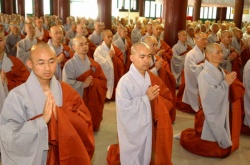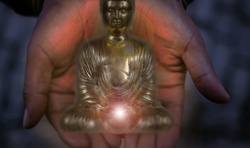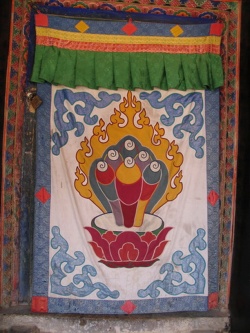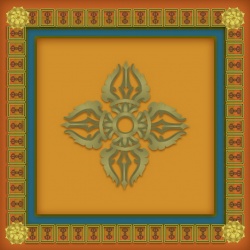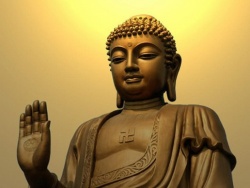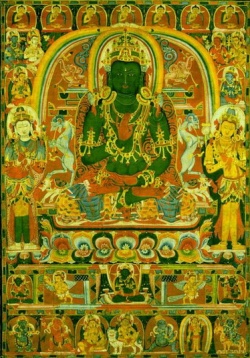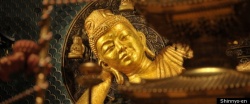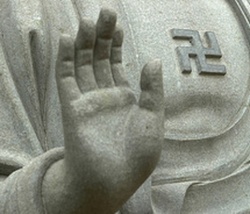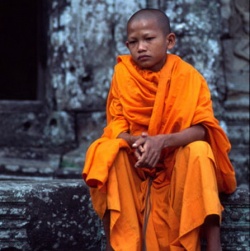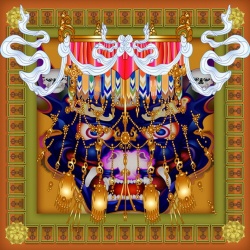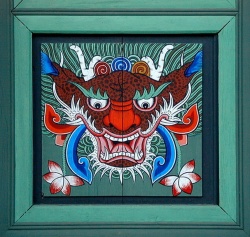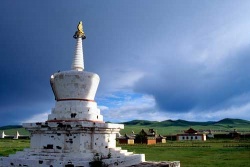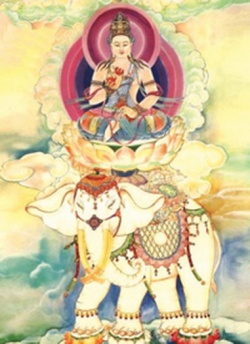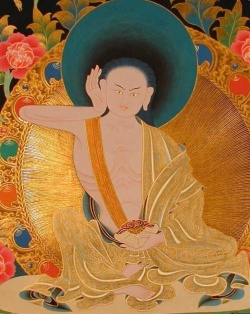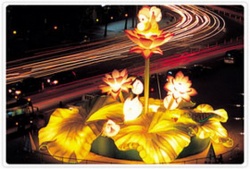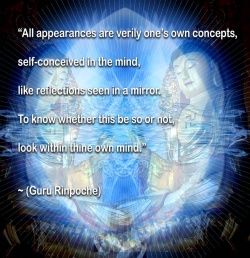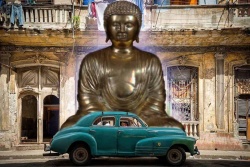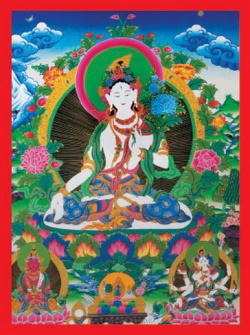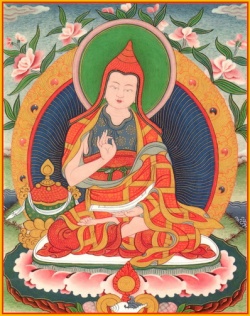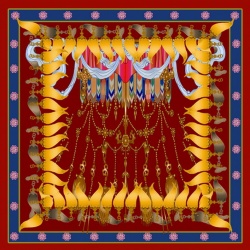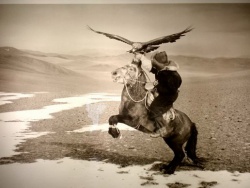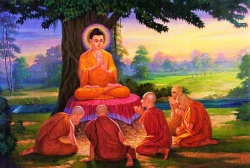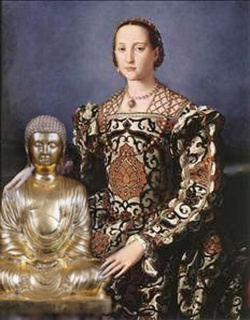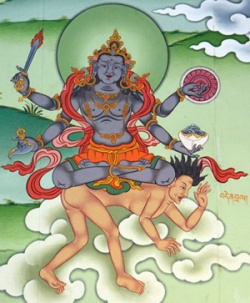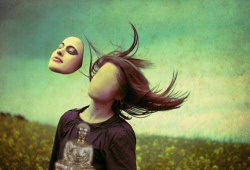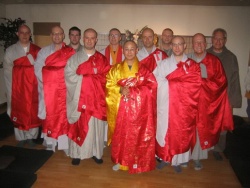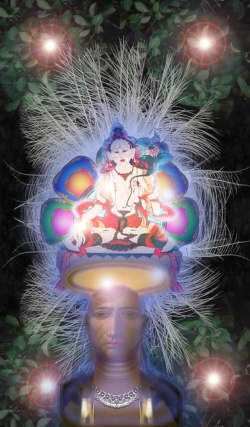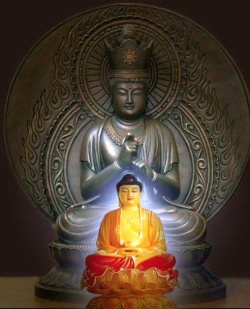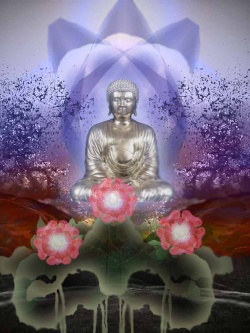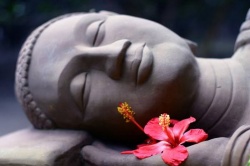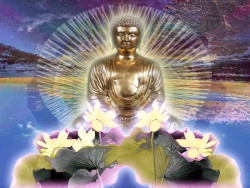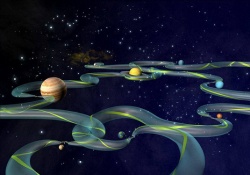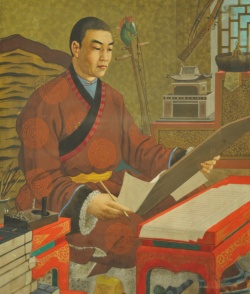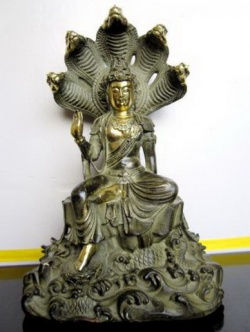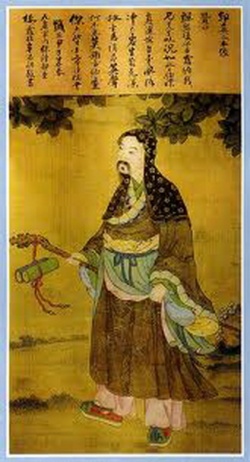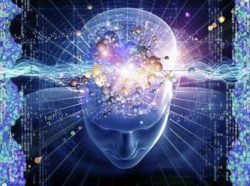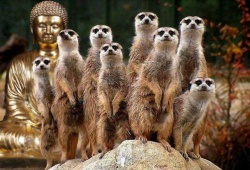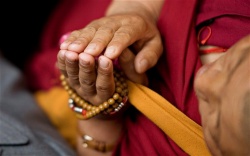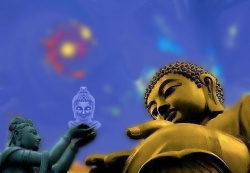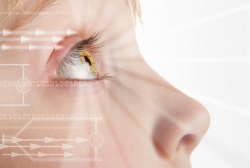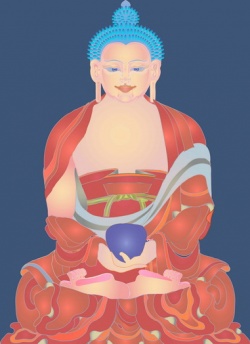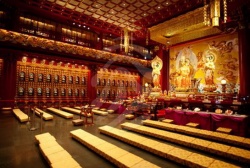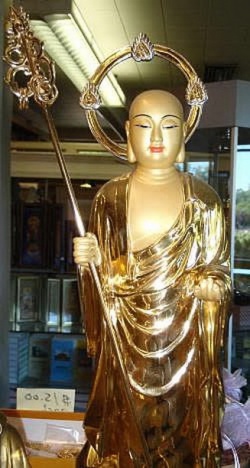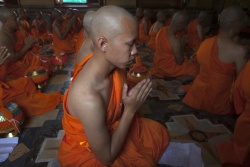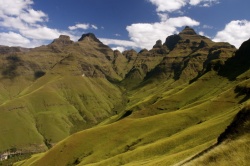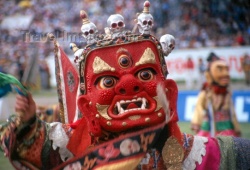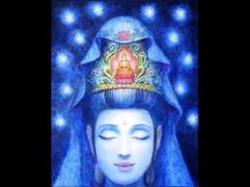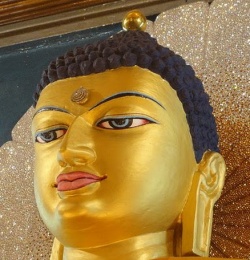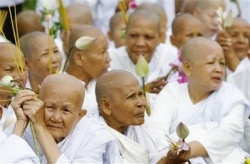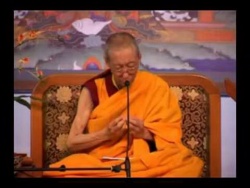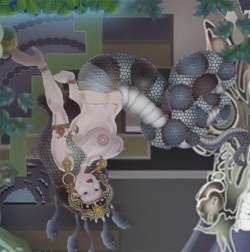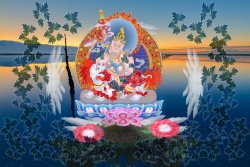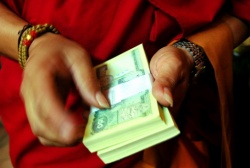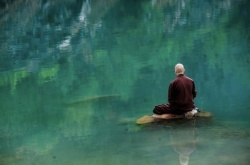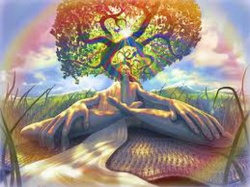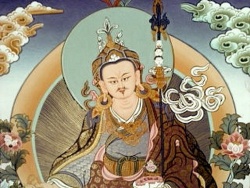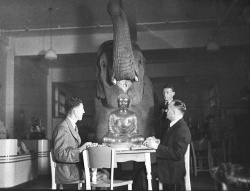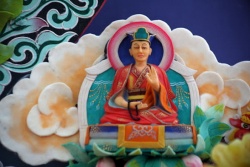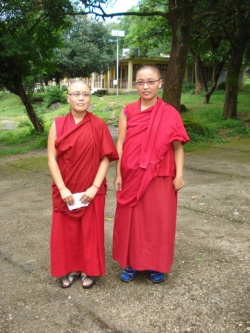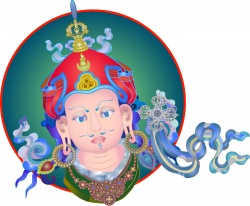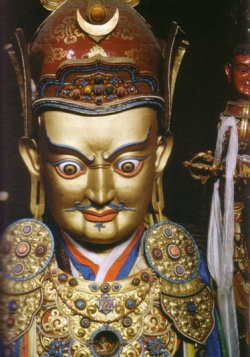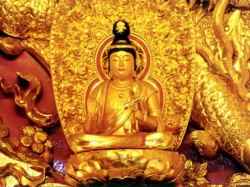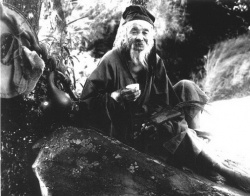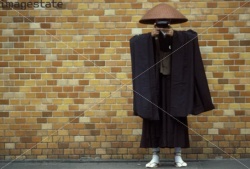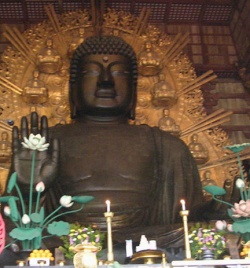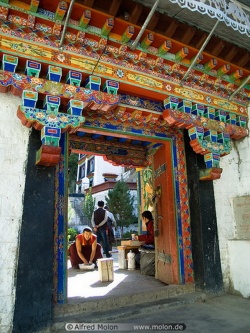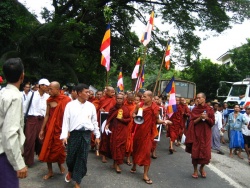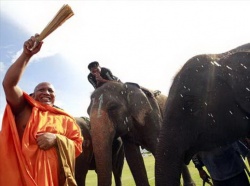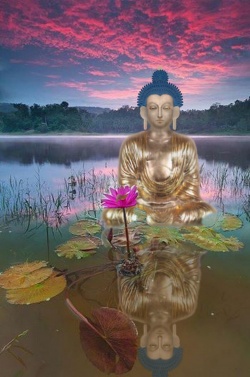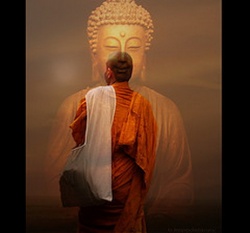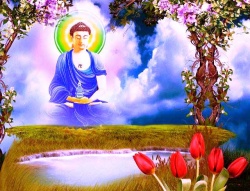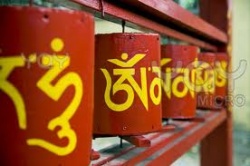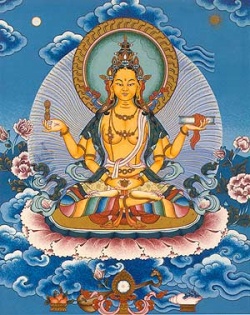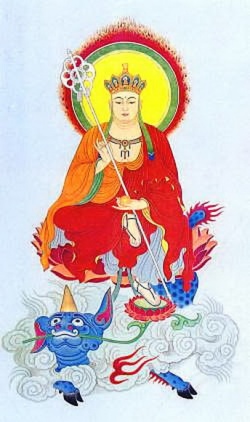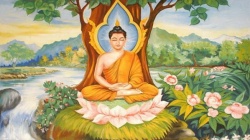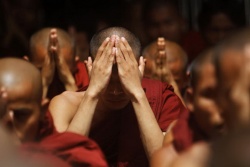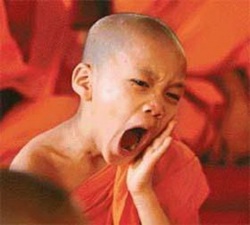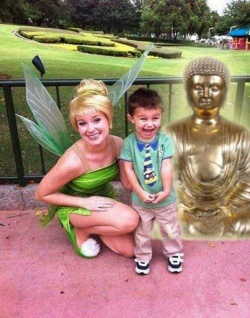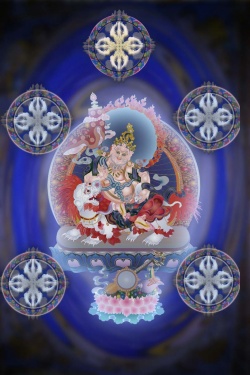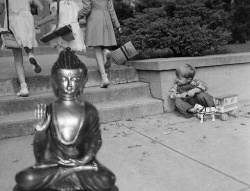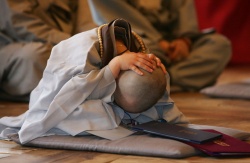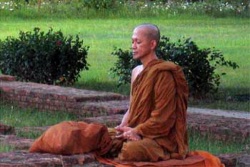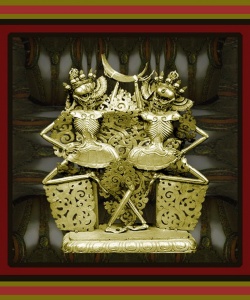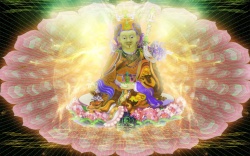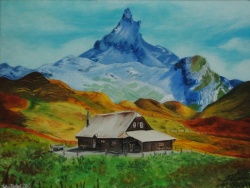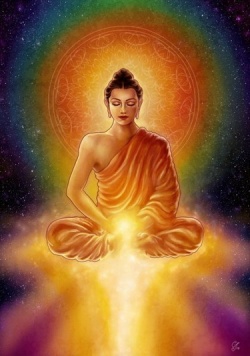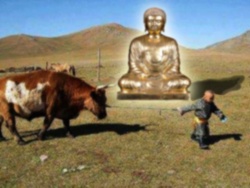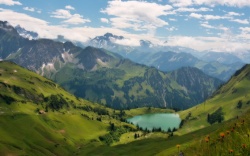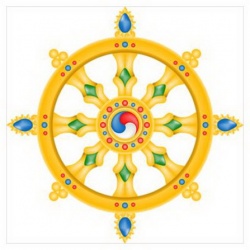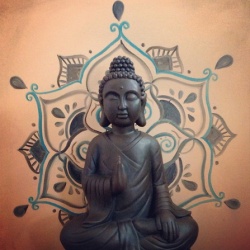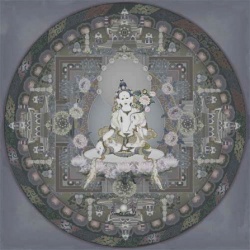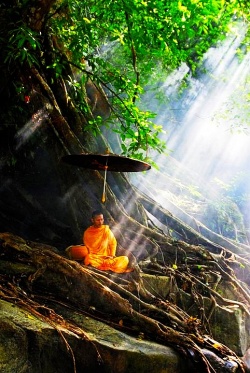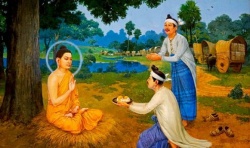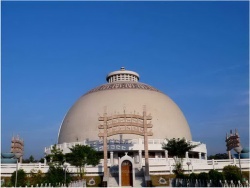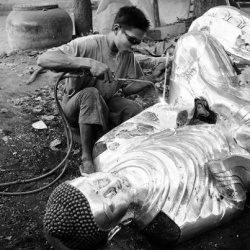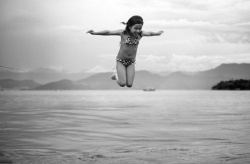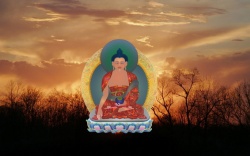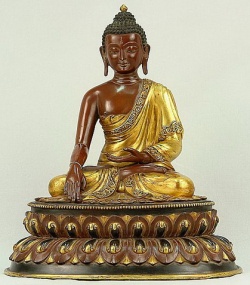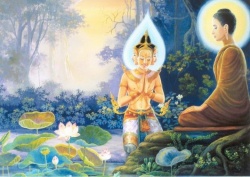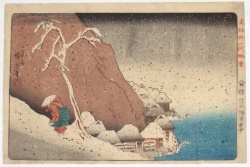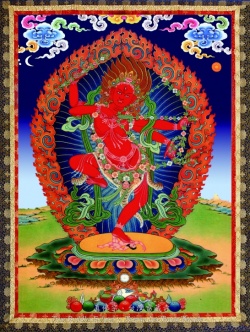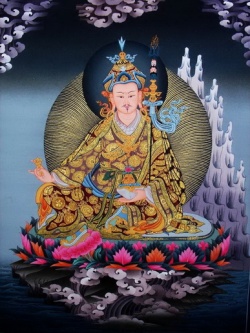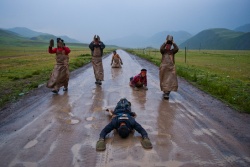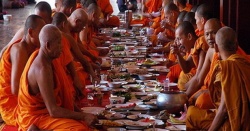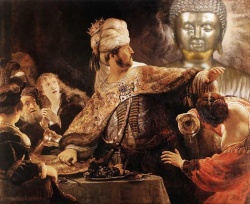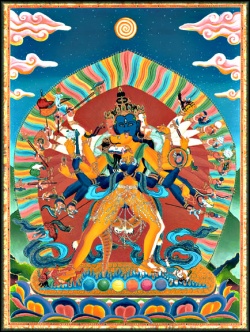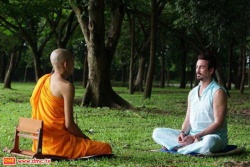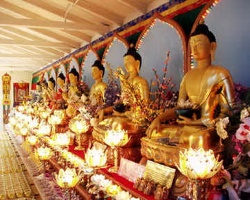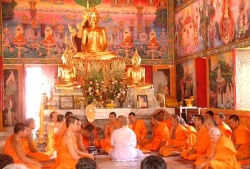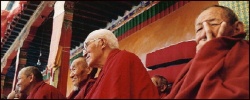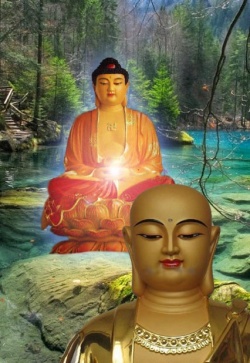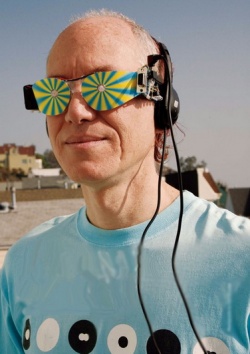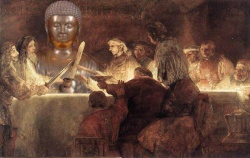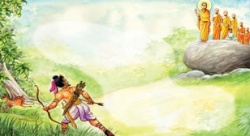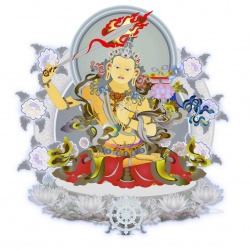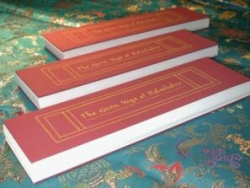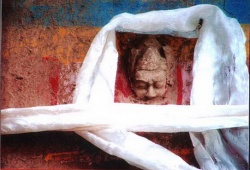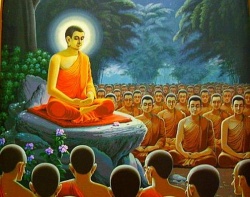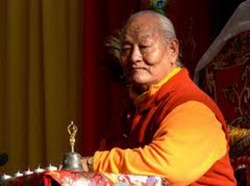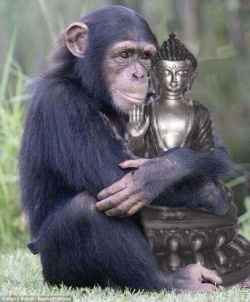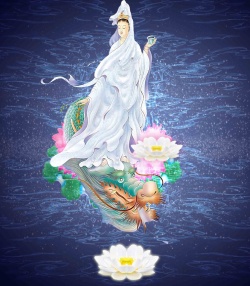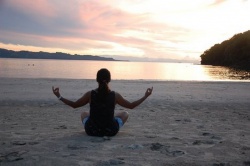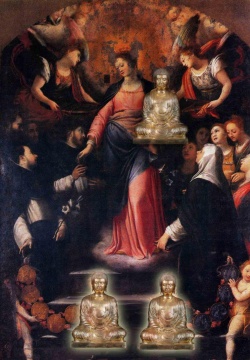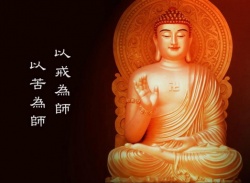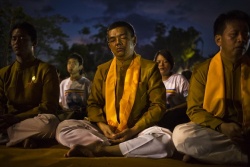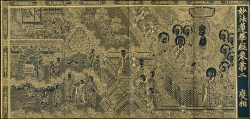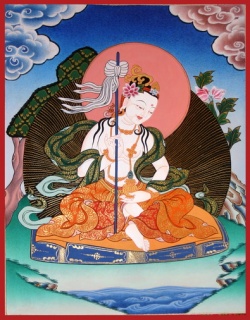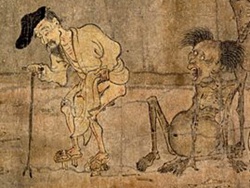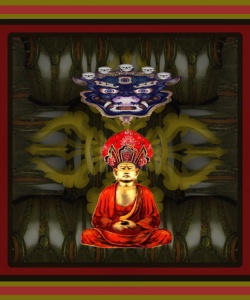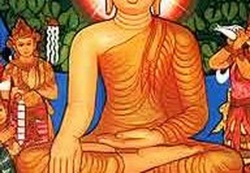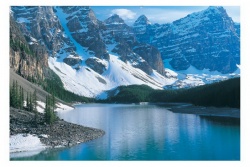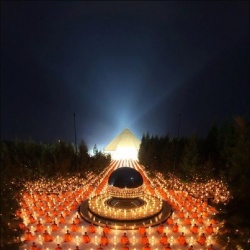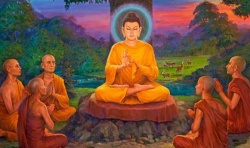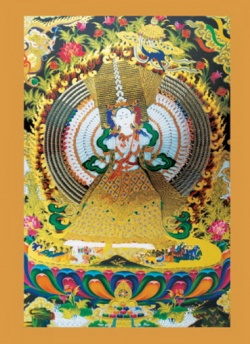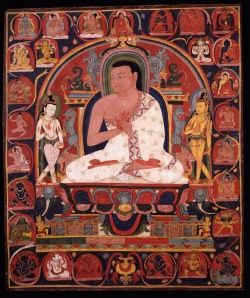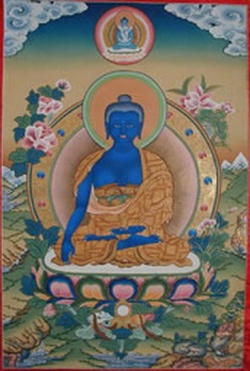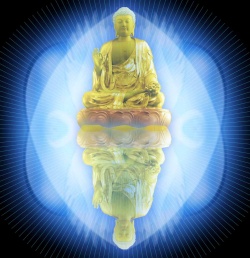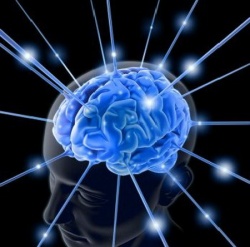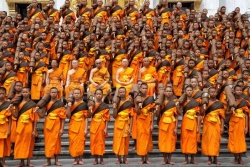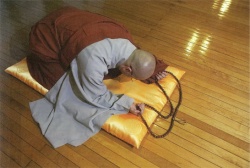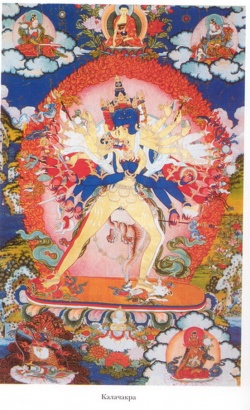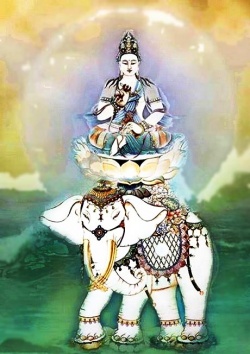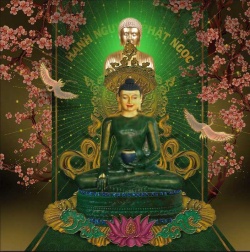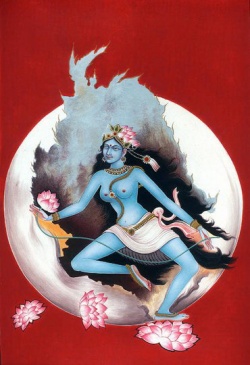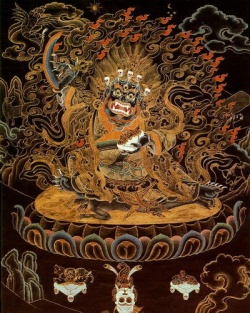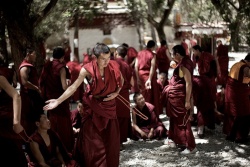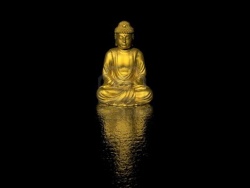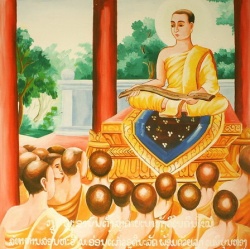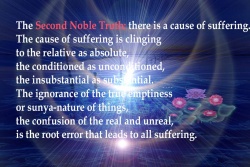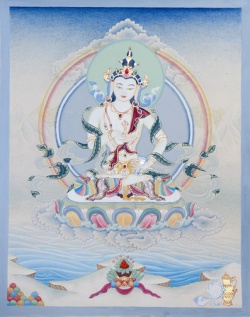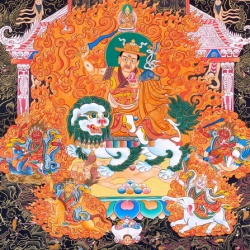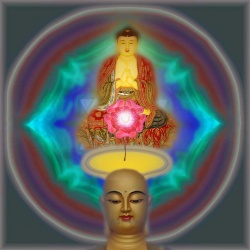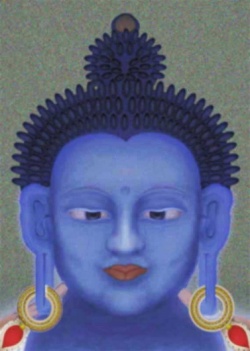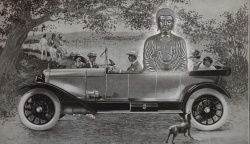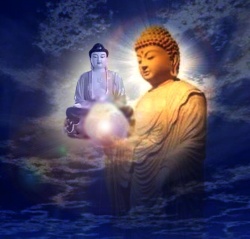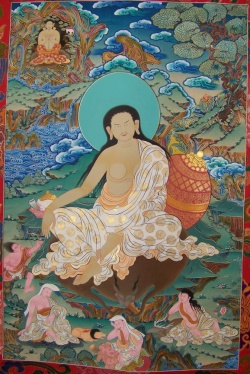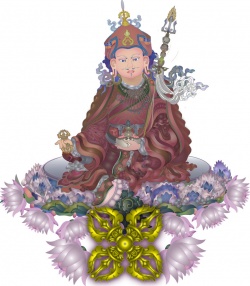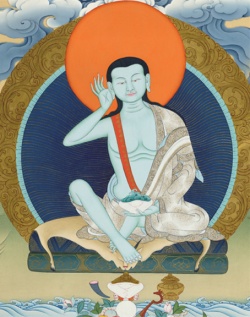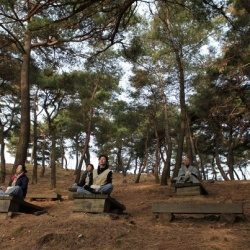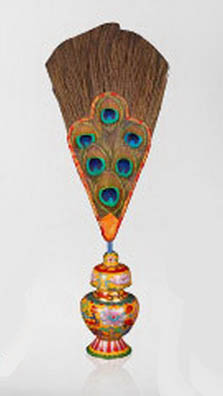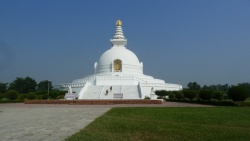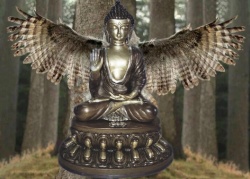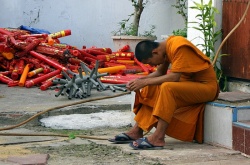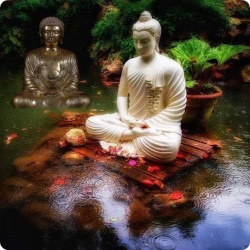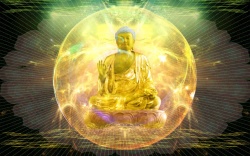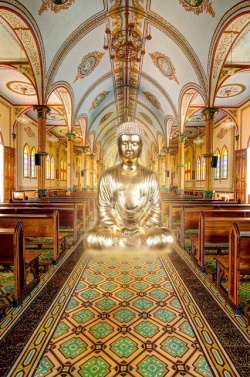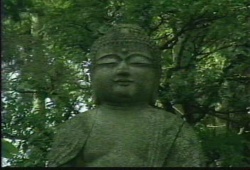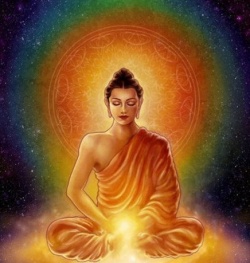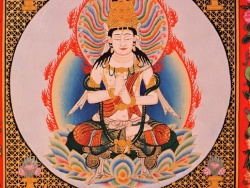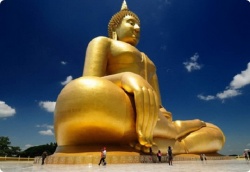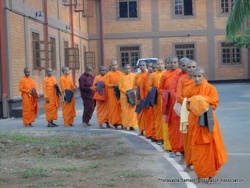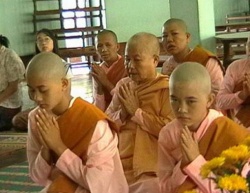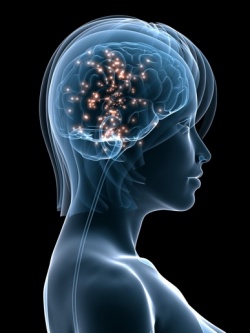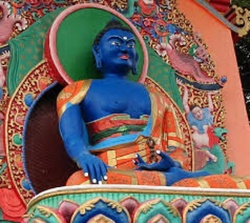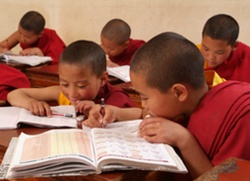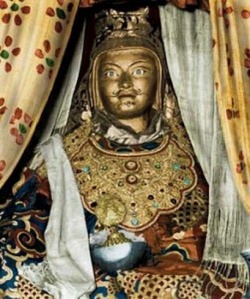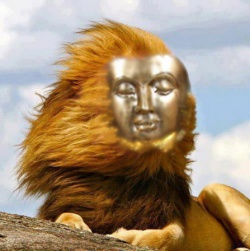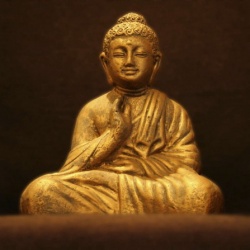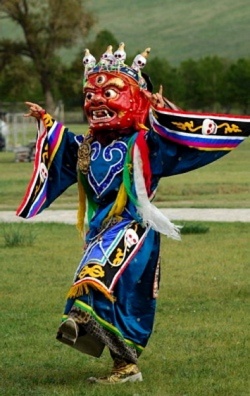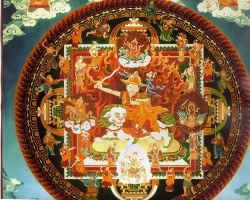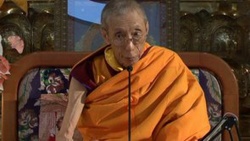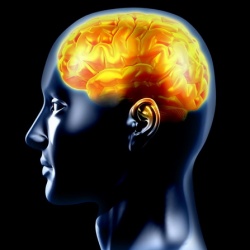The Sadanga Yoga by Anupamaraksita
Sadanga Yoga called the “six-limbed yoga” (ṣaḍaṅgayoga, sbyor ba yang lag drug). These six yogas are visionary practices, designed to induce luminous appearances that
THE SADANGA YOGA BY ANUPAMARAKS.I TA WITH RA vIsRlmANA'S GUJYABHARAJY1NAMA$AI)ANGA YOGATIPPAJ:fl
Text and annotated translation
ROMA
ISTITUTO ITALIANO PER L' AFRICA E L'ORIENTE
2000
Distributed by Herder, International Book Centre, 120, Piazza Montecitorio, 00186 Rome, Italy.
In Italy by Libreria Distributrice Degrassi,
61/a, Via Fonteiana, 00152 Roma.
In India, Bangladesh, Nepal and Sri Lanka by Munshiram Manohru"lal, Publishers (P) Ltd., Post Box 571554, Rani Jhansi Road, New Delhi 110055. TUTTI I DIRITTI RISERVATI
PREFACE
The $aljarigayoga by Anupamarak~ita, presented here for the first time in Sanskrit along with an English translation, is the most important treatise on the sixfold yoga in the Buddhist tantric tradition of the Kiilacakra.
Notwithstanding. its importance, this text has been lost in Sanskrit, sharing the same fate as many other fundamental Indian works. Fortunately, with respect to other unfound texts, the $aljarigayoga was translated into Tibetan J between the 12th and 13th centuries by Vibhiiticandra, Mi-mnyam bzang-po and the Lo-tshii-va dPal-ldan-blo-gros brtan-pa. Since the Tibetan translation clearly shows that this text was mainly composed of passages from other works, the major part of which are available to us in manuscripts and printed editions, a fairly reliable reconstruction of the Sanskrit text has been possible. The few passages of which we do not possess the corresponding Sanskrit have been retranslated with the help of the Tibetan translation and the Sanskrit commentary on the $aljarigayoga itself, the GUI}abharaI}I by RavisrIjfiiina. This latter work has come down to us in one MS copy only, preserved in the Library of the Royal Asiatic Society of Great Britain and Ireland (London), and was edited and translated into German by Gunter Gronbold (1969) at a time when studies in this field were just beginning. The GUI}abharaI}I has been edited anew here and its most important passages have been translated again in the notes.
I would like to thank Professor Gherardo Gnoli, President of the IsIAO, and the Board of Directors for having accepted this work for publication in the Serie Orientale Roma - the famous series founded by Professor Giuseppe Tucci, whose life and work is for me a constant point of reference and inspiration.
This work has also been made possible with the help of Professor Mauro Maggi, formerly Director of the IsIAO Library, Klaus-Dieter Mathes of the Nepal German Manuscript Preservation Project, and the authorities of the Royal Asiatic Society, who have allowed me to use the necessary Sanskrit manuscript sources. I am grateful to all of them. 9
I am also indebted to Professor Giacomella Orofino, who has studied some passages from the Tibetan translation with me, and Professor Raffaele Torella, who has carefully read my work and made helpful suggestions, and whose scholarship and guidance are of inestimable value tome.
Special thanks are due to Dr. Harunaga Isaacson for having most kindly read my work and for his many valuable suggestions and comments.
Words cannot express the gratitude and high esteem I have for Professor Raniero Gnoli, an extraordinary and gifted man. He has never hesitated to help me with my research and to offer me his time and his knowledge that extends into many fields. With particular reference to this work, he showed me the relationship between the Tibetan and the Sanskrit texts and encouraged me to continue my research in this direction. Without his invaluable and constant help, this work would not have been possible. This book is dedicated to him.
I would also like to thank Anne Coulson who helped me in revising the English text.
Rome, September 1999
INTRODUCTION
§ 1. THE SIXFOLD YOGA. GENERAL CHARACTERISTICS Besides the more widespread and famous eightfold yoga (a~tiirigayoga), the classic formulation of which was established by Patafijali (Yogasfitra, II, 29-III, 3),~ there are also important ancient testimonies of a sixfold yoga (ialjarigayoga) present in many Hindu and Buddhist worksl. Several scholars have ah-eady turned their attention to this shortened yoga and many starting points for further research in this field are present in their works2.
Many questions about the sixfold yoga remain unanswered: questions concerning its origins3 , its relationship with the a~tiirigayoga traditions, and 1 It is worth mentioning that there also exist texts in which the yoga has a number of limbs other than six or eight (see Gronbold 1983b: 182-3). Let us consider, for instance, the ViiyupuriiI}8 (X, 76: priiI}iiyiimas tathii dhyiinaI!l pratyiihiiro 'tha dhiiraI}ii I smaraI}aI!l caiva yoge 'smin patica dharmiii} prakJrtitiii} II) and the Mrgendriigama (Yogapiida, 3: priil}iiyiimah pratyiihiiro dhiir8J!ii dhyiinavik~aI}e I japai} samiidhir ity aJigiiny aIigi yoga '~ramai} svayam II). 2 See Zigmund-Cerbu 1963; Pensa 1969; Gronbold 1969, 1982, 1983a, 1983b, 1983c, 1984; Rastogi 1992; Brunner-Lachaux 1994; Orofino 1996; Isoda 1976. Cf. also Pandey 19632: 534-8; Dviveda 1984, Upodghiita, pp. 112-9; S.B. Dasgupta 1958: 164-70; Garde 1973. Recently, an English translation of four articles by G. Gronbold (1982, 1983b, 1983c, 1984) has been published with indexes: G. Gronbold 1996. 3 At present, the most ancient Indian text dealing with yoga is the Maitri Upani~ad (cf. Cowell 1935: 129-36).
A. Zigmund-Cerbu (1963: 130) has advanced the hypothesis that the limb-list found in this work (VI, 18) represents the original yoga framework, common to Hindu and Buddhist schools. Cf. also Hauer 19582: 102. In Maitd Upani~ad VI, 18, the six limbs are listed and the aim of the sixfold yoga is stated. Through its practice the wise yogin sees Brahman and, having abandoned merit and demerit, unites everything in the supreme unperishable (paramiik~ara). Riimatjrtha in his commentary explains that 1) priiI}iiyiima is breath-control performed through the three phases beginning with the piJraka; 2) pratyiihiira corresponds to withdrawal of the senses from external objects; 3) dhyiina is the entrance of the antai}karaI}a into an object of meditation, in accordance with the nature of that object; 4) dhiiraI}ii is when the antai}karaI}a 11
the transmission over the centuries of its teaching within the same school or from one school to another.
Since many works have not come down to us and, in many cases, we have only ariga-lists, and very often living traditions no longer exist or, if they do, are not linked to the ancient schools, we can only indicate issues and suggest some hypotheses. Here, we will focus our attention only on a few questions. At first, it should be noted that ~agarigayoga, even more than a~fiirigayoga, ca=ot be studied as a unitary phenomenon4 . Each of the six limbs is explained and practised in various ways in the different traditions, and at least five ariga lists can be found in Hindu works alones: focuses without intenuption on this object, like oil flowing; 5) taJka is a) the examination performed in order to see if the mind is well-concentrated on the object, or b) to see the obstacles to reaching concentration, which are caused by the inferior powers that have been generated through dhyana and dharm/a, or c) the savikalpasamadhi (lit., 'the concentration endowed with conceptual construction'); 6) samadhi cOITesponds to the fusion of the mind with the fonn of knowable reality. The mind reaches a state of calm and steadiness, similar to that of the tip of a lamp in a closed space. In Maitl] Upani~ad VI, 19, it is said that after the mind has been fixed on a single point (ekatra sthirmp kf'tvii), after having abandoned sensorial objects, after having controlled the breath, the wise yogin remains without conceptual
construction (nii}sarpkaipaj. Then the individual soul (atman), which is identified with the vital breath (praI}a), is fixed in the fourth state. In Maitr! Upani~ad VI, 20, a superior (parii) kind of dhw'alJa is explained. The yogin sees Brahman through the taTka (tmkeI}a), which is explained by Ramatlrtha as niscitJriipeI}a jnanena, after having pressed the tip of the tongue on the palate and having anested his mind, word and breath. He identifies with Brahman and becomes niriitman, limitless, or, in other words, free. 4 C. Pensa writes: "Una prima carattelistica dello ~agarigayoga e questa, che ad esso non si puo fare riferimento come a una categOlia fissa, qua!'e I' a~riiilgayoga - in cui gli otto elementi che 10 compongono sono sempre gli stessi, per 10 meno come numero e tipo - bensl come a un insieme di pratiche di cui alcune mutano e sono sostituite a seconda dei contesti dottrinari. La tradizione dello ~agaJiga, dunque, attestata in un periodo abbastanza antico - e potrebbe essere forse pili antica dell'altra - appare fiorente, come vedremo, in epoca tarda, ed ha caratteli di instabilita, in contrapposizione con la stabile e conservativa tradizione dello yoga a otto 'membri n, (1969: 522). Obviously, it can also be the case that in some texts that accept the a~rwigllyoga the meaning ascribed to the aligas does not coincide with their usual explanation. See, for example, the Trisikhabriihmapa (S. Dasgupta 1922: 454). See also Colas 1988. 5 However, it is worth noting that these lists can be divided into two groups - G. Gronbold was the first clearly to distinguish two groups in the ~agailgayoga tradition: the tmka-class and the iisana-class (1983b) - and that sometimes can be distinguished only for the order of their limbs.
Some references to other Hindu works dealing with the ~adailgayoga are in Kane 1962: 1419, note 2327, and Gupta, Hoens, Goudriaan 1979: 166. 12
A) prapayama, pratyahiira, dhyana, dharapa, tarka, samadhi (Maitri Upani~ad, VI, 18), B) asana, prapasarpmdha (prapayama), pratyahiira, dharapa, dhyiina, samadhi (Dhyanabindu Upani~ad, 41; Yogaciirjamapi Upani~ad, 2; Gbraksasataka, 7; Gorak~avacallasaJpgraha; 62; Akuiagamatantra6 ). C) pratyahara, dhyana, prapayama, dhiirapa, taJka (vIk~apa), samadhi (Rauraviigama, Vidyiipiida, VII, 5; MatangapiiramesvaJ'iigama, Yogapada, I, 6; Amrtanada Upani~ad, 6). D) pratyiihara, dhyana, priipiiyiima, dhiirapii, asana, samiidhi (Kirapagama, Yogapiida, I, 3). E) priipiiyiima, pratyahiira, dhiirapii, tarka, samiidhi, dhyana (Vi~pus8Iphita, XXX, 57 ff). The most evident difference between the classic a~tiiIigayoga fonnulation and the ~ac;1arigayoga is the absence of yama and niyama and the presence, in some texts, of taTka (also called vik~~a) instead of asana. The absence of yama and niyama has been explained by deeming these two arigas to be presupposed, particularly in the case of tantric schools (Pens a 1969: 524-5; Bmnner-Lachaux 1994: 439-40). As a matter of fact, it is well known that the tantric practitioner has to observe many restrictions described at length in the Caryapadas of the Agamas and the Tantras. The word tm:ka needs further analysis on the aim of the yoga (lit., 'union') itself, on the different ways in which this aim is understood, and on the different doctrinal contexts that underlie the yogic traditions. This subject will not be examined in depth heres.
It is worth mentioning that the sixfold yoga neither necessarily contradicts nor excludes the eightfold yoga. In Hinduism, these two kinds of yoga are sometimes mentioned or even described in texts belonging to the same school or tradition, In the Kasmrrian advaita saiva tradition, for example, the eightfold yoga is dealt with in the Netratantra (also called M[tyuiijayabhattaraka) (chap. VIII) - although the limbs are explained in a different way with respect to Pataiijali's yoga (Rastogi 1992: 259-60; see above note 4) - and in the TantTiiloka (IV, 87 ff), whereas references to the sixfold yoga are found in the Malinivijayottm'atantra (chap. XVII)9 and in another part of the Tantriiloka (IV, 15-16), where Abhinavagupta quotes 6 A MS of the Akuliigamatantra is described in Bagchi 1934: 61-3. 7 The word yoga has been traditionally explained as 'concentration', in confOimity with yuj samadhau (ef. Yogasiitrabhii~ya, ed., Madras 1952, p. 5; see also Yogaratnamiila, ed. p. 143, and below, gloss on sl. 2), and 'connecting', in conformity with yujir yoge (see S. Dasgupta 1975: 226-7).
8 See below, p. 37, note 68.
9 One of the most important tantras of the saiva tradition. It has been published by M.K. SastrI in the Kashmir Selies of Texts and Studies, vol. 37, Srlnagar 1922. Chapters 1- 6, 8-9, 11 have been translated into Italian by R. Gnoli (19993 : 645-89). On this text, see also Sanderson 1992.
crucial passages from this tantra that deal with yoga 10. Furthermore, in the Netratantroddyota I, 8, K~emaraja states that yogins are those who worship the Lord through the yoga of six limbs, etc. (yoginalJ. ~ac;larigadiyogenesvararadhakaJ;.) l1. G. Gronbold has already noted that in late Gorak~ayoga texts both the ~ac;larigayoga and the a~tangayoga were known (l983b). Similar considerations could be made with reference to vai~J?ava schools. Thus, even if the major part of the Pancaratra Sarphitas accepts the division of yoga into eight limbs (even though these are arranged in different lists) 12, the Vi~J?usarphita (chap. XXX, 57 ff) and the SanatkumfiI: asarphita (cf. J;?~iratra, I, 14cd; III, 59cd) adopt the ~ar;1arigayoga. The latter text refers to the yoga tradition of the Padmodbhava[sarphitfij, but it does not give an ariga list13 . Epigraphy provides us with more evidence of ~ar;1arigayoga practice in this vai~J?ava sect. Zigmund-Cerbu (1963: 129-30) partially quotes the first verse of a Piificaratra inscription dated Saka 879 (957 A. D.) found in Cambodia and published with a translation by G. Coedes, in which the sixfold yoga is clearly cited (1954: 132-9)14. Despite the undeniable differences, in general the sixfold yoga described in Hindu works seems to be closer to the classic formulation of 10 Cf. also the Tantriilokaviveka by Jayaratha, ed., vol. III, pp. 15-6 and pp. 102-3 (comm. on IV, 96),
11 Ed.p, 4.
12 The AhirbudhnyasaIphita (XXXI, 15 ff, XXXII), the Naradiyasarphita (XXX, 9cd- 21), the Brhadbrahmasarphita (IV. vii, 52-74), the Sriprasnasarphita (III, 18-19ab), the Paramesvarasarphita (VII, 438-503) and the isvarasarphita (IV, 83 ff) follow Patafija!i's scheme: yaIfla, niyama, asana, praI}ayama, pratyiihara, dhiiraI}a, dhyana and samadhi. In the Padmasarphita (Yogapada I-V) niyama is replaced by tapas, whereas in the Jayakhyasarphita, yama, niyaIfla and asana are substituted with japa, yoga and iiha respectively (chap. XXXIII). Japa is also present in the yoga-limb list of the Mrgendragama (Yogapada 1,3) (see above note I, and also Brunner-Lachaux 1994: 449, 454), A reference to the eightfold yoga is also in the Satvatasarphita II, 7c. 13 On the Padmodbhavasamhita, see Schrader 1916: 8. 14 yas srisaIikharathaIigasa;iJgadharaI}iprodyadgadakhadgadhrk dhmmmo dhmmmavidam ajiidinidhano vedyo ya eko vibhu/;11 sevyo yas ca ~acjaIigayogavisadair yyogipravinair hrdi sreya/;1praptyabhila~ibhis sa bhagavan narayaI}o namyatam II "Hommage soit rendu au bienheureux Narayal!a, portant Sri, la conque, Ie disque, I'arc, la terre, la massue levee et I'epee, dharma de ceux qui connaissent Ie dharma, premier receptacle de l' Aja, inconnaissable, unique, souverain, digne d'etre honore dans leur crer par ceux qui brillent par Ie yoga' it six divisions, qui possedent I'intelligence des yogin et qui desirent obtenir I'emancipation" (trans. Coedes, p. 136). 14
the a${arigayoga (at least when considering the explanation of certain limbs)15 than is the si{cfold yoga of the Buddhist tantras, where the six limbs are explained in a completely different way. The most ancient testimony of a Buddhist $aq.arigayoga (Tib., sbyor ba yan lag drug pa) is found in the GSU (stt. 141-154)16. Here, the six limbs are expounded according to this sequence: 1) pratyiihara (Tib., so sor sdud pa, 'withdrawal'); 2) dhyana (Tib., bsam gtan, 'contemplation'); 3) prapayama (Tib., srog gi rtsol ba, 'restraint of the breath' or 'breathcontrol'); 4) dharap.a (Tib., 'dzin pa, 'retention'); 5) anusmrti (Tib., rjes su dranpa, 'recollection' or 'subsequent mindfulness'); and 6) samadhi (Tib., ting nge 'dzin, 'concentration') (st. 141). The description of the yoga limbs that we fmd in the GSU most likely represents one of the most ancient (if not the most ancient) traditions of the sixfold yoga in the Buddhist schools. This is proved not only by the fact that the yoga adopted by other later Buddhist works, such as the SU, the LKC and the 1;)VP, follows the same list as the GSU, but also by the fact that some of the most crucial stanzas of this text are quoted and glossed in those works, which seem to depart from or contradict in some way the GSU teaching. As a matter of fact, it is a typical and a well known Indian practice to adapt ancient authoritative texts or sentences to a context different from their own in order to confirm new teachings, practices, or interpretations, without entailing any conscious idea to betray the quoted source.
Stanzas 142-154 of the GSU were also quoted and glossed by two important teachers of the Kalacakra, namely, Niiropa (Nastapada) in his Sur and Ravisrijiiana in the GBh (see below pp. 128-36). The latter bases his commentary on the GSPU by Deutero-Candrakirti, who quotes and 15 Rastogi (1992) has shown the extent to which the sixfold yoga of KiiSmIrian Saivism was influenced by the a~!iiIigayoga. He has analysed several texts, among which also the passages of the Svacchandatantra in which the yoga is treated, i.e., VIT, 286 ff. 16 Chapter XVITr of the GS, which is called GSU, was probably added to the GS. There are different opinions among scholars as to the date of the GS. Y. Matsunaga has convincingly proved that "in the first half of the 8th century [ ... J the Guhyasamiija-tantra as an Anuttarayoga-tantra was not completed", but was probably in a formative stage (1978: xxiv). "The Guhyasamiija-tantra including the Uttaratantra part was completed during the latter half of the 8th century" (ibid., p. xxvi). A. Wayman (1995: 141) places the GS around the beginning of the N century A.D.
Several commentaries on the GSU are preserved only in Tibetan translation. See, for instance, the A~!iidaSapa!alavistaravyiikhyii by Nligfujuna (Wayman 1977: 164-6) (Peking ed., voL 60, # 2649), the A~!iida§apa!alavyiikhyiina by Candraprabha (Peking ed., vol. 64, # 2712) and the Sriguhyasamiijatantrapafijikiiby Jinadatta (peking ed., voL 63, # 2710). 15
comments several parts of the GSU in chapter XII of his work17. The text of the GSPU was reproduced by Ravisrljfiana almost verbatim. His intervention consists of simply changing a few words and moving the commentary on stanzas 150cd-151, which in the.GSPU is a part of the gloss on anusmrti, to the explanation of the first limb, pratyiihiira, following a disposition of the verses of the GSU more similar (at that point) to Naropa's. The way in which the above-mentioned authors and Nagarjuna (the author of a -,?Y preserved in Tibetan, see below p. 49) divide verses 142-154 of the GSU on the basis of the six yoga-limbs is summarized in the following tablel8 :
Here follows the translation of GSU, 141-154 with the commentary by Ravisrijfiana and some parts of the gloss by Naropal9. The principal differences will be briefly discussed afterwards: The sixfold yoga consists of withdrawal, contemplation, restraint of the breath, retention, recollection and concentration [141]. The interiorization (svavftti) of the ten senses, which takes place with respect to all food of desire, is called withdrawal [142]. GBh: Here, the word 'senses' means the senses and their objects. 'The interiorization of the ten senses' (again, the senses and their objects) is their acting as perceptors and perceivables respectively. [ ... ] [This refrainment] is performed 'with respect to all food of desire', be it low, middle, or high. Withdrawal (pratyiihiira) is the repeated eating (iiharal}a), 17 Probably the GSPU represents an ancient tradition close to the original text of the GS. A part of the commentary of the GSPU on chap. XII of the GS has also been edited and translated by A. Wayman (1977: 36-50).
18 In the GSPU (GBh and ~y by NagiiIjuna), GSU, 144cd-145ab (guhyatantre~u sarve~u vividhiil;1 parikirtitiif;J I guhyarp tarkodayarp tarkarp viciirarp tatprayogatafJ II, ed., p. 132) is quoted in the following shortened version: guhyatrayarp vitmkas ca viciirarp tatprabhogatli (ed., p. 116), whereas it is fully quoted in the SUT (ed., p. 30). 19 See GSPU, ed., pp. 116-9 (cf. below GBh, Text, fols. 23a6-25b4), and SUT, ed., pp.31-5.
viz., perception through sensorial faculties, of desires - i.e., of colours, etc. -, which are desired, wished.
sur: [ ... ]. With the words 'ten senses' one should understand senses and sense objects. 'The interiorization' of these ten (senses and sense objects) simply means their persisting in themselves, i.e., their tuming inward. In other words, it corresponds to [their] pure existence (sattfimfitratfi): senses and sense objects respectively avoid becoming perceiver and percept. The interiorization corresponds to their being in this condition and not to their acting as perceivables and perceptors [ ... ]. The idea that "the five desn:es are wholly [united] thmugh the application of the five Buddhas" is called contemplation. This is fivefold. That is, in contemplation the following five aspects are gathered:
examination, analysis, joy, pleasure and the fixedness of thought on a single object. Examination cOlTesponds to (the arising of) the three secrets, whereas analysis is its development. The third aspect is the apparition of joy, the fourth is the sum of pleasure, and the fifth has to be known as ow' own mind, which is [characterized by] the dissolution of the arising of knowledge in knowable reality. [This mind) consists of all Buddhas; it is pacified and well established on the ether of all things [143-144cd, 145-146].
GBh: 'The five desires', colours, and so on, are the objects of the senses. 'Wholly' means at one with the senses. 'The five Buddhas' are the eyes, and so on. There is a union, a connection, between these [[[senses]] and sense . objects) 'through the application of the five Buddhas'. Therefore, contemplation is the pure idea: "also fmID, and so on, are the five Buddhas". This [contemplation] is fivefold, according to examination, and so on. [ ... ] 'The three secrets' are the senses, the objects and the [different kinds of] knowledge. Examination is the idea: "the five senses, the five kinds of sensmial knowledge and their objects have the same nature as the five Tathagatas". The insistence (vicfira;;Jasthitl) of this idea is analysis. For the practitioner, 'the apparition of joy' corresponds to a relaxation due to a profound adherence to the truth. 'The sum of pleasure' is the pleasure obtained by this adhesion. It is characterized by a relaxation of the body. Thus, for he who has applied himself repeatedly and has reached the pinnacle of excellence, there is 'the arising of knowledge' - that is, the six kinds of active knowledge (prav!ttivijiiiina), namely, the knowledge of the eyes, and so on - in knowable reality, which extends from fmID to the dharrnadhfiW.
The 17 dissolution of this mind is 'the fIxedness of thought on one single object', which is characterized by perfect knowledge of the voidness of perceivable and perceptor. It corresponds to the [[[yogins]]'] own mind. [This mind) has the nature of all Buddhas and is pacifIed [since the conceptual constructions of perceivable, and so on, are dissolved] (GSPU). It consists only of light, and is fIrmly and exclusively based upon the voidness of all things. sur: [ ... ]. The words 'five desires' mean all beings, both movable and unmovable. These 'are united with the five Buddhas'. In other words, it means that all beings are naturally united with all Buddhas, namely, consist of all Buddhas. 'Wholly' means that there is a mental creation (kalpanii) of all beings who are all Buddhas, according to an apparition of the three times and the three worlds, which the yogins can directly perceive. This mental creation is devoid of conceptual construction; it is vision devoid of conceptual construction and error. It happens continuously and is called contemplation (dhyiina) [ ... ]. The 'three secrets' are the three worlds, which extend to the three times and are made of body, word and mind. Their 'arising' corresponds to the knowledge of them [ ... ]. Breathing consists of five kinds of knowledge and corresponds to the . five elements. Breathing out, one has to conceive 'the great jewel of five colours' in the fonn of a ball on the tip of the nose [of the lotuses) (GSPU). This is called 'restraint of the breath '. Having meditated on one's own mantra in the heart, [the breath) should be propelled to the bindu [147-148].
GBh: ['Breathing' has the nature of 'the fIve kinds of knowledge', beginning with that of the mirror. Having emitted it from the hole of one's own vajra, one has to meditate on this [[[breathing]]), which consists of earth, and so forth, 'in the form of a ball', viz., in the form of a drop of bodhicitta, 'on the tip' of the lotus or of the nose] (GSPU). It has 'five colours', that is, it has the nature of the five Tathagatas. Therefore, the restraint of the breath is called (or known) in this way because through it the great jewel, the vital breath, the life, is restrained or, in other words, prolonged. [ ... ]. 'Having meditated· on one's own mantra in the heart', in the lotus of one's heart, '[the yogin) should propel' the vital breath 'to the bindu'. SUr: [ ... ]. The 'fIve kinds of knowledge' correspond to the five Buddhas beginning with Ak~obhya, that are the five aggregates, knowledge (vijiiiina), and so on, which belong to the five mar;.qalas of la1ana. Breathing, which consists of these, occurs in the left nostril. The words 'five elements' mean 18
the five elements beginning with earth, which belong to the five m8{l jalas of rasana. Breathing, which consists of these, i.e., of the five elements, occurs in the right nostril. 'Breathing out in the form of a ball'. Here, the ball is the vital breath of the right and left m8{ljalas that is unified in the central channel, in the avadhiiti The vital breath, once pushed out in the form of a ball, has to be 'conceived', that is, meditated on, 'on the tip of the nose'. The word 'nose' means the pericarps of the navel, heart, throat, forehead and crown. It will be conceived, that is, meditated on, from the middle of one pericarp to the middle of another one, and not from the right petals of the lotus to the left ones. Due to the suppression of the left ~d right courses, tllls vital breath that flows in the central channel is called 'the great jewel of five colours'. [This exercice] is called restraint of the breath (prapayama) and adamantine muttering (vajrajapa). The latter has to be performed in unity with the central channel (see below, p. 293, note 156) [ ... ]. 'One's own mantra' is the vital breath that has to be meditated on 'in the heart', from the middle of one pericarp to another, and that 'should be propelled to the bindu'. In other words, it must be arrested in the bindu-place, the forehead [ ... J. Once this jewel, which is accompanied by sensorial faculties and their [[[objects]]), has been restrained, it has to be fixed. This is retention [149ab]. GBh: Retention is what causes the fixation once the jewel - the jewel of the mind -, which is the basis of the senses and their objects (that is, eyes, colours, and so on), has been restrained, i.e., dissolved through breath-control [ ... ].
Once the mind has reached the alTest-vajra, the perception of the signs occurs. Bodhivajra said the signs are five. The first sign has the aspect of a mirage, the second is similar to smoke, the thiJ:d has the aspect of a firefly, the fourth of a shining lamp, and the fifth of an everlasting light similar to a cloudless sky [149cd-15l].
GSPU (cf. GBh, fols. 22bs-232): With the aspect of a mirage, the first sign appears through the dissolution of earth into water. Then, through the dissolution of water into fire, there is the second [sign] with the aspect of smoke. Through the dissolution of fire into wind, there is the third [sign] with the aspect of a firefly. Then, through the dissolution of wind into knowledge [lit. 'three lights'], we have the fourth [sign], which is similar to a lamp and consists of a mass of light. Through the dissolution of knowledge [lit. 'eilsentiallight' (prak[tyabhasa)], we have the fifth [sign],
which is similar to a cloudless sky. It is an uninteITupted and shining light. These five signs lead to nirvapa. It has been said in the Kmwantavibhaga: "At first, earth goes into water, water goes into fire, fire goes into wind, wind goes into knowledge, and knowledge goes into light". SUT: The two and a half verses beginning with the words 'Once the mind ... ' refer to the withdrawal limb. Their position after the retention limb is wrong, since it contradicts the master's teaching [ ... J. The words 'aITest-vajra' mean the path of the avadhuti[ ... J. Once 'the mind', namely, the vital breath, has reached this [[[path]]), 'the perception of the signs', that is, their arising, the apparition of the smoke, and so on, occurs. The change of position between the first sign and the second one shows that one should have faith in the master's teaching.
[The yogin) should expand [his] motionless [mind/great jewel) in the elements of the ethel" (khadhatu~u) thmugh the adamantine way. Having meditated on this [[[mind]]), he should diffuse it according to the aspect reached thmugh recollection. This [moment] is recollection. In it the appmition occurs [152-153].
GBh: '[The yogin) should expand', [viz., meditate on] (GSPU), '[his] motionless', pure 'mind in the elements of the ether', that is, in the worldelements, 'through the adamantine way', i.e., through absorption into the radiance that inconceivably follows the five signs, according to the nature of the Dharmakaya. Thus, 'having meditated on', that is, having directly experienced his own radiance, [the yogin) 'should diffuse' [his mind) 'according to the aspect' previously reached 'through recollection'; in other words, through the appearance of the mirage, etc. he reached the limit of beings (bhutakO!l)' He should diffuse [his mind) according to the same process. The fifth limb, that is, recollection, has been described. [The apparition or the consciousness occurs in this limb, anusmrti, not in another one] (GSPU).
sur: It is 'motionless', devoid of movement, due to the retention limb. The agent, that is, the great jewel, will cause the arising of the caprjalifrom the wheel of the navel, 'through the adamantine way', i.e., through the central channel, 'in the elements of the ether', that is, in the wheel of the crown. The cm}rjaJi, arisen from the pericarp of the lotus of the crown, will melt the syllable harp and, thereafter, will conduct the four bindus (consisting of body, word, mind and knowledge, and cOITesponding to the 20
four relative delights) until reaching the pericarp of the lotus of the vajra gem. Soon after the retention the capJiili bums .. This is the masters' teaching [ ... J. First of all, one should 'meditate on', that is, stabilize through withdrawal and contemplation, this comprehensive apparition of the three worlds, which cou-esponds to the relative truth. Subsequently, it should be radiated in this form 'through recollection'. 'According to this aspect', namely, according to the relative uuth. The [[[yogin]]) should see that it pervades the whole sky. Recollection, the yoga limb called in this way, is here the vision of all the three worlds in the three times. It is said that 'in it the apparition occurs' because in it, in the limb called recollection, tl1e apparition of the three worlds occurs.
Having collected together all existences (bhiiva) in the fOlID of a ball thmugh the union of wisdom and means, [the yogin) should meditate on the image in the middle [of the ball]. Suddenly, the arising of knowledge occurs. This is called 'concentration' [154].
GBh: Having unified every form of existence (sarvabhiiva), movable and unmovable, 'in the form of a ball', namely, according to the nature of mahiimudrii, 'through the union of wisdom and means', that is, through the unification of the relative and absolute truth, '[the yogin) should meditate on', create, 'the [image]" i.e., the nature of the great Vajra-holder, whose nature is [the condition of] 'two in one' (yuganaddha), 'in the middle' of this [ball], which is movable and unmovable. Through this process, knowledge arises 'suddenly', in a moment. [It is the mising of the Body of Gnosis (jfilinadeha), concentration, the sixth limb] (GSPU). Sur: [ ... ]. The words 'through the union of wisdom and means' refer to the condition of purity dependent on the perfect fusion of knowable and knowledge, and caused by the unchanging pleasure. This condition is the final state of the successive moments beginning with n4J~yanda that occur when the [seed] ascends towards the ethereal lotus. ill this condition of purity, the yogin will collect 'together', in an entire whole, 'all existences', movable and unmovable, consisting of reflections (pratibhiisa). These will be collected 'in the form of a ball'; in other words, they will become unique and radiant (prabhiisvaJ-a), consist of supreme, pure, and great pleasure, and be similar to an elixir that has devoured and unified the essence of all metals, beginning with iron. [Having collected all existences) in the middle of this light, which is perfectly fused with the great, supreme and pure pleasure, [the yogin) will 'meditate on', namely will see, the image consisting of relative truth. According to the detailed teaching (pratinirdesa), concentration corresponds to 'the arising of lmowledge', that is, the comprehension occuring 'suddenly' of the non-duality of the two truths [ ... J. In Kalacakra texts, such as the LTT by VajrapiiJ)Po, the SU (and its commentaries)21, the LKC (and the VP) and the ~y by Anupamarak~ita (and the GBh), the yoga practice is dealt with differently than in the GSU, with the exception of several elements that remain the same. Since a clear exposition of the ~arjarigayoga according to the Kalacakra tradition can be studied elsewhere22, here we will examine only some aspects of it. 1) The ~agarigayoga practice begins with withdrawal. On the one hand, it consists of the interruption of the ordinary function of the senses and their external activity, and on the other hand, of their remaining at rest (svavrttistha). It is said that the sense faculties act in a 'divine' way, namely, that they perceive their objects as non-differentiated realities, i.e., as realities not included among those that can be conceptually conceived. Through the withdrawal, the yogin remains in a condition of direct perception (pratyak~a) devoid of conceptual construction (nil:vikaJpa)23. In order to do this he engages the so-called gaze of Vighniintaka, that is, he turns his eyes upward towards the crown and fixes his mind in the void. If this exercice is performed well, some signs (nimitta), the number and order of which differ from one text to another, appear to him24. 20 The L TT by VajrapiiI.1i is certainly one of the most ancient texts of the Kiilacakra. See Cicuzza-Sferra 1997.
21 In the SU, which probably contains the first formulation of the ~a;iaJigayoga according to the Kiilacakra school, stanzas 24-34 deal with pratyiihiiJ'8 and dhyiina, stanzas 35-69 with priijliiyiima, and stanzas 77-145 with dhiiraflii. The commentaries do not concur on the verses treating anusmrti and samiidhi. Naropa thinks that stanzas 91-92 deal with anLlsmrti and stanza 145 with samiidhi, whereas according to Srjdharananda, anusmrti is dealt with in stanzas 80-81, samiidhi in stanza 82ab, and stanzas 82cd ff explain both anusmrti and samiidhi.
22' See Gronbold 1983a, Dhargyey 1985: 128-53, Mullin 1991: 109-26 (based mainly on the Tibetan tradition) and Orofino 1996.
23 Deep experience and the knowledge of reality are attained - according to the Buddhist point of view - the moment when there is direct perception (pratyak~a) of things as they are, namely, pure sensation of pmticular entities (svalak~aJ.18) free from conceptual construction and illusion. Usually this phase occurs in the first instant of perception and lasts only a moment.
24 The apparition of images during the first phase of the meditation (in order to calm the body and the mind) is also described by Buddhadasa Bhikkhu. Although this master 22
According to the LKC (V, 115), the signs are ten25; these are divided into two groups, on the. basis of the place in which the yogin practises. His practice can be performed either in a open space or in a closed space. In the former case it is called day-yoga, in the latter case night-yoga. During the night-yoga, that is, during the yoga performed in darkness (see below pp. 276-77, 292), four signs appear from a cloudless sky: smoke (dhUma), mirage (marIcl), firefly (khadyota) and lamp (pradipa). During the dayyoga (see below pp. 276-78, 292) six signs appear: flame (jviillf), moon (cancb:a), sun (arka), Riihu, lightning (vidyut) and bindu, which is similar to a blue lunar disc that illuminates all things. According to the SU (st. 26), when this last sign has arisen the yogin can see and then meditate on a last apparition in the middle of it, which is technically called the 'universal image' (visvabimba; Tib., sna tshogs gzugs). This text does not mention a 'Buddha's image' (buddhabimba; Tib., sangs rgyas gzugs) and 'void image' or 'image of the void' (sunyabimba; Tib., stong pa'j gzugs), which appear in the same context in other sources, such as the LKC and the LTT26.
belongs to the contemporary Theravada tradition, I am quoting here an extract from one of his books, as interesting comparisons can be made with the subject matter we are discussing here. "Now, the breath refines and calms further when We create a mental image (nimitta) at the guarding point. This mental image is only imaginary, it is not real. It is created by the citta, it is mind-made. You can close the eyes and 'see' it. It is like a hallucination that the mind creates by itself to calm the breath. To do so, the mind must be subtle. The breath, everything, must be refined in order to raise a mental image. The breath must become finer and calmer until the image is created. The mental image can be any kind of shape or form, depending on what is appropriate for the body of each person. Some people might create a sphere - red, white, green, or any color. It could be a candle flame, for instance, or a puff of cotton, or a wisp of smoke. It can look like the sun, or the moon, or a star. Even the image of a spider's web glimmering in the sunlight is within the abilities of the mind's creative powers. The kind of image depends on the one who creates it. The mind merely inclines in a certain way and the image arises by itself. It is a purely mental phenomenon that has no physical reality" (1989: 41-2).
25 It is worth mentioning that according to Naropa and Ravisrijfiana during the anusmrti the ten signs appear again and are related to the ten phases of love described in LKC IV, 126 (below pp. 104,266 note 82).
26 While considering the Sanskrit texts of the Kalacakra, we have to note that sometimes the three terms visvabimba, buddhabimba - which conesponds to the realization of Buddha's body of enjoyment (sambhogakaya) - and siinyabimba are sometimes used as synonyms and sometimes not. As a matter of fact, in LKC V, 115 (and VP, where NS 61c- 63b is quoted) we find mention of the buddhabimba, but not of the visvabimba, whereas commenting on NS 6Ic-63b, in both the LTT and the pilkinijiilasarpvararahasya (which is mostly based on the L TT), we find the compound sarvakiiratraidhiitukapratibhasa 23
In other texts (see, for instance, the GSU, the pVP and the TIS by Samadhivajra)27, there is no mention of night-yoga and day-yoga and only the first four signs aTe listed along with the cloudless sky, which is considered to be the fifth and last sign. The inversion of the first and second signs, which we fInd in some of these texts, such as the TIS and the liianodayatantra, is worth mentioning because it is criticized by VajrapalJi in his LTT (see below pp. 126, 289-90). He explicitly writes: "According to the master's teaching, the yogin first sees the smoke and not the mirage in the ether", then - a few lines below - he concludes by declaring that this order of the five signs was stated by the Blessed One in the GSU and also in the pVP. I was not able to find this concept in the Tibetan text of the pVP. On the contrary, while I was reading a part of the fourth chapter of this tantra, at precisely the part where there are the three stanzas quoted by VajrapalJi in his teaching on yoga28, I found a passage that seemingly contradicts VajrapalJi's statement. In the following transcription and translation, the order of the stanzas is in accordance with the Tibetan translation.
~a;iangaql bhavayet tasmat svadhi~thanasamaql punaJ:! I pascat saqllak~ayec cihnam anulomavidhikramaiJ:! 1130 ('apparition of the three worlds endowed with all the aspects'), which could be a paraphrase of visvabimba, instead of bLlddhabimba. Moreover, it is interesting to note that the compound visvabimba is glossed by Sadhuputra Srjdharananda with the words sarviikiiravaropetasilnyatii (SUTippaJ.li, comm. on st. 29). Sometimes it seems that Ravisr!jfiana sees a difference between visvabimba and bLlddhabimba. While glossing SU 26, he strictly follows Niiropa's commentary and makes only a few changes. Instead of °buddhabimbadarsanasahitam [ ... ] visvabimbam, he writes °buddhabimbadarsanapilrvam [ ... ] visvabimbam, that is, "the universal image is preceded by the vision of the Buddha's image" (see also below comm. on st. Ja). In other parts of the GBh (see, for instance G, fo!. 26a6) the two terms are synonymous.
27 The TJS has been edited and translated into Italian by R. Gnoli (RSO 1966). An edition of the Sanskrit text with a commentary has been published at Kathmandu with the title TattvajiiiinasarpsiddhilJ MahiisukiJaprakiisikii, Dharmodayagranthamala (37), 2013 Vikrama Samvat.
28 In hi~ LTT Vajrapa\li quotes six and a half other stanzas from the QVP; see MS B, fols. 4a, 52b-53a (Cicuzza, personal communication). Other stanzas of the QVP can be traced in other texts, such as the SUT (ed. pp. 4, 27), the Vasantatilakii (ed., p. 15) and the piikinijiilasarpvararahasya (ed., p. II).
29 Aryaqiikinivajrapaiijaramahiitantrariijakalpa, ed. Peking, voL 1, # 11, p. 227, foL 272b.
30 The first two piidas are also quoted in the piikinijiilasarpvararahasya (ed., p. 8), which continues with the following stanzas: sarviiIigasLlndararp ramyarp sarviisaIiga- 24
I rang byin brlab pas byin brlabs te I I de la yan lag drug [dug: ed.] . bsgombyal
I phyi nas yang ni dam tshig gi II cho ga'i go rims [go rim: ed.] rim pa yis I (lines 1_2)31.
Thel-eiore, [the yogin) has to meditate on the sixfold yoga, similaJ: to a self-blessing, and then he will see the signs in their regular sequence. [ ... J (cf. Jiianodayatantra 12c, 13).
I mtshan ma yang dag mtshon par by'a I I dang po sprin gyi mam pa ste I I gnyis pa du ba 'dra ba yin II gsum pa me khyer mam pa yin I I bzhi pa mar me nyer 'bar ba I Ilnga pa rtag tu snang ba ste I I sprin med nam mkha' 'dra banyid I (lines 2-3). The first sign that he will see is the one with the aspect of a cloud, the second is similm' to smoke, the third has the aspect of fiieflies, the fourth is a shining lamp, and the f'rfth is a continuous light, similar to a cloudless sky.
sarvajfiahetukrup. tad dhi siddhinikate nivartakam I paseau mayopamakarrup. svapnakarrup. k~aI.1at k~aI.1am II I de ni thams cad mkhyen pa'i rgyu II dngos grub nye bar ' gyur pa yin I I phyi nas sgyu ma'i mam pa ltarllrmi lam mam par skad cig 'gyur I (line 3)32.
The [initial sign] is caused by the Omniscient One, and does not detennine the attainment of the [[[mundane]]) perfections. Later, moment by vivarjitam II ramyarp tu cfiikinlcakrarp sviidhi~thanarp mahiidbhutam I yad tldeti k~aJlenaiva gUI11piick1prasiidatl0l1. See also DhifJ 10 (1990) 28. 31 We find the reading go rims (for go lim) in the sTog Palace Kanjur, fol. 161b7 (H. Isaacson, personal communication). In the Tibetan translation (Peking ed.) of the ~y this verse has been translated with the following words: I yan lag drug sgom [bsgoms: sDe-dge) de las ni II slar yang rang byin brlab pa ste II byin brlabs [rlabs: sDe-dge) mam pa'i rim pa yis II phyi nas mtshan ma mtshon par bya I.
32 In the Tibetan text of the ~y this verse has been translated with the following words: I de ni thams cad mkhyen pa 'i rgyu II dngos grub nye bar 'jug byed pa II phyi nas sgyu ma 'i mam pa ste II rmi lam mam pa skad cig las I.
moment, the [[[manifestations]] of the other signs having an] aspect similar to that of Maya, the aspect of a dream, appea?3.
sidhyaty ase~aniJ:!se~arp traidhatukarp caracararn I Iokadhatu~u sarve~u yavanto vajradehinaJ:! II
I kharns gsurn rgyu dang rni rgyu ba'i II rna Ius Ius pa rnedpa 'grub I I 'jig rten kharns ni tharns cad du I I ji srid rdo rje'i Ius can marns (lines 3-4)34.
The entire universe (with its movable and immovable entities) attains realization as faT as the number of adamantine creatures is concerned in all the world~5.
GSU, 150cd-151
1) dhiima (Tib., du ba)
2) marlcika (Tib., smig rgyu)
3) khadyota (Tib., mkha' snang ba)
4) pradlpa (Tib., mar me)
5) nirabhragagana (Tib., sprin med pa'i nam mkha') TJS (II, 13-15)
Jiiiinodayatantra, 12-13 (ed" p. 8)
J;lVP (chapter IV)36
1) I11!ga!)"~l,1abha / marici
2) dhiimra (dhiima)
3) khadyota
4) dlpojjvala
5) vigatabhragagana
33 This stanza is difficult, especially in the first half. The translation, which has to be considered provisional, is based on the context (see below, pp. 289-290, and also SUr, GnoIi-Orofino: 233-34) and it is not supported by the Tibetan translation, according to which, the word sarvajiiahetllkam should not be taken as a bahuvrlhi. Moreover, "it is pruticularly noteworthy [ ... J that the Tibetan translators took nivmtakam to have not a negative sense but apparently a positive one; possibly they assume that here nivartakam is m.c. for nirvmtakam ([ ... J there is considerable confusion between niv!t and nirv[t, and indeed also some other cases where forms from roots used with both upasargas are concemed). The Tibetan translation of the verse as quoted in the ~y (see above, note 32) even translates 'jug byed pa, as if reading/understanding pravmtakam. This reading might most naturally be understood 'which urge one onward when siddhi is near', the idea being that the practitioner would be encouraged by the signs" (H. Isaacson, personal communication). The reading pravmtakam occurs also in the SUr (ed., p. 40; NAK, MS 5-116, NGMPP, Mf. B 94/9, fo1. 43a3).
34 In the. Tibetan translation of the ~y this verse has been translated with the following words: I 'jig rten khams ni thams cad du I I ji srid rdo rje'i ius dang idan II khanJs gsum 19yU dang mi rgyu ba I I ma ius ius pa med par 'grub I. 35 I have also consulted a MS of the piikinlvajrapaiijaratippa1,1I, but the gloss on these verses seems to be COlTUpt (Kaiser Library, Kathmandu, MS 230, NGMPP, Mf. C26/3, fols. 3br 4al)'
36 See also Appendix IX.
Both PUI.1farilca in the VP (comm. on LKCV, 115) and VajrapaI,li in the LTT quote NS IV, 20c-22b (61c-63b) as the scriptural basis for the six signs of the day-yoga, jviiIa, and so on. It is interesting to note that these stanzas of the NS have also been quoted and commented on the piikinijaIasarpvaTm'ahasya by Anailgayogin, using almost the same words as VajrapaI,li37. However, since the cloudless sky and the apparition of the three worlds endowed with all the aspects are counted in the sign list, the passage of the NS in this text is interpreted as a reference to eight signs and not six38.
SU, 26; LKC V, 115
night-yoga
1) dhilma (smoke)
2) mariCi (mirage)
3) khadyota (firefly)
4) pradlpa (lamp)
day-yoga
'" nirabhragagana
5) jviila (flame)
6) candra (moon)
7) arka (sun)
8) vajra (Rahu)
9) paramakalii (vidyut)
10) bindu
- buddhabimba
DiikinijiilasaJpvararahasya (ed., p. 7)
1) nirabhragagana
2) jfiana
3) candra
4) silrya
5) Riihu
6) vidyut
7) citta (bindu)
8) sarviikaratraidhatukapratibhasa
The perception of these signs corresponds to what could be described as an initial realization of the voidness. These, in fact, are described as existing realities but devoid of self-nature and transcending material nature. In order to explain the nature of this vision, which lacks conceptual construction (voidness cannot be understood as a concept), a simile is given in the SU (vv. 24-34): the yogin's vision is similar to the vision seen by a virgin in the mirror during the magical image (pratisena) rite39. The 37 Anangayogin bases the major part of his work on Vajrapa1)i's LTT, which he quotes copiously.
38 The I)iikinijiilasarpvararahasya by Anangayogin is also included in the I)iikiniguhyasamayasiidhanamiiliitantrariija (NAK, MS 3-719, NGMPP, Mf. AI40/4, fols. 1l0b4-117a7).
39 On this divinatory rite, see Orofino 1994a; PAJS (VP, ed., vol. III, pp. 87-8). In Hindu works the same ritual is called prasenii (cf., for example, Bha\\otpala's gloss on Brhatsarphitii 76; Tantriilokaviveka III, 65). Another litual similar to the pratisenii rite is
commentators on these verses of the SU and also Ravisrljiii'ina in his GBh (these stanzas are also quoted in the -,?Y) diverge on only a few points (see below pp. 115-19,280-83)40.
S.B. Dasgupta (1969: 107-8) gives an interesting explanation of the meaning of the five signs mentioned in the GSU according to a MS commentary on the MmmakaJikatantra preserved in Paris (Bibliotheque Nationale, Paris, Sans. No. 83, p. 45b): "In the commentary on the Mmmakalika- tantra it has been explained that the sign of mirage signifies the knowledge about the nature of the world, which at that time appears to the yogin to be as illusory as a mirage. When the illusory nature of the Dhmmas is thus realised, there remains no appearance (pratibhasa) , and, therefore, everything appears to be smoky, a mere illusory happening through the collocation of the causes and conditions like the origination of an elephant in magic; this dependent origination (pratitya-samutpada) is the smoky nature of the world and hence is the second sign. Again as for the third sign it is said that as the firefly shines in the sky now and then for a single moment, so also in this stage perfect knowledge appears through the void-nature of the Dharmas like momentary flashes and hence is the appropriateness of the third sign. In the fourth stage knowledge becomes as bright as a burning lamp and in the fifth or the final stage it becomes like the clear blue mid-day sky of autumn".
2) The second limb of the yoga, contemplation (dhyiina), consists in stabilizing the mind and consolidating the image arising at the end of the signs. It takes place in five phases corresponding to the five moments into which the first of the four dhyanas (jhana) was divided in ancient Buddhism41 : examination (vitm-ka), analysis (vieara), joy (Pdtl) , bliss (sukha) and the fixedness of thought on a single object (eittaikagratif)42. In described in the HT (I.ii, 28) and explained in the HTPT by Vajragarbha (Kaiser Library, Kathmandu, MS 128, NGMPP, Mf. CI4/6, fol. 42a). Stanzas' of the HT are numbered here according to the edition by G.W. Fan'ow and l. Menon (1992).
40 Commenting on SU, 24-34, rNam-par rgyal-ba-dbang-po (Vijayendra) strictly follows Naropa's gloss (see dBan mdor-brtan-pa'i bljed-byang (SUTippaJ}lJ, Peking ed., vol. 48, # 2104, fols. 6b3-lOb4).
41 Cf., for instance, Sarpyutta Nikaya XVLix-xi (PTS, vol. II, p. 210 ff), Majjhima Nikaya l.v, 3 Mahavedallasutta (PTS, vol. I, p. 294), Digha Nikaya XXXIILi, 11 (PTS, vol. III, p. 222). See also Zigmund-Cerbu 1963: 132; Griinbold 1983a: 32; Gnoli 1994: 96. 42 Sometimes cittaikagrata is called samtidhi: cf. Sarpyutta Nikaya XXXV, 99 and commentary (Sarattha Pakasini by Buddhaghosa), ADhK VIII, 7 (ed. by S.D. Sastrl, p. 28
the LKC (IV, 116) there is another list: prajfia, tarka, vicara, rati and niscalasukha (in the VP this latter moment is identified by PUl).;larika with cittaikagratay.
According to Theravada practice, vitakka (applied thought) and vicara (sustained thought) operate together; vitakka has the function of directing the mind to an object (the breath, and so on), whereas vicara has the characteristic of keeping attention on it. Whenever the object is out of the awareness-field, the yogin leads his mind back to it through the vitakka43 . Buddhaghosa writes: "Applied thought is like the hand that grips firmly and sustained thought is like the hand that rubs, when one grips a tarnished metal dish filmly with one hand and rubs it with powder and oil and a wollen pad with the other hand" (trans. NaI).amoli Bhildffiu, pp. 148-9)44. After this initial phase, characterized by vitakka and vicara, a state of contentment or happiness (pftl) arises45 . In this state the mind is contented and the body refreshed. Pfti is not peaceful, for it is characterized by a kind of excitement or disturbance of the mind that ceases only when bliss (sukha) takes over. Bliss is a state of joy that follows and intensifies pfti. Body and mind are calm and pacified. One-pointedness (ekaggatay is the last phase of the first jhana. The yogin's mind is fully focused on one single point, on the chosen object for the meditation.oo In the Kalacakra texts, these five dhyiina phases are explained in a slightly different way. The principal differences are in the explanation of the first two factors and the last one. Vitarka is the vision of the three 1140), Arthaviniscayasiitranibandhana (ed. by N.H. Samtani, p. 181), GSPU (ed., p. 52). On vitarka and vicara, see also Stcherbatsky 19882: 104-5. 43 In this context the translation of vitakka and vicifra with 'applied thought' and 'sustained thought' could be misleading. We should remember that, strictly speaking, the practice of vitakka and vicifra does not entail any kind of 'thought': at least in the way in which it is ordinarily meant. The reflective activity of mind, even if still partially present, is reduced here to its capacity of focusing and maintaining the awareness on the chosen object of meditation: " ... the first level of absorption still comprises elements of reflection and mental discourse: thoughts arise (applied thought) and are pursued (sustained thought). However, these reflective activities are sllictly integrated in the meditative process and serve to strengthen it. Applied thought consists of applying of focusing the thinking capacity of the mind exclusively on the meditation subject (and on the counterpart sign once this has alisen), while sustained thought means maintaining the reflective activity steady on the subject, without distractions" (Solt~-Leris 1986: 59). 44 Visuddhimagga IV Parhavfkasi{laniddeso (ed., p. 142): malaggahital[l kal[lsabhifjanal[l ekena hatthena dafh8l[l gahetvif, itarena hatthena cU{l{latelaviflajJgupakena parimajjantassa, dalhagaha{lahauho viya vitakko, parimajjanahattho viya vicifro. 45 In the Visuddhimagga, five kinds of pHi are listed, see trans. pp. 149-51.
worlds, that is, of all the realities as an indistinct whole. With vicfira this vision is directed towards particular realities, which are seen in their individuality, but always in a non-conceptual way. Following the phase characterized by vitarka and view'a, pIiti and sukha correspond respectively to mental tranquillity and to physical and psychological relaxation (prasrabdhl)46. The last phase is a non-conceptual and non-dual kind of concentration on the universal image (vi§vabimba) arisen at the end of the signs. In it, the polarities of perceiver and perceivable reality vanish. 3) Restraint of the breath (priU;Jayama), the third limb of the yoga, consists of arresting the left and right courses of the vital breath and making it enter into the central channel, which in Buddhist tantras is usually called a vadhatf7 .
Two methods are described. The first consists of adamantine muttering (vajrajapa): according to the Kalacakra teachings it consists of the repetition of the syllable OIp. during inhalation, the syllable haIp. during retention, and the syllable alJ during exhalation (cf. G, fo1. 12b6_7)48. The second method consists of hafhayoga: the vital breath is violently pushed into the central channel once the bodhieitta has been arrested in the lotus of the wisdom (see below, pp. 270-71).
46 See ADhK VIII, 9 (ed., p. 1142). In the first two dhyiinas, sukha is defined with the word prasrabdhi. Cf. also Al1haviniscayasiltranibandhana, ed., p. 180. PIiti is called sallmanasya (see trans. L. de La Vallee Poussin, pp. 150-1). See below G, fol. 15a2_3; cf. SUT (Gnoli-Orofino 1994: 214).
47 The disposition of the channels (niirji), which are imagined in the human body and in which the vital breath flows, has recently been the object of study (Gnoli-Orofino 1994; Orofino 1996; Cicuzza-Sferra 1997: 122-5). The principal concepts that have to be kept in mind are summarized here: 1) the three principal narjis change position above and below the navel; 2) the terms pral}a and apiina (in the LKC, HTPT, etc.) sometimes have a technical meaning and denote respectively the breath that flows above and below the navel; 3) below the navel, the avadhiltI changes name according to the reality that it bears (cf. SU, 50, 56); 4) the channels reflect a microcosm-macrocosm relationship. G. Orofino (1996: 132) writes: "These channels are interconnected in a reiationship of wisdom and means, related to the male and female essence, semen and menstrual blood, in their tum differentiated into the standard Tantric Buddhist threefold division of body, voice and mind (kiiya, vak, citta), that is, from the most tangible to the most subtle level. Moreover, following a mal}rjaJa pattern, in their sublimated dimension each of them represents a Tathagata of the six families, related to the six aggregates, the six elements, the six sense organs, the six sense objects, the six action senses and the six actions. In this way the representation of the inner channels reflects a universal vision of microcosmic existence that is symmetrical with the outer macrocosm". 48 On this practice, which is explained differently in the GS, see Dhargyey 1985: 137. 30
4) Retention (dhiira1J8.), the fourth limb, consists of the unification of the vital breath with the bindu, viz., the semen, and the fixation of the latter in the four cahas of the· tlu'oat, heart, navel and secret parts. In each one of these cmas, only one of the four aspects of the bindu is fixed: the jiiiinabindu is fixed in the throat, the cittabindu in the heart, the viigbindu in the navel, and the kiiyabindu in the secret parts (see VP ad LKC V, 75 and Gnoli-Orofmo 1994: 151, note 4)49.
It is worth mentioning that Naropa also describes the practice of retention in his SUr when he explains the method for deceiving the ari~ta (Tib., chi Itas), the breath that causes death (comm. on SU, 77-78; ed., p. 54)50: after having assumed a sitting position with the legs crossed (paryarika), the yogin must press his right breast with his right arm and his left breast with his left arm in order to make the vital breath flow out from the right or left nostril and enter into the other one. Then he should focus his mind on the bindu, which is in the forehead, and meditate on the syllable mp. (which has to be conceived as a white line directed upwards) in the wheel of the navel. He should arrest the two courses while mantaining the vajTa (male organ) erect with the help of his hand. The exercise is correctly performed if there is no ejection of the moon (i.e., the semen).
5) During the practice of the f:tfth limb, viz., recollection (an usIIl[tI) , the yogin unites with one of the three types of consorts, technically called mudriis. The karrnamudrii is a real woman, the jiiiinamudrii is the mental image of a woman created by the yogin himself, and the mahamudrii is the consort of Kalacakra51.
According to a famous stanza of the HT, due to this union the warmth of passion lights the C~q.ali (Tib., gtum mo), the female energy or also the real woman. Her fire melts the semen (which corresponds to the syllable hmp. and to the moon)52 and the latter begins to flow downward, starting from the head 49 The bindu, lit. 'drop' (Tib., thig Ie), is identified in Buddhist Tantric texts with the bodhicitta, the 'thought of enlightenment'. Sometimes it is called "moon". 50 On the ari~ra, see SUr (Gnoli-Orofino 1994: 287-301). 51 Cf. Dhargyey 1985: 151-2.
52 See P. Kvrerne 1977: 31. In the HT (l.i, 32) we read: clJI;J(j51f jvalitii niibhau dahati palicatathiigatiin I dahati ca Iocaniidfn [ed., IocaniidIf:J; Snellgrove 1959 vol. II: 6] dagdhe haJJI ['hmp: ed.] sravate sasf II "CaJ).SUilI, ablaze in the navel, burns the five Tathagatas. She [also] burns Locana, and so f011h. When hmp is burnt, the moon melts". On this verse, see also Snellgrove 1959 vol. II: 36-7,. YoglJI'atnamiiIii (ed., p. 110). This verse is quoted in the commentary on the TJS (ed., p. 4) with the reading IocaniidiIJls ca dagdhohaIJ1 (cf. also VP, 31
and arriving at the top of the vajra with a gradual increase of pleasure. The semen passes through four states called prathamiinanda (or simply iinanda) , paramiinanda, viJ:amiinandc?3 and sahajiinanda54, respectively connected to kaya, viik, citta and jiiiina55• This descent, technically called binduyoga (lit., 'yoga of the bindu' or 'yoga of the bindus '), is related to the white fortnight of the moon. It is very important that the semen, also called bodhicitta, does not flow outward, because only then can the yogin transcend both concupiscence and non-concupiscence, the black and the white fortnights, and reach a pleasure which goes beyond ordinary pleasure. This pleasure is technically called 'immutable bliss' or 'unchanging pleasure' (ak~arasukha). When this pleasure reaches the highest degree, it is called 'supreme unchanging pleasure' (paramiik~arasukha) or simply 'supreme unchanging' (paramiik~ ara). It represents both the supreme level of spiritual advancement and spiritual realization in its essence, that is, the Vajra-holder, the Adamantine Being and his creative power. In other words, the supreme unchanging corresponds to a state of bliss and to the impelishable source of the universe56. The knowledge of the 'supreme unchanging', that is, the direct experience of it, is a state of pleasure and wisdom. ed., vol. II, p. 205, lines 7-8). Commenting on this verse, which occurs also in the Sahajasiddhi (I, 12) - the major part of the verses of this text can be traced back to the HT (see Shendge 1967: 129, note 7) -, Vajragarbha quotes 110 stanzas from a text called Paiicalak~ahevajra, the supposed miilatantra of the HT (HTPT, MS H, fols. 19b-25b; Kaiser Library, Kathmandu, MS 128, NGMPP, Mf. CI4/6, fols. 21a-26a). It is probably an explicative tantra of the HT. Vajragarbha considers the Paiicalak~ahevajra to be the miilatantra of the HT; see GnoE-Orofino 1994: 66; SfelTa (forthcoming). It is worth noting that in some MSS (of the Muktavali, Sahajasiddhi and HTPT) we find the reading loeanadinam and 'ham.
53 In the SUT (c~mm. on stanza 81), the word virama (lit., 'cessation') is interpreted as 'multiform pleasure' (vividharamaI,w).
54 On the term sahaja, see GnoE-Orofino 1994: 72, note 2. 55 In the HT these states are also called vicitra, vipaka, vimarda and vilak~al}a (cf. HT ILiii, 6-10; iv, 59-61). See below, p. 294.
56 Cf. SarvadurgatipariSodhanatantra (pp. 94, 272, line 1). "Ak~ara is that which is impeIishable" (ak~aI'arp [ ... ] ak~ayarp bhavati; Nirukta XIII, 12). The word ak~aI'a also means 'syllable'. The supreme unchanging is also the supreme syllable: it has the nature of the phoneme "a", which is the source of all other sounds. In the SUT (where we can find six explanations of the term ak~ara; ed. pp. 69-70) we read: paramak~aro 'py akaral;1 I akarasambhavaI; samyaksambuddhaI; prajiiopayatmako vajrasattvo napurpsakapadarp sahajakaya ity ueyate I jiianajiieyatmako hetuphalayor abhedatvat I sa ca kfilaeakro bhagavan paramak~arasukhapadam I ([ktmp ea namasangityarp "sarvamantrarthajanako mahabindur anak~araI; I pafieak~aro mahasiinyo bindusiinyaI; sajak~araI; II" [NS X, 2] miilatantre ea "akarasafijiiakaI; prokto dhannadhfitur mahak~araI; I vajrayonir jinendral}arp 32
After the bodhicitta has been retained, it begins to flow upward. This ascent of the semen is called siik~mayoga (lit., 'subtle yoga') and is related to the black fortnight. The semen passes through four phases called ni1}.~yanda, vipaka, puru~akara and vaimalya57. The whole process was clearly described by Vajragarbha in his HTPT58 :
kiiyaviikeittakiiraI.lam II tadyathii bhagaviin buddhal} sambuddho 'kiirasambhaval} I akiira{J sarvaval1JiigIYo mahiirthal} paramiik~aral} II mahiipriiI.lo hy anutpiido viikyatiihiiravarjital} I sarviibhiiiipahetvagral} satvaviiksu prabhiisvaral} II" [ef. NS v, 1-2] (ed., p. 69; see GnoliOrofino 1994: 352-3). The same concept is expressed in the AK ([ ... ] paramiik~aral} akiirasvabhiival}; ed., p. 21) and the Vasantatiiakii X, 7d (cf. also DhII} vol. 8, p. 44). The fundamental role of the phoneme 'a' as imperishable source of language (and thought) is stressed not only in Indian Phonetics and Grammar, but also in Hindu tantric schools (see, for instance, Torella 19992: 88-89, note 133; Padoux 1990: 235-43). 57 The words vipiika, nil}~yanda and puru~akiira are generally used in Buddhist texts to denote three kinds of effect (phaia). See, for instance, ADhK (ed., pp. 330 ff), Stcherbatsky 19882: 81, 106; Bodhisattvabhiimi, chap. VIII. Cf. Gnoli-Orofino 1994: 74 and note. 58 Kaiser Library, Kathmandu, MS 128, NGMPP, Mf. C14j6, fols. 55b-56a: tathatiiyiiIp gatal} srjmiin iigatas ea tathaiva ea I anayiiprajfiayiiyuktas tathiigato 'bhidhlyate II [HT Lv, 8] iti I iha anaya prajfiaya sunyataya yukta~ sunyatabimbena saha tathatayaip guhyakamale vajramaJ)iparyantam aprati~lhitanirvfu.1abhumau u~I!I~ad akasadhator lalalakaIflhahrnnabhiguhyakamale~ u viiyutejojalap!thivIjfianadhatusvabhave~u vajrayo~idbhage~u vih,taviin iti srIman bodhicittavajro gata~ I iigatas ca tathaiva ceti I yathadhobhagena gatas tatha vajramaIfer guhyakamale jfianadhiitor agato nabhau h;'daye kal!lhe lalale u~I!I~e urddhvaretasii I evaIJ.l yathii gatas tathagata~ siddh~ I dvadasanganirodhena dvadasabhUmiprapt~ I yatha lokasal)1Vrtya anandaparamanandaviramanandasahajabhedenagato laHilad adh~ I tatha viv!'tya ni~yandavipakapuru~akaravaimalyena guhyallalalar~ gata~ I tatba caha I nabhau ni~yandata prokta vipako dharmacakrake I sambhoge puru~akaro [puru~akaras ca: MS] vaimalyal)1 tu mahasukhe II iti niyamo vak~yamal!e I eval)1 yatha pratipadadipaficadasakalabhedena u~I!I~ad guhyakamale pUl1)akaliisvabhavenagatal)1 sal)1v!tyadhoretasa jfianacittam I tatha vajramal!er uddhrtal)1 yogabalena guhyakamalad vivrtya pratipadadikalabhedena sal)1pul1)akaHisvabhavena urddhvaretasa lalalakamale gatam u~I!I~e ~o9asIkalasvabhavena I evaIJ.l sal)1saril! al)1 rajodhatu~ kr~l!apratipadadibhedena guhyad u~I!I~al)1 gato 'mavasyante [[[gata]]~ j amavasyante: MS] ~o9asI kalahanibhedena I sa eva buddhanam vivrtya u~I!I~at kr~l!apratipadadikaliibhedena amavasyante ~o9asI na~lacandrakalabhedena guhyakamale gata~ I tatha caha sal)1vrtyadibuddhe I
adhas candraIIl!·tal)1 yati maraJ)e sarvadehinam I urddhve suryarajo rahuvijfianal)1 bhavalak~al!e [Olak~al!al)1: MS]II [SU, 86] atas candraIIl!·tasyorddhve kartavyal)1 gamanal)1llfPa I adho 'rkarajaso rahuvijfianasyak~are sukhe II [SU, 87] viv!·tya I
The GlOljOUS One has gone into the tathata and similmly he has retul7led. United with this wisdom, he is called Tathagata [HT Lv, 8]. Here "united with this wisdom", namely with voidness, [in other words] together with the image of voidness, "the Glorious One", the diamond of the bodhicitta, "has gone into the tathata' - namely, into the lotus of the secret parts to the jewel of the vajra, or, in other words, into the aprati~thitaniJ:vfiI}.a
- starting from the crown (the element of ether) and descending through the lotuses of the forehead, throat, heart, navel and secret parts, which correspond to the wind, fire, water, earth and knowledge, according to the principle "He dwelt in the matrixes of the adamantine women". "And similarly he has returned". In the same way as he has gone down to, he has come up from the jewel of the vajnJ (the element of knowledge), which is in the lotus of the secret parts, through the navel, heart, throat, forehead and crown, because the semen was directed upwards. Thus, it is proved that he has gone in the same way that he has come back. He has reached the twelve Earths through the arrest of the twelve limbs. As, from the worldly point of view, he has gone [downward] starting from the forehead through the four delights: the [first] delight, the supreme delight, the multiform delight and the innate delight; in the same way, from the superior point of view, he has gone from the secret parts to the forehead, through the four steps of nil}~yanda, ripeness, effort and purity. It has been said: The niJ:l~yanda is said to be present in the navel; ripeness, in the wheel of dharma; effort, in the (wheel of) f11lition; and PUljty, in the great pleasure.
This is the rule according to what will be said later. In the same way that from the worldly point of view and on the basis of the semen directed upwards, the bodhicitta, characterized by the fifteen kalas (pratipad, and so on), flows into the lotus of the secret parts, where it manifests in the form of the kala called pilrI}a, so also from the superior point of view and on the basis of the semen directed upwards, the bodhicitta (drawn from the jewel of the vajTa by the force of yoga) ascends from the lotus of the vajTa, which is characterized by the [fifteen kalas, such as] pTatipad, and so on, until it reaches the lotus of the forehead, where it manifests in the form of the kala called piln}a, and then continues further beyond until it reaches the crown, where it manifests in the form of the sixteenth kala. Similarly, for those who live in silT[lsaTa, blood (characterized by the pi"atipad, and so on, of the black fortnight) ascends from the secret lotus to the crown, where, at the end of the amavasya, it manifests in the form of "the absence of kalas",
namely, the sixteenth kaJi;i. From the superior point of view, in the case of those who are awakened, the blood (characterized by the various kalas of the black fortnight) descends from the crown until the lotus of the secret parts, where, at the end of the amavasya, it assumes the form of the black moon, namely, the sixteenth kala. In the Adibuddha it has been said that, from the worldly point of view:
For all beings, at the moment of death, the ambrosia of the moon descends and the blood ascends; the blood of the sun goes upward and the conscience of Rahu goes into transmigration [SU, 86]. And, from the superior point of view:
o King, for this reason it is necessary that the ambrosia of the moon ascend, the blood of the sun descend, and that the conscience of Riihu go into the unchanging pleasure [SU, 87].
The descent and ascent of the bodhicitta and their relationship to the cakJ'as is summarized in the following table:
suklapak~a59 (descent)60 (cakra)61 (ascent)62 kr~(lapak~a suklapaii.camj prathamananda u~(llsa-tiir(la vaimalya ~01asjkala dasami paramananda ka(l!ha-thrt puru~akiira piir(limii pLin;imii viramananda nabhi-tguhya vipiika dasami ~01asikalii sahajiinanda guhya ni~~yanda suklapaficami With the unification of the two courses of the breath and the ascent of the bodhicitta, a process of reabsorbtion of the elements and of the aggregates begins. According to a conception that we find in several works of the Kalacakra, such as the SU (stt. 57 ff), the VP (ad LKC II, 47) and the LTT (ed., pp. 58-9), and - with a few differences - also in the Yogasastra by Hemacandra (IV, 36 ff), one thinks that aggregates and elements characterize some specific places called maryjalas, in which the vital breath enters, moves and an"ests. These maryjalas constitute five parts 59 In each fortnight there are three moments called pilr{lii; the third of these coincides with the viramiinanda, whereas the ~orja§ikalii corresponds to the sahajiinanda (cf. SUTippa{ll, comm. on stt. 83-85). On the sixteen kalas, cf. Gnoli-Orofino 1994: 199 note. 60 Cf. VP, comm. on LKC III, 124; HT II.iii, 6 ff. 61 It is worth noting that the space between the ilfl.lii and ka{ltha, and between hrt and niibhi, is not related to anyone of these delights (iinanda) (cf. Snellgrove 1987: 264 and SUT, ed., p. 54).
62 Cf. VP, comm. on LKC IV, 111 (ed., vol. II, p. 206, line 8 ff). 35
in which we can divide each of the 'petals' (dala) , i.e., channels, of the navel and, similarly, the two nostrils. The left nostril- connected with the lalanii - is characterized by the five elements (earth, etc.) and the right nostril - connected with the rasanii - by the five aggregates (perception, etc.)63. Thus, the unification of the breath implies the progressive assimilation of the five m8J}ljalas flowing in the right channel (the m8J}ljalas of the elements) and the five mar)Cjalas flowing in the left channel (the m~~alas of the aggregates). These m~~alas dissolve gradually - the earth in water, and so on - and unify in the central channel where the m~~ala of gnosis flows. This process is summarized by a contemporary teacher with the following words: "When one is highly advanced in the stage of completion, one never allows the white bodhicitta to be emitted but, as it descends to the very tip of tIre genitals, without (it) wavering, one retains it without any emission whatsoever. It is at this point that one experiences the initial moment of immutable bliss and that the material components of the body and the various active energies begin to be exhausted. This process has begun and it will continue as one proceeds in the later stages of meditation" (Dhargyey 1985: 143). 6) With concentration (samiidhl), the last limb of the yoga, the progressive purification of the elements and the aggregates is complete. This purification entails the progressive suppression of the 21,600 breaths that occur in one day and one night and their replacement by the corresponding number of unchanging moments (ak$arak$~a) of pleasure. It is also connected to the gradual attainment of the six wheels and of the twelve Earths64: from the top of the vajra up to the crown, 3,600 breaths are suppressed and two Earths are attained in each wheel65.
cakra
guhya
nabhi
hj"daya
ka~!ha
deities
Locana (Alqobhya)
P~c!-ara (Vairocana)
Vajradhatvisvari (Amitabha)
Ma:makl (Ratnasambhava)
Tara~l (Amoghasiddhi)
Visvamata (Vajrasattva)
bhiimis
pramudita; vimala
prabhakarl; arci~mati
sudurjaya; abhimukhi
diirailgama; acala
siidhumati; dharmameghii
samantaprabhii; jfiiinavati
sviisas
3,600
3,600
3,600
3,600
3,600
3,600
21,600
63 See Gnoli-Orofino 1994: 276 note 1, 279; and below, trans., notes 99 and 119. 64 On the Earths, see below pp. 261-62, 298 .
. 65 See Gnoli-Orofino 1994: 76-7,133, note 3. During this process, the thirty-six elements that constitute the physical body stop their ordinary activity and reveal their adamantine nature: they appear like thirty-six deities, different (anya) from what they were before. The yogin remains in a pure condition devoid of conceptual construction. A halo of light radiates from the sunyabimba (or jiiiinabimba) and also from the pores of his own skin. After three years and three fortnights, he becomes a Buddha with a 'body of gnosis' (jiiiinadeha). "With the culmination of this tantric path, one actualizes the body of empty form of the deity and consort and attains the consciousness that simultaneously directly experiences all phenomena and is, itself, of the nature of the great immutable bliss. Upon this attainment, one has become a fully enlightened Buddha [ ... ]. Furthelmore, one attains the four-fold Body of the Buddha [ ... ]. Being a Buddha, one is now immensely capable of serving sentient beings. In just one instant, one is able to emanate oneself in many, many ways throughout the world in order to be of service to sentient beings,,66. In the ~a9migayoga tradition of the GS (which - as we have already seen
- differs slightly from that of the Kalacakra)67, during the anusTI1!1i and the samiidhi there are respectively an irradiation and a reabsorption of the mind. After the mind has been arrested, the above-mentioned five signs are perceived and the mind (or the three worlds) is radiated in all the elements. More precisely, with the gradual rising of the signs, a progressive dissolution of the elements (earth into water, water into fire, and so on) occurs until one realizes the pure light or voidness. The dissolved elements have to be radiated throughout the universe. In the samiidhi a kind of reabsorption of these elements occurs along with the realization of the unity of wisdom and means, that is, of a state of perfect pUlity. In this condition of purity (which is determined by the unchanging bliss, the last moment in the ascent of the bindu towards the u~.¢~a), the yogin gathers all the forms of existence, both movable and unmovable, in a single ball made of light and bliss, and inside this ball he sees the image of voidness (see above, pp. 20-22)68. 66 Dhargyey 1985: 157.
67 " ... there are two types of methods for attaining Buddhahood in the tantric practice. In the Guhyasamaja practice, for example, one actualizes the illusory body apart from the gross body and, in this way, attains full enlightenment. In contrast, in the Kalacakra system one actually extinguishes this material body and actualizes the body of the deity and consort. Both of these methods are perfectly authentic and they are completely effective". (Dhargyey 1985: 157-8).
68 On the basis of this description, we cannot agree with Zigmund-Cerbu' s statement that equates the Hindu tarka with the Buddhist anusmrti (1963: 131-2). See also Pens a 1969: 526-7; cf. above note 3.
§2.THE FAMILIES
The realization of the sixfold yoga entails a different way of perceiving oneself and the world. All reality is seen by the yogin as the manifestation of divine energies that, according to Tantric Buddhism, can be divided - for didactic purposes - into the families of the Bodhisattvas. Each one of the elements of which the world is composed is ruled by one of the Bodhisattvas or one of their partners: form (riipa) is purified by Vairocana, notion (sarp.jiiii) by Amitabha, and so on. In Kalacakra texts we have six families69. Vajrasattva is the head of the sixth family, which purifies the jiiiinaskandha, the jiiiinadhiitu, the manas, and so forth 70. Thus, through the sixfold yoga the yogin directly perceives and realizes the general interrelationship between all the planes of reality; an interrelationship that also extends through the microcosm and the different degrees marking the path of spiritual advancement. At this point, in some texts a description of reality is given that recalls some coeval (and some previous) Hindu speculations on the role of viic, the word. The joining of the elements to each other and even the succession of time (kiila) is descrilled as the combination and play of purely sonorous elements. Alqobhya, Khaslgin (Amoghasiddhi), Ratnap~ (Ratnasambhava), Kamaladhara (Amitabha) and Cakrin (Vairocana) are each associated with one of the vowels (both short and long: a, i, T, u, /, and ii, i, t, ii, J) and with one of the five classes of consonants, which are both arranged according to the order described in Kalacakra texts (see VP comm. on LKC I, 8): gutturals (ka, kha, ga, gha, ria), palatals (ca, cha, ja, jha, iia), retroflexes eta, tha, ga, gha, {la), labials (pa, pha, ba, bha, rna) and dentals (ta, tha, da, dha, na). Both the five vowels and the five classes of consonants correspond respectively to the elements: ether, wind, fire, water and emth 71. The list also includes a couple of vowels (visarjaniya and anusviira) not mentioned in the GBh and a sixth class of consonants, the spirants (sa, .9pa - also called upadhmiiniya - ~a, sa, .pka - also called jihviimiiliya)72. The latter phonemes (.fI, rp and spirants) are associated with Vajrasattva and 69 See, for instance, SU, 161-172, LKC V, 101-107 and below, pp. 297-304. 70 The complete table is in Gnoli-Orofino 1994: 79; see below, pp. 314-15. On this theme, see also NS III, 1-2 and AK (with AKU); GSPU (ed., p. 17); PAJS (VP, ed., vol. III, pp. 71-3); Tucci 1949:.67.
71 Cf. Newman 1987a: 417-8; HTPT, MS H, fols. 14a-15a. 72 Each of the five spirants belongs· to one of the preceding classes: sa is a dental, l)pa is a labial, and so forth.
COlTespond to the knowledge (jfiIina) element. Phonemes can be combined according to a progression representing the phonetic counterpart of cosmic evolution and involution. From this perspective, temporal sequence (the solar year and the lunar month), which is nothing but the external manifestation of the intelTelationship existing between all things, can be described in terms of phonematic combination. In the LKC (I, 8) we read: "A and so forth, the thirty - the vowels joined with HA, YA, RA, V A, LA
- are the digits of the moon. Also, the day-maker sun courses in the series of KA and so forth endowed with vowels by [ ... J 360 solar days. HA and so forth, that are also vowels, are the niiq1s. Gods, humans, and hooded nagas, as well as the birth places of living beings, are 'mantras'. Indeed, 0 king, the three realms are generated like this from A and so forth joined with KA and so forth,,73 (trans. Newman 1987a: 442-3). The 360 days of the year cOlTespond to the combination of each one of the consonants (30 in all) with each vowel (12 in all, if we also count J;!. and rp) (30x12 = 360). During the six months of the dak~iI;.iiyana, the southern passage of the sun, we have 180 days characterized by a short vowel and one consonant. These syllables are divided in six groups, each one cOlTesponding to the transit of a constellation (Cancer, and so forth) and to a class of phonemes according to the following sequence: Iia, Iii, ri!~ Iiu, Ii!, Iiarp, gha, ghi, gh!', etc. (see table in VP, ed., vol. I, p. 62; Newman 1987a: 458) - each class of phonemes includes 30 syllables divided into five groups of six sounds. The moon prevails over the sun and the night increases. During the six months of the uttal"iiyR+1a, the northern passage of the sun, we have 180 days characterized by a long vowel and a double consonant (sarpyuktavyafijana, lit., 'conjoined consonant'). These follow a regressive sequence: ssiiJ;!., ssT, ssii, sst, sSl, ssii, J;!.pJ;!.piiJ;!., etc., and cOlTespond to Capricorn, and so on (see table in VP, ed. vol. I, p. 62; Newman 1987a: 459-60). The sun prevails over the moon and the day increases. Newman (1987a: 451) writes: "The six series, KA and so forth, are the six elements, space and so forth, and the six families. The five in each of them are the five elements and the five families, i. e., in one month there are five sections of six lunar days - the five families". Rahu cOlTesponds to the transits of the constellations. These transits occur twelve times a day and, during each transit, on the microcosmic 73 adyas triI"(1sat svara ye hayaravalayutas te kalendor dinais ea kadyan vargan samatraI"(1s carati dinakaral} slinya~ac1vahnimanail} I hadya matras ea niic1yal} suranaraphaI)ino bhlitayonis ca mantra ity iidau kadiyukte bhavati khalu npotpattir evaI"(1 tridhiitol} II 39
level, the prfiI}a flows into the avadhfitI. Therefore, the temporal progression is strictly related to breathing and its flow in the najls 74. The white and black fortnights con'espond respectively to the fifteen short "vowels" (a, i,1", u, !, a, e, 81~ 0, aI, ha, ya, ra, va,laf5 and fifteen long ones (a, 1, t, etc.). Each of the two groups is divided into three series of five digits (kalfi, tithl) corresponding to tamas, rajas and sattva. Moreover, the digits - named respectively nanda, bhadra, jaya, rikta and piirI}a - are connected with one of the elements, ether, and so forth76. §3. SUBDIVISION OF THE ANGAS (SEV A, ETC.)
In some texts we find another subdivision of the yoga limbs. They are disposed in four groups, each one of which is equivalent to a different phase of yoga practice. The technical terms used (seva, upasadhana, sfidhana and mahasadhana) for these levels first appear in the GSU, in Vajrapfu.J.i.'s LTT, in the HTPT (Section Nine, stt. 50-51), and then in the LKC77. Vajrapfu:J.i and PUlfc;larika, commenting on GSU, 173cd-175ab and LKC IV, 120 respectively, explain that seva (practice) corresponds to pratyfihfira and dhyfina, upasadhana (near-realizationf8 to prfiI}ayama and dhfir8I}a, and sadhana (realization) to anusmrti. Implicitly mahasadhana (great realization) is related to samadhi.
This scheme does not agree with LKC (and VP) IV, 113-114. Both verses and commentary are cryptic, and the passage of the GBh in which these are glossed presents some obscure passages79• The most evident difference is that in LKC (and VP) IV, 113 pratyahara, dhyfina, praI}ayama and dhfir8I}a are all considered to be aspects of the upasadhana, whereas seva only represents an initial phase, in which the yogin performs some exercises of self-control, control of the breath (praI}asamyama), and so on, in order to achieve worldly perfections (siddhJ). 74 Cf. HTPT, Kaiser Library, Kathmandu, MS 128, NGMPP, Mf. C14/6 fol. 23a ff. 75 In the VP we read: akiirildilakariintii/;1 pancadasa svarii/;1- air u ! I a e ar a all ha ya ra 1a vii iti (ed., voL II, p. 33, lines 1-2). 76 On this theme, see also Newman 1987a: 381-2,418,442-70; Onoli-Orofino 1994: 220-1, note 3. On the names of the lunar digits, see also Varahamihira's Brhatsarphitii, 99.2. 77 See also OS XII, 60-76; Wayman 1977: 36-50. 78 Cf. GSPU, ed., p. 115: upasildhanam upa samfpe siidhymp ni~piidyate iti lqtvii. 79 The same text seems con'upt and must be emended in order to make sense; see below Text, fol. 13b6•
This kind of sevif, which represents an introduction to the practice of the six limbs of the yoga, can be compared with the 'common prac*e' (sifmifnyasevif) described in the GSU (stanzas 134-140) where, as a matter of fact, a distinction is drawn between the 'common practice' and the 'supreme practice' (uttamasevif). The 'common practice' is connected to the four vajras, namely, the four moments that make up the utpattil(J:ama (sunyatifbodhi, and so on), and to the laukikasiddhi; the 'supreme practice' is connected to the completion of the sixfold yoga that makes up the utpannakrama and to the lokottm·asiddlu-8O.
Invisibility, etc., Me called 'commonpelfections'. Buddhas have said that supreme perrection is the means of accomplishing Buddhahood. The means disclosed by Bodhivajra is fOUlfold. In all the YogatantJ:as it is always honoured by the yo gins. 'Practice' is called the fiIst, 'neM-realization' the second, 'realization' the third, and 'great realization' the fOUlth. Practice is twofold:.common and supreme (uttama). The common one occurs through the four vajras, [whereas] the sUp1"eme one occurs through the six limbs. The first [[[vajra]]) is the intuition of voidness, the second is the seizing of the lunm· bindu, the thiJ:d is the Mising of the image, and the fourth is the projection of the 'unchangings ,81. The practice occurring through the four vajras is the common realization. The practice occurring through the ambrosia of knowledge has to be accomplished always and in every way. Having perrOlmed the [supreme] practice through the sixfold yoga, [the yogin) will accomplish the supreme realization. Supreme perrection does not arise in any other wa/2 [GSU, 134-140].
A reference to the four vajras is also present in LKC (and VP) IV, 114, where the different moments of the yogin's generation of the chosen deity 80 We should note that according to Naropa (SUr, ed., p. 31) the uttamasevii is connected only to the first two yoga limbs (pratyiihiira and dhyiina), whereas according to the GSU it is related to all six yoga limbs.
81 See HT I.iii, 2. Gnoli-Orofino (1994: 209) translate aksara with 'sillaba'. 82 antardhiiniidayap siddhisiimiinyii iti kfrtit!iP I siddhlm uttamiim ity iihur buddhii buddhatvasiidhanam II (134) caturvidham upiiymp tu bodhivajrepa varpitam I yogatantre~u sarve~u §asyate yoginiirp sada II (135) seviividhiinmp prathamarp dvitfyam upasiidhanam I siidhanarp tu trtfyarp vai mahiisiidhanarp eaturthakam II (136) siimiinyottamabhedena sevii ea dvividhii bhavet I vajraeatu~kepa siimiinyottamii ~at;Ibhir migatap II (137) prathamarp §iinyatiibodhir dvitfyarp bfjasarpgraham I trtfyaIp bimbani~patti§ eaturtharp nyiisam ak~aram II (138) ebhir vajracatu~kepa sevii siimiinyasiidhanam I sevii jiiiiniimrtenaiva kartavyii saJyatap sadii II (139) seviiIp ~at;Imigayogena lqtvii siidhanam uttamam I siidhayed anyathii naivajiiyate siddhir uttamiill (140). Cf. also SUr (ed., pp. 29-30).
are related to the different phases of man's life and to seva, etc. In this stanza, there is also a reference to the correlation between human life and the four vajras, which in this case are the vajra of the body, word, mind and knowledge. This correlation is clearly expounded in LKC (and VP) II, l7ab. The kayavajra is present from conception until birth, the vagvajra from the first breath until the eruption of the milk teeth, the cittavajra from the appearance of the milk teeth onward, and the jiianavajra from the loss of the milk teeth and the consequent appearance of new teeth until the period in which a person is able to procreate (12 years old for woman, and 16 for man): garbhe sTikayavajTarp prathamam iha bhaved vaksvanlparp pTasiite cittarp dantodbhave vai punaT api patanad udbhave jiianavajram83 . In some Buddhist texts the same concept of samanyaseva and uttamaseva is expressed through another pair of terms: utpattikrama and utpannakrama84 . The first marks a phase that could be defined 'introductory', the second a phase of accomplishment. The latter phase consists in the practice of the sixfold yoga. It is central to the meditative practice, since it is the only means that enables the yogin to achieve the Great Perfection (mahasiddhl), mahamudTa. All the other practices, albeit necessary, represent preliminary steps based on conceptual constructions (vikaJpa) that merely permit the achievement of worldly pelfections85 . These practices can be also performed through some yogic exercises (breath-control, recitation of particular mantras, and so forth), but are not comprised in the practice of true yoga.
Sometimes no technical term is used, in order to emphasize the distinction between these two kinds of practices. In the LTT, for instance, 83 In the VP (ed., vol. I, p. 165, lines 3-8) we read: atra prathamarp garbhe srIkayavajrarp bhavati prasiltyavadhirp yavat, kayavayavani~pattir ity arthal,J I tatal,J prasilte vagvajrarp pral}asarpcaral,J prajJOtpattil,J I tatas cittarp sarpjfiagrahakarp dvatrirpsaddantodbhave sati bhavati I [Oo.J punar api dantapatantid dvatljrpsaddantodbhave sati stril}arp dvadasavar~avadhi jiitinavajrarp sukracyutyavasthalak~al}arp sahajiinandalak~al}arp naral}arp ~o;lasavar~avadher veditavyam iti kayavfikcittajfianani~pattikathanam I. 84 The compound utpannakrama has been translated in several ways, such as "process of the perfected or fully developed nature" (Shendge 1967: 134), "accomplishment process" (Orofino 1996), "completion process" (Newman 1987a), "processo di adempimento" (Gnoli-Orofino 1994), "Stufe des Entstandenseins" (Gronbold). It is explained in the GBh with the following words: utpanno ni{ipanna fikasabhavanagamyal,J I tasya kramo dhilmadimargal,J (fol. 6b4 _s). On the difference between utpattikrama and utpannakrama, see also Shendge 1967: 129-34.
85 Through mantras, and so on, one cannot obtain true perfection, see Advayasiddhi, 2, JS I, 5, GBh (see below, p. 248, note 37).
Vajrapal!i clearly hints at these two kinds of yoga: that performed by beginners with the aim of achieving worldly perfections and the yoga performed in order to reach the lokottarasiddhi. In both cases he speaks of pratyiihiira, but the distinction between these two kinds of pratyiihiira is clear. The first is performed through the utterance of the syllable DIP. and is connected with certain breathing exercises; the second is the first limb of the yoga. In the first case one can obtain the mundane yogin's nature; in the second case one can achieve the supramundane yogin's nature, namely, Buddhahood86.
§4. ANUPAMARAK-?ITA'S ~Y AND OTHER TEXTS ON THE SIXFOLD YOGA Anupamarak~ita, who is quoted by Naropa (956-1040), lived between the end of the X and the beginning of the XI century. His main work, the ~Y, cannot be considered original. Apart from the nine initial stanzas composed by the author, this text consists of a well arranged collage of quotations drawn from other works (see Basic Structure of the ~Y) and connected sporadically through short sentences. Furthermore, the central corpus of these quotations is also present in a later work, the SUr by Naropa, who quotes one of the introductory verses by Anupamarak~ita (see below p. 80, verse jha).· However, since Anupamarak~ita presents these quotations in a more linear and congruent manner than Naropa (cf. GnoliOrofino 1994: 101-2), the ~Y, along with the GBh by Ravisrijfiana, is certainly the most famous and exhaustive treatment of the sixfold yoga in the Buddhist tantric tradition of the Kalacakra87• This is proved by the great success of this work in India and Tibet beginning in the XI century88. 86 See below, pp. 284-86.
87 Anupamarak~ita quotes several verses from the VP, the LKC and the Tantrottara that are not present in the SUr, whereas Naropa cites and glosses stanzas 133-157ab of the GSU, some of which are quoted by Ravisrljniina in the GBh On Naropa's and Anupamarak~ita's date, see below, note 101.
88 One of the most significant parts of the ~y is quoted from the section devoted to yoga in the L TT by Vajrapagi (Peking ed., # 2117). He attempts to interpret the first ten and a half stanzas of the CST (also called Laghusarpvaratantra or Herukiibhidhiinatantra) - a work of seven hundred stanzas that briefly explains the teaching of the Lak~iibhidhiinatantra (a text that probably never existed, which is considered to be the basic tantra of the Sarpvara school) -, not only in light of the Sarpvara doctrines, but also according to the Kalacakra teachings. The tendency (also present in Hinduism) to interpret originally independent and not always consistent texts and teachings (even though belonging to the same tradition) as 43
As a matter of fact, several sources deal with the teacher lineage (gurupm:arppaTii) of the Anupamarak~ita school of ~acjangayoga. These sources (all in Tibetan, with the exception of the GBh) include: 1) the Tibetan translation of RavisrijfUina's $acjangayogatika; 2) four works by Bu-ston (1290-1364) (1: dPe-med-'tsho'i-sbyor-druggi- brgyud-pa, which is contained in the gSang-sngags-rgyud-sde-bzhi'igzungs- 'bum; 2: Bla-ma-dam-pa-mams-la-gsol- 'debs-kyi-dpe-le-tshanbrgyad- pa; 3: sByol'-ba-yan-lag-drug-gi-sngon- 'gl'O 'i-lim-pa; 4: gSan-yig); 3) one work by Tsong-kha-pa (1357-1419) (sByol'-ba-yan-lag-drug-girdzogs- l'im-gyi-gnad-bsdus-pa, a text compiled by rGyal-stengs-pa, a disciple of Tsong-kha-pa);
4) the Blue Annals (Deb-thel'-sngon-po) by 'Gos-lo-tsa-ba gZhon-nudpal (1392-1481);
5) a work by Padma-dkar-po (1526-1592) (dPe-med-'tsho'i-lugs-kyimal- 'byol'-yan-lag-drug-pa 'i-khlid-l'do-l'je 'i-tshig- 'byed). These texts have been studied by Gronbold (1982), who has analysed the differences between their accounts and who has also proposed a lineage chart in which all the teachers mentioned are placed in successive order, from Vajradhara until Padma dkar-po. All the sources, excluding the Blue Annals (Roerich 1979: 764, 800)89, consider Dharmakarasanti to be Ravisrljiiana's teacher; the same statement is made at the beginning of the Tibetan translation of Ravisrljiiana's two works dealing with ~acjangayoga (namely, the GBh and the $acjangayogatIkii). The admissibility of this affirmation is proved by the following arguments: different ways of explaining a single view is justified by a dictum often repeated by Vajrapal!i and Vajragarbha (cf., for example, HTPT, MS H, fols, 16b, 25a): tantral)l tantrfintm'eI}a boddhavyam, "A tantra has to be understood on the basis of another tantra", A MS of the CST (Peking ed., Tan trariijasrilagh uSaJpbamniima, vol. 2, # 16, pp, 25-40) is preserved in the Baroda Library (Gaekwad Oriental Institute, MS 13285, Baroda), It has been described in DhIJ:1 13 (1992) 7-9, where only the first four stanzas are published. Another MS is in the Kaiser Library, Kathmandu (Henzkilbhidh,Tnatantra, MS 410, NGMPP, Mf. C44/3), Among the commentmies available in manuscript, there is the Cakrasal)1varaviv!'ti (NAK, MS 3-720, NGMPP, Bl 12/21+1 13/1) and the Cakrasal) 1varapaiijikil by Jayabhadra (NAK, MS 5-112, NGMPP, Mf. B30/43; MS 3-365, NGMPP, Mf. B30/41). A modern MS of the Cakrasal)1varapaiijikii is also preserved in the IsIAO Library among G, Tucci's MSS (not catalogued), Stanzas of the CST can be found in the Abhidhiinottaratantra.
89 The Blue Annals state that RavisrIjfiiina was the teacher and not the disciple of Dharmakarasanti (see also Gronbold 1969: 129).
A) As we have said, in the Tibetan translation of the GBh there is a sentence declaring that Ravisrijfiiina was Dharmi'ikarasiinti's disciple. This sentence is not present" ~ the Sanskrit manuscript of the GBh, but is found with a few differences in the translation of the ~a!aIi.gayoga!ikii, the commentary by Ravisrijfiiina on another text by Anupamarak~ita dev:oted to the sixfold yoga (see Appendix VIII).
We should note that in the Sanskrit manuscript of the GBh, the sentence in which Dharmi'ikarasiinti is mentioned could be missing due to a case of saut du meme au meme, whereas it may actually have been present in the two copies of the GBh that the author of the Blue Annals declares to have read in Indian books, i. e., in Sanskrit manuscripts (Roerich 1979: 764). As a matter of fact, the declaration by 'Gos-Io-tsa-ba gZhon-nu-dpal, that Ravisrijfiiina's statement is an example of the unreliability of some of the accounts by Indian teachers (Roerich 1979: 764), makes sense only if the Tibetan historian believed that this sentence was really by Ravisrijfiiina and not an addition made by a Tibetan translator9o. B) The author of the Blue Annals preferred to follow Sakyasribhadra's statement (ca. 1127-1225) that Ravisrijfiiina was Dharmi'ikarasiinti's teacher. In this case, it would be logical to admit that Ravisrijfiana was elder than Dharmi'ikaraSiinti and that he was the disciple of Sadhuputra Sridhariinanda. Nevertheless, we should remember that, at another point of the Blue Annals, the same 'Gos-Io-tsa-ba gZhon-nu-dpal writes that Dharmi'ikaraSiinti (along with Bhaskaradeva) was a disciple of Sadhuputra (Roerich 1979: 761), the direct disciple of Anupamarak~ita91. J. Newman (1987a: 82, note 28) refers to a note by L. Chimpa and A. Chattopadhyaya where it is emphasized that two of Sadhuputra's works were apparently written for Dharmi'ikarasiinti92; a fact already cited by Gronbold (1969: 126-7). Moreover, in Taranatha's rGya-gar chos- 'byung (fol. 124a) it is declared that during the period of the four Sena kings the Law was nourished by Dharmi'ikarasiinti and others shortly after
- Subhi'ikaragupta, *Ravisrijfiiina, *Nayakapasri and *DaSabalaSn-93. 90 spyir na rgya gar ba dag la yang gtam nges pa med pa srid de I nyi ma dpal gyis mdzad pa 'i yan lag drug gi 'grel pa dpang gis bsgyur bar nyi ma dpaJ chos 'byung zhi ba'i slob mar byas la pap chen rin po che'i gsung gis nyi ma dpal ni chos 'byung zhi ba'i bla ma yin zhes gsung la I kho bos rgya dpe gnyis mthong ba la yang de kho na ltar snang ngo I (fo!. 6724_5),
91 That Bhiiskaradeva was Sndharananda's disciple is also stated in another passage of the Blue Annals (Roelich 1979: 795).
92 Chimpa-Chattopadhyaya 1970: 308, note 18.
93 Chimpa-Chattopadhyaya 1970: 316.
Of course, it is possible that there was a small age difference between Dhmmakarasanti and Ravisrijfiana, and that in some particular field Dharmakarasanti could actually have been Ravisrijfiana's teacher, but probably not in the ~agarigayoga.
C) Moreover, B. La! has recently pointed out (AK, ed., p. xxxi) that in the commentary by Vibhilticandra on one of the initial verses of the AK it is declared that Dharmakarasanti was Ravisrijiiana's teacher: "yat [ ... ] papgitacahacilgamapeT dhmmiikaTasanticarapad adhigatarp jiianarp tad dipyate [tat tipyate: ed.] likhyate samasat sarpJqepaf' (AKU, ed., p. 113). On the basis of these arguments, in the introduction of the GBh I have retranslated the missing sentence into Sanskrit. The whole passage, in which I have also made other minor emendations (see notes in the Text below), could be translated in the following way: Having honoured the Lord, the GloTious Kalacakra, and the masters (guru), who m'e burdened (guru) with virtues, I compose the GUlfabharaJ).i, a commentmy on the GIOlious [Anupamarak~ita 's] ~a;laiJ.gayoga. Here, the teacher Anupamarak~ita, whose flow of thought was purified by the continuous exercise of knowledge of external and internal [[[realities]]), spent twelve years at SrikhasarpaI).a94 meditating on the teaching of reality devoid of base and conceptual construction. Here, when he was sleeping, distressed because he was unable to obtain higher knowledge [lit. 'particular acquisition'] (vise~adhigama), he received a command by Vajrayogini: "0 son, go to Vikramapura95 , there you will receive higher knowledge!". Greatly esteeming her command, he went to Vikramapura, followed by his disciple of that time, the great learned Sadhuputra Sridhara96. Here, on a full moon night, at midnight, he received a teaching from the Blessed One who, having assumed the semblance of an ascetic, appeared in front of him: "0 son, this is the truth". As soon as he received this teaching, he entered into samadhi and the 94 According to J. Newman (1987a: 87, note 45; 1991: 70) "the Khasarpal!a vihilra was nearby and attached to the great SomaplIra vihara, the ruins of which are located at Paharpur, Rajshahi District, Bangladesh". See also Tatz 1987: 701 and note 31. See also Gronbold 1969: 57, note 3.
95 "Vikramapura is probably the modern Bikrampllr in the region of Dacca" (M. Tatz, op. cit., p. 700, note 23). See also Gronbold 1969: 58, note 4. 96 The author of the Kalacakrasadhana, the KalacakramaIJqalavidhi and the SVTippani The latter work has been edited by R. Gnoli (1997b). On Sadhuputra Sridharananda, see also Gronbold 1969: 126-7.
Blessed One vanished. Then, as soon as the night passed, he came out samiidhi. He, the glorious master, the mahiitma, passed on his experience to the glorious Sridhara, [his] honourable assistant. The latter, in his tum, endowed with supreme compassion, passed on his experience to the great learned Bhaskaradeva, after having understood that [his disciple) was from every aspect worthy of receiving the teaching. Subsequently, this glorious master, who was a great learned one, an omniscient one in a time of degradation (ka~iiyakiilasarvajfia)97, instructed Dharmiikarasanti, a venerable master, a jewel-mine of incomparable and unquestionable virtues, such as compassion. The truth has also been reached by me, Ravisri, a wise one in the series of teachers that is at the feet of the glorious master [Anupamarak~ita]. This is the masters' chain (G fols. 1bj-2aj). As we have already seen, this passage is also present, but with a few differences, in the introduction of the $ai;farigayoga?Ikii by Ravisrijiiana (see Gronbold 1984)98. The Tibetan translation of these two passages (that of the GBh and that of the $ai;farigayogatIkfi), which in neither case corresponds fully to the Sanskrit manuscript of the GBh, has been transcribed below (pp. 189-90; Appendix VIII). We also have some information about the date of Dharmiikarasanti. From the colophon of his KiilacakrabhagavatsiidhanavidhP9, it transpires 97 On the ka?fiyakiila see, for instance, Lalitavistara, XVII, 11-12 (ed. by P.L. Vaidya, p. 188), Saddhmmapw;Jljarfkasiitra, II (ed. by P.L. Vaidya, pp. 28-9); for other references, see Edgerton 1970 vol. II: 174.
98 In this paper, the Gennan scholar has shown the principal characteristics, the structure and the importance of this account, also on the basis of passages from other works in which this story is expounded (1: sByor-ba yan-lag dl'llg-gi sngon 'gro'i rim-pa by Bustan, 2: Blue Annals, 3: Chos- 'byung bstan-pa'i padma rgyas-pa' nyin byed and 4: dPemed- 'tsho'i lugs-kyi mal- 'byor yan-lag drug-pa'i khrid rdo-lje'i tshig 'byed by Padmadkar- po, 5: rOya-gar chos- 'byung by Tiiranatha, and 6: dPag bsam ljon bzang by Sum-pa mkhan-po ye-shes-dpal- 'byor).
99 iti srfmallokesvm·aninniipapu~cjmIkaviracitavimalaprabhoddh!'tal.l slikfilacakrabhagavatsfidhanavidhilJ samiiptai,J I Iqtir iyaIp k?mfipfilagopiilakiriita[sic, read °kilipo; in the MS preserved in Kathmandu (see below in this note) we read °kirftaO, fol. 48a5] ko[igha[itacar81,lasarasijamahfipal}cjitadhmmfikm'asantipfidfinfim II. In a note (Sferra 1995: 359, note 1), I erroneously ascribed the authorship of the Kfilacalcrabhagavatsfidhanavidhi to PUI,lqarlka. Two MSS of this work are available: 1) Tokyo (Matsunami 1965: 42-3, MS No. 100); 2) Kathmandu (P.B. Kamsakara, Private Collection, NGMPP, Mf. E22290/1104/5); cf. DhiJ.111 (1991) 10-2. The text has been published recently in DhiJ.124 (1997) 129-174. 47
that he lived and taught under the patronage of king K?mapala (= Mahipala II), who ruled around 1070100.
Thus, I propose the following line of descent: Vajradhara
Anupamarak$ita
'srldharananda
Bhaskaradeva
Dhmmakarasanti
Ravisrljfiana
Ratnarak$ita
Vibhuticandra
(rDo-rje- 'chang; rDo-rje- 'dzin)
(dPe-med-'tsho; dPe-med-bsrung-ba) 101
(dPal-'dzin) ca. 1040 (coeval with Naropa)
('Od-byed-Iha; 'Od-mdzad-Iha)
(Chos-kyi-'byung-gnas-zhi-ba) ca. 1070 (coeval with Mahlpala II) (Nyi-ma-dpal-ye-shes) 11th-12th cent. .
(Rin-chen-' tsho)
(Bi-bhil-ti-tsandra) 12th-13th cent. 102
It should be kept in mind that, as already noticed by Gronbold (1982: 340-1), VibhUticandra was at the centre of different traditions of the $ajaiJgayoga. He would also have received the $ajarigayoga teaching by Sabar! (see Roerich 1949: 727, 796).
It is worth mentioning that in the bsTan-'gyur (rGyud-'grel) another ~y by Anupamarak~ita (vol. 47, # 2083) is preserved along with its commentary, the ~Ytjka by Ravisrijiiiina (vol. 47, # 2084)103. Both texts have been translated into Tibetan by Vibhuticandra. In the Tibetan Tripi!aka there are several texts on the sixfold yogalO4: 1) the $ajaiJgayoganama by VajrapiiI}i (vol. 47, # 2080), which is simply a copy of the section on yoga ofthe LTT by VajrapiiI}i (see below pp. 119-135), 2) the Triyogabrdayavyakarap.anama by Maiijnsrirajakirti (vol. 47, # 2087),
100 See Newman 1987a: 90. Cf. also AKU, ed. p. 113, line 20. Mahlpala I ruled between circa 974/977 and 1026/1027 and therefore in a period that, at the best, can coincide with the beginning of the first diffusion of the Kiilacakra teachings and the compilation of the LTT and the HTPT. J. Newman has recently pointed out that the LKC and the VP were probably composed between 1025 and ca. 1040 CEo See Newman 1998b. 101 It is worth mentioning that according to Taranatha Anupamarak$ita lived during the period of kings Bheyapiila (1008-1040) and Neyapala (1040-1075) (Chimpa-Chattopadhyaya 1970: 307). On Naropa's date, see Wylie 1982.
102 On Vibhilticandra and his life, see Steams 1996. 103 Anupamarak$ita also wrote other works (see Gronbold 1984: 55-6): 1) Srlkhasarpa, Jaiokesvaravistarasadhana (Sadhanamaia, 24, ed., pp. 54-62; Peking ed., vol. 79, # 3686), 2) Aryakhasarpapasadhana (Peking ed., vol. 80, # 4233), 3) Tiirasadhana (Sadhanamala, 98, ed., pp. 200-206; Peking ed., vol. 80, # 4313), 4) AlYatarabhatrarikasadhana (Peking ed., vol. 48, # 2105), 5) AJyamafijusrIniimasarpgltyamrtabindupratyiilokavrttiniima (Peking ed., vol. 48, # 2112).
104 Cf. Gronbold 1983c. In the sDe-dge edition (bsTan 'gyur rgyud), all the texts concerning the ~a;IaiJgayoga are in vol. pa, fols. 198b-328b. 48
3) the kyakfilacakrapfidasampradfiyanfima~ar;Iailgayogopade§a by Aryakalacakrapada (vol. 47, # 2088),
4) the Slikfilacakmpade§ayoga~ar;Iailgatantrapafijikiinfima by Avadhiltipada (vol. 47, # 2089),
5) the $ar;Iailgayogopade§a by Cilu (voL 47, # 2090), 6) the Yoga~ar;IaIiganfima by SrIsabarisvara (vol. 47, # 2091), 7) the Yogamfilfi by Buddhakirti (vol. 47, # 2092), 8) the $ar;IaIigayoganfima.tIkfiby Candrakirti (vol. 60, # 2651), 9) the $ar;IaIigayogfilokakrama by SrIvairocanavajra (vol. 65, # 2742), 10) the $ar;IaIigayoganfima!Ikfi by Pal!qita Smrti (vol. 66, # 2764), 11) the $ar;Iailgayoganfima (anonymous) (vol. 66, # 2765), 12) the $ar;Iailgayoganfima by Nagarjuna (vol. 85, # 4792). The major part of this work corresponds verbatim to a section of the GSPU (ed., pp. 116-9: p1'atyfihfiras tathfi dhyfinarp [ ... J samfidhir iti ~a~!ham 8ligarp kathyate; see above pp. 17-21). It finishes with a list of teachers according to the GS lineage 105.
The sixfold yoga is also dealt with in other texts. Among these, the Srlkfilacakranfimatantrag81'bha is worth mentioning. It is a short work of 47 §lokas, translated into Tibetan by Bhadrabodhi (vol. 1, # 6)106 and glossed by PUl!qarika (Aryavalokitesvara) in the Kfilacakratantrag81'bhavrttivimalaprabhfinfima (vol. 81, # 4608). The yoga is also u'eatened in some parts of the Srlparamfirthaseviiby PUl!qarika (vol. 47, # 2065)107 and of the commentary on the GS by Cilu (voL 63, # 2709). Other important teachings on the sixfold yoga are present in the works of Bu-ston, Tsong- 105 See Wayman 1977: 36,164; Gronbold 1982: 338. 106 J. Newman assigns the authorship of this work to Yasas (1991: 63). 107 The Sanskrit text of this important work was seen by A. Otto Francke at the end of the 19'h century. He sent the transcription of the first two folios to F. Kielhorn, who published it. This transcription complises stanzas 9-12 (see Kielhorn 1969: 838). At the beginning of this century a photographic copy of the MS examined by Francke was made by H. Maspero. Now, all hope of finding the Sanskrit text of the Paramal'thasevii is confined to the photos, because the original palm-leaves were probably destroyed in a fire that broke out during a robbery at the monastery where they were preserved along with other texts (see Finot 1934: 1-4). R. Torella has tried to find the photos of this MS among Maspero's papers in Paris (January 1996), but for the moment no trace of them has been found. Other verses of the Paramiirthasevii can be found in other texts (Subhii~itasaJ!1graha, GBh, SUT). On this work see Sakai 1960: 359-352. An incomplete MS of the Paramiirthaseviihas been recently identified by J. Newman (1998a: 314, note 5). The MS is kept in the NAK, where it is "misleadingly catalogued under the title Kiilacakratantra" (MS No. 5-7235, NGMPP reel No. B 30/31).
kha-pa (1357-1419) and rGyaHshab-dar-ma-rin-chen (1364-1432) (see Chandra 1966: 11_15)108.
Another short work (3 folios) entitled $arjangayoga is preserved in the NAK109. I thank very much Prof. Kameshwar Nath Mishra, who most kindly gave me a photographic copy of this MS in Rome (March 1996). It consists in a slunmary of a part of the GBh, which appears also with a few differences in the AP by Abhayakaragupta (see below, Appendix IX)l1D. §5. ABOUT THIS EDITION
The .$y by Anupamarak~ita has been critically edited and translated into a modem language here for the first time. The Italian translation of some passages, those corresponding to the SUr, is found in Gnoli-Orofino 1994 (see Basic Structure of the .$Y). As regards the critical edition of this text and its commentary I have adopted the following criteria. With the meeting of two vowels, or. of a vowel and a diphthong at the end and at the beginning of words, I preferred leaving the sandhi in the form in which it appears in the MSS, even if the latter contradict the standard rules of vowel combination and do not reflect a constant practice. In MS G, for example, we read: parvvadivase arddhariitrasamaye 108 Bu-ston' s teachings on the sixfold yoga have been edited by L. Chandra in Collected Works of Bu-ston, International Academy of Indian Culture, New Delhi, 1965, part 3. These teachings are divided in the following way: folios 295-314 concern notes on ~a;fangayoga, folios 315-324 genealogies of sixfold yoga masters, 347-360 preliminroy performances of ~a;fangayoga, 361-480 guide to the six limbs, and 569-574 the yantra of the sixfold yoga. Bu-ston also composed a genealogy of the ~a;faIigayoga according to the Vibhiiticandra school (TWB 5170.3: MA 3b) and another one according to the Anupamark~ita school (TWB 5170.4: MA 3b-4a). Tsong-kha-pa composed some vajragiithiis on the sixfold yoga (TWB 5275.56: KHA 52a; 5351: DA 1-22). "His oral teachings on the ~a;faIigayoga have been recorded by rNam-dkar-bsdod-nams (TWB 5388: NA 1-22), by Shar-kha-ba-lin-chen-chos-rgyal (TWB 5376: DA 1-5), by rGyal-stengs-pa (TWB 5352: DA 1-21), or anonymously (TWB 5375: DA 1-7)" (Chandra 1966: 13-4). rGyal-tshab-dar-ma~lin-chen wrote an outline on the sixfold yoga (TWB 5431). 109 It is pro"! of a MS refened to as a whole as 'Siidhanavidhiina (Bauddhagranthasarpgraha)': NAK, MS 3-693, NGMPP, Mf. A936!11, fols. 36aT 37b6. It has been described in DhiJ;18 (1989) 15.
110 Cf. 1) NAK, MS 5-21, NGMPP, Mf. A48/2. fo!. 26a\.s; 2) Library of the Asiatic Society of Bengal, Calcutta, MS 3827, fols. 64a2-64b3' Abhayalcaragupta, in tum, probably summarized this pro'! of the GBh. On Abhayakara's date, see Bilhnemann 1992. Cf. also Newman 1987: 92-3.
'vadhiitam instead of parvadivase 'Tdhm:atrasamaye 'vadhiitam (fol. 1b4) and °sarpkhyaya iinta instead of °sarpldJyayama (fol. 2as)111. In MS V3 we find gagane wfllr instead of gagana wfllr (fol. 273b3); °dt~?ya iti instead of ° dr~?yeti (fol. 317b2), etc. When the meeting of two vowels occurs at the end of a verse, I preferred putting two (or one) dap.cjas in the text and, if necessary, modifying the sandhi of the MS (or of the MSS). For example, in MS G we read yathiiTkka iti (fol. 7 ~), but I have changed it to yathw:kaf;111 iti.
In almost all the MSS used, we find the ending ° ml instead of ° arp before the palatals c, ch, j and jiJ. Sometimes we find the nasal 'n' instead of the anusvw'a when the word that follows begins with a dental or with the nasal 'n'. The anusvw'a inside the word (or also at the end of the word) is usually written as 'm', 'n', or oil', respectively before semivowels, dentals and gutturals; for example, in MS G we read sam vat (fol. 1 b2), sandoha (fols. 6al, 19b4), santati (fol. Ib2), sangraha (fol. 13a6, even if in the same line also the form sarpgraha occurs), kartavyan katharp (fol. 3b2), kiTttanan gup.oo (fol. 3b3) and 'stangate (fol. 24b6). In all the MSS the anusvara is often at the end of the sentence before the daI}cja I12 . The consonant or semi-vowel following an or' is doubled (with a few exceptions, such as in MS G, where we find gUrLlpw'arppmyam; fol. Ib7). The words tattva, sattva, and so on, are written respectively tatva, satva, and so on. The alternance of the palatal sibilant with the dental sibilant occurs in MS G, but without any regularity; for instance, in line 1 b3 we read sa ca, whereas in line 1 bs sa ca; in line 20as we find prabhasvm'a and in line 2b6 prabhasvm·a. In MS V3 we read sarira instead of smira (see, for instance, fol. 214a4)113. Sometimes, at the end of a word we find the dental or the lingual instead of the corresponding nasal, such as blJavayet nasikagre (B l , fol. 78bs), kwyat mantriti (B, fol. 57br58al) and ~a? nimittiini (G, fo1. 20a3_4). Finally, in MS Al we can note that before a word beginning with '3' it is possible to find a final Om' when On' should be expected, such as bhagavam aha instead of bhagavan aha (cf. fol. 45al)' Other irregularities III Sometimes an avagraha is used in order to explicit the sandhi inside a compound; cf. MS G, fol. 26b3, where we read slldllrjjayii 'bhimukhf' and dilrangamii 'calif'. 112 In MS G the final "m" (when followed by a vowel) is episodically precedeed by an anusviira (presumably a slip in handwriting), such as °vyatit8Ipm acittaO (fol. 3b t) and te~iimm indriyairCfol. 23b I ).
113 It is worth mentioning that in MS G there are other irregularities. For instance, we find nilysviisam (neuter; fol. 22aI) and Ilif:Jsviisaly (masculine; fol. 21 bs), and also nisviisa (fol. 26aI); gagaJ}a (fol. 20a2) and gagana (fol. 20a4). 51
can be traced; in MS V3 , for instance, we find dasavidhaJ;. dhiimao instead of dasavidho dhiimao (fol. 315bs). In all of these cases the sandhi has been standardized. Some words that appear in MS G could denote linguistic peculiarities: madda for manda (fol. 4a3), mahimam for mahimiinam (6aS)114, and susi~ita for susik~ita (6a3)llS. All the other changes I have made to the text (including the elimination of dap!jas or their shifting) are noted in the Critical Apparatus, with the exception of the double dap!ja, which I have placed only at the end of the paragraphs (in the MSS there is no regularity) and the verses. Sometimes I have also pointed out in the notes the handwritten corrections of the copyist (see, for instance, MS G, fols. 19b6, 21al)' The MSS used in the ~y for the section taken from the LTT belong to three families: A and Al belong to a hyparchetype [ex], B and BI , to a hyparchetype [~], and C to a hyparchetype [y]. I "have also consulted a modem copy of MS A (henceforth Ac), which G. Tucci brought from Nepal. It is preserved in the IsIAO Library in Rome (not catalogued) and is written on Nepalese paper in Devanagari characters with nine lines per page (cm. 32x16). There are some corrections above the incorrect words. The MS is numbered in the right margin of the verso. In the Critical Apparatus I have only recorded a few of the different readings of this MS. More information on it and on the relationship between the codices of the work by Vajrapfu;1i, is given in the edition of the LTT by C. Cicuzza (Serie Orientale Roma, vol. 86); therefore it is not necessary to deal with this subject at length.
The italics in the text indicates the parts that have been retranslated from Tibetan. Obviously, I do not claim to have perfectly restored the original text of these parts. However, I think that, at least in this case, a ret:ranslation, even if imperfect, could be useful in finding the original text in other MSS and in giving an idea of how this text may have been articulated in Sanskrit (cf. Seyfort Ruegg 1992: 388). In the Basic Structure of the ~y (below, pp. 63-65) I have adopted the technical telminology proposed by Ernst Steinl(ellner (1988). The paragraph titles have been inserted into the translation in order to help the reader; they are not present in the original work. In the text the words glossed are in bold character. Occasionally I have used two semicolons in order to place a sentence between brackets (see, for instance, MS 52
114 See below, p. 83, note on line 20.
115 See below, p. 83, note on line 14.
G, fol. 6b6_7). Additions are usually placed between two hooked parentheses « ... » and explained in the critical apparatus. Shifted sentences are placed between brackets ([ ... D. Furthennore, I have put the sentences or words that I was not able to understand fully or that seem 'uncertain between two cruces desperationis (t ... t). The Tibetan texts of the ~y and the GBh have been printed here to allow the reader to make an immediate comparison with the Sanskrit text. For Tibetan orthographic transcription - which is based on the sDe-dge edition and the Peking edition of the Tibetan Canon - I have adopted the system proposed by T. Wylie (1959).
The transcription of the Tibetan translations1l6 is based on the Peking edition. I have placed in the notes all the variant readings of the sDe-dge edition.
116 The translation of the GBh diverges quite often from the Sanskrit text ofMS O. 53
ABBREVIATIONS
(For the sigla used in the Critical Apparatus, see pp. 57-61) Abhidharmakosa
Am!taka{likii
Am!taka{likoddyota
Abhayapaddhati (Buddhakapii!amahiitantrariija.iJkii) Central Institute of Higher Tibetan Studies
Cakrasi1Ipvaratantra
Dhi{l. A Review of Rare Buddhist Texts. Samath piikinivajrapaiijara
East and West
GU{labhar8{li
Guhyasamiijatantra
Guhyasamiijatantrapradipoddyotana
Guhyasamiijottara
Hevajratantra
Hevajratantrapi.{lc;fiirthatikii
Indo-Iranian louma!
liiiinasiddhi
Laghukiilacakratantrariija
Laghutantra!fkii
Mahiivyutpatti
National Archives of Kathmandu
Nepal German Manuscript Preservation Project
Niimasarpgiti
Paramiik~arajiiiinasiddhi
Pali Text Society
Paiicakrama
Rivista degJi Studi Orientali
Serie Otienta1e Roma
Sekoddesa
Sekoddesa!fkii
~ac;faiJgayoga
Tattvajiiiinasarpsiddhi
A Catalogue of the Tohoku University Collection of Tibetan Works on Buddhism, ed. by Y. Kanakura et aI., Sendai, 1953. Vyaktabhiiviinugatatattvasiddhi
Vima!aprabhii
Wiener Zeitschrift fijr die Kunde Siidasiens
CONSPECTUS SIGLORUMl17
A The MS of the LTT by Vajrapfu.1i preserved in the Kaiser Library, Kathmandu, and listed as No. 225, NGMPP, Mf., C 25/6. It consists of 30 palm-leaves written in Protobengali script (em. 55x5.5). Each page contains seven lines. There are a few COlTections in the margins. It is numbered on the verso in both the left and right margins. It begins with: oIp namap' sTicakrasaIpvaraya and finishes with: iti lak~abhidhiinad uddhrte laghvabhidhiine pj-99arthavivaT~arp nama prathamatikapillicchedap. II II. It was probably written between the XI and the XII centuries. Fol. nab is missing.
Al The MS of the LTT by Vajrapfu.1i preserved in the NAK and listed as No. 5-109, NGMPP, Mf., B 112/14. It consists of 50 folios written on paper in Devanagari script with nine lines per page (cm. 32x12). There are a few colTections in the left and light margins of the folios. It is numbered on the verso in both the left and right margins. This MS is described in DhiP. 11 (1991) 4-7. It begins with: oIp namap. slicab"asaIpvlll'aya and finishes with: iti lak~abhidhanad uddhrte laghvabhidhiine pi~9arthavivlll'~aIp nama pTathamatikaplllicchedap. II II. In the MS there is a lacuna colTesponding to the pmt missing in MS A.
Ac See above p. 52.
B The MS of the LTT by Vajrapfu.1i preserved in the NAK and listed as No. 3-715, NGMPP, Mf., A 47/20. It consists of 65 folios written in Bhujimol script on palm-leaves. Each page (cm. 29.5x6.5) contains seven lines and two columns of which the first, on the left, is about II? More infOimation on MSS A, Ai A" B, BI and C can be found in the forthcoming edition of the LTT by C. Cicuzza.
half as wide as the second on the right. The MS is numbered in the right margin of the verso from 2 to 65. Folios 1 b, 43ab and 62ab are missing. It begins with: yojanaprayojanany abhisamvik$ya vaineyajananiirp niyamarahitaniirp svacittiibhipriiyeI}.a and finishes with: iti lak$iibhidhiiniid uddh!te laghvabhidhane piprjiirthaviv81·aI}.arp niima prathamaf;1 tikiip811cchedaf;111 II siidhyasiidhanasarpyogiit yat tat seveti bhanyate II vajrapadmasamiiyogiitm upasiidhanam ucyate II siidhanarp ciilanarp proktarp hurpphatkiiJ'asamanvitarp II II svabhiivarp svasukharp siirptam mahiisiidhanam ucyate II II. The last two verses, which conespond to GSU 176-177, have been added by a later hand. B 1 The MS of the L TT by VajrapaI).i preserved in the NAK and listed as No. 4-2489, NGMPP, Mf., A 135/23. It is a modern copy made on Nepalese paper and written in Nevari script. Each page (cm. 31.5x12.5) contains seven lines. The MS consists of 88 folios numbered in the right margin of the verso. The MS is incomplete. Folio 18ab is missing and in folios 33b, 60a and 84a there are lacunas. These latter conespond to the missing parts of MS B. It begins with: yojanaprayojanany abhisarpvik$ya vaineyajananiirp niyamarahitaniirp svacittiibhip1'iiyeI}.a and finishes with: III lak$iibhidhaniid uddh!'te laghvabhidhiine piI}.rjiirthavivaraI}.arp niima prathamaf;1 tikiiparicchedaf;111 II subharp II II siidhyasiidhanasarpyogiit yat tat seveti bhanyate II vajT8padmasamiiyogiim upasiidhanam ucyate II siidhanarp ciilanarp proktarp hurpphatkiirasamanvitarp II svabhiivarp svasukharp santam mahiisiidhanam ucyate II Illikhitarp [- - -J II II subharp II.
C A photographic copy of 50 palm-leaves of the LTT preserved in the IsIAO Library of Rome (not catalogued) in four negatives and a photo between the MSS of G. Tucci. The folios contain five lines per page. The conections are found above the first line and below the fifth. The numbers, which appear in the left margin, are not easily legible. Folios 31ab, 34ab, 35ab and 49a are missing. The beginning words are not easily legible until himagiritanayii (stanza 1). The last folio finishes with: iha lak$iibhidhiiniid uddh!·te laghutantre 'smin laukikalokott81·asiddhisii. It is in Nevari script. G The MS of the GBh preserved in the Royal Asiatic Society of Great Britain and Ireland, London. It is listed as Hodgson Sanskrit Collection, No. 68. The MS consists of 29 f;llios (em. 30.5x5) 58
numbered on the light side of the verso from 1 to 28 with seven lines per page (except fols. 16a-19b, 21a-28b that have six lines and fol. 29a that has two liiles). It is in Nevan script. See also Dhi1;121 (1996) 24-5.
H The MS of the HTPT by Vajragarbhadasabhfimisvara preserved in the NAK. It is listed as No. 3-693, NGMPP, Mf. A 1267/6. It begins with: namap slihevajraya II lokacm:avivmjitarp jinamayarp nityoditarp vyapinarp nirdvarpdvarp vimalarp nilindljyasukharp sarvajiiam evarp pm·am I siintarp cittam acittacittam ajafjarp sm-vencbjyarp sarvato buddhiiniiIp. prm;llpatya kayam amrtarp svabhavikarp bodhaye II and finishes abruptly with the words: atra laghutantre abhi~ekapata. The MS consists of 30 folios numbered on the verso from 1 to 44b. Folios 30a-43b are missing. It is in Maithili script. LJ The edition of the LKC by B. Baneljee; see Bibliography. L2 The MS copy of the LKC that G. Tucci had someone copy from a more ancient one during a scientific mission in Nepal. I have described this MS in a brief note (Sferra 1995, note 5). L3 The photographic edition of a palm-leaf MS of the LKC published by L. Chandra in Sanslajt Manuscljpts From Tibet (Facsimile edition of the Kiilacakratantra and of an unidentified palm-leaf manuscript, both from the Nm·thang monastery), International Academy of Indian Culture, Sata-Pitaka Series vol. 81, New Delhi, 1971. The MS is written in old Bengali script and consists of 240 folios numbered on the verso. It is dated "parinirvi4J.a 1808" and "Saka 1186", viz., 1263- 1264 A.D.
L4 The edition of the LKC by R. Vira and L. Chandra; see Bibliography. (T) indicate a particular reference to the Tibetan translation of the LKC according to the Peking edition (reprinted in the book along with the Mongolian translation, pp. 53-331).
Nc The MS of the AK by Ravisrijfiiina preserved in the Cambridge University Library and listed as No. 1108. It was described by C. Bendall with the following words: "Palm-leaf; 53 leaves, 6-7 lines, 13x2 in.; dated N.S. 512 (A.D. 1392). Niinla-sailgHHippa¢ or AmrtakaJ. 1ika. Some leaves are rather broken at the edges, and many pages,
especially those at the beginning, are bluned and illegible. For this Commentary on the Nama-sanglti entitled the Am]1a-K3.I}ika, see R.A.S. Cat. No. 35. Begins: vi~ayavi~ayivyomiisle~aprav~tanimittakarp. ravisasitamovartmiiv~ttyiisariiricalahiyarp. I' [ .. .]" (Bendall 1883: 29).
Nk The MS of the AK by Ravisrljfiiina preserved in the Kaiser Library, Kathmandu, and listed as No. 9-133 Mf. C 14/10. The MS consists of 70 folios numbered on the right and left side of the verso from 1 to . 70. Most of the MS has nine lines per page. It begins with: aIp nama buddhaya II vi~ayavi~ayivyamasle~apravrttanimittakaJ.i. and finishes with: tadfitmasukhanippatya hr~!aJ.i. I ayatisukhani~patya (cf. ed., p. 109). It is in NeviirI script.
Nt The photographic copy of a palm-leaf MS of the AK by RavisrIjfiiina preserved in the NAK and listed as 4-21, NGMPP, Mf. B 24/23). It consists of 101 leaves and begins with: aIp nama maiijunfithaya II vi~ayavi~aylvyamasle~ap1"avrttanimittaka{1 (fo1. 1 b) and finishes with: yatha dr~!arp tatha likhitarp lekhika nasti da~a{1 I subham astu sal"vada II (fo1. lOla). The folios are numbered on the right side of the verso from 1 to 100 with five lines per page (except fo1. lOla that has two lines). The leaf that contains folios 97a and 97b is the only damaged one. It is in Neviiri script. A photo of this MS is also preserved in the IsIAO Library among G. Tucci's MSS (not catalogued).
T The Tibetan translation of the -?Y (sByor-ba yan-Iag drug-pa) by Anupamarak~ita (dPe-med-pas gsungs-pa) that was rendered by Vibhuticandra and Mi-mnyam bzang-po with the help of Blo-grosbrtan- pa. When a specific reference is made to one of the two editions of this version that I studied (Peking or sDe-dge), the siglum T is replaced by P or D respectively. More complete information is given in Bibliography.
T I The Tibetan translation of the GBh (INal- 'byal"-yan-lag-drug-gi bljedbyang- yon-tan-gyis- 'gengs-pa shes-bya-ba) by Ravisrljfiana (Nyi-ma dpal-ye-shes) that was rendered by Vibhuticandra and revised by Blogros- brtan-pa. As with the siglum T, PI and DI indicate a particular reference to the Peking or sDe-dge editions of the Tibetan Tripi1aka. See Bibliography.
60
V 1 The copy of the first three chapters of a MS of the VP of which G. Tucci ·had a copy made from a more ancient one (apparently not V 3) during a scientific expedition in Nepal. I have desclibed this MS in a brief note (Sferra 1995: 360).
V2 The palm-leaf MS of theVP preserved in the Library of the Asiatic Society of Calcutta and listed as No. 10766/ R.B.4 / D 136. This is the only MS of the VP that is complete. It consists of 222 folios numbered on the left side of the verso from 1 to 221, with seven lines per page. It is in Archaic Bengali script. The P AJS is also included in it (fols. 186b2-206b6). Sometimes the margins of the pages are damaged. In general, the MS is correct: there are a few emendations in the margins and a few glosses apparently made by another hand. For more information on this MS, see Rara Prasad Shastri 1917: 79-82.
V 3 The Mf. of an ancient palm-leaf MS of the first four chapters of the VP in Bhujimol characters, which G. Tucci brought from Nepal. I have described this MS in a brief note (Sferra 1995: 360). 61
a ... a
~ ... ~
y ... y
0 ... 0
e ... e
1; ... 1;
TJ .. ·TJ
~ ... ~
t...l
K ... K
'A ... 'A
Il .. ·Il
v ... v
BASIC STRUCTURE OF THE ~y
Citatum in alia. Stanzas ka, kha, gha, na, ca, cha and ja have been retranslated on the basis of G, where almost all the words are quoted (see below notes on the Text), and with the help of T (see below, pp. 153-54). Stanza ga is quoted in the AKU (NAK, MS 3-655, NGMPP, Mf. A 117/10, fol. 19a2_3; Tokyo University Library, MS 18, fol. 18b3_5; ed., p. 133). Piidas a and b are also quoted in the AKU (MS 3-655, fols. 11 bs-12al; MS 18, fol. 11 b4; ed., p. 122). Stanza jha is quoted in the AK (Nc fol. 18a5_6; Nk fol. 25as_9; Nt fol. 33b4-5; ed., p. 34) and in the SUr (ed., p. 48).
Citatum ex alia. In T the verse (LKC V, 127) is introduced with the words "[ ... J rgyud gyi rgyal pa dang po'i sangs rgyas su gsungs pa" (= "[ ... J tantrariija iidibuddha uktam").
Citatum ex alia usus secundarii. This passage is drawn from the PAIS by Pmy;!arika (V 2 fol. 187b4_7; VP, ed., vol. III, p. 62, line 23 - p. 63, line 5). Citatum ex alia usus secundarii. These 25 stanzas are drawlJ from the introduction of the VP where they appear in a different order (V3 chap. I, fols. 4b5-5b6; VI fols. 3a6-3b7; ed., vol. I, pp. 6, line 9 - 8, line 6). Stanza 19 is also quoted in the AKU (ed., p. 146; cf. also p. 127, lines 5-6). Verse 20ab is also quoted in the AK (ed., p. 3). The last verse consists of the first two piidas of a sragdharii stanza (V 3 chap. I, fol. 2b6; V I fol. 2a5; ed., vol. I, p. 3, lines 9-10). Citatum ex alia usus secundarii. The passage corresponds to LKC III, 2; IV, 232. Citatum ex alia usus secundarii. This passage is drawn from VP, comm. on LKC IV, 232 (V3 chap. IV, fols. 273bz-274a2; V2 fol. 168bl -4; ed., vol. II, pp. 249-50); it is also quoted in the SUr by Naropa (ed., p. 48/3). Citatum ex alia usus secundmii. This passage con'esponds to LKC IV, 113. Citatum ex alia usus secundmii. This passage is drawn from VP, comm. on LKC IV, 113 (V3 chap. IV, fols. 31484-315a2; ed., vol. II, pp. 207-8); it is also quoted in the SUr (ed., p. 43).
Citatum ex alio usus seculldarii. This passage con'esponds to LKC IV, 114. Citatum ex alia usus secundarii. This passage is drawn from VP, comm. on LKC IV, 114 (V3 chap. IV, fols. 315a2-315bs; ed., vol. II, pp. 208-9); it is also quoted in the SUr (ed., pp. 43-4).
Citatum ex alia usus seculldmii. This passage cOlTesponds to LKC II, 108. Citatum ex alia. The following stanzas are also quoted in the PAIS (V2 fol. 206b2_3; VP, ed., vol. III, p. 102). In T these verses are introduced with the following words: "[ ... J dang pa'i sangs rgyas su gsungs pa" (= "[ ... J paramiidibuddha ukta/f'). .
Citatum ex alia usus secundarii. The following passage corresponds to LKC IV, 115-120.
63
s···s
0 ... 0
IT •.. IT
p ... p
'1: ... '1:
1) ... 1)
Cjl ... Cjl
x .. ·x
OJ ... OJ
aa ... aa
~~ ... ~~
Yf ... Yf
00 ... 00
EE ... EE
64
Citatum ex alia usus secundaTii. This passage is drawn from VP, comm. an LKC IV, 115-119 (V3 chap. IV, fols. 315bs-317b[; ed., vol. II, pp. 209-12); it is also quated in the SUr (ed., pp. 35-6, 44-5). Stanzas IV, 115c, 116, and 117ab are also quoted in the AK (ed., pp. 30-2). Verses IV, 116 and 117ab are briefly commented on in the AKU (ed., pp. 142-3). Citatum ex alia. This passage con-esponds to LKC IV, 196-197. In T it is introduced with the words: "[ ... ] 'di nyid du bsgrub thabs kyi le'uT bcam ldan 'das kyis gsungs te" (= "[ ... ] atraiva siidhanapa!ale bhagavatakta1;J"). Citat1lm ex alia US1/S secundaTii. This passage is drawn from VP, comm. on LKC IV, 120 (V3 chap. IV, fols. 317b[-318a1; ed., vol. II, p. 212); it is also quoted in the SUr (ed., pp. 36-7).
Citatum ex alia usus secundarii. This passage con-esponds to LKC IV, 198; V, 113-114.
Citatum ex alia usus secundaTii. This passage is drawn from VP, comm. on LKC V, 114 (V2 fol. 184b1.3; ed., vol. III, p. 53); it is also quoted in the SUr (ed., p. 46). .
Citatum ex alia usus secundarii. This passage con-esponds to LKC V, lIS. This stanza is also quoted in the AK (ed., p. 30) and glossed on in the AKU (ed., p. 142).
Citatum ex alia usus secundarii. This passage is drawn from VP, comm. on LKC V, lIS (V2 fol. 184b3_6; ed., vol. III, p. 54); it is also quoted in the SUr (ed., pp. 37-8).
Citatum ex alia usus secundarii. This passage con-esponds to LKC V, 116. Citatum ex alia usus secundarii. This passage is drawn from VP, comm. on LKC V, 116 (V2 fols. 184b6-185a[; ed., vol. III, pp. 54-5); it is also quoted in the SUr (ed., p. 38).
Citatum ex alia usus secundarii. This passage correspands to LKC V, 119, 122, 121.
Citatum ex alia. This passage corresponds ta SU, 24-34 (see ed. by R. Gnoli and Orofino 1994b: 133-4). In T it is introduced with the words: "[ ... ] mchag gi dang pa'i sangs rgyas kyis kyang Tab tu gsungs pa" (= "[ ... ] paramiidibuddhe 'pi proktaJ/'). Stanzas 24-27 have also been quoted and commented on in the AK (ed., pp. 33-4). Verse 28cd is quoted in full in the SUTippaJ,li(ed., p. 122, lines 26-7).
Citatum ex alia usus secundarii. The following passage is drawn from Vajrapfu:!i's LTT (A fols. 25a2'27a6; Ac fols. 57b2-62b7; A[ fols. 42as-45b7; B fols. 53bT 58b2; B[ fols. 73a4-79bs; C fols. 41a[-44a4)' This paI1 is also quoted in the SUr (ed., pp. 38-42). Citatum ex alia usus secundarii. This passage is drawn from the L Tr (A fol. 28b2_3; Ac fols. 65bT 66a[; A[ fols. 47b9-48a2; B fols. 6Ia6-61b2; B1 fol. 83b3-7; C fol. 46a3-4); it is also quoted in the AK by Ravisrljfiana (Nk fo1. 61 bS_9; Nc fols. 45aT 45b2; Nt fol. 87b2_4 ; ed., p. 90). Citatum ex alia. This passage is drawn from Vajragarbha's HTPr (H fol. 12b4.6). In T it is introduced with the wards: "[ ... ] byang chub sems dpa' chen pa dpal Tda lje snying pa zhabs kyis gsungs pa I 'di Ita ste" (= "[ ... J mahiibadhisattvasrivajragarbhapiidaiT ukta1;J1 tadyathii"). Citatum ex alia. This passage is drawn from the SrikiilacakJ'atantrottara (= Tantrottara) (cf. TibetmJ Tripi!aka, bKa' 'gyur, rGyud I, Peking ed., # 5, vol. I, fols. 145as-146a3). In T it is introduced with the words: "[ ... ] rgyud phyi mal" sa bcu'i dbang phyug 'jam dpaJ zhabs kyis gsungs pa" (= "[ ... ] talltrottare dasabhumIsvm·amafijusrlpiidair uktam"). Stanzas 36-38 have been retranslated on the basis of d and T (see below, pp. 137-39, 182-83). Stanzas 34-35 are also quoted in the SUr (ed., p. 34); stanzas 39-40 are also quoted in RavisrijiUina's AK (Nk fols. 9ag-9b4; Nc fols. 7bs-8al; Nt 13b4-14a2; ed., p .. 15; see Appendix VI), in the plinted edition of the VP (vol. III, p. 156) and in DhI~ 11 (1991)52.
1;,1;, ••• 1;,1;, Citatum ex alio usus secundarii. This passage cOlTesponds to LKC V, 162, 160, 101-107; V, 98,163. Stanzas 101-103 are quoted in the PAIS (VP, ed., vol. III, p. 101), AK (ed., pp. 98-9) and commented on by Vibhiiticandra in the AKU (ed., p. 207).
TlTl ... TlTl Citatum ex alio usus secundarii. This passage is drawn from the introduction of the VP (V3 chap. I, fols. l7as-l7bs; VI fol. 9b4-1l; ed., vol. I, p. 19, lines 16-28).
CONCORDANCE BETWEEN THE GBH AND OTHER TEXTS
fols. 4b, 5-5a, 4 vimaleti ... sambandhI: this passage has been incorporated with few modifications in Vibhiiticandra's AKU (NAK, MS 3-655, fols. 2Sa7-2Sbl; Tokyo University Library, MS. IS, fol. 27bl _6; ed., p. 144).
fols. 5a, 4 - 5b, 3 kiilacakre ... taddharasya: this passage is a summary of the beginning of the PAJS, cf. Appendix V.
fol. 12a, 1-6 idiinfrp ... nirmapakiiyena: this passage is a summary of VP, comm. on LKC m, 2, cf. Appendix I.
fol. 14a, 1-6 idiinfrp ... ityartha{l: this passage is almost identical to Vp, comm. on LKC II, IDS and presents only a few differences (cf. ed., vol. I, pp. 22S-9; V3 chap. II, fol. 63al_6; VI fol. 101119_14). fols. 15a, I - 15b, 7 bhiivagrahaflllIJl ... bhavet " iti: this passage is similar to a portion of the AP (see above, p. 50) and of a brief anonymous work entitled $ar;Iarigayoganiima (see Appendix IX).
fols. 15b, 7 - 16a, 4 ayantritaprapatayii ... °k~BfIaliibha{l: this passage is also quoted in the AK VI, 2 (43); ed., p. 29; cf. DhIJ;! 11 (1991) 55-6. fols. 17b, 5 -lSb, 2 iha siinya O ••• iti niyama{l: this passage is drawn from VP, comm. on LKC V, 119 (V2 fol. lS5a5_7; ed., vol. m, p. 56). fols. 18b, 2 - 19a, 1 idiinfrp : .. miirgapravesaniyama{l: this passage is drawn from VP, comm. on LKC V, 122 (Vz fols. 185b6-186al; ed., vol. III, pp. 57-S) and is also quoted in the SUT (ed., pp. 46-7). fol. 19a, 1-5 idiinfrp ... yogiibhyiisaniyamaJ;!: this passage is drawn from VP, comm. on LKC V, 121 (Vz fol. 185b4-6; ed., vol. III, p. 57) and is also quoted in the SUT (ed., p. 46).
fols. 19a, 6 - 21a, 6 asyaivetyiidi ... supiniintare sminn ityiidi: this passage (which corresponds to the commentary on SU, 24-34) is almost identical to that of Naropa (cf. SUT, ed., pp. 47-9). See also Vijayendra's SUTipPBflf (Peking ed., vol. 4S, pp. 4-6, fols. 6b3-10b4). In particular, the text comprehended between fol. 19a6 and fol. 20bl cOITesponds (with a few differences) to a part of the AK (ed., p. 33, line 11 - p. 34, line 10).
fols. 22b, 5 - 23a, 2 prthivyii ambhasi ... athiivised I iti: this passage is drawn from the GSPU (ed., p. 118).
fols. 23a, 6 - 23b, 2 asya pratinirdesaJ;! ... pratinirdesa{l: this passage is drawn from the GSPU (ed., p. 117).
fols. 23b, 5 - 24a, 6 pratyiihiira... dvitfyam angam: this passage is drawn from the GSPU (ed., pp. 117-8).
fol. 24b, 2-4
fol. 24b, 5-6
fol. 25a, 2-3
fol. 25a, 4-6
fol. 25b, 2-4
pratmirdesa ucyate ... trtiyam arigam: thIs passage is drawn from the GSPU (ed., p. 118).
asya pratinirdesai} ... caturtham arigam: this passage is drawn from the GSPU (ed., p. 118).
The commentary by RavisrUiUina echoes PK I, 33cd, 34cd (ed., p. 7) and PKTippwJi by Parahitarak~ita (ed., pp. 23, 25). vajramargeI,l8 ... paficamam anusmrtiJ: this passage is drawn from the GSPU (ed., p. 119).
sarvabhavarp ... ~a~rham arigam: this passage is drawn from the GSPU (ed., p. 119).
TEXT
EDITION OF THE SANSKRIT TEXT
~a9ailgayogal:I
GUQ.abharru:Unama~a;laIigayoga!ippaQ.ya sahital).+ namal} srikiilacakriiya
anirastasarviivara1'}iibhrajiile nil}se~asa1!Zkhyiintavikalpaviiyau 1
- nama!) srildilacakraya II
srlkalacakram isvaram abhivandya gUl)air guriin guriiIps ca maya 1 5 srlmati ~a;tarigayoge gUl)abhar8.l)l !ipp8.l)I kriyate II Ib
ilia khalu bahiradhyatmavidyabhyasabha*vitacittasaIptatir aciiryanu- 2 pamarak~ito niralambakalpatattvopadesabhavanaya snKhasarp8.l)e dvadasasaIpvatsaran anai~It 1 tatra ca vise~iidhigamam anasadayato dinamanaso * nidrasamupagatasya tasya vajrayoginyadeSo bhiit 1 3 10 gaccha putraka vikramapuraIp tatra tava vise~iidhigamo bhavi~yatiti sa ca tadadesaIp sirasi nidhaya tatkalaSi~yena sadhu*putrel)a ma- 4 hap8.l);titaSrldharel)anugamyamano vikramapuram agat 1 tatra ca kasmiIpscit parvadivase ardharatrasamaye 'vadhiitaIp samasthaya bhagavata sak~ad upadi~!a~ putraka i*daIp tattvam iti sa ca 5 15 tadupadesalabhamatrel)a samadhisamapanno babhiiva sa ca bhagavaIps tadaivantarhita!) 1 atrantare ratrir atlta sa ca samadher vyudasthat 1 sa ca mahatma srlguru*~ sahakaril)aIp tatrabhavantaIp 6 :j: On the. criteria used for the edition, see above pp. 50-3 II 1 namaJ:! srikalacakraya: retranslated from T (dpaf dus kyi 'khor fa fa phyag 'tshal fa) II 2 the metre of st. ka is upajiiti; stanzas kha, ga, ca, cha and ja are siirdUlavikrlt/.ita; stanzas gha and Iia are va1!1sastha; st. jha is miilini (atisakvari) II 4 the metre of the verse is iilJIG II 8 anai~it; ane~it: G II 9 nidrasamupagatasya: conjecture; nidravasamupagatasya: G II 14 after upadi~taJ:! a dalJt/.a is placed in G I after tattvam a dalJt/.a is placed in G II 15 bhagavarps tadaivao: conjecture (tada is confirmed by TJ: de'i tshe); bhagavas tedevao: G \I 16 samadher; samadhyer: G II 17 sahakariI)arp: conjecture; in Tl we read dka' ba mdzad cing (= du~karmaklirinam, "one who undertakes difficult tasks"); klesakarinan: G I tatrabhavantam: conjecture; tatrabhagavanta: G \I .. .
sviikiisadhiitiiv udita~ suloko vibhiiti lokeSvarapfin!acandra~ II [ka] srlsridhararp svayam adhigatam upadi~tavan I sa ca srlgurulJ paramakarul) ikalJ sarvatha bhajanam adhigamya svadhigatarp mahapal); Iitarp bhaskaradevarp prasadIkrta*van I tato 'pi mahapal) ;lita- 7 5 srIgurulJ ka~ayakalasarvajfio dharmakarasantim upadi~tavan I tato pi canirvacanlyanavadyakarul)adigul)aratnakaralJ srlgurolJ srigurucaral)asaparyacaturel)a mayapi ravisriya tattvam asaditam iti gurupararpparyam I
tad evarp sacchi*~yadhye~al)avasad acaryanupamarak~ito nama 2a 10 vajradharapadavlpratilambhaheturp ~a;lai:tgayogarp cikir~ulJ sve~tadevatastutimukhena ~a;lai:tgayogam uddipayati sma II
nirastetyadi I nirastani * pratik~iptaI}i sarvam aVfl)vantlti 2 sarvavaralf)ani abhrajalani meghasarpcaya yatra sa tatha tatra nilp;e~asaI!lkhyaya samastyena anto vina~to bhramal)asi:Iatvad 15 vikalpal) pak~itulyo * vayur nabhasvan yatra I atas ca svii- 3 kasadhiitau saradamalagaganatale udita avirbhutalJ svlHokal). kalyal)asukhaloko lokesvaro buddhalJ padmapal)ir va sa eva sarvajanahIa*dakatvat purJ)acandral). I candre ca sarvarp yojyam 1 4 sadararthas tu I nirastasarvavaraJ)abhrajale grahyagrahaka- 20 roparahite I anena pratyaharadhyanaitge ukte I cak~ate pratyaharo dasa*narp vi~ayavi~ayinam apravrttilJ same 5 prajfia tarko vicaro ratir acalasukharp dhyanam apy ekacittam I [LKC IV, 116ab]
iti I nil)se~asal!1khyayii anto nirodhito baddho bahimirgamabha- 1 suloko: conjecture based on T (,od'bzang can) and on the requirements of the metre; in G the compound is commented on with svalokaJ:!, which in the verse is contra metrum II 4 tato 'pi mahapaI!qitasrlguruJ:! ... upadi~tavan: conjecture based on T 1 (des kyang pa~j(ji ta chen po rgyal pa 'i b!a ma snyigs ma'i dus kyi thams cad mkhyen pa chos kyi 'byung gnas zhi ba fa bshad do); the same sentence is found in the $a(iaizgayogatikii by Ravisrljfiana (Peking ed., vol. 47, p. 238, fol. 3, lines 3-4), see Appendix VIII II 6 °ratnakaraJ:!; °ratnakaran (followed by a da~l(ia): G II 9 °chi~yadhye~aI!ao; °chi~yadhe~anao; G I acaryanuO; acaryad anuo: G II 13 tatra ... nabhasvan yatra: this sentence has been translated slightly differently into Tibetan (T1: gang du 'khrul pa'i dang tshu! can nyid kyi phyir rnam rtag dang 1 phyags can dang mtshungs pa'i rlung ste 1 dbugs rnams grangs ma Ius pa mtha' bdag nyid nub ste zhig pa'a I) II 14 anto: conjecture (see line 24); arpto: G II 16 in G svalokao is preceded by a dal'}(ia II 17 kalyaI!ao; kalyaI!ao: G I after °aloko [°aJokaJ:!] a dal'}(ia is in G II 19 °grahakaropao: G; in T1 we read 'dzin pa fa sags par sgro btags pa dang bral ba la ste (= °grahakadyaropaO) II 20 ukte: conjecture; uktaJ:!; G II 21 apravrttiJ:!: see below, p. 102, line 16; apavrtiJ:!: Gil 24 anto: conjecture; anta: G II 74
ya~ salflsarasamavalambarahitas tabhyam abhinno vibhu~ siinya~ so 'pi dayamaJlah sthitim atikrantas ca bhiimlsvara~ 1 vad * vikalpas ca savasanacaturasltisahasracittak?al)alak?aJ)o va- 6 yus ca pra1)apanavatau yena yatra va 1 anena ca pra1)ayama- 5 dhara1)aiJge ukte I tatha ca 1
pral)ayamo dvimargaskhalanam api * bhaven madhyame pra1)aveso 7 bindau pra1)apraveso hy ubhayagatihato dhiira1)a caikacittam II [LKC IV, 116cd]
iti 1 s v a atma cittam sa eva akasadhatuh sarvakiiravaloki- 10 tavisvabimbarp tatra anena ca anusmrtya*iigam uktam 1 tatha ca 2b ca1)9a1yalokanarp yad bhavati khalu tanau c&mbare 'nusm[1i~ syad [LKC IV, 117a]
iti 1 uditas ca1);ialya sparsad u?l)l?acakrad agata~ 1 nirabhasaprakasatvat svaloka~ 1 sarvalokanarp ta*dadharatvat sarvabuddhai~ 2 15 sirasi vajragre ca dh[1atval lokesvara~ I ?o;iasanandasukratvat piir:l)acandral) pasciid vise?al)asamasa~ 1 anenapi samadhyaiJgam uktam 1
prajfiopayatmakenak~ara1)asukhavasa*j jiianabimbe samadhi~ 1 3 [LKC IV, 117b]
20 iti cak~ate 1 vibhiiti jayati 1 anena namaskiira ak?ipta~ 1 ten a tarp prati pral)ata iti labhyate II
idanirp ~a9ailgayogasyasya yad abhidhe*yarp tad virodhabha- 4 samukhena pratipadayann aha 1 ya ityadi I yo natha~ 1 sal!lsaro janmamaral)aprabandha~ samv[1isatyam 1 samas taduccheda~ 25 paramarthasatyam I tayo~ pratyeka*m avalamba alambanarp 5 tadrahitatvat tatha 1 ala eva tabhyaf!l samv[1iparamarthasatyabhyam 2 so 'pi: T (yang 'di ni) I °krantas ca; °kranto 'pi is also possible; in T we read 'das kyang II 3 °vasanao: see below, foL lOb6; °vasanao: G, equally possible II 6 bhaven: cf. below, p. 102, line 18; bhevet: Gil 7 bindau; bindo: G II 9 sva atma cittarr: G; in T1 we read rang gi bdag nyid kyi sems sa (= svatmacittam) II 10 tatra: G; candra: T 1 (zla ba) II 11 caD~alyO; caD~yalyo: G II 13 caD~alya sparsad: T1 (glum mas reg pa las); caD~alyasparSad: G II 16 °candra~: T1 (zla ba); °canda~: G I pascad vise~aDasamasa~: conjecture, cf. below, fo!. 8b4 and p. 238, note 3; pascat samasa~: G, T1 (phyin tshig sdud) I anenapi: T1 ('dis kyang); anenanapi: G II 20 before jayati a dalJcja is in G I tena tarr prati praData iti labhyate: conjecture based on T 1 (p. 187); tena tarp praty asmin praData iti labhyate: G; tena asmin praData iti labhyate is also possible; '~another possible emendation, which is much closer to what G reads, would be tena tarr praty asmi praData iti labhyate (asmi praData~ = pral}.ato 'smi, though the latter is the more common word-order in Sanskrit)" (H. Isaacson, personal communication) II 75
tanviino 'khilasaukhyam iigatimatiirrz kalpojjhito nirgatir niithaJ; kascid alarrzkarotujagatas cittarrz vicittodayaJ; II [kba] kirpcitkalpaparigraho graha iva grasaya baddhagrahas abhinno 'dvaidhariipo yuganaddhas trailokaikariipatvad vibhul) 5 sunyatisunyamahasu*nyasarvasunyataya prabhasvaratvac chiinya~ 6 parama1).udharmatatita ity arthag I darpa1).apratibimbopamasarvakaravaropetatvad dayamayal) sarvakaranirakara ity arthag I
sthitim ati*hanta alambananasaktacitto 'sthanayogena susthita ity 7 arthag I nirvikalpakajnanaprakar~avasthavise~a bhiimaya.!) I tasam 10 thaw dvadasabhumisvarag I gatimatal!l nirvikalpa*jnanopa- 3a desanirvedhinam I akhilasukhaqI paramak~arapancakamopabhogasukharp tanvana~ spharayan I kalpojjhito dvandvarahital). I nirgatir ak?aratvenacaladriipal). I jagadupasevyatva*n natha.!) I 2 avaggocaratvena kascit I alai!lkarotu adhiti~1hatu I jagatas cittaI!l 15 jaganmanasam I vicittam acittacittarp tenodetiti vicittodaya~ I virodhas tu sugamal). II
gurur buddho * gurur dharmo gurul). sailghas tathaiva ca I 3 gurur vajradharal). sriman gurur evatra kara1).am II iti sadbhutagu1).odbhavanapural).saram aviparitatattvopade~1ararp 20 srigururp namaskaram aha I ki * i!lcid iti I kiI!lcitkal- 4 papadgraha.!) I kirpcid apy astiti svikaral). I astlti sasvati dmir ity arthag I grasaya ~acfgatisarpsaradulfkhanubhavaya I avasyarp dul).- khahetutva*d baddhagraha:l). I uktarp ca I 5
tilatusamatta vi sallada veanu karai avassa II 25 .. [[[Sarahapada]], Dohiiko~a, 75cd]
1 the retranslation of this piida is uncertain; °saukhyam (which is very common in Kalacakra literature) and agatimatam are conjectures based on the requirements of the metre. In G we find akhilasukhaI)1 and gatimataI)1 II 4 'dvaidhao ; 'dvedha: G I before yuganaddhas a dwuja is in G II 5 °sarvasunyaO; sarvasunyao: G II 8 sthitim: conjecture; sthitam: G II 9 after nirvikalpakajfiana a dmJr.ja (perhaps erased) is in G II 1 2 dvandvao; dvandao: G II 13 ak~aratvena: conjecture; ar;ak~aratvena: G, T1 (mi 'gyur ba med pa nyid kyis) I nathalr conjecture based on T and T1 (mgon po) (see also Gronbold 1969: 16); nartha~: G II 14 after alamkarotu a danda is in G II 15 after acittacittam a danda is in G II 16 virodhas; virodh~;: G; in T 1 we read: 'gal ba'i dOll nl go sld'o II 17 this stanza is also quoted in the Abhisamayamaiijari (Dhif:t XIII, p. 154). The first half of the verse is very similar to JS I, 24ab (gurur buddha bhaved dharmaf:t saligha§ ciipi sa eva hi) II 1 9 °pura~saram: conjecture based on T 1 (SllgOl1 du 'gro bar); parasparam: G II 22 after grasaya a dalJr.ja is in G II 23 uktal)1 ca ... avassa deest in T 1; the verse has been restored on the basis of Bagchi 1938: 32, 129-30 (see also below, p. 239, note 7). In G we read: tilatusamatta vi saJlabha vesar;a karai tsavasma II
tattyagaJ:1 sahasojjhitaS cirataraparaprapataprasii~ 1 ittharp. satpathaviplave disati yas cittavyatitarp. habhobimbarp. vyomadayatm.!l tarp varagururp vande muda sarvada II [gal tatas tathiibht1taguror mahiitmana~
5 svabodhasarrzkirtanam eva kirtanam 1
na hi sphuradrt1padhanarrzjayiid rte
samujjvalii dhiimasikhii prafiyate II [gha]
tasya vikalpalesasyapi tyagas tattyaga ucchedadr~tir ity arthaJ:11 sa sahasojjhito 'vicaryocche*dadr~tir iti yavat 1 anantakalpadu~- 6 10 khahetutvat tivramahadu~ahetutvac ca cirataraparal}. sa casau prapatas ca avicyadinarakapatas tarp. prasiite tatra prasavati 15
20
25
preraya*titi va tatba uktarp. ca 1 7
ye~arp tu siinyata dmis tanasadhyan babha~ire 1 [Madhyamakakiirikii XIII, 8cd]
iti 1 ittham anena prakaret:la satpathaviplave mUktimargavyalope sati 1 yal}. srigurur nabhobimbal!l dhiima*disarvakaravis- 3b vabimbarp. cittavyatitam acittacittariiparp. vyomadayatma siinyatakarut: labhinnarp disati prayacchati sacchi~ebhya iti se~aJ:1 1 tal!l varagurul!l sngururp vande kayavati.ma*nobhi~ pr~amiimi 1 2 muda harsena sada triskalam II
nanu srlguruprasactad eva yadi sanmargopalambhas tada sadgurugut: lakirtanam eva kartavyarp. katharp ~asIati.gayogaprakar~akarat:le pravrtto 'sI*ty aha 1 tata ityadi 1 yata evarp. tatas tasmat ta- 3 thabhiitaguror yathabhiitamargopade~tur mahatmanal}. paramakarut: latmana~ kirtanal!l gut:l0dbhavanarp svabodhasal!lkirtanam eva guruprasadaprapta*tmiyajfianaprakatikar~am eva 1 etad evar- 4 thantaranyasenaha 1 hir yasmat sphuradriipadhanal!ljayad rte 1 piidas band d (line 3) have been badly transcribed in the edition of the AKU (pp. 122, 133) I °prasiil): G, Tokyo University Library, MS 18, fols. llb4, 18b4; NAK MS 3-655, fol. 12aj; °pasiil) (or °yasiiJ:!): NAK, MS 3-655, fol. 19a3 II 2 satpathao: G, Tokyo University Library, MS 18; satyapathao: NAK, MS 3-655 II 3 talJ1 instead of °nalJ1, which is the reading found in both MSS, is the word suggested by G (see below, line 18) II 7 samujjvala is a conjecture based on the requirements of the metre; in T we read yang dag 'phyur ba; ujjviila: G II 9 'viciiryoo; 'vicaryauo: G I yavat; yavata: G II 10 before tivrao a dalJrja is in G II 1 1 before aVicyo a da~lI;la is in G II 12 before uktalJ1 a dalJrja is in G II 15 before anena a da~14a is in G I °viplave: Tj (slad par gyur cing); °vipleva: G II 17 before cittaO a da~lrja is in G II 21 °prasadiid eva: Tj (drin kha na las) II 23 tata ityiidi: Tj (de phyir zhes pa la sags pa ste); ya ityiidi: G I the sentence tathabhiitaguror. .. gUJ;l0dbhavanalJ1 is translated a few lines below in Tj II 26 °praka!ikar~am: Tj (rab tu gsal bar byed pa); °pralq1ikaraJ;lam: G II 77
na bodhamiino mama dosakiiranam
pravartakatvena pariirthasiidhana~ I
udiihrte vaktur aniscite janal}
pravartate viifichitasiddhaye katham II [Ji.a] 5 neyiirthapratipattigarvitadhiyo miirgojjhitii mantrilJo mandaprajfiatayii vidanti na vidhidviiriin ni~edhiin api I jvalajjvalanam antareIJa ujjvaHi sphu!abaddhami.lla dhiimasikhii na pratiyate I etena * srlguruprasadad evaitadgranthakaraIJapa!avarr 5 mamety uktarr bhavati II
10 nanu sarvamanyanapagatarp tattvamargam asadayato bhavataJ:l katharr tattvajfianaJabha iti cittasamunnatir iti parihara*m aha I neti I 6 mama bodhamano na do!?akara~aI!l bhavatlti se~aJ:l I yato muktyarthinarr pravartakatvena pararthasadhanam I ayam arthaJ:l I na Iabhadyasaya mama jfianavi~karaJ:l kirr tarhi 15 bhavabhayabhlru*l)am upayabhavasandarsanena pravartanaya I 7 arthantaranyasam aha I kasmirrscit pravp:tihetuke 'rthe udahrte kathite aniseite sarrdigdhe svayam aniscito vaktur abhidhatuJ:l sakasaj j a*n 0 'rthl viiiiehitasiddhaye i~tasiddhaye kathaI!l 4a pravartate naivety arthaJ:l yadi va vaktur abhidhatuJ:l 20 sambandhini udahrte vacane II
pp:hagjanakp:a!lkadibhir anekatantre~u neyarthapratipattigarvitabu* ddhayo durmantriJ)o nirayagaminaJ:l I aryavalokitesva- 2 rakp:aFkaya srllaghukalacakratantradhiraje ca neyanitarthavibhagapratipattir iti tantradhirajamahatmyam uddlpayann aha I ne*yeti I 3 25 neyartho yatharuto 'rthaJ:l I margojjhitaJ:l saJTlvp:iparamarthavibhagakusalaJ: l I ata eva mandaprajli:iataya vidhidvaran vidhimukhan ni~edhan na vidanti iti kp:va srima*dvajradharajfiaya 4 srlkalaeakrabhagavadajfiaya mali:ijusrl mahabodhisattvaJ:l srilaghukalaeakrabhagavattantram nee sambhaladeSe sarrgayati sma I
30 anena desakasarpgHikarayor a*rthad adhye~akasya srivajrapal)er 5 mahatmyam uddlpitarr bhavati II
6 api: T (kyang) 1\ 7 ujjvala (see above, p. 77, line 7); ujjvala (also preceded by a da(lcja): G I dhiimao; dhiimao: G II 10 °manyanao: cf. Edgerton 1970, vol. II: 419 and CatU(lstava II, 24 (quoted in AKU, ed., p. 176) II 11 °jfianalabha iti; °jfianalabhiti: G II 14 °asaya: conjecture based on T1 (re ba'i bsam pas) (see also Gronbold 1969: 17); °asraya: G II 16 udahfte; udahriyate (later corrected): G II 17 before aniscite a dalJcja is in G I aniscito; aniscintato: G II 21 pf!hagO; prthako: G 1\ 22 aryao: conjecture based on T1 ('phags pal; acaryao: G II 23 °nitarthaO; °nitharthao: G II 24 tantradhirajamahatmyam; tantrapirajamahatmyam: G I neyeti; nayeti: G II 25 yatharuto 'rthaJ:!; yatharutIrthaJ:!: G II 26 mandao; maddao: G II 27 vidanti; vindanti: G I °dhilrajfiaya; °dharajfiaya: G II 28 °laghukalacakrao; °laghukalacakrao: G II 29 ike: conjecture based on T and T1 (gsungs tel; acve (or iicche): G II
srzmadvajradhariijiiayii tribhuvanasyiirthaya Lice vibhur maiijusrzr laghukiilacakrabhagavattantrm.n prasannai~ padai~ II [ea] srzmiin yatra mahalq-po hi bhagavan lokesvaro nirmita~ sarvarthair vimalaprabhaf!l suvimalaio? tzkiim a karo? it padai~ I 5 tadvyaktzlq-tabuddharatnahrdayaf!l pUJ:zyatmana~ priipya hi nztarthamrtasevaya bhavavio?af!l bhindanti nandanti ca II [eha] sarvajiieyagm:zaspade bhagavata~ sarvajiiasaf!ljiianvita sattattvakara lsvaradigaditaf!l casU trl}af!l yatra hi I prajiiaparamitapi yatra sakalonmlladvikalpadruma- 10 pradhvaf!lsa gaganodbhavasyajanani buddhasya suddhiitmana~ II [ja]
snman iti I yatra ea mahatantre lokeSvaranirmitakaya~ srIpUIf4ariko nama I sarvarthasueanat sarvarthail). * I uktaT)1 ea I lika 6 sarvarthasueiketi [SU, Sb] I vimalaprabhal!l nama tIkam akar~Ic 15 eakara Itaya p"kaya vyaktikrtaIp sphullk:rtaT)1 yad buddharatnahrdayal! l sanmargopadesasaraT)1 pUI)yatmana~ sriguro*J:l sakasat 7 prapya nltarthamrtasevay a paramarthaeaturthanandapiyu~apraptya bhavaviljam ajavarrjavamahavi~aT)1 bhindanti paramak~ aratiiT)1 nay anti I ata eva nandanti ca sadana*bhogasukhavicehedat 4b 20 etena tikiikarasyapi mahimanam uddipayati II punas tantradhirajamahatmyam adarsayati I sarveti I sarvajfieyagaI) asya sakalabahyadhyatmikavidyasthana*nivahasya aspade 2 adhare I uktaf!1 ea I tan nasti yan noditam adibuddhe I yatra tantraraje bhagavato buddhasya sarvajfiasal!ljfia sarvajf1a ity abhi- 25 dhiinam I anvita anugatartha * asit I yatra ca sattaUva ratnaKara 3 lSvaradigaditaIp troavat plavamanatvenasaratvat trI)am asH I prajfiapararnitapi sarvadharmaSunyatapratipattir api I saKala*s ea 4 te unmilanto bahalThhavanto ye vikalpadrumas te~aT)1 pradhvaIpsal) paramak~arasamarasibhavo yasyaf!1 sa tatha I gaganod- 30 bhavasya visvabimbodbhavasya buddh.asya janani * mata sud- 5 dhatmana~ sakalavikalpanailkitamurte~ II
1 tribhuvanasyarthaya: T II 2 prasannai~ padai~: T II 3 mahakfpo: T (thugs rje chen po) I hi: conjecture I bhagavan: T II 4 suvima:ai~ ... padai~: T (shin tu gsa! ba'i tshig gis) II 8 casH troarp yatra hi; hy asH tp:larp yatra ca is also possible II 1 3 pUI)qariko; pUI!qarikao : G I apparently nama is followed by two da(ujas in G II 14 °suciketi: S U (ed., p. 131); °sucaketi: G II 1 6 sakasat; sakasata: G II 19 sadanabhogao : T] (rtag tu !hun gyis grub pa); satatanabhogaO (preceded by a da(l¢a): G II 22 aspade is preceded and followed by a dalJ¢a in G II 23 nodi tam; noditam aditam: G II 25 asH: conjecture (cf. also Gronbold 1969: 18); asat: G II 27 prajfiaparamiHipi: G; in T1 we read rgyud gang du shes rab pha rot phyin pa 'ang ste (= yatra tantre prajfiaparamitipi) II 30 buddhasya ... mata deest in T1 II 3 1 °murte~: conjecture; °murtil): G II
vimalanabhasi yasmin nirmite locana.rdhe
sphuradurukaruI)ardrad asayad asrayasat I
sadasadubhayabhavabhavani.rbhedy akasmad
udayadakhiladhumadyanvayaJ:1 sunyataya~ II [jha]U 5 evam utpannakramasya sphufikaraIJiiya mahiimudriimiirgabhiivaniinusiireIJa srimadiidibuddhatantriidiviikyaratnarrz samyaksarrzbuidanityl dhumadinimittodayakaraI)atyl ~aqailgayogasrayatyl srlgurusa'Tlpradayam upadisam aha I vimaleti I ya*smin virnala- 6
nabhasi meghadyavaraI)arahite I nirmite 'ntaraIavalambitaya vya- 10 parite Ilocanardhe pihitapihitanetre sphl.lradarukarul.laya ardrat sarasad asaya*c cittad asrayal!l vikalpacittam asnati n¢sva- 7 bhavlkaroti iti tasmat I anena sampradaya ukta~ I ukt~ ca I andhakare na ki'Tlcid api cintayed ity uddesa~ I anyatra ca I * 5a utpatya ca manomLila'Tl krtva sunye 'tha ghar~aI)am I 15 avidyatimi.randhanam afijana'Tl kim ata~ param II iti I sarahapadair api I
savvabhava vaqha khasama karijjai I
khasamasahave'Tl cia * dharijjai II
so vi cia acia karijjai I
20 tenaI)uttarabohi lahijjai II [Dohiiko~a, 77 (153)] 2 sphurado: Nk, G; sphurudo: Nc, Nt I asayad asrayasat: Nc, Nk, T; G and AKU (ed., p. 111) require this reading; asayad asrayadal): Nt; asayaga;lhamargat: SUT (ed., p. 48), AK (ed., p. 34) /I 3sadasado: Nb T, G; sahajado: Nc; sadasado: Nt /I 4 °akhilao: Nk, Nt, T, G; °asikhao: Nc /I 5 evam ... uktam: retranslated from T (de ltar rdzogs pa'i rim pa gsal bar byed pa phyag rgya chen po'i lam bsgom pa'i rjes su mthun pa dpal dang ldan pa'i rgyud dang po'i sangs rgyas la sogs par gsung rab rin po che yang dag par rdzogs pa'i sangs rgyas nyid kyi 'bras bu ster bar byed pa rnams yang dag par bsdu bar bya'o II gang sangs rgyas rin chen za ma tog rgyud gyi rgyal po dang po'i sangs rgyas su gsungs pa I) /I 7 srIguruo; srIgurao: G II lOin G pihitapihitanetre is preceded and followed by a dmJcj.a I ardrat: Tj (brIan); adrat: G /I 11 before asrayaf!1 a dalJ.cj.a is placed in G II 12 andhakare na kificid api cintayed: T 1 (mun pa la cung zad kyang sems pa med par bya'o); andhakare~a kificid api cintayed: G /I 14 utpa\ya: Tj (phyung byas te), AKU, Tokyo, MS 18, fol. 27b3; utpadya: G, AKU, NAK, MS 3-655, fol. 28a5 II 1 6 °padair: conjecture; °pada: G II 17 this verse has been restored with the help of the AKU (MSS quoted). It does not correspond exactly to the same st. in the ed. by Bagchi (1938: 32,130-1; st. 77) and in the ed. by Bhayani (1997: 53, st. 153), especially regarding the pada d. In G we read: sarvvabhavava\a khasama karla kkhasamasahave cIa dharIjai / so vi cIa karIjai tena a~uttarabohi lahIjai; pada c has not been translated in T j (dngos kun mkha' dang mnyam byas shing I nam mkha' mnyam par sems gzung na I des ni bla med byang chub 'thob I) II
ddhatvaphalapradalfl salflk9ipyate I yad buddharatnakarandake tantrariija iidibuddha uktam I ' ,
~ekatvarp. hy adikadyoJ:! sasidinakarayor asanarp. vajril)o na hiirpkarel)aiva cihnarp. paril)atam apararp. ne~yate vaTl)ariipam I 5 utpannasyak~arel)a k~aranidhanagatasyiisya divyendriyasya iti I anena sarvakiiranirakaro hetur ity uktarp. bhavati I sadasadubhayabhavabhavanirbhedi
- sadasadadicatuskotivinirmuktah I 3
a!casmad vikalpahetum anapek~ya svanubhavo 'bhavatiti se~a~ I udayann utpadyamano 'khiladhiJrnadidaSanimittanugamo * yasya 4 10 sa sunyatayal) sambandhi I nimittany utpannakramadyotakani sarp.vrtiparamarthasatyaikatvaprakasakani II
kalacakre jfiiinapatale ~aqvirrsatsataslokanantaravrttena I eka* tvam ityadi I ak~arodbhavasahajakayasya alikalipadmacandraditya- 5 sanahiirrkaraparil)atacihnotpadariipavafl)abhujasarrsthanaparikalpana- 15 dharmaprati~edho hi * yasmat tasmad bhagavataJ:! paramak~ara- 6 jfianasiddhir ucyate I adir akiiradisvarasamiihas candraJ:! !cadi!). kakiiradivyafijanasamiihaJ:! siiryas tayor ekatvam ekikaral)am asanam adhara*J:! pakaravyafijanatmakarp padmam akiiratmakarp. 7 candramal)qalarp. rephatmakarr siiryama1)qalam I vajrill).a!). para- 20 mak~arajfianino neti nirastam I tatha hUqIkaraparill).ataI!l vajracihnaJ! l ta*tparil)ato devatakiiyavafl)abhujamukhasarp.sthanapari- 5b kalpanadharma adheyalak~al)o neljyate I abhinivesalak~al)atvena kprasvabhavatvat I akljarell).a paramak~arasukhenot*pannasya I 2 atas ca kljaranidhanagatasya prakrtajanakalpitakaradik~ararahi- 25 tasya utpadanirodharahitasya va divyendriyasya mahamudradhipatyasambhiitasya sarvakarasya trailokya*karasukhariipasya 3
bindo~ I paramajinapater vajrasattvasya I visvamayadhaJrasya visvamaya visvamata mahamudra taddharasya II
3 ekatvarp: Lj_. L3; ekatva: L2. L4 II 4 cihnarp: Lj. L3. L4; cinharp: L2 I apararp ne~yate: L1, L3; apararp nek~ate: L4; apadarp nek~atai: L2 II 6 ity; ituty (later corrected): G II 8 anapek~ya; anapek~ao: G II 9 udayann; udayan (followed by a da~j(!a): G II 10 utpannao: conjecture; upannao: G II 13 °sahajakayaO; °sahajakayao: G II 14 °sarpsthanao; Usasthanao: G II 18 before pakarao a da~j(!a is in G I °vyafijanatmakarp: conjecture (see also Gronbold 1969: 20); °vyafijanatmakas: G I before akaratmakarp a dalJ.qa is in G II 19 candramal) 9aIarp; candracandramal)9aIarp (also followed by a daw!a): G II 20 before nirastam a da~lI!a is in G \I 22 after ne~yate in G (in the upper margin of the fol io) we read 'tal) II 2 3 ak~arel)a: T 1 ('gyur ba med pas), V 2; ak~aral!a: G II 24 °kaipitakaradik~arao; °kaipitakaradyak~arao: G; in T1 we read: brlags pa'! a yig fa sags pa 'i mi 'gyur ba) II 25 mahamudradhipatyasambhutasya is translated in T1 withphyag rgya chen pa'i bdag nyid du gyurpa II 81
sarvakarasya bindo!J paramajinapater visvamiiyadharasya II [LKC V, 127]B
yata evarrz tasrnat Yparamak~arasukhasadhanabhiratena yogina sadgurupadesalabdhena du~~asaIlgaparivarjitena dhlimadinimittaparibha- 5 vitenadikarmikeI!a madhyamavisodhitena sakalasattvaikaputravatparamasnehanubaddhacittena laukikalokottarasatyasritena putrakalatradisvasarlranirapek~ akel).a ma~haviharagurudravyopabhogabahyabhutena buddhabodhisattvamargasritena maitrikarul).am uditopek~acaturbrahmaviharaviharil). a santikarmadilaukikasiddhisadhanabhil~avarji- 10 sadguriipadesalabdhena labdhasrigurusam*pradayena I du~- 4 !asangaparivarjitena parivarjitapapamitrel).a I paribhavitadhumadinimittatvad dhumadinimittaparibhavitena :bodhicittasthirlkaral) aikadak~el)a pra*thamapravrttatvad adikarmikel).a I 5 visodhitamadhyamavahatvan madhyamavisodhitena I uktarp ca I 15 dhlimadln bhavayitva tu cittam krtva tu niscalam I madhyamarp so*dhayitva tu bhavayet paramak~aram II 6 iti I ma!has chattradinilaya!J I viharo bhik~usailghikavasa!J I akasadhatau visvabimbe sarvakarasunyateva adarsas tatra pratisenava* t sadhakacintavat I anutpannadharmavalokitena ava- 7 20 lokitavikalpitadharmel).a I balajanakalpitabahirarthabhavat svaciUaspharaJ) apratibhasasvapnasadrsarthacittena I vaibha~ikasau- 6a trantikayogacaramatananta!Jpatat parama1.lusandohatmakadharmavicarasunyena I carvakamatapravesad dlirik[1occhedavadatvad
ucchedasu*nyatadiirIlqtena I adhyatmasukham eva divyamu- 2 1 paramajinapater: G, T 1 (rgyal pa'i bdag po I11chog gi); sakalajinapater: L], L2, L 3, L4, T (I11tha ' dag rgyal pa 'i bdag po). A variant paramajinapater occurs in the PAJS (YP, ed., vol. Ill, p. 60; Y2 fo!' 186b3), where this verse is quoted with its commentary. However, we must note that Bu-ston translates. the compound with the words I11tha' dag rgyal pa'i bdag po (= sakalajinapati; The Collected Works ofBu-ston, Part 3 [gal, fol. 1017) and PUl!siarika writes sakalajinapater in the comm. (see Appendix V). The word paramajinapati occurs elsewhere in the LKC (see below, p. 243, note 22) I visvamayadharasya: L1, L3, L4; visvanayadharasya: L211 3 yata evaf)l tasmat: T (see below, p. 151); these words recur in G (fol. 7aS; cf. below, p. 85, line 25) II 4 °paribhavitena: T, G; °bhavitena: Y 2 II 5 °nadikarmikel!a; read °nanadikarmikel!a ? (cf. Edgerton 1970, vol. II: 93) II 9 .~antikarmadjO: Y2; ,~antyadio: T II 12 after °paribhavitena a da~lIja occurs in G I bodhicittao: conjecture based on ~y (Y2, T); cittao: G, T1, equally possible II 17 °sanghikaO; °sanghjkao: G II 18 adarsas; adarsan: G II 19 after °dharmavalokitena a danda occurs in G II 20 before svacittaO a danda occurs in G II 22 after °anta~patai a dmuja occurs in G II 24 before uccheda~unyaO a d£l(u!a occurs in G II
tena sarvajfiapadavlm aro;!hukamena mal,l;!alacakradivikalpabhavanaparityaktena akasadhatau sarvakarasunyatadarsapratisenavad anutpannadharinavalokitena svacittaspharaI)apratibhasasvapnasadrsarthacittena paramaI)usarpdohatmakadharmavicarasunyena ucchedasunya- 5 tadurilqtena adhyatmasukhasvasarpvedyadharmanuraktena bahyendriyasvasarpvedyasukhadharmaparityaktena prajfiopayatmakenabodhicittasthirikaraI)
aikadak\eI)a paramak\aramahasukhaprajfiajfianamargopadesalabdhena adharadheyacihnavafI)abhujasarpsthanamaI)-
- !aladevataparikalpanadharmo ne\yata iti IY tatM 10 i5margarahito na tattvarp prapnoti tathagatena yat proktam I drasukham eva svasaJ
- !lvedyo dharmas tadanuraktena I karmanganajfian anganodbhutasukhanasangad bahy endri y as v asal! lvedyasukhadharmaparivarjitena I * prajnopayatmaken.a 3 dhumadinimittodayanantararp samadhyangasphutIbhavaya susi\,ita- 15 karmangananuragarasikena I uktarp ca I
vajrarp padme prati\,~hapya praI)arp bindau nive*sayet I bindun cakre~u bindunarp spandarp vajre nirodhayet \I iti I anavaratam mahamudrallnacittena va II
4
tathetyadina vimalaprabhatlkoktaryakadambakenasya ma*rgara- 5 20 jasya mahimanam uddlpayati I
idanIrp margad bhra~~asya tattvapraptim aha I tatha margetyadi I tatihagatena yat proktam yat ~o!asacatul).prabihedal!l tat tattval!l caturtharp srI*guruvaktrarp fia prapnoty ayogl vivi- 6 dhavikalpadimargcJga vividbavikalpa.l) padmasuryacandra- 25 rahukalagnibljacihnapariI)amamukhabhujavafI)asarpsthanavlrakramasvadhi*\! hanakramadi I adisabdena sarvadharmocchedasunyatavada- 7 2 akasadhatau: G, T (nam mkha'i khams la), V2; akasagatau: VP, ed., vol. III, p. 62, line 29 I °pratisenavad: T (pra phab pa bzhin), G; °pratisenadyo later corrected to pratisenao: V2 II 9 tatha: T (de bzhin du), G II 10 the metre of the following stanzas is i'iI)'ii, except for verses 2 and 23 that are gfti, verse 8 that is upag/ti, and verse 25, which consists of the first two piidas of a sragdharii stanza. The second half of verses 18 and 22 is irregular, and the first half of stanzas 21 and 24 is irregular II 12 °jfiananganodbhiitasukhao: T1 (ye shes kyi bud med las byung ba'i bde ba) I before bahyendriyaO a da~lIia is in G II 13 °dharmaparivarjitena: G; °dharrnaparityaktena: V 2 II 14 before dhiimadio a da~j(ja is in G I susi~itao: G (= susik~ita, cf. Edgerton 1970, vol. II: 529); in T1 we read: legs par bslabs pa II 1 8 anavaratarp: T 1 (rgyun mi 'chad par); anavaratao: G II 20 mahimanam (see above, p. 79, line 20); mahimam: G, equally possible (O.V. Bohtlingk, Sanskrit-Worterbuch, sub voce; M. Monier-Williams, A Sansla,it-English Dictional)" p. 803) II 25 °bijaO; °bijao: G II 26 °kramadi: conjecture based on T 1 (rim pal (see also Gronbold 1969: 21); °krarrnadilr G II 83
~oqasacatuJ:!prabhedarp vividhavikaJpadimargeI)a II [1] utpattikramamuktarp hurpphatkaradikaJpanarahitam I utpannakramayogas tattvarp tattvasya sadhanarp nanyat II [2] di I etat tattvaf!1 prakatam abhi~ekapataJe 139 [sic] I 5 kamanandas tu kampak~aram api ca catu~keI)a yogaJ:! sa ekaJ:! pUfI)a * sakty udbhavo vai bhavati ca paramananda eva dvitlyaJ:! 6b jvaJa bindus ca ghurma punar api viramananda evarp t[1iya oqqa nadas ca nidra bhavati ca sahajananda evarp catu*rthaJ:! II 2 [LKC III, 124]
10 iti II
ato vikaJpamargeI)a na tat tattvam I napi tattvasyatattvarp nama sadhanarp bhavati I yady etat sadhanarp na bhavati kirp tad astv ity aha I utpattityadi I tattvasya mahasukha*sya sadhanaf!l sadhyate 3 'neneti sadhanaf!l tattvam eva nanyat padmadisarpkaJpanam I kif!1 15 tat tattvam utpattikramamuktaf!l garbhavakramaI)akramarahitam hUl!lpha;kara iti * mantraJ:! I adisabdena mudradikalpana I 4 etadrahitaf!l tattvam I kif!1 tad ity aha utpannakramayoga iti I utpanno ni~panna akasabhavanagamyaJ:! tasya kramo dhuma* dimargaJ:! I tasya yogaf) prajnabimbena sahak~arajnanodayasanga 5 20 iti II
idanim aryadvayena sanidarsanabodhicittadarsanopayam anupayapratik~ epaI)a*d aha I ka~;hastha ityadi I ya iva yadvat I agnir 6 1 °catu~o: V3, G, VP ed.; °van)ao: Vj (this is the correction of the accepted reading) II 4 it is possible that the number 139 (which deest in Tj) corresponds to a previous numeration of LKC III, 124. On the different numerations of the LKC verses, see Cicuzza-Sferra 1997: 116-8 II 5 kamanandas: conjecture (see VP, ed., vol. Il, p. 109); kamanandan: Lj, L3, G; kamanandal)1: L2, L4 I after eka~ a dancja is in G II 6 eva: G, Tj, Lj, L2, L3, L4; eval)1: VP ed. II 7 ghiinna: G, L2, L4; ghiifI)a: L3; miirccha: Lj, Tj I eval)1: Lj, Tj; eva: L2, L3, L4, G I after trtlya~ a dWlcja is in G II 8 o;i;ia: Bu-ston (see Sferra 1995: 362), L4 (T), L3; o;ira: G; ol)1\\a: Tj; ona: Lj; odra: L2, L4 II 10 iti: conjecture based on Tj (zhes sa); siti (or miti): G II 11 ato ... tattvam: Tj (de'i phyir rnam par rtag pa'i fam gyis te kha na nyid ma yin zhing) I before nama a da~lcja is in G II 12 aha: conjecture based on the context and Tj; Qadi: G II 14 nanyat: conjecture; nanyata: G I kil)1 tat tattval)1: Tj (de kha na nyid de ci zhe na); kin tatva tval)1: G II 15 utpattiO; utpatio: G I garbhavakramanakramarahitam: conjecture; in T j we read: mngaf du jug pa'i rim pa dang brdf ba (see also Gronbold 1969: 22); garbhavajramaI)akrama / rahital)1: G II 19 °jiianodayasanga iti: G; °mahajiianodayasanga iti: Tj (ye shes chen po skye ba fa chags pa'o zhes pa'a; zhes pa 'a deest in P 1) II 21 aryaO; ayao: G II 2 2 °pratik~epaJ)ad aha: conjecture based on T1 (spangs pas gsungs pa); °pratik~edhal!atta: G I after iva a dalJcja is in G I agnir. .. apisabdartha~; in Tj we read: me rten med par re zhig [shig: PJl l71i mthong ba ni shing fa gnas kyang zhes pa'i kyang gi sgra'i dan to II
ka~thastho 'pi sadagnir na dpsyate chedabhedanopayail) I sarakal!4apal!irnathanat tatrasthal) sa drsyate yadvat II [3] tadvac cittabhaso na drsyate kalpabhavanopayail) I tatraiva drsyate 'sau lalanarasanaikayogena II [4] 5 dhlirnadinimittena pral!ayarnena rnadhyavahena I na drsyate; nirasrayas tavan rna drsyatarp; k.a~thastho 'pity apisabdarthal) I chedabhedanopayair iti I karal!e t[1iya I chedal) * 7 kutharadibhil) I bhedanani vrk~abhidadibhil) I upayo dvararn I sarasya kal)~o da1!4al) I pal)ir hastal) I tabhyarp mathanat so 10 ' gnis tatrastho 'plti tasrnin nirmanthyaka~the ti*~thatlti tatra- 7a sthah I sa iva tadvat I cittasyabhasas cittabhasas traidhatukadar §anarp na drsyate kalpabhavanopayair vikalpabhlk~l!abhirnukhlkaral! advarail) I asau ciWibha*s 0 drsyate lalana- 2 rasanaikayogeneti I karal!e t[1iya I ekayogo 'dvayayogas tatraiva 15 svacitta eveti I uktarp paramarthasevayarn api I ka~thad dhavi*s toyarn apindukantad 3
dadhna gh[iarp lohakularp silabhyal) I
striyonisailgad avina~tasaukhyarp
grhl!antu yogyas tadupayayogail) II
20 citte na kascid bhavatapaniyo
na k~e*pal!iyo na ca hanivrddhI I 4
citte svacittapratibhasamatrarp
traidhatukarp toyagato yatharkal) II [stt. 157, 173] iti I ekarn eva cittarp prajfiabirnbagatarn anekarn iti bhaval) II 25 etadeva * darsayannaha I yata evaf!1 tasmad ityadi 5 rnuktakena yad uktarp. pratyaharadipaficailgalabhinarp s am adhyailgasphu! Ibhavaya bodhicittasthirlkaral!aikadak~el!eti tad 2 sarakaI)9apal)io: V I, V3, G; sarakal)u(aral)i): VP ed. I tatrastha~: conjecture based on G; tatstho: V3 contra metrum; tats tho 'pi: VI contra metrum II 7 °bhedanopayair: conjecture; °bhedanopayer: G II 8 vrk~abhidadibhi~: conjecture based on T 1 (shing 'byed byed fa sogs pa rnams kyis); vrk~adroadibhi~: G II 10 nirmanthyao: G; manthyao: TI (bsrub par bya ba) II 12 after °darsanarp a dalJrja is in G I after °bhavanopayai~ a dalJrja is in G II 14 after ' dvayayoga~ a da~lrja is in G I tatraiva; tatreva: G II 16 st. 157 is also quoted in the Subhii!jitasamgraha (ed. Bendall, part II, p. 26); in the Tibetan translation of the Paramiirthasevii, Peking ed., voL 47, the first verse is on p. 7, fols. 12a8-12bj; the second verse is on p. 7, foL 13bj_3; the metre is upajiiti II 17dadhna: G; dadhno: Bendall, p. 26 I lohakularp: Tj (lcags rigs rnams) , Bendall, p. 26; lohagularp: G II 18 avina~!asaukhyarp; avi~!asokhyarp: G II 20 apaniyo; apal)iyo: G II 25 yata evarp ... tad evaha (p. 86, line 4) deest in TI (see below, p. 247, note 35) II 27 before tad a da~J(ja is in G II
vidyavratena vajrapatenaivordhvasukre1)a II [5] marge1)anena sukharp yogi prapnoti sarvabuddhanam I paramak~arabhisadhanarp sahajarp va sarvadiitinam II [6] eva*ha I dhfimetyadi I dhfima evadir yasya nimittasya tena 6 5 nimittarp pratyayo yena sucyate 'bhimatarp tad iti I pra~ayama.tt kumbhaka urdhvadhas trinaqlnirodhatma 1 madhyavahena cittana*qyarp vaho 'nupravesaJ:l pra1)avayo~ 1 . vidyavratena 7 vidyapradhanarp vratal!l brahmacaryam 1 vidya svajinabhi~ikta gU1)avati grahya 1 guru1)a abhidhanottare 'pi 1 10 sarpprapya pukkasirp ca*nyarp. rupayauvanam31)qitam I 7b ekayogakrtabhyasarp samayajfiarp. drqhavratam II nirlajjarp ni~sprharp. dhlrarp vitr~1)arp. niraharpkrtam I vidyavratarp taya sardham acaren mantravit svayam II iti 1 tato va*jrapatena 1 vajrasyapatanarp stabdhyarp teneti 1 firdhva- 2 15 siikre~eti m31)ipadmat pratipagatya lalatarp gatena 1 uktarp ca 1 stabdhaliiJ.ga~ sada yogi urdhvareta~ sada bhavet 1 mahamudraprasaiJ.*gena vajravesair adhi~thita~ II 3 ekavirpsatsahasrais ca ~a!satai~ paramak~arai~ I iti II
20 margeJ).anena dhumadi~aqaiJ.gayogalak~31)ena 1 yogy utpannakramayogo 'syastIti s arv a*buddhanal!l sukhaf!l nirindriyarp 4 paramak~arabhisadhanal!l paramak~aram abhisadhyate samantan ni~padyate yeneti sahajaf!l tat prapnoti 1 sarvadfitinaf!l niruddhanarp dvasaptatisahasra*naqlsvabhavanarp qakinmam 5 25 sunyarp sahajam ity uktam 1 tribhavavarjitam anahatam 1 na tu lokaruqhya turyavar31)atmakarp sahajam 1 sunye hy aikyam ucyate sarvavara1)apaga*mad iti v asabdartha~ II 6
2 yogi": V3; yogi: VI II 3 paramak~arabhisadhanarp: conjecture, T (mngon par sgrub pa); paramak~arabhidhanarp: V I, V3, G (see belqw, note on line 22). The verse is hypermetrical I °diiti"nam: V3; °diitinam: VI II 7 before prfu)avayol) a da(zrja occurs in G II 8 vidya... abhidhanottare 'pi: conjecture, Tj (rig ma ni rang gi rgyal ba'i dbang bskur zhing yon tan lhag pa gzung par bya'o / mngon par brjod pa bla mar yang j); vidya svajinabhi~iktapi guruI;1a grahyii / / abhidhanottarepi: G II 10 canyarp: G ·(read carurp ? H. Isaacson's suggestion) I °yauvanao; °yovanao: G II 11 cf. GSU, 118cd II 12 nil)sprharp; nisprharp: Gil 1 4 stiibdhyarp: T I (reng ba nyid); starthyarp: G II 15 after o.~iikrel)eti a dalJrja occurs in G I uktarp ca... iti deest in T j; the verses are taken from the Paramadibuddha and are also quoted below, p. 102. For other references, see above, p. 63 II 20 yogy: conjecture; yoga: G II 22 paramak~arabhisadhanarp: conjecture based on T] (mngon par bsgrub pa) and also arising from the context; paramiik~ariibhidhanarp: G II 23 sahajarp tat: conjecture; sahajas tarp: G II
rupadisarpkalpanair mar;9alacakradibhavanabhyasai~ I sidhyati laukikasiddhi~ kirp punar i~~a mahasiddhi~ II [7] marga~ sadguruprasadato bhavati suddhasi~yar;am I nanv evam utpannakramayogas tattvaI!l tattvasya sadba- 5 nal!l nanyad ity uktam [cf. above, stanza 2cd] atas tad evastu kim aparer;anupayoginety aha I riipetyadi I lokas traidhatukarp tatrabhava
- laukikI casau siddhis ceti siddhir akani~!habhuvanaparyantam 7 aisvaryarp sidhyati I riipadisaI!lkalpanair iti rupyate badhyate iti riipam I tad evadi yasya tasya kalpanal!l manasarp * karmeti I 8a 10 tatra rupabhavana karmamudra I adisabdena jfianarp tasya bhavana jfianamudra I mal)~alacakradibhavanabhyasair iti mal)4alam adharalak~aI)arp cakraI!l devatasamuha adheya~ * adi- 2 sabdena mantramudrasanadi tesam bhiivana 'bhimukhikaranam tasyabhyasa abhlk~r;abhinivesas' talr iti I yady evam anenaiv'a 15 marger;a sarvasiddhi~ sidhyati I alarp dhumadi*margopadesenety 3 aha I kim iti mahati casau siddhis ceti mahasiddhir mahamudrasiddhi~ i~!a lokottara I kil!1 punal} kim u siddhir iti dhumadimargopa*desam antarer;a naivety artha~ II 4 nanv ayarp margopadesa~ kirp sarve~am eva samyaksarpbo- 20 dhipraptisamudyatamatinarp sarvasmad eva bhavati I ahosvit ke~afici*d eva suddhanarp jagadarthakarar;akusalotsahinarp kutascid 5 evety aha I marga ityadi I sadgurul). srigurus tasya lak~ar;arp paramarthasevayarp vistareI)akhyatarp * yatha
I 6 dhyayi bhavadhyanavimuktasariga~
25 kaml mahakamanibaddhacittah I
mahavrati dVindriyasaukhyayoge
mudraprasaIlge 'py avina~!araga~ II
candrarkamargapravina*~!ayoga~ 7
prajfianale yogabalat pravi~!a~ I
30 anantasaukhyamrtaseka eva
sa srigurur vajradharo 'ghahanta II [st1. 20-21] iti vistara~ I tasya prasadas tattvopadesanugraha~ I tasma*d bhava- 8b 2 sidhyati: V3; siddhyate: Vj I mahasiddhHr V3; mahasiddhi: VI II 11 °cakradibhavanao. °cakradibhavanao: G I before mandai am a danda is in G II 12 before cakram a danda is in G II 17 before maham'u'drasiddhih 'a' danda is iii G II 18 naivety: 'conjecture (see also Gronbold 1969: 24); nevety (preceded by a dw}cja): G II 19 before kif[! a dalJcja is in G II 24 the metre is upajati; these stt. were quoted by F. Kielhorn in a brief paper written in 1894 (1969: 838); in the Peking ed., vol. 47, # 2065, fols. 3aS-3b2 II 25 before kamI a da(1da is in G II 27 prasange; prasage: Gil 29 prajfianale: conjecture based on TI (shes rab me fa) (see also Gronbold 1969: 25); prajfiavalo: G II
ye~aIp sattve~u krPa parakaryasubhodyamo nit yam 1/ [8] anyasmai dattam idaIp sumargaratnaIp pramattasattvaya 1 hriyate kuvi~ayacaurai~ svagrharaI).yaIp pravi~tasya 1/ [9] vicikitsakauk[tyanidra-alasyauddhatyacaurais ca 1 5 hriyate sumargaratnaIp kutumbagahanaIp pravi~tasya 1/ [10] ty utpadyate ke~aIp suddhasi~yaJ"lam suddhal}. sekadibh~ prahl1)apriik[tahaIpkaramalas ca te si~yal}. pariirthakara1)adibhir anusasanlYas ceti 1 uktaIp maha*mudratilake 1 2 vi~aIp mantradibhir yadvat sodhyamanaIp rasayanam 1 . 10 tad vat sekadibhi~ si~yam asuddhaIp suddhimad bhaved II ~ti 1 te~iiIp parakaryasubhodyamal}. kalyii1)ot~aha * iti 1/ 3 idanlIp labdhamargii1)iiIp pramadiniiIp margapaharaI).animittam aha 1 anyetyadi 1 idam anantaroktaIp buddhatvaIp s ukhena mrgyate 'nvi~yate yen~ti margam 1 ra*tiIp tanotlti ratnal!l cintamaI).iratnam 4 15 iva ratnaIp durlabhatvac cintitiirthaphahpradatvac ca sumargaratnam pascad vise~a1)asamas~ 1 pramattal}. pramadaca*rl 5 hitasukhanapek~~ 1 ~a4gati~u sldatlti sattval}. 1 anyo y~ kfPadigu1)avikala~ parahitasukhanudyatamat~ 1 tasya pravi~!asya svasya grhal!l * daras tad evaraJ"lyal!l kriirasattvasrayam 1 6 20 kuvi~ayacaurair iti vi~ayantlndriya1)y e~v iti vi~aya riipadayo bahyabhogas te ca kutsita alpasvadatvad vipa*k~atvan miir- 7 chacittenadharmasevanac ca ta eva cauras tair dattam api sumargaratnal!l hriyate cauryata iti 1/
na kevalam ebhi~ svagrhara1)yarp. pravi~!asya sumargaratnaIp 25 hriya*te 1 ku~umbagahanal!l pravi~!asya vicikitsadicaurais ca 9a 1 ku!umbal}. kalatraputrapautradir gahanal!lvanam tribhir 4 °nidriHilasyao: the. hiatus is necessary for the arya metre; °nidriiliisyao: V j, V 3 II 5 hriyate: V], V3; iihriyate: VP ed. II 6 after suddhaJ:! a dalJlfa is in G II 8 anusiisaniyiis; al)usiisaniyiis: Gill 0 tadvat: Tj (de bzhin); tattviit: G I si~yam asuddhalJ1 suddhimad: the neuter gender (which could not be applied to disciples) is probably an intentional choice: si~yo 'suddha~ suddhimiin would be contra metrum II 12 °miirgal)iilJ1; °miirganiilJ1: G I pramiidiniilJ1: Tj (bag med pa mams k),i); pramiiditiio: G II 13 anantaroktalJ1: Tj (de ma thag tu brjod par) II 15 sumargaratnalJ1; .summarggaratnalJ1: G II 18 in G °vikala~ is followed by a dalJ.rJa I pravi~!asya; pravitasya: G II 19 °sattviisrayalJ1; °sattviisaya~: G II 20 vi~ayantindriyal)y: vi~ayantindriyiiny: G f I 21 after alpiisviidatviid a dalJ.rJa is in G I vipak~atviinmurchiicitteniidharmasevaniic ca: conjecture; vipak~atviit murchamohena dharmel)a sevaniic ca: G; vipiikaruk~atvan murchiicittena sevatvat: T] (mam par smin pa rtsub pa nyid kyi phyir dang brgyal ba'i sems kyis bsten pa nyid kyi phyir /"0) II 23 cauryata iti: conjecture based on Tj (rku bar byed do zhes pa'o); cauryate bhiiti: G II 26 °putrapautriidir: Tj (bu dang bu'i bu fa sogs pa); °putriidi~: G II
pral)atipatamithya-adattaparadarariik~apaisunyam I sambhinnavaco 'bhidhyavyapadakudr~ticaurais ca II [11] satpapakopapapakahatyadrohendriyabhisarpsaktiJ:! I paficakapaficabhir ebhis caurai ratnarp sada hriyate II [12] 5 api pratyayair niscite 'pi sumargaratne sarpsayo vicikitsa kim ayarp * sumargo na Yeti I kaukrtyaf!l kutsitarp karma maya krtam ato 2 naharp margarp sak~atkari~ya ity evamakaram I nidra svapaJ:! kayamanasor akarmal)yatapadanalak~m)arp styanamiddha*m iti yavat I 3 alasyam anutsaha auddhatyaf!1 vik~iptacittata nagaradicitta- 10 bhramal)am iti yavat I tad ami samadhimala anayaryayakhyata margarp bha*vayatam iti II 4
na kevalam ebhiJ:! samanair hriyate pral)atipatadibhir api I rat-nam iti sumargaratnam I sada kalatraye I pral)atipataJ.l sattvavadhaJ:! I mithye*ty anrtavacaJ:! I adatteti paradravyaharal)am I paradareti 5 15 kamamithyacaraJ:! I ruk::avacaJ:! paramarmodghatanam I paisunyavacaJ:! kli~!acittasya parabhedavacanam * I sarnbhinnavacaJ:! ka- 6 madyupasarphitasya hahaihehityadiragajanakarp vacaJ:! I abhidhya paradravye vi~amasprha I vyapado vadhacittam I kudr::!ir nastidrstih II
20 tatha'l" satpapa*kaf!1 hirpsadipaficakam I upapapakapaficakam 7 dyutadipaficakam I gohatyadipaficakarp mitradrohadipaficakam I cak~uradindriyabhisaf!1saktipaficakam iti I pafica parimal)am asyeti pa*ficakanarp pafica tair eva caurair iti I tatha I 9b hirpsasatyarp parastrlrp tyajasva paradhanarp madyapanarp tathaiva 25 sarpsare vajrapasaJ:! svakusalanidhanarp papam etani pafica I dyutarp savadya*bhojyarp kuvacanapathanarp bhutadaityendra- 2 dharmam
gobalastdnaral)arp tridasanaraguroJ:! paficahatyarp na kuryat I . 3 °opapapakao: V j, V3; °opapatakao: VP ed. I °saI)1saktiJ:!: V3; °saI)1saktiJ:!: V j II 5 niscite; nisrIte: G I saI)1sayo; sarigayo: G II 6 na veti; neveti: G II 8 akarmal)yaO; akarmal)ye: G II 9 before nagaradiO a da(lcj.a is in G II 10 samadhio; samadhio: G I anayaryayakhyiHa: T1 ('phags pa'i tshigs su bead pa 'di yis bshad); anaya 'paya akhyato: G II 12 irriyate: conjecture based on T\ ('phrog pa) (see also Gronbold 1969: 26); kriyate: G II 15 paramarmodghatanam; paramarmo\ghatanam: G I paisunyaO; paisiinyao: G II 20 upapapakao; upapapapakao (later corrected); G II 22 cak~uradlndriyaO; cak~ura / dlndriyao: G II 23 paficakanaI)1; paficakarpnaI)1: G II 24 parastrlI)1: G, cf. VP (ed., vol. II, p. 88); parastri: Lj, L2, L3, L4 II 27 °dharmarp: L2, L3, L4, G; °dharma: L\ II 28 tridasanaraguroJ:!: G, L1, L3, L4; tridasanaguroJ:!: L2 II
atyantakhanapanair nanabhogair anekacaurais taiJ:! 1 vlryavato 'pi hriyate pramadamurchiiIp gatasyaiva " [13] svayam eva na hi parik~aka itarasya vitasya darsayej jfiatum 1 bhavati mahiirgharp na bhavati tadvakyan muficateratnam " [14] 5 droharp mitraprabhuI)iiIp tridasanaraguroJ:! smp.ghavisvasiniiIp ca asakti*s tv indriyaI)iim iti bhuvanapateJ:! paficavirp.sad vratani " 3 [LKC III, 93ab, 94]
iti 1 papakaf!1 karma khyatam antarayakaram atra grhitarp paficanantaryakariI)am aplti "
10 na kevalam ebhiQ suma*rgaratnarp hriyate atyanta- 4 khanapanair nana bhogais ceti khanam atyanta miiIpsadibhak~ aI)arp. 1 panaf!1 suradipanam atyantarp. murchadharmeI) eti 1 bhufijyanta iti bhogal). srakcandana*dayaJ:! 1 nana 5 vicitriiJ:! 1 vlryavato 'pi ITIiirgabhiivanotsahino na kevalam 15 anantaroktasyiidf~lhavlryasya vlryavato 'plty apisabdarthaJ:! 1 pram ado 'tya*ntakhanapanadyakalyfu)amitrasaiJ.gaJ:! tasman 6 miirchaf!1 cetaso vikalatiiIp gatasya hriyata eveti 1 bhavabhogadiratir ukta 'ntarayakari kusalakiiriI)iim aplti "
nanv e*varp margaratnasya parik~akam abhisandhayokta 7 20 antarayakara do~iiJ:! 1 tasya ca miirgasya svayam aparik~akasya tu ka varttety aha 1 svayam ityiidi 1 hir yasmat svayam aparI*k~akas lOa tasmad itarasyanyasya vi!asya mahapapalqtasya darsayed bhavati maharghaf!1 mahiiratnam idam iti jfiatum 1 sa aha na bhavati 1 atas tadvakyad vitavacanan muficatae*veti 1 evam eva 2 3 parik~aka: V3; parik~aka: VI I darsayej; pradc:rsayej: VI, V3, VP ed. contra metrum. 0, commenting on this stanza, only reads darsayej. This latter reading appears to be more suitable for the iiryii metre. In the first case, we should have an iilyiigiti metre only in the first half of the verse II 4 tadvakyiin: V3; tadviikyal]1: V] II 5 drohal]1: L], L2, L3, L4; drohiil]1: 0 I mitrao: 0, LI (cf. note 1 of the critical apparatus, p. ll3), L2, L4; mitral]1: L3 I tridasanaragurol): 0, L] , L3, L4; trida.~anagurol:J: L2 I sal]1ghavisviisiniil]1: L I, L3, 0; sal]1ghavisviisanal]1: L2, L4 II 6 bhuvaiIapatel:J: L2 (cf. VP, ed., vol. II, p. 88); bhuvanapate: L I, L3, L4; bhunapatel:J: 0 II 10 atyantakhiinapiinair; . 'tyantakhiinapiithaur: 0 II 1 2 suriidipiinam; suriidail): 0; T I (chang 'thung ba la sags par grags pa'o) II 13 srakcandaniidayal:J: 0; srakcandanastrisayaniisaniidayal: J: T I (me tog phreng ba dang tsandana dang bud med dang mal stan fa sags pa ste; la sags deest in PI) II 14 °bhiivanoo; °bhiivaniio: 0 II 16 atyantakhiinao; atyantyantakhiinao (later corrected): 0 I °mitriio; °miitrao: 0 II 17 vikalatiil]1; vikalatiitiil]1: 0 II 19 °sandhiiyoktii; °sal]1ndhayoktaI)1 (followed by a dar;.q.a): 011 21 svayam ityiidi; svayamam ityadi (later corrected): 0 II 22 itara.~yiinyasya vi!asya: conjecture; itarasyarthavi!asya: "0; in TI we read gzhan gcig shos g.yon can II 23 before bhavati a dar.zq.a is in 0 II
yebhya~ karayati maharatnaparik~arp suratnavettrbhya~ I te~arp visuddhavakyai~ svaklyaratnarp hi vijfieyam II [15] mara~ karoti vighnarp rupai~ sambuddhabodhisattvanam I pitrmatrduhitrbhaginlputrabhratri~!abharyaI)am II [16] 5 tasmat sadgurudattarp sumargaratnarp hi yamata~ si~yai~ I kartavyam atisuguptarp eauraku!umbarp parityajya II [17] du~prajfiajatlya~ papamitravaeanad anargharp sumargaratnarp praptam api mufieatlti papamitropasaitgamanado~;a ukto margaparik~ arthinam aplti II
10 na*nv evarp katharp margaratnarp vijfieyarp svayam aparik~akeI)eti 3 eet I sat yam sa eet karayati maharatnaparlk~aI!l yebhyai). suratnavetq·bhyal). sakasat te~al!l visuddhava * kyaiT avisarp- 4 vadakavacanair hi sphutarp vijfieyaI!l niscetavyam anargham idam iti I evam eva kulaputreI)a prapto margaJ:1 kalyiiI)amitravaeanad 15 anargham idam iti parl*k~ya anubaddhavyo na moktavya iti 5 kalyaI)amitrasrayaJ:1 sreyan margabhavakanam iti II tad evarp margabhavanayarp prasthitasyapi na cittarp sthiribhavati mara*karmatyagarp vinety atas tad eva darsayann aha I mara ityadi 6 maw hi paplyan buddhadiruparp nirmaya bhavakasyantarayarp 20 kawti yatha nayarp margo bodhaye nanena kasci*n niryatItyadi 7 veditavyarp marakarmaparivarte II
evarp marakarmado~am upak~ipya sarvam upasarpharann aha I tasmad ityadi hiT yasmad etan margapaharanimittam asti tasmac cauraku!umba*m upalak~aI)arp vicikitsadikam api tya- lOb 25 ktva yatnatai) sadgurudattaIp margaratnaI!l guptaIp karyarp 1 °parlk~arp: V 3; °parik~arp: V 1 II 4°bhagin1o: V 3, V]; °bhaginio: VP ed. II 6 parityajya: V3; parityajyaJ:!: v] II 7 before sumargaratnam a dm:lI;la is in G II 8 °sangamanado~a: conjecture (see also Gronbold 1969: 27); °sankumal)ado~a: G I ukto: conjecture based on T] (gsungs) (see also Gronbold 1969: 27); unto: Gil 12 suratnavettrbhyaJ:!: conjecture; suratnavettrsya: G II 14 prapto margaJ:!: G; praptarp margaratnarp: T] (lam rin po che thob pa) II 15 anargham idam: T t ('di ni rin thang med pa'o zhes) I parlk~ya; parlk~a: G; suparlk~a: T] (legs par yongs su brtags te) I after anubaddhavyo a dm;4a is in G II 20 yatha; yatha: G II 21 the sentence veditavyam ... °parivarte is slightly different in TJ (rig par bya ste zhes rgyas par shes rab kyi pha rol tu phyin par bdud kyi las kyi Ie 'ur gsungs pa shesparbya'o) I °parivarte:Tt (Ie'ur); °parivrrtte: G 1122 evarp ... aha: Tj (de Itar bdud kyi las kyi skyon nye bar spangs nas thams cad nye bar bsdu ba gsungs pa) II 23 before etana da~u!a is in G I °nimittam: G; deest in T) II 24 before tasmac a da~lI;la is in G I before vicikitsadP a da~lrja is in G I tyaktva: G; parityaktva: T) (yongs su btang ste) II 25 margaratnarp guptarp: G; . sumargaratnam atisuguptarp: Tj (lam rin chen khyad par du 'phags pa [D) 'phags pas) legs par sba ba) II
vlrakramo na margaJ:! svadhi~1hanakramas ca mok~aya I suvisuddhakrama eko mok~aya sarpdarsito buddhaiJ:! II [18] saukhyena sarpgrhitaJ:! paficanantaryakaril!o yena I sekarthena jinendraiJ:! prajfiopayatmake tantrell [19] 5 vlrakramo na bahye dehe pral!ak~ayo hy asav uktaJ:! I svadhi~thanarp sunye traidhatukadarsanarp nama II [20] s i Hair iti margarak~okta II
nanv aparo 'pi margo 'sti mok~aya na vety a*ha I v ire- 2 tyadi I virakramo bahyaraudradevatapujalambanadiJ:! svadhi- 10 ~!ha~ahamas cittena santadevatayogasukhalambano mok~aya na des ito buddhaiQ I kaJ:! punas tarhi des ita ity a*ha I suvisud- 3 dhakrama eka iti utpannakramayogo 'dvitlyaJ:! II katham etaj jfiayate iti ced aha I saukhyenetyadi I yena kfual!ena jinendraiJ). salf!lgrhita visve samu*panitaJ:! paiicanan- 4 15 taryakariI)a iti I anantaryal!i matrPitrarhadvadhaJ:! sarpghabhedo dU~1acittena tathagate rudhirotpadas ceti I etadanyatarel!avi*cau 5 kalpam anantaram evasyata ity anantaryam ucyate I saukhyena sukhopayena sekarthena caturthena I anyatha paficanantaryakaril!arp vlrakramena raudra*karmaviratih sviidhisthanena vardhitasamsarasu- 6 20 khavasaniiSarptatena mok~avaptiJ) I tena k~raI).eneti II . nanu yadi idarp kramadvayarp vlrasvadhi~thanakhyam akramam e*va manyate tada bhagavatakimartham uktam iti ced aha 7 viretyadi hir yasmad dehe praI)ak~ayo hy asav ukta tasmad vlrahamo na bahye I nanv evarp bahye * svadhi- lla 25 ~!hanai!1 spa~1am astv iti cen na yasmiit svasya cittasyadhi~ thanarp pratibhasaJ:! tac ca siinye traidhatukadarsanaI!l na- 4 jinendrail): VI, V3, AKU, ed., p. 146; jinendral): VP ed. II 6 svadhi~!hanaf!1: V 3; sadhisthanaf!1: V I II 7 iti margarak~okta: G; iti mok~abhila~inaf!1 margaparirak~okteti: TI (zhes pa [PI zhes par] thar pa 'dad pa rnams kyi lam yangs su srung ba gsungs sa / zhes pa 'a) II 8 na vety aha; mitradare ~ety aha: G; in T I we read ma yin nom nges na 'di la gus pas ci zhe na gsungs pa I viretyadi: TI (dpa' ba zhes pa la sags pa'a) II 9 °alambanadil): G; °alambanadilak~a~al): T I II 10 santadevatao: santidetaO (later corrected to santidevataO): G I °alambano; °alambanam (followed by a dalJqa): G; °mukhalak~a~o: TI II 14 saf!1grhIta; sangrahIta: G I visve; visva: G II 15 anantarya~i: G; paficanantarya~i: TI II 16 etado ... ucyate; in TI we read lnga pa rnams las gang yang rung ba'i skyan gyi [D1 skyal1 gyisl par mtshams med po kha nar ma nang med par bskal par gnas par 'gyur te / des /1a mtshams med par bJjad par bya'a II 19 °karmaviratil); °karmaviratail): G I svadhi~!hanena; svadhi~!ha~enantyan na: G; svadhi~! hanakrama: TI II 2] nanu yadi: T] [0]: 'a na gal tel; nanv: G I °akhyam akramam; °akhyaf!1 makramam: G /I 22 manyate; manyate paribhavat: G II 23 dehe; tadehe: G II 24 bahye; dehe: G I °adhi~!hanaf!1; °adhi~!ha~af!1: G II 25 cen na; cet / na: G I °adhi~lhanaf!1; °adhi~lha~af!1: G II
sarpsare niJ:!sare buddhatvarp phalarp tatk~ayat tataJ:! purpsam 1 kadaliphalam iva pakvarp kadalmasena sambhavati" [21] vfscikakulirasattva yasyaJ:! syus te vinasinas tasyaJ:! 1 evarp bhavati vinasi tad yogacittarp mayayaJ:! Ii [22] 5 advayam acalam ananvayam i~tarp paramak~ararp maharagam 1 meti prasiddham suvisuddhakramavyavasthokta jagadarthaka* ri1)am apiti " 2
nanu svadhi~thanarp traidhatukasya darsanam uktam taddarSanat tasyanivrtteJ:! sarpsaranivrttilak~aI).arp buddhatvarp katham 10 iva sambhavatlty aha 1 saf!lsara ityadi 1 saI!!*sare traidhatuke 3 ni~sare mf~amo~adharmake buddhatvaJ!l sarvajfiatadiguI).avibhutilak~ aI).arp phalal!l sararp bhavati tatk~ayat sarpsarak~ayad anantaram 1 katham ivety aha kada*Hphalam iveti yatha 4 niJ:!sarayarp kadalyaI!! sararp phalarp pakvaJ!l bhavati 15 kadallnasena evarp buddhatvam apiti "
nanu buddhatvasya bodhicittarp sadhanam i~yate 1 ta*ttvarp 5 tattvasya sadhanam iti vacanat [cf. stanza 2, above, p. 84] tac ca mayotpannatvan mayaya avidyatvena vartanad atattvarp katharp buddhatvasadhanarp bhavatity aha 1 vfsciketyadi 1 vfsci*ka~ 6 20 sukakltaJ:! kuHra~ karkata yasya matur bhaveyus tasya vinasinas te yatha eval!l yogacittaI!! yogal). prajfiopayasamapattis tasmin yac cittal!l caturtho 'bhi~ekaJ:! sa*rpvrtyotpannarp yasya mayaya 7 avidyacyutidharmiI).yaJ:! sakasilt tasya vinasi tad bhavatiti mayopasamena sarpsarasyapunaravrttir ukta tattvayoginam 25 asvasanartha*m iti " 11 b
nanu bodhicittarp sukradhatur ihocyate 1 tat katham ajaqasya buddhatvasya paramak~arajfianasya sadhanam uktam 1 sat yam uktam 1 sukrak~arasvabhavena sadhayet paramak~aram 1 [SU, 143ab] iti * vacanat 1 ata evasya tattvasya yogacittasya paramak~ararupeI).a 2 30 ~oqasacatuJ:!prabhedarp prakatayann aha 1 advayam ityadi 1 dvayarp nama sarpsaranirvaI).acittarp na vidyate * yasyeti advayam 1 maI).i- 3 1 tatal:J: V3; atal:J: VI II 2 kadaHphalam: V3; kadaliphalam: VI II 5 paramak~ ararp: V3; paramak~ararp: VI II 6 suvisuddhao: TI (shin tu mam par dag pa'i); svavisuddhao: G II 10 sarpsare; sarpsarpsare: G II 11 mr~amo~adharmake: cf. Edgerton 1970, vol. II: 441 II 18 mayotpannatvan; mayotpannatvat tac ca: G II 20 silkakl!al:J: conjecture; silkakI\al:J: G I karkala; karkka\a: G II 23 °dharmiI)yal:J; °dharminyal:J: G II 24. mayopasamena: conjecture; in Tj we read sgyu ma dang bral bas; mayopamena: G I °yoginam: conjecture (see also Grbnbold 1969: 30); °yoginyam: G II 25 asvasanartham; asvasanartham: G II 26 ajac.Jasya: TI (bems po ma yin pa); majalasya: G II 31 na vidyate yasyeti advayam: conjecture; in T I we read gang la yod pa ma yin pa de gnyis med do; tanu vidyate yasyeti: G II
bhavabhavabhavarp jfianarp sattvarp samantabhadrarp ca II [23] araIJo maharaI:Ias ca sahaja!) sribodhicittabindudhara!) I srikalacakravajra!) prajfiopayatmako yoga!) II [24] evarp yo vajrayogo 'parimitasugatai!) sevito desitas ca 5 sangHa bodhisattvair varakulisadharair mantravidbhi!) samastail) I [25]0
Eadau sarpsevanlYo gurur api samayi vajrayanadhiru9has tattvadhyaYl tv alubdho vyapagatakalu~al) k~antisIlo 'dhvavarti I si~yaIJarp margadata narakabhayaharas tattvato brahmacari 10 maraIJarp vajradaIJ9a!) sa ca dharaIJitale vajrasattva!) prasiddhalJ II [LKC III, 2]
padmad na calafity acalam I na vidyate 'nvayalJ prajfiopayarpso 'syety alll.anvayam I anuttarasukhapradatvad i~!am iti caturtho yoga!) I ~atsatadhi*kaikavirpsatisahasraSvasanirodhat paramak~a- 4 15 ram I ragaviragayolJ sukla1q~IJayor madhye sthitigamanabhavan maharagam sakaranirakaranirmukta*tvad bhavabhavabha- 5 vam I ase~ajfieyadarsanaj jiUilll.am iti tP:lYo yoga I jagadanandakaraIJapurvakasattvarthasaktatvat sattvum adimadhyantakalyaIJakaratvat
s a*mantabhadram I maraklesavikalpapagaman na 6 20 vidyate raIJalJ sabdo 'ntarbahirjalpa!) prak~e9itavimuktasirphanadasarpgramo va 'syeti arai).ai) I anahatadhvanirupatvan ma*han raIJa!) 7 sabdo 'syeti mahara~a iti dvitlyo yogalJ I lokacaravivarjanat sahajal] I catu~kayavaraIJak~ayat srIbodhicittabindudharai} I sunyatakaruIJayor abhinnatva*t srikalacakravajra~ I jfianasllasam- 12a 25 bharasambhp:atvat prajiiopayatmako yoga iti prathamo yogalJ II idanirp gurvaradhanaya vajracaryaparik~am aha I adav iti I iha mantranaye * laukikalokottarasiddhikank~ibhi!) si~yair guru);i se- 2 vanlyal:t I tarp ca samyak parik~ayed iti aha I bodhicittarak~aIJat samayj sevanlyal:t putrakalatradibhir aradha*niyalJ I vajraya- 3 30 nadhirii~ho mantrayanadhiruqha!) paramak~arajfianabhavakatvat tattvadhyayj I sarvaputrakalatradisvasariranirapek~atvad alub- 1 bhavabhavabhavarp: VI; bhavabhavabhavarp: V3 II 8 k~antisllo: LI, L3, L4; k~antis1to: L2 II 12 na calatity; acalatIti: G II 15 sthitiO; sthitir: G II 16 rnaharagarn; rnahabhagarn (corrected to rnaharagarn): G I sakarao; sakarao: G II 17 tftIyo yoga!); tftlyoga!): G \I 20 prak~et;litao: cf. Edgerton 1970, vol II: 356, Tj (rab tu sgrogs shing); prak~etritaO (preceded by a dancja): G \I 22 iti dvitlyo yoga!): TI (zhes pa rna! 'byor gnyis pa'o); dvitIyoga!): G I lokacarao; lokadhyanao: G II 24 jiianasllao: conjecture arising from the context; jiianaO deest in both G and T I \I 27 laukikao: conjecture (see also Gronbold 1969: 31); lokikao: G II 29 sarnayI; sernayI: G I aradhanIya!) (in G agadhanIya!) later corrected to aradhantya!) II 30 rnantrayanadhio; rnantrayanayanadhio: G II 31 before alubdha!) a da(zcja is in G II
pratyak~arp canumanarp dvividham iha bhaved devatalambanarp yat pratyak~arp tattvayogad u.iur iva gagane 'nekci.sambhogakayam 1 apratyak~e 'numiinarp rnrtakatanur ivatattvatal:I kalpanarp. yac citradau darsaniyarp. hy aparil)atadhiyiirp. yoginiirp. bhavaniirtham II 5 [LKC IV, 232)6
tiha sattviinam asayavaSena yoginiirp. pratyak~al!l canumiinal!l dvividham bhaved devatiilambanal!l yat 1 tayol; pratyak~anumanayor yat pratyak~al!l tat tattvayogiid gagana u"ur iva bhavet taracakram iViinekasambhogakayam iti marpsadicak~ur- 10 grahyarp mayasvapnasadrsarp tribhavarp. tryadhvani 1 atra prathamarp. miirp.sacak~u~a yogy adikarmiko visvabimbarp. paSyaty abhijfiabhir vina 1 tato divyacak~u~a pasyaty abhijfiavadhivasat 1 tato buddhacak~ u~a pasyati vitaragavadhivasatal:I 1 tatal; prajfiacak~u~a paSyati bodhisattvavadhivasat 1 tato jfiiinacak~u~a pasyati samyaksambud- 15 dhavadhicittavaSat sarvopadhivinirmukta iti 1 evarp tathagatasya paficacak~iirp.~i marpsadiny uktani siinyatadarsanarp. prati 1 anye dhaJ). 1 ra*gadido~apagamad akalu~aJ). 1 k~iintau silarp phalanir- 4 apek~a svabhaviki pravrttir yasya sa k~iintisj]aJ). 1 adhva buddhamiirgas tatra vartanasllo 'dhvavartil a*sau gurur iiradhital:I san 5 20 si~yiiy;tiil!l miirgadiitii narakabhayaharo bhavati 1 sa ca tattvato brahmaciiri paramiik~arasukhapraptal:I 1 miiriiy;tiil!l caturmiiriil)iirp. vajrada*l).ia iva vajraday;t"o dhvarp.sakatvat 1 s a coktalak~3.l)al:I 6 srigurur dhara~itale vajrasattvadhi~thiinamilrtitvad vajrasattvaJ). prasiddho nirmiil)akayena II
25 idiinirp laukika*lokottarasiddhaye devatiilambanam ucyate 1 7 pratyak~am iti tattvayogiid visvabirnbabhavanayogat 1 tiiriicakram iveti nilam3.l)icandramal).ialiikarabindumadhye * 'nantiina- 12b ntabuddhasal!lbhogakiiyasarpdarsanapiirvakarp. traidhatukaghatapatadidarsanam mii1!lsacak~u~ii satayojanavyavahitavas-
1 pratyak~aIJ1: L], L3, L4; pratya~k~aIJ1: L2 I iha: L1, L3, T ('dir); api: L2, L4 II 2 u;lur: L1, L3, L4; utarur: L2 117 bhaved: conjecture (api deest in T); api bhaved: V2, V3 II 8 tat tattvayogad: V2, T (de ni de kho na nyid kyi rnal 'byor gyis); tattvayogad: V3 II 9 bhavet: V3; bhavati: V2 II 11 visvabimbaIJ1: SUT (ed., p. 48/3), in T we read: gzugs brnyan; visvaIJ1: V2, V3 II 12 °vasat: V3; °vasata~: V2 II 14 °vasat: V2; °vasata~: V3 II 15 °cittaO deest in T I sarvopadhio: V2, V3; sarvase~ao: T (lhag rna kun) I tathagatasya paiicaca~iiIJ1~i: ed., V3; tathagatacak~iiIJ1~i: V211 16 uktani: SUT, T (gsungs); deest in V2 and V3 II 23 before sngurur a dalJrja is in G II 25 °siddhaye; °siddhiye: G II 26 visvao; visvao: G II 29 °cak~u~a; °cak~u~a: G II 95
sattvaJ) siinyatadarsanavi~aye jatyandha iti tattvabhavananiyamaJ:! I atattvasadhane punar apratyak~e 'nurnanaI[l rnrtakatamu' ivatattvataJ;t kalpanaI[l tac citradau darsaniyarn iti I citrarp pratima gha~ita ni~ikta buddhabodhisattvanarp maI)qalacakrarp va 5 likhitva niyatakararp darsanlyarp balayoginaI[l mandanarp bhavanartham iti vikalpabhavananiyamaJ:!l1;
'Ylseva paficamrtadyair jalanidhikulisair mantrajapadibhis ca pratyaharadibhiJ:! syat kulisakamalajenamrtenopasiddhiJ:!1 anandadyais trivajrabjasamarasagata bhavana sadhanarp syat 10 prajfiasange 'cyutarp sambhavati khalu mahasadhanarp siik~mayogat II [LKC IV, 113]'Yl
&ihadikarmikel)a prathamarp seva kartavya sadhanavidhina I seva pandimrtadyair iti I bahye paficamrtarp viqadikam adisabdena gokvadikarp tair bhak~itaiJ:! seva devatato~anartham I adhyatmani 15 paficamrtani paficaskandha adisabdena paficendriyal)i paficapradlpaJ:! 1 te~arp nirapek~ata seva sariradravyat[~l)aparityagas taya sevaya devata varada bhavanti na giithadina bhak~iteneti I jalanidhikulisair iti I kayabhoganirapek~ata vagbhoganirapek~ata cittabhoganirapetudarsina I abhijfiabhiqddhyadibhiJ:!1 divyacak~u~a * 'nantalo- 2 20 kadhatvantaritasiik~matarariipasarpdarsina I vas af!l samarthyam I buddhacak~u~a paracittavedina I prajnacak~u~a sarvadharmavikalpanalak~ aI)ena I jnanaca*k~u~a sarvakarasarvavastudarsina I 3 anye sattva arvagdarsinaJ:! I rnrtakatanur iveti calanaspandanabhavat I gha!i ta mrdadina I ni~ikta pittala*dina II 4 25 viJadikaI[l virasumamiipaficakam I gokvadikaf!l gokudahanapaficakam I adhyatmani pafidimrtani pancaskandhaJ;t paficendriyal). i pancapra*dipani iti I uktarp ca I 5
1 in V2 and V3 after iti we find te~aT]1 vistaro vak~yamal)e paramak~arajfianasiddhau vaktavya iti II 2 punar: V2, V3; deest in T II 3 tac deest in V2, V3; yat / tac: SUT, T (gang II de) II 4 citraT]1: V3, T (ri ma); citrao: SUT; evaT]1: V2 II 10 °SaIige: LJ, L3; °saT]1jfie: L4; °sajfie: L2 I sambhavati: LJ, L3; yad bhavati: L4; yat bhavati: L2 I khalu: L2, L3, L4; svalu: LJ II 12 seva paficamrtadyair iIi: V3; deest in T II 19 °darsina: conjecture (see also Gronbold 1969: 32); °darsana: G I rddhyadibhi~: TJ (rdzu 'phrulla sags pa rnams kyis so); savyadibhi~: G II 20 °suk~matarao; °suk~metarao: G I °saT]1darsina; °saT]1darsana: G I vasaT]1 samarthyam deest in T J II 22 °sarvavastudarsina; °sarvavastudarSana: G 1123 before calanao a danda is in G II 25 virasumamuo; virasumamuo: G II 26 adhyatmani; adhyatmana~: G I paficamrtani; paficalTlfliidi: G I paficendriyar:ti; paficendriyani: G II 27 °pradlpani; °pradlpam: G II 96 .
k~ata cyavanasukhanirapek~ata seva kayavakcittanarp brahruacaryarp sarpyama ity artha~. I anaya devata varada bhavanti na bhavabhogaspfhayeti I man~rajapadibhis ce ti I iha mantrajapo nama praI).asarpyama~ I adisabdena recakapurakakumbhakayoga~ sada seva 5 taya devata varada bhavanti na priiI).enayantritena vagjalpiteneti nltartha~ I neyarthena punar a.\~amaladina japadikarp kartavyarp samanyasiddhyartham I
idanlm upasadhanam ucyate I pratyahaTa ityadi I iha sarpsariI).am aharas cak~uradindriyai rUpadivi~ayagrahaI).arp tatparityaga~ praty- 10 ahara ity ucyate I sunyatabimbe 'nyais cak~uradibhir marpsadyair anyarupadivi~ayagrahaI).am upasadhanarp I tatha dhyanarp praI).ayamas ca dhiiraI).a ca I kulisakamalajenam!'tenacyutenopasadhanarp nitarthena I bahye devatotsarjanena neyarthenety upasadhanasiddhi~ I ya bindo~ svetadhara patati dinanisarp mamakl sa sura no I 15 gokvadyarp cak~urade~ spharaI).am anudinarp nanyamarpsarp kadacit I se*va pancamrtanarp svakulabhuvi gatair devatai~ suddhakaye I 6 sunye cittapravesat sahajabhuvi sukharp maithunarp tan na yonau II [LKC IV, 127]
iti I recakapurakakumbhakayoga a~aranirgama*orpkaraprave- 7 20 sahurpkarasthitipratyavek~aI).alak~aI).a~ I ayantritenasthirlkf1ena samanyasiddhyarthaJ!llaukikasantyadisiddhyartham I ahara amukhikaraI).am I lau*kikariipadyiimukhikarapratipak~i- 13a 1 cyavanasukhanirapek~ata: V3; in T we read 'pho ['phro P] ba'i fangs spyod kyi bde ba fa ltos pa med pa (= cyavanabhogasukhanirapek~ata) I seva: V3; deest in T I kayavakcittiinarp: conjecture based on T, SUT (ed., p. 43); kayavakcittao: V3 II 2 anaya devata: SUT; anaya devatavata: V 3 II 5 before na pral)ena a dmiga is in V31 vagjalpiteneti: SUT, V3; deest in T II 6 punar: SUT, V3; deest in T II 8 pratyahara ityadi: SUT; in T we read so sor zhes pa fa sags pa'o II so sor sdud pa zhes pa fa 'dir (= pratItyadi / pratyahara itiha); pratyadi / iha pratyahara iti: V 3 II 9 tatparityaga~: T (de yongs su spong ba ni), SUT; tata~ parityaga~: V 3 II 10 ity: V3, SUT; deest in T I marpsadyair anyarupadio: V3, SUT; deest in T; anyarupadi is commented on in G II 12 dharal)a ca: T (dang 'dzin pa), SUT; dharal)at: V3 I °acyutenao: V3, SUT, G; deest in T II 13 °siddhi~: V3, SUT; deest in T II 14 PUly;larika does not comment on this st. I bindo~: Lj, L3, L4; bindo: G; biddho~: L2 I dinanisarp: Lj, L3, L4, G; dinanidarp: L2 I no: L2, L4; 1)0: G; na: L1, L3 II 15 gokvo: L\, L3, L4, G; sokvo: L2 I cak~urade~: Lj, L2, L3, L4; cak~uradai~: G II 16 gatair devatai~ suddhakaye: G; gate daivate siddhakaye: L2, L4; gatair daivatai~ suddhikaye: L], L3 II 17 sahajabhuvi sukharp: G; samarasakaral)arp: L], L2, L4; sahajabhuviCcitta ? [not easily legible]) sukham (corrected to samarasakaranaryt): L3. In T] we read fhan skyes sems kyi bde ba (= sahajacittasukharp) II 19 °yoga = °yoga~: G; in the ~y (above, line 4) we find ° kumbhakayoga~ I °nirgamaO; °nirgama~: G II 97
idanlrp sadhanamucyate 1 anandetyadi 1 ihanandadyais trivajrai) kayavakcittabindavo 'bjasamarasagata bhavana sadhanaIW syad dhrmabhiguhye bindiinarp sthitir ity aIiha!] 1 evarp sadhanam 1 tato mahasadhanarp 1 prajiiasange 'cyutal!l sukharp sambha- 5 vati yada tada khalu mahiisadhanaf!1 suk~mayogiid iti I su~umnanasIikordhvarp sUkrasarpyogan mahasadhanam ity ucyate nHarthena I neyarthena puna!] prajfUidharmodayanasikagre sar~apadikam iti niyama!] I evarp mahasadhanarp bhavati II,'} Ladau vai sunyatabodhir api khalu tata!] sarpgrahas candrabindor 10 bimbotpattis ca tasmat pravararasakulair ak~aranyasa eva I e~a samanyaseva jalanidhikulisaiJ:i sadhanarp madhyamarp ca atropayas caturdha bhavati mrdudrsIha!] sadhanailge tathaiva II [LKC IV, 114]L
Kihotpattikrame prathamarp. sunyatiibodhi.r iti prfu:1inarp maraI)ante 15 skandhaparityagad upapattyarpsikaskandhagrahaI)ad yad antaralarp tvat pratyahara ity artha!] I anyarupadi paramfu:1udharmatatitalokottararupadi I dhyanaRp. prajfiatarkavicararatiniscalasukhalak~al! am I pra*~ayamas candrasiiryagatibhailgalak~al!a!] I dharaJ).:l 2 guhyanabhihrtkamhalaIatagatyagatimukhena bindau svasanirodhala- 20 k~al!a I kulisakamaliam u~l!l~apadmam tatroditatvat tena kulis a*kamalajenamrtenacyutena bodhicittenety arthaJ:i I 3 abjasamarasagata hrnnabhiguhyakamalakafl!ikasamaraslbhuta anena binduyoga ukta!] 1
su~umnana9i sail*khini tadurdhvaI!l sukrasaRp.yogad bodhi- 4 25 cittagamanat I anena suk~mayoga ukta!] II
idanirp mrdvadibhedena sevadikam ucyate I iidav ityadi I skandhaparityagad iti vartama*nikadehaparityagat upapatty- 5 1 ihanandadyais: this is the readin'g suggested by the verse and T ('dir dga' ba la sogspa rnamskyis); ihanande: V3, SUT 115 khalu: V3, SUT; deest in T 116 ity: V3, SUT; deest in T II 7 puna~: V3, SUT; deest in T I °nasikagre: SUT; nasigre: V 3 II 12 tathaiva: LJ, L3, L4; tathaiva~: L2 II 15 yad antaralarp: V 3, SUT; yad: T II 16 pratyahara; pratyahara: G II 17 after dhyanaT)'l a dalJlja is in G I °niscalasukhao; niscalasukharp: G (niscalasukharp is preceded by a da(llja) II 18 °laksanah; °laksanam: G II 19 bindau: cf. SU, 77; bindoh: G I svasao: deest in T1 f °lak~aJ)a; ·ofak~af.lam: G II 20 tatroditatvat: conjecture based on TJ (del' byung ba nyid las); tadroditatvat (followed by a dalJlja): G I kulisao: conjecture (see also Gronbold 1969: 33); .~ulisao: G II 24 su~umnana91 saJlkhinl; susumana saT)'lkhlnl: G II 26 ityadi: T1 II 27 before vartamanikao a dalJlja is in G II
sunyatak~aI)am ekarp tribhavadarsanarp tac chunyam ity ucyate 1 khalu niscitam 1 tataJ:t k~aI)at paScat sal!lgrahas candrabindor iti 1 ihaIayavijfianasya matrgarbhe sukrabindiiniirp grahal).arp nama s af!lgrahaJ: t 1 tataJ:! sukradigrahal).at tasmad bimbotpattir nama sap- S tamasair garbhani~pattil) kayani~pattir ity arthaJ:! 1 tatal) pravararasakulair iti ~a!skandhais cak~uradlnam ak~aranyaso riipadivi~ ayapravrttir iti 1 evarp devatasadhane 'pi kalpanatmakarp bhavayed adikarmikal) 1 e~a samanyaseva jalanidhikulisair iti kayaviikcittajfianavajrani~ pannaiJ:1 1 sadhanaf!l madhyamal!l ca priil).ani~- 10 pattiJ:t 1 atropayas caturdha bhavatiti sevanga upasadhanange mrdudr1haJ:t sadhanange tathaiva 1 ~o;laSavar~avadher iti niyamaJ:! 1
af!lsikaskandhagrahaJ)ad iti bhavibhavagrahaI)at etanmadhye yad antaralam antarabhavalak~al).am 1 tribhavadarsanal!l bhava- 15 trayasak~addarsanam 1 a*layavijfianasyase~avasanadharasya sarp- 6 graho rajal)sukrabindumadhye cittapravesaJ:! matrgarbhe su - krabindiinaf!l grahaJ)af!l nama sal!lgrahaJ:t saptamasair iti samanyam 1 svariipato navama*sair ity uktam 1 devatasadhane 7 garbhanidarsanena 1 tena tata ityadina upasadhanadyangatraya- 20 sucanam 1 ~a!skandhai rupavedanasarpjfiasarpskaravijfianajfianalak~ aI)ail) 1 e~a,samanyaseva * laukikasiddhiseva 1 tathaivopa- 13b sadhanarp sadhanarp mahasadhanam iti 1 ata eva jalanidhltyadi 1 etena kayavakcittajfianavajrani~pattir ity uktarp bhavati 1 sadhanaf!l madhyamam ity upasadha*nam 1 madhyamam ity anena 2 25 sadhanasya vise~itatvat 1 ata eva praJ)ani~pattir iti vyakhya atreti anantaroktasevopasadhanayor upayas caturdheti mrdvadicaturdhety arthaJ:! 1 te~u catu"'r~u madhye dvidha 'tra 3 sevopasadhanayol)1 dvidhapy asau yojyal) sadhanamahasadhanayol)1 ata eva aha sevanga upasadhananga iti 1 mrdudr1ha iti 30 cana*ntaroktena sevopasadhanena vak~yamiil).ena ca sadhanamaha- 4 1 tribhavadarsanaJTI: V3, VP (ed., vol. II, p. 208), G; tribhuvanadarsanaJTI: Sur, equally possible II 7 devatasadhane: V3, SUT (ed., p. 44); in T we read lha'i rnal 'byor la (= devatiiyoga) I kaipanatrnakaJTI: V3, T (brtags pa'i bdag nyid); kalpanam ekaJTI: SUT II 13 °skandhagrahru:Jad; °skandhagrahasyad: G I bhavibhavagrahaJ).at; bhavibhavagrahru:Jat: G II 17 grahaJ).a!p; grahanam: G II 18 samanyam/ svarUpato: G; in Tl we read spyi'i ngo bo las (= samanyasvarupato) II 1 9 before garbhanidarsanena a dalJ.q,a is in G 1122 jalanidhityadi; jalanidhityadi: G II 23 °vajraO deest in G and T II 26 after atreti a dalJ.q,a is in G I before upayas a dalJ.q,a is in G II 28 dvidhapy asau yojya/:l: conjecture; dvidha scad (-;0 pascad ?) yojya~ yogi: upaya~: G. In Tl [Dll we read rnam pa bzhi zhes pa chung ngu la sogs pa rnam pa gnyis ni phyi nas sbyar bar bya ste sgrub pa dang sgrub pa chen po dag la'o I before sadhanamahasadhanayo~ a dalJ.q,a is in G II 29 aha: conjecture based on Tl (gsungs pa); hi: G I sevanga; sevange: G II 30 vak~yama~ena: conjecture (see also Gronbold 1969: 34); vak~ama~ena: G II
atra mrdur jatabalo dantotthanat tu madhyabalaJ:! dantapatat kuma-, raJ:! punar dantotthanat ~oqasavar~ordhvarp. prauqhaJ:! putraduhitrjanakatvad iti 1 evarp sarvadevatanarp caturvidham angarp yogin a bhavaniyam iti laukikasatyaniyamaJ:! II .
5 idanirp paramarthasatyena buddhabimbani~pattir ucyate 1 iha prathamarp siinyatiibodhir iti andhakare na kirpcid api cintaniyam 1 tatal). saI!lgrahas candrabindor iti 1 binduparyantarp dhumadinimittagrahal) am 1 bimbotpattis ca tasmad iti tasmad bindor
visvadarsanarp bimbotpattil). 1 pravararasakulair iti niravaral)aiJ:! 10 ~a!skandhair ak~aranyasa iti pradesikaskandhadhatvayatanadinarp nirodhaJ:! 1 tate mrdvadibhedo bhumiIabhena bhavati yavan na dvadasabhumisvaro bhavati 1 tate
dvadasakarasatyarthaJ:! ~oqasakaratattvavit 1
sadhanena saha sarpbandhaJ:! 1 tac ca chando'nurodhad adyanta- 15 grahal)arp pratyaharel)a 1 ate 'tra balakumarayor api gra*ha- 5 I)arp veditavyam 1 dr4hal). prauqhaJ:! 1 mule tathaiveti mahasa dhanailga ity arthaJ:! kumaro mrdus trtiyailgarupaJ:! 1 etena sevadicatu~ karp mrdvadicatu~!ayena yojitarp. bha*vati 1 6 [atretyadi 1 m rd ur jatabiila i*ti 1 indubindusarpgrahat prasuti- 7 20 simno mrdur iti I] antarabhavad arabhyoktva sarpprati mrdujatadisabdena jata eva ~o4asetyadi 1 sariranidarsanena prastutartham udahrtya darsayati 1 [~]
mrdvadibhedena bhiimilabha iti mrdviidicatu~karp pratyekarp bhumitrayayojitam ity arthaJ:! 1 pramuditadijfianavatlparyan- 25 ta*dvadasabhumilabhad dvadaSabhiimHvarah 1 tato dvada- 14a siildira ityadi gathartho 'smabhir amrtakal)lkayarp namasamgIti! ippal)yarp vivrta iti neha pratanyate II
t jatabalo: SUT; jatabalary: V3 (which follows with a dalJcja) II 2 putrao: SUT; putrao: V3 II 9 visvadarsanaIl1 bimbotpattiry: V3, SUT; in T we read sna tshogs gzugs (= visvabimbotpattiry) II 11 tato: SUT; ato: V3 I mrdvadibhedo bhumilabhena: V3, SUT; mrdvadibhedena bhumilabha: G I in V3 a dalJcja is placed after bhavati II t 7 kumaro mrdus trtlyaJigarupary: G; in T1 we read gzhon nu ni dman pa ma yin pa yan lag gsum pa'i ngo bo'o II t 8 mrdvadicatu~tayena deest in D1 II 19 in G the sentence atretyadL .. mrdur iti is placed after darsayati I jatabala: conjecture based on T1 (skyes pa'i byis pa'o) (see also Gronbold 1969: 34); jatabana: G I indubindu; indrabindu: G; candrabindu is equally possible II 20 antarabhavad... °adisabdena deest in T1 I arabhyoktva: conjecture; aramboktva: G I mrdujatadisabdena: conjecture; mrdujatadik~anto: G II 21 sariranidarsanena: conjecture; sarlranirdasena: G; in T1 we read Ius nges par brtan pas btsas pa ni II 23 bhumilabha; bhumilabha: G II 25 °labhad; °labhlt (followed by a da~lcja): G II 26 ityadi; iti adi: G II 27 G has a dalJrja before neha I pratanyate: conjecture (see also Gronbold 1969: 34); pratyanyate: G II
virpsatyakarasambodhir vibuddhaJ:l sarvavit paraJ:l11 [NS 133 (IX, 15)]
iti IK tatM
Asunye dhumadimargarp guruniyamavasad bhavayed bimbaslmno 5 na~icakre~u tasmat sthiram api kurute praIfam apanavayum 1 pascad indor nirodharp graha iva kurute bodhicittasya yogI tasmad yat kirpcid i~!arp katipayadivasaiJ:l prapyate janmaniha II [LKC II, 108)A
iti 1 ayarrz riijamiirga/:t 1 bhiivaniikramasyopadda/:t paramiidibuddha 10 ukta/:t 1 tadyathii
I-ldhumadln bhavayitva tu cittarp lqtva tu niscalam 1 ida*nirp lokottarasiddhimarga ucyate 1 siinya iti siinye dhiima- 2 dimargaql guruniyamavasad vak~yamaIfakramad iti bhavayed bimbasimno bimbarp sarvakarabimbarp tatparyantarp citta*m iti 1 3 15 na4-jcakre~u tasmad avadheJ:l sthiram api kurute praI)avayum apanavayul!l ca 1 nabhicakre yogi pascan nirodham iti graha iva rahur iva indo*r bodhicittasya yogiti praIfapanaY0J:l 4 parasparasarpyogaJ:l sa yasyasti iti yogi 1 bodhicittasya cyutik~aIfasya nirodham upasamarp ni~yandadikam a*k~ararp karoti 5 20 1 tasman ni~yandad vipakapuru~akaravaimalyarp yat kif!1cid avacyarp tat katipayadivasais trivar~atripak~akalacakradinair 3 iti: T (ces so); iti niyamal): V3, SUr I tathii: conjecture based on T (de bzhin du) II 4 bimbaslmno: Lj, L4, T, G; bimbaslmnal): L3: visvaslmno: L2, VP ed. II 5 tasmat: Lj, L3, VP ed.; pasCiil: L2, L4 I iipiinao: LI, L2, L3, L4, metri causa, cf. also below, p. 108, line 8 and p. 271, note 10011 6 indor: Lj, L2, L4; bindor: L3 II 9 ayarp ... tadyathii: T (lam gyi rgyal po 'di sgom pa'i rim pa'i man ngag mchog gi dang po'i sangs rgyas su gsungs pa / 'di Ita ste /) II 11 stanzas b, c and d (piidas ab) are also quoted in G (fols. 6a3-4, 7b2-3) II 12 dhiimadimargarp: conjecture; dhiimadimarge: G; in Tj we read du ba la sags lam Ili II 13 vak~yamaI)ao: conjecture (see also Gronbold 1969: 34); vak~amanao: G I before bhiivayed a da!l(ja is in G II 14 tatparyar.tarp; tatpraryantarp: G I cittam: G; cittena: TI (sems kyis) II 16 nabhicakre: VP ed., G, V3; na.Hcakre: G; deest in TI I before graha a dal}rja is in G II 17 before indor a da!lrja is in G II 20 ni~yandiid vipakao: VP ed., G, V3. In TI we read rgyu mthun pa dang mam par smin pa (= ni~yandavipiikaO) I katipayadivasais; katipayadisais: G; it is also possible that the correct reading is katipayadinais as suggested by G. Gronbold (1969: 35), since Ravisrljfiiina summarized the following passage by PUI)qarlka in one sentence: 'T .. J tat katipayadivasai~ priipyate janmaniha / katipayadiniini trivar:;atripak:;akiilacakradiniini, tair iti mahiimudriisiddhi~ priipyata ebhi~ skalldhai~ siinyiidivimok:;asodhitair iti mahiimudriisiddhisiidhan(lmiirganiyamarl" (VP, ed., vol. I, p. 229) II
madhyamarp sodhayitva tu bhavayet paramak~aram II [a] padme vajrarp prati~thapya praIfarp bindau nivesayet I bindiin cakre~u bindiinarp spandarp vajre nirodhayet II [b] stabdhalingaJ:! sada yogI iirdhvaretaJ:! sada bhavet I 5 mahamudraprasangena vajravesair adhi~thitaJ:! II [c] ekavirpsatsahasrais ca ~atsataiJ:! paramak~araiJ:! I k~aIfaiJ:! piifl).air maharajan vajrasattval; svayarp bhavet II [d]f.l anyatra
prajfiiismigo na kartavyo yiivad dhi dasa noditiib I 10 biihyavrttiparicchediin nimittiini ca yoginab II [e] vpratyaharo jinendro bhavati dasavidho dhyana!D ak~obhya eva praIfayamas ca khaqgi punar api dasadha dharaIfa ratnapaIfiJ:! I qombyarp canusmrtiJ:! syad api kamaladharaJ:! srlsamadhis ca cakri ekaikaJ:! paficabhedaiJ:! punar api ca yato bhidyate hy adikadyaiJ:! II 15 [LKC IV, 115]
pratyaharo dasanarp vi~ayavi~ayiIfam apravrttiJ:! sarlre prajfia tarko vicaro ratir acalasukharp dhyanam apy ekacittam I praIfayamo dvimargaskhalanam api bhaven madhyame praIfaveso bindau prliIfapraveso hy ubhayagatihato dharaIfa caikacittam II 20 [LKC IV, 116]
caIfqalyalokanarp yad bhavati khalu tanau cam bare 'nusmrtiJ:! syat prajfiopayatmakenak~araIfasukhavasaj jfianabimbe samadhil; I etan mrdvadibhedais trividham api bhavet sadhanarp visvabhartus tisro mudras trimatras trividhagativasat karmasarpkalpadivyal; II 25 [LKC IV, 117]
pratyahareIfa yogi vi~ayavirahito ' dhi~thyate sarvamantrail; paficlibhijfianalabhi bhavati narapate dhyanayogena suddhaJ:! I praI)ayamena suddhal; sasiravirahital; piijyate bodhisattvair maraklesadinasam visati dasabalam dharanaya balena II [LKC IV, 118] 30 sarpsuddho 'nusmrtel; syad vimalam api ca bhamaI)qalarp jfianabimbat mahamudrasiddhil; * prapyata ity arthal; II
2 padme vajra!)1: V2; vajra!)1 padme: G II 9 st. e, which is not commented on in G, has been retranslated on the basis of T (cf. below, p. 159) I I 10 bahyaO; bahye is also possible II 1 2 °pa\li~: L1, L3, L4; °pa\li: L2 I I 13 90mbya!)1: L1, L3, L4; 90mbya: Lz II 14 °adyaitr L1, L3, L4; °adyai: L2 II 16 °vrtti~: Lj, L3, L4; °v[tti: Lz II 17 °cittam: Lj, L2, L3, G (fol. 2aS); °cihnam: L4 I I 24 °divya~: L1, L2, L3, L4; °devya~: SUT (ed., p. 35) II 26 yogI: Lj, L3, L4; yogi: L2 I 'dhi~lhyate: L1, L3, L4; 'dhi~!yate: L2 I sarvao: Lj, L3, L4; samac: L2 II 29 balena: L], L3, L4; balena~: L2 II 30 'nusm[te~: Lj, L3, L4; 'nusm[la~: L2 I vimalam api ca: Lj, L3; vimalamanasi: L2, L4 I °ma\l9alam: Lj, L3, L4; °ma\l9ale: L2 II
6
tasmac chuddha~ samadhau katipayadivasai~ sidhyati jfianadeha~ I pratyahiiradibhir vai yadi bhavati na sa mantriJ:1am i~tasiddhir nadabhyasad dhathenabjagakulisamal!au sadhayed bindurodhat II [LKC IV, 119]
5 sevayam adiyogo nabhasi dasavidhas cakril!a~ krodhadr~tya dr~tya vighnantakasyamf1apathagataya copasadhye ~asiaiIga~ I prajfiasr~tendubindor api kulisamal!au tryak~ara~ sadhane syat saukhyana~taikasanta~ sahaja iha mahasadhane jfianayoga~ II [LKC IV, 120]V
10 idiinif(l s~asiaiIgayoga ucyate pratyahlha ityadina I iha pratyahara adikarmaJ!i jinendra iti jfianaskandh~ I sa ca nimittabhedena dasavidho dhumamancikhadyotadlpajvaJacandradityarahukalabindudarsanabhedenakalpito jfianaskandha~ I dhyanam ak~obhya eva
dasavidho vijfianaskandha~ I vi~ayavi~ayil!arp dasanam ekatvarp 15 visvabimbe dhyanam iti I praJ)ayamas ca dasavidhaJ:l kha4glti samskaraskandhah I vamadaksinadasamandalaikalolibhutatvad iti I pu'nar api dasadha dharaJ)'a' ratnapai).h iti vedanaskandhaJ:l I pra1)asya dharal!a nabhihrtkaJ!thalaJato~1)l~akamale gatagatabhedena dasavidheti I gombyaf!l canusmrtiJ) syad api kamaladhara iti 20 sarpjfiaskandho dasavidhaJ:l I sa canusmf1ir gom byaI!l madhyanasiyarp dasakamavasthabhedata iti I srisamadhis ca cakriti vairocano dasavidhaJ:l samadhir dasavayunarp nirodhata iti I evarp bhagavan aprati~thitanirva1)o 'vaho vayunarp yata ity arthaJ:l11115 II idanlrp pratyaharadilak~aJ!am ucyate pratyah.aretyadina I iha pra- 25 tyaharo nama sa.rire vi~ayavi~ayiJ)al!l dasanaI!l sambandhenaidanlrp ~aTslokaiJ:l ~agangayogam aha I pratyahara ityadi [-,] I adikarmaJ)i dhumadinimittabhavanayarp jinendra iti vajrasattvo ni*ravara1)avi~ayavi~ayitvena dasanimittarupaJ:l I kha4gi amogha- 14b siddhi~ I dasakamavasthabhedata iti I
1 tasmac chuddhal;!: L], L3; tasmad buddhal;!: L2, L4 I sidhyati: sur (ed., p. 44); sidhyate: L], L2, L3, L411 3 dha!henabjagao: L], L2, L4; dha!henabjao: L3 II 6 copasadhye: L1, L3; copamadhye: L2, L4 II 7 °sr~!enduo: L1, L3; °sparsenduo: L2, L4 II 8 iha: L1, L2, L4: iti: L3 II 10 idanlf]1: T (da ni) I iha: V3; deest in T II 15 dasavidhal;!: V3: deest in T II 21 dasakamavasthaO; dasakamavakao: V3 II 23 'vaho; 'vato: V3 II 26 after pratyahara ityadi the sentence anusmrtau ... svasaf]1vedyal;! (below p. 104, lines 9-11) occurs in G, but deest in T1 II 27 in G, before adikarmani we find sadhanakhevr 136/, which deest in T] [is it an abbreviation for sadhanakhal!ge vrttam 136 (= LKC IV, 136)?; see above, p. 84, note on line 4] II 28 niravaral!avi~ayao ... °nimittarupal;! deest in T1 I before niravaral!ao a dalJ¢a is in G II
pravfttir VIJnanasya siinyaHibimbe vi~aye~u pravrttir anyrus cak~uradibhi\:l paficavidhair iti 1 tatha tasminn eva bimbe prajiiety alokanam 1 tarka iti bhavagrahaJ).am 1 vicara iti tasya niscayarthaJ:! 1 cintakaiJ.k~ajvaro 'iJ.ge varamukhakamale su~kir annapravrtti\:l * 2 5 kamponmadas ca ghiirma prabhavati manaso vibhramas tivramiircha 1 dhiimadya vajril)as ta\:l prakatadasavidhaJ:! pr~ino 'iJ.ge~v avastha loke ta manmathasya prakatitaniyataJ:! ko * jina\:l kal) sakamaJ:! II 3 [LKC IV, 126]
iti lak~aJ).a [anusmrtau bimbadarsanasya pascad yogino maharagatvad 10 dasavastha jayante ka*mavasthapratiriipa dharaJ).aphaladhiimadidar- [14a, 7] sanapiirvikaJ:! svasarpvedyaJ:!] 1 dasavayiinaJ!l pr~apanasamanodanavyananagakiirmakrkaradevadattadhanarpjayanam 1 nirodha upasamo
'k~arl*bhava\:ll ragaviragapak~abhavad aprati~thitanirvaJ)al) 1 4 ekaika\:l paficabhedail) punar api ca tato bhidyate hy adikadyail) II 15 [LKC IV, 115d]
iti 1 trirpsadvyafijanatmakaiJ:! kacata*patasair akasavayuteja-udaka- 5 prthivijfianadhatusvabhavair airulkarapaficahrasvasvarabheditaiQ 1 tathaiva prthivyadisvabhavais ca lkaradi*dirghapaficasvarabheditais ca 6 1 sr~tisarpharakramel)a 1 me~avr~adidvadaSasarpkrantibhedena 1 prati- 20 daJ).;iarp ~a~!yuttaratrisatasvasal) 1 dak~il)ayane ekavyafija*narp 7 hrasvasvaras candra\:l uttarayal)e sarpyuktavyafijane dirghasvaraJ:1 siiryaJ:! 1 sarpkrantau sarpyuktavyafijanatrayarp pluto rahuJ:1 1 sattvarajastamomatrabhedena caran bhidya*ta ity arthaJ:! II 15a
anyais cak~uradibhirmarpsadibhir 1 alokanaJ!l visvabimbaIo- 1 sunyata°: SUr (ed., p. 36), T (stong pa nyid); sunyao: V3 II 4 cintao: Ll, L3, G; cittao: L2, L4 I °ajvaro: L2, L3, L4, G; °ajjvaro: Ll I varamukhao: LJ, L3, G (SUr, ed., p. 35); varasukhao: L2, L4 I sU:jkir annapravrtti~; §u~kir anyapravrtti~: G; suskir annapravrtti~: L3; su~ko 'nnapravrtti~: LJ; suktir annapravrtti~: L2; suktir anta pravrtti~: L4; su~kadravyapravrtti~: VP ed. (vol. II, p. 216) II 6 °dasavidha~: LJ, L3, L4, G; °dasavidhii: L2 II 7 manmathasya: L2, L3, L4, G; manmayasya: LJ I °niyata~: L3, G; °niyata: Ll, L2, L4 I k~ sao: Ll, L2, L3, L4; kas ca: G II 9 lak~aI;la; lak~aI;la~: G I before yogino a da(uja is in G II 10 before "dharaI;lao a da(uja is in G II 12 °kykarao; °makarao: G I nirodha: conjecture (see also Gronbold 1969: 35); nirovy (or nirodhy ?): G II 14 ekaika~: Lj, L2, L3. L4; ekaikao: G I tato: G; yato: Lj, L2, L3, L4 II 17 before airujO a dalJq,a is in G II 1 8 pythivyadisvabhavais ca; °bhavais ca deest in Till 19 pratidaI)9mp (which can be interpreted as a temporal accusative) deest in Tj II 20 °svasa~: conjecture; o§vasan: G I before ekavyaftjanarp a dalJq,a is in G II 22 smpkrantau; sarpkranto: G II
ratir iti bimbasaktih I acalasukham iti bimbena saha cittasyaiklkaraJ) am I evarpgrahyagrahakabhedena dhyiinal!l dasavidham I iha priiI;layamo nama dvimarga iti vamadak~il)amargaskhalanal! l nirodho madhyame marge pravesal) sa ca dasavidho 5 dasamal);iaianirodhatal) I iha bindav iti I iaIate praI;lapravesal) I ubhayagatihata iti gamanagamanarahital)I dharaJ9llii pral)asya laUita ekacittam nama 1111611
caI;lj.aiyalok.anal!l yat tribhavasyambare samlsmrtir dasavidha purvokta I prajnopayatmakeneti I jfieyajfianaikaloli:- 10 bhiitatvenalq;araJ).asukhavasaj jiianabimbe samiidhis ceti I sapi dasavidha [sic] pral)adlnam abhavata iti I evarp ~aqari.gayogal) sadhanam I etan mrdvadibhedais trividham api bhavet sadhanaI!l visvabhartui) kalacakrasya I tisro mudras trimatras kanam I bhavagrahaJ).aI!l bhavaniriipJ.l)am tasya bhavasya 15 niscayarthai) siinyatasvariipatvavadha*ral)am bimbasaktir 2 vi?ayavyav[1tya manomatrel)antarmukhena devatatmakam atmanam alambamanasya niruttaraprajfiopayaikarasarp vicarayatas tattvapravesabhimukhye* na yat saumanasyarr sa ratil;t pritir ity arthal) I 3 kayaprasrabdhyadisukham acalasukham I madhyame marge 20 pravda iti I akiisadip[1hivyadidasamaJ).j.ala*bhari.gena lalana- 4 rasanayor nirodhas cavadhiitimargel)aiva pravesasthitinirgamalak~ al)a pral)avayo/:l siik~manaqyarp prav[1ti/:l pral)ayama iti ya*vat I ubhayagatihata iti nabhih[1kal)thaJaJa!o~l)l~e~u gaty- 5 agativirahel)a gamanagamanarahita iti krtva I kramel)a vayiinam 25 apacayad biodau bodhi*citte cittavahanasya pral)avayo/:l sunya- 6 taikarasarp nivesanarp dharal)ety uktarp bhavati II dasavidha purvokteti dharal)aprati~the citte svarasato dasavidhadhumadinimittaprati* bhasapurvakam utpannamal)qaladevatadar- 7
sanarp pratibimbakararp nirvikaJpakarp; tato 'nekarasmispharal)arp; 5 dasamaJ!9alanirodhata/:l; dasamaI!9alarodhata/:l: V3; dasa deest in T II 6 gamanagamanarahita/:l: V 3; rahita deest in T II 9 purvokta: SUT; prokta: V 3 I °lonbhutatvenak~aral!ao: SUT; °lonbhutenak~arao: V3 II 10 sapi dasavidha: sic V3, SUT (cf. Edgerton 1970, vol. II: 568); so 'pi dasavidho is the usual form \I 12 etan: SUT; etan: V3, T ('di rnams) II 13 trimatras: SUT; trimatra iti: V3; in T we read gnas skabs gsum zhes II 1 6 antarmukhena devatatmakam atmanam aIambamanasya: conjecture (see below, p. 321, line 3); antaramukhe ve [or "ce" (?)] devatatmakam atmanam aJak~amal!e: G; in T1 we read nang du phyogs pas lha'i bdag nyid la dmigs bzhin pas II 21 °rasanayor; °rasanayor: G II 22 suk~mana9yal)1; suk~mamadhye: G II 23 °gatihata; °gatiha!a: G \I 25 apacayad; upacayad: G I bodhicitte: conjecture based on T 1 (bvang chub kyi sems kyi thig Ie la); bodhir cittasya (followed by a dal}rja): G 1\ 26 nivesanal)1; nivesane: G; deest in TJ II 27 between dharal!a and prat;~!he a da~lrja is in G 1\ 29 'nekarasmio; 'naikarasmio: G II
trividhagativasad iti I iha bodhieittasya k~aragatir mrdumatra I spandagatir madhyamatra I nil)spandagatir adhimatreti 1 evarp' karmamudra k~arasukhadayika 1 jfianamudra spandasukhadayika 1 mahamudra nil)spandasukhadayika 1 evarp trimudrabhavana ~aq.- 5 aJi.gayogena bhagavatoktal iti ~aq.aJi.gayogo bhavanlyo yogina buddhatvayeti II 117 II
idiinI111 pratyiihiiriidipha1am ueyate pratyaharetyadina 1 iha pratyahareI;la yada yogi visuddho bhavati bimbena sthinohiitena tada sarvamantrair adhi~!hyate vacasa varadiinadikarp dadati 1 10 paficabhijfianalabhi bhavati narapate dhyanayogena suddha iti 1 iha yada 'nimi~acak~ur bhavati tada divyaeak~ur bhavaty evarp divyasrotro dhyiinena suddho bhavati 1 praI;layamena suddha iti iha yada ravisasimiirgarahito yogi bhavati sada madhyamaviihas tada praI;layamena suddha1}. san piijyate bodhisattvai1}. 15 pra§asyata ity arthal) 1 maraklesadinasaf!l visati dasabalam iti siinyatabimbarp grahyagriihakacittarp visati 1 dharaI;laya baleneti pra~asya gatagatak~aye~aika101Thhavati II 118 II tate dhatutraye devataeakraspharaJ}apiirvika cintadida§akamavastha* lak~~anusmrtir iti 1 praI;ladinam abhavata iti c~q.anjvala- I5b 20 samuddipitataya vajrama~isikharagraprati~!ham aeyutarp bodhicittarp; tatah kramena sateakresu * nirodhitasatsatadhikaikavimsatisahasra- 2 svasas; tatlia . nirvikaipayogiik~aramih~sl!khamayayuganaddhatrnakajfiiinamayadehamahavajradharasvabhaval) sa*miidhir iti II 3
pratyaharadiphalaf!l ~aq.aJi.ganusarpsalak~~am bodhi- 25 saUvo bhavatiti svasantiine buddhagu~alabhat 1 katham evarp vyapadisyata iti eet I ja*tibodhidharmaeakradyapravartanat 1 tat- 4 pravartanena tu buddhak~etre sarpbuddhavyapadesabhag bhavaty evety asaya~ 1 dasavasitadikam iti ayu~karma*virnuktipari~kiira- 5 pr~idhanarddhidharmacittopapatti jfiiinava§itadikam 1 grah y agra- 30 hakacittaf!l karta 1 uktas eiinyatranusa111sal) 1 3 °dayika: SUT; °dayina: V3 I °dayika: SUT; °dayina: V3 II 4 °dayika: SUT; °dayina: V3 I ~a9angayogena: SOT; ~ac;langayoge: V3 II 8 yada yogi: SUT (ed., p. 44); yogi yadil: V3 II 12 divyasrotro: V3, SUT (ed., p. 45); divyasrotradi: D (Iha'i rna ba la sags pa) II 14 madhyamavahas: SL1T; madhyamilvahakal): V3 II 15 prasasyata; prasalj1syata: V3, ed. II 16 sunyatabimbalj1: SUT; sunyatabimbam iha: V 3 II 19 abhilvata; avahata: G II 2 0 °prati~tharh; °prati~thitam (later corrected): G II 22 °svilsas; °svasas: G I °sukhamayaO; °sukhamaYalJ1: G II 24 bodhisattvo ... °vasitildikam is an anticipation of the commentary on st. 119 II 25 the sentence svasantilne ... iti cet deest in T1 II 26 iti cet: conjecture; ity aha: G I jiltio ... tatpravartanena: T1 (skye ba dang byang chub pa dang chos kyi 'khor 10 la sags pa rab tu mi jug pa'i phyir te / de rab tu jug pas nz); jiltibodhidharmacakrilyapravartanat / tatapravartanena: G II 28 before ayu~O a da1Jq.a is in G II
saI!lsuddho 'nusmrter iti I ihiinusmrtir bimbiiliilganaIp cittasya sarvavikalparahitatvaIp tasmac chuddho yada tadii vimalaJIl prabhama~~ alaI!'l bhavati I apicaSabdad romakupat sphuranti paficarasmayo niscaranti joanabimbiit sunyabimbiid iti I tasmiic 5 chuddhal) samiidhiiv iti I iha grahyagrahakacittayor ekatvena yad ak~arasukharyJ bhavati tat sukhaIp samadhir ucyate I tasmiic chuddhal) samadhe!) suddho vaimalyaIp gata!) katipayadivasais tripak~atrivar~ai!) sidhyati I jiiiinadeha iti dasavasitiidikaIp prapto bodhisattvo bhavatiti pratyiihiiriidiniyama!) I 10 idiiniryJ ha!hayoga ucyate I ilia yadii pratyiihiiriidibhir bimbe dr~!e saty ak~arak~aryaIp notpadyate ayantritapraryatayii tadii n iidiibhyiisiid dha!hena praryaIp madhyamiiyaIp viihayitvii prajfiiibj agataku Ii sama~au bodhicittabindunirodhiid ak~arak~aryaIp pratyiiharaIp samiisiidya * sarvamantrair adhi~!hite I 15 dhyiinajfiiinaryJ samapadya paficiibhijfiatvam iipnuyiit II praryiiyamena niyataryJ bodhisattvair nirik~yate I dhararyiirthabalo nityaryJ vajrasattvaryJ samii*viset II . anusmrtisamayogat prabhamaryqala [sic] jiiyate I samadhivasitamatre niravararyavan bhavet II [GSU, 155-157] 6
7
20 iti I mrdutaya viimadak~iI}aviihavicchedad ayantritaprii*~atayii I 16a niidiibhyiisiij jfianasahajanandabhyasiid dhatena hUIpkaraniidena prajiiiibjagatakulisama~au bodhicittabindurodhiid iti 1 yathoktaya anuriigitayii va*rakaminya!) kakkole bolaIp vidhivat 2 prak~ipya ni~kampataya visramya tasyii!) kifijaIkamukhe vajramaryiryJ 25 ni~piqya nirbharapritirasena k~aryaIp na ciilayet 1 tatas tayo*!) 3 k~araddravodaye hUryJkiiroccararyapura!)saraIp sadgurupiidaprasadikrtam iimukhayatas caturthasahajiinandanubhavena bodhicitta- 1 'nusmrter iti / ihanusmrtir: V3; 'nusmrter iti: SUT, T 1/ 2 °rahitatvam: SUT; °rahital]1~ V 3 II 3 romakupat sphuranti d~est in T II 6 tasmac chuddhal) s~madh~l) suddho: SUT; tasman samadhisuddho: V3 II 8 tripak~atrivar~ai/:l sidhyati: SUT; trivar~adinatripak~ail) sidhyate: V3 II 9 bhavatlti: SUT, V3; in T we read 'gyur ro II de ltar II 11 ak~arak~a~!al]1 notpadyate: conjecture based on T ('gyur ba med pa'i skad cig l11i skye ba); ak~arak~aI,le notpadyaie: V3; ak~arak~aI,lam utpadyate: SUT I nadabhyasad dhathena: SUr, T; nadabhyasat vak~yamaI,lat hathena: V3 II 14 stanzas GSU, 155-157 are also quoted in the SUT (ed., p. 31) and in a MS described in DhiIJ 8 (1989) 15 (see Appendix IX) I adhi~thite: G; adhi~thyate: ed. (Matsunaga 1978: 124) II 15 apnuyat; apnuyayat: G II 16 nirlk~yate: see Matsunaga 1978: 124, note 25; nirilk~ate [sic]: G, see also below, p. 322 II 17 °rthabalo: G; °nubalan: ed. (Matsunaga 1978: 124) II 19 °matre; °matreI,la (later corrected): G II 23 bolarp vidhivat; bolavivivat: G II 26 k~araddravodaye: conjecture; k~araddasodaye: AK (ed., p. 29), T] ('gyur ba'i skabs byung na) is possible as well; k~araddrasodaye: G II 27 amukhayatas: AK II lO7
sadhayen ni~spandeneti hathayoga~ II~ niidiibhyiiso 'traiva siidhanapata1e bhagavatoktal:z 1
°ya saktir nabhimadhyad vrajati parapadarp dvadasantarp kaIantarp sa nabhau sarpniruddha taqidanalanibha da~qarupotthita ca 1 5 cakrac cakrantararp vai mrdulalitagatis calita madhyanaqyarp yavac cO~~l~arandhrarp sprsati hathataya sucivad bahyacarma II [LKC IV, 196 = II, 120]
apanarp tatra kale paramahathataya prerayed urdhvamarge u~l!l~arp bhedayitva vrajati parapurarp vayuyugme niruddhe 1 10 evarp vajraprabodhan manasi savi~aya khecaratvarp prayati paficabhijfiasvabhava bhavati punar iyarp yoginarp visvamata II [LKC IV, 197 = II, 121]0 1111911
bindunirodhas tato 'k~aTaJ)a*k~aI;,la1abha ity artha~ 1 atraiva 4 srlkalacakrasam bandhini II
15 yeti 1 saktitI pra~asaktir vrajati parapadaJ!l niralambasthanarp dvadasantam iti vamanasapu*te akasadiprthvlma~qaIantarp ~oqa- 5 saIiguladidvadasaIigulaparyantam 1 kalantam iti dak~iIJanasapute prthvlmal!qaladyakasantarp dvadasaIiguladi~oqasaIigulaparyantam 1 hurpkaranadoccara~ena pral!apananilayo~ sarpyojanan nabhau saJ!l- 20 niruddha 1 saiva pra~asaktis ta4idanala*nibha vidyudagnitulya 1 6 calita prerita 1 sucir iva siicivat"
apanam iti vrajati pravisati 1 parapuTaJ!l parasariram 1 atheyaHipi parapurapraveso * na bhavati tad evaJ!l kartavyam ity aha 1 16a evam anena krame~a vajraprabodhat paramasukhajfiana- 25 prabodhat 1 manasiti grahyagrahakacittaikalollbhute cetasi 1 savi*~a- 2 ] niryspandeneti; ni~pandeneti: SUr, V3 I nadabhyaso... bhagavatoktary: retranslated from T (cf. below, p. 163); nadabhyaso 'traivoktary: SUr II 4 saf)1niruddha: L], L3, L4; saviruddha: L2 I °analao: Lj, L3, L4; °alanao: L2 II 5 vai: L], L3, L4; nai: L2 II 6 yavac cO~I,11~ao: Lj, L3, L4; yavacho~I,11~ao: L2 I °randhraf)1: L2, L4; °randhre: Lj, L3 I spp§ati: Lj, L2, L4; sprti: L3 I siicivad bahyacarma: L], L3; siicibaddha hy acarma: L4; srtibaddha hy acarma: L2 II 8 apanaf)1: Lj, L2, L3, L4; apanaf)1 (the expected word) is contra metrum; see above, p. 101, line 5 and below, p. 271, note 100 II 9 parae: L3, T; varao: Lj, L2, L411 10 °vi~aya: L3; °vi~ayat: L], L2, L4 I °caratvaf)1: Lj, L3, L4; °caratnaf)1: L2 II I 3 'k~araI,1ak~aI,1ao: conjecture (see also Gronbold 1969: 38); 'k~araI,1ak~araI,1ao: G II 14 °kalacakrao; °kalacakrao (later corrected): G II 16 akasao: G; in T] we read nam mkha'i dkyil 'khar (= °akasamaI,1sJalaO) I ~osJasangutadidvadasangulaparyantam: conjecture based on T] (thug par sar bcu drug la sags par sar bcu gnyis kyi mthar thug par 1'0) II 18 after o~09asangulaparyantam the compound ~09asangulantam is added and later erased in G II 19 the word °nadao deest in Tj II 20 tasJidanalao; taditanalao: G II 2 I calita; calata:. G II 23 after na bhavati we find Gir 'gyur zhe na ('kena bhavati cel') in Tj II
108
ltidanirp sunyatabimbasadhanaya dr~!ir ueyate I sevetyadi I iha seva dhilmadinimittabhavana I tasyarp sevayam adiyogo dhumadinimittagrahaJ)arp eittasyeti I sa ea dasavidho dhumadina sardharp pratyayo bhivati tena dasavidhaJ:1 I sa ea cakriJ)a ity 5 u~l)i~asya krodhadg,!yety urdhvadr~!ya 'nimi~aya nimittarp bhavati I ratriyogena eaturvidham I divayogena ~acfvidham I tato bimbam I evarp bimbaparyantarp. sevangarp. bhavati pratyaharel)a dhyaneneti I dr~!ya vighnantakasye ti I vighnantako 'mrtakul)cfali I tasya dr~!ir amrtasthanagata lalatagata I taya dr~!ya vighnantakasya- 10 mrtapathagataya copasadhye ~a4angaJ:1 I cakiirat praI,1ayamo dhiiral)a kartavya praI,1asya bimbe dr~!e saty upasadhanam I prajiiasr~!endubindor iti I iha prajfiaragena Sr~!as easav indubindus ea sr~!endubindus tasya prajfiasr~!abodhieittabindor api kulisamaJ).au gatasya yas tryak~arayogo bhavati guhye 15 nabhau hrdaye sa sadhane syad iti sadhanange trtiye bhavati I evarp sadhanangarp kartavyam I saukhyana~!aikasanta iti I iha saukhyenana~ tena bodhieittasya ya ekak~al)a~ sa santa ity ueyate I sahaja iha mahasadhane jiianayoga iti I eittasyak~arasukhena sahaikatvam iti I mahasadhanangarp. eaturtham lilt 20 ya indriyavi?ayaikalolibhilta sa sakti~ khecaratvam akani?!habhuvanaparyantam adhipatyarp. prayati I na kevalam evam ity aha I paficetyadi I rddhidi*vyaeak?urdivyasrotraparaeittajfianapurvaniva- 3 sanusmrtisvabhava pafidibhijiiasvabhava visvamaHi ea bhavati mahamudrall
25 prajiiaragel)a nirvika*lpaeal)cfalijvalaya I tryak~arayoga iti I 4 guhyagatas eittabindur niruddha~ I nabhigato vagbindur niruddha~ I hrdayagata~ kayabindur niruddha i*ti I saukhye- 5 nana~!ena vajramukhe bindusarpdohaeyutena jfianabindur niruddho jiianayogal) I
30 vayuyugme niruddha ityantena bhuearisiddhi~ sueita I kheca- 1 sevetyadi / iha seva: conjecture; iha sevetyadi: SUT (ed., p. 36); sevetyadi / iha seveti / adi: V 3 II 6 °yogena: V 3, T; °yoge: SUT I tato bimbam deest in T II 8 'mrtakUJ);!alT: V3, T; 'mrtaku\I;!allti: SUT (ed., p. 37) II 9 lala\agata: SUT, V3; lalatasthanagata: T (dpral ba'i gnas su son pa) II 13 ca smendubindus tasya deest in T II 15 sadhane: SUT, V3; sadhan1higa: T (sgrub pa'i yan lag) I iti: V3, SUT; iti kartavyam: T (zhes pa bya ba la) II 17 bodhicittasya: SUT; bodhicittal)1: V3 II 23 °anusmrtisvabhava: Tj (Ijes su dran pa'i rang bzhin); °anusmrtisubhava: G II 25 tryak~arayoga; tryak.~aro yoga: G II 28 before vajramukhe a dm,lCja is in G I °sal)1dohacyutena; °sal)1doha 'cyutena (followed by a dm,lija): G I jiianabindur niruddho; jiianabinduriruddho: G II 30 vayuyugme: T 1 (zung gi dung gi); vayu~r yagma: G II
Pmudra mayanurupa manasi ca gagane rLipavad darpaJ)e ca trailokyarp bhasayantl ta~idanalanibhanekarasmirp sphuranti I bahye dehe~v abhinna vi~ayavirahitabhasamatrambarastha cittarp cetomayalingayati ca jagato 'nekarupasya saika II 5 [LKC IV, 198]
cittasyabhasamatra svamanasi janitadarsabimbopama vai yoglndraiJ:1 sevaniya sakalajinasutaiJ:1 sevita ya ca buddhaiJ:11 sa jfianarciJ:1pravrddha dahati savi~ayarp maravrndarp saJDastarp ragadirps capi kaye dadati samasukharp yoginarp var~ayogat II 10 [LKC V, 113] II 120 II
- ratval!1 prayatltyantena khecansiddhir ukta I visvamatetyantena 6 mahamudrasiddhih suciteti II
mudra mahamudra mayanumpa svacchadarpaJ)apratibimbopama I * manasi ca gagane 'cittacitte 'ta evaha I riipavad 17a 15 darpaI)e ceti I rupam iva riipavat I spharanti [sic] spharayanti I bahye mayadehe~v abhinna vi~ayendriyaikalo*libhuta ata eva 2 vyatirekel)a dharmapratibhasarLipavi~ayavirahita anekariipasya jagatas cittam alilligayati ekapi sa I ata eva cetomaya aci*ttacittasvabhava II 3
20 cittasya grahyagrahakaikalolibhutasyabhasamaJra svacittapratibhasarLipa divyamudra svamanasi sarviikarani*rakararLipe ja- 4 nitajata sa abhasamatra jfiaIiarcir jvalajjfianarp cary~alijvala pravrddhii I savi~ayai!l skandhadhatvayatanasahitarp maravrndai! l * vikalpacittajalam I uktarp ca I mara!) svacittarp na paro 'sti 5 1 this verse is quoted twice in PAlS (YP, ed., vol. III, pp. 80, 88) II 2 °rasmirp: Lj, L4; °rasmi(rp): L3; °lak~ml: L2 II 6 LKC Y, 113 is also quoted in a MS entitled Kalpariijatantra that is preserved in the IsIAO Library, Rome (not catalogued), fol. 39b4-7. In fact this MS contains a text that appears to be recent. It is a work that combines prose and poetry, probably composed with a didactic purpose (see, for instance, fols. 43 ff). In it we can find qu_otations from several works, such as the GS (fol. 4b), the HT (fol. 31 b), the Adibuddha (fols. 32a, 33b, 39a), the Cakrasamvara (fol. 36b), the HTPT (fols. 32a-32b) and even the Kalpariijatantra (fol. 31a) I °abhasamatra: L], L3, L4: °abhasamana: L2 I janitao: L], L3; janatitao: L2: janibhao: L4 I °bimbopama: Lj, L3, L4; °bimbopasa: L2 " 8 °pravrddha: Lj; prabuddha:L2, L3, L4 II 9 samasukharp: Lj: samasukharp: L2, L3, L411 11 prayatity; prayatilty (later corrected): G " 16 after abhinna a da(1cja is in G " 1 8 before ekapi a dmJcja is in G " 20 after °matra a dalJcja is in G I svacittapratibhasarlipa divyamudra: G; in T] we read rang gi Ius la snang par ni gyi ngo bo mehog gi phyag rgya'o II 21 °nirakararlipe: conjecture (see also Gronbold 1969: 39); °nirakarakararlipe: G" 22 jfianarcir jvalajjfianarp car;9alljvalapravrddha: conjecture; in T] we read de ni ye shes me lee 'bar ba ste ye shes kyi gtum mo 'bar ba 'phel ba'o; jfianarcir jvalannisarigajfianacar;9alljvaIa: G" 24 mara~ ... : cf. below, p. 274, note 106 " 110
prajfia jfianarr ca cittarr bhavati dasavidhas tasya cabhasa eva seko 'smin majjanarryad vimalasasinibhadarsabimbopama vai I tasman nirvaI!asaukhya.cyutam api sahajarr cak~ararr vai caturtharr yasyaitad buddhavaktrarr hrdayamukhagatarr vartate sriguruJ:t saJ:t II 5 [LKC V, 114]P
C;iha prajfia ca jfianal!1 ca yathasarrkhyarr grahakacittarr; tasya ca grahakacittasya yo dasavidho dhiimadiko grahyadarsabhasal;l pratisenavat sa eva jfianarr; grahyacittam ity arthaJ:t I evam adarse svacak~uJ:t pratibimbam iva svacak~urgrahyam iti prajfia ca jfianarr ca 10 I seko 'smin majjanarp. yad iti I ilia grahyacitte grahakacittasya yas tasmin praveso; biihyavi~aye~v apravrttiJ:t pratyaharo dhyanarr praI!ayamo dharaI!a; majjanam ity ucyate ~a1ange I tasman majjanan nirva~asaukhyam acyutam api sahajarp. cak~araf!1 vai caturthaf! 1 sukhaJTl balaprauq.haspandanaJTl paraJTl lokopamatikrantaJTl 15 trailokyacaramuktam ity arthaJ:t I hasitek~aI!asparsalinganapaI!ivyaptidvandvarahitaJTl karmamudrajfianamudraheturahitaJTl siinyatasarvakarapratibhiisalak~ aJ!am iti I idaJTl buddhavaktraf!1 jfianavaktraJTl yasyacaryasya hrdayagatarp. bhavitaJTl svanubhavaJTl mukhagatarp. si$yebhyaJ:t pratipadanaya vartate sarvakalaJTl sa sri- 20 mara iti I dadati dadati samasukhal!1 sahajanandasukharp. var~ayogat trivar~atripak~akalaca*kravar~eI!ety arthaJ:t II 6 prajiia ca jfianaf!1 ca yathasarp.khyam iti I prajfia sarvadharmasiinyatapratipattiJ: t sa grahakacittam tasya dhiimadika
adarsavabhaso grahyacittarp. sa e*va jiianam I etena yatha darpaI!e 17b 25 pratibimbitaJTl svacak~ur atmacak~u~a grhyate tatha siinyatasvabhavena cittena siinyatasvabhavaJTl sarvakaracittaJTl drsyate sa*dety arthaJ:t I asmin grahyacitte dhiimadilak~aI!e graha- 2 kacittasya siinyatacittasya majjanam ekalollbhavah I anusmrtim aha I vimaleti I balaprau*4haspandanam iti upayasya k~arasukhaJTl 3 30 dvidha balaJ:t prauq.haJTl ca I prajfiayaJ:t spandasukhaJTl vrddham te~aJTl pararp. Iokottaram tayoJ:t prajfiopayayor yada niJ:t*spandaJTl 4 2 °opama: LJ, L3, L4; °opame: AKU (ed., p. 149); °opasa: L211 3 tasman: L3; tasmin: Ll, L2, L4 II 4 °mukhao: T, VP ed.; °sukhao: LJ, L2, L3, L4; su and mu are almost indistinguishable in some MSS (such as L3) II 7 the word grahyaO deest in T II 12 ~a1aIige: T, SUr; ~a1aIigair: VP ed. II 14 °opamatikrantam: conjecture; °opamam atikrantam: SUr (ed., p. 46); °opamam atikrantam: V2 II 15 °sparsaliIiganao: V2, Sur; sparsa deest in T II 17 °lak~al!am: V2, SUr; deest in T I idarp: V2, SUr; deest in T I jiianavaktram: T (ye shes kyi zhal), SUr; deest in V2 II 20 after dadati a dal}cja is in G II 23 grahakacittarp deest in TJ II 24 after etena a dal}cja is in G I after darpal!e a danda has been erased in G II 27 after dhumadilaksane a danda is in G , grahakao; grahyakao: G II 28 sunyatacittasya: G; °cittasya deest' in TJ II 31 °opayayor; °opayayor (later corrected): G II 111
gUTUT vajradhara ity arthaJ:t I nanye dvindriyasukhavaboddhara iti lie; 'takasasaktaeittair animi~anayanair vajramargarp. pravi~~ai~ sunyad dhumo marlei~ praka~avimalakhadyota eva pradlpa~ I jvala eandrarkavajrru;y api paramakala drsyate bindukas ea 5 tanmadhye buddhabimbarp. vi~ayavirahitanekasambhogakayam II [LKC V, 115]'t
1Jidanim asya svaeittasyabhase pravesa ueyate akasetyiidina I iha mantrayane paramitayane ea dvidha yogabhyasaJ:t I akase yogabhyaso 'bhyavakase ea I ya iikase yogam apsyate sa ratrau nisehidragrhe 10 'ndhakara akasasaktaeitto dhumadikarp. nimittarp. paSyati I animi~ anayano vajramaTgaf!1 pravi~!a iti I ilia madhyamapral) apravi~~aJ:t sunyad eva akasasaktaeittaiT animi~anayanaiT vajTamaTgaf!1 pTavi~!ail] sonyad dhumo madeil] pTaka!avimalakhadyota eva pTadipa I iti nisayogena pasyati I tato
15 nirabhrarp. gaganarp. paSyati tato gaganat punar divayogena gaganodbhava~ svayambhu~ prajfUijfiananalo mahan iti [NS VI, 20ed (61)] jvala dfsyate nirabhre gagane I evarp. vairocano mahadiptir jfianajyotir virocanas [NS VI, 21ab (62)] eandTabhasal:). I jagatpradipal:). [NS VI, 21e] sOTyal] Ijfianolko [NS VI, 2Id] vajTarahu~ I 20 mahatejal:). prabhasvaro [NS VI, 2Id] vidyut paTakaleti I vidyarajo bhavati tae eatuTthaf!1 divyamudrodbhiitam iti I vajTadhaTo nirmitakaya ity artha~ II
idanim asya svaeittasya cittabhase darpaI)apratibimbo*pa- 5 macittabhase pravda ueyate akasetyadina I TatTav iti andha- 25 karopalak~al)am I akasasaktacitta iikasalinacittaJ:t I iikase asakta*ni 6 tatsamarasilihiitani cittani ye~iiqI tair vajramaTgapTavi~!aiT avadhiitigatapral)avatail:). gaganan nirabhragaganad adharanimittariipat I Topavabhasata i*ti darpaI)apratibimbopamana- 18a vilapratighariipapratibhasanat I sabdavabhasata iti kaI)thatalv- 30 adiprayatnajanitamahasukhollasaniihatadhvanimatr.anu*bhavanat I eta- 2 vata anena slokena bhagavataJ:t srlvajradharasya kayadvayam uddiptarp. bhavati II
2 °margarp: L]. Lz, L3, L4; °miirgao: AK II 3 °khadyota: L]. L3, L4; °khayota: Lz II 7 svacittasyabhase: VZ. SUT (ed., p. 37); svabhase: T (rang gi snang ba la) II 8 ca: SUT, T (dang); deest in Vz II 10 akasasaktacittal): VZ. SUT; sarvasaktacitta: T (kun nas chags pa'i sems) I in T the sentence dhiimiidikarp ... pasyati comes after siinyad eva (line 12) II 12 akasasaktacittair: VZ, SUT; T has kun nas zhen pa 'i sems II 1 5 punar divayogena: SUT; divayogena: T (nyin mo'i mal 'byor gyis); punar divayoge: Vz II 25 °asaktacitta: conjecture; °asakicitta: G II 26 after tair a dalJrja is in G II 31 kayadvayam; kayam udvayam (later corrected): G II
'gramantreso [NS VI, 22a (63)] binduka iti daSadhiinimittarp samajadau riitriyogena I namasaqtgityiiqt diviiyogena bhagavatoktam I tato mantrarajii mahiirthakrd iti [NS VI, 22b] sarviikiiraqt ghatapatiidikaqt bimbadarsanam iti I tanmadhye bindumadhye buddha- 5 bimbaI!l vi~ayavirahitaI!l dravyiibhiiviit kalpaniibhiiviic canekasambhogakiiyam I tato bimbayogeniiniihatadhvanir yal) sa eva
sruyate I evarp nirmii~akayo riipiivabhiisatal) I sabdavabhiisatal) sambhbgakiiya ity arthal) III
Cf'akasaqt stabdhadr~tyii jaladhararahitaqt yoginiilokaniyarp 10 yavad vai kr~~arekha sphuradamalakara drsyate kalanaq.yam I tasyiiqt sarvajfiabimbaIp payasi ravir ivanavilarp visvav~aIp sarvakiiraIp svacittarp vi~ayavirahitaIp napararp cittam evall [LKC V, 116]Cf'
Xatra divayoga iikiisaJ!l stabdhadrHyii jaladhararahital!l yogi- 15 niilokaniyaJ!l piirviih~e 'parah~e ca ravel). pr~tharp dattva 'nyatha ravirasmibhis timirarp bhavati tena tadbadhat pratidinam avalokaniyarp yiivad bindumadhye kr~l].arekhii viilapram~a sphuradamalakarii drsyate kiilanii4yiim avadhiityam antarbhiitaIp sarvajfiabimbaI!l traidhatukam aSe~arp payasi ravir iviiniivilal!l 20 visvavarl].al!l sarviikiiraJ!l svacittal!l visayavirahital!l niiparal! l cittam eva paracittaIp na bhavati paracittajfiiinabhavatal) I iha prathamarp svacittabhiiso miiIpsacak~ti~a tathagatasya drsyate divyadicak~u~a paracittajfianarp drsyate tena dharmasaIpgraha uktiini paficacak~iiIp~i bhagavata iti I evarp kramiin miiIpsacak~ur divya- 25 cak~ur buddhacak~ul). prajfiacak~ur jfiiinacak~ur bhavanabalena bhavi~ yati I tato 'dr~taIp na kiIpcid asti sarvajfiasyeti IIX iikiisam iti stabdhadr~!ya niscaladr~tya I paracittajfianabha-
- vad iti svacittatiriktasya paracittasya jfieyasyabhavat I uktaIp ca I 3 ajatasyiiniruddhasya yaj jfieyasyeha darsanam I 30 tat svacittasya niinyasya hahyajfieya*vihhagatal) II 4 1 after iti in T evam (de ltar) is added II 2 divayogena: V2. T; diviiyogena sandhyiibha5iintareI;la: SUr II 3 °pa!iidikal)1 bimbao: V 2; °pa!iidibimbao: Sur II 5 dravyabhaviit: V2. T; dra~!avyiibhiiviit: Sur I ca: Sur (ed .• p. 38); deest in V2 II 6 bimbayogenanahatao: V2. T (gzugs brnyan gyis mal 'byor gyis ... ); bimbayoge 'nahatao: SUr II 7 sambhogakaya: Sur; sambhoga: V2 II 9 stabdhadr~!yii: LI; tac ca dr~!yii: L2. L3. L4 I jalao: LI. L3. L4; janao: L2 I °rahital)1: L3; °sahital)1: L1. L2. L411 1 1 tasyiil)1: LJ, L3, L4; tasyii: L2 II 15 ca: Sur; deest in V2 II 2 1 °jfiiinabhiivata~: V2, SUr; °jfianiibhiiviit: G I iha: V2; tatra: Sur II 23 divyadicak~u~a ... kraman: deest in T II 24 kramiin: V2; jfianakramiin: SUr II
1jJbhumyakaro drqho na drutasalilavapur na dravas tv adravatvad vahnyakaro na vahnis calapavanatanur niscalo yo 'nilo na I sunyakaro 'pi drsya~ sitaharitamahavisvavaI1!o na vaI1!a~ sarvakaro 'py adp§ya~ svahrdayakalu~aklesamaraprabhavat II 5 [LKC V, 119]
pj"thvi toyarp prayati jvalanam api jalarp pavako marutarp ca vayu~ sunyarp ca sunyarp vrajati dasavidharp vai nimittarp nimittam I sarvakararp prayaty ak~araparamasukhanahatarp jfianakayarp jfianad rddhis ca siddhir bhavati narapate janmanihaiva purpsam II 10 [LKC V, 122]
ato na ditmanatmanarp mudriturp sakyate kvacitl kirp chinatti mahakhaqga atmanam atmadharaya II vandhyaduhitrsangena svapne saukhyarp yatha * bhavet I gaganodbhavabimbena sevitena tathatmana~ II [SU, 156-158] 15 iti II
5
anena sIokena dharmakayasadhanam uktarp bhavati I bhumya. ldira ityadi bimbalak~aJ).am I iha sunyatapra*tibhaso 'dravyo 6 bhumyadir drsyate na drqhai) I drutakaro mancikajalavan na jalam adravatviit I evarp vahnyakaro na vahnir adahako yata~ 20 calapavanatanur adravyatva*n niscalo ya.tI so 'nilo na 18b adravyatvac chiinyakaras tad api drsyate mayanagaram iva sitadivarl) ayukto 'py adravyatvan na vaI1!a~ I sarvakaro 'pi sarvada balanam adrsya*l) I tat kasya heto~ klesamaraprabhaviid 2 vamadak~il)anaqipral)apracarad iti niyam~ II
25 idanirp paficamal}qalak~aya ucyate prthvityadina iha yada yogi animi*~anayano bhavati krodhadr~tya sunye aropitacittas tada 3 vame dak~il}e va prthvity upalak~al}am I yada dak~il}e pj"thvipravahakale yogi bhavanarp karoti tada*yarp vidhi~ I na punar 4 vamanaqipravahakale kirp tv akasadimal}qalakramata~ I tena vame 30 dak~il}e va yanmal)qalarp vahati pral}as taddharmitvad tad eva mal}qalam ucyate I te*na dak~il}anaqyarp pj"thvimal}qalapral}o 'bmal}- 5 qalarp prayati I evarp vijfianamal}qalarp yavat I vamanaqyam akasadina 1 dravas: L], L3, L4; dras: L2 II 2 °tanur niscalo.: L], L3, L4; °tanuniscalo: L2 114 adrsya~: L], L4; adp;yao: L2, L311 6 marutarp: L], L3, L4; marutas: L2 II 7 dasavidharp: L], L3, L4; dasavidha: L2 II 8 ak~arao: L], L2, L4; ak~ayao: L3 119 rddhis: L], L3: vrddhis: L2, L4 1119 yatai};yatas(later corrected): GII 21 adravyatvac (followed by a dG!u!a): G; adravyac: V2 I chunyakaras; sunyakararp: G I mayanagaram (preceded by adalJc!a): G; mayanagarai}: V2 II 22 sarvada: G; sasarvada: V211 25 afterucyateadalJc!a is in Gil 30 yanmal!~alarp: conjecture (cf. VP, ed., vol. III, p. 57, line 24); yen mal!~alarp: G II 31 'bmal!~alarp: V2; 'pamal!~alarp: G II
madhye pral)apravesal) saravisasigater bandhanarp savyavame cittarp mudraprasailge paramasukhagatarp vajrasambodhanarp ca I padme vajradhvanir va: svakarasaIilajollalanarp saukhyahetor bijatyagal) sa saukhyo maral)abhayaharal) sriguror vaktram etat II 5 [LKC Y, 121]1J!
ayaytz mahiimudropadesa~ paramiidibuddhe 'pi prokta~ I tadyathii Wasyaiva sadhanarp kuryat pratibhasair acintitail) I dhumadibhir nimittais tail) prajfiabimbair nabhal)samail) II [SU, 24] yati I evarp siinyaip vrajati dasavidhanimi *ttal!l dhumadikarp 6 10 nimittarp ca sarvakarabimbarp vrajati I bimbam ak~arasukharp vrajati I tad eva jfianarp prajfiaparamitayal) I jfianad rddhis cakasagamanadikam I siddhis ca trai*dhatukesvaratvarp bhavati narapate 19a janmanihaiva pUi!1sam iti margapravesaniyamal) II idanirp yogopasarphara ucyate madhye praI)a ityadina I iha 15 prathamarp yogina madhye pra*J)apravesaJ:i kartavyo 'vadhutyarp 2 yena nimittarp pasyati I ity ekarp snguror buddhasya kayavajrarp vaktram ucyate I tasmat saraviJ.1a dak~il)agatina sardharp sasigater vamanaqigater ba*ndhanaip pral)asyeti niyama~ I pral)ayamo 3 dvitiyarp vagvajram I cittaip mudraprasailge bimbe 'nuraktarp 20 bodhicittarp drutam I tj1:1yarp cittavajram I paramasukhagatal1l vajrasal1lbodhanal1l ca * I atha bimbadvarel)a nanandasukharp 4 bhavati I tada padme vajradhvanir va sanakail) kartavyal) I atha stn na labhyate tada svakarakamalenollalanaf!l kartavyarp saukhyavfddhihe* tot) patahetor na I evarp bljatyagal) sa saukhyo 5 25 bhavati maraI)abhayaharaJ) sriguror vaktralf!l caturtharp jfianavajram etad iti yogabhyasaniyama~ II
dvadasasahasrike paramadi*buddhe yata~ sekoddesa akr~- 6 tah II
.. asyaivetyadi I asyaiva niravase~aklesajfieyavaral)endhanadaha- 30 kasya sarvajfiajfianagne~ sadhanalf!l sphu~lbhavarp dhiimiidibhii). kuryad yogI I kirp*bhutais tail) sarvasmin mUlatantre laghu- 19b 1 this stanza is also ljuoted in TJSFkii (ed., p. 17) I praI!apravesa~: Lj, L3, L4; praI!apravesa~: LZ I saravisasigater: Lj, Lz, L4; saravisater: L3 II 2 °prasange: Lj, Lz, L3; °prasaJ1ga: L4 II 4 bljatyaga~: Lj, L3, L4; bljyatyaga~: Lz I saukhyo: sic for saukhyarp II 6 ayarp ... tadyatha: retranslated from T (cf. below, p. 168) II 7 on the following stt., see above, p. 64 II 12 bhavati; bhivati: G II 13 janmanlhaiva; janmanlheva: G II 15 yogin a; yoglna: G II 23 kartavyarp; kattavyarp: G II 25 °guror vaktrarp; °guro vraktrarp: G II 27 sekoddesa; sekodde: G II 2 9 niravase~ao ... °dahakasya: SUr (NAK, MS 5-116, Mf. B 94/9, fo!. 51 ag), Tj II 31 sarvasmin; sarvesmin: G I mUlatantre: AK (ed., p. 33), Sur (ed., p. 47); mulatantra: G II
astinastivyatikrantail) pratyayarthail) svacetasal) I paramal).urajal)sarpdohail) sarvatal) parivarjitail) II [SU, 25] dhumamaricikhadyotadipajvalendubhaskarail) I
tantre aryaprajfiaparamitadinitarthasutre prasiddhail) akasmac 5 chunyapratibhasanat pratibhiisaii) sarvavikalpoparamad acin:ti* taii) tattvaphalasya purvarupatvan nimittaii) I grahya- 2 grahakarahita svabhavasunyatadhil) prajfia tadbimbair yogipratyak~ abhasail) bahyadhyatmamalanupaliptatvan na*bhai)sa- 3 mai~ I astityadi I sadasadadido~avikalpakalankanankitatvad asti- 10 nastivyatikrantaii) yogisvasarpvedyatvat pratyayarthaii) svacetasai) * sarvatha'krtrimadbhutanil)svabhavarupatvat sar- 4 vatal) paramaJ).urajai)saI!ldohavarjitail) II
dhiima ityadi I sarvabahyadhyatmavyapakadhiimiikaral) sunya-
- bhasal) I ayarp ca meghabhasanantaram utpadyate I yathoktarp 5 15 prathamarp meghavad bhati dvitiyarp dhumasannibham I iti I calajjaIakara maricil) I khadyotadipakarau prasi*ddhau I etani 6 catvari nimittani nirandhragrhe 'ndhakarabhavatvad ratriyoga akasayogas ca I yathoktarp srisamajadau prathamadvitiyavilomena nirodhavajra*gate citte nimittodgraha jayate II 20 paficadha tan nimittarp tu bodhivajrel)a bha~itam I prathamarp maricikakararp dvitiyarp dhumasannibham II trtiyarp khadyotakakararp caturtharp dipam ujjva*lam I 4 before aryaO a da~l(ja is in G I °siitre: SUT; °siitra: G II 5 chiinyao: G; chiinye: AK, SUT, equally possible I before pratibhasail.J a dGlJrja is in G I sarvavikalpoo: AK, SUT, T]; sarvakalpavikalpoo: G I acintitail.J; acittitais: G II 7 °sunyatadhIl.J: SUT, T]; °sunyadhll.J: G; °siinyadhll.J: AK II 8 bahyadhyatmamalanupaliptatvan: conjecture; in AK and in SUT we read bahyadhyatmikamalananuliptatvat and bahyadhyatmamaIananuliptatvat respectively, which are equally possible; in T] we read phyi dang nang gi dri mas ma gos pa nyid kyi phyir; bahyadhyatmamaladhiimadibhil.J anupaliptatvan: G II 9 °do~ao: G, T] (skyon); deest in AK and SUT II 10 yogic: AK, SUT; yogai: G II 11 sarvatha'lqtrio: G, AK, SUT (NAK, MS 5-116, Mf. B 94/9, fo!. Slb5); sarvakaralq"trio: SUT (ed.); in T] we read mam pa thams cad du ma byas pa I °madbhutao: G, SUT; °modbhiitao: AK I before sarvatah a danda is in G II 13 sarvao: G; sakalao: AK, SUT I °vyapakao: AK, SUT; °vy"akaka" (the intermediate syllable seems to have been erased or incorrectly written): G I °dhiimao: G, Tj; °sukladhumao: AK, SUT II 16 before calajO the word evarp is added in AK and SUT I prasiddhau: AK, SUT; prasiddhe: G II 17 'ndhakarao: AK, SUT; 'ndhakare: G II 19 stanzas GSU, 149cd-lSl are quoted here differently than in the edition by Matsunaga (1978: 124) and the GSPU (ed., p. 117). Verses IS0cd-151 are hypermetrical. They are also quoted in the Jfiiinodayatantra (en., p. 8) I agate; °gato: G I nimittodgraha: GSPU; nimittograha: G II 22 khadyotakakararp: G, SUT (ed., p. 48); khadyotakararp: AK, Jfiiinodayatantra II
20a
2
tama~ kala mahabindur visvabimbarp. prabhasvaram II [SU, 26] pihitapihitanetrabhyam sunye yan narlUkalpitam I drsyate svapnavad birribarp. tad bimbarp. bhavayet sada 1\ [SU, 27] abhiive bhiivanii bimbe yoginiii!l sii na bhiivanii I 5 pafieamarp. tu sadalokarp. nirabhragaganasannibham \I [GSU,14ged-151]
iti I tato nirabhragaganabhasapurvako vahnyakara~ sunyabhaso jvalii I indubhaskarabhasau prasiddhau I tama iti * rahvaloka~ kr~l)a- 3 ratnavad abhasa~ I kaleti vidyudabhasa~ I mahabindur iti sa- 10 earaearadyotakanIlavafl)aeandramal)4aliikarabhasa~ I etani ~al)*nimit- 4 tani nirabhragaganalokabhavatvad divayogo 'bhyavakasayogas ea I tatas tanmadhyagamisambhogakayatmakabuddhabimbadarsanapurvakam e*kak~al)e karasthanlropamasvaeehasarvakiirarp. gha!apa!a- 5 didarsanarp. visvabimbal!l prabhasvaram 1\
15 pihitetyadi I pihitapihitanetrabhyam antaralavalambita*ya 'rd- 6 dhonmllitaloeanabhyarp. siinye grahyagrahakarahite yan nanukalpitaY! l yogipratyak~arp. tad bimbaJ!l dhumadikarp. bhavayet svanubhavarp. kuryat I ubhav api yogav uktau * srlmadadibuddhe 7 akasasaktetyadina [ef. LKC V, 115] I uktarp. ea prajfiaparamitayam I 20 ratnaloko nama samadhi~ I ratnapradlpo nama samadhi~ I eandraloko nama samadhi~ I suryapradlpo nama samadhi~ I yavat sa*rvakaradarsl nama samadhir ityadi I tasmad asandehato 20b dhumadimargo buddhatvarthina bhavayitavya~ 1\
nanu sakalavikalpakalankiinailkita mahamudra bhavana * ea 2 25 samaropa~ I tat katharp. bhavayed ity uktam iti aha I abhavetyadi I yathopadesarp. bahyadhyatmabhave tasminn eva bhavana bimbe ya yoginaI!l bhavana sa 'bha*vatvad eva na bhiivana I nanu bhava- 3 5 sadaIokal]1: G, SUr, liiiinodayatan1:ra; sadaloke: AK II 7 nirabhrao: sur; nirabhral]1: AK, liiiinodayatantra; ribhrao: G I °gaganabhasao: G; °gaganasamabhasao: AK, sur 118 tama iti: conjecture; tamI: G, T 1 (mun can ni); tamiti: AK (ed., p. 34); tameti: SUr II 9 sacaracarao; sacaracaraio: G II 12 agamic: AK, Sur; °gamitu°: G I °piirvakam: G, T1 (sngon ma can); °sahital]1: AK, SUr II 13 ekak~al!e: AK, sur, T] (skad Gig gGig fa); ekak~al!a: G I °sarvakaram: G, SUT (ed.); °sarvakarao: AK, SUT (NAK, MS 5-116, Mf. B 94/9, fol. 52a6), equally· possible II 15 before antaraIavaiambitaya the word iti is in AK and SUr II 16 after siinye we find akase in AK and SUr I after nanukalpital]1 we find svapnavadbimbal]1 in AK and SUr II 17 yogipratyak~al]1: conjecture; yogI pratyak~al]1: G I diimadikal]1: G, T1; visvabimbal]1: AK, SUr II 18 before svanubhaval]1 a dWlI!-a is in G I svanubhav:l]1 kuryat: G; dhyanangena sthirIkuryat: AK, SUr II 19 akasao; 'kasao: G II 21 °pradipo nama; °pradipo nama: G II 23 buddhatvarthina; buddhatvan vina (later corrected): G II
bhavo 'bhavo na cittasya bimbe 'kalpitadarsanat II [SU, 28] pratisenal?1 yathadarSe kumarl pasyed avastujam I atitanagatal?1 dharmal?1 tattvayogy am bare fatM II [SU, 29] asya bhavo na bhiival:z syad vastusunyarthadarSanat I 5 vastuno 'bhavato 'rtho 'sti mayasvapnendrajalavat II [SU, 30] asati dharmilJi hy e~a dharmotpadal:z pradrsyate I cintamalJir ivanantasattvasaparipurakal:z II [SU, 31] adr~tal?1 pratiseniiyiil?1 kllmarl cauradi pasyati I bhavavikalpayor vikalpatvavise~at katham abhave na bhavanety 10 aha I bhava ityadi yasmad yoginary siinyata*bimbe bhava- 4 bhavavikalpau na stary I kutary siinyaHibimbe 'kalpitadhiimadipratyak~ adarsanat I ayam asayary I yadi kalpitarp. syat tada bhavai). sya*d ghatapatadivat I yady adarsanarp. syat tada 'bhavai). 5 syad vandhyaputradivat I atra tv akalpitapratyak~adarsanat sarvarp. 15 sustham II
avikalpitadarsanasiddhya*rtham anuriipadf~tantam aha prati- 6 senetyadi I pratisenaf!l sadhakacintarp. darpal!akhaqgaIi.gu~thapradlpacandrasiiryodakanetravi~ ayam a vastll j atp. cauradijaqadharma*
janitam II 7
20 asyavikalpitadarsanasya bhavabhavau na sto nirvastukarthakriyakaritvamatropalambhat I loka eva nirvastuko 'py artho dfsyate
miiyasvapne*ndrajaiadivat ata evaha I asatiti atmadike 21a dharmil)i asati sa ca nirvikalpajnanotpadai). sarvakarajagadarthasampadakatvac cintamal)ir iva II
25 dmiinta*siddhim aha I ad!"~tam ityadi I pragadr~tam eva 2 cauriidikam atrastha mantradhi~1hitalocana kumarj pasyati pratisenayiif! 1 sat yam sadhakai). pratisenavataraka*s tat stha- 3 narp. kumarikathitarp. gatvii pradeSikacak~llrbhyiiI!l savaraI! acak~urbhyam ekadesavi~ayabhyarp. pasyanti I ayam asayary I yogi: 30 siddhopadesamantradhi~thitabu*ddhilocanary kumarlvad askhalita- 4 2, 8 kumarl recurs in all commentaries of the SU and in many Kalacakra texts, kanya would be preferable for the metre II 9 vikalpatvavi,~qat; vikalpatvavise~atvat: G I abhave na bhavanety; abhavabhavanety: G II 11 °vikalpau: cf. Gronbold 1969: 43; °vikalpo: Gil 12 °dhlimadio; °dhiimadi~u: G I kalpitar)1; kalpita~: G II 13 gha!apa;adivat: cf. Gronbold ivi; gha;itadivat (later corrected to gha!atadivat): G II 14 syad; syatra: G II 15 sustham: G is not easily legible (cf. also Gronbold 1969: 44); svastham is also possible II 17 °cintam: G; °cintitam: SUrippa~li II 20 °karitvaO; °karyatvaO (preceded by a dalJ.qla): G II 22 before mayaO a da~l{!a is in G I °jaIadivat; °jaIadilu: G II 2 5 adr~;am; adr~!im: G (apparently corrected), SUPaiijikii I °adr~!am; °adr~!im: G (apparently corrected) II 26 before pratisenayarp a da~lqla is in G II 28 pradesikao; pradesikao: G II 118
tat priiddikanetriibhyiil?l gatvii pasyanti siidhakiih II [SU, 32] yadi pasyati sadrupal?l svamukhal?l kil?l na pasyati I yadi pasyaty asadrupal?l sasasrfzgal?l kathal?l na ca II [SU, 33] na pasyaty anyacak$urbhyiil?l svacak$urbhyiil?l na pasyati I 5 drsyamiinam ajiitaryl tat kumiiryii jiitakal?l yathii II [S U, 34]0) aayena punar buddhatvarp. sidhyate sa upaya ucyate yogitvam ityadina [CST I, 9cd-lOab] I iha yogitvai!1 dvidha laukikarp. lokottararp. ca I tatra lokottararp. yogitvarp. buddhatvam iti I tadvise~ at)arp. paramaIp pu~yaIp pUl)yasarp.bharaparipuIl)atvat I tatha 10 pavitral!l papanasanam iti I tad eva jfianasarp.bharaparipuIl)atvat bodhieittaeandro 'nupadi~!aprthagjanagamyam ambare lokottararp. tattvarp. pasyati II
tac ea sarvaprapafieavarjitam ity aha I ya*diti I anyacak~ur- 5 bhyam anyada 'darsanat svacak~urbhyam andhapa!aeehaditatvat 15 anena pratisenadmantena yogipratyak~arp. sarvatha svabhavabhavad ajatam I svapne kuma*rikaputropalambhavat siddharp. 6 sarvajfiajfianam I uktarp. ea yatha kuman supinantare 'sminn ityadi [ef. Samiidhiriijasutra IX, 17] II
idanlm samvaratantradidvarena sadaitgayogakramam aha I y 0- 20 gitvam l*tyadi I uktarp. ea laghutantre I' lIb yogitvarp. paramarp. punyarp. pavitrarp. papanasanam I sidhyate mantrajapena dhyanena ea sukhena ea II [CST I, ged-l Oab] 6 punar buddhatvarp sidhyate: B; punar buddhatvarp sidhyati: A, A I; buddhatvarp sidhyate: B I; buddhatvarp sidhyati: C; puna~ is trans. in T (slar yang) I before yogitvam a daY}cja is in all MSS II 7 / iha yogitvarp dvidha: A, AI, B 1, C (which also has a da(lcja after yogitvarp), T; deest in B II 8 lokottararp: A, AI, C; lokottarao: B, BIll 9 °paripuI1)atvat: B, BI, T; °pufI:tatvat: A, AI, C (which does not continue with a da(lcja) I tatha pavitrarp,.. ihoktarp (p. 120, line 2) deest in T I °paripun:tatvat: B, B I; °pun:tatvat: A, A I, C; C omits the daY}cja between iti and tad I after °pun;atvat a da(lcja is in A, A I, B, B I II 11 °candro 'nupadi~taprthagO; °candra~ / anupadi~!arp prthago: G II 13 anyacak~urbhyam ... andhapa\acchaditatvat: G; in TI we read gzhan gyi mig gis gzhan gyis dus sum mthong ba'i phyi,. dang / rang gi mig dag gis mun pa dang ras kyis bkab pa nyid kyi phyir ro; in SUT (ed., p. 49) we read: anyacak~urbhyarp laia!adibhavabhyarp na pasyati napi svacak~urbhyam any ada 'darsanat; in SUTippa(11 (Gnoli 1997b: 1247 -8) we read: anyacak~urbhyam iti / laUi!adibhavabhyam / svacak~urbhyarp ca na pasyati / andhapa\apracchaditatvat I °cak~urbhyam any ada; °cak~urbhyarp manyada: G II 1 4 before svacak~urbhyam a daY}cja is in G I °pa!acchaditaO; °pa\acchaditao: G II 16 siddharp; siddhirp: G II 22 verse !Oab is slightly different in the MSS of the Laghutantra (Herukiibhidhiinatantra): sidhyate japan mantrarrjapena dhyiinam eva ca (Kaiser Library, MS 410, Mf. C 44/3, fol. 1bS_ 9); sidhyate japen mantrarr jiipena dhyiinena ca (Gaekwad Oriental Institute, Baroda, MS 13285) II
pavitrarp papanasanam iti / tad buddhatvarp sidhyate mantrajapena dhyanena ca sukhena ceti / ihoktarp yogitvam ane-' nopayena sidhyate yoginam / sidhyata ity agamapathalJ / asav upayalJ ~a9angayogo 'tra madhyavilomenokta ekantaritangarp tyaktva / tad 5 evanuktangarp purvam aparoktangasamarthyad evavagantavyam / yathayarp divakara ity ukte 'paro nisakaro 'nukto 'pi samarthyad evopalabhyate / tatha parasparapek~akadharmo 'nukto 'py uktadharmeIfopalabhyate / ato 'smin tantre ekantaritam aparangatrayarp nirdi~!arp madhyoktangarp purvarp kartavyam atra gurupadesata iti 10 gurusarppradayalJ / anyatha tantroktapa!hakrameIfa yadi grhyate tada gurusarppradayalJ ko 'sau nama / tasmad gurusarppradayena sarpiti / anena mantrajapadina madhyaviIomeneti ma*ntrajapat 2 purvarp dhyanapadarp pa!haniyam ity arthalJ / anuktangal!l pratyaharapraIfayamanusmrtyangatrayam / ayam iti suryal) / apara iti 1 pavitraf!1: A, A 1, B; pavitra: C; papitraf!1: B 1 I papanasanam iti: A, A); papanasa(naf!1 erased)jfianasarpbharaparipuIl)atvad iti: B; papanasanam iti tad eva jfianasaf!1bharaparipurDatvad iti: B); papanasanarp pUDyasarpbharapuIl)atvad iti: C I sidhyate: A, A1, B, B1; sidhyati: C 112 dhyanena ca: the word ca is only present in A I ihoktaf!1 yogitvam: A, B, C; ihoktayogitvam: B); ihoktaf!1 yogitattvam: A1; buddhatvam: T (sangs rgyas nyid) II 3 sidhyate yoginam: A, A1, T (mal 'byo/" pa rnams kyis [P: kyi] [ ... ] 'grub par 'gyu1' 1'0); sidhyati yoginam: C; sidhyati yogina: B, B) I sidhyata ity: Ac, A1; sidhyate ity: A, B, B 1, C; before sidhyate ity the dal!r/a deest in Ac, A), B and B) I after upaya~ a dWlr/a is in B 1 and C II 4 ~a;langayogo 'tra: A, A 1, C (which does not have the avagraha); / ~a;larigo yogo tra: B, B) I °vilomenokta: Ac, A1; °vilomenoktaJ:!: A; °vilomenoktaJ:! /: 8, C; °viIomeno-J:! [sic]: B 1 I after tyaktva the da(lr/a deest in Ac and A1 115 evanuktal1gaf!1 purvam aparoktangao: A1, C; evanuktangarp purvam aparoktal1garp: A; evanuktangapurvam / aparoktangao: 8, B) I evavagantavyam: A, A1, 8, 81, C; ivavagantavyam:Ac: in T the word eva is not translated II 6 ukte 'paro: A, A); ukte aparo: 8, B1, C II 7 evopalabhyate: A, A 1; eva labhyate: C; evolabhyate: B 1; 8 is illegible I parasparapek~akadharmo: A, C; parasparapekakadharmo: 8); paramparapek~akadharmo: A 1; here B is illegible I 'py uktao : A), 8, C; py uktao : A, B1; deest inT II 8 °dharmeDopalabhyate: A, AI, 81; °dharme palabhyate: 8 II 9 after nirdi~tal]1 the da(lr/a deest in Ac and A) I madhyoktangal]1: A, AI, C; madhyoktangaO BI; madhyongao : 8 I purval]1: 8, 81; purve: A, A1, C I before atra the da(lr/a deest in A1 I gurupadesata: A, A1, B1; gurupadesate: 8; gurupadesa: C II 10 before gurusarppradayaJ:i a dmlr/a is in B I and C I anyatha... °adikal]1 (p. 121, line 1) deest in T; anyatha: A, A); anyatha yadi: 8), C; here 8 is illegible I yadi: A, A); deest in 8, 81, C I after grhyate a dal!r/a is in 8, 8) and C II 11 after °sarppradayaJ:i a da(lr/a is in C I after °saf!1pradayena a da(lr/a is in A II 13 anuktangal]1; anuktonga: G II 14 apara; aparam: G II 120
dhyabha~antaradikarp veditavyam I sarvatra tena boddhavyam I athava bodhisattvakrtaFkaya nanyaya pfu)~ityabhimanabhiitai/:l krtayeti I tenatraparangatrayarp dhyanenetyadinavagantavyam I aparatantrantaroktai/: l ~a~angair asmin piI)~llqto 'rtho 'ngatrayaI)am ava- 5 gantavya/:ll iha samajottare bhagavan aha I
pratyaharas tatha dhyanarp praI)ayamas ca dharaI)a I an\lsmrti/:l samadhis ca ~a~ango yoga i~yate II [GSU, 141] ato dhyanapurva/:l pratyaharo veditavya/:l I mantrajapapiirva/:l praI) ayamo veditavya/:l I atra mantrajapaSabdena napurpsakajapo va- 10 jrajapo va praI)adharaI)a ucyate I sukhapiirvanusmflir veditavya I atra sukhaSabdena samadhir ucyate 1 evam ebhi/:l ~a~angai/:l sidhyati yogitvarp buddhatvam iti 1 samanyena bahyayogitvarp laukikarp sidhcandra/: l asmin tantre laghutantre apara*tantran- 3 taroktail) srisamajatantroktair avagantavya iti aryavajrapa- 15 I)ipada/:l prahu/:l I srIsamajottara iti a~!adaSapata\e 1 napuI!lsakajapo 'vadhiitI*gatatvena praI)apratyavek~a 1 vajrajapai). pa- 4 ramarthajapa urdhvarp nasagre praI)ayamakalpana I tadbhavanaprakar~ aparyante praI)ayamo nirodha/:ll uktarp * ca vimalaprabhayarp 5 1 veditavYaIp: A, AI, C (the da~j(!a does not follow in A and AI); veditavya /: B 1; here B is illegible I sarvatra tena boddhavyam deest in C I boddhavyam /: A, AI, B; bodhavya: BIll 2 °sattvalqiat1kaya nanyaya: A, AI, C; °satva!lkaya / nanyaya: B, B1 I pa~;Iityabhimanabhiitai~: A, A1; pa~;Iitabhir manabhiitai~: B, B1; va~;Iitabhimanabhiitai~: C I krtayeti: B, Bl; krtaya iti: A, A1, C II 3 °adinavagantavyam: B 1, C; °adina 'vagantavyam: A, AI, B I aparatantrantaroktai~: A, A I, B 1; aparaIp tantrantaroktai~ /: C; aparatantrantakti~: B II 4 'rtho: B, Bl; rtho: A, AI; artho: C I avagantavya~: A, AI, B, Bl; avantavya~: C II 5 samajottare: B, B1, C, T ('dus pa phyir mar); srlsamajottare: A, Al I bhagavan aha: A, B, B1, C; bhagavann aha: A1 II 6 Matsunaga's ed. (1978) presents some different readings (pratyiihiiras tatM dhyiinal?1 priiniiyiimo 'tha dhiira~lii / al1usl11rti~ samiidhis ca ~a4migo yoga ucyate, p. 123, notes 12 and 14) I pratyaharas: A, A 1, B, B 1; pratyahara: C I dhyanaIp: A, A 1, B, B 1; dhyana: C II 7 anusmrti~ samadhis: A, B, B1, C; anusmrtisamadhis: Al II 8 ato: A, AI, B, B1; Treads ces so / de'i phyir (= iti / ato) I °piirva~ pratyaharo: A, B, B1; °piirvapratyaharo: A 1; °purvaIp pratyaharo: C I before mantrajapapiirva~ the dWll!a deest in Ac and Al I °piirva~ pra~ayamo: A, B, B1; °piirvapra~ayamo: A 1; °piirvaIp pra~ayamo: C II 10 °piirvanusmrtir: A, AI, C; °piirva 'nusmrtir: B, B 1 II 11 ucyate: A, A I, B I; ity ucyate: B (in this MS the word ity has been erased), C II 12 buddhatvam deest in C II 13 °tantrantaroktaih; tantroktaih: G, T 1 (rgyud gzhal1 du gsungs pas) II 14 before aryaO a da~j(!a is in Gil' 1 8 pra~ayamo; pra~ayamau: G II
yati 1 adikannikiil)arp. baIayoginarp. laukikarp. phalarp. mantrajapena pratyahiirasarp.jfiina dhyanena mal);laIacakradivikaIpabhavanacittemi s ukhena kannamudrajfiiinamudriik~araspandasukhena laukikasa- . tyenakani~!habhuvanaparyantam iti 1 eVam ubhayakramel)a laukika- 5 lokottararp. yogitvarp. sidhyati 1 atra lokottararp. yogitvarp. ~a;larigayogena sidhyati yatha tathocyate II
~~iha pratyaharo nama bahyariipadivi~aye~v apravrttis cak~uradindriyais cak~urvijfiiinadinam adhyatmavi~aye~u pravrttir divyacak~ uradlndriyair divyacak~urvijfiiinadinam iti 1 adhyatmani sunya- 10 taIambanenakalpitarp. sarvabhavadarsanarp. sunye pratisenadarse kumarikaya iveti pratyahariiilgam ucyate traidhatukabuddhabimbadarnabher urdhvarp. gacchatIti cintayed yathecchaya anupaIambhaparyantam ucchvasal). 1 nasikayarp. cintayen ni\:lsvasal) 1 tathaivadhare 'nupalambharp. yavad * yathecchaya 1 tsabdabodhal).t 6 15 pararp. gop ita amnayal). 1 tatheti
mantrajiipeneti pratyiihiira orpkiiriidyucciiral)arp. tats al!lj fiena divyacak~urvijfianiidjniim ity iidisa*bdena divYaSrotravijfia- 22a nadisarp.grahal). 1
1 before adikarmikal)aqI the dtilJcja is omitted in B 1 I adikarmikal)iirp: A, A I, BI, C; adikarmil)aqI: B I balayoginaqI: A, AI, B, BI, C; yoginaqI: T (mal 'byor pa mams kyis) I laukikaqI phalaqI deest in T I after phalaqI a da~lcja is in B, B 1 and C II 2 after °SaqIjiiina a da~lcja is in A, A 1, Band B I I °vikalpabhavanacittena: A, B1, C (in A and BI a dalJcja follows here); °vikalpanabhavanlicittena j: A1; °cittena: B; vikalpa deest in T II 3 sukhena: A, AI; sukhena ca: B, B 1, C, T (dang bde ba yis) I °jiianamudrao deest in C I before laukika~atyena a dalJcja is in A and A1; deest in T, which reads 'jig rten pa'i bde bas II 4 akani~!habhuvanao: A, A1;akani~than bhuvanao: B, BI, C II 5 lokottaraqI: A, A1, B, C; lokottarao: B1 II 6 before yatha a dalJcja is in B, BI and C I tathocyate: A, AI; tatha ucyate: B, BI, C; after these words the compound ~a9angayoga is added as a subtitle in the margin of A and A1 II 7 apravrttis: A, A1. B (which follows with a dalJcja), C; pravrttiJ:i j: BI; deest in T II 8 after °vijiianadinam a dalJcja is in all MSS I pravrttir: B, B1, C; pravrttio: A, A 1; deest in T II 9 iti deest in Till 0 sarvabhavao is preceded by a dalJcja in B, B 1 and C I °bhavadarsanaqI: A, B (correction of °bhavadarsane); °bhlivanadarsanaqI: A 1; °bhavadarsanao: B 1; °bhavadarsane: C I pratisenadarse: B (correction of pratisenlidarsanaqI), B1, C, T (pra phab. pas me long la); pratisenlidase: Ac; pratisenlidarsake: A (correction of pratisenlidarsene), A1 (correction of pratisenadarse) II 11 after iveti a dalJcja is in B, BI and C I after ucyate a dalJcja is in B, B1 and C I °buddhabimbao: A, AI, C; °ddhabimbao: B (correction of °buddhadhabimbaO), B1 II 12 after cintayed a dalJcja is in G II 13 niJ:isvasaJ:i; nisvasaJ:i: G II 16 mantrajapeneti: T1 (sngags bzlas pas zhes pa la); vajrajapa iti (followed by a dalJcja): G I tatsaqIjiiena: T1 (de'i milig can kyis so); tatsaqIjiiakena: G II
sanad iti 1
tato dhyana'!l nama siinye~u sarvadhaIr.le~u dme~u satsu 1 prajiUi nama te~u cittapravrttiJ:11 vitarko nama bhavagrahaI)arp cittasya 1 vicaro nama bhavagrahaI)apratipatti~ 1 ratir nama sarvabhave~u cittaropaI)am 1 5 acalasukharp nama sarvabhavebhy~ sukhasarppattir iti 1 evarp paficadha dhyaniiilgam ucyate 1
tat~ praJ)ayamo nama laIanarasanavamadak~iI)amarganirodh~ 1 ava:dhiitimadhyamarge pr~avayo~ sada pravrttir iti 1 piirakakumbhakarecakayogenavadhiityam orpkareI)a svasarp hiirpkareI)a niro-
10 dham ~kareI)a ni~svasarp candrarabusiiryasvabhavena kurute yogIti praI).ayamiiilgam ucyate 1
tato dharaJ)a nama pr~asya mabendravaruI).agnivayumaI).qaIe nabhau hrdi kaI).!he lala!e praveso babye 'nirgam~ 1 bindau pr~anivesanam iti dharaI).iiilgam ucyate 1
15 tato 'nusmrtir nama sve~!adevatadarsanarp pratibimbakararp ucchvasa'!l praveSalak~aI).am 1 nirodhaqt sthiribhavam niJ).svasal! l nirgamariipam 1 ayarp cartha~ svanubhavasiddho nitartho vajrap~i*padaprabhrtirnahabodhisattvasarpmato na vipratipattivi~a- 2 y~ 1 anye tv anyatha prayojanantaravaSena 1 sve~!adevatadarSa- 20 naI!l nirvikalpacaI)qalipratyak~ikar~ 1 * sandhyabha~antareJ)eti 1 3 2 after the word satsu the dalJq.a is omitted in A I II 3 te~u: A, A I, B, C; ti~u: BI II 4 °grahaI,1apratipattiJ:!: C, SUT (ed., p. 38); °pratipattiJ:!: A, AI; °grahaI,1apravrttiJ:!: B, BI; this word is translated as rtogs pa in T II 6 paficadha dhyanailgam: A, AI, C; paficadhyanailgam: B, BII ucyate j tataJ:!: A, Al (which, in correspondence to the dalJq.a, has the subtitle praI,1ayama in the margin), C; ucyate tat j: B, BI II 7 °vamadak~iI)ao: A, B, BI, C; vadak~iI,1ao: Al II 8 avadhiltimadhyamarge: A, AI, B, BI; avadhiltimadhyamamargga: C; Treads dbu ma a wa dhu Wi lam du I sada pravrttir: A, A I, C; sadavrttir: B, B I; Treads rlag tu 'jug pa ste II 9 °avadhiltyam: A, A I, C (which follows with a dalJq.a); °avadhiltya /: B, BI I OIpkareI,1a svasalj1: BI (which follows with a dalJq.a) , C; olj1kareI,1a svasaJ:! /: B; olj1kareI,1occhvasalj1 /: A, Al I nirodham /: A, BI; nirodhaJ:! /: B, C; nirodhanam /: Al II 10 nii:Jsvasam /: A, Aj, BI; niJ:!svasaJ:!: B (which follows with a dalJq.a), C I °rahusilryao: A, AI, B, BI, T (sgra gcan dang nyi ma); °silryarahuo: C II 11 praI,1ayamailgam ucyate deest in T II 12 °varuI,1agnivayumaI,1qaie: conjecture; °varuI,1agnivayumaI,1qaie: B; °varuI,1yagnivayumaI, 1qale: A, AI; °varuI,1agnivayum~qalao: BI, C II 13 lalate: A, B, BI;' deest in A I I bahye 'nirgamaJ:! /: Bl, C (which does not follow with a dalJq.a); bahye 'nirgamo: AI; bahye anirggamo: A; bahye nirggamaJ:!: B I bindau praI,1anivesanam may be a reference to SU, 77b (pralJarrz bindau niveSayet) II 14 beforedharaI,1ailgam the dalJq.a is omitted in all MSS II 15 tato 'nusmrtir: AI, B, BI, C; tate nusmrtir: A II 17 nitiirtho; nitarthi (?): G II 19 anye tv; anya tv: G I prayojao: conjecture (see also Gronbold 1969: 45); prajojao: G II 123
vikalparahitam I tasmad anekarasmisphuradruparp prabhamal!;lalam I tato 'nekakararp sphuradruparp traidhatukaspharal!am ity anusmJiyangam ucyate I .
tata~ samadhir name~1adevatanuragad yadak~arasukhapraptis 5 tasyam ekikaral!arp cittasya grahyagrahakarahitarp cittarp samadhyailgam ucyate tathagatai~ I iha ~a;lailgayogo 'tra sarpk~epel!0kta~ I vistarato Iak~abhidhane paramadibuddhe va sadguriipadesenavagantavyo yogin a mahamudrasiddhaye iti I iha ~a;lailgasya punar adimargabhavanopadesas tantrantare~uktaI:t I iha 10 srlsamajottare sevopasadhanarp sadhanarp mahasadhanarp ceti I tad eva bhagavan aha I
sevakale maho~l!i~abimbarp vibhavya yatnata~ I upasadhanakale tu bimbarp camJiakul!;lalim iI sadhane devatabimbarp bhavayed yogatatpara~ I
15 visi~1arucisattvanarp dharmatattvaprakasanam I viruddhaIapayogena yat tat sandhyaya bha~itam II [GSPU (ed., p. 3)] ity uktalak~al!ena I yatas tantre ~a*1kotilak~al!am uktam I tatha ca 4 srlsamaje I
sandhyayabha~anasandhyaneyarthaniyatarthata I
1 °sphurado: A], B], C; °spharado: A; °sphudo: B I after °mal!9alam the dalJr/a deest in B, B] and C 112 °sphuradriiparp: A, A] (C is illegible); °sphudriiparp: B, B] I °spharal!am: A, B, B1 (C is illegible); °sphural!am: A] I after °spharal!am a da(lr/a is in Band B] (C is illegible) II 4 name~!ao: A]; nama i~!ao: A, B, B1, C I after °anuragad a da(lr/a is in C I after °praptis a dalJr/a is in B, B] and C II 5 °karal!arp: A, A], B, B]; °karal!a~: C I grahyagrahakao: A, A]; grahakagrahyao: B, B] , C; T has gzung ba dang 'dzin pa II 6 ucyate: A 1, B, C; ity ucyate: A, B] I 'tra: A, A], B, B], C (atra); deest in T II 7 vistarato: conjecture based on T (rgyas par); vistaro: A, A], B, B], C I °buddhe va: A, B, B]; °buddher va: A]; °buddha: C II 8 °desenavao: B]; °desanavao: B; °desenanaya vavao: A]; °desena anaya vavao: A; °da~ena (?) sada avao: C I yogina: A, B, B], C, T (mal 'byor pas); yoginarp: A] I °siddhaye iti: B, B1, T; °prasiddhaye iti: A; °pratisiddhaya iti: A]; °prasiddhasya iti: C II 9 °margao: A, A], B], T; deest in Band C I tantrantare~iio: B, B1, C; tantratantrantare~iio: A, A] II 10 srIsamajoo: A, A], B], C, T; samajoo: B I sevopasadhanarp sadhanarp: A] ; seva upasadhanarp sadhanarp: A, C; seva sadhanam upasadhanarp: B, B], T I tad eva bhagavan aha: A, A], B, B I, C; deest ;n T II 12 the ed. (Matsunaga 1978: 126) has some different readings (seviikiile mahoslJ~m!l bimbam iilambya yogata~ I upasiidhanakiile tu bimbam amrtakUl}r/alam II siidhane devatiiyogm!l kUlyiin mantri vidhiinavit I mahiisiidhanakiile ca bimbm!l buddhiidhipm!l vibhum II) I °O~I!I~ao: B, B], C; °O~I!I~arp: A, A] II 13 °kuI!9alIm: A, AI, C; °kuI!9alim: B, B] II 19 °nasandhyao: G; °nosandhyao: GSPU, also possible II
mahasadhanakale tu bimbarp buddhiidhiparp vibhum II [GSU,172-173]
iti I atra sandhyabha?antareI)o~i)i~abimbaIp. buddhabirnbarp traidhatukam ase~ata akase dharmodaye cittavajrarp prati~~hapya s e- 5 valdile prathamakale pratyahareI)a bhavayed dhyanaitgena sthirikuryad iti I atra bhagavata~ pratijfia I
sarvacintarp parityajya dinam ekarp parlk~ayet I yadi na syat pratyayas tatra tada me tan mr?a vaca~ II iti I atra pratyayo dhiimadikarp nimittarp nanyan mantradikarp 10 dinenaikena sadhyate yena pratyayo bhavi~yati mantriI)am I ato 'stinastibuddhirp parityajya nirasrayarp krtva sunye gambhiro nirayathiirutarp ca narutarp ~a!kotir iti ldrtitam II
mrdvindriyaI)arp sa*ttvanarp prabodhartham iti sphu!am I 5 tattvasya kathanarp vyaktarp nasandhyarp samudahrtam I 15 maI);laJadi?u kalpe~u caryayarp cayathayatham II uttanam arthakathanarp tad yatharutabha?itam * I 6 ko~akhyakadaya~ sabda lokasastrabahi~krta~ II
tathagatanarp sanketa narutarp tat praldrtitam I pracchannatattvakathanarp neyiirtharp bha~ate jin~ II 20 sadbhiitarthaprakasa*ya nltartharp bha?ate puna~ I [GSPU (ed., p. 3)] 22b iti I buddhabimbaIp. traidhatukarn iti mahabindumadhyavartik!~ I)arekhapratibhasivividhasarpbhogakayatmakatrailokyadarsanam I sarvacintal11 yat ki*ficid vikalpena cintanam I nirasrayaf!l niralam- 2 1 vibhum: B, BI, C; prabhum: A, Al II 3 atra: A, B, BI, C; atra dhiimadidarsane (dhiimadio is added on the right side of the folio): Al I °antareI)o~I)I~ao: A I; °antareI)a u~I)i~ao: A, B, B1, C I buddhabimbaJTI: B, B 1, C; buddhabimba: A II 4 before akase a dm:u!a is in all MSS II 5 after bhavayed a da~1i!a is in B, BI and C II 6 iti / atra: A, A1; ity atra: B, B I, C II 8 yadi na ... : the half-verse is hypermetrical; see also Newman 1987a: 339; this stanza is also quoted in AKU (ed., p. 143) with a few differences ('tu tada tan me' for 'tatra tada me tan') II 9 dhiimadikaJTI nimittaJTI: A, B, B I, C; dhiimadikanimittam: Al I mantradikaJTI dinenaikena: A, A] ; mantradina dinaikena: B, B]; C is illegible II 10 before yena a da~lI!a is in B, B] and C II 11 gambhiro: A, A1, C; gambhlre: B (correction of gambhiro), B] II 12 ca narutaJTI; ca nirutaJTI: G I after iti kirtitam the verse visi~tao ... is repeated in T 1 II 14 °nasandhyaJTI: conjecture; °nasandhyao: G; nasandhya: GSPU II 16 yatharutabha~itam; yatharudbha~itam (later corrected): G II 17 kotakhyakao: see below, p. 285, note 135; kotak~akao: G, T1 (ko!iik~a) I °bahi~krta/:!; °bahiskrta/:!: G II 1 8 saiIketa narutaJTI; saiIketanurutarr: G II 22 °rekhapratibhasio; °re~apratibhasio: G II
lambalJ pratyayo bhavati / sa ca pratyayo dhiimadiko bhavyate yogineti tathagataniyamalJ / tatha
karaJ).air bandhasaT)1yogailJ sadhayed bhuvanatrayam / iti / buddhabimbaT)1 bhuvanatrayaI!! sadhayet kara~ais ca- 5 k~uradibhilJ / sa evopadeso guruvaktrel).avagantavyalJ / tatra guriipadesenakase prathamaT)1 yogI dhiimaT)1 pasyati na maricikam iti svanubhavato jneyam / tato maricika pascat / tad eva dhiimadikaT)1 kalpanarahitaT)1 pratisenavad iti / evaT)1 prathamarp dhiimanimittam , dvitlyarp maricikanimittam , q1:IyaT)1 kha4yotanimittam , caturthaT)1 10 pradIpanimittam' pancamaT)1 nirabhragaganasannibhaT)1 nimittam iti samajottare 4akinlvajrapafijare 'pi bhagavatoktam / tadupari bhagavan aha 4akinlvajrapanjare
bam'
marlcikanimittaIp dvitIyam iti tantrantare prathamaT)1 manCI- 15 kakaram iti vilomena boddhavyam iti yavat , * etac ca sadgu- 3 riipadesad bodhisattvalq1:a~IkatalJ svanubhavatas ca vijneyam prajnopayabhedena mukhyatalJ paficadhatuvisuddhiriipiil).i maricya* dipancanimittani srlsamiijadau pratipaditani , akasadhator api 4 tantroktatvat , uktaT)1 c~~adasapa~ale ,
20 aptejavayuprthvigaga*naT)1 ca sarviin tan bodhisattvasadrsan vipuliin 5 namami [GSU,20Scd]
iti prthivya ambhasi lay an an maricikakaram / ambhasas tejasi layanad dhiimakaram , tejaso vayau layana*t khadyotakakaram' 6 siik~madhator abhasatrayagamanad dIpavadalokapunjarupatvat tad dI- 1 after .bhavati the da!uja deest in B, B 1, C I sa ca pratyayo: conjecture based on T (yid ches byed du [P: paJ de yang); sa pratyayo: SUT (ed., p. 39); sa ca pratyayartho: A, A 1; satyarp pratyayartho: B, B1; sa pratyayadiko: C I before and after yogineti a da!uja is in C II 5 before sa evopadeSo the da!u!a deest in Band B I I after evopadeSo a da(uja is in B II 6 after pasyati a dal}rja is in B 1 and C I after iti a dW1rja is in B, B1 and C II 7 after jneyam the dal}rja deest in A and A 1 I maricika: C: marlcika~: A, A 1, B, B 1, SUT; maricikiH: Ac I the dal}rja after pascat deest in A, AI and B1 II 9 dvitiyarp: A, AI, B; dvitiyakarp: B1 II 10 pradipanimittarp: B, BI, C; dipanimittarp: A, AI I °sannibharp nimittam iti: A; °sannibhanimittam iti j: B, B1, C; °sannibharp nimi: AI II 11 samajottare: A, AI (which has a da(lrja after the word), C; samajottare 'pi: B, B1 I °oktam: A, AI; °okta~: B, B1 II 12 after aha a dal}rja is in all MSS II 17 mukhyata~: T1 (gtsa bar); sukhyata~: G II 18 before srisamajadau a dal}rja is in G I °dhator; °dhataur: G II 22 p]1hivya; p]1hivyady: G II 23 vayau; vayau (apparently corrected to vayor): G II 24 tad dipakaram; tad deest in T1 II
sarvajfiahetukarp tad dhi siddhinikate nivartakam I pascan mayopamakararp svapnakararp k~aIjat k~aIjam II ityadi I ato bhagavato vacanad adau dhiimadinimittabhavanapratyayo bhavati I kecit siddhikale vadi~yanti te sarve bhagavataJ:! prati- 5 jfiabhangakariIjaJ:! I sarvacintarp parityajya dinam ekarp parik~ayet pratyayam iti bhagavato vacanavihe!hakaJ:! I yat siddhikale laukikarp dhiimadikarp nimittarp tan mayasvapnopamarp na bhavati I sak~ad dhiimajvaladidahanakriyasamarthyat tatha kunkumapu~paratnasuvall) adivmir api I ataJ:! ~aq.angayogad dhiimadikarp nimittarp bhavatiti I 10 tatha q.akinlvajrapafijare bhagavan aha I . ~aq.angarp bhavayet tasmat svadhi~thanasamarp punaJ:!1 paScat sarplak~ayec cihnam anulomavidhikramaiJ:!1I iti I atra svadhi~!hanaI!l nama sarpvrteJ:! satyadarsanaf!1 [cf. PK III, lOab] pratyaharel)a I cihnaI!l nama meghadhiimadivat pratibhasaJ:1 I 15 pakaram I prakrtyabhasalayanan nirabhragaganavat satata*lokariipa- 23b tvan nirabhragaganasamam iti paficadha nimittani I uktarp ca I pran mahi salilarp gacchej jalarp gacchati pavakam I pavako vayum anveti vayur vijfiana*m aviset II 2 vijfianarp dharaIjangatvarp prabhasvaram athavised I 20 [Karmiintavibhiiga, quoted in GSPU (ed., p. 118)] 1 the first half of this st. is hypermetrical; see above, p. 25 I °nikate nivartakam: A, AI, C; °nikate nirvvartakam: B; °nikater nirvvartakam: BIll 2 °opamakararp.: A, B, BI, C; °opakararp.: Al I k~aJ).am: A, AI, C; ak~al).am: B, B1 II 3 bhagavato: A, AI, B, BI; bhagavatoktao: C II 4 vadi~yanti: AI, B, B1, C (B, Bland C continue with a dalJ.q.a); vadi~yante: A I bhagavatary: B, BI, C (which continues with a dalJ.q.a); tathagatal,l: A, A1; in T we read: de bzhin gshegs pa'i (= tathagataO) II 5 after parlk~ayet a darq.a is in A, B, BI and C II 7 nimittarp. tan mayasvapnopamarp.: conjecture based on SUT (ed., p. 40); tan nimittarp. mayasvapnopamarp.: A, A I, B, B 1, C II 8 after °samarthyat a dalJ.q.a is in A, A I, Band B I I °ratnao: A, AI, B, BI; °ratnarp.: C II 9 nimittarp.: A, AI, B, BI, C; deest in T II 11 cf. above, pp. 24-5 I °samarp.: A, AI, B; °mayarp.: BI; C is not clear (perhaps °mayarp.) II 12 sarp.lak~ayec: A, A I, B I, C; salak~ayec: B II 1 3 the sentence between svadhi~thanarp. and yogina (below, p. 129, line 10) is also quoted with some differences in AK (ed., pp. 45-6) I satyadarsanarp.: B, B1, C, T, SUT; satyadarsanarp. silnye darsanarp.: A, Al (silnye darsanam is probably an interpolation) II 14 the dalJ.q.a after pratyaharel).a deest in C I °dhilmadivat pratibhasary /: A, AI, C; °vatadhilmadipratibhasary: B; °tatradhilmadipratibhasary: BIll 17 pran; pran: G I salilarp.: GSPU; salIlarp. (later corrected): G I gacchej jalarp.: GSPU; gacchec chaWarp.: G I gacchati: GSPU; gaccheti: G II 19 dharaIJangatvarp.: G, T 1; dharal).arp. tv ittharp.: GSPU II
sa ca prathamarp drsyate pradipaparyantam , tata akasarp nirabhrarp nirmalam iti , tantre~v apararp jvaladibinduparyantarp ~a~anya" nimittarp mayajale samadhipata1e proktarp bhagavata , tadyatha , gaganodbhaval) svayambhul) prajfiajfiananalo mahan II 5 vairocano mahadiptir jfianajyotir virocanal) I jagatpradipo jfianolko mahatejal) prabhasvaral) II vidyarajo 'gramantreso mantrarajo maharthak[t I [NS, 61cd - 63ab (VI, 20cd - 22ab)]
iti I mayajale divayogena ~atskandhavisuddhirupalJi ~aIJnirnittani 10 gaganodbhava itya*dina kathitani , srlmadadibuddhatantraraje tu 3 vi~ayendriyaprajfiopayavisuddhirupalJi dasanimittani mukhyatal) pratipaditani '" I ebhii) kara~air iti divyacak~uradibhjl) praty- 4 aharangalabdhair band h as al!l Y 0 g ai ~ pralJabandhahetutvat praQ.ayamarupail) sa eva pratyahara eva iti bha*val) I kalpa- 5 15 napo~habhrantapratyak~atvat I uktarp ca samajottare I dasanam indriyarthanarp svavrttistharp tu sarvatal) I pratyahara iti proktal) kamahararp prati prati * II [GSU, 142] asya pratinirdesal) I indriyalJi indriyarthas ca te~arp svavrttir yathasvarp grahyagrahakariipelJa pravrttil) tatrasthitil) sva- 6
20 vrttistharp tu sarvato hlnamadhyo*ttamabhedena kamahararp 23b prati prati I kamyante 'bhila~yanta iti kama rupadayas te~am indriyair 1 before pradipaparyantam a da!leja is in Band B 1 I tata: A, AI, B, B 1; tatal:J: C II 2 apararp: A, B, Bl, C; aparao: Al I ~aqanyao: conjecture based on SUr; ~addhao ((iadvaO): A, AI, B, Bl, C; in T deest 113 mayajale: A, B, C; mayajaJao: Bl; malajiile: Al I °pa\ale: B, C, T, SUr (ed., p. 40); °jalapa\ale: A, AI, B 1 I after tadyatha the da!leja deest in A, Band C II 4 gaganodbhaval:J: A, B, B 1, C; gamanodbhaval:J: A 1 I after svayambhul:J a da!leja is in C II 5 jfianajyotir: A, B, Bl, C (in B, Bl and C a dalJeja precedes the word); jfiiinak~yobhi: Al II 6 jfianolko: A, B, Bl, C; jfianottho: Al II 7 vidyarajo 'gramantreso: B, Bl, T, AK (ed., p. 46: mahiisukhapradhfmatviid agramantrdal;), PAlS (ed., p. 69); vidyarajogramantrdo: A, AI, C, equally possible ('the terrifying lord of the mantras') I mantrarajo: A, B, Bl, C; mantraraja: A 1· II 9 °jaJe; °jaJena (later corrected): G II 10 °tantraraje; °tantre rajiidhiraje (later corrected): G II 11 vi~ayendriyao: conjecture (cf. Gronbold 1969: 47); vi~ayendriye: G II 12 before divyacak(iuro a dWleja is in G I pratyaharangao: conjecture (cf. Gronbold 1969: 47); pratyahara\langao: G II 14 iti bhaval:J: Tl (zhes dgongs pa ste) I kalpanapoqhabhrantao: Tl (rtog pa dang bra! zhing ma 'khru!pa), see also below, p. 295, note 162; kalpaniiprauqhabhramtao: G II 15 before samajottare a daneja is in G II 16 indriyarthanarp: G; indriyanarp tu: ed. GSPU I sarvatal:J; sarvatil:J (later corrected): G II 17 °ahara iti proktal:J: GSPU (ed., p. 116); °aharam iti proktarp: G, ed. (Mat;;unaga 1978: 123) II 19 before svavrttistharp a dWleja is in G II 20 °ahiirarp prati prati; °ahara prati pati: G II
iti I gathadvayena mayajale 'paranimitlarr bhagavatoktaq1 sandhyabha~ antareI,la I pilrvoktan nirabhragaganad bhavati pratibhaso ya~ sa gaganodbhaval:t svayambhiiJ.!. sarvavikalparahitacittad iti I atra prajiiiijiiananala iti jvalapratibhasaJ:1 I vairocano mahiidlptir iti 5 candrapratibhasa~ I sa evajnanajyotir virocana iti I jagatpradipa iti silryapratibhasa~ I jiianoU:.a iti rahupratibhasa~ I rnahatejaJ). prabhasvara iti vidyutpratibhasa~ I vidyarajo 'gramantre§a iti -bindupratibhaso nllavafI,lacandramaI,l4alakara iti I mantrarajo maharthak.rd iti sarviikaratraidhatukabhavapratibhaso mayasvapna- 10 pratisenatulyo dfsyate yogina pratyahareI,leti cak~uradindriyakaraI,lena I tata~ praI,layamabandhena I ebhi~
karaI,lair bandhasaq1yogai~ sadhayed bhuvanatrayam I kamarilparilpyalak~aI,laq1 sthiracalasvabhavatmakam II iti I tatha 4iikinivajrapafijare bhagavan aha I 15 sidhyaty ase~ani!)se~aq1 traidhatukaq1 caracaram I lokadhatu~u sarve~u yavanto vajradehina!) II
yad aharaI,laq1 grahaI,laq1 prati prati puna!) punas tat pratyahara ity adYaIlga*sya pratinirdesaJ:11 2
1 after iti the da(lga deest in A and Al I 'paranimittarp: B, Bj, C; apararp nimittarp: A, A 1 I after bhagavatoktarp a dalJga is in B I and C " 2 before purvoktan the da(lqa deest in B, BI and C; the text between purvoktan and yogina is also quoted with some differences in Ravisrfjfiana's AK (ed., pp. 45-6) I before pratibhaso a dalJqa is in Bland C (in B it is erased) II 5 before candrao a da(lga is in Band B 1 I after °pratibhasa~ the dalJqa de est in B I jfianajyotir: A; jfianajyoti: B, BI; jfiiinak~obhir: AI; C is illegible I virocana iti: B, BI, C; virocanas ca: A, A I I jagratpradfpa iti: A, A j; jagatpradfpeti: B, B!, C (not preceded by a da(lqa) " 6 jfianolka A (correction of jfianolka), B, Bj, C; jfianottha: Al I mahateja~: A, AI; mahateja: B, Bj, C" 8 before nllao a dalJqa is in Band B I I mantrarajo: A I, Bl; mantraraja: A, B, C (not preceded by a dWlqa) " 9 before sarvakarao a dalJqa is in B, B1 and C II 10 °pratisenao: A, A 1, C; °pratisenao: B I; °pratibhasenao (later corrected to °pratisenaO): B I after yogina a dalJqa is in A and All after pratyahareQeti a da(lga is in B, B 1 and C I °adfndriyao: A, A1, B, Bl; °indriyao: C (adi is not .translated in TI) " 11 °bandhena / ebhi~: A, B, B 1, C; °bandhenaibhi~: A 1" 12 piidas c and d of this st. are hypermetrical; T does not consider it a verse; a similar sentence is present in L TT, MS B, fo!. 48b (c. Cicuzza, personal communication) " 13 °ruparupyao: A, A 1; °ruparupao: B, B I, C I sthiracalao: A, A I, B, C; sthiracarao: Bill 14 tatha: A, A 1, B, C; tathavajrao: B 1 II 15 cf. above, p. 26 I °ni~se~arp: A, AI, BI, C; °ni~se~ao: B I traidhatukarp caracaram: conjecture; traidhatukacaracaram: A (correction of traidhatukasacaracaram), AI, B, BI; C is not clearly legible (traidhatukasaturacararp ?) II 129
iti 1 ~a9-arigayogabhavanayeti bhagavato niyamaJ:1, 1 tatha srisamaje bhagaviin aha 1
abhave bhavanabhavo bhavana naiva bhavana 1
iti bhavo na bhavag syad bhavana nopalabhyate II [GS II, 3] 5 iti 1 ihabhave nirabhragagane bhavana pratyaharag sa evabhave bhavanabhava iti 1 bhavana naiva bhavana iti 1 iha pratyaharabhavana ya abhave nirabhragagane sa bhavana naiva bhavana bhavati 1 vikalpabhavaniirahitatvad iti bhavo yaJ:1, pratyahiirel).a dr~!aJ:1, sa bhavo na bhavaJ.t syad avikalpitatitiinagatavartamiinabha- 10 vadarsanad iti 1 ato vikalpabhavana nopalabhyate pratYaharabhavanayam iti bhagavato vakyam 1 iyarp bhavana prajfiapiiramitayiim api bhagavatokta 1 tadyatha 1
pratyaharel).oktalak~al).ena yo dr~!aJ.t sphu!ikrtag sa bhavo na bhavo na kalpitariipag 1 kutaJ:1, nirvikalpacittaikagrataya 'vi- IS kalpitatIta*nagatavartamanabhavadarsanad iti dhyaniirigam 1 3 uktarp ca 1
paficakiimiiJ:1 samiisena paficabuddhaprayogataJ:1, 1 kalpanarp dhyanam ucyeta tad dhyiinarp paficadha bhave*t II vitarkarp ca viciirarp ca pritirp caiva sukharp tatha 1 t ~a9angayogabhavanayeti: conjecture based on T (yan lag drug gi rnal 'byor bsgoms pas so zhes pa); ~a9angayogabhavaneneti: SUT (ed., p. 41); ~a9angabhavaneneti: A, A I; ~a9angabhavanayeti: B, B I; ~a9angabhavaneti (not preceded by a da!leja): C I srisamaje: A, AI, C, T (dpal 'dus par); samaje: B, BI II 5 ihabhave: A, AI, T Cdir dngos po med pa); abhave: B, BI, C, SUT I nirabhragagane: C, sUT; nirabhre gagane: A, AI, B, BI I evabhave: conjecture based onT (kho na dngospomedpa la); evabhavo:A, AI, BI, C; ebhavo: B II 6 bhavana: A, A I, B I, C; bhavana: B I pratyahiirabhavana: A, B, BI, C; pratyahiirabhavabhavana: A I II 7 nirabhragagane: B, B I, C, SUT; nirabhre gagane: A, AI I bhavana bhavati: A, AJ, BI, C; bhavana bhavati: Ac; bhavana bhavatiti: B; bhavaneti: SUT II 8 vikalpao: A, AI, BI, C; kalpaO(later erased): B I iti bhavo: B (the da1Jeja before bhavo has been erased); iti / bhavo: BJ, C; / iti bhiivo: A; iti / iti bhavo: AI II 9 avikalpitaO; conjecture based on G and T (rnamparmabrtagpa); akalpitao: A, AI, B, BI, C I °agatavartamanao: A, B, BI, C; agavartamanao: AI I °bhavadarsaniid: AI, G, T (dngos po mthong ba'i phyir); °bhllvabhavadarsanad: BI, C; °bhavabhavadarsanad: B; °bhavabhavacanartamanabhavabhavadarsanad: A II 10 after nopalabhyate a da1Jeja is in B, B I and C II t t °bhavanayam: A, AI, BI, C; °bhavanam: B I vakyam: A, AJ, BI, C; vakya~: B II 12 after tadyatha the da1Jeja deest in C II t 7 stanzas GSU, 143- 144cd, t 45- t 46 are also quoted in GSPU (ed., p. 116) (;lnd SUT (ed., p. 30) II t 8 ucyeta: GSPU, SUT; ucete: G II
4
atha khalu sakro devanam indra ayu~mantaJTl subhiitim etad avocat I ya aryasubhiite 'tra prajfiaparamitayaJTl yogam apsyate kva sa yogam apsyate I subhiitir aha I akase sa kausika yogam apsyate yaJ:! prajfiaparamitayaJTl yogam apsyate I abhyavakase sa kausika yogam 5 cittasyaikagrata ceti paficaite dhyanasangrahaJ:! II guhyatraYaJTl vitarkaS ca vicaras tatprabhogata II tfli*yaJTl prltisankasaJTl caturthaJTl sukhasangrahaJ:! I 5 svacittaJTl paficamaJTl jfieyaJTl jfianajfieyodayavyayaJ:! II sarvabuddhamayaJTl santaJTl sarvakasaprati~thitam I 10 [GSU, 143-144cd, 145-146]
iti I pratyaharavisodhanaya * dvitiyangasya pratinirdesaJ:! I paficakama 6 riipadaya indriyal)aJTl vi~ayabhiitaJ:! samasenendriyair ekibhavena paficabuddhas cak~uradayas te~ilJTl saJTlyojanaJTl yojanaJTl pa*fica- 24a buddhaprayogataJ:! tasmad riipadayo 'pi paficabuddha ity 15 evaJTlvidhaJTl yat parisuddhakalpanaJTl tad dhyanam tac ca vitarkadibhedena paficavidhaJTl bhavati I vitarketyadi prabhedakatha* nam I guhyatrayetyadindriyavi~ayavijfianani guhyatrayam I 2 paficendriyal)i indriyajfianani tadvi~ayas ca paficatathagatatmaka iti yat parijfianaJTl sa vitarkaJ:! I * tasminn eva yad vicaral)asthitir vicaraJ:! I 3 20 evam vicarayatas tattvapravesabhimukhyena yat saumanasyalaksanam tat p'ritisankasam I tattvabhinivesena kayapra*srabdhyadilak~al)aJTl' Yelt 4 praptaJTl sukhaJTl tat sukhasaJTlgrahaJ:! I evam abhyasyataJ:! prakar~aparyantagamanaj jfianasya cak~uradi~atpravrttivijfianasya jfieye riipadidharma*dhatuparyante udayo jfianajfieyodayaJ:! tasya 5 25 k~aya cittasya grahyagrahakaSiinyatvaparijfianalak~al)a cittaikagrata svacittam ity uktam I tad evaJTlvidhaJTl cittaJTl sarvabuddha* mayaJTl santam abhasamatraJTl sarvasiinyaikani~thaJTl jayata iti 6 paficaprabhedaJTl dvitiyam angam I
akasa iti ratriyogena I abhyavakasa iti divayoge*na I 24b 1 devanam: A, B, BI, C; devatanam: A1 I ir.dra ayu~mantarp: A, B, BI; indrayu~mantarp: AI; indraJ:! ayu~mantarp: C II 2 'tra: B, BI, C; atra: A, Al I apsyate: C, SUT; atsyate: B, BI; apatsyate: A, A] II 3 apsyate: C (which follows with a da(u;la), SUT; atsyate: B, Bl; apatsyate: A, Al I before subhutir the da(lcJa deest in AI, Band C I apsyate: C, SUT; apatsyate: A, AI, B, B1 I before yaJ:! a dancJa is in Band B I II 4 apsyate: C, SUT; apatsyate: A, AI, B, BII/ abhyavakase: A, AI, BI, C; / ity avakase: B II 5 ceti: G; caiva: ed., p. 123, GSPU, SUT" 6 °trayarp: G, GSPU; °trayodayas: SUT I vitarkas: GSPU; vitarkarp: G; tarko: SUT I vicaras: G, SUT; vicararp: GSPU II 7 °sangrahaJ:!: G; °sangraham: GSPU, SUT II 8 °vyayaJ:!: G; °k~ayam: SUT, ed., p. 124, GSPU II 9 sarvakasao: G, GSPU; sarvakamao: SUT II 11 indriyal).arp: G; indriyal).i: GSPU II 13 yojanarp; codanarp: G II 17 vicaral).asthitir vicaraJ:!; vicaral).arp sthitivicara: G II 21 °prasrabdhyo; °prabdhyo (the letters bdhya have been erased): G II 25 °aikagrata; °ekagrata: G II 29 divao; dikayaO (later corrected): G II
aptukamo yai) prajiiaparamitayiiqI sik~itavyarp. marpsyate / iti / mahamudrabhavana pratisenamayatulya nirabhre gagane bhagavatokteti / evarp pratyahareT)a dhyanena sevangam ucyate / tato "mrtakuT)4alibimbasarpjiiaya sandhyabh~antareT)a vayur 5 uktai) [ef. GSU, 172d] / sa ca paficaprakarai) / tatha samajottare bhagavan aha /
paficaratnamayarp svasarp paficabuddhair adhi~!hitaffi / niscarya piT)4ariipeT)a nasikagre vibhavayet " [GSU, 147] iti / iha paiicaratnaSabdena rasanapaficamaT)q.aladharmiT)al) p[thivy- 10 adipaficadhatavai) / tanmayarp 8vasaf!1 paiicaratnamayam iti savyanasapu!e / tatha paiicabuddha lalanapaficamaT)q.aladharmiT)o vijiianadipaficaskandhiiQ / tair adhi~!hitaf!1- 8vaSaf!1 vamanasapU!e amrtaku~4alibimbasaf!1jiiayetyadina priiT)ayamangarp t[tiyam ucyate / uktarp ca /
15 paficavaTT)arp maharatnarp priiT)ayama iti sm[tam / svamantrarp hrdaye dhyatva pra*T)arp bindugatarp nyaset " 2 [GSU, 148]
iti / pratinirdesa ucyate paficavaTT)arp paficatathagatatmakam / ata eva maharatnarp praT)arp jivitam ayamyate dirgharp vistaryate yena sa 20 pra*T)ayama iti sm[tai) / tam eva praveSadisvabhavena binduna 3 'hamisam abhyasyamanatvat / svamantrarp hrdaye svahftpuT)q.arike dhyatva priiT)arp binduga*tarp nyased iti t[tiyam aiJ.gam / 4 1 aptukamo: conjecture based on SUT; apatnukama~ j: B; apantukama~: A, AI, B I (which follows with a da1J.rja); apantukama j: C I marpsyate: SUT; matsyate j iti: B, Bl, C; matsyata iti: A, Alii 2 after iti the da1J.rja is omitted in A, B, BI and C I °mayatulya: B, BI, C; °mayatulya: A; °mayantulya: All bhagavatokteti: A, AI, C; bhagavatoktam iti: B, Bj II 4 'mrtakugqalIo: A, B, BI, C; 'mrtakulIo: Al II 5 after ukta~ the dalJrja is omitted in Al I before bhagavan a da(lrja is in Bj II 7 the edition (Matsunaga 1978: 124) presents some different readings (paficajfiiinamaya/fl Sviisa/fl paficabhutasvabhiivakam / nisciirya pil}rjarupe1J.a niisikiigre tu kalpayet jj) II 8 piI)qariipega nasikagre: ail MSS; padmanasagre pigqariipega: GSPU II 9 °dharmiga~: A, AI; °dharmigya~: B, BI, C I prthivyadipaiicao: A, A I, B, B I; Prthvyadipaiicao: C; in T paiica deest II 1 1 before savyanasapute a dalJrja is in B, B I and C I before tatha the da1J.rja deest in B, Bj and C I °dharmigo: A, B, Bj, C; °dharmige: Aj " 12 before tair the dal}cja deest in A. Aj, B and BIll 15 st. GSU 148 is also quoted in PK I, 15 (ed., p. 3), AK (ed., p. 52), GSPU (ed., p. 117) II 20 smrta~: conjecture; smrto mata~: G II 21 before svahrt° a da1J.rja is in G II 22 dhyatva; jiiiitva: G; in T] we read bsams nas II
iti 1 niscarya pil)."ariipel).eti 1 iha piI}"aJ!l savyavasavyamaI).qaHinam ekatvarp madhyamayfun avadhiityarp pral)avayor iti 1 tarp ca pral)avayurp niscarya pil)."ariipel).a nasikagre vibhavayet 1 atra n as ikasabdena nabhihrtkal)!halala!o~l)i~akamalakaf1)ikocyate 1 tasya- 5 gre bhavayen nasikagre bhavayet kafI)ikat kafI)ikamadhye na savyavasavyakamaladala iti 1 evarp bindusthane pil)."ariipel).a nirodhital) priiI)al) 1 tenaiva tasya dharaI).ocyate 1 evam ailgadvayenopasadhanam amrtakul)qalibimbeneti 1 tad evopasadhanarp vajrajapa ity ucyate 1 madhyamabhinnangena japtavya iti pral)asya na vamada- 10 k~il)ana;lyarp pracarel)eti 1 u~l)i~abimbe dr~!e sati paScat priiI)ayamarp evaJ!l bindusthane pil)."ariipel).a nirodhitaJ). pral).as tena tasya dharal).ocyate iti dharal)angam 1 uktarp ca 1
niruddhe svendriye ra*tne dharayed dharaI).arp smrtam 1 5 [GSU, 149ab]
15 iti 1 asya pratinirdesaJ:! 1 svarp rupadayo vi~ayiil). 1 indriyarp cak~uradaya~ 1 tasmin svendriye niruddhe viline tato vi~ayendriya* dharabhiite ratne cittaratne ca priiI)ayamena saba niruddhe 'starp- 6 gate yad dharayet tad dharaI).am 1 kirp tat bhiitako!il) etad dharal)akhyam iti caturtham ailgam 1
20 madhyamabhinna*Iigena japtavya ity asya vyakhyanarp 25a pral).asya vamadak~il).ana"yam apracarel)eti 1 uktarp ca 1 bhik~asina na japtavyarp na ca. bhaik~arato bhavet 1 1 pit:Jq.aI]1: A, AI, B, C; pit:Jq.ao: BI I °mat:Jq.alanam ekatvaI]1: A, AI, T (dkyi/ 'khor rnams kyi. .. gcig pa nyid); °mat:Jq.aliinatmakatvaI]1: B, B], C II 2 avadhiityaI]1: A, A], B], C; adhiityaI]1: B I taI]1: A, A]; sa: B, B], C II 3 °vayuI]1: A, A]; °vayur: B, B]; °vayu: C II 4 °sabdena: A, A], B, B]; °sabde: C I tasyagre: B1, C; tasya 'gre: B; tasya agre: A, A] II 5 kart:Jikat: B, B], C; kaft:Jikatary: A, A1 I after °madhye a small dot (often used as a dm;uja) is in A] II 6 °avasavyao: B. BI; °avasavye: A, AI, C I °dala: AI, B, C; °dale: A, BI II 7 before tenaiva the dalJrja deest in A] I tasya deest in A] I °dvayenopasadhanam: A, AI, C; °dvayena upasadhanam: B, BI II 8 °opasadhanaI]1: A, AI, B, C; °opasadhanao: B 1 II 9 madhyamabhinnfui.gena: A, G; madhyama 'bhinnangena: Ac, A I, B, B I; C is illegible I before prat:Jasya a da(1rja is in B, B] and C Ina ... pracaret:Jeti: A, AI, T (rgyu ba med pa pas so); na ... pracara iti: B, BI, C I °dak~it:Jao: A, AI, B, BI; °dak~it:JaI]1: C II 1 0 u~t:JI~ao: A, AI, B, BI; U~l)lo: C II 13 st. OSU 149ab is also quoted in GSPU (ed., p. 117) and in SUT (ed., p. 30) I niruddhe svendriye ratne: G, OSPU; niruddham indriyaI]1 ratnaI]1: SUT (paraphrased with niruddhaT!l sendriyaT!l ratnam) I smrtam: OSPU, SUT; smrtim (later corrected): 0 II 18 etad: conjecture; eva: G II 21 apracarel)eti; aprayacaret:Jeti: 0 II 22 st. bhik~asina ... (slightly different from OS VII, 4, ed., p. 21) is also quoted in the Tattvasiddhi by santarak~ita (NAK, MS 5-45, NOMPP, Mf. A915/3, foI.40alO_ll) and iIi the Kaipariijatantra, IsIAO Library, Rome, MS not catalogued, fol. 4b2-3 II
kuryan mantriti 1 guriipadesal) sandhyabha~antareI).avagantavya iti ) priiI).ayamadharaI).opasadhanam ucyate 1
tatah sadhane devatabimbam [OSU, 173a] iti 1 iha dharaI). abalena nabhistharp caI).;lali:rp jvalitarp pasyati yogi sarvava- 5 raI).arahitarp pratisenopamarp mahamudram anantabuddharasmimeghan spharayantirp prabhamaI).q.alavirajitarp tam anusmrtim I sii sadhanam ucyate 1 dharaI).ante CaI).q.aIlyogarp bhavayed iti niyamal) 1 tatas tasya jfianarci~a skandhadhatvayatanadini dagdhany ekalolfuhavanti 1 vamadak~iI).anaq.igatani vijfianadiprthivyadlni maI).q.a- 10 lasvabhavani laIa!e candramaI).q.ale pravi~!ani 1 tataS caI).q.aIya jfianarci~a candre drute sati tadbodhicittarp binduriipeI).adhogatarp kaI).!he hrdi nabhau guhyakamale anandaparamaviramasvabhavena tato vajramaI).irp yavat sahajanandasvabhaveneti 1 athava vicitravipakavimardavilak~ aI).asvabhaveneti 1 evarp -~oq.aSakaIapiifI).arp ma- 15 japen mantram abhinnangarp sarvaka*mopabhogakrt II 2 [OS VII, 4; PK I, 26; Pi1}(jJkramasiidhana, 202 (ed., pp. 12-3)] iti 1 bhinnakarak~ararp bhik~asanam uccaraI).am pravyabaropalambhakhyarp bhaik~am 1 sarpketarp mantratattvakhyarp mantra rp pravesasthitivyutthanapratyavek~atmakam * 1 abhinnan- 3 20 garp tathata paramarthikarp madhyamabhinnangatvam 1 anusmrtiJ:! sadhanam ucyata iti 1 uktarp ca 1
1 after mantriti the da(uj.a deestin A and C I °avagantavya iti /; °avagantavya iti: A, AI; °avagantavya~ / iti: B, BI (which continues with a dm;rj.a), C II 4 nilbhisthaIJI: A; nilbhisaIJIsthaIJI: B, BI, C; nabhijiiaIJI: Al I before yogi a dalJrj.a is in A I II 6 °virajitiiIJI tam anusmrtiIJI: B, C; °virajitiiIJI manusmrtiIJI: AI; °virajitam anusmrtiIJI: A; °virajitam tam anusmrtio: BI II 7 cal)~aliyogaIJI: A, AI, B, Bj, C, T (gtum mo'i rnal 'byor); cal)~aIiIJI yogi: SUT (ed., p. 42) II 8 tasyil: A, AI, C: tasyaIJI: B, BI II 9 °prthivyiidini: B, BI, C; °Prthvyadini: A; °prthvadini: A I II 10 before lalii.!e a da(lrj.a is in Band C I °rnal)~ale pravi~!iini: A, AI; °mal)~alapravi~!ani: B, BI, C II 11 after sati a dalJrj.a is in C I tado: A, AI, T (de); yado: B, BI, C I °cittaIJI binduriipel)adhogataIJl: BI, C; °cittabinduriipel)ildhogataIJl: B; °cittaIJI bindusvariipel)adhogataIJI: A, Al II 12 kal)!he: A I, B, B 1; / kal)!ha: C; kascid: A II 13 yavat: A, AI, BI, C; yat: B II 14 °piifl)aIJI: A, AI, C; °piifl)ao: B, BI 1115 °karnopabhogak[t: PK, GS, Pi(lrj.fkramasiidhana, Tattvasiddhi; °karnapabhogak[t: Kalpariijatantra; °kamopabhogatas: G, TI (spyodpas) II 17-20 See below, p. 293, note 156 I bhinnakaraksaram; bhinna 'karaksararn: G I bhiksasanarn; bhiksa bhiksa 'sanam (followed by a dO(Irj.a): G I pravy~haroo: G, Yogimanoharii by Munisribhadra (ed. p. 44); in TI we read so SOl' sdud pa (= pratyaharoO) II 18 saIJlketaIJI; saIJlketaIJI: G II 20 after pararnarthikaIJI a dalJrj.a is in G II 134
I)yantargatarp yacia sukharp dadati bhavanabalena cyitvanasukhasadfsamiti df~~anta01atram I svariipato dVlndriyajalTl k~arasukhalTl ko~isahasratamlm api kalii!Tl narghati paramak~arasukhasyeti I ihak~ arasukhavastha ya sahajanandariipiI)l savastha kapy avijfieya 5 balayoginam I bodhisattvail). siinyatasamadhir ity ucyate I na punar lokariic.lhya nastikyiirthanupatiniti II~~
evarp ~ac.langayogena mantrajapena dhyanena sukhena ca buddhatvarp yoginalTl sidhyate paramarp pUI)yarp pavitralTl papanasanam I janmaniliaiva sadhyasadhakaniyamo bhagavatoktal). lIaa 10 sthiralTl vai vajramargeI)a spharayet tarp khadhatu~u I vibha*vya yadanusmrtya tadakararp tu salTlspharet II 4 [GSU, 152 - 153ab]
iti I vajramargeI)alalTlghanlyapaficanimittiinupiirveI)a prabhasvarapravesena sthiram visuddham cittam khadhatusu lokadhatusu * 5 15 spharayed dharmakayasvarupeI)a I evam atmiin~ prabhasvaragatarp vibhavya sak~atkrtva yat piirvam anusmrtya maricikadyakareI)a bhiita*ko~ilTl prapitalTl tadakareI)a tenaiva krameI)a salTlspharet I etad 6 anantaroktam angalTl paficamam anusmrtir iti I sahajanandarupiJ;ai savastha bodhisattvai*J;a sunyatabo- 25b 20 dhir ucyata ity antena samadhir uktal). I uktarp ca I prajfiopayasamapattya sarvabhavan samasatal). I salTlhfiya piI)c.layogena bimbalTl madhye vibha*vayet II jha~iti jfianani~pattil). samadhir iti sarpjfiitam I [GSU, 154] 1 before dadati a da~j(fa is in C II 2 before svariipato the dalJrfa deest in C II 3 kotio: Aj, B, Bj, C; koW: A I after niirghati a dalJrfa is in Band B1 II 4 savastha ... anupatiniti: see below, p. 295, note 159 I savastha: A, Aj, C; sa 'vastha: B, Bjl kapy: A, Aj, C; karyy (?): B, Bjll 5 °yoginam: A, Aj, B1, C; °yogina: B I before bodhisattvail) the dalJrfa deest ill A, B, B1, C I ity ucyate: A, Aj, B, Bj;ucyate: C I punar: A, B, Bj, C; pur: Alii 6 °anupatinIti: A, AI, B, BI, C; °anuyayini: SUT II 7 buddhatvarp: T (sangs rgyas nyid) , SUT; yogitvarp: A, AI: yogitvarp buddhatvarr..: B, BI, C II 8 yoginiirp: A, AI, B, B I; yogina: C I sidhyate: A, A j; sidhyati: B, B1, C I before paramarp a dalJrfa is in B, Bj and C I °na.~anam: A, Aj, B, Bl; °naniisanarp: C II 9 before janmani the dalJrfa deest in A, Band B1 I °ihaiva: A, AI; °Iheti: B, B1, C I before sadhyaO a da(lrfa is in A, Band B1 II 10 sphiirayet tarp: G, GSPU, SUT; spharayita: ed. I khadhatu~u: G, Tl, ed.; svadhatu~u: GSPU, SUT II 11 sarpspharet: G, SUT; sarpsmaret: ed., GSPU II 15 before dharmao a dalJrfa is in G II 16 mancikadyakarel)a: Tl (smig rgyu la sogs pa'i mam pas); mancinimittavat adi akarel)a: G (mariciO is preceded by a dalJrfa) II 17 before tadakiirel)a a da(lrfa is in G II 18 angarp paficamam: TI (yan lag lnga pa); aI1gapratyaharadikapaficam: G II 21 °bhavan: ed., SUT, G; °bhiival): GSPU II 23 sarpjfiitam: GSPU, SUT; sarpjfiitai): ed.; saJIlgitam: G II 135
2
tattvatalJ punar YYiha sarvakaranirakaro hetu~ I pratyaharel)a yo dr~t9 bhavo ghatapatadik~ pratisenatulya~ pratibhasate I sarvakara~ kalpanapocjho 'bhranta~ pratyak~adarsanad iti I. nirakara~ param1il)udharmatatita~ kalpanarahitatvad iti I pihitapihitanetragamyo yatas 5 tasman na riiparp na rupad anyaJ:! I na cak~urgamyo na cak~u~a vina I evarp sarvakaranirakaro hetuJ:! I prajfiaparamita mahasiinyata sarvakaravaropeta YY ityiidi 1
sa eva arthalJ srlhevajratlkayiirrz mahiibodhisattvasrzvajragarbhapiidair uktalJ 1 tadyathii 1
10 bbidanirp piirvoktaprajfiopayayoJ:! paramarthabhavanocyate 1 bhavarp bhavyam [HT I.i, 11] ityadina 1 ihakase bhavarp bhavyarp svapnopamarp paramal)udharmatatitam 1 tasya parijfiaya abhavarp bhavyarp iti 1 sarvabhavarp sthavarajaJigamarp prajiiopayasamapattya saJTlv[ tiparamarthayogena sthitarp * pil)cjariipel)a mahamudrariipel)ai- 3 15 kik[tya tasya sthavarajangamasya madhye yuganaddhatmakarp mahavajradharatvarp vibhavayej janiyat anena * kramel)a jhatiti 4 k~al)ena jfianani?pattiJ:! samadhir iti ~a~tham angam iti samajakramel)a ~acjangayogakramaJ:! "
bhaval!l bhavyam ityii*dillcti 1 5
1 tattvataQ punar: retranslated from T (slar yang de nyid du) I sarvakaraniraIdiro: conjecture based on AK (Ne, Nk, NO; sarvakaro nirakaro: A, A1, B, B 1, C I after hetuQ the da!lC!a deest in A1, B, B1, C I dr~!o: A, A1, B, B1; dma: C II 2 before pratisenaO a da!uja is in C I pratibhasate: conjecture; pratibhasataQ: A, A 1, B, B 1, C (before pratibhasataQ a dal}r/a is in A, B, B], C); °pratibhasaQ: AK (Ne, Nb NO I before sarvakaraQ the dal}r/a deest in A], Band B] I sarvakaraQ kalpanapo;lho 'bhrantaQ pratyak~adarsanad iti: A, C; sarvakaraQ kalpanapo;lho bhrantaQ pratyak~adarsanad iti: A j; sarvakarakalpanapo;lho 'bhrantaQ pratyak~ adarsanad iti: B, B]; sarvakaraQ / kalpanapo;lhabhrantapratyak~adarsanat: AK (Ne, Nk, NO II 3 nirakaraQ ... na cak~uro is illegible in C I before kalpanao a dal}r/a is in Band B] I yatas tasman na rliparp: conjecture; yataQ / tasmad rlipo: B, B1; yataQ / tasman na rlipo: A, Aj; yataQ / tasmanurlipo: Ae II 5 after anyaQ the da(lr/a deest in Band B J I na cak~uro: A, A I, C; cak~uro: B, BIll 6 sarvakaranirakaro: conjecture based on AK (Ne, Nb NO; sarvakaro nirakaro: A, A], B, B1; C is illegible I after hetuQ the dal}r/a deesl in AI, Band Bl 118 sa eva ... tadyatha: retranslation from T (don 'di nyid dpaZ kye'i rdo rje'i bshad par byang chub sems dpa' chen po dpaZ rdo rje snying po zhabs kyis gsungs pa / 'di Zta sle /) II 10 idanirp: H; deest in T II 13 sthavarajaIigamarp; sthavararp jarpgamarp: G I sarpvpio; samvrttio: G II 16 before janiyat a dal}rja is in G I before jha!iti a dm.u!a is in G II 17 before samajaO a da!lrja is in G II 136
vikalparahitacittena I pratibhasaIokanat}1 kalpanapo9ham abhrantat}1 pratyak~amity ucyate Ill/)
ityiidi I evarrz tantrottare dasabhumisvaramafijusripiidair uktam I EEpratyaharadi~a9bhir dasabalabalina sunyatabhavanokta 5 ratrau dhumadiyoga~ punar api divase vyomni dipadiko 'pi I pratyahareI)a yogi gaganatalagatat}1 pasyati tlyadhvariipat}1 tatra dhyanena cittat}1 dr9ham api kurute biihyabhlivan vihaya II [34] prliI)ayamais taminyfuyl saSiravirahitat}1 vahayet prliI)avatarp niJ:!svasocchvasahinat}1 punar api kurute dharaI)angena bindau I 10 khe 'nusmrtya svabimbac chasina iva maharaSmayo niscaranti vajrac chukrarp samadhya vrajati sirasi vaimalyasaukhyaprapufI)am II [35]
mohasyiikiisadr~!yii bhavati nidhanatii sunyatiidarsanena riigasyiidhyiitmadr~tya bhavati nidhanatii prii1}aviiyau niruddhe I 15 bhavarp bhavyat}1 bhavet prajfia abhavat}1 ca parijfiaya I tadvad dherukat}1 bhavyam abhavarp ca parijfiaya II [HT Li, 11] iti snnevajratantra uktam II
dasabalabalina ma*havajradhareI)a I siinyatabhavana sarva- 6 karasarvaSunyatapratipattiJ:! I ratrav andhakare I divase aloke I 20 tryadhvariipaf!l kamaruparupyariipam I * taminyam avadhutyam 26a bahimirgamabhavan niJ,tsvasocchvasahinam I svabimbad visvabimbat II
akasadr~!ya antaralavalambidmya mohasya ni *dhanata ni~- 2 svabhavata sa ca locana adhyatmadr~!ya skandhaya- 25 tanadisunyatadr~tya ragasya nidhanata sa ca pliI)qara I anangadH! ya sarvakaravaropetasunya*tabimbe sahajanuragadr~!ya 3 dve~asya laukikadve~asya nidhanata ni~svabhavata niravaraI).ata 1 pratibhasalokanam; paribha~iilokanaf!1: HTPT, MS Is lAO, not catalogued, fol. 8a3; pratipathiilokanarp: H. In T (and also in the Tibetan translation of HTPT, Peking ed., vol. 53 # 2310, fol. 13a6) we read snang brnyan mthong ba'o (= pratibimbiilokana) II 3 ityadi... uktam: retranslated from T (zhes pa la sogs pa'o II de bzhin du rgyud phyi mar sa bcu'i dbang phyug 'jam dpal zhabs kyis gsungs pa /) II 4 the seven following sragdhara stanza~ correspond to Tantrottara, 34- 40 (see above, Basic Structure of the ~Y); for the Tibetan text of stt. 36-38, which have been retranslated here, see below pp. 178-79 II 15 prajfia: conjecture based on H (foi. 12b), see below, p. 296, note 164; priijfiii~: G II 16 abhiivam: conjecture; na bhavarp: G II 17 before srihevajraO a da(Uja is in G II 20 before kamao a danda is in G II 21 before nihSvasoo a danda is in G II 23 before antariilaO a iia1Jt/.a is in G II 24 skandhayatanadio;· skandhadiyataniidiO (later corrected): G II 25 °siinyatii°; °siinyatao: G II 137
dve~asyiinangadr~tyii bhavati nidhanatii sukravaimalyasaukhyiin miinasya ghrii1'}adr~tyii bhavati nidhanatiiniihatabrahmagho~iit II [36]
prii1'}iiyiime niruddhe bhavati hi vimalarrz ma1'}qalarrz buddhabimbiid 5 bhumidvandvarrz kramiid vai sirasi galahrdor niibhiguhye ca murdhni 1
sukre1'}ordhvarrzgateniipy adhasi ca rajasiiniihatabrahmagho~iid buddha!} siistii ca yasmiit trimalavirahita!} k;iiyaviikcittavajra!} II [37] mahadve~ata sa ca vajradhatvisvari 1 sukrasya yad vaima- 10 *Iyal!l tena yat saukhyal!l tasmat 1 ghraJ.lad!"~!ya nasikopa- 4 iak~itantaraiadese dr~!ya manasya prak[tasya manasya nidhanata niravaraQ.ata 1 sa ca ma*maki 1 anahatabrahmagho~ad anaha- 5 tamahasukhadhvanisamullasat II
praJ.layame bahirnirgamabhavena dharaQ.angasphu!ibhavena ni- 15 ruddhe sati nirvikalpasa*hajacaQ.;ialisphu!Thhavad buddhabimbad 6 visvabimbad vimalaSasimaJ.l4.alal!l nirmalaprabhamaQ.;ialarp. bhavati jayate iaukiker~yak~ayat 1 sa ca taraQ.i 1 ~a!su * cakre- 26b ~urdhval!lgatena sukreJ.ladhogatena rajasa 'nahatabrahmagho~ at paramak~aramahasukhollasan matsaryanidhanata sa ca 20 visvamata 1 evarp. ca praticakrarp. bhiimidvayo*palambhakrameI)a 2 dvadaSabhumisvaro bhavati 1 tatha hi guhyacakre ~a¢atadhikatrisahasrasvasocchvasanirodhena pramuditavimaIabhiimidvayam 1
nabhicakre tathai*va nirodhena prabhakaryarci~matibhiimidvayam 1 3 tathaiva hrdayabje sudurjayabhimukhibhiimidvayam 1 kaQ.!hapadme 25 'pi diirailgamacaiabhiimidvayam 1 ufQ.abje ca sa*dhumatIdharma- 4 meghabhiimidvayam 1 eta bodhisattvabhiimayal). paficadvayany eva tathaivo~Q.i~acakre tu samantaprabha buddhabhiimir jfianavati vajradharabhumis cety etad dvayam 1 evaryt ca * ~a!satadhi- 5 kaikavirytsatisahasrasvasanirodhena trim al av irahi tai;t ka y a- 30 vakciUavajro dvadasabhiimisvaro nirvikalpadharmadesako buddho bhagavan iti II
anena * krameI)a ~a;iailgayogasak~atkareI)a bhiimyadicakra~a!ka- 6 suddhir darsita 1 paficacak~u~iiryt pratyekarp. sambhava ucyate svadl- 5 the words sirasi galahrdor nabhiguhye ca miirdhni appear in LKC IV, 100a, 231c; bhiimer miirdhni dvayaf!1 vai sirasi galahrdor nabhiguhye kramel)a is also possible II 9 sa ca: T] II 10 yat; yatat (later corrected): G I ghriil)ao: G, Tantrottara (Peking ed., fol. 145b5: sna rtser); pral)ao: T] (srog gi) I after °dr~!ya a da1Jcja is in G II 12 sa ca mamaki: T]; locana mamaki: G I after °gho~ad a da~lcja is in G II 15 before buddhabimbad a dar;.cja is in G II 16 before vimalao a da~lcja is in G II 19 before matsaryaO a dar;.cja is in G II 23 prabhiikaryO; prabhakari (followed by a dar;.cja): G II 26 paficadvayiiny eva: conjecture;, in T 1 we read lnga kho na (= paficaiva); pavau (preceded by a dar;.cja): G II 27 tathaivoo; tatathaivoo (later corrected): G II 138
sVlidlniiJ?l miiJ?lsacak$uJ:z prakrtigUl'Javasiid divyacak$uJ:z suriiniiJ?l pratyekasriivakiilJiiY!1 narahrdayagataJ?l buddhacak$us trtiyam I prajfiiicak$us caturthaJ?l prabhavati vimalaJ?l bodhisattve$u suddham
5 buddhiiniiJ?l sarvadarfi trimalavirahitaJ:z paficamo jfiiinacak$uJ:z II . . [38]
nil)spandanandasukrarr kulisam api ca taddharal)ad vajradhrg vai bijaip. kayasya sukrarr jinajig iti pita nabhicakre sukharr yat 1 tal lak~yarr lak~amal)o hrdi paramasukharr natha arolig eva 10 tad vedyarr yena kal)!he dh[tam acalasukharr vedako ratnadhfk sal) II [39]
prajfiadhrg yen a tantre sirasi dh[tarn idarr sukravaimalyasaukhyam u~l)i~e brahmarandhre 'k~araparamasukharr ~o;lasanandapufl)am I ya prajfia nil)svabhava paramasasikaJa ~o;lasi pUfl)imante 15 sananta yasya vidya sirasi sakulise ~a~!ham0 vajrasattval)II [40)"£ ~~na~!e candrarkabimbe 'py ubhayapathi sada pral)avate niruddhe abje vajre prabuddhe drutasasini mahasuryabimbe pravi~!e I nam ityadina prakrtigu~avasaj jiitigul)a*vaSat II 27a i danirr ~a;laIlgayoganiravaral)lkrtasya ~a!cakrakamalakafl)ikasthi- 20 tasya ~a!tathagatatmakatvam aha ni~spandetyadina vajradhrg ak~obhyal)1 * jinajig vairocanal) I arolig arnitabhal) I ratnadhrg 2 ratnasarrbhaval) I prajiiadhrg amoghasiddhil) I etena ~atskandhavisuddhir ukta II
naHe bhagne candrarkabimbe lala*narasanasvakaye I ubha- 3 25 yapathi nasapu!advaye pra~avate niruddhe pral)apanavayor bahimirgamabhavac cakrapancakakasasthite abje sphu!lbhuta*
sunyatabimbe bahyanganapadme va vajre cittavajre bole va 4 prabuddhe purvoktakramel)otthapite prabuddhavajra ity arthal) I tada ca druto yal) sasi sukram I ta*smin mahasuryabimbe sahajacal)- 5 7 for stt 39-40 see also below, p. 318 I niJ:!(sya)spandao: Nc, Nk, Nt; ni~yanda: Tantrottara (rgyu 'thun); niJ:!syanda: T; nispandao: Dhl~; in MSS ni~yanda and nispanda are quite similar and often even the Tibetan translators misunderstood the word (cf. Orofino 1994b: 39-43) I taddhara~ad: Nt, Dhl~; dhataddhara~ad: Nc, Nk II 9 lak~yalJ1: Nc: Iak~ao: Nk; Iak~o: Nt II 10 acalao: Nc, Nt; acarao: Nk I saJ:!: Nt, Dhl~; deest in Nc and Nk II 12 prajfiadh[g .yena: Dhl~, Nc, Nt; prajfiadhrgena: Nk II 14 pii~imante: Dhl~, Nk, Nt; pii~emante: Nc II 15 sananta: Dhi~, Nk, Nt; sananda: Nc II 17 abje: L2, L3, L4; jabje: L, I vajre: conjecture; vajrao: Lj, L2, L3, L4 II 20 niJ:!spandetyadina; niJ:!~p(y)andetyadina: G; niJ:!syandetyadina: T, 1124 after bhagne a dalllja is in Gil 25 °vayor; °vayvor: G II 27 cittavajre: Tj; cihnavajre: G II 28 before prabuddhe a dalJrj.a is in G II 29 before sahajaO a dalJrj.a is in G II
bhavabhavaikabhute trividhabhavagate 'nahate sarpprabuddhe tasmin kale sa yogi vrajati parapadarp na dvayarp yasya kirpcit 1/ [LKC V, 162]
praI/apane niruddhe k~ubhitasasadhara!) suryabimbarp prayati 5 abje vajre prabuddhe dravati punar asau suryabimbarci~a vai 1 vijfianarp jfianam ekibhavati ca maruta candrasurye niruddhe evarp caivarp tathaivarp trividham api bhaven napararp kirpcid asti 1/ [LKC V, 160]
cakrarp svaccharp samantat tribhava iti sukharp ratnam asyaiva raga!) 10 padmarp klesak~ayo ' si!) kulisam api mahajfianakayo hy abhedya!)1 chedo 'jfianasya kartri tv iha ~aq api kulany ebhir utpadita ye te 'py evarp veditavya!) kham iva samarasa!) skandhadhatvindriyadya!) 1/ [LKC V, 101]
qalThimbe adhare pravi~!e gate drute sasini sati 1 bhava- 15 bhavaikabhute sunyatakaruI/abhinne trividhabhavagate kayavak* cittamalarahite 'nahate paramak~aramahasukhollase saf!l- 6 prabuddhe sati tasmin kale mahasukhodayak~aI).e sa yogI ~aqaJi.gayogasak~atkari paramarp * padarp parapadaJII sahajanan- 27b dasukhaprati~~harp vrajati 1 yasya yogino dvayaf!l svaparabhi- 20 nivesalaksanam na kimcid asti 1/
praJ).apanavayau 'niruddhe sati caI/qa*lijvalaya k~ubhito 2 dravito ya!) sasadharaf) sa suryabimbatp. prayati almgayati 1 vajre bodhicitte padmani cakrill).i te~u prabuddhe purvoktakrameI/ottha*pite tathagate ity artha!) 1 dravati dravibhute 3 25 sati 1 druto asau sasadhara!) suryabimbarci~a saha vijfianaI!l jfianaf!l caikibhavati rnaruta saha ca*ndrasurye ca 4 niruddhe niravaraI/e sati 1 yad bhutarp paramak~arasukharp tad vaktum asakyatvad evamanubhavagamyam ekaravarpkaratmakam 1 traivaci*katvena sarvatha satyatam aha 1/ 5
30 cihnavisuddhir ucyate cakram ityadinii. tribhava iti saman- 1 °bhavagate: LI, L3, L4 (cf. LKC II, 3d; III, 199a; IV, 47c; IV, 106d), Tib. trans. of LKC (L4, p. 304: srid par gnas pa'i); °bhagavate: L2; °bhayagate: T II 2 yasya: Lj, L3, G; kasya: L2, L411 4°apane: Lj, L4; °apate: L2; °ayame: L3 I prayati abje: L j, L3, L4; prayatil]1 qabje: L2 II 5 vajre prao: conjecture; vajraprao: Lj, L2, L4; vajre padmaprao: L3 II 6 niruddhe: Lj, L3, L4; viruddhe: L2 /I 7 bhaven naparal]1: L], L3, L4; bhavenaparal]1: L2 II 1 0 'si~: L], L2, L4, V2; si: L3 I mahajfianakayo: L1, L2, L3, L4; tato jfianakayo: V2 (in the PAIS Bu-ston translates with rdo Ije dag kyang ye shes sku chen mam par = mahajfianakayo) II 11 kartri tv iha: VP (ed., vol. III); kartrivara: Lj, L2, L3, L4, V2, T, Bu-ston (fol. 212, line 1: gri gug mchog) I ~aq api: L1, L2, L3, L4; ~aq api ca: V2· In L3 ~aq api replaces an· erased word of three syllables II 15 trividhabhavao; tribhavabhayao: G, T j II 16 °vako; °vaktio: G II 18 after °sak.)2tkarI a dalJ¢a is in G II 25 druto asau; druty asau: G I saha; saha~: G II 26 before maruta a da(l¢a is in G II
5
yasmin vai jatiruparp vrajati nidhanatfup tan maharupam uktarp yasyfup sarpsaraduJ:tkharp vrajati nidhanatarp. sa mahavedanokta 1 yasyarp. sarp.sarasarp.jfi& vrajati nidhanatarp. sa mahavajrasarp.jfia yasmin sarpsarabuddhir vrajati nidhanatarp. vajrasarp.skara eva II [LKC Y, 102]
yasmin nidradyavastha vrajati nidhanatarp. tac ca vijfianam uktarp . y~minn ajfianabhavo vrajati nidhanatfup tan muner jfiiina.m eva 1 tan mohitanfup pacanaya vairocanasya svacchal!1 cakram 1 asyai*va tribhavasya sukhiirtharp ratnasarpbhavasya ratnam 1 nira- 6 10 varaI).asarpjfiadharme!).a ragi!).arp. maharagahetor amitabhasya padmam klesak~aya iti amoghasiddhe*r asiJ.t abhedyakaya 28a iti ak~obhyasya kulisam 1 ajiiiinasya ccheda iti ~a~!hakulasya kartrj 1 ebhih satkulaih kham iva samarasa nirvikarariipa* disvarupaJ:t 15 uktarp. ca'l 2
15 eko 'sau vajrasattvaJ:t pralayaghananibho heruko vai babhuva raudri:il).fup pacanartharp sa ca samayajino mohitiinarp. sukhiirtham 1 ratneso duJ:tkhitiinfup * sa ca kamaladharo ragil).fup ragahetor 3 vighniinfup dhvarpsanartharp tv asikarakamalo 'moghasiddhir babhuva II [LKC Y, 90]
20 dve~ad ya visvamata pralayasikhinibha * 4i:ikini sa babhuva 4 mohat sa locanakhya paramakaru!).aya miimaki miinahetoJ:t 1 ragat sa pa!).4arakhya sakalagu!).anidhis tan!).! ce*r~yaya sa 5 etau dvau visvariipau vi~ayavi~ayino 'nye ca sarve babhuvul) II [LKC Y, 91]
25 iti II
jatiriipal!1 priilq1:ariipam 1 sal!1saraduJ.tkhal!1 pralqtaduJ:tkhiidivedana 1 evam uttaratrapi * 6
2 mahavedanokta: Lj, L3, V2; mahavedinokta: Lz, L411 3 yasyarp.: Lj, L3, L4, V2, yasya: L2 II 4 °buddhir: Lj, L3; °vrddhir: L2, L4 II 6 yasmin nidriidyo: LJ, L2, L3, L4, T: jagradyo: V2; Bu-ston translates with gnyid (= nidra); in L3 yasmin nidrao is the correction of yasmin nidroo I tac ca: Lj; L3, V 2; yac ca: L2, L411 7 muner: LJ, L3, ~, V2; mune: L2 I eva: LJ, L2, L3, L4; eka: V2 II 8 pacanaya; locanaya (later corrected): G II 11 before amoghasiddher a dal}r/a is in G I abhedyaO; abhyedya (followed by a dal}r/a): G II 12 ak~obhyasya; ak~obhyak~osya (later corrected): G I ~~!hakulasya: conjecture based on the meaning and on T 1 (rigs drug); ~a~!handalasya: G II 15 babhiiva; babhiival:l (later corrected): Gil 17 ragahetor: Lj, L3, L4, G; rajahetor: L211 18 babhiiva; L!, L3, L4, G; babhiival): L2 II 21 mohat sa: Lj, L2, L3, L4; mohatma: G II 22 ragat sa: L!, L2, L3, L4; ragatma: G I cer~yaya: Ll, L3; L4, G; cerk~aya: L2 II 23 visvariipau: LJ, L3, L4, G; visvariipo: L2 I °vi~ayino 'nye: L], L2, L3, L4; °vi~ayiI)au ye: G II
ete vairocanadya~ paramajinavar~ ~a;ividha~ ~a!kuIani anye ~a;idhatubheda avanisikhipayomarutakasasanta~ II [LKC Y, 103]
yasyarp moha~ samasto vrajati nidhanatarp locana sa dharitn 5 yasyarp mana~ samasto vrajati nidhanatarp mamakI sambha eva I yasyarp raga~ samasto vrajati nidhanatarp pa'!;iara sa havi~ syad yasyam i"r~ya samasta vrajati nidhanatarp tari,!l sanilas ca II [LKC Y, 104]
yasyarp dve~a~ samasto vrajati nidhanatarp vajradhatvIsvan kharp 10 yasyarp matsaryarp sarvarp vrajati nidhanatarp visvamatak~ararp sa I dr~!adr~!arp hi ruparp manasi nabhasi vai pasyate ya~ sa cak~ur durac chabdarp sr'!0ti prakatam iva mahasrotram etaj jinasya II [LKC Y, 105]
sarvarp grh'!ati gandharp paramasukhakararp sa sunasa vibhos ca 15 sa jihva ya svacandramrtam api ca sada svadate saukhyadarp ca I vajrasparsarp samantad api harati sada vajrakayendriyarp tat prajfiopayaprasaitgad visati samasukhe yo mana~ so 'sya dharrn~ II [LKC Y, 106]
ete ~a;ibhedabhinna vi~ayavi~ayino bodhisattva~ sabharya 20 dr~!adn;tal!l vyavahitavyavahitam I manasi nabhasi acittacitte II samasukhe aksarasukhe I dharmo dharmadhatuh I etenaitad uktarp' .
sarvata~ pa,!ipadadyarp sarvato 'k~isi*romukham I sarvata~ srutiman loke sarvam avrtya ti~!hati II 25 iti II
1 ~a;lvidhaJ:l: L1, L3, L4, V2; ~a;lvidha: L2 II 2 avanisikhipayoo: L), L3, L4, V2; avatisikhipayoo: L2 II 6 sa haviJ:l: L1, L3, L4; sa bhaviJ:l: L2 II 7 taril).!: L), L3, L4; taral).!: L2 II 9 khaf!1: L1, L3, T; sa: L2, L4 II 10 yasyaf!1: L), L3, L4; yasya: L2 I matsaryaf!1 sarvaf!1: L); matsaryasarvam: L2, L4. In L3 sarvaf!1 replaces an erased word of three syllables I °ak~araf!1: L1, LZ, L3, L4. In L3 °ak~araf!1 seems to be the correction of °ak~araor Qak~araf!1 II 12 etaj: L], L3, L4; evaj: L2 II 14 sunasa: L], L3; suta sa: Lz, L411 15 svacandramrtam: L], Lz, L3; sucandramrtam: L4. In L3 a syllable between °amr and tam is erased I api ca: L], Lz, L3, L4. In L3 ca is a later addition II 16 api harati: conjecture; apaharati: L], L2, L3, L4 II 17 samac: L], LZ, L4; samac: L3 II 19 ete: Lj, Lz, L3, L4· In L3 ete is the correction of te I bodhisattvaJ:l: L), L2, L3, L4. In L3 it is the correction of bodhisattva I sabharya: L1, Lz, L3, L4· In L3 a syllable between sao and °bharya has been erased II 23 on this stanza see below, p. 303, note 182 I pal).ipadadyaf!1: H (foJ. 9a7, foJ. 12b3), Subhii~itasa1?1graha (ed., p. 42), AKU (ed., p. 138), SUPaiijikii (ed., p. 69); pal).ipadarthaf!1: G II 142
28b
bimbe riipadayo 'm! jinavaravi~aya~ ~a1Prakara~ samantat I svacchajataniruddha~ paramasukhakaranavilajfianagamya nanyo grilhyas tridhatim tu sakalajagatas cendriyadvaragamya~ II [LKC Y, 107]
5 buddhanam apy agamya tv aparimitagul!a buddhanirmal!amaya atmanarp darsayant! tribhuvananilaye sakrajalarp yathaiva I nanabhavair vibhinna sajinasuraI1fl)arp svasvacitte pravi~ta e~anutpannadharma payasi nabha iva bhrantidotpattir atra II [LKC Y, 98]
10 krodha buddha~ sadevya~ khalu rasakulisa bhiimigarbhadayas ca pratyak~a~ khe bhavanti pramudital1rdaya yogina~ siddhikale I pratyii~e cardharatre bhavati saSidine ce~tasiddhis ca tasya ratnair va pu~pavr~tir bhavati bhuvitale kalayogat prakr~ta II [LKC Y, 163]1;1;
15 bimbe 'k~arasukhe rupadayo ' jataniruddha iti I anavilai) kayavakcittakalu~air anakula~ I * jfianagamyal) paramak~ara- 2 vedya~ I indriyadvaragamya grahya nanye iti se~a~ II buddhair agamya eveti parigal!ayitum asakyatvat I uktarp ca I jayati sukharaja eka~ karal!arahita~ sadodito jagatam I 20 yasya ca nigadanasama*ye vacanadaridro babhiiva sarvajfia~ II 3 buddhasya vajradharasya nirmaI).amaya visvamata buddhanirmaI). amaya sakrajalam indrajalam I yatha payasi nabhodarsa*narp bhrantarp tadvad utpattir evatra bhrantida II 4 rasakulisal) ~attathagata bhiimigarbhadayal) k~itigarbhadayas 25 ca siddhikale mahamudrasiddhikale pratyii~e * 'rul!0dga- 5 1 bimbe: 0, T; visve: L], Lz, L3, L4, the Tib. trans. of LKC (L4, p. 289) (sna tshogs) II 2 °sukhakaranavila: L], Lz, L3, L4. In L3 a syllable between °karao and °naviia has been erased I °gamya: L2, L4; °gamya~ (without normalizing the sandhi): L], L3 II 3 grahyas: L], L2, L4; grahyas: L3 I °jagatas cendriyadvaragamya~: L1, L3; °jagac cendriyadvaramasya~: L4; °jagac cendriyadvaramasya: L2 II 6 tribhuvanao: L], L2, L4; tribhuvao: L3 I yathaiva: Lj, LZ, L4; tathaiva: L3 II 8 e~anutpannao: LZ, L3, L4; e~am utpannao: L1 I atra: L], L3, L4;etra: LZ II 11 °hrdaya yogina~: Lj, L3, L4; °hrdayagina~: L2 II 12 °u~e: L2, L3, L4; °u~e: L1 II 13 prakr~¥i: Lj, L3, VP ed.; prahr~!a: L2, L4 II 15 after bimbe in T1 we find gzugs brnyan la (= pratibimbe) II 17 iti se~a~ ... asakyatvat: conjecture based on Tj (see below, p. 232) II 19 this st. (iiryii) deest in T]. Naropa and Sadhuputra Srldharananda attribute it to Saraha (cf. SUT, ed., p. 63; SUTippa(li, Onoli 1997b: 143). It is also quoted in the comm. by Advayavajrapada on Saraha's Dohiiko:ja (Bagchi 1938: 98). It is the opening Verse of the VBhATS by Yoginlcinta (Guhyiidya~rasiddhisal!lgraha, ed., p. 169) I jayati: VBhATS, SUT; sa jayati: 0, contra metrum; jayatu: SUTippm:zi II 21 after visvamata a danda is in 0 II 23 after tadvad a danda is in 0 II 25 pratyu~e; pratiu~e: 0 i," ..
1111asminn adibuddhe vajrapadarp prakatam uddesanirdesapratinirdesair bhagavata prakasitam I asyaiva sadhanaya mahamudrabhavana dhumadinimittamarga~ prakasit~ I
sunya ekagraman~ lqtva dinam ekarp parilqayet I 5 iti I ato bhagavato v ac an at paramadibuddhe vajrapadarp mahamudrabhavanamargo dhumadika~ prakatat. I na gurupararpparyakramel) agata~ I nadhi~thana111 gurvajfiayeti I asya ca margasya pratyayo 'sti ahamisarp dinam ekaJ!l parlk~ayed iti bhagavato vacanat I iha na canyan mantradisadhanarp dhumadinimitta111 vihaya 10 dinenaikena yogina paIik~al)lyam / nimittam api tridha / adinimitta111 madhyanirnittam antanimittarp ceti / adinimitta111 dhumadimarg~ ~a~aitgayogena bimbani~pattir ak~arak~al)aIabha~ / madhyanimittarp paramak~arak~al)air a~tadasaSatair adibhumilabh~ / paficabhijfia , dmarthasarpdarsana111 laukikasiddhipraptir iti / antanimittarp bud- 15 dhatva111 vajradharatvam ekavi111satisahasrai~ ~atsatadhikai~ paramaksaraksanair dvadasabhumilabhan mahamudrasiddhir iti / etad vajntpadadikarp nimittapurvaka111 prakata111 tantraraje paramadibuddhe bhagavata desitam /1111
mavelayam ardharatre ca I tasyapi siddhikalatvat / sasidine ·20 pUfl)avamasyam i~!asiddhir mahamudrasiddhi~ / kalayogat tripak~atrivar~a*yogat 1/ 6
vajrapadaf!l tattvapadam / adhi~thanam avesalak~al)am / Srlmadadibuddhadinanatantral). am iti adisabdena srisamajasa111-
varahevajra~akinIvajrapafijaral)arp sa*rpgrah~ 1/ 7 25 bhaktir yasya gurau Iqpa ca Iqpal)e sevaryamafijusriya111 prau~hi~ prakrtagitayor atitara111 saktis ca dharmasrutau / tasya srivarapalanayaka iti khyatasya dharma*sthiter 29a bhuyo 'dhye~al)aya ~a~aitgabharal)l sr~ta maya tippal)l 1/ krtva ~a~aitgayogasya tippal)lrp prapi yan maya / 30 subharp tenakhilo loka~ prapnuyat parama*k~aram 1/ 2 4 the first piida of the verse is hypennetricalll 7 nadhiHhanal)1: G; cf. also PAIS (ed., p. 88); nadhi~thani: VP ed., V I, V3, T II 9 dhiimadinimittal)1: V I, VP ed.; dhumadininimittal)1: V3 II 10 dinenaikena: V I, VP ed.; dinaikena: V3 II 1 I madhyanimittam: V3, VP ed.; madhye nimittam: VI II 12 bimbani~pattir: V3, VP ed.; nimbani~pattir: V I II 14 °sal)1darsanal)1 laukikao: V 3, VP ed.; °sal)1darsanalaukikao; VI II 17 nimittapurvakal)1: V3, VP ed.; nimittal)1 piirvakal)1: V I II 20 piirl).avamasyam; pUfl).amasyam: G II 23 before adisabdena a da(lrja is in G II 25 bhaktir. .. the metre is sardu!avikrfrjita I °sriyal)1; °srlyal)1: G II 26 prau9hi~; pro9hi~: G II 29 krtva ... the metre is anustubh I prapi: conjecture; prapti: G II
srfmadiidibuddhiidiniiniitantriir.ziirtz ~acfmigayogalt samiiptalt krtir iyartz par.zcfitiinupamarak{;itapiidiiniim II
~aqaJi.gayogatippal)i samiiptii I lq1:ir iyalTl mahiipal)qitaravisrijfiiinapiidiiniim II
1 srlmado ... opadanam: the text has been retranslated from T (dpalldan mchog gi dang po'i sangs rgyas la sogs par rgyud sna tshogs pa [D. 303a, 1] rnams kyi mal 'byor yan lag drug rdzogs so II 'di ni mkhas pa dpe med pas gsungs pa'i zhabs kyis mdzad pa'o) 1 srlmadadibuddhadio: conjecture based on G; in T we read dpalldan I71chog gi dang po'i sangs rgyas la sogs par (= srlmatparamiidibuddhadiO) \I
TRANSCRIPTION OF THE TIBET AN TEXT
sByor ba yan lag drug pa
dPe med pas bsrungs pa
[Po 32Gb, 7; D. 285b, 5] I rgya gar skad du I ~a ;Imp ga yo ga I bod skad du I sbyor ba yan lag drug pa I
dpal dus kyi 'khor lola phyag 'thsallo I I
(XI kun la sgrib pa sprin gyi dra ba bsal ba la I Imam rtog rIung gi grangs mams rna Ius nub gyur pa'i I I rang gi nam mkha'i khams su shar pa'i 'od bzang can II 'jig rten dbang phyug zla ba gang bas gsal gyur cig I [ka] I gang zhig [Po 321a] 'khor zhi'i dmigs pa bral yang de dag las ni tha dad med cing khyab pa'i bdag II stong pa yin yang 'di ni brtse ba'i rang bzhin gnas pa las ni 'das kyang sa dbang phyug I I rtogsl ldan mams ni rna Ius bde ba rgyas par byed kyang rtog pa spangs shing 'gro med mgon II sems dang bral ba 'char ba 'ga' yis 'gro ba'i sems la rgyan du byed gyur cig I [kha]
I cung zad rtog pa'i yongs2 'dzin gdon bzhin nyams pa'i ched du 'dzin pas bcings pa [D. 286aJ ste I I de gtong bab col du ni spangs shing shin tu yun ring thar ba med par lhung ba kye I I de Itar dam pa'i lam la bslad la gang gis nam mkha'i gzugs bmyan sems las mam 'das shing I I mkhad dang brtse ba'i bdag nyid ston pa'i bla rna mchog la dga' bas rtag tu phyag 'tshal 10 I Ega]
I de phyir rang gi rtogs4 pa sgrogs pa kho na de Ita bur I I gym pa'i5 bla ma'i bdag nyid chen po sgrogs pa ste I I gang phyir 'bar ba'i gzugs can me ni med pa na I I du ba'i rtse mo yang dag 'phyur ba rtogs6 pa med I [gha]
1 D: rrog. 2 D: yangs. 3 D: rnkhas 4 D: rrog. 5 D: gyur pa. 6 D: rrog. 149
, bdag gi rtogsl pa'i nga rgyal skyon gyi rgyun min te , , rab tu 'jug byed nyid kyis gzhan don sgrub par byed , , smra ba po las rjod2 pa nges pa med pa na" skye bo 'dod pa 'grub pa'i ched du ji Itar 'jug' rna] , drang don rtogs pas khengs pa'i mkha,3 pa lam mams spangs pa'i sngags pa ngan pa mams " shes rab dman pa nyid kyis sgrub pa'i sgo nas 'gag4 pa mams kyang rig mi byedS " rdo rje 'dzin dpal bka' yis 'gro ba gsum mams dang ched khyab bdag 'jam dpal gyis , , bcom ldan dus kyi 'khor lo'i nyung ngu'i rgyud ni rab tu gsal ba'i tshig gis gsungs , rca] , gang la dpalldan thugs Ije chen po bcom ldan 'jig rten dbang phyug sprul pa des' [Po 321b] 'thall1s cad don can shin tu gsal ba'i tshig gis rgyas 'grel dri rna bral 'od mdzad " des gsal byas pa'i sangs rgyas rin chen snying po bsod nams bdag nyid las thob nas , , nges pa'i don gyi bdud rtsi brten6 pas srid pa'i dug mams 'joms byed dga' bar byed' [cha] , shes bya'i tshogs mams kun gyi gzhi rten btsam7 ldan kun mkhyen mtshan gyi rjes mthun dang , , dam pa de nyid rin chen chu gter gang du dbang phyug la sogs rtsa ru bshad , , gang du shes rab pha rols phyin pa 'ang mtha' dag 'du ba'i mam rtog ljon shing mams " rab tu 'jig byed nam mkha' las byung sangs rgyas dag pa'i bdag nyid skye9 byed ma'o , [ja] , dri rna med pa'i nam mkha' gang la sprul pa mig 'byed la , , thugs rje chen po rgyas pas brIan pa bsam [D. 286b] pa'i brten za las' , yod dang med dang gnyis ka dngos pOlO dngos med 'byed pa bral , , stong pa nyid kyi rjes ' gro du sogs rna Ius blo burl I , char' [jha]X de Itar rdzogs pa'i rim pa gsal bar byed pa phyag rgya chen po'i lam bsgom pa'i rjes su mthun pa dpal dang ldan pa'i rgyud dang po'i sangs rgyas la sogs par gsung rab rin po che yang dag par rdzogs pa'i sangs rgyas nyid kyi 'bras bu ster bar byed pa mams yang dag par bsdu bar bya'o , , gang sangs rgyas rin chen za rna tog rgyud kyi rgyal po dang po'i sangs rgyas su gsungs pa ,
[3, gang phyir a sogs ka sogs Ii bong can dang nyin byed gcig nyid rdo rje can gyi gdan min shing , , hurp. yig nyid kyis mtshan rna dang ni yongs su I D: rlog. 2 D: bljod. 3 D: mkhas. 4 D: dgag. 5 D: byad. 6 D: bslen. 7 D: beom. 8 D: rol tu. 9 D: skyed. 10 D: dngos po deest. II D: glo bur. 150
gyur pa gzhan pa kha dog gzugs ni mi 'dod de I I' gyur ba med pas bskyed I 'gyur ba nyams par gyur pa mchog gi dbang po mams dang ldan pa ni I I mam pa kun ldan thig Ie- mtha' dag rgyal ba'i bdag po sna tshogs sgyu rna 'dzin pa 'di la'o I [LKC V, 127]13
gang gi [Po 322a] phyir de ltar2 yin pa de'i phyir Ymchog tu mi 'gyur ba'i bde ba sgrub par byed pa la mngon par dga' ba'i mal 'byor pa bla rna dam pa'i man ngag thob pa I gdug pa'i grogs yongs su spangs pa du ba la sogs pa'i mtshan rna yongs su bsgoms pa las dang po pa dbu rna mam par sbyangs pa I I sems can thams cad la bu gcig pa lta bur mchog tu brtse ba'i sems rjes su beings pa I 'jig rten3 'jig rten las 'das pa'i bden pa la brten pa I bu dang chung rna la sogs pa dang rang gi Ius la ltos pa med pa I I tshogs khang4 dang5 gtsug lag khang dang bla ma'i rdzas nye bar 10ng6 spyod pa las phyi rol du gyur pa I sangs rgyas dang byang chub sems dpa'i lam la brten pa I byams pa dang snying rje dang dga' ba dang btang snyoms te tshangs pa'i gnas bzhis mam par gnas pa I zhi ba la sogs pa'i 'jig rten pa'i dngos grub sgrub pa la mngon par dga' ba spangs pa I thams cad mkhyen pa'i go 'phangs7la gnas par 'dod pa I dkyil 'khor gyi 'khor lola sogs pa mam par rtog pa'i sgom pa yongs su spangs pa I nam mkha'i khams la mam pa [D. 287a] thams cad pa stong pa nyid me long la pra phab pa bzhin du rna skyes pa'i chos nges pas mthong ba I rang gi sems kyis spros pa'i snang bmyan nam mig yor rmi lam dang mtshungs pa nyid du sems pa I rdul phra rab tshogs pa'i bdag nyid kyi chos mam par dpyad bas stong pa chad pa'i stong pa9 nyid ring du byas pa I nang gi bde ba rang rig par bya ba'i chos la rjes su chags pa I phyi rol gyi dbang po'i rang rig par bya ba'i bde ba'i chos yongs su spangs pa I shes rab dang thabs kyi bdag nyid can gyi byang chub kyi sems brtan par byed pa lalO gcig tu mkhas pa I mchog tu mi 'gyur ba'i bde ba chen po'i shes rab ye shes kyi lam gyi man ngag [p. 322b] thob pas rten dang brten pa mtshan rna dang kha dog dang phyag dang dbyibs dang dkyil 'khor gyi lha yongs su brtags pa'i chos mi 'dod do zhes pa'oY II de bzhin du I
I °sna tshogs mam rtog la sogs lam gyis ni I de nyid de bzhin gshegs pas gang gsungs pa II bzhi la rab tu dbye ba'i bcu drug can I lam dang bral bas thob pa rna yin no 1[1]
1 D adds cing. 2 D: 'di lIar. 3 D adds dang. 4 D: gang. 5 D: dang deest. 6 D: longs. 7 D: 'phang. 8 D: par. 9 D: lao to D: lam.
I bskyed pa'i rim pas gsungs pa'il hurp. dang ni I phat yig la sogs rtogs2 pa dang bral ba I I rdzogs pa'i rim pa'i mal 'byor de nyid ni I de kho na yi sgrub thabs gzhan yod min I [2]
I ji ltar me ni shing la rtags3 gnas kyang I bead dang dbye ba'i thabs kyis mi mthong ste I I gtsub shing gtsub stan4 lag pas bsrub5 pa las I de la gnas pa yang ni mthong 'gyur ba I [3]
I de bzhin sems kyi snang bar rtog pa yi I bsgom pa'i thabs mams kyis ni mi mthong ste II de nyid du 'di la la na dang ni I ro rna gcig tu sbyor bas6 mthong par 'gyur 1[4]
I du ba la sogs mtshan rna mams kyang ni I srog rtsol gyis ni dbu mar 'bab7 pa dang II rig ma'i brtul zhugs kyis ni rdo lje ni Iltung min de bzhin steng du khu ba ste I [5]
I lam 'di mams kyis sangs rgyas mams kyi ni I bde ba mchog tu 'gyur ba med ces pa I I mngon par sgrub pa 'am pho nya mo kun gyi8 I lhan cig skyes pa mal 'byor pas thob9 'gyur I [6]
I gzugs la sogs parlO rtog pall dkyil 'khor gyi I 'khor 10 sgom pal2 goms par gyur pas [D. 287b] ni I I 'jig rten pa yi dngos grub 'grub 'gyur gyi I 'dod pa'i dngos grub chen po ga la zhig 1[7]
I gang mams sems can mams la brtse ba yis I gzhan kyi l3 bya ba dge ba rtag blison pa'i II slob rna dag pa mams la lam mams ni I bla rna dam pa'i drin las 'byung ba yin I [8]
I lam bzangl4 rin chen 'di ni bag med kyi [Po 323a] I sems can gzhan pa mams la byin pa na I I rang khyim dgon pa mams su rab zhags l5 la I yul ngan chom rkun mams kyis 'phrog par byed I [9] I the tshom 'gyod pa dag dang gnyid dang ni lIe 10 rgod pa'i chom rkun mams kyis kyang I I gnyen 'dun 'thibs po'i nang du zhugs pa yi16 I lam bzangs rin po che ni 'phrog par byed I [10]
1 It is evidently a mistaken reading of the Sanskrit original (utpattikl'amam uktam instead of utpattikramamuktam). 2 D: rtog. 3 D: rtag. 4 D: gtan. 5 D: bsrubs. 6 D: ba. 7 D: 'gag. 8 D: kyi. 9 D: 'thob. 10 D: pa. 11 D: par. 12 D: bsgom pa. 13 D: gyi. 14 D: bzangs. 15 D: zhugs. 16 D: na.
I srog gcod rna byin gzhan gyi bud med dang I brdzun dang tshig rtsub dang ni phra rna dang I I 'khyal bar gyur pa'i tshig dang bmab sems dang I gnod sems lta ba ngan pa'i chom rkun dang I [11] I yod pa'i sdig dang nye ba'i sdig pa dang I gsod 'khu dbang po kun nas chags pa ste I I chom rkun lnga pal lnga po ' di mams kyis I rin po che ni rtag tu 'phrog par byed I [12]
I shin tu bza' dang btung dang sna tshogs pa'i I longs spyod du ma'i chom rkun de mams kyis I I brtson ' grus Idan du zin kyang bag med cing I brgyal2 bar gyur pa nyid la 'phrag3 par byed I [13] I gang phyir rang nyid rtog pa po min pa I rin thang chen par 'gyur ram shes ched du II g.yon can gzhan la ston pa min zhes pa'i I de'i4 tshig gis rin chen 'dor bar byed I [14]
I gang mams nas chen bzang po rig pa mams I rin cen6 chen po yongs su rtog tu gzhug I I de mams kyi7 ni mam ngag dag mams kyis I rang gi rin chen mam par shes par bya I [15]
I rdzogs sangs rgyas dang byang chub sems dpa' dang I pha dang rna dang bu mo sring mo dang I I bu dang spun zla 'dod pa'i chung rna yi8 I gzugs mams kyis ni bdud mams gegs byed do 1[16]
I de phyir bla rna dam pas gnang ba yi I lam bzang9 rin chen slob rna mams kyis ni I I chom rkun rtsa lag yong su btang10 by as te I 'dangll pas shin tu legs par sba bar bya I [17]
I dpa' bo'i [Po 323b] rim pa bdag [D. 288a] byin brlab12 pa yi I rim pa 'ang thar pa'i ched du lam rna yin I I shes 13 tu mam dag rim pa gcig pu ni I thar pa'i ched du sangs rgyas mams kyis bstan I [18] I mtshams med Inga po byed pa mams kyang ni I dbang bskur don ni bde ba gang zhig gis I I thabs dang shes rab bdag nyid rgyud du ni I rgyal ba'i dbang pos yang dag gzung bar 'gyur 1[19]
1 D: pa'i. 2 D: rgyal. 3 D: 'phrog. 4 D: de yi. 5 D: rin. 6 D: chen. 7 D: kyis .. R D: yin. 9 D: bzangs. 10 D: glang. 11 D: 'bad. 12 D: rlabs. 13 D: shin. 153
I dpa' bo'i rim ni phyi rolla min te I Ius la srog zad nyid la 'di gsungs so II bdag byin brlab1 pa'i rim p02 stong pa la I khams gsum po ni mthong bar ' gyur pa'i mig I [20]
I 'khor ba snying po med de zad gyur pa I de las skyes bu'i sangs rgyas nyid 'brus3 bu I I chu shing gi ni 'bras bu smin pa dag I chu shing nyams las yang dag 'byung ba bzhin I [21]
I sdig srin dang ni shing srin sems can mams I gang la4 byung ba de mams des nyams byed I I de bzhin mal 'byor mams kyi sems des ni I sgyu rna mam par nyams par byed par 'gyur I [22]
I gnyis med g,yo ba med dang gnyis rtogsS med I 'dod dang mchog tu mi , gyur 'dod chags che I I dngos dang dngos po med6 pa dang I ye shes dang ni sems pa kun tu bzang I [23]
I sgra 'thab med dang sgra che ba dang ni I lhan skyes dpal ldan byang sems thig Ie ' dzin I I dpalldan dus kyi 'khor 10 rdo Ije dang I shes rab thabs kyi bdag nyid mal 'byor ro I [24]
I de Itar rdo rje'i mal 'byor gang zhig dpag med bde gshegs mams kyis bsten cing7 brtan pa dang I I byang chub sems dpa' rdo rje mchog 'dzin gsang sngags rig pa kun gyis yang dag bsdus gyur pa'o I [25]° £1 dang por yang dag brten8 par bya ba bla rna 'ang dam tshig ldan zhing rdo rje'i theg la9 lhag par gnas I I de kho na nyid sgom zhing rna chags dri rna mams 10 bral bzod pa'i ngang tshul W 324a] lam la 'jug I I slob rna mams la lam ni sbyin byed dmyal ba'i 'jigs 'phrog de nyid las ni tshangs spyod ldan II bdud mams la ni rdo Ije'i dbugs pall de yang 'dzin ma'i gzhi la rdo rje sems dpar rab grags pa'o I [LKC III, 2] [D. 288b] Ilha'i12 dmigs pa gang yin mngon sum dang ni rjes su dpag pa mam gnyis 'dir 'gyur te I I mngon sum de kho na nyid sbyor las mkha' la skar rna bzhin du du rna longs spyod rdzogs pa'i sku I I mngon sum min na rjes su dpag pa shi ba'i Ius bzhin de kho na nyid min pas rtags 13 pa gang II de ni ri mo sogs la blta bya yongs su rna smin blo can mal 'byor mams kyi sgom pa'i don I [LKC IV, 232]£
I D: rlabs. 2 D: pa. 3 D: 'bras. 4 D: las. 5 D: rtog, 6 D adds las 'das. 7 D: zhing. 8 D: bsten. 9 D: pa. 10 D: rnam. 11 D: dbyug pa. 12 D: lha yi. 13 D: rtag.
I;'dir sems can mams kyi bsams1 pa'i dbang gis mal 'byor pa mams kyi lha'i dmigspa gang yin mngon sum dang ni Ijes su dpag pa mams kyis2 gnyis su 'gyur ba ste I mngon sum dang rjes su dpag pa de dag las mngon sum gang yin pa de3 ni de kho na nyid kyi mal 'byor gyis mkha' la skar rna bzhin du 'gyur te I skar ma'i tshogs bzhin du du rna longs spyod rdzogs pa'i sku zhes pa ni sha la sogs pa'i mig gis gzung bar bya ba srid pa gsum dang dus gsum4 rmi lam dang sgyu rna dang mtshungs pa'o I I 'dir dang por las dang po pa'i mal 'byar pas mngon par shes pa med par sha'i mig gis gzugs bmyan mthong ngo I I de nas mngon par shes pa'i mtshams kyi dbang gis lha'i mig gis mthong g04 I I de nas 'dod chags dang bral ba'i mtshams kyi dbang gis sangs rgyas kyi spy an gyis gzigs so I I de nas byang chub sems dpa'i mtshams kyi dbang gis shes rab kyi spyan gyis gzigs so I I d~ nas yang dag par rdzogs pa'i sangs rgyas kyi mtshams kyi dbang gis ye shes kyi spyangyis gzigs te Ilhag rna kun las mam grol zhing II zhes so II [Po 324b] de Itar de bzhin gshegs pa'i sha la sogs pa'i spyan lnga po mams ni stong pa nyid gzigs pa'i ched du gsungs te I I sems can gzhan mams ni stong pa nyid Ita ba'i yul dmus long ngo zhes pa de kho na nyid sgom pa'i nges pa'o I I de kho na nyid rna yin pa'i sgrub par byed pa la mngon sum min na Ijes su dpag pa shi ba'i Ius bzhin I de kho na nyid min pas brtags pa gang I I de ni ri mo sogs la blta5 bya I I zhes pa ni sangs rgyas dang byang chub sems dpa' mams kyi ri mo dang sku gzugs byas pa dang lugs rna 'am dkyil 'khor gyi 'khar 10 bris nas nges pa'i mam par bIta bar bya ste I byis pa'i mal [D. 289a] 'byor pa dman pa mams kyi sgom pa'i don du'o zhes pa mam par rtog pa sgom pa'i nges pa'o III;
III bdud rtsi lnga la sogs dang chu °gter rdo Ije mams dang sngags kyi bzlas pa sogs kyis6 bsnyen pa ste I I so sar sdud pa sogs dang rdo rje padma las skyes bdud rtsi yis ni nye bar7 sgrub par 'gyur II dga' ba la sogs mams kyis rdo rje gsum dang chu skyes ro mnyam gyur pa bsgom8 pa sgrub par 'gyur I I shes rab 'grogs9 la 'phOlO med 'gyur ball phra mo'i mal 'byor dag las nges par sgrub pa chen pO'012 I [LKC IV, 113]1l ~'dir las dang po pas dang por sgrub thabs kyi cho gas bsnyen pa byas te I phyi rol du bdud rtsi lnga ni bshang ba la sogs pa'o II sogs pa'i sgras go ku la sogs pa ste Ilha mnyes pa'i don du de mams zos pas bsnyen pa'o II nang du bdud rtsi lnga ni phung po lnga mams so I I sogs pa'i sgras ni dbang po 1 D: bsam. 2 D: kyi. 3 D: de deesto 4 D: dus gsum deest. 4 D: ngo. 5 D adds bar. 6 D: kyi. 7 D: ba'i. 8 D: sgom. 9 D: sbyar. 10 D: 'pho ba. 11 D: med pa'i. 12 D: chen por 'gyur.
lnga marns sgron rna lnga'o [ [ de marns la ltos pa rned pa ni bsnyen pa ste [ [ Ius dang rdzas la sred pa yongs su spangs pa'o [ [ bsnyen pa des lha marns' rnchog ster bar 'gyur gyi bshang ba la: sogs pa zos pas ni rna yin no [ [ chu gter rdo lje marns [Po 325a] kyis zhes pa Ius kyi longs spyod la ltos pa rned pa dang [ [ ngag gi longs spyod la ltos pa rned pa dang [ serns kyi longs spyod la ltos pa rned pa dang [ 'phrol ba'i longs spyod kyi bde ba la ltos pa rned pa ste Ius dang ngag dang serns dang tshangs par spyod pa'i sdorn pa'o zhes pa'i don to [ [ 'dis lha rnchog sbyin par 'gyur gyi srid pa'i longs spyod la chags pas ni rna yin no zhes so [ [ sngags kyi bzlas pa sogs kyis zhes pa la [ [ , dir sngags kyi bzlas pa zhes bya ba ni srog sdorn pa ste [ sogs pa'i sgras ni dbyung ba dang dgang ba dang [ bum pa can gyi mal 'byor ni rtag tu bsnyen pa'o [ [ des lha rnchog ster bar 'gyur gyi srog rna bsdarns pas ni rna yin no zhes pa'i2 nges pa'i don to [ [ drang ba'i3 don gyis bgrang phreng la sogs pas bzlas pa la sogs pa bya ste [ [ thun rnong gi dngos grub kyi don du'o [
[ da ni nye ba'i bsgrub pa bljod par bya ste [ [ so sor zhes pa la sogs pa'04 [ [ so sor sdud pa zhes pa la 'dir 'khor ba pas marns kyi sdud pa mig [D. 289b]la sags pa'i dbang po marns kyis gzugs la sogs pa'i yul 'dzin pa'o [ [ de yongs su spong ba ni so sor sdud par brjod par bya ste [ stong pa nyid kyi gzugs la mig la sogs pa'i6 gzhan marns kyis yul 'dzin pa ni nye ba'i bsgrub pa'o [ [ de bzhin du bsarn gtan dang srog rtsol dang 'dzin pa ste [[[rdo rje]] padrna las skyes bdud rtsi yis ni nye bar bsgrub pa ste nges pa'i don gyis so [ [ drang ba'i don gyis ni phyi rol du lha spros pas so zhes pa nye ba'i sgrub pa'o [
[ da ni sgrub pa gsungs pa [ dga' ba zhes pa la sags pa ste [ 'dir dga' ba la sogs pa marns kyis rdo rje gsurn po sku dang gsung dang thugs kyi thig Ie marns te [ de mams chu skyes su ro rnnyarn par [Po 325b] gyur pa sgorn pa bsgrub par 'gyur te snying ga dang lte ba dang gsang bar thig Ie marns gnas pa'o zhes bya ba'i don to [ [ de ltar bsgrub pa pO'07 [ [ de nas bsgrub pas chen po ni shes rab sbyar la gang gi tshe 'pho ba rned pa'i bde bar 'gyur ba de'i tshe sgrub pa chen po ste [ phra rno'i mal 'byor las ni zhes pa nges pa'i don gyis su shurn na'i rtsa'i steng du khu ba yang dag par sbyor ba las nges pa'i don gyi9 bsgrub pa chen por bljod par bya'o [ I D: 'pho. 2 D: pa ni. 3 D: ba'i deest. 4 D: pas (not followed by shads). 5 D: pa deest. 6 D: pa. 7 D: sgrub pa'o. 8 D: sgrub pa. 9 D: gyis. ' 156
I drang ba'i don gyis ni shes rab kyi chos 'byung gi sna'i rtse mor yungs kar la sogs pa'o zhes pa nges pa'o II de ltar sgrubl pa chen por 'gyur ro Ill') 11 dang por stong nyid byang chub nges par slar yang de nas zla ba thig Ie yang dag 'dzin II de nas gzugs mams skyed2 cing rab mchog ro'i rigs3 mams kyi4 ni ge godS pa nyid II 'di ni spyi yi6 bsnyen pa chu yi'i7 gter gyi rdo rje mams kyis sgrub pa8 'bling po yang II 'dir thabs mam bzhir 'gyur te dman dang brtan pa sgrub9 pa'i yan lag la nilo de bzhin nyid I [LKC IV, 114]1 K'dir bskyed pa'i rim pas dang por stong nyid byang chub ces bya ba ni srog chags mams shi ba'i mthar phung po yongs su dor zhing skyeba'i cha shas can gyi phung po 'dzin pa las par gang yin pa stong pa nyid kyi skad cig gcig po srid pa gsum mthong ba ni stong zhes bljod II bya' 0 I I nges par ni 12 gdon mi za bar ro I I skad cig de 'i 13 phyi nas zla ba thig Ie yang dag [D. 290a] 'dzin II zhes l4 'dir kun gzhi mam par shes pas ma'i mngal du khu ba'i thig Ie mams 'dzin pa ni yang dag 'dzin no II de 'og tu khu ba la sogs pa bzung ba de nas gzugs mams bskyed pa zhes bya ba ni zla ba bdun pa mams kyis mngal rdzogs pa ste I Ius rdzogs pa'o zhes pa'i don to I I de nas rab mchog ro'ils rigs mams kyis [Po 326a] II zhes pa phung po drug po mams kyi 16 mig la sogs pa mams kyi yi ge dgod pa ste17 I gzugs la sogs pa'i yulla rab tu 'jug pa'o zhes pa'o II de bzhin du lha'i mal 'byor la yang brtags pa'i bdag nyid bsgom par bya ste las dang po pas so II 'di ni spyi'i bsnyen pa'o I I chu'i gter gyi rdo lje l8 mams kyis zhes pa Ius dang ngag dang sems dang ye shes kyi rdo rje rdzogs pa mams kyis bsgrub pa 'bring po yang ste srog rdzogs pa'o II 'dir thabs mam pal9 bzhir 'gyur te zhes pa bsnyen pa'i yan lag dang nye ba'i bsgrub20 pa'i yan lag la dman pa dang brtan pa'o I I sgrub pa'i yan lag la de bzhin kho nar 10 bcu drug gi mtshams su'o zhes pa nges pa'o I
I 'dir dman pa ni skyes pa'i byis pa'o II so skyes pas 'bring po'i byis pa'o I I so lhung nas gzhon nu'o I I slar yang so skyes nas 110 bcu drug gi rjes la dar rna ste bu skyed par byed pa nyid kyi phyir fO zhes pa'o II de bzhin du lha thams cad yan lag mam pa bzhir mal 'byor pas bsgom par bya'o zhes pa ni 'jig ften pa'i bden pa'i nges pa'o I
I D: bsgrub. 2 D: bskyed. 3 D: ro yi rig. 4 D: kyis. 5 D: yi ge 'god. 6 Dreads ci'i instead of ni spyi yi. 7 D: yi. 8 D: bsgrub pa'i. 9 D: bsgrub. 10 D: la ni deest. II D adds par. 12 D: ni deest. 13 D: de yi. 14 D adds pa. 15 D: ro yi. 16 D: kyis. 17 On the word dgod pa (nyasa) see Snellgrove 1959, vol. I: 57, note 2.18 D: gyi rdo Ije deest. 19 D: pa deest. 20 D: sgrub. 157
da ni don dam pa'i bden pas sangs rgyas kyi gzugs rdzogs par brjod Pi:j.r bya ste II 'dir dang po stong nyid byang chub ces pa ni mun pa la cung zad kyang bsam par mi bya'o II de nas I zla ba thig Ie yang dag 'dzin II zhes pa ni du ba la sogs pa'i mtshan rna thig le'i mthru- thug pa 'dzin pa'o II de nas gzugs mams bskyed cing zhes pa dang I thig Ie de nas sna tshogs gzugs mthong ba ni gzugs skye ba'o II rab mchog ro'il rigs mams kyis II zhes pa sgrib pa med pa'i phung po drug mams kyis so I I yi ge dgod pa zhes pa ni nyi tshe [Po 326b] ba'i phung po dang khams dang skye mched la sogs pa mams 'gog pa'o II de'i phyir sa thob [D. 290b] pa ni dman pa la sogs pa'i dbye bas 'gyur te I ji srid sa bcu gnyis kyi dbang phyug tu rna gyur gyi bar du'o II de'i phyir
I bden don mam pa bcu gnyis ldan I
I de nyid mam pa bcu drug rig I
Imam pa nyi shus byang chub pa I
I mam par sangs rgyas kun rig mchog I [NS 133 (IX, 15)] Ices SOK II de bzhin du I
AI stong par du ba la sogs lam2 bla ma'i nges pa'i dbang gis gzugs bmyan mtshams su bsgom par bya II de nas rtsa ba'i 'khor 10 mams su.srog dang thur sel rIung ni bitan pa 'ang byed pa ste II phyi nas3 zla.ba'i 'gog pa bza' bzhe ni4 byed de byang chub sems ni mal 'byor pa yis so I I de nas gang zhig cung zad 'dod panyin zhag 'ga' yis skye ba 'dila thob par 'gyur I [LKCII, 108)1.. I zhes so I lam gyi rgyal po 'di sgom pa'i rim pa'i man ngag mchog gi dang po'i sangs rgyas su gsungs pa I 'di Ita ste I
III du ba la sogs sgoms5 nas ni I
I sems ni g.yo ba med byas te I
I dbu rna sbyangs pa byas nas ni I
I mchog tu mi6 'gyur bsgrub par bya I [a]
I padmar rdo rje rab bkod nas I
I srog gi thig ler gzhug par bya I
I 'khor lor7 thig le'08 thig Ie yi I
I g.yo ba rdo rjer dgag par bya I [b]
1 D: ro yi. 2 D adds duo 3 D adds ba. 4 D: bzhin. 5 D: bsgorns. 6 D: rna. 7 D: 'or lor. S D: thig Ie.
I rtag rtu rtag rengs mal 'byor pa I
I rtag tu steng du khu bar' gyur I
I phyag rgya che dang' grogs pa yi I
I rdo rje 'bebs pas byin gyis brlab1 I [c]
I mchog tu mi 'gyur skad cig ni I
I stong phrag nyi shu rtsa gcig dang I
I drug brgya rdzogs pas rgyal po che I
I rdo Ije sems dpar rang nyid ' gyur I [d]fl
I mam pa gzhan du na I
I shes rab rna dang' grogs mi bya I
I ji srid bcu ni rna shar par I
I mal 'byor pa ni phyi'i g.yeng ba I
I yongs su [Po 327a] chad na2 mtshan rna mams I [e] VI so sor sdud pa rgyal ba'i dbang por 'gyur te mam pa bcu'o bsam gtan mi skyod pa nyid do I I srog rtsol yang ni ral gri can no slar yang mam pa3 bcu'o 'dzin pa phyag na rin chen nyid I I g.yung pa4 mo Ia ni rjes su dran pa padma ' dzin ' gyur dpal Idan ting , dzin 'Ichor 10 can I I re re dbye bars lnga mams kyis te slar yang gang lasa sogs ka sogs mams6 kyis phye ba'o I [LKC IV, 115]
I so sor sdud pa Ius la yul dang yul can bcu mams rab tu 'jug pa med pa'o II bsam gtan yang ni shes rab rtog dang7 dpyod dga' dang g.yo med bde ba [D. 291a] sems rtse gcig pa'o I I srog gi rtsol ba yang ni lam ni gnyis po nyams zhing dbu mar srog ni zhugs par ' gyur I I thig ler srog rab zhugs shing gnyis ka'i bgrod pa bcom pa sems rtse gcig pa 'dzin pa'o I [LKC IV, 116] I gtum mo'is snang ba gang zhig nges par Ius dang nam mkha' la9 'gyur ba rjes su dran par' gyur I I shes rab thabs kyi bdag nyid kyis ni ' gyur med bde ba'i dbang gis ye shes gzugs la ting nge 'dzin II 'di mams dman pa Ia sogs dbye ba mams kyis sna tshogs gtso bo'ilO sgrub thabs mam gsum 'gyur II phyag rgya gsum dang gnas skabs gsum ni mam gsum bgrod pa'i dbang gis las dang kun rtog mchogll I [LKC IV, 117]
1 0: brJabs. 2 0: nas. 3 0: pa deest. 4 0: pa deest. 5 0: ba. 6 0: rnams deest. 7 0: dang deest. 8 0: po 'i. 9 0 adds yang. 10 0: boo 11 0: spyod.
I so sor sdud pas mal 'byor pa ni yul dang mam bral stegs 1 mams kun gyis byin gyis brlab II mngon shes Inga ni thob par 'gyur te mi yi bdag po btag2 sbyor bas dag pa'03 I I srog gis4 rtsol bas dag pa ri bong can dang nyi rna dang bral byang chub sems dpa' mams5 kyis mehod I I bdud dang nyon mongs la sogs nyams shing stobs beu la ni [Po 327b] 'jug 'gyur 'dzin pa'i stobs kyis so I [LKC IV, 118]
I rjes su dran pa yang dag6 dri med 'od kyi dkyil 'khor ye shes gzugs las so II de nas ting nge 'dzin gyi dag pa nyin zhag 'ga' zhig mams kyis ye shes Ius 'grub po I I so sor sdud pa sogs kyis gal te sngags pa sogs kyi 'dod pa grub par rna gyur na I I nil da goms pas ehu skyes su gnas rdo rje nor bu 7 stobs kyis thig Ie bkag nas bsgrub pas I [LKC IV, 119] I bsnyen pa la ni dang po'i mal 'byor mam beu mkha' la 'khor 10 can gyi khro bo'i lta bas so I I bgegs mthar byed pa'i blta9 bas bdud rtsi'i lam du son pa yis kyang nye ba'i bsgrub la yan lag drug I I shes pa la spros zla ba thig Ie rdo rje nor bur gnas pa'i 'gyur med gsum ni sgrublD pa la I I bde ba mi nyams geig pu zhi ba Ihan skyes ye shes mal 'byor 'dir ni sgrub11 pa chen po la'o I [LKC IV, l20r
da ni smal 'byor yan lag drug brjod par bya ste so sor sdud pa zhes so I I las dang po la rgyal po'i dbang po zhes pa ye shes kyi phung po'o I I de yang mtshan ma'i dbye [D. 291b] ba mam pa beu ste I du ba dang I smig rgyu dang I mkha' snang dang I mar me dang I 'bar ba dang I zla ba dang I nyi rna dang I sgra gean dang I eha dang I thig Ie mthong ba'i dbye bas rna brtags pa'i ye shes kyi phung po'o II bsam gtan mi bskyod pa nyid te mam par shes pa'i phung po'o II mam pa beu ni yul dang yul can beu po mams geig nyid du sna tshogs gzugs la bsam gtan no I I srog rtsol yang na12 ral gri can I I zhes pa 'du byed kyi phung po ste Imam pa beu ni g.yon dang g.yas kyi dkyil 'khor beu mams geig tu 'dres par gyur pa nyid kyi phyir ro II slar yang mam pa beu ste 'dzin pa phyag na rin chen no II zhes pa tsor13 ba'i phung po ste I srog gi 'dzin pa lte ba dang I snying khal4 dang I mgrin pa dang I dpral [Po 328a] ba dang I gtsug tor gyi padma la 'gro ba dang 'ong ba'i dbye bas mam pa beu'o II g.yung mo la ni rjes su dran pa padma 'dzin par 'gyur te zhes pa 'du shes kyi phung po'o I I g.yung rna dbu ma'i rtsa la rjes su dran pa de yang beu ste 'dod pa'i gnas skabs beu'i dbye ba 1 D: sngags. 2 D adds po. 3 D: gdab. 4 D: gi. 5 D: dpa' mams deest. 6 D adds dag pa. 7 D: bu'i. 8 D: pa deest. 9 D: Ita. 10 D: bsgrub. II D: bsgrub. 12 D: ni. 13 D: tshoT. 14 D: gao
las so I I dpal Idan ting 'dzin 'khor 10 can te mam par snang mdzad do I I ting nge 'dzin mam pa beu ni rlung beu po mams 'gog pa'i phyir ro I I de Itar beom Idan ' das ni mi ·gnas pa'i my a ngan las' das pa ste I gang dag gil rlung mams mi 'bab pas so zhes pa'i don to II [115] da ni so sor sdud pa la sogs pa mams kyi mtshan nyid bshad par bya ste I so sor zhes pa la sogs pa'o I I 'dir so sor sdud pa zhes bya ba ni Ius la yul dang yul can beu po mams kyi 'breI pas2 mam par shes pa mi 'jug pa ste I I stong pa nyid kyi yul mams la mig la sogs pa gzhan Inga po mams kyis rab tu 'jug pa'o II gzugs de nyid la shes rab ees pa Ita ba dang I rtog pa zhes pa dngos po 'dzin pa dang I dpyod pa ees3 pa de'i don nges par byed pa dang I dga' ba zhes pa gzugs la ehags pa dang I g.yo med bde bazhes pa gzugs dang Ihan eig sems geig tu byed pa'o I I de ltar gzung ba dang I 'dzin pa'i dbye bas bsam gtan4 mam pa beu'o II [D. 292a] 'dir srog gi rtsol ba zhes bya ba yang lamS ni gnyis po zhes pa g.yon pa dang g.yas pa'i lam nyams pa ste 'gog eing dbu ma'i lam du 'jug pa'o II de yang dkyil 'khor6 'gog pa las mam pa beu'o II 'dir thig ler zhes pa dpral bar srog rab tu 'jug pa gnyis ka'i bgrod pa be om pa bzhes7 'gro ba dang 'ong ba 'dzin pa srog dpral bar 'dzin pas sems rtse geig pa zhes bya ba'o II [116] gtum [p. 328b] mo'i snang ba gang zhig Slid pa gsum gyi nam mkha' las gyur pa de ni rjes su dran pa ste Imam pa beu ni sngar gsungs zin to I I shes rab thabs kyi bdag nyid kyis ni zhes pa shes bya dang shes pa geig tu 'dres pa nyid kyis te I 'gyur med bde ba'i dbang gis ye shes gzugs la ting nge 'dzin to I I de yang srog la sogs pa mams med pa las mam pa beu' 0 I I de Itar mal 'byor yan lag drug gi sgrub byed s08 I I 'di mams dman pa la sogs dbye ba mams kyis sna tshogs gtso bo dus kyi 'khor lo'i sgrub thabs mam pa gsum du ' gyur I phyag rgya gsum dang gnas skabs gsum I I zhes pa ni Imam gsum bgrod pa'i dbang gis te I I 'dir byang chub kyi sems 'gyur ba'i bgrod pa ni dman pa'i gnas skabs so II g.yo ba'i bgrod pa ni 'bling po'09 gnas skabs so I I mi g.yo ba'j bgrod pa ni mehog gi gnas skabs so I I 'di Itar las kyi phyag rgya ni 'gyur ba'i bde ba sbyin pa mo'olO I I ye shes kyi phyag rgya ni g.yo ba'i bde ba sbyin pa mo'o I I phyag rgya chen mo ni mi g.yo ba'i bde ba sbyin pa mo'ol1 II de Itar sbyor ba yan lag drug la phyag rgya gsum bsgom par be om ldan 'das kyis gsungs pa'i phyir mal 'byor pas sangs rgyas nyid kyi ehed du sbyor ba yan lag drug bsgom par bya'o zhes pa' 0 II [117] 1 D adds phyir. 2 D: pa las. 2 D: zhes. 4 D: bas ma gtan. 5 D: lam deesl. 6 D adds las. 7 D: zhes. 8 D: do. 9 D: po'i. 10 D: pa'o. 11 D: pa'o.
de ni so sor sdud pa la sags pa'i 'bras bu brjod par bya ste I so sor zhes pa la sags pa'o I I 'dir gang gi tshe mal 'byor pa so sor sdud pa gzugs brtan par gyur pas mam par dag par 'gyur ba de'i tshe sngags mams kun gyis byin gyis brlab par 'gyur te I tshig gi mchog sbyin pa la sags pa ster bar byed do II mngon par shes pa lnga ni thob par [D. 292bJ 'gyur te mi'i bdag po bsam gtan sbyor bas dag pa'o I I zhes pa ni 'dir gang gi [Po 329aJ tshe mig mi 'dzums par gyur pa de'i tshe lha'i mig tu 'gyur ro I I de bzhin du lha'i mam1 la sags pa ste bsam gtan mam par dag pa la 'gyur ro II srog gi 'tsol bas dag pa zhes pa ni 'dir gang gi tshe mal 'byor pa nyi rna ri bong can gyi lam dang bral te I rtag tu dbu mar 'bab par gyur pa de'i tshe srog gi rtsol bas dag par gyur pa ni byang chub sems dpa' mams kyis mchod de sngags2 par byed do I I zhes pa'i don to I I bdud dang nyon mongs la sags nyams shing stab ma3 bcu la ni 'jug par 'gyur teo zhes pa ni stong pa nyid kyi gzugs gzung ba la 'dzin pa'i sems 'jug par 'gyur te 'dzin pa'i stabs kyis so zhes pa ni srog gi 'gro ba dang 'ong ba zad pas gcig tu 'dres par 'gyur bas so II [118J
rjes su dran pa legs par dag pa zhes4 ni gzugs la 'khyud pa'i sems kyis mam par rtog pa thams cad dang bral ba nyid de de las gang gi tshe dag par gyur pa de'i tshe dri med 'ad kyi dkyil 'khor du 'gyur ro I I kyang gi sgra las 'ad zer lnga 'phro zhing ye shes gzugs las zhes pa stong pa'i gzugs las so I I de nas ting nge ' dzin dag pa na zhes pa 'dir gzung ba dang , dzin pa'i sems dag gcig nyid kyis gangS' gyur ba med pa'i bde bar gyur pa'i bde ba de ni ting nge ' dzin du brjod par byas ste6 I ting nge 'dzin de las dag pa dri rna med pa nyid du gyur pa ni nyin zhag nyung zad mams kyis zhes pa phyogs gsum dang 10 gsum mams kyis 7 ye shes Ius ni grub par ' gyur zhes dbang bcu la sags pa thob pa'i byang chub sems dpar 'gyur ro II de Itar so sor sdud pa la sags pa'i nges pa'o I
I da ni stabs kyi mal 'byor gsungs te I ' dir gang gi tshe so sor sdud pa la sags pa mams kyi8 gzugs mthong bar gyur9 ba na [Po 329bJ srog rna bsdams pa nyid kyis 'gyur ba med pa'i skad cig mi skye ba de'i tshe na da goms par 'chad par 'gyur ba'i stabs kyis srog dbu mar 'bab par byas nas shes rab kyi chu skyes su rdo rje nor bur byang chub kyi lO sems kyi thig Ie 'gog pa las mi g.yo bas mi 'gyur ba'i skad cig bsgrub par bya'o zhes pa stabs kyis mal 'byor ro/; I I
I D: rna ba. 2 D: bsngas. 3 D: stobs. 4 D adds pa. 5 D: gang deest. 6 D: bya ste. 7 D: kyi. 8 D: kyis. 9 D: 'gyur. 10 D: kyi deest.
na da goms pa ni 'di nyid [D. 293a] du bsgrub! thabs kyi le'ur beom Idan , das kyis gsungs te I
°1 nus rna gang zhig lte ba'i dbus nas gzhan gyi gnas su beu gnyis mtha' dang eha yin mthar ' gro ba I I de ni lte bar yang dag bkag nas glog gi me dang mtshungs pa'i dbyug pa'i gzugs can Ingas pa las I I 'khor 10 las ni 'khor 10 gzhan du nges par dal zhing rol pa'i bgrod pas dbu ma'i rtsa la bskyod I I ji srid gtsug tor bug par stobs nyid kyis ni phyi rol pags pa la ni khab bzhin reg par byed I [LKC IV, 196 = II, 120] I de yi dus su thur du sel ba mehog gi btsan thabs nyid kyis steng gi lam du bskul bar bya I I zung ni rIung dag , gags pa na ni gtsug tor phug nas pha rol grong du 'gro bar 'gyur I I de2 ltar yid la rdo rje rab tu sad pas yul dang beas pa mkha' la spyod pa nyid du 'gyur3 II mngon shes Inga yi rang bzhin du ' gyur slar yang' di ni mal 'byor pa mams dag gi sna tshogs yum I [LKC IV, 197 = II, 121]° [119]
7tda ni stong pa nyid kyi gzugs sgrub4 pa'i ehed du lta stangs brjod par bya ste I bsnyen pa zhes pa la sogs pa'o I I 'dir bsnyen pa zhes pa ni du ba la sogs pa'i mtshan rna [sic] sgom pa na ste I bsnyen pa de la dang po'i mal 'byor ni sems kyi du ba la sogs pa'i mtshan rna 'dzin pa'o II de yang du ba la sogs pa dang lhan eig yid ehes par byed pa mam pa beur 'gyur te des na mam pa beu'o II de ni 'khor 10 can gyi zhes pa gtsug tor gyi khro bo'i lta bas [Po 330a] zhes pa mig mi 'dzums par steng du lta bas mtshan mars 'gyur te I mtshan mo'i mal 'byor pa6 gyis mam pa bzhi dang I nyin mo'i mal 'byor gyis mam pa drug ste I de la gzugs kyi mthar thug pa so sor sdud pa dang bsam gtan gyis7 bsnyen pa'i yan lag tu 'gyur ro I I bgegs mthar byed pa'i lta bas zhes pa la bgegs mthar byed ni bdud rtsi 'khyil ba'o I I de'i8 lta bas ni bdud rtsi'i gnas su son pa ste dpral ba'i gnas su son pa'o I I lta stangs des te bgegs mthar byed kyi bdud rtsi'i lam du son pas nye ba'i sgrub pa la yan lag drug go II kyang yig las srog rtsol dang 'dzin pa bya ste I 'srog gi gzugs mthong bar gyur pa na nye ba'i sgrub9 pa'o I I shes rab la spro [D. 293b] zla ba thig Ie zhes pa lalO 'dir shes rab kyi ehags pas spros pa yang 'di yin la I zla ba thig Ie yang yin pa ste I shes rab la spros pa'i byang chub kyi sems kyi thig Ie rdo rje nor bu son pa de'i yang gsang ba dang lte ba dang snying khar!! 'gyur med gsum du gyur pa gang yin pa de 1 D: sgrub. 2 D: 'di. 3 D: du 'gyur deest. 4 D: bsgrub. 5 D: par. 6 D: pa deest. 7 D: gyi. 8 D: de. 9 D: bsgrub. 10 D: la deest. 11 D: gar. 163
ni sgrub pa'i yan lag la zhes pa gsum sgrub pa'i yan lag la 'gyur ro I I de Itar sgrub l pa'i yan lag bya'o I I bde ba rna nyams gcig pu zhi ba zhes pa2 bya ba la I 'dir bde ba rna nyams pas byang chub kyi sems kyi skad cig gcig pu gang yin pa de ni zhi ba zhes brjod par bya ste I lhan skyes ye shes mal 'byor 'dir ni sgrub3 pa chen po la zhes pa sems kyi 'gyur ba med pa'i bde ba dang Than cig geig pa nyid do zhes pa bsgrub pa chen po'i yan lag ste bzhi pa'o II"
PI phyag rgya sgyu ma'i Ijes su mthun pa yid dang nam rnkha' la ni me long la ni gzugs bzhin te I I 'jig rten gsum po snang bdu4 byed eing dri med glog dang mtshungs pa'i 'od zer du rna 'phro bar byed I I phyi dang Ius la dbyer med yul dang mam par [Po 330a] bral ba tsamS ste rnka' la gnas pa ni I I sems kyi rang bzhin 'gro ba du ma'i ngo bo'i sems la 'khyud par byed do de ni geig pu'o I [LKC IV, 198]
I sems kyi snang ba tsam ste rang gi yid las skyes pa me long gi ni gzugs bmyan Ita bu nyid I I gang zhig mtha' dag rgyal ba'i sras dang sangs rgyas mams kyis bsten pa mal 'byor dbang pos bsten bya ste I I ye shes me lce6 rab tu rgyas pa de ni7 bdud rtsogs8 yul dang beas pa mtha' dag sreg byed eing I I Ius la 'dod ehags9 la sogs kyang ste mal 'byor palO la 10 yi sbyor bas bdel! mnyaml2 ster bar byed I [LKC V, 113] [120] I shes rab ye shes kyang ste l3 sems dang de yi snang ba nyid nil4 mam pa beu porlS 'gyur I I dbang bskur dri med ri bong can mtshungs l6 gzugs bmyan Ita bur17 'di la zhugs pa gang yin pa I I de las my a ngan 'das pa'i bde ba 'pho med lhan eig skyes pa 'gyur med nyid ni bzhi pa ste I I sangs rgyas zhal 'di gang gi snyingl8 dang khal9 la gnas pa20 de ni dpalldan bla ma'o I [LKC V, 114]P
~'dir shes rab ye shes ni grangs bzhin du 'dzin par byed pa'i sems dang sems kyi gzung bar bya21 gang yin pa du ba la sogs pa mams22 [D. 294a] beu po ste me long gi snang ba pra phab pa23 Ita bu de nyid ni ye shes te gzung bar bya ba'i sems so zhes pa'i don to I I de ltar me 10ng24 rang gi 1 D: bsgrub. 2 D: pa deest. 3 D: bsgrub. 4 D: bar. 5 D: snang ba tsam. 6 L4(T) adds de ni. 7 L4(T): pas. 8 D, LiT): tshags. 9 L4(T): Ius la chags pa. 10 L4(T): mams. 11 D adds ba. 12 D: mnyams. 13 L4(T): dag ni. 14 L4(T): dag kyang. 15 L4(T): po nyid duo 16 L4(T) adds me long. 17 L4 (T): bu. 18 L 4(T): thugs. 19 L4(T): zhal. 20 L4(T): par gyur. 21 D: bya ba. 22 D: mam pa, 23 D: pa deest, 24 D adds lao
mig dang gzugs bmyan ni mig dang gzung bar bya ba yin pa de bzhin du shes rab dang ye shes kyang ste I I dbang bskur ' di la zhugs pa gang yin pa zhes pa ni 'dir 'dzin par byed pa'i sems kyi gzung barbya ba'i sems de la rab tu zhugs pa ni phyi rol gyi yul mams la rab tu mi 'jug pa'o I I yan lag drug la so sor sdud dang bsam gtan dang srog rt~ol dang 'dzin pa ni zhugs pa zhes brjodl par bya'02 I I gang zhugs pa de las my a ngan las 'das pa'i bde ba 'pho med lhan cig skyes pa mi 'gyur nyid ni [Po 331a] bzhi pa ste I bde ba byis pa dang dar la bab pa dang g.yo ba mams kyi mchog 'jig rten pa'i dpe las 'das pa 'jig rten gsum gyi spyod pa las grol ba zhes pa'i don to I I dgod pa dang Ilta ba3 I 'khyud pa dang I lag bcangs dang4 I gnyis gnyis5 bral ba las kyi phyag rgya dang I ye shes kyi phyag rgya'i rgyud6 dang bral ba stong pa nyid main pa thams cad pa so sar snang pa'o zhes pa'o I I sangs rgyas zhal 'di ste ye shes kyi zhal slob dpon gang gi snying la gnas pa zhes pa myangs shing rang gis nyams su myong ba dang I slob rna mams la rtogs su gzhug pa'i ched du dus thams cad du kha la gnas par gyur pa de ni dpalldan bla rna ste rdo rje 'dzin pa'o zhes pa'i don to I I gzhan dbang po gnyis kyi bde ba rtogs 7 par byed pa po mams ni rna yin no zhes pa'o II~
"I nam mkhar kun nas chags8 pa'i sems kyis9 mig ni mi 'dzums rdo rje'i lam du 10 zhugs pa yis I I stong pa las ni du ba smig rgyu II dri rna med pa'i mkha' snang rab gsall2 nyid dang mar me dang I I 'bar ba dang ni zla ba nyi rna rdo rje mams dang mchog gi cha dang thig Ie mthong bar ' gyur I I de yi dbus su ye shes l3 gzugs ni yul dang mamparl4 bral bal5 longs spyod rdzogs sku du ma'0161 [LKC V, 115]"
Uda ni rang gi sems 'di'i rang gi snang ba la rab tu gzhugl7 pa gsungs te I nam mkhar zhes pa la sogs pa'o II 'dir sngags kyi theg pa dang pha rol tu phyin pa'i theg pa la mal 'byor goms pa [D. 294b] mam pa gnyis te I nam mkha' la dang I bla gab med pa la'018 I I gang zhig nam mkha' la mal 'byarl9 goms par byed pa des mtshan mo bug pa med pa'i khang par mun pa la I nam mkha' kun nas chags pa'i sems dang mig mi 'dzums shing rdo rje'i lam du [Po 331b] zhugs pa zhes pa 'dir dbu mar srog rab tu zhugs pas 120 stong pa kho na las du ba la sogs pa'i mtshan rna mthong ste II 1 D: rjod. 2 D: byed do. 3 D adds dang. 4 D: bcangs teo 5 D: gnyis gnyis 'khyud pa dang. 6 D: rgyu. 7 D: rtog. 8 L4(T) (and also the Tib. translation of the SUr, where this stanza is quoted): zhen. 9 L4(T): dang. 10 L4(T) adds rab tu. 11 L4(T) adds rab gsa!. 12 L4(T): rab gsal - deest. 13 L4(T): sangs rgyas. 14 D: pa dang. 15 D: ba deest. L4(T) adds du rna. 16 L4(T): pa'i sku. 17 D: zhugs. 18 D: pa'o. 19 D: mam par. 20 D: the shad deest. 165
I kun nas zhen pa'i sems dang mig mi 'dzums shing rdo rje'i lam du zhugs pa yis I I stong pa la ni du ba smig rgyu rab gsal dri rna med pa'i mkha' snang nyid dang mar me dang I [LKC V, IISab]
I zhes pa ni mtshan mo'i mal 'byor gyis mthong ngo I I de nas nam mkha' sprin med pa la Ita ste I nam mkha' de la nyin mo'i mal 'byor gyis I I nam mkha' las byung rang! 'byung ba I
I shes rab ye shes me bo che I [NS VI, 20cd (61)] I zhes pa 'bar ba mthong ste I sprin medpa'i nam mkha' la'o II de bzhin du I 'od chen mam par snang bar byed I
I ye shes snang ba lam me ba I [NS VI, 21ab (62)] I zhes pa zla ba'i snang ba'o II 'gro ba'i mar me [NS VI, 21c] ni nyi ma'o I I ye shes sgron [NS VI, 21d] ni rdo rje ste I sgra gcan gzi bJjid chen po '0 II 'od gsa) [NS VI, 21d] ni glog ste mchog gi cha shes pa'o I I sngags mchog dbang po rig sngags rgyall [NS VI, 22a (63)] ni thig le'o I I de ltar mtshan rna mam pa bcu ste I 'dus pa la sogs par mtshan mo'i mal 'byor gyis dang I mtshan yang dag par brjod par nyin mo'i mal 'byor gyis bcom ldan 'das kyis gsungs so II de nas I gsang sngags rgyal po don chen byed I [NS VI, 22b (63)] Ices pa mam pa thams cad pa2 bum pa dang snam bu la sogs pa'i gzugs bmyan mthong ngo zhes pa'o I I de'i dbus su ste thig le'i dbus su sangs rgyas gzugs ni yul dang mam par bral ba ste de'i rdzas med pa'i phyir dang I rtog3 pa med pa'i phyir4 longs spyod rdzogs pa'i sku du ma'o I I de nas gzugs bmyan gyis5 mal 'byor gyis6 gzhom du med pa'i sgra gang yin pa de kho na thos te de ltar gzugs snang ba las sprul pa'i sku dang e sgra snang ba las longs spyod rdzogs pa'i sku'o zhes bya ba'i don toU II 'P[P. 332a] I nam mkha' chu 'dzin bral bar gyur pa mal 'byor pa yis rengs pa'i mig gis blta [D. 29Sa] bya ste I Ire kha nag po dri med 'od zer 'phro ba dus kyi rtsa la mthong gyur par du'o I I de la kun mkhyen gzugs ni chu I D: rab. 2 D: duo 3 D: !"togs. 4 D adds teo 5 D: gyi. 6 D: gyi. 7 D: the shad deest. 166
la nyi ma Jta bur myog pa med pa sna tshogs mdog I Imam pa kun ldan rang sems yul dang mam par bral ba'i sems ni gzhan pa min pa nyid I [LKC Y, 116J'I'
X'dir nyin mo'i mal 'byor ni nam mkha' chu 'dzin bral ba mal 'byor pa'i rengs pa'i mig gis blta bar bya bal ste I snga dro dang phyi dro nyi ma la rgyab bstan nas so II mam pa gzhan du na nyi ma'i 'od zer mams kyis mig rab rib tu ' gyur te ngo de2 yis te gnod pa las so I I nyin mo so sor blta bar bya ste ji srid3 thig le'i dbus su ri mo nag po skra'i tshad tsam pa dri med 'od zer 'phro ba dus kyi rtsa la ste a wa dhli ti la mthong bar gyur kyi bar du' 0 I I nang du ' dus pa kun mkhyen gzugs ni khams gsum rna Ius chu nang la4 nyi rna bzhin du myog pa med pa kha dog sna tshogs te 15 mam pa kun ldan rang sems yul dang bral ba mams so I I sems ni gzhan pa min pa nyid I gzhan gyi sems ni rna yin te gzhan gyi sems shes pa med pa'i phyir ro I I 'dir dang por rang gi sems kyi snang ba de bzhin gshegs pa'i sha'i spy an gyis mthong zhing 16 sha'i spyan dang lha'i spyan dang sangs rgyas kyi spyan dang shes rab kyi7 dang I ye shes kyi spyan ni sgoms8 pa'i stobs kyis 'byung bar 'gyur ro I I de'i phyir thams cad mkhyen pas ma gzigs pa cung zad kyang med do I I x
'VI sa yi mam par sra ba min zhing zhu ba chu Ius khu ba min te gsher ba nyid min phyir II me yi mam pa me min g.yo ba rlung gi Ius ni gang zhig9 g.yo ba min pas rlung rna yin I I stong pa'i mam pa yin yang ltalO bya [Po 332bJ dkar dang ljang dang kha dog sna tshogs chen po kha dog min II mam pa thams cad yin yang blta bya min te rang snying dri rna nyon mongs bdud kyi mthu las so I [LKC Y, 119J
I sa ni chu la rab tu 'jug cing chu yang 'bar byed la ste gtsang mar byed pa rIung la'o II rIung ni stong pa la ste stong pa nges par mtshan rna mam pa beu ru ' gyur zhing mtshan rna ni I I mam pa thams ead pa ru ' gyur te mi 'gyur mehog gi bde ba gzhom du med pa'i ye shes sku I I ye shes las ni rdzu 'phrul [D. 295bJ dngos grub tu 'gyur mi bdag skyes bu mams kyi skye ba 'di nyid la'o I [LKC Y, 122J
I dbu mar srog ni 11 rab gzhug nyi rna dang bcas ri bong can gyi bgrod pa g.yas dang g.yon la being12 I I phyag rgya rab tu 'grogs la sems dang 1 D: ba deest. 2 D: de deest. 3 D adds duo 4 D: la deest. 5 D: the shad deest. 6 D: the shad deest. 7 D adds spyan. 8 D: sgom. 9 D: gang zhig deest. 10 D: blta. 1l D: gi. 12 D: gcig. 167
mchog gi bde ba la gnas rdo rje yang dag bslang ba yang I I padmar rdo rje'i sgra 'am rang gi lag pa chu las skyes pas gsor ba bde ba'i rgyu ru ste r I sa bon gtong ba min pa'i bde ba de ni 'chi ba'i 'jigs 'phrog 'di ni dpal ldan bla ma'i zhall [LKC V, 121]'"
phyag rgya chen po'i man ngag 'di ni mchog gi dang po'i sangs rgyas kyis kyang rab tu gsungs pa 'di lta ste 11
WI 'di nyid kyi ni sgrub byed bya I
I snang bmyan bsams2 pa rna yin pa I
I du sogs mtshan rna de mams kyis I
I shes rab gzugs bmyan nam mkha' mnyam I [SU, 24] I yod dang med las mam par' das I
I rang gi sems kyi yid ches don I
I rdul phran las skyes tshogs pa mams I
I kun nas3 yongs su dor ba yis I [SU, 25]
I du ba smig rgyu mkha' snang dang I
I sgron rna 'bar ba zla nyi dang I
I mun can cha dang thig Ie che I
I sna tshogs gzugs bmyan 'od gsal ba I [SU, 26] I btsums shing rna btsums mig dag gis I
I stong par gang zhig rjes brtags min I
I rmi lam bzhin du gzugs mthong 'gyur I [Po 333a] I gzugs de rtag tu bsgom par bya I [SU, 27]
I dngos med gzugs la sgom pa de I
I mal 'byor pa yis4 sgom rna yin I
I dngos po dngos med sems kyis min I
I gzugs la rna brtags mthong phyir ro I [SU, 28] I ji ltar pra phab gzhon nu mas I
I me long la mthong dngos skyes min I
I de bzhin ' das dang rna ' ongs chos I
I mkha' la de nyid mal 'byor pas I [SU, 29]
1 The Tibetan translation of SU, 24-34 (and SU, 156-158; see below, pp. 215-6) basically corresponds to text A of the edition (Orofino 1994b), although some remarkable differences can be found. 2 D: bsam. 3 D: rtog. 4 D: yi. 168
I de'i lasl dngos po dngos med 'gyur I
I dngos po stong pa'i don mthong phyir I
I dngos las dngos med don yod pa I
I sgyu rna rmi lam mig 'pill"ul bzhin I [SU, 30] I med pa'i chos can la ni chos I
I skye ba 'di ni rab tu mthong I
I yid bzhin nor ltar mtha' yas pa'i I
I sems can re ba yongs skong byed I [SU, 31]
I pra phab pa yi gzhon nu mas I
I rna mthong ba yi rkun po mthong I
I nyi tshe ba yi mig dag gis I
I song nas sgrub pa po yis [D. 296a] mthong I [SU, 32] I gal te yod pa'i gzugs mthong na I
I rang gi gdong pa cis mi mthong I
I gal te med pa'i gzugs mthong na I
I ri bong rwa ni cis mi mthong I [SU, 33]
I gzhan gyi mig gi2 mi mthong zhing I
I rang gi mig gis mthong min pa I
I skye ba med pa mthong ba ni I
I gzhon nu ma'i3 bu ji bzhin I [SU, 34]"'
O:Xslar yang gang gis sangs rgyas nyid I 'grub pa'i thabs de brjod par bya ste I I mal 'byor pa nyid ces pa la sogs pa'o [CST I, 9cd-lOab] I I 'dir mal 'byor pa mam pa gnyis te I 'jig rten pa dang 'jig rten pa las 'das pa'o I I de las 'jig rten las 'das pa'i mal 'byor pa ni sangs rgyas nyid do I I di'i khyad par ni bsod nams mchog ste bsod nams kyi rtshogs4 yongs su rdzogs pa nyid kyi phyir ro I I thabs 'dis mal 'byor pa mams kyi5 sangs rgyas nyid 'grub par [Po 333b] 'gyur ro zhes pa lung gi bljod pa'o II thabs 'di ni mal 'byor yan lag drug ste gcig gi6 bar bead pa'i yan lag re dol' nas dbus rna lim pa rna yin pas gsungs so I I ma bljod pa yan lag snga ma de nyid ni snga rna dang phyi ma bljod pa'i yan lag gi shugs nyid las rtogs par bya ste I dper na 'di nyin mor byed pa'o zhes brjod pa na gzhan mtshan mor byed pa7 zhes rna brjod kyang shugs nyid las nye bar thob pa bzhin no I I de Itar 1 D: de yi. 2 D: gis. 3 D: rna yi. 4 D: tshogs. 5 D: kyis. 6 D: gis. 7 D: bljod pa. 169
phan tshun Itos pa'i chos ni rna brjod pa'i chos las thob bo I I de'i phyir rgyud 'dir re res par bcang pa'i yan lag phyi rna gsum bstan te I dbus su gsungs pa'i yan lag snga mar bya ba nil 'dir bla ma'i gdams ngag las so zhes rig par bya ste I thams cad du de yis rtogs par bya'o II yang na byang chub sems dpas mdzad pa'i rgya cher 'grel gyis te Imam pa gzhan du mkhas pa ni2 nyid kyi nmgon pa'i nga rgyal du gyur pa mams kyis byas pa'i 'grel pas ni rna yin no zhes pa'o I I de'i phyir 'dir yan lag gsum bsam gtan dang zhes pa la sogs pa des rtogs par bya'o II rgyud gzhan du gsungs pa'i yan lag drug po mams kyis 'dir yang mdor by as pa'i don yan lag gsum gyis rtogs par bya'o II 'dir 'dus pa phyi mar bcom ldan [D. 296b] 'das kyis gsungs pa I
I so sor sdud dang bsam gtan dang I
I de bzhin srog rtsol 'dzin pa dang I
I rjes su dran dang ting , dzin te I
I mal 'byor yan lag drug tu 'dod I [GSU, 141]
I ces so II de'i phyir bsam gtan gyi sngon du so sor sdud pa3 rig par bya'o I I sngags bzlas pa'i sngon du srog rtso14 rig par bya'o I I 'dir sngags bzlas pa'i sgras rna ning gi bzlas pa 'am rdo rje'i bzlas pa ste [Po 334a] srog 'dzin pas bljod6 bya'o II bde ba'i sngon du rjes su dran pa rig par bya ste I 'dir bde ba'i sgras ting nge 'dzin brjod par bya'o II de Itar yan lag drug po 'di mams kyis mal 'byor pa sangs rgyas nyid du 'grub par 'gyur ro II thun mong gis 7 phyi rol gyi mal 'byor pa nyid 'jig rten pa 'grub po I I las dang po pa byis pa'i mal 'byor pa mams kyis ni sngags bzlas pas te so sor sdud pa'i ming can gyis dang bsam gtan gyis te dkyil 'khor gyi 'khor lola sogs pa sgom pa'i sems dang bde ba yis te lIas kyi phyag rgya dang ye shes kyi phyag rgya 'gyur ba dang g.yo ba'i bde bas 'jig rten pa'i bde bas 'og min gyi srid pa'i mthar thug pa zhes pa'o II de Itar rim pa gnyis kyis 'jig rten pa dang I 'jig rtenS las ' das pa'i mal 'byor pa nyid ' grub po I I ' dir 'jig rten las 'das pa'i mal 'byor pa nyid yan lag drug gi mal 'byor gyis 'grub par 'gyur ji Itar9 de Itar bljod par bya'o I
J3J3'dir so sor sdud pa zhes bya ba ni phyi rol gyi gzugs la sogs pa'i yul mams la mig la sogs pa'i dbang po mams kyis mig gi mam par shes pa la sogs pa mams mi 'jug par nang gi yul mams la lha'i mig la sogs pa'i dbang po mams kyis lha'i mig gi mam par shes pa la sogs pa mams 'jug pa ste I 1 D: ni deest. 2 D: ni deest. 3 D: par. 4 D adds par. 5 D: rlsol bar. 6 D adds par. 7 D: gi. 8 D adds pa. 9 D: 'gyur ba ji Ita ba.
nang du stong pa nyid la dmigs pas ni dngos po thams cad stong pa la mthong ba rna brtags pa pra phab pas me long la gzhon nu mas mthong ba lta bur 'gyur ro zhes pa so sor sdud pa'i yan lag tu brjod de I khams gsum pa'i sangs rgyas kyi gzugs bmyan mthong ba'i phyir ro II de nas bsam gtan zhes bya ba ni stong pa'i chos thams cad mthong bar [D. 297a] 'gyur ba [Po 334b] la shes rab ces bya ba 'di mams la sems 'jug pa dang I Ttog pa zhes bya ba sems kyi dngos po ' dzin 1 pa dang dpyod pa zhes bya ba dngos po rtogs pa dang2 I dga' ba zhes bya ba dngos po thams cad la sems gnas pa dang I g.yo med bde ba zhes bya ba dngos po thams cad la sems gnas pa dang3 I g.yo med bde ba zhes bya ba dngos po thams cad las bde ba kun phun sum tshogs pa ste I de ltar lnga ni bsam gtan gyi yan lag tu brjod do I I de nas srog rtsol zhes bya ba la la na dang I ra sa na g.yon4 dang g.yas pa'i lam 'gags pas dbu rna a wa dhu H'i lam du srog gi rlung rtag tu 'jug paste I dgang ba dang bum pa can dang I dbyung pa'i sbyor bas a wa dhu rlis ru orp. yig gis 'jug pa dang I hurp. yig gis 'gog pa dang a:/:l yig gis 'byung6 ba zla ba dang I sgra gcan dang I nyi ma'i rang bzhin gyis mal 'byor pas byed do zhes pa'o I I de nas 'dzin pa zhes bya ba srog dbang chen dang I chu dang me dang rlung gi dkyil 'khor la lte ba dang I snying ga dang I mgrin pa dang I dpral bar zhugs pa phyi ral du 'gro ba med par thig Ie la srag 'jug pa zhes bya ba 'dzin pa'i yan lag tu brjod par bya'o II de nas rjes su dran pa zhes bya ba ni rang gi 'dod pa'i lha mthong ba gzugs bmyan gyi mam pa can mam par rtog pa dang bral ba'o I I de las 'od zer du rna 'phro ba'i ngo bo 'od7 kyi dkyil 'khor te I de las mam pa du ma'i 'od zer 'phro ba'i ngo bo can khams gsum pa spro ba'o zhes pa rjes su dran pa'i yan lag tu brjod par bya'o II de nas ting nge 'dzin zhes bya ba ni 'dod pa'i lha la rjes su chags pa las gang 'gyur ba med pa'i bde ba thob pa ste I de la sems rtse gcig tu byed pa [Po 335a] gzung ba dang I 'dzin pa dang I bral ba'i sems nis ting nge ' dzin gyi yan lag tu de bzhin gshegs pa mams kyis gsungs so I I , dir yan lag drug gi mal 'byor mdor sdus9 pas gsungs pa ste I rgyas par mngon par brjod pa 'bum pa 'am mchog gi dang po'i sangs rgyas sulO bla rna dam pa'i man ngag gis mal 'byor pas phyag rgya chen po'i dngos grub kyi ched du rtogs par bya'o II 'dir yan lag drug gi dpangll po'i lam sgom pa'i [D. 297b] man ngag rgyud gzhan mams su yang gsungs te I 'dir dpal 'dus pa phyi mar bsnyen pa12 sgrub pa dang nye ba'i sgrub13 pa dang I sgrub pa chen po zhes pa ste14 II
I D: rtogs. 2 D: dpyod pa zhes bya ba dngos po rtogs pa dang deest. 3 D: g.yomed bde ba zhes bya ba dngos po Ihams cad la sems gnas pa dang deest. 4 D adds pa. 5 D: II. 6 D: dbyung. 7 D: nyid. 8 D: ni deest. 9 D: bsdus. 10 D: Sll deest. II D: dang. 12 D adds dang. 13 D: bsgrub. 14 D: sgrub pa chen po zhes pa ste deest. 171
I bsnyen pa'i dus su gtsug tor che'i I
I gzugs bmyan 'bad pas mam bsgorn bya I
I nye bar1 bsgrub pa'i dus su ni I
I bdud rtsi 'khyil ba'i gzugs bmyan no I
I mal 'byor brtson pas sgrub pa la I
Ilha'i2 gzugs bmyan bsgorn bya stel
I sgrub pa chen po'i dus su ni I
I sangs rgyas khyab bdag gzugs bmyan no I [GSU, 172-173] I zhes so II de la dgongs pa'i skad cig gzhan gyis gtsug tor chen po'i gzugs bmyan ni khams gsurn pa rna Ius pa nam mkha'i3 chos 'byung la thugs rdo rje rab tu gzhag4 nas bsnyen pa'i dus su ste 15 thog rna'i dus su so sor ba sdud pa bsgorn par bya zhing bsarn gtan gyi yan !ag gis brtan par bya'o II , dir bcorn ldan ' das kyis dam bca' ba ni I
I bsam pa thams cad yongs spangs te I
I nyi rna gcig ni yongs brtag bya I
I gal te yid ches rned pa na I
I de tshe nga yi brdzun tshig yin I
I zhes so II 'dir yid ches byed6 ni du ba la sogs pa'i rntshan rna ste I gzhan sngags la sogs pa'i nyi rna gcig gis sgrub7 par bya ba ni [p. 335b] rna yin te I gang gis8 sngags pa marns kyis yid ches pa 'gyur9 bar 'gyur ba'o II des na yod pa dang rned pa'i blo yongs su spangs te I rten rned par byas nas 110 zab rno stong pa la drnigs pa rned par sgorn 11 par bya ste I yid ches byed du 'gyur ro I I yid ches byed pa12 de yang du ba la sogs pa mal 'byor pas bsgorn par bya'o zhes pa de bzhin gshegs pa'i nges pa'o II de bzhin du I I byed pa bcing ba'i sbyor ba yis I
I sa gsurn po ni bsgrub par bya I
I zhes byed pa mig la sogs pa mams kyis sa gsum sangs rgyas kyi gzugs bmyan du bsgrub par bya ste I de'i man ngag ni bla ma'i zhallas rtogs par bya'o II de la bla ma'i man ngag ces bya ba ni nam mkha' la mal 'byor pas dang por du ba rnthong ste smig rgyu ni rna yin zhes pa rang gis nyams 13 su rnthong bas14 shes par bya bar15 'gyur ro II phyi nas smig rgyu ste du ba 1 D: ba'i. 2 D: Iha yi. 3 D: mkha'. 4 D: bzhag. 5 D: the shad deest. 6 D adds pa. 7 D: bsgrub. 8 D: gi. 9 D: 'byung. 10 D: the shad deest. 11 D: bsgorn. 12 D: duo 13 D: gnyis. 14 D: ba. 15 D: byed par.-
la sogs pa na1 rtog pa dang bral ba pra phab pa lta bu zhes pa'o I I de [D. 298a] ltar thog mar du ba'i mtshan ma'o I I smig rgyu ni mtshan rna gnyis pa'o I I mtshan rna gsum pa ni mkha' snang ngo II mar me ni mtshan rna bzhi pa'o II sprin med pa'i nam mkha' ni mtshan rna lnga pa'o 12 zhes 'dus pa phyi rna dang mkha' 'gro rna rdo rje gur du yang be om ldan 'das kyis gsungs so I I de las steng du be om ldan 'das kyis gsungs pa I I de ni thams cad mkhyen pa'i rgyu I
I dngos grub nye bar 'jug byed pa I
I phyi nas sgyu ma'i mam pa ste I
I rmi lam mam pa skad eig las I [.QVP]
I zhes pa la sogs pa'o I I de'i phyir be om ldan 'das kyi gsung las du ba la sogs pa'i mtshan rna ni dang por bsgom pa'i yid ehes byed du 'gyur ro I I kha eig grub pa'i dus so zhes SIma bar 'gyur ba de mams thams cad de bzhin gshegs [Po 336a] pa'i dam bea' ba 'jig par byed pa ste Ibsarn pa thams cad yongs su3 spangs nas I nyin zhag geig ni yongs su brtag I yid ehes byed ees pa'i beom ldan 'das kyi gsung la tho 'tsham4 pa'o II de grub pa'i dus su 'jig rten pa'is du ba la sogs pa gang sgyu rna dang rmi lam lta bu de ni mtshan mar mi 'gyur te I dngos su du ba dang 'bar ba la sogs pas sreg pa'i bya ba nus pa'i phyir ro II de bzhin du gur kum dang me tog dang rin po ehe dang I gser la sogs pa'i char pa yang ngo I I de'i phyir yan lag drug gi mal 'byor las du ba la sogs par 'gyur ro 116 zhes mkha' 'gro rna rdo rje gur du beom ldan 'das kyis gsungs pa I
I yan lag drug sgom7 de las ni I
I slar yang rang byin brlab pa ste I
I byin brlabs8 mam pa'i rim pa yis I
I phyi nas mtshan rna mtshon par bya I [.QVP]
I zhes pa'o I I 'dir rang byin gyis brlab pa'i rim pa zhes bya ba ni so sor sdud pas kun rdzob kyi bden pa mthong ba'o[ef. PK Ill, lOab] I I mtshan rna zhes bya ba nisbyin9 dang du ba la sogs pa dang 'dra bar snang ba ste I de yang sgron ma'i mthar thug pa thog mar mthong ngo I I der sprin med pa'i nam mkha' dri rna med pa'o I I rgyud mams su gzhan 'bar ba la sogs pa'i thig le'i mthar thug pa ste I sgyu 'phrul dra ba'i ting nge 'dzin gyi le'ur yang 10 beom ldan 'das kyis gsungs pa 'di lta ste I 1 D: ni. 2 D: the shad deest. 3 D: su deest. 4 D: 'tshams. 5 D: gyi khams. 6 D: the two shads are not present. 7 D: bsgoms. 8 D: rlabs. 9 D: sprin. 10 D: yang deest. 173
I narn mkha' las [D. 298b] byung rang byung ba I I shes rab ye shes me bo che I
I ' od chen mam par snang bar byed I
I ye shes snang ba lam me ba I
I 'gro ba'i mar me ye shes sgron I
I gzi brjid chen po ' od gsal ba I
I rig pa'i rgyal mehog sngags dbang po I
I gsang sngags rgyal po don chen byed I [NS, 61ed-63ab (VI, 20cd-22ab)] [Po 336b] Ices tshigs su bead pa gnyis kyis mthsan rna yang beom ldan 'das kyis dgongs pa'i skad gzhan gyis gsungs so I I sngar brjod pa'i sprin med pa'i nam mkha' la snang bmyan gang yin pa de ni nam mlrna' las byung rang byung ba'o II shes rab ye shes me bo ehe ste mam par rtog pa thams cad dang bral ba'i sems nyid kyi phyir ro I 11 zhes pa'o I I des na I shes rab ye shes me zhes pa ni 'bar ba ltar snang ba'o II 'od chen mam par snang bar byed II ees pa zla ba ltar snang ba'o II de kho na I ye shes snang ba lam me ba II zhes S02 II 'gro ba'i mar me zhes pa nyi rna ltar snang ba'o II ye shes sgron zhes pa sgra gean ltar snang ba'o3 II gzi brjid chen po 'od gsal ba II zhes pa glog ltar snang ba'o II rig pa'i rgyal mehog sngags dbang po I I zhes pa4 thig Ie snang ba ste I kha dog sngon po zla ba'i dkyil 'khor gyis5 mam pa can no I I gsang sngags rgyal po don chen byed I Ices pa khams gsum pa'i dngos po mam pa thams cad pa6 ltar snang ba sgyu rna dang I lmi lam dang I mig yor dang mtshungs par7 mam pas so sor sdud pas8 mthong ngo I I mig gi dbang po'i byed pas9 dang I de nas srog rtsol being ba ste byed pa 'di mams kyis dang being ba'i sbyor bas sa gsum po 'dod pa dang I gzugs dang I gzugs med pa'i mtshan nyid can blian pa dang I g.yo ba'i rang bzhin gyis bdag nyid nilO bsgrub par bya zhes pa'o I I de bzhin du mkha' , gro rna rdo rje gur du be om ldan ' das kyis gsungs pa I I 'jig rten khams ni thams cad du I
I ji srid rdo rje'i Ius dang ldan I
I khams gsum rgyu dang mi rgyu ba I
I rna Ius Ius pa med par 'grub I [QVP]
ees te yan lag drug gi [Po 337a] mal 'byor bsgoms pas sa zhes pa beam ldan 'das kyi nges pa' 0 I I de bzhin du dpal ' dus par beam ldan ' das kyis gsungs pa I 1 D: the two shads are not present. 2 D: pa'o. 3 D: ye shes sgron zhes pa sgra gcan ltar snang ba'o deest. 4 D: pa deest. 5 D: gyi. 6 D: lao 7 D: pa'i. 8 D: par. 9 D: pa. 10 D: ni deest. 174
I dngos po med la sgom pa med I [D. 299a]
I sgom pa sgom pa nyid, ma yin I
I de Itar dngos po dngos med ' gyur I
I sgom pa dmigs su med pa'o I [GS n, 3]
I zhes so II 'dir dngos po med pa sprinl med pa'i nam mkha' la sgom pa ni so sor sdud pa ste de kho na dngos po med pa la bsgom pa med ees so I I sgom pa sgom pa nyid ma yin I I zhes pa 'dir so sor sdud pa sgom pa'i dngos po med pa sprin med pa'i nam mkha' la bsgom yin2 pa de ni sgom pasgom pa nyid ma yin par ' gyur te I mam par rtog pa bsgom pa dang bral ba nyid kyi phyir ro I I de Itar dngos po gang zhig so sor sdud pas mthong bade ni dngos po dngos min ' gyur te I mam par ma brtag3 pa ' das pa dang ma 'ongs pa dang da Itar byung ba'i dngos po mthong ba'i phyir ro zhes pa'o II de'i phyir so sar sdud pa'i sgom4 pa la mam par rtog pa'i sgom pa dmigs par mi ' gyur ro 15 zhes pa beom ldan ' das kyis gsungs ng06 I I bsgom pa 'di ni beom ldan 'das kyis shes rab kyi pha rol tu phyin par yang gsungs pa 'diIta ste I
de nas lha mams kyi dbang po brgya byin gyis tshe dang ldan pa rab 'byor la 'di skad ees smras so II 'phags pa rab 'byar gang zhig shes rab kyi pha rol tu phyin pa la mal 'byor du byed pa de ei Itar mal 'byor du byed pa yin Irab 'byor gyis smras pa I kau shi ka gang shes rab kyi pha rol tu phyin pa la mal 'byor du byed pa de ni nam mkha' la mal 'byor du byed pa'o II kau shi ka gang7 bla gab med pa la mal 'byor du byed par sems pa de ni gang shes rab kyi [p. 337b] pha rol tu phyin pa la bslab par bya bas sems pa'o I I zhes sprin med pa'i nam mkha' la phyag rgya chen pobsgom pa pra phab pa9 dang mtshungs palO beom ldan 'das kyis gsungs so I I de Itar so sor sdud pa dang bsam gtan gyis bsnyen pa'i yan lag brjod do I I de nas bdud rtsi 'khyil ba'i gzugs bmyan gyi ming gis dgongs pa'i skad gzhan gyis rIung gsungs so [cf. GSU, 172d] II de yang mam pa lnga ste I de skad du 'dus pa phyi mar beom ldan 'das kyis gsungs pa I rin chen lnga'ill rang bzhin du bugsl2 1
I sangs rgyas lnga yis byin brIabs13 pa I
I D: sgrib. 2 D: gang sgom. 3 D: brtags. 4 D: .pa bsgom. 5 D: the shad deest. 6 D: so. 7 D: gang deest. 8 D: bar. 9 D: pa deest. !O D: par. 11 D: Inga yi. 12 D: dbugs. 13 D: dabs. 175
I gong bu'i [D. 299b] gzugs kyis phyung nas ni I I sna yi rtse mor mam bsgom bya I [GSU, 147]
I zhes so I I 'dir rin chen Inga'i sgra yis ra sa na'i dkyil 'khor Inga yil chos can sa la sogs pa'i khams mams so I I de'i rang bzhin gyi dbugs ni rin chen lnga zhes pa ste sna'i bug2 g.yas su'o II de bzhin du sangs rgyas Inga ni Ia la na'i dkyil 'Ichor Inga'i chos can mam par shes pa Ia sogs pa'i phung po lnga mams te I de mams kyis byin gyis rlabs3 pa'i dbugs ni sna bug g.yon par ro I 14 zhes pa'o I I gong bu'i gzugs kyis phyung nas ni I I zhes pa Ia 'dir gongS bu ni 'dir6 g.yas pa dang gcig7 shos kyi dkyil 'khor mams kyi srog gi rlung dbu rna a wa dhil tIT gcig pa nyid do 118 zhes pa'o I I srog gi rlung de yang I gong bu'i gzugs kyis phyung nas ni I I sna'i9 rtse mor mam bsgom bya I I 'dir sna'i sgTas ni .He ba dang I I snying kha dang 110 mgrin pa dang I dpral ba dang I gtsug tor gyi padma'i ze 'bru I I bljod de de'i rtsemor ro I Imam bsgom bya ni Ite ba dang Ite ba'i dbus su ste padma' i ' dab rna la ni rna yin no I I de Itar thig Ie' i gnas su [P. 338a] gong bu'i gzugs kyis srog 'gogsl2 pa de nyid kyis de'i 'dzin par brjod do I I de Itar yan lag gnyis kyis nye ba'i sgrub l3 pa ste bdud rtsi 'khyil ba'i gzugs bmyan gyis zhes pa'o I I nye ba'i bsgrub pa de nyid rdo Ije'i bzIas pa zhes brjod par bya ste I dbu rna dbyer med pa'i yan lag gis bzlas par bya'o zhes pa 114 STog g.yon pa dang g.yas pa'i rtsa la rgyu ba med paIS pas so I I gtsug tor gzugs bmyan mthong barl6 na I I phyi nas sngags pas srog rtsol bya I I bla ma'i man ngag dang dgongs pa'i skad kyis rtogs par bya'o 117 zhes pa ni I srog rtsol ba dang 'dzin pa ste nye ba'i bsgrub pa bljod do I
I de nas I bsgrub pa la ni Iha'il8 gzugs [GSU, 173a] I I zhes pa 'dir 'dzin pa'i stobs kyis lte bar gnas pa'i gtum mo 'bar ba mal 'byor pas mthong ste I sgrib pa thams cad dang bral ba pra phab pa Ita bu phyag rgya chen mo , od zer gyi sprin mtha' yas pa spro bar byed pa ' od zer gyi 19 dkyil 'khor du mam par gsal ba ni rjes su dran pa [D. 300a] ste sgrub20 par brjod do I I 'dzin pa'i mthar gtum mo'i mal 'byor bsgom par bya'o 121 zhes pa nges pa'o I
1 D: yis. 2 D: bu gao 3 D: brlabs. 4 D: the two shads are not present. 5 D: gang. 6 D: 'dir deest. 7 D: cig (preceded by a shad). 8 D: the two shads are not present. 9 D: sna yi. 10 D: the shad deest. 11 D: 'prur. 12 D: 'gog. 13 D: bsgub. 14 D: the shad deest. 15 D: pa deest. 16 D: bas. 17 D: the shad deest. 18 D: Iha yi. 19 D: gyis. 20 D: grub. 21 D: the shad deest. 176
I der de'i1 Itar ye shes kyi me lees phung po dang khams I dang skye mched2 Iia sogs pa mams bsreg3 pa gcig tu 'dres par 'gyur te I g.yon pa dang g.yas pa'i rtsar son pa mam par shes pa Ia sogs pa dang sa Ia sogs pa'i dkyil 'Ichor gyi rang bzhin mams dpral bar zia ba'i dkyil 'khor Ia rab tu zhugs pa mams so I I de nas gtum mo'i ye shes kyi me lees zia ba zhu bar gym pa ni de byang chub kyi4 sems thig Ie'i gzugs kyis 'og tu song ba ni mgrin pa dang I snying ga dang Ilte ba dang I gsang ba'i padmal" dga' ba dang I mchog [Po 338b] dga' dang I khyad dga'i dga' ba'i rang bzhin dang I de nas rdo 1je nor bu ji srid pa'i bar du Ihan cig skyes pa'i dga' ba'i rang bzhin gyis so zhes pa'o II yang mam pa sna tshogs pa dang I mam par smin pa dang L mam par nyed pa dang I mtshan nyid dang bral ba'i rang bzhin gyis so I 15 zhes so I I de Itar cha bcu drug gang ba nor bu'i nang ji srid par son pa gang gi tshe bsgoms pa'i stobs kyis bde ba 'breI te I 'dzag pa'i bde ba dang 'dra ba'o zhes pa ni dpe tsam ste I 16 rang gi ngo bos ni dbang po gnyis las skyes pa'i bde bas mchog tu mi 'gyur ba'i7 gnas skabs kyi lhan cig skyes pa'i dga' ba'i ngo bo can gyi8 bye ba stong gi char yang mi phod do I I gnas skabs de ni byes pa'i mal 'byor pas ci yang mam par shes par bya ba rna yin pa'o I I byang chub sems dpa' mams kyi stong nyid byang chub ces bljod de I 'jig rten la grags pa'i med pa nyid kyi ljes su 'gro ba ni rna yin no I~~
I de ltar yan lag drug gi mal 'byor gyi sngags bzlas pa dang I bsam gtan dang bde ba yis9 mal 'byor pa mams sangs rgyas nyid du 'grub par 'gym te I bsod nams mchoglO dag byed sdig pa 'jig byed pa I skye ba 'di nyid la zhes pa sgrub pa po'i nges pa bcom ldan ' das kyis gsungs so I IC(C( slar yang de nyid du Yr'dir mam pa thams cad mam pa med ni rgyu ste I so sor sdud pas gang zhig mthong ba'i dngos po [D. 300b] bum pa dang snam bu la sogs pa dang pra phab pa dang mtshungs 11 pa so sor snang ba las mam pa thams cad pa rtog pa dang bral zhing rna 'khrul pa'i mngon sum gyis mthong ba'i phyir zhes pa'o II mam pa med ni rdul [Po 339a] phra rab kyi chos nyid las rna ' das pa ste rtog pa dang bral ba nyid kyi phyir ro I I bsums12 shing rna btsums pa'i mig gis rtogs par bya ba gang yin pa de'i phyir gzugs rna yin I gzugs las gzhan pa yang rna yin I mig gis dang mig med par rtogs par bya ba yang rna yin no I I de ltar mam pa thams cad mam 1 D: de. 2 D: dang skye mched deest. 3 D: bsregs. 4 D: kyi deest. 5 D: the two shads are not present. 6 D: the two shads are not present. 7 D adds bde ba'i. 8 D: gyis. 9 D: bas. 10 D adds tu. 11 D: mchungs. 12 D: btsums.
pa med ni rgyu ste I shes rab kyi pha rol tu phyin pa chen po stong pa nyid mam pa thams cad mchog dang Itan pa'orY zhes pa la sogs pa'o I ' I don 'di nyid dpal kye'i rdo rje'i bshad par byang chub sems dpa' chen po dpal rdo rje snying po zhabs kyis gsungs pa 'di Ita ste I 88sngar bshad pa'i shes rab dang thabs dag gi don dam pa'i sgom pa brjod par bya ste I dngos po sgom 1 bya zhes pa la sogs pa' 0 [cf. HT Li, 11] I I 'dir nam mkha' la dngos po bsgom bya ni rmi lam Ita bu ste I rdul phra rab kyi chos nyid las 'das pa'o I I de yongs shes pa dngos po med pa bsgom par bya ste I mam par rtog pa dang bral ba'i sems kyis snang bmyan mthong ba'o II rtog pa dang bral zhing rna 'khrul pa ni mngon sum zhes brjod pa la sogs pa'02188
I zhes pa la sogs pa'o I I de bzhin du rgyud phyi mar sa bcu'i dbang phyug 'jam dpal zhabs kyis gsungs pa
EEl stobs bcu'i stobs dang ldan pas so sor sdud sogs drug po mams kyis stong pa nyid ni bsgom3 pa gsungs I I mtshan m04 du ba la sogs mal 'byor slar yang nyin mo mkha' la 'bar ba la sogs mams kyang ngo I I so sor sdud pas mal 'byor pa ni nam mkha'i mthil du son pa dus gsum gzugS mthong bar 'gyur6 I I de la bsam gtan [Po 339b] gyis sems bstan7 par yang ni byed de phyi rol dngos po mams ni mam par spong 1[34] I srog gi rtsol bas ri bong can dang nyi rna dang bral mun par srog gi8 rlung ni 'bab par bya9 I I 'byung ba dang ni 'jug pas dman par slar yanglO byed de 'dzin pa'i yan lag gis ni [D. 30Ia] thig ler ro II rjes su dran pas mkha' la ri bong can bzhin rang gi gzugs las ' od zer chen po nges 11 par rgyu I I ting nge 'dzin gyi12 khu ba rdo rje las ni mgo bOT bgrod byed dri med bde bas rab gang ba' 0 I [35]
I nam mkha'i Ita bas gti mug mtha' nyid du ni byed par 'gyur te stong pa nyid ni mthong bas so I I nang gi Ita bas 'dod chags mtha' nyid du ni byed par 'gyur te srog gi rlung ni 'gags pa na'o I I Ius med Ita bas zhe sdang mtha' nyid du ni byed par 'gyur te khu ba dri med bde ba las II srog gi!3Ita 1 D: bsgom, 2 D: par bya'o. 3 D: sgom. 4 0: mo'i, 5 0: gzugs mams. 6 0: byed. 70: brten. 8 0: pa can du srog. 9 0: 'bab par 'gyur. lO 0: slar yang is placed before 'byung ba. 11 0: po nges deest. 12 0: gyis. 13 It is worth mentioning that in the Tantrottara text (see below, p. 179, note 1) instead of srog gi (priiI,laO) we find sna rtse (ghralJa). The latter seems to be the correct reading (it is worth noting that often in Sanskrit MSS ghraI,l8 and praI,l8 are very similar).
bas nga rgyal mtha' nyid du ni byed par 'gyur te gzhom med tshangs pa'i dbyangs las so I [36]1
I srog dang rtsol ba ' gags nas2 sangs rgyas gzugs las dri rna dang bral dkyil 'khor dam par 'gyur I I gsang ba lte ba snying kha'i3 chu sky~s mgrin pa mgo bo gtsug tu sa zung rim pas so II !ehu ba steng du son dang 'og tu 'ang rdul gyis gzhom du med pa'i dbyings4 las ni I I sku gsungsS thugs kyi rdo rje dri rna dang6 mam bral gang gis sangs rgyas ston pa po I [37f I khyi la sogs pa'i sha yi mig ste rang bzhin yon tan dbang las Iha la sogs pa'i Iha yi mig I I rang sangs rgyas dang nyan thos mams !eyi mi yi snying la son pa sangs rgyas spyan ni gsum pa'o I I byang chub sems dpa' mams kyi dri rna dang bral dag pa'i shes rab spyan ni bzhi par rab tu 'gyur I I sangs rgyas mams kyis thams cad gzigs shing dri rna gsum dang mam bral [Po 340a] ye shes spyan ni Inga pa'o I [38]8
I 'dzag med dga' ba khu ba rdo rje yang ste de 'dzin pa las nges par rdo rje 'dzin pa'o lisa bon Ius kyi thig Ie yab ste lte ba'i 'khor lor bde ba gang zhig dzi na dzig ces so I I de nas mtshon bya mtshon par byed pa snying gar mchog gi bde ba mgon po a ro lik9 nyid do I I de ni rig bya rig byed gang gyis mgrin par g.yo med bde ba 'dzin pa de yang ratna d~'k I [39] I gang gis lO spyi bo'i rgyud du khu ba dri rna med pa'i bde ba 'dzin pa 'di ni pra dznya d~k I I gtsug tor tshangs pa'i bu gar 'gyur ba med pa mchog I Tantrottara (bKa' 'gyur rGyud, Peking ed. # 5, ka, fol. 145b, lines 3-5): I nam mkhffi' bltas pas gti mug mam par 'jig par 'gyur te sna tshogs stong pa nyid mthong bas II nang gi bdag nyid bltas pas' dod chags 'jig par' gyur te srog gi rlung dag bkag pas so II yan lag med pa bltas pas zhe sdang 'jig par 'gyur te khu [khun in the text] ba dri med bde ba yis I I sna rtser bltas pas nga rgyal 'jig par 'gyur te gzhom du med pa tshangs pa'i gsungs las so I. 2 D: na. 3 D: ga'i. 4 D: dbyangs. 5 D: gsung. '6 D: dang deest. 7 Tantrottara (ibid., lines 5-7): I srog dang rtsol ba bkag pas sangs rgyas gzugs bmyan dri rna bral ba'i dkyil 'khor yang dag pa I I gsang ba lte ba snying kha mgrin pa mgo bo rdo Ije mams su rim bzhin sa zung de [re in the text] II khu ba gyen du song zhing khrag kyang 'og tu 'gro la tshangs dbyangs gzhom du med pa las I I sku gsung thugs kyi rdo rje gsum dang dri rna bral ba gang gis stan pa sangs rgyas nyid I. 8 Tantrottara (ibid., lines 7-8): I khyi la sags pa'i sha yi mig dang rang bzhin yon tan dbang gis Iha la sags pa'i lha yi spyan II rang rgyal nyan thos dag gis gzhan kyi sems rtogs shes pa sangs rgyas spyan te gsum [gsun in the text] pa'o I I byang chub sems dpa' mams kyi dl; rna bral ba mam dag bzhi pa shes rab spyan du 'gym I I sangs rgyas mams kyi thams cad gzigs pa dri rna gsum dang bral ba lnga pa ye shes spyan I. 9 D: !k. 10 D: gi.
gi bde ba dga' ba bcu drug gang ba ni II gang zhig shes rab rang bzhin med pa mchog gi ri bong can cha bcu drug pa ste nya yi [D. 301b] mthar 1'1 gang gi rig rna dga' ba de ni rdo rje dang bcas mgo bor drug pa rdo rje sems dpa'o I [40]""
1;1;1 zla ba nyi ma'i rgyu pa nyams shing lam ni gnyi ga yi yang srog gi rIung ni rtag 'gags la 1 I I chu skyes rdo rje2 rab tu sad cing ri bong can zhu nyi ma'i gzugs chen la ni rab tu zhugs II dngos dang dngos med gcig gyur mam gsum 'jigs pa spong zhing gnyom3 med legs par rab tu rtogs pa na4 II de yi dus nas mal 'byor pa de gang la gnyis ni cung zad yod pa mchog gi go 'phang 'gro I [LKC V, 162]
I srog dang thur sel ' gags par gyur na ri bong' d!':in pa skyod6 pa nyi ma'i gzugs la rab tu 'gro I I rdo rje padmar rab tu sad na slar yang 'di ni nyi ma'i gzugs kyi7 me lees zhu bar byed I I rIung dang zla ba nyi rna 'gags par gyur na mam par shes pa dang ni ye shes gcig tu 'gyur I I de ltar e warp dang ni de bzhin de ltar mam gsum du ' gyur gzhan ni cung zad yod rna yin I [LKC V, 160]
I 'khor 10 srid gsum kun nas dang ba zhes pa'o 'di bde ba rin chen chags pa [Po 340b] nyid II padmo'i nyon mongs zad pa ral gri rdo rje ye shes sku ni chen po rni phyed pa'o II mi shes gcod pa gri gug mchog gi rigs drug mams te ' di mams kyis ni bskyod pa gang I I phung po khams dang dbang po sogs mams mkha' bzhin ro mnyam de yang de bzhin rig par bya I [LKC V, 101] I gang8 du nges par rigs kyi gzugs ni mnyam9 pa nyid gyur de ni chen po'i gzugs su gsungs I I gang du 'khor ba'i sdug bsngal nyams pa nyid du gyur pa de ni tshor ba chen por gsungs I I gang du 'khor ba'i 'du shes mthar byed nyid gyur de ni rdo rje'i 'du shes chen po'o II gang du 'khor ba 'phel ba nyams pa nyid gyur de ni rdo rje 'du byed kho na'o I [LKC V, 102] I gang du gnyid la sogs pa'i gnas skabs nyams pa nyid gyur de yang mam par shes par gsungs I I gang du me shes dngos po nyams pa nyid du gyur pa de ni thub pa'i ye shes nyid I I 'di mams mam par snang mdzod la sogs dam pa'i rgyal ba mchog mam drug ste ligs drug mams I I gzhan ni khams drug dbye ba mams te sa dang me dang chu rIung nam mlilla' zhi ba mams I [LKC V, 103] I L4 (T): chen pa 'gags. 2 D: Ijer. 3 D, L4 (T): srid par gnas pa'i gzhom. 4 L4 (T): gyur pa. s L4 (T): su. 6 D, L4 (T): bskyod. 7 D: kyis. 8 D: god. 9 D, L4 (T): nyams. 180
I gang du gti mug mtha' dag mthar byas nyid gyur spyan ma [D. 302a] yin te de ni 'dzin ma'o II gang du nga rgyal mtha' dag nyams pa nyid gyur ma ma ki ste de ni chu nyid do II gang du 'dod chags mtha' dag nyams pa nyid gyur gos dkar mo ste de ni me ru 'gyur I I gang du phrag dog mtha' dag nyams pa nyid gyur de ni sgroI ma'o de ni rlung yang ngo I [LKC V, 104] I gang du zhe sdang mtha' dag nyams pa nyid gyur rdo rje dbyings kyi dbang phyug ma ste mkha' I I gang du ser sna thams cad nyams pa nyid gyur de ni sna tshogs yum ste de ni 'gyur med do I I mthong dam ma mthong gzugs ni yid kyi nam mkha' la yang Ita bar byed pa gang de mig II rings! nas sgra ni rab tu gsal [Po 341a]babzhin du thos 'di rgyal ba'i rna ba chen po'o I [LKC V, 105]
I mchog gi bde ba byed pa'i dJi kun 'dzin pa de ni khyab bdag gi yang sna bzang po I I rang gi zla ba bdud rtsi bde ba ster ba 'ang rtag tu myong bar byed pa gang de lee I I rdo lje'i reg bya kun nas 'dzin pa gang de rtag tu rdo lje Ius kyi dbang po ste I I shes rab thabs dang rab tu 'grogs las yid ni mnyam la 'jug gang de ni 'di yi chos I [LKC V, 106] I dbye ba drug gis phye ba'i yul dang yul can 'di mams byang chub sems dpa' btsun mor bcas I I gzugs bmyan la ni gzugs sogs 'di mams rgyal ba mchog gi yul mams mam drug kun nas ni I I dang zhing ma skyes ma 'gags mchog gi bde byed myog med ye shes kyis ni rtogs bya ste I I gzhan gyis gzung bya khams gsum du ni mtha' dag 'gro ba'i dbang po'i sgo yis rtogs bya min I [LKC V, 107]
I sangs rgyas mams kyi 'ang rtogs bya min pa dpag med yon tan dang ldan sangs rgyas spru kha pa2 sgyu ma ni I I srid gsum gnas su bdag nyid ston par byed de brgya byin dra ba nyid bzhin nyid du'o I I sna tshogs dngos mams kyis phye rgyal ba dang bcas lha mi3 mams kyi rang rang4 sems la rab zhugs pa I I 'di ni ma skyes chos te chu la nam mkha' bzhin du 'di la skye bar 'khrul pa ster ba'o I [LKC V, 98]
I khro bo sangs rgyas lha mo dang bcas nges par ro yi rdo rje mams dang sa yiS snying po sogs II rab tu dga' ba'i thugs can mams ni mal 'byor pa la 'grub pa'i dus su mkha' la mngon sum 'gyur II de yi 'dod pa'i dngos grub li bong can gyi zhag gi tho rangs6 ni mtshan [D. 302b] mo'i phyed la 'gyur 1 D: ring. 2 D: sprul pa. 3 D: mi deest. 4 D: dang deest. 5 D: gzhi'i. 6 D omits the second . rang.
II rin po che 'am me tog char pa mchog gyur dus kyi sbyor bas sa'i1 steng du 'gyur I [LKC V, 163]~~
lllldang po'i sangs rgyas las 'dir rdo rje'i tshig 'di rab tu gsal par mdor bstan pa [P. 341 b] dang rgyas par bshad pa mams kyis bcom ldan 'das kyis gsal par mdzad do II 'di nyid kyi sgrub thabs phyags2 rgya chen po'i sgom pa du ba la sogs pa'i mtshan rna can kyi lam gsal par mdzad de I stong par rtse gcig yid byas nas I
I nyi rna gcig ni brtag par bya I
I zhes so I I bcom ldan 'das kyi gsung 'di yi3 phyir mchog gi dang po'i sangs rgyas su rdo rje'i tshig phyag rgya chen P.o sgom pa'i lam du ba la sogs pa rab tu gsal ba ste I bla rna brgyud pa'i rim pas 'ongs pa ste I bla ma'i bka' yis byin gyis brlabs pa rna yin no zhes pa'o I I lam 'di'i rab tu gsal ba la nyin dang mtshan mor yid ches pa yod de I nyin zhag gcig ni brtag par bya II zhes bcom ldan 'das kyi4 gsung giS phyir ro I I 'dir du ba la sogS pa'i mtshan rna bor nas gzhan sngags la sogs pa'i sgrub thabs kyis mal 'byor pas brtag par bya ba rna yin no I I mtshan rna yang rnam pa gsum ste I I dang po'i mtshan rna dang I bar ma'i mtshan rna dang6 I mtha'i mtshan ma'o II dang po'i mtshan rna ni du ba la sogs pa'i lam rnal 'byor yan lag drug gyis7 gzugs brnyan grub par mi 'gyur ba'i skad cig thob pa'o I I mtshan rna bar rna ni mchog tu mi 'gyur ba'i skad cig brgya phrag bco brgyad rnams kyis sa dang po thob pa dang I mngon par shes pa lnga dang I I rna mthong ba'i don yang dag par mthong ba dang I 'jig rten pa'i dngos grub 'thob pa'o I mtha'i mtshan rna ni I sangs rgyas nyid dang I rdo rje 'chang nyid ste8 mchog tu mi 'gyur ba'i skad cig drug brgyas lhag stong phrag nyi shu rtsa gcig rnams kyis sa bcu gnyis thob pa phyag rgya chen p09 dngos grub thob po zhes pa'o I I rdo rje'i tshig la sogs pa mtshan rna sngon rna can 'di rab tu gsal bar rgyud kyi rgyal po mchog gi dang po'i sangs rgyas [Po 342a] su bcom ldan 'das kyis bstan to zhes pa'0'111 I
dpalldan mchog gi dang po'i sangs rgyas la sogs par rgyud sna tshogs pa [D. 303a] mams kyi rnal 'byor yan lag drug rdzogs so II I I 'di ni mkhas pa dpe med pas gsungs 10 pa'i zhabs kyis mdzad pa'o I I 0: sa yi. 20: phyag. 3 0: 'di'i. 4 0: kyis. 5 0: pa'i. 60: bar rna'i rntshan rna dang deest. 7 0: gi. 8 0: de. 9 0: po'i. 10 0: bsrungs. 182
Colophon
Ila stong ding ri'i bla1 'khor rnkhan pa khrod du rgya gar shar phyogs dza gad da2 la'i pa,!;li ta chen po bi bhu ti tsa ndra dang I gnyal gyi 10 tsa3 ba rni rnnyam bzang pos bsgyur ba'o I I I I slar yang 10 tsa4 ba'i ming tsam 'dzin pa snyom las pa bsod snyoms pa dpalldan blo gros brtan pas I dpal dus kyi 'khor lo'i tshulla lhag par mos shing blo gros kyi snang ba cher rgyas pa'i slob dpon chen po chos grags dpal bzang po'i bkas bslcul te I sgra don ji lta ba bzhin du bsgyur zhing zhu chen grub pa'o I I 'dis 'gro ba shin tu mang po la phan par gyur cig I dge'oS II 1 D: glang. 2 D: tao 3 D: tsa. 4 D: tsa. 5 D: dge'o deest. 183
rNal 'byor yan lag drug gi brjed byang yon tan gyis 'gengs pa Nyi rna dpal ye shes
Introduction
[PI, 342a, 6; DI, 303a, 4] I rgya gar skad du I gu J.la bha ri J.lil [sic] na rna ~a ;ian ga yo ga !ippa na I bod skad du I mal 'byor yan lag drug gi brjed byang yon tan gyis 'gengs pa zhes bya ba I
dpal dus kyi 'khor lola phyag 'tshallo I
I dpal dus 'Ichor 10 dbang phyug dang ni yon tan gyis I I che ba'i bla rna mams la bdag gi phyag 'tshal nas I I dpal dang ldan pa mal 'byor yan lag drug la ni I I yon tan mams kyis 'gengs par byed pa'i brjed byang bya I 'dir nges par phye2 dang nang gi rig pa la bsgom pa goms par gyur pa'i thugs rgyud can slob dpon dpe med 'tsho dmigs pa dang rtog pa med pa'i de kho na nyid kyi man ngag bsgom3 pas I dpal kha sarpa4 J.li'i drung du 10 bcu gnyis bzhugs par gyur to I I der yang rtog pa'i khyad par rna byung ba las yid zhum nas yid kyi [PI, 342b] dbang du gyur pa de la rdo Ije mal 'byor mas bstan par gyur te I bu bkris ma'i grong du song shig I der khyod6 la rtogs 7 pa'i lchyad bar 'byung bar' gyur ro zhes8 I de yang bka' de spyi bor bzhag nas de'i dus kyi9 paJ.l;ii ta chen po legs pa'i bu dpal 'dzin rjes su 'brang bzhin pas bkraw ma'i grong du gshegs so I I der yang tshigs mtshams kyi nyin zhag 'ga' zhig la mtshan phyed kyi dus su kun spangs pa'i cha lugs can I be om ldan 'das kyis dngos su nye bar bstan te I kye [D I , 303b] bu 'di ni de kho nall nyid do zhes so II de yang man ngag stel2 thos pa tsam gyis ting nge 'dzin la snyoms par zhugs par 'gyur13 ro I I be om 1 D1: gu r;a r;ii pur r;i. 2 D1: phyi. 3 D1: bsgoms. 4 D1: kharsa pi!. 5 D1: bi ha. 6 D1: khyed. 7 D1: rtog. 8 Dl adds so. 9 Dl adds slob rna. 10 D1: bi kra. 11 D1: kho. 12 D1: teo 13 D1: gyur.
Idan 'das de yang de'i tshe mi snang par gyur to II de'i tshe de rna thag tu mtshan mo 'das shing de yang ting nge 'dzin las langs so I I dpal Idan bla rna bdag nyid chen po des kyang mam pa thams cad kyang del' dka' ba mdzad cing I bskal! pa dang Idan pa'i dpalldan dpal 'dzin la rang gi rtogs pa nye bar bstan n02 I I dpalldan bla rna mchog tu thugs Ije can des kyang mam pa thams cad du snod dang Idan par rtogs nas pary.4i ta chen po 'od byed Iha la bka' drin du mdzad do I I des kyang pary.4i ta chen po rgyal pa'i bla rna snyigs ma'i dus ki thams cad mkhyen pa chos kyi 'byung gnas zhi ba la bshad do I I kha na rna tho ba med pa3 thugs rje la sogs pa'i yon tan brjod du med pa'i rin po che'i 'byung gnas dpalldan bla rna de las kyang I dpalldan bla ma'i zhabs bsten pa la mkhas pa nyi rna dpal bdag gis de kho na nyid yang dag par thob po zhes pa bla ma'i rgyud4 pa'o I I de Itar slob rna dam pas gsol ba btab pa'i dbang las slob dpOIl dpe med 'tsho zhes bya bas rdo Ije 'dzin pa'i raus go 'phang 'thob pa'i rgyu mal 'byor [PI, 343a] II yan lag drug mdzad par bzhed pas II rang gi 'dod pa'i Iha la bstod pa'i sgo nas mal 'byor yan lag dlUg gsal bar mdzad de I Comment81yon Stanza Ka
kun la zhes pa la sogs pa'o II thams cad la sgrib par byed do zhes pa kun la sgrib pa'i sprin gyi dra ba ste I sprin gyi tshogs mams gang du gal6 zhing spangs pa de ni skad de del' 1'0 I I gang du 'khrul pa'i7 dang tshul can nyid kyi phyir mam rtog dang I phyogs can dang mtshungs pa'i rlung ste I dbugs mams grangs rna Ius pa mtha' bdag8 nyid nub ste zhig pa'o I I de'i phyir yang rang gi nam mkha'i khams su ste I ston ka'i nam mkha' dri rna med pa'i dkyil du shar zhing gsal par gyur pa'o 'od bzang po can te I dge zhing bde ba'i 'od can 'jig rten dbang phyug sangs rgyas sam padma'i phyag can no I I de nyid ni skye bo mams dga' bar byed pa nyid kyi phyir zla ba gang pa'o II zla ba la yang thams cad sbyar bar [D!, 304a] bya'o I I nang gi don dang bcas pa ni kun la sgrib pa'i sprin gyi dra ba bsal ba ni gzung ba dang 'dzin pa la sogs par sgro btags pa dang bral ba la ste I 'dis ni so sor sdud pa dang bsam gtan gyi yan lag gsungs so I I 'chad par 'gyur ba'ang
I so SOT sdud pa yulla yul dang yul can bcu mams rab tu 'jug pa med pa'o I I bsam gtan yang ni shes rab rtog dang dpyod pa dga' dang g.yo med bde bar sems rtse gcig pa'o I [LKC IV, 116ab]
1 D1: skaL 2 D1: to. 3 D1: pa'i. 4 D( brgyud. 5 D1: rau deest. 6 D1: bsaL 7 D1: ba'i. 8 D1: dag.
I zhes pa'o I I rlung dang mam par rtog phyir 'gro ba med pa'i phyir bag chags dang bcas pa'i sems kyis skad cig stong phrag brgyal cu rtsa bzhi'i mtshan nyid can dang I srog dang thur sel kyi rlung mams kyang grangs ma Ius pa gang gis sam I gang du nub cing 'gags par gyur pa ste I 'dis kyang srog rtsol dang I 'dzin pa'i yan lag dag gsungs so II de skad du yang I srog gi rtsol ba yang ni lam [Pb 343b] ni gnyis po skyel2 zhing dbu mar srog ni zhugs par 'gyur I I thig ler srog rab zhugs shing gnyis ka'i bgrod bcom3 pa sems rtse gcig pa 'dzin pa'o I [LKC IV, 16cdJ I zhes pa'o II rang gi bdag nyid kyi sems so II de nyid nam mkha'i khams yin zhing mam pa thams cad mthong ba sna tshogs pa'i gzugs ni zla ba4 ste I 'dis kyang rjes su dran pa'i yan lag gsungs so II de skad du yang I gtum mo'i snang ba gang zhig Ius dang nam mkha' la yang nges par 'gyur ba rjes dran 'gyur I [LKC IV, 17a]
I zhes so II shar pa ni gtum mos reg pa las gtsug tors gyi 'khor 10 las 'ongs pa ste I snang ba med pa rab tu gsal ba nyid kyi phyir 'od bzang can no I I de 'jig rten thams cad kyi rten nyid kyi phyir na I sangs rgyas thams cad kyi spyi bor dang I rdo rje'i rtse mor gzung ba nyid kyi phyir 'jig rten dbang phyug go I dga' ba bcu drug gi khu ba nyid kyi phyir gang ba'i zla ba ste phyin tshig sdud do II 'dis kyangting nge 'dzin kyi yan lag gsungs te I shes rab thabs kyi bdag nyid ni 'gyur med bde ba'i dbang gis ye shes gzugs la ting nge 'dzin I [LKV IV, 117b]
zhes 'chad par 'gyur ro I I gsal bar gyur cig rgyal bar gyur cig [Dl , 304b] pa'o I I 'dis ni phyag 'tshal ba yang 'phangs te des na de la rab tu 'dud do zhes mtshon par bya'o II
Comment81Y on Stanza Kha
da ni mal 'byor yan lag drug po 'di gang brjod par6 bya ba de 'gal bar snang ba'i sgo nas rtogs7 par byed pa gsungs te I I gang zhes pa la sogs pa'o I I mgon po gang zhig 'khor bar skye ba dang 'chi ba'i kun rdzob kyi bden pa dang I zhi ba de chad pa don dam pa'i bden pa ste I de dag so sor dmigs pa ni kun nas dmigs par byed pa ste I de dang bral ba nyid kyi phyir 1°1: brgyad. 2 01: sgyel. 3 01: beom deest. 4 It is evidently a mistakenreading of the Sanslait original (candra instead of tatra). 5 O( geu to ra. 601: brje dpar. 7 01: rtegs. 187
de skad du'o II de nyid kyi phyir kun rdzob dang don dam pa'i bden pa de dag las tha dad med par gnyis su med pa'i ngo bo zung 'jug go II 'jig rten gsum dang gcig pa'i ngo bo nyid kyi phyir khyab bdag [PI, 344a] go I I stong pa dang shin tu stong pa dang I stong pa chen po dang I thams cad stong pa nyid kyis 'od gsal ba nyid kyi phyir stong pa ste I rdul phra rab kyi chos nyid las 'das pa zhes pa'i don to I I me long gi gzugs bmyan Ita bu'i mam pa thams cad mchog dang ldan pa nyid kyi phyir brtse ba'i rang bzhin te Imam pa kun ldan mam pa med ces pa'i don to II gnas pa las 'das pa ni dmigs pa la chags pa'i sems te I gnas pa med pa'i tshul gyis l legs par gnas pa zhes bya ba'i don to I I mam par rtog pa med pa'i ye shes rab tu gyur pa'i gnas skabs kyi khyad par ni sa mams te I de mams kyi dbang phyug ni sa bcu gnyis kyi dbang phyug go I I rtogs ldan mams kyi2 ni rtog med kyi ye shes man ngag la mkhas pa mams kyi' 0 I I mnyam3 med bde ba ni mchog tu mi 'gyur bar 'dod pa lnga la longs spyod pa'i bde ba'o II rgyas par byed pa'i4 'phro bar byed pa ste II rtog pa spangs pa ni gnyis dang bral ba'o II 'groS med mi 'gyur ba med pa nyid kyis na6 g.yo ba med pa'i ngo bo'o II 'gro ba7 nye bar bsten par bya ba nyid kyi phyir mgon po'o II ngag gi spyod yul ma yin pa nyid kyis na 'ga'o8 I I rgyan9 par byed gyur cig ni byin gyis rlobs shig pa'o II 'gro ba'i sems ni 'gro yid do II sems dang bral ba ni sems med pa'i sems te I de yis 'char ro1O zhes pa [DI , 305a] I sems dang bral ba 'char ba'o II 'gal ba'i don ni go sla'o I Commentmy on Stanza Ga
I bla ma sangs rgyas bla ma chos I
I de bzhin bla ma dge ' dun te I
I dpalldan bla ma rdo Ije ' dzin I
I bla ma nyid kyis 'dir byed rgyu'o I [see above, p. 76, note 17] I zhes pas I phyin ci ma log pa'i kho na nyid ston par byed pa'i dpalldan bla ma dam par gyur pa'i yon tan gsal bar byed pa sngon du 'gro bar phyag 'tshal bar gsungs pa II cung zad ces pa'o II cung zad rtog pa'i yongs 'dzin ni cung zad kyang yod do zhes khas len pa ste I yod de zhes [PI, 344b] dang rtag pa'o zhes ll Ita ba'o zhes pa'i don to I I nyams pa'i ched du ste 'gro ba sdug bsngal gyisl2 'khor ba'i sdug bsngal nyams su myong ba'i ched du' 0 I I nges par sdug bsngal gyi rgyu nyid kyi phyir ' dzin pas I beings pa'o II mam par rtog pa'i cha de yang gtong ba ni de gtong ste chad r Dr: rgyas. 2 Dr: kyi deest. 3 Dr: nyarns. 4 Dr: pa ni. 5 Dr adds ba. 6 Dr: rna. 7 Dr: bas. 'Dr: 'gal 10. 9 Dr: brgyan. IO Dr: reo rr Dr: dang rtagpar. r2 Dr: kyis.
par lta ba zhes pa' i don to I bab col du spangs par mi I mam par rna bead pa chad par lta ba'o zhes pa'i bar ro II bskal pa mtha' yas par sdug bsngal gyi rgyu nyid kyi phyir shin'tu ring bar thar ba med de I de yang 'di yin la ltung ba yang ste rnnar med pa la sogs par2 dmyal bar ltung ba'o II de skye ba'i phyir ram de gnyis rab tu skye zhing 'phen par byed pa ni de skad do I I gsungs pa yang
I gang mams stong pa nyid lta ba I
I de mams bsgrub tu med par gsungs I [MadhyamakiiIika xm, 8cd] I zhes so II de ltal" mam pa 'di yis dam pa'i lam slad3 par gyur cing grol ba'i lam rni rnngon par gyur pa la dpalldan bla rna gang gis nam mkha'i gzugs bmyan du ba la sogs pa mam pa thams cad pa sna tshogs pa'i gzugs sems las las mams 'das te I sems med pa'i sems kyi ngo bo can mkha' dang brtse ba'i bdag nyid4 dang thugs rje tha mi dang pa ston par mdzad cing I stsol bar mdzad de slob ma dam pa mams la zhes pa lhag ma'o II bla rna mchog dpal ldan bla rna de la phyag 'tshal zhing Ius dang ngag dang yid mams kyis rab tu 'dud do II dga' bas5 ni rangs pas so II rtag tu ni dus gsum du'o II Commentary on Stanza Gha
'0 na gal te dpalldan bla ma'i drin leho na las dam pa'i lam nye bar thob pa yin na de'i tshe [Db 305b] bla ma dam pa'i yon tan sgrogs pa kho na bya ba rna yin nam I ji Itar mal 'byor yan lag drug pa'i rab tu byed pa rtsom pa zhugs she na I gsungs pa I de phyir zhes pa la sogs pa ste I gang gi phyir de Itar yin pa de phyir te de'i phyir rang gi rtogs pa sgrog6 pa kho na ni I de Ita [PI, 345a] bur gyur pa'i bla rna yang dag pa ji Ita ba'i lam ston pa7 po'i bdag nyid chen po mchog tu thugs ba rtse ba'i bdag nyid sgrogs shing yon tan gsal bar byed pa ste I bla ma'i dlin gyis thob pa'i bdag nyid kyi shes pa rab tu gsal bar byed pa kho nas so I I don 'ill nyid don8 gzhan bkod pas gsungs pa I gang gi phyir 'bar ba'i gzugs can me ni med pa9 ste me 'bar ba med na du ba'i rtse mo yang dag par 'khyurlO zhing gsal bar 'chil ba rtogs pa medII pas so I I 'dis ni dpalldan bla ma'i drin kho na las gzhung 'di byed pa la bdag mkhas pa nyid do I I zhes bshad par ' gyur ro II Commentmyon Stanza IVa
'0 na nga rgyal thams cad dang bral bas de kho na nyid kyi lam sgrub par byed pa khyod kyil ci2 ltar nga de kho mi nyid shes pa thob pa'o zhes sems 101: ni. 2 0 1: pa'i. 3 0 1: bslad. 4 0 1 adds de stong pa nyid. 501: ba. 6 0 1: sgros. 7 0 1: sa. 8 0 1: de. 9 0 1 adds na. 10 0 1: 'phyur. 11 0 1: mad.
mtho bar 'gyur zhe na Ian gsungs pa I bdag gi rtogs3 pa'i nga rgyal skyon gyi rgyur 'gyur min te 'gyur ba zhes pa lhag ma'o I I gang gi phyir grol ba don du gnyer ba mams rab tu 'jug byed nyid kyis gzhan don sgrub par byed pas so II don 'di yin te myed pa Ia sogs pa re ba'i bsam pas bdag gi shes pa gsal bar byed pa rna yin gyi I '0 na ci zhen I srid pas 'jigs pa mams Ia thabs kyi dngos po yang dag par bstan pas rab tu 'jug par byed pa'i phyed4 du'o II don gzhan bkod pa gsungs pa I rab tu 'jug pa'i rgyu'i don 'ga' zhig brjod pa Ia ste I bshad pa Ia rang nyid kyis rna nges pa'i smra ba po 'chad pa po'i skabs las nges pa med cing the tshom za ba na don du gnyer ba'i skye bo 'dod pa 'grub pa'i ched du ji !tar 'jug ste I rna yin pa kho na'o I I zhes pa'i don to I I gang yang smra ba po ste mngon par brjod pa po dang 'breI pa'i brjod pa'i tshig Ia ni
Commentary on Stanza Ca
so so skye bos byas pa'i rgya cher 'greI5 Ia sogs pa mams kyis rgyud du rna mams su drang ba'i don [PI, 345b] rtogs pas khengs pa'i blo [Dl , 306a] can gyi sngags pa dam pa mams dmyal bar 'gro ba kh06 na ste I 'phags pa spyan ras gzigs dbang phyug gis mdzad pa'i rgya cher 'gi-el gyis7 dpal dus kyi 'khor 10 nyung ngu'i rgyud kyi rgyal por drang ba dang nges pa'i don mam par dbye ba rab tu rtogs so zhes rgyud kyi rgyal po'i bdag nyid chen po gsal bar byed pa gsungs pa I drangs pas zhes pa'o I I drang ba'i don ni I de kho na nyid kyi don spangs te gsungs pa'o I I lam spangs pa mams ni kun rdzob dang don dam pa'i mam par dbye ba la mi mkhas pa mams so I I de nyid kyi phyir I shes rab dman pa nyid kyis9 sgrub pa'i sgo nas te I bsgrub pa'i phyogs las dgag pa mams mi rtogs so zhes bya bas nas lO I rdo rje 'dzin dpal bka' yis ni I bcom Idan 'das dpal dus kyi 'khor lo'i bka' yis so I I 'jam dpal byang chub sems dpa' chen pos dpal dus kyi 'khor 10 nyung ngu'i rgyurll gsungs te I shambha la'i yul du yang dag par bsdu ba mdzad nas bstan to II 'dis ni ston pa po dang bsdu ba mdzad pa po dag gis dang don gyis na gsol ba 'debs pa po dpal phyag na rdo rje'i bdag nyid chen po nyid gsal bar byas par 'gyur ro I Commentary on Stanza Cha
rgyud chen po gang la 'jig rten dbang phyug gi sprul pa'i sku dpal padma dkar po zhes bya bas don thams cad gsal bar byed pa'i phyir thams cad j Dj : kyis. 2 Dj : ji. 3 Dj : rtog. 4 Dj : ched. 5 Dj adds pa. 6 Dj : kho deest. 7 Dj : gyi. 8 Dj : drang ba. 9 Dj : kyis deest. 10 Dj : ba ni. jj Dj : rgyud.
donI dri ma dang bral ba'i 'od ces bya ba'i rgya cher 'grel mdzad de by as par gyur to I I gsungs pa yang
I rgyas 'grel don kun gsal byed pa I [SU, 5b]
I zhes so II rgya cher 'grel des gsal byas pa'i II sangs rgyas rin chen snying po ste I yang dag pa'i gdams ngag gis2 lam snying po bsod nams nyid3 las te I bla ma dam pa'i skabs las thob nas nges pa'i don gyi bdud rtsi bsten pas te I don dam pa dga,4 bzhi pa'i bdud rtsi [P lo 346a] thob pas srid pa'i dug ste I skye zhing skye ba'i dug chen po gcod par byed cing mchog tu mi 'gyur ba 'dren par byed do I I de nyid kyi phyir I dga' bar byed de rtag tu lhun gyis grub pa'i bde ba rgyun mi 'chad pa'i phyir ro II 'dis ni rgya cher , grel mdzad pa po'i yang ches che ba nyid gsal bar byed do I I Commentmyon Stanza fa
slar [DI,306b] yang rgyud kyi Ihag pa'i rgyal po'i bdag nyid che ba nyid ston par byed de I shes bya shes so I I shes5 bya ba'i tshogs mams kyi ste I phyi dang nang gi rig pa'i gnas kyi tshogs mtha' dag gi gzhi rten te 'byung gnas su'o I I gsungs pa yang I dang po'i sangs rgyas su ma gsungs pa gang de med do shes so I I rgyud kyi rgyal po gang du bcom Idan ' das kyi stel sangs rgyas kyi6 kun mkhyen gyi mtshan thams cad mkhyen7 pa zhes pa'i mngon bljod ljes mthun pa ste I don gyi rjes su mthun par gyur pa dang I de kho na nyid rin po che'i 'byung gnas der dbang phyug la sogs pas bshad pa ni rtsa ba dang 'dra ba ste I g.yo bzhin pa nyid kyis na snying po med pa nyid kyi phyir rtswar gyur pa'o I I rgyud gang du shes rab8 pha rol phyin pa 'ang ste chos thams cad stong pa nyid rtogs par byed pa yang ni gang du thaI mtha,9 dag kyang de yin la I 'du shes mang por gyur pa gang yin pa'i mam par rtog pa'i ljon pa mams te I de mams rablD tu 'jig byed mchog tu mi 'gyur ba ro mnyam par gyur pa yin pa de ni de skad do II nam mkha' las byung ni sna tshogs gzugs las byung ba'i'o II dag pa'i bdag nyid dell ni mam maml2 par rtog pa mtha' dag gis l3 mtshan ma med pa'i sku can gyil4 phyir ro I I
Commentmyon Stanza Jha
da ni du ba la sogs pa'i mtshan ma15 byung ba'i rgyu mal 'byor yan lag drug gi rten dpal ldan bla mas yang dag par rab tu byin pa'i man ngag 1 0 1 adds can. 2°1: gi. 3 OJ: nyid deest. 4 OJ adds ba. 5 OJ: zhes (not preceded by shads). 6°1: kyis. 7 OJ: mkhen. 8 OJ: rdo. 9 O( mkha'. 10 OJ: rdo. jl 01: de deest 12 OJ: mam deest. 13 OJ: gi. 14 O( can nyid kyi. 15 OJ: rna deest. 191
gsungs pa I dri med ces so II dri rna med pa'i nam mkha' [PI, 346b] gang la ste I sprin la sogs pa'i sgrib pa dang bral ba'o I I sprul pa la ste nang lad la] dmigs pa'i bya ba can la'o II mig phyed la ste bleab cing2 bleab pa'i mig la'o I I snying rje chen po rgyas pas brlan cing snum par byed pa'i bsam pa las te I sems las rten mam par rtog pa'i sems za zhing rang bzhin med par byed de3 zhes pa de las so I I 'dis yang dag par rab tu sbyin pa gsungs so I I gsungs pa yang mun pa la cung zad kyang sems pa med par bya'o zhes nye bar bstan pa'o shes so II ghzan du yang yid kyi rtsa ba phyung byas te I
stong pa nyid la goms byed pa I
rna rig [D], 307a] rab rib kyis Ijongs4la I
mig sman 'di las gzhan ci yod I
ces so II sa ra ha'i zhabs kyis leyang
dngos kun mkha' dang mnyam byas shing
nam mkha' mnyam par sems gzung na I
des ni bla med byang chub 'thob I [Dohiiko!}a, 77 (153)] ces gsungs so I I 'diss ni mam pa kun ldan mam pa med pa rgyu' 0 zhes gsungs par' gyur ro I I yod dang med dang gnyis ka dngos po dngos med nges6 par 'jig pa ste I yod pa dang med pa la sogs pa mtha'7 bzhi las mam par grol ba glo bur bste I mam par rtog pa'i sgyu rna la ltos te'o II rang gis nyams su myong bar 'gyur ro zhes pa lhag ma'o II 'char zhing rab tu sleye ste du ba la sogs mtshan rna bcus po rna Ius pa gang stong pa nyid kyi rjes 'gro ste 'breI pa can no I I rdzogs pa'i rim pa gsal bar byed pa mams ni kun rdzob dang don dam pa gcig9 nyid du rab tu gsal bar byed pa mams so II
Commentmyon LKC V, 127
dus kyi 10 'khor 10 'i ye shes kyi Ie 'u 11 tshigs su bcad pa nyi shu rtsa drug lhag pa'i brgya pa'i de rna thag pa'i tshigs su bcad pas gsungs pa I gang phyir zhes pa 1a sogs pa'o I I gang gi phyir 'gyur med las byung ba'i lhan cig skyes pa'i sku la a phreng dang ka pm'eng [p], 347a] dang I padma dang I zIa ba dang I nyi ma'i gdan dang I hurp. yig yongs su gyur pa'i j Dj : nang lao 2 Dj adds mao 3 D1: do. 4 D1: ldongs. 5 D1: 'dig. 6 Dj : nyes. 7 Dj : mthe'. 8 Dj : bew. 9 Dj : gug. 10 D1: gyi. jj Dj : le'u'i. 192
mtshan ma las skyes pa'i gzugs dang I kha dogl dang I phyag dang dbyibs yongs su brtags pa'i chos bkag pa de'i phyir I bcom ldan 'das kyis mchog tu mi 'gyur ba'i ye shes grub pa gsungs so I I a sogs ni a yig la sogs pa dbyangs kyi tshogs zla ba ste I ka sogs ni ka yig la sogs pa gsal byed kyi tshogs nyi ma'o I I de dag gcig nyid ni gcig tu byed pa'o I I gdan ni rten te pa yig gsal byed kyi bdag nyid can2 padma dang I a yig gi bdag nyid can zla ba'i dkyil 'Ichor dang I re pha'i bdag nyid can nyi ma'i dkyil 'Ichor ro I I rdo rje can gyi ni mchog tu mi 'gyur ba'i ye shes can gyi'o I I ming zhes pa gsal ba'o II de bzhin du hUI!l yig yongs su gyur pa'i rdo rje'i mtshan ma dang de ybngs su gyur pa'i 1ha'i sku kha dog dang I phyag dang zhal dang I dbyibs yongs su brtags pa'i chos [Dl , 307b] blien par bya ba'i mtshan nyid can mi 'dod de I mngon par zhen pa'i mtshan nyid kyis ni3 'gyur ba'i rang bzhin nyid kyi phyir ro II 'gyur ba med pas te mchog tu mi 'gyur ba'i bde bas bskyed cing de'i phyir yang 'gyur ba mthar byed gyur pa4 tha mal pa'i skye bos yongs su brtags pa'i a yig la sogs pa'is mi 'gyur ba dang bra1 ba'i6 'am I skye ba dang 'gag pa dang bral ba mchog gi dbang po can phyag rgya chen po'i bdag nyid du gyur pa mams7 kun pa'i ste 'jig rten gsum gyi mam pa'i bde ba'i ngo bo can gyi'o I I thig le'i ste lhan cig skyes pa'i dga' ba bzhi pa'i thig le'i'o I I rgyal ba'i bdag po mchog gi ste rdo rje sems dpa'08 I I sna tshogs sgyu ma'i sna tshogs yum phyag9 rgya chen po ste de 'dzin pa'i'o II
Commentmyon y ... y (VP ad LKC V, 127)
bla ma dam pa'i man ngag thob pas ni dpalldan bla ma'i yang dag par rab tu sbyin pa thob pas so II [PI 347b] gdug pa'i grogs yongs su spang ba ni sdig pa'i grogs po yongs su dor bas so I I du ba la sogs pa'i mtshan ma bsgom pa ni du ba la sogs pa'i mtshan ma yongs su sgom pa nyid kyi phyir te I sems brtan par byed pas so I I thog mar zhugs pa nyid kyi phyir las dang po pa'o I I sbyangs pa'i dbu ma 'bab pa'i phyir dbu ma mam par sbyangs pa'o II gsungs pa yang
I du ba 1a sogs bsgom bya ste I
I sems ni g.yo ba med byas nas I
I dbu ma sbyang ba byas nas ni I
I mchog tu mi 'gyur bsgom par bya I
1 01: dag. 2 01: cin. 3 01: na. 4 o( byed de 'gyur ba. 5 0,: pa 'am. 6 o( ba. 7 o( marn. 80,: dpa'i'a. 9 0,: rna 'dzin pa'i ste I sna tshags sgyu rna ni sna tshags yul phyag. 193
I zhes so II tshogs khang ni gra ba la sogs pa'i gnas so II gtsug lag khang ni dge slong gi dge 'dun gyi gnas so II nam mkha'i khams ni sna tshogs gzugs ' bmyan la mam pa thams cad pa'i stong pa nyid mil long la pra phab pa bzhin du skyes pa med pa'i chos mthong ba ste I mam par rna brtags pa'i chos mthong bas so II byis pa skye bos brtags pa'i phyi rol gyi don med pa'i phyir rang gi sems kyi spros pa'i snang bmyan rmi lam dang mtshungs pa'i don du sems pa'o II bye brag tu smra ba dang I mdo sde pa dang I mal 'byor pa'i lugs kyi nang du rna lhung ba'i 'phyir rdul phra rab tshogs pa'i bdag nyid kyi chos2 mam par dpyad bas stong pa'o I I tshu rol mdzes pa3 pa'i lugs [Db 308a] I I la mi 'jug pa'i phyir chad par smra ba ring du byas pa nyid kyi phyir na chad pa'i stong pa nyid ring du byas pas so I I nang gi bdag nyid kyi bde ba kho na mchog"gi phyag rgya'i bde4 ste I de nyid rang rig par bya ba'i chos yin zhing de la rjes su chags pa'o I lIas kyi bud med dang ye shes kyi bud med las byung ba'i bde ba mams la chags pa med pa'i5 phyi rol gyi dbang po'i rang rig par bya ba'i bde ba'i6 chos yongs su spangs pa'o II shes rab dang thabs kyi bdag nyid can gyis te I du ba la sogs pa'i mtshan rna 'byung ba'i de rna thag tu [PI, 348a] ting nge 'dzin gyi yan lag gsal bar 'byung bar bya ba'i ched du I legs par bslabs pa'i las kyi phyag rgya la rjes su chags pa'i rocan gyis so II gsungs pa yang I rdo rje padmar bzhag byas nas I
I srog ni thig ler gzhug par bya I
I 'khor lor thig Ie thig Ie mams I
I g.yo ba rdo rje dgag par bya I
I zhes so II rgyun7 mi 'chad par phyag rgya chen po la brten pa'i sems kyis yang na'o II
Commentary on Stanza 1
da ni lam shes pa'i de kho na nyid mi 'thob pa gsungs pa I lam zhes pa la sogs pa'o I I de bzhin gshegs pas gang gsungs pa'i bzhi yiB rab tu dbye ba bcu drug can gyi de kho na nyid bzhi pa dpal ldan bla rna rdo rje9 de ni mal 'byor palO yin pas 'thob pa rna yin no II sna tshogs mam rtog ni padma dang nyi rna dang zla ba dang sgra gcan dang dus me dang sa bon dang I mtshan rna yongs su gyur pa'i zhal dang phyag dang I kha dog dang!! 101: me. 201: tshos. 3 0 1: pa deest. 4 0 1 adds ba. 5 0 1 adds phyir. 601: bde ba'i deest. 7 0 1: rgyu" 8 0 1: bzhi'i. 9 It is evidently a mistaken reading of the Sanskrit original (guruvajram instead of guruvaktram). 10 0 1 adds rna. 11 0 1: deng. 194
dbyibs dang dpa' bo'i rim pa rang byin gyis brlab l pa'i rim pa2la sogs pa'o II sogs pa'i sgras ni ehosthams cad chad pa'i stong pa nyid smra ba la sogs pa'o II de kho na nyid 'di rab tu gsal bar dbang bskur gyi le'ur gsungs te I 'dod dang dga' ba dag dang 'dar dang 'gyur med kyang ste bzhi pos sbyor ba de geig ste I I gang ba dang ni nus dang skye ba mehog tu dga' ba nyid ni gnyis par nges par' gyur I I 'bar dang thig Ie dang ni gnyid yur slar yang khyad dga'i dga' ba 'di Itar gsum pa'o II orp.ga3 dang ni na da gnyis4 dang lhan eig skyes pa'i dga' ba 'di Itar bzhi par 'gyur I [LKC III, 124] I zhes so II
Commenti11Y on Stanza 2
de'i phyir mam par rtog pa'i lam gyis de kho na nyid rna yin zhing I de [Dl, 308b] kho na nyid rna yin zhes bya bas yang de kho na nyid kyi sgrub byed du 'gyur ba yang rna yin no I I gal te 'di de kho na nyid kyi sgrub byed du mi 'gyur ro zhes pa de ei zhe na I gsungs pa I bskyed pa'i rim pa zhes pa la sogs pa ste I de kho na nyid kyi ste bde ba chen po'i sgrub byed de 'di yis bsgrub par bya'o II [PI, 348b] zhes pa sgrub byed de kho na nyid de kho na yin6 I gzhan padma la sogs pa'i kun du rtog pa ni rna yin no I I de kho na nyid de ei zhe na bskyed pa'i rim pa las grol ba ste I mngal du 'jug pa'i rim pa dang7 bral ba'o II hurp. dang pha! yig ees sngags so II sogs pa'i sgras ni phyag rgya la sogs pa'i rtog pa ste I de dang bral ba ni de kho na nyid do II de ei zhe na gsungs pa I rdzogs pa'i rim pa'i mal 'byor zhes pa la sogs pa ni grub par gyur pa ste I nam mkha'i sgom pas rtogs par bya ba'o II de'i rim pa ni du ba la sogs pa'i lam ste I de'i mal 'byor ni shes rab kyi gzugs dang lhan eig mi 'gyur ba'i ye shes chen po skye ba la ehags pa'08 II Commenti11yon Stanzas 3-4
da ni 'phags pa'i tshigs su bead pa9 gnyis kyis dpe dang beas par byang chub kyi sems mthong ba'i thabs ni thabs rna yin pa spangs pas gsungs pa I shing la gnas palO la sogs pa'o II ji Itar de gang dang 'dra bar me rten med par re shigll mi mthong ba ni shing la gnas kyang zhes pa'i kyang gi sgra'i don to II bead dang dbye ba'i thabs kyis zhes l2 pa byed pa la gsum pa'o II beod pal3 sta re la sogs pa mams kyis so I I dbye ba ni shing 'byed byed la sogs pa mams kyis so I I thabs ni sgo'o I I gtsub shing ni bsrub l4 shing ste j Dj: brlabs. 2 Dj: jigs. 3 Dj: ona; L4 (T): oqqa. 4 L4 (T): gnyid. 5 Dj: ba deest. 6 Dj adds gyi. 7 D( dag. 8 Dl adds zhes pa'o. 9 Dj bshad ba. 10 Dj adds zhes pa. 11 D( zhig. 12 D1: zhas. j3 D1: gcod pa ni. 14 Dj: srub.
de dag gis bsrubs l pa las so I I me de2 la gnas pa yang zhes pa de la ste bsrub par bya ba'i shing de la gnas so zhes pa de la gnas3 pa'o II de bzhiri du ste de dang , dra bar sems kyi snang ba ni sems snang ste I khams gsum pa mthong ba yin la II mam rtog bsgom pa'i thabs mams kyis te mam par rtog pa yang yang du rnngon du phyogs par byed pa'i sgo mams kyis mi mthong ngo I I ' di ni ste sems kyi snang ba ni brkyang rna dang ro rna gcig tu sbyor bas mthong ste zhes pa byed pa la gsum pa'o I I gcig tu sbyor [DI , 309a]bas4 ni gnyis su med par sbyor ba'o I I de nyid du ste rang gi sems Imo na'05 I [PI, 349a] I don dam bsnyen par yang gsungs pa I I shing las me dang zla ba chu shellas ni chu yang ste I I zho las mar dang rdo ba mams las lcags rigs mams I I bud med skye gnas 'grogs las rna nyams bde ba ni I I de thabs sbyir6 bas skalldan mams kyis gzung bar mdzod I I khyod kyis7 sems la gsal8 bar bya dang gzhag bya ba I I cung zad med cing , grib dang 'phel ba dag kyang med I I sems la rang gi sems ni khams gsum pa nyid du I I so sor snang ba tsam9 ste chur son nyi rna bzhin I [Paramarthaseva, stt. 157, 173]
I zhes so I I sems gcig tu kho na shes rab kyi gzugs bmyan du gyur pa du ma'o zhes dgongs pa'o I
Commentmy on Stanza 5
I 'di nyid ston paslO gsungs pa I du ba zhes pa la sogs pa'o II du ba kho na mtshan mall gang gi dang po yin pal2 de yis te I mtshan13 rna ni yid ches par byed pa ste I gang gis mngon par ' dod pa gsal bar bya ba de zhes pa'014 I I srog rtsol ni bum ba can te steng dang 'og gi rtsa gsum 'gog pa'i bdag nyid do I I dbu mar 'bab pa ste I sems kyi rtsar srog gi rlung 'bab cing rjes su 'jug pa'o II rig rna gtso bo'i brtul zhugs ni tshangs par spyod pa ste I rig rna ni rang gi rgyal ba'i dbang bskur zhing yon tan lhag pa gzung par bya'o II rnngon par brjod pa bla mar yang I
I pu kka si ni 15 mchog mdzes rna I
I gzugs dang lang tshos brgyan by as rna I
I gcig tu mal 'byor goms by as rna I
I DI : bsrub. 2 DI : de de. 3 DI : so zhes pa de la gnas deest. 4 DI : ba. 5 D( na la'o. 6 DI : sbyor. 7 D( kyi. 8 DI : bsal. 9 DI : rtsarn. 10 DI: pa. II DI : rna deest. 12 DI : nga. 13 DI : rnchan. 14 DI : so. 15 DI : pu kka Sl.
I dam tshig shes shing brtul zhugs l brtan I
I brtan rna ehags med ngo tsha med I
I srid bral nga rgyal med thob nas I
I de dang Ihan eig sngags rigs2 pa I
I rang gis3 rig ma'i brtul zhugs spyad I [AbhidhiinottaTa] I ees so I I de las rdo rje rna Ihung ba ste I I rdo rje rna Ihung ba ni reng4 ba nyid de des so I I steng du khu bas zhes pa nor bu dang padma las gyen5 du , gro bas dpral bar son pas so I I
CommentaTY on Stanza 6
lam 'di yis ni steng du [PI 349b] ba la sogs pa yan lag drug gi mtshan nyid ean6 gyis so II mal 'byor ni rdzogs pa'i rim pa'i mal 'byor te 'di la yod pas so I I sangs rgyas kun gyi bde ba ni dbang po'i rna yin pa ste I mehog tu 'gyur rna med pa ni rnngon par bsgrub pa 'am ste mehog tu mi [DI , 309b] 'gyur ba zhes pa mngon par sgrub par byed pa stel gang gis kun nas rdzogs par byed do zhes pa'o II pho nya kun gyi Ihan eig skyes pa 'thob ste rtsa stong7 phrag bdun eu rtsa gnyis 'gags pa'i rang bzhin gyimkha' 'gro rna mams kyi stong pa ni Ihan eig skyes pa zhes brjod eing srid pa gsum spangs pa'i gzhom du med pa yin gyi I 'jig rten las grags pa'i bzhi pa'i bdag nyid kyi Ihan eig skyes pa ni rna yin no I I stong pa ni gcig nyid du brjod par bya ste I sgrib pa kun dang bral ba'i phyir ro zhes pa 'am gyi sgra'i don to II
Comment81yon Stanza 7
'0 na de ltar rdzogs pa'i rim pa'i mal 'byor de ni8 kho na nyid dang9 kho na nyid kyi sgrub par byed pa yin zhing gzhan rna yin no zhes bshad 1a I de'i phyir de nyid 'gyur mod I nye bar mi mkho ba gzhan gyis ei bya zhe na I gsungs pa gzugs zhes pa la sogs pa'o II 'jig rten ni khams gsum pa ste I de la yod pa ni 'jig rten pa nyid do II de yang 'di yin la dngos grub kyang ngo zhes pa'o II dngos grub ni 'og min gyi srid pa'i mthar thug pa'i dbang phyug nyid de 'grub po I I gzugs la sogs pa'i rtogs lO pa zhes pa gzugs su yod eing gnod par bya'o II zhes pa gzugs tell kho na gang gi dang po yin pa'o II de'i rtog pa ni yid kyi las so zhes pa ste I de l2 gzugs sgoml3 pa ni las kyi phyag rgya'o L I sogs pa'i sgras ni ye shes te I de sgom pa ni ye shes kyi phyag rgya'o II dkyil 'khor 'khor lola sogs pa I sgom pa goms pa yis r Dr: shugs. 2 Dr: rig. 3 Dr: gi. 4 Dr: nges. 5 Dr: kyen. 6 Dr: cin. 7 Dr: steng. 8 Dr: 'byor ni de. 9 Dr adds de. 10 Dr: bi'i ftOg. rr Dl adds de. 12 Dr: de lao r3 Dr: bsgom. 197
zhes pa la dkyil ni rten gyi mtshan nyid can no I [PI, 350a] I 'khor 10 ni lha'i tshogs pa bstenl pa'i mtshan nyid can no II sogs pa'i sgras ni sngags dang phyag rgya dang gdan la sogs pa'o II de mams ni2 sgom pa ni mngon du phyogs par byed pa ste I de sgom pa ni yang yang du mngon par3 zhen pa yin zhing de mams kyis so I I gal te de Ita na lam 'di kho nas thams cad dngos grub 'grub par 'gyur mod II du ba la sogs pa'i lam gyi man ngag gi dgos pa med do zhe na I gsungs pa I ga la zhes so chen po yang 'di yin la dngos grub kyang4 ngo zhes pa dngos grubs chen po ste phyag rgya chen po'i dngos grub po II 'dod pa ni 'jig rten las 'das6 [Db 31Oa] pa'o I I gang· la 'grub ste du ba la sogs pa'i lam gy? man ngag ces par ces 'grub ste I rna yin pa kho na'o zhes pa'i8 don to II
Commentary on Stanza 8
'0 na lam gyi nye bar bstan pa 'dis ci yang dag par rdzogs pa'i byang chub 'thob par brtson pa'i blo can thams cad kyi thams cad las 'gyur ram I '0 na te dag par 'gro ba'i don byed pa la mkhas pa la spro ba 'ga' zhig kho na mams kyi 'ga' zhig kho na las yin zhe na I gsungs pa I lam zhes pa la sogs pa'o I I bla rna dam pa ni9 dpalldan bla rna ste I de'i mtshan nyid ni don dam bsnyen par rgyas par gsungs pa ji skad du
I bsam ldan srid pa'i bsam gtan nyams lO la chags pa I I 'dodldan 'dod pa chen po la ni thugs breI ba I I brtul zhugs che ldan dbang po gnyis kyi sde sbyor la I I phyag rgya rab tu 'grogs la ' ang 'dod chags rna nyams pa I I zla ba nyi ma'i lam ni rab nyams mal 'byor can I I shes rab me la mal 'byor stobs las rab tu zhugs I I mtha' yas bde ba nyid kyis bdud rtsi thob ' gyur ba I I dpal ldan bla rna rdo rje 'dzin pa sdig 'joms de'i zhes rgyas par ro [Paramiirthaseva, stt. 20-21]
I de'i bka' drin ni de kho na nyid kyi man ngag gis rjes su 'dzin pa'o I I de las [PI, 350b] 'byung ste skye'o I I su mams kyis she na I slob rna dag pa mams kyis te I dag pa ni dbang bskur ba la sogs pa mams kyis tha mal pa'i nga rgyal gyill dri rna spangs pa mams so I I slob rna de mams ni gzhan gyi don byed pa 1a sogs pa mams kyis rjes su bstan par bya ba yang ngo zhes pa'o II phyag rgya chen po'i thig ler gsungs pa I DI : brlen. 2 Dj : kyi. 3 DI : pa. 4 DI : kung. 5 D) adds pa. 6 Dj adds pa. 7 DI : lam gyi deest. 8 DI : pa'o. 9 DI : na. 10 Dj adds pa. II Dj : kyi. 198
I ji ltar dug ni sngags sogs kyis I
I sbyangs bzhin pa ni bcud len te I
I de bzhin dbang bskur la .sogs kyis I
I slob ma ma dag dag ldan ' gyur I
I zhes so I I gang mams gzhan gyi bya ba dge la ba rtson pa ste I dge ba de la spro ba'o zhes pa'o II
Commentary on Stanza 9
da ni lam thob pa mams kyi bag med pa mams kyil lam 'phrog pa'i rgyu mtshan gsungs pa I gzhan zhes pa la sogs pa'o II sangs rgyas nyid gang gis bde ba tshol zhing don du gnyer bar byed pa ste I de ma thag tu brjod par2 'di ni dga' ba rgyas par byed do zhes pas rin chen te yid [DI , 31Ob] bzhin gyi rin po che dang 'dra bas rin po che ste I myed dka' ba nyid kyi phyir dang3 bsams pa'i don gyi 'bras bu ster ba nyid kyi phyir na lam bzang4 rin chen no I I phyi nas khyad par gyi bsdu ba'o I I bag med ni bag med pa'i spyod pa can te I phan pa bde ba la ltos pa med pa'o I I 'gro ba drug po mams su nyams par ' gyur bas na sems can no I I gzhan pa ni gang snying rje la sogs pa'i yon tan dang bral ba pha rolla phan pa dang bde ba la mi brtson pa'o I I rang gi khyim ni chung ma'o I I de kho dgon pa ste I gdug pa'i sems can gyi gnas te zhugs pa de'is I 'di mams su dbang po mams 'ching ngo zhes pa yul mams te I gzugs la sogs pas phyi rol gyi longs spyod mams so I I de mams kyang ngan pa ste ro bro ba chung ba nyid kyi phyir dang I mam par smin pa rtsub pa nyid kyi phyir dang I brgyal ba'i sems kyis bsten pa nyid kyi phyir ro I I de mams kho na chom rkun pa mams te I [PI, 351a] byin pa'i lam mzad po'i rin po che yang de mams kyis 'phrog par byed I rku bar byed do zhes pa' 0 I I Comment81Y on Stanza 10
'di mams 'ba' zhig gis lam bzang po rin po che'i nor khyim gyi dgon par zhugs pa 'phrog pa 'ba' zhig tu ma zad kyi I gnyen mdun6 'thib po'i nang du zhugs pa'i the tshom la sogs pa'i rkun po mams kyis kyang ngo I I gnyen mdun7 ni chung ma dang bu dang bu'i bu la sogs pa grags pa'o I I thibs po ni nags so II yid ches pa mam pa8 gsum gyis9 nges pa'i lam bzang po'i rin po che la yang som nyi za ba ni the tshom ste I ci ste 'di lam bzang po yin nam '0 na te ma yinlO pa'o II 'gyod pa ni las ngan pa bdag gis by as j Dj : kyis. 2 Dj : pa. 3 D( adds a shad. 4 Dj : bzangs. 5 Dj : de'o. 6 Dj : 'dun. 7 Dj : 'dun. 8 D1: pa deest. 9 D1: kyis. 10 Dj adds zhes.
te I de'i phyir bdag gis lam mngon du mi bya'o zhes pa 'di Ita bu'i mam pa can no I I gnyid ni gnyis pa ste I Ius dang yid dag las su mi rung ba nyid du' skyed par byed pa rmugs pa zhes pa'i bar ro II Ie 10 ni spro ba zhan pa'o II rgod pa ni sems mam par g.yengs pa nyid de I grong khyer la sogs su 'khyam pa zhes pa'i bar ro II de Itar 'di mams ni lam sgoml pa mams kyi ting nge ' dzin kyi dri rna mams su [Dl , 311 a] 'phags pa'i tshigs su bcad pa 'di yis bshad do zhes pa'o II
Commentmy on Stanza 11
ting nge 'dzin kyi dri rna 'di mams kyis 'phrog pa 'ba' zhig tu rna zad kyi I srog gcod pa la sogs pa mams kyis kyang ste I rin po che zhes pa ni lam bzang po'i rin po che'o I I rtag tu ni dus gsum du'o I I srog gcod pa sems can gsod pa'o II brdzun zhes pa rni bden pa smra pa'02 II rna byin pa zhes pa gzhan gyi rdzas rku ba'o II gzhan gyi bud med ces pa ni 'dod pa log par spyod pa'o I I tshig rtsub pha3 rol po'i zhe 'gegs par byed pa'o I I phra rna smra ba ni nyon mongs pa can gyi sems kyis pha rol 'byed pa'i tshig go I I tshig 'khyal ba ni 'dod pa la sogs pas nye bar bcom pa'i ha ha hi hi zhes pa la [PI, 351b] sogs 'dod chags bskyed pa'i tshig go I bmab sems ni gzhan gyi rdzas la log par chags pa'o I I gnod sems ni gnod par byed pa'i sems nyid do Illta ba ngan pa ni med pa'i Ita ba'o II
Commentmyon Stanza 12
de bzhin du yod pa'i sdig pa Inga ni 'tshe ba la sogs pa'o I I nye ba'i sdig pa lnga ni cho lola sogs pa'o I I gsod ces pa ba lang la sogs pa gsod pa lnga'o I I 'kIm zhes pa grogs po la sogs pa la 'khu ba lnga'o I I mig la sogs pa'i dbang po kun nas chags pa lnga'o zhes pa 'di'i tshad lnga yin pas lnga pa mams lnga ste chom rkun pa de mams kho na'o zhes pa'o II de skad du I 'tshe dang mi bden gzhan gyi bud med spongs shig gzhan gyi nor dang chang gi btung ba de bzhin nyid I I 'khor bar rdo rje zhags pa yin te rang gi dge ba mthar byed sdig pa lnga po 'di mams so II tshe4 lo kha nas rna tho bcas pa'i zas dang tshig ngan klog dang 'byung po Inga6 min dbang po'i chos II ba lang byis pa bud med skyes pa mams dang lha mi'i bla rna gsod pa lnga ni mi bya'o I I grogs po rje bo mams dang lha dang mi yi bla rna dge 'dun yid brtan mams la 'khu ba yang I I dbang po mams ni kun nas chags pa'o zhes pa mi'i bdag po'i brtul zhugs mams ni nyi shu lnga I [LKC III, 93ab, 94]
I zhes so I I sdig pa can gyi las zhes bya ba bar du gcod par byed pas te I mtshams med pa Inga po byed pa mams kyang bsdus pa'o zhes pa'o II Commentmy on Stanza 13
'di mams kyis lam bzang po'i rin [DI , 311b] po che 'phrog pa 'ba' zhig tu rna zad kyi I shin tu bza' dang btung ba mams kyis dang sna tshogs pa'i longs spyod mams kyis kyang zhes pa'o I I bza' ba ni shin tu sha la sogs pa za ba'o II btung ba ni chang 'thung ba la sogs par grags pa'o I I shin tu ni rgyall ba la sogs pa'i chos kyis so I I longs spyod par bya bas na longs spyod de me tog phreng ba dang tsandana dang bud med dang [PI, 352a] mal stan2 pa ste sna tshogs pa mam par bkra ba'o I I brtson 'grus Idan pa la yang ste lam bsgom pa la spro ba'i'o II bljod rna thag pa'i3 brtson 'grus brtan pa can 'ba' zhig gir rna zad kyi brtson 'grus brtan pa dang mi Idan pa'i yang ngo zhes pa yang gi sgra'i don to I I bag med pa ni shin tu bza' ba dang btung ba la sogs pa dang mi dge'i4 grogs po dang 'grogs pa'o I I de las brgyal ba ste sems dang bral ba nyid du gyur pa la 'phrog par byed pa kho na '0 zhes pa'05 II mam pa sna tshogs pa'i srod pa'i longs spyod la mngon par dga' ba ni dge ba byed pa mams kyi yang bar du gcod pa'i zhes pa p06 I I
Commentmy on Stanza 14
o na de Itar lam rim po che yongs su rtog pa po la mngon par dgongs nas bar du gcod par byed pa'i skyon mams bljod7 par byed pa rna yin nam I rang nyid lam gyi yongs su rtog pa po rna yin pa la brjod pa ci zhig ce na I gang phyir te gang gi phyir rang nyid rtog pa po min pa de'i phyir gzhan gcig8 shos g.yon can kill"am pa chen po la ston te I 'di rin po che rin thang chen po yin nam zhes shes pa'i ched du'o I I des smras pa rna yin no I I de nas de'i ngag las te I g.yon can gyi tshig las 'dor bar byed pa kho na'o zhes pa'o II de bzhin kho nar shes rab 'chal ba'i rig9 can ni sdig pa'i grogs po'iJO tshig las lam bzang rin thang med par rin po che thob na yang gtong bar byed do I I de Itar lam lin po che yongs su rtog pa don du gnyer ba mams kyi II yang sdig pa'i grogs po dang nye bar 'grogs pa'i skyon gsungs so zhes pa'o II CommentalY on Stanza 15
'0 na de ltar lam rin po che mam par shes par byas na rang nyid yongs su 110g pa po rna yin pas ji ltar bya zhe na I bden mod I de ni gal te gang j Dj : brgyal. 2 Dj adds la sogs. 3 Dj : pa. 4 DI : dge ba'i. 5 DI : bya ba'o. 6 Dj : gcod par byed pa'o zhes pa'o. 7 D( Ijod. 8 D( cig. 9 Dj : rigs. 10 DI : dregs pa'i. II DI : kyis. 201
mams kyi [Dl , 312a] skabs las rin chen chen po yongs su rtog par byed dl! gzhug pa de mams kyi mam ngag dag [PI, 352b] gis te I mi slu ba'i tshig mams kyis ni gsal bar mam par shes par bya ste I rin thang med pa'i nor bu rin po che 'di'o nges par bya'o II de Ital kho na rigs kyi bus lam rin po che thob pa dge ba'i bshes gnyen gyi tshig las 'di ni rin thang med pa'o zhes legs par yongs su brtags te shin tu brtan par byas nas Ihag par rjes su 'breI par bya zhing dor par mi bya'o zhes pas dge ba'i bshes gnyen la brten pa ni rtag tu dge legs kyi ched du lam rin po che bsgom pa la brtson pa mams kyi yang shin tu legs pa yin no zhes bshad do zhes pa' 0 Comment81Y on Stanza 16
de Itar lam sgom2 pa la rab tu zhugs pa'i yang bdud kyi las mam par spangs pa med par sems brtan par gyur pa rna yin no zhes pa de'i phyir de kho na ston pa gsungs pa I bdud ces3 pa la sogs pa'o I I bdud sdig can ni yang dag par rdzogs pa'i sangs rgyas la sogs pa mams kyi gzugs mams su spml nas lam bsgom pa la rab tu zhugs pa'i byang chub sems dpa'i bgegs te bar du gcod par byed do I I ji skad du I 'di ni bla na med pa yang dag par rdzogs pa'i byang chub kyi ched du ba'i lam rna yin la I gang gis khyod gnas pa'i lam 'dis 'ga' zhig kyang nges par 'byung4 ba dang I nges par 'byung bar 'gyur ba dang I nges par 'byung par 'gyurs ba 'ang rna yin6 zhes pa la sogs pa rig par bya ste zhes rgyas par shes rab kyi pha rol tu phyin par bdud kyi las kyi le'ur gsungs pa shes par bya'o II Comment81Y on Stanza
de Itar bdud kyi las kyi sky on nye bar spangs nas thams cad nye bar bsdu ba gsungs pa I de phyir zhes pa la sogs pa'o I ni ste gang gi phyir lam 'phrog par byed pa 'di yod pa'i rgyu de'i phyir ro I chom rkun rtsa lag ces pa nye bar mtshon pa ste I the tshom la sogs pa yang yongs su btang ste 'bad pas te gus pa chen pos bla na7 dam pas byin pa'i lam rin chen [PI, 353a] khyad par du 'phags pas legs par sba ba rab tu gsal pa rna yin par slob rna mams kyis bya'o zhes par9 thar pa 'dod pa mams kyi lam yongs [D j , 312b] su smng ba gsungs so I zhes pa'o I Commentary on Stanza 18
'0 na thar pa'i ched du lam gzhan yang yod pa rna yin nam nges na 'di la gus pas ci zhe na gsungs pa I dpa' bo zhes pa la sogs pa'o I dpa' bo rim pa 1°1: Itar. 2 01: bsgom. 3 01: rtsi 'khyil. 4 01: byung. 5 01: par 'gyur deest. 6 0 1 adds no. 7°1: rna. 8 O( pas. 9 01: pa.
ni phyi rol gyi drag po'i lha mchod pal dmigs pa la sogs pa'i mtshan nyid can no I rang byin gyis brlab pa'i rim pa ni sems kyis lha zhi ba'i mal 'byor gyi sgo la dmigs pa'i mtshan nyid can no I thar pa'i ched du sangs rgyas mams kyis yang dag par bstan pa min zhes pa'o II bstan pa 'di ci zhig yin zhe na gsungs pa I shin tu mam dag rim pa gcig pu zhes pa ste I rdzogs pa'i rim pa'i mal 'byor gnyis med pa'o II
Comment31Y on Stanza 19
gal te ' di lta bu ji ltar shes par bya zhe na I gsungs pa I gang gis zhes pa' 0 I rgyu gang zhig rgyal ba'i dbang po mams kyis mtshams med pa lnga po byed p'a mams yang dag par gzung baste dbugs phyung bar gyur pa'o I mtshams med pa lnga po mams ni rna gsod pa dang pha gsod pa dang I dgra bcom pa gsod pa dang I dge ' dun kyi dbyen dang I de bzhin gshegs pa la ngan sems kyi2 khrag 'byin pa zhes pa ste Ilnga po mams las gang yang rung ba'i skyon gyi3 par mtshams med pa kho nar rna nang med par bskal par gnas par 'gyur te I des na mtshams med par brjod par bya'o I I bde ba nyid kyis te thabs bde pas so I I dbang bskur don gyis4 ni bzhi pa'i don gyis so I I gzhan du na mtshams med pa lnga po byed pa mams dpa' bo yiS rim pa drag po'i las 1a chags pa dang ma6 bral ba dang I rang byin gyis brlab pa'i rim pa 'khOT ba'i bde ba shin tu 'phel ba'i bag chags kyi rgyun can mams kyis thar pa thob pa rna yin te I rgyu des zhes pa'o I Comment31yon Stanza 20
'0 na gal nyC rim [PI, 353b] pa gnyis po 'di khyod rim pa rna yin par sems na de'i tshe bcom ldan 'das kyis ci yi8 don du gsungs she na I gsungs pa I dpa' bo'i zhes pa la sogs pa'o II ni ste gang gi phyir Ius la srog zad pa la 'di gsungs pa de'i phyir dpa' bo'i rim pa phyi rolla ni min no I I '0 na de ltar Ius la rang byin gyis brlab pa gsalla9 zhes malO [Dl, 313a] yin tell I gang gi phyir rang gi sems byin gyis brlabs12 pa so SOT snang ba ste I de yang stong pa!3 khams gsum pa nyid mthong ba'o I I ming zhes pa rab tu grags pa'o zhes pa'o I I 'gro ba'i don byed pa mams kyi shin tu mam par dag pa'i rim pa mam par bzhagl4 pa yang gsungs pa'o zhes pa'o II Comment31yon Stanza 21
'0 na rang byin gyis brlabs l5 pa ni khams gsum pa mthong ba nyid du gsungs la I de mthong ba las de mi ldog pa'i phyir des na 'khor ba gnas par j DI adds dang. 2 DI: kyis. 3 D( gyis. 4 Dj : gyi. 5 DI: po'i. 6 DI omits mao 7 °1: teo 8 °1: ci'i. 9 DI: lam. 10 DI: nam. II 0 1: zhes nam yin teo 12 0 1: brlab. 13 0 1 adds lao 14 °1: gzhag. 15 D 1: brlab.
gyur pa'i rntshan nyid can sangs rgyas nyid ji Itarl Har srid ce na I gsungs pa I 'khor ba zhes pa la sogs pa'o II 'khor bar te kharns gsurn pa snying po' rned pa brdzun pa bslu ba'i chos can la sangs rgyas nyid de tharns cad rnkhyen pa nyid dang Imam pa tharns cad mkhyen pa nyid dang I lam gyi rnkhyen pa nyid dang I lam gyi mam pa mkhyen pa nyid dang2 I stobs bcu dang I rni 'jigs pa la sogs pa'i yon tan marn par 'byor ba'i rntshan nyid can ni 'bras bu ste snying por ' gyur ro I I de zad las te 'khor ba zad pa de rna thag tu' 0 I I ci dang , dra bar 'byung zhe na gsungs pa I chu shing gi 'bras bu bzhin zhes pa ste I ji Har snying po rned pa'i chu shing la3 snying po 'bras bu srnin la4 chu shing nyarns pas yang dag par 'byung ba de bzhin du sangs rgyas nyid kyang ngo zhes pa'o II
Commentary on Stanza 22
'0 na sangs rgyas nyid ni sgrub par byed pa byang chub serns dpa'i byang chub kyi serns su 'dod na de kho na nyid kyi sgrub par byed pa ni de kho na nyid do zhes pa'i [PI, 354a] gsungs gi phyir de yang sgyu rna las skyes pa nyid kyi phyir sgyu rna ni rang rig pa yin la I de 'jug bzhin pa'i de kho na nyidS rna yin pa ji Itar sangs rgyas nyid kyi sgrub par byed par' gyur bar 'os zhe6 na I gsungs pa I sdig pa zhes pa la sogs pa'o II sdig pa ni shu ka'i srin bu' 0 I I ku li: ra ni karka ta' 0 I I gang gi skabs las 7 'byung ba rang gi rna de de marns kyis nyarns par byed pa ji lta ba bzhin zhes pa de Itar mal 'byor gyis8 serns te I mal 'byor ni shes rab dang thabs snyorns par 'jug pa'o II de la yod pa'i serns gang yin pa dbang bskur ba9 bzhi pa I sgyu rna gang lig pa 'pho ba'i chos can gyi skabs las kun rdzob tu [Dl , 313b]skyes pa yin zhing I de marn par nyarns par byed par 'gyur ro zhes pa'o II sgyu rna dang bral bas na 'khor ba slar Idog pa rned par brjod de de Imo na nyid kyi mal 'byorlO pa marns kyi dbugs dbyungll ba'i don du'oll CommentaIY on Stanzas 23-24
'0 na byang chub kyi serns ni berns po'i kharns su 'dir brjod la I de yang berns po rna yin pa rnchog tu rni 'gyur ba'i ye shes sangs rgyas nyid kyis sgrub par byed par ci Har brjod ce na I brjod pa bden te I khu ba rni 'gyur ba'i rang bzhin gyis I
I rnchog tu rni 'gyur ba bsgorn par bya'o I [sic] [SU, 143ab] j OJ omits !taL 2 OJ omits lam gyi rnam pa mkhyen pa nyid dang. 3 OJ: las. 4 OJ: pa. S OJ: nyid deest. 6 O( she. 7 OJ adds byung shing. 8 OJ: gyi. 9 OJ: ba deest. 10 OJ: 'byeL jj O( 'byung.
zhes pa'i gsung las so II de nyid kyi phyir mal 'byor gyi sems 'di'i mchog tu mi 'gyur. ba'i ngo bos! bzhi'i rab tu dbye ba bcu drug gsungs pa I gnyis med ces pa la sogs pa'o II gnyis zhes bya ba ni 'khor ba dang my a ngan las 'das pa'i sems te I gang la yod pa rna yin pa de gnyis med do I I nor bu dang padma las g.yo ba med do zhes pa g.yo ba med do I I gnyis rtogs te shes rab dang thabs kyi cha 'di la yod pa rna yin no zhes pa gnyis rtog med do II bla na med pa'i bde ba ster ba nyid kyi phyir 'dod pa'o zhes pa mal 'byor bzhi pa'o I I dbugs brgya phrag2 lhag pa'i stong phrag nyi shu rtsa gcig 'gog pa'i [PI. 354b] phyir mchog tu mi 'gyur ba'o I I chags pa dang bral ba'i phyogs dkar po dang nag po zhes bya ba bdag gis3 gmis pa dang 'gro ba med pa'i phyir 'dod chags chen po'o II mam pa dang bcas pa dang mam pa med pha4 las nges par grol ba nyid kyi phyir dngos dang dngos po med pa'o I I shes bya rna Ius pa mthong ba'i phyir ye shes so zhes mal 'byor gsum pa'o I I 'gro ba dga' bar byed pa sngon rna can sems can gyi don la kun nas chags ba nyid kyi phyir sems dpa'o II dang po dang I dbus dang I tha mar dgeg5 byed ba nyid kyi phyir kun tu bzang po zhes pa' 0 I I bdud dang I nyon mongs pa dang I mam par rtog pa dang bral ba'i phyir smra6 ste I grag pa phyi dang nang gi brjod pa 'am I yang na rab tu sgrogs shirIg mam par lhong ba'i seng ge'i sgra can gyi g.yul 'di yod pa rna yirI pas sgra 'thab med pa'o II gzhom du med pa'i sgra'i ngo bo nyid kyi phyir 'di'i [DI, 314a] II sgra ste grags pa chen pa'07 II zhes pa mal 'byor gnyis pa'o I I 'jig rten gyi spyod pa mam par spangs8 'pa nyid kyi phyir lhan skyes so I I sku bzhi'i sgrib pa zad pa'i phyir dpalldan byang chub sems kyi thig Ie 'dzirI pa'o I I stong pa nyid dang snyirIg rje dag dbyer med pa nyid kyi phyir dpal ldan dus kyi 'khor la9 rdo rje'o I I tshul khrirns kyi tshogs yang dag par rdzogs pa nyid kyi phyir shes rab thabs kyi bdag nyid mal 'byor ro zhes pa mal 'byor dang pO'OID II
Commentary on LKC IlL 2
da ni bla rna bsten pa'i ched du rdo rje slob dpon yongs su brtag pa gsungs pa I dang por zhes pa la sogs pa'o I I 'dir sngags kyi tshulla 'jig rten pa dang 'jig rten las 'das pa'i dngos grub 'dod pa'i slob rna mams kyis bla rna la brten 11 par bya ste I de yang yang dag par yongs su brtag par bya'o zhes gsungs pa I byang chub kyi sems bsrung ba'i phyir dam tshig can no I I bsten par bya ste bu dang chung rna la sogS!2 pa mams kyis mnyes par bya'o I I rdo rje theg par lhag par gnas pa ni sngags kyi [ D[: boo 2 D[: adds drug. 3 D1: gi. 4 D1: pa. 5 D1: dge ba. 6 D1: sgra. 7 D1: po'o (not followed by shads). 8 D1: spongs. 9 D1: 10. 10 D1: pa'o. 11 D1: bsten. 12 D1: segs. 205
theg pa chen po Ihag par gnas pa'o II mchog tu mi 'gyur [PI, 355a] ba'i ye shes sgom pa po nyid kyi phyir de kho na nyid bsgom pa'o I I bu dang chung rna la sogs pa thams cad dang I rang gi Ius la yang ltos pa med pa'i phyir rna chags pa'o I I 'dod chags la sogs pa.'i skyon dang bral ba'i phyir dri rna med pa'o I I bzod pa yangl tshul te 'bras bu ba2 ltos pa med par 'jug pa gang gi rang bzhin yin pa de ni bzod pa'i ngang tshul can no I I lam ni yang dag par Idzogs pa'i sangs rgyas kyi lam ste I de la 'jug pa'i ngang tshul can ni lam la 'jug pa'o II bla rna 'di mnyes par byas par gyur na slob rna mams la lam gyi sbyin byed dmyal ba'i 'jigs pa 'phrog par 'gyur r03 II de yang de kho na nyid las tshangs spyod Idan te mchog tu mi 'gyur ba'i bde ba thob pa'o I I bdud mams kyi ni ste bdud bzhi po mams kyi rdo rje dbyug pa dang 'dra bas Ido rje dbyug pa ste I 'joms par byed pa nyid kyi phyir TO I I brjod pa'i mtshan nyid can4 gyi dpalldan bla rna ste I yang rdo rje 'dzin ma'i bzhi IngaS rdo rje sems dpas [Dl , 314b] byin gyis brlabs pa'i sku can nyid kyi phyir rdo rje sems dpar rab tu grags te sprul pa'i sku yis so II
Commentary on S ... s (VP adLKC IV, 232)
da ni 'jig rten pa dang6 'jig rten las 'das pa'i dngos grub kyi ched du Iha'i dmigs pa gsungs pa I mngon sum zhes pa'o II de kho na nyid sbyor las te I sna tshogs gzugs bmyan bsgom pa'i mal 'byor pas7 so I I skar ma'i tshogs bzhin zhes pa nor bu sngon po dang I zla ba'i dkyil 'khor gyi mam pa can gyi thig le'i dbus sangs rgyas longs spyod rdzogs pa'i sku mtha' yas ba mthong ba sngon rna can khams gsum pa bum pa dang snam bu la sogs pa mthong ba'o II sha'i mig gis ni dpag tshad brgya yi8 par du chod pa'i dngos po mthong bas te I mngon par shes pa rdzu 'phrulla sogs pa mams kyis so I Ilha mig ste 'jig rten gyi khams mtha' yas pas par du chod pa'i phra mo dang cig shos kyi gzugs mthong bas so I I sangs rgyas kyi spyan gyis te gzhan gyi sems rig pas so I I [PI, 355b] shes rab kyi spyan gyis te chos thams cad la mam par mi rtog pa'i mtshan nyid can gyis so I I ye shes spyan gyis te dngos po thams cad kyi mam pa thams cad9 mthong bas so I sems can gzhan mams ni tshu rol mthong ba mams so II shi ba'i Ius bzhin zhes pa ni g.yo ba dang 'gul ba med pa'i phyir TO II byas pa ni sa la sogs pas so II zlumlO pa ni ra gan la sogs pas so I I
I D( la ngang. 2 D1: lao 3 D1: ro deest. 4 Dl adds mtshan nyid can. 5 D1: gzhi lao 6 D1: 'jig rten pa dang deest. 7 D( las. 8 D1: brgya'i. 9 D1: kyi mam pa thams cad dees!. !O D1: blugs.
206
Commentmyon 7J ... 7J (VP ad LKC IV, 113)
bshang ba la sogs pa ni bi ra shu mal mu ste lnga'o II go ku la sogs pa ni go ku da ha na ste lnga'o II nang du bdud rtsi lnga ni phung po lnga mams so I I dbang po lnga mams ni sgron rna lnga po zhes pa pOZ I I gsungs pa yang3 I nyin dang mtshan mar thig Ie las ni dkar po'i rgyun 'bab gang te4 rna rna ki5 chang rna yin I I go leu sogs na6 nyin zhag so sar mig la sogs pa spro ba'o sha gzhan res? yang ni min I I rang rigsS gnas pa'i lhamams kyis ni dag pa'i Ius la bdud rtsi lnga mams bsnyan9 pa ste I I stong par sems rab 'jug las lhan skyes sems kyi bde ba 'khrig pa'o de ni skye gnas pa ma yin I . [LKC IV, 127]
I shes so I I dbyung ba dang dgang ba dang bum pa can gyi mal 'byor te I oIp. yig phyir 'gro ba dang I aJ:l yig 'jug pa dang [D], 315a] I hUIp. yig gnas par so sor rtog pa'i mtshan nyid can no II rna bsdams pa ni brtan par rna byas pas so II thun mong gi dngos grub kyi don du ni 11 10 'jig rten pa'i zhi ba la sogs pa'i dngos grub kyi don du'o II sdud pa ni mngon du phyogs par byed ba ste I 'jig rten pa'i gzugs la sogs pa la mngon du phyogs par byed pa so sor spangs pa nyid kyi phyir I so sor sdud pa'o zhes pa'i don to II gzhan mams kyill gzugs la sogs pa ni rdul phra rab kyi chos nyid las 'das pa 'jig rten las 'das pa'i gzugs la sogs pa mams kyis so I I bsam gtan ni shes rab dang rtog pa dang dpyod pa dang dga' ba dang g.yo med bde ba'i mtshan nyid can no I I srog rtsol ni zla ba dang nyi ma'i bgrod [Pl, 356a] pa 'jig pa'i mtshan nyid can no I I ' dzin pa ni gsang ba dang lte ba dang snying ga dang mgrin pa dang· I dpral bar 'gro ba dang 'ong ba'i sgo yis thig Ie la 'gog pa'i mtshan nyid can no II rdo rje padma ni gtsug tor gyi padma ste I der byunglZ ba nyid las rdo rje'i13 padmar skyes pa'i bdud rtsi des de byang chub kyi sems mi 'phro14 bas zhes pa'i don te 15 I chu skyes ro mnyam gyur pa ni snying ka16 dang lte ba dang gsang ba'i padma'i ze 'brur ro mnyam par gyur pa'o I I su shu rna na'i [sic] rtsa ni dung can rna ste I I de'i steng du klm ba yang dag par sbyor ba las te I byang chub kyi sems 'gro ba las so II 'dis ni phra mo'i mal 'byor gsungs so II Commentmyon K ... K (VP adLKC IV, 114)
da ni dman pa dang mchog gi dbye bas bsnyen pa la sogs pa brjod par byas te I dang por zhes pa la sogs pa'o I I phung po yongs su dor ba las zhes pa 1 O( shurn. 2°1: lnga'o zhes pa'o. 3 0 1: 'ang. 4 01: ste. 5 0 1 adds ste. 6 D1: ni. 7 O( 'ga'. 8 0 1 adds lao 9 01: bsnyen. 10 01: the two shads are not present 11 D1: kyis. 12 D1: byang. 13 01: Ije. 14 0 1: 'pho. 15 0 1: to. 16 0 1: gao 207
da Itar ba'i Ius yongs su btang ba las so I I skye ba'i char gtogs pa'i phung po'il 'dzin pa las zhes pa 'byung ba'i slid pa kun 'dzin pa las so I I 'di'l dbus te gang bar du srid pa bar ma'i mtshan nyid can no I I srid pa gsum mthong ba ni srid pa gsum dngos su mthong ba'o II kun gzhi mam par shes pa bag chags rna Ius pa'i rten gyi rdul dang khu ba'i thig le'i dbus su sems 'jug pa ste I ma'i mngal du khu ba'i thig Ie mams 'dzin pa zhes bya ba ni yang dag par 'dzin no II zla ba bdun mams kyis zhes paspyi'i ngo bo [Dj, 315b] las zla ba dgu mams kyis zhes brjod do I Ilha'i sgrub pa la mngal gyi dpe yis te I des na de nas zhes pa la sogs pas zhe2 ba'i sgrub pa la sogs pa'i [Pj, 356b] yan lag gsum gsal bar mdzad do II phung po dl1lg po mams kyis te I gzugs dang I tshor ba dang I ' du shes dang I ' du byed dang I mam par shes pa dang I ye shes kyi mtshan nyid can mams so I I 'di ni spyi'i bsnyen pa3 ste 'jig rten pa'i dngos grub kyi bsnyen pa'o II de bzhin du nye ba'i sgrub pa dang I sgrub pa dang I sgl1lb pa chen po'o zhes pa ste de nyid kyi phyir chu gter la sogs pa'o I I 'dis ni sku dang gsung dang thugs dang ye shes rdzogs pa'o zhes bshad par 'gyur ro II bsgrub4 pa 'bring po zhes pa ni nye ba'i sgrub pa ste I 'bring po zhes pa 'dis sgl1lb pas khyad par du byas pa nyid kyi phyir ro II de nyid kyi phyir srog6 rdzogs pa'o zhes bshad pa'o I I 'di la zhes pa de rna thag tu brjod pa'i bsnyen pa dang I nye ba'i bsgrub7 pa dag la'o II thabs ni mam pa bzhi zhes pa chung ngu la sogs pa mams pa'i'08 zhes pa'i don to I I de bzhi9 mams la dbus su mam pa gnyis te I de'i phyir bsnyen pa dang nye ba'i bsnyen pa dag pa'olO I I mam pa bzhi zhes pa chung ngu ball la sogs pamam pa gnyis ni phyi nas sbyangl2 bar bya ste I sgrub pa dang sgrub pa chen po dag la'o I I de'i phyir gsungs pa I bsnyen pa'i yan lag la dang nye ba'i sgrub pa'i yan lag la zhes so I I dman pal3 brtan pa zhes pa yangl4 bsnyen pa dang I nye oarlS sgl1lb pa dang 'chad par 'gyur ba'i sgrub pa dang I sgl1lb pa chen po dang 'breI pa'016 II de yang sdeb sbyor gyi ngar dang po dang mtha' smos pa'i so sar sdul7 bas te I de'i phyir 'dir 'bring po'i byis pa dang I gzhon nu dag kyang , dzin par rig par bya' 0 I I brtan pa ni dar rna' 0 I I rtsa bar de bzhin nyid ces pa sgrub pa chen po'i yan lag la'o zhes pa'i don to II gzhon nu ni dman pa rna yin pa yan lag gsum pa'i ngo bo'o II 'dis ni bsnyen pa la sogs pa bzhi dman pa la sogs pa bzhil8 dang sbyar bar 'gyur tol9 I I skyes pakho na dang bcu dl1lg ces pa la sogs pa'i Ius nges par brtan pasbtsas pa ni don [PI, 1 0 1: po. 201: nye. 3 0 1 adds sten pa. 4 0 1: sgrub. 5 0 1: par. 601: srig. 701: sgrub. 801: mam pa bzhi'o. 9 0 1: bzhin. 10 0 1: la'o. 11 0 1: ba deest. 12 0 1: sbyar. 13 0 1 adds dang. 14 0 1 adds brjod rna thag pa'i. 15 0 1: ba'i. 16 0 1: 10. 17 0 1: bsdu. 18 0 1: drnan pa la sogs pa bzhi deest. 19 0 1: roo
357a] dper bljod nas ston par byed de 'dir zhes pa la [D!, 316a] sogs pa'o I I dman pa ni skyes pa'i byis pa'o II zhes zla ba thig Ie sdud pa ni sa! btsas pa'i mtshams ni dman pa·zhes bya'o II
dman pa la sogs pa'i dbye bas sa thob pa zhes pa dman pa la sogs pa bzhi so sor sa gsum la sbyar ba'o zhes pa'i don t02 II rab tu dga' ba la sogs pa ye shes dang ldan pa'i mthar thug pa'i sa beu gnyis kyi thob pa las sa3 beu gnyis kyi dbang phyug go I I de'i phyir bden don mam pa beu gnyis zhes pa la sogs pa'i tshigs su bcad pa'i don ni kho bos mtshan yang dag par brjod pa'i rjed4 byang bdud rtsi'i thigs par bhal zin to zhes pas 'dir rgyas par mi bya'o II
Comment81yon LKC II, 108
da ni 'jig rten las 'das pa'i dngos grub sgrub par byed pa'i lam bljod par bya ste stong pa zhes so II stong par du ba la sogs lam ni bla ma'i nges pa'i dbang las te 'chad par 'gyur ba'i rim pa las sgom5 par bya'o I I gzugs bmyan mtshams su ste gzugs bmyan ni mam pa thams cad pa sna tshogs pa ste de'i mthar thug par sems kyis so zhes pa'o II mtshams de nas rtsa'i 'khor 10 mams su srog gi rIung ni brtan6 pa'ang byed do thur sel gyi rlung yang mal 'byor pa yis so II phyi nas zla ba 'gog pa zhes bza'7 bzhin te sgra gcan bzhin du'o I I zla ba ste byang ehub sems so II mal 'byor pa zhes pa srog dang thur sel dag phan chun8 du yang dag par sbyor ba ni mal 'byor te I de gang la yod pa zhes pa mal 'byor pa'o II byang chub kyi sems 'jig pa'i skad cig 'gog eing nye bar zhi ba ste I rgyu mthun la sogs pas 'gyur ba med par byed eing de'i phyir rgyu mthun pa dang mam par smin pa dang skyas bu byed9 pa dang dri ma med pa nyid do I I gang cung zad ni bljod par bya ba ma yin pa ste de byed do I I nyin zhag nyung zad kyis ni 10 gsum dang phyogs gsum dus kyi 'Ichor lo'i nyin zhag mams kyis te phyag rgya chen po'i dngos grub 'thob po [Ph 357b] zhes pa'i don to II Comment81Y on VP IV, 115
da ni tshigs 10 su bead pa drug!! gis mal 'byor yan lag drug gsungs pa I so sor sdud pa zhes pa la sogs pa'o Illas dang po ba du ba la sogs pa'i rntshan rna sgorn pa na!2 [Dj , 316b] rgyal ba'i dbang po zhes pa rdo rje serns dpa'o I I ral gri ean ni don yod grub pa'o I I 'dod pa'i gnas skabs beu'i dbye13 ba las zhes pa
1°1: sdud pas. 2 01: teo 301: sa deest. 4 01: brjed. 5 01: bsgom. 6 01: rten. 7 O( gza'. 8 D1: tshun. 9 01: skyes bu byad. 10 01: chigs. 1101: dug. 12 O( bsgom pa ni. 13 O( dbre. 209
I bsam dang 'dod dang Ius la rims dang kha mehog padma skarn dang zas la rab tu mi 'jug dang I I 'dar dang smyo ba rab tu rmongs par gyur dang' yid kyi mam par 'khrul dang drag tu rgyal ba ni I I rdo rje can I gyi du ba la sogs rab gsal mam pa beu ste srog ehags Ius la 'jig rten du I I rab gsal nges pa de mams yid sgrub gnas skabs mams S02 su zhig rgyal ba3 'dod pa de ni su I [LKC IV, 126]
I zhes pa'o I I rlung beu mams te srog dang4 thur sel dang I mnyam gnas dang I gyenS rgyu dang6 khyab byed dang7 klu dang8 rus9 sbal danglO rtsangs pa dangll lhas byin dangl2 nor las rgyal ba mams 'gog eing nye bar zhi ba mi 'gyur bar gyur ba'o I I ehags pa dang ehags pa dangl3 bral ba'i phyogs med pa'i phyir mi gnas pa'i my a ngan las 'das pa'o I Ire re dbye bal4 mams kyis te slar yang gang las a sogs ka sogs mams kyis phye ba'o I [LKC IV, 115d]
zhes gsal byed sum eu'i bdag nyid ka tsa 1a pa talS sa mams nam mkha' dang rlung dang me dang ehu dang sa dangl6 ye shes kyi khams kyi rang bzhin mams kyis dang I air u ~ yig dbyangs thung du lnga yis phye ba mams kyis dang I de bzhin du sa la sogs pa'i rang bzhin r yig la sogs pa dbyangs ring po Inga yis phye ba mams kyis te spro ba dang sdud pa'i rim pas so I I lug dang glang la sogsl7 'pho ba beu gnyis kyi dbye bas te drug eulS lhag pa'i brgya phrag gsum gyi dbugs mams so I I lhor bgrod pa la gsal l9 byed geig pa dang dbyangs thung du'o I I byang du bgrod pa la gsa120 byed brtsegs pa dang dbyangs ring po ste nyi ma'o I I 'pho ba na gsa121 byed gsum brtsegs [PI, 358a] pa dang shin tu ring po ste sgra22 gean no I I snying stobs dang rdul dang mun pa'i phyi mo'i dbye bas spyod eing dbye bar bya ba'o zhes pa'i don to II
CammentaIY on VP IV, 116
mig la sags pa gzhan mams kyis zhes pa shi23 la sogs pa mams kyis so I I Ita ba ni sna tshogs gzugs ean24 Ita ba'02S I I dngos po 'dzin pa ni dngos po la nges par rtogs pa'o I I de'i ste dngos po'i don nges [DI' 317a] par 101: cen, 2 0 1: SUo 3 0 1: ba'i. 4 0 1 adds a shad. 5 0 1: khyen. 6 0 1 adds a shad. 7 0 1 adds a shad. 8 ° 1 adds a shad. 9 0,: rul. 10 0, adds a shad. 'I 0, adds a shad. 12 ° 1 adds a shad. 13 0,: chags pa dang deest. '401 adds Inga. '50,: ta pa. 16 0 1: sa dang deest. 17 0, adds pa. '80,: cus. '90,: la sogs lao 20 0,: la sogs lao 2' 0,: dsal. 2201: sgru. 23 0 1: sha'i 24 0, adds lao 25 0,: pa'o.
byed pa ni stong pa nyid kyi ngo bo nyid du nges par 'dzin pa'o II gzugs la chags pa ni yul bzlog pas yid tsam du nang du phyogs pas lha'i bdag nyid la dmigs bzhin pas bla na med pa'i shes rab dang thabs ro gcig par mam par dpyod pa las de kho na nyid la 'jug cing mngon du phyogs pas gang yid bde ba nyid de de ni dga' ba ste rangs pa'o zhes pa'i don to Illus shin tu spyangs pa la sogs pa'i bde ba ni g.yo med bde ba'o I I dbu ma'i lam du rab tu 'jug pa zhes pa ni nam mkha' la sogs pal dkyil 'khor bcu 'jig pas brkyang rna dang ro rna dag 'gags pa'i dbu ma'i lam kho nar rab tu 'jug pa dang gnas pa dang 'byung ba'i mtshan nyid can srog gi rlung phra mo 'jug pa ni srog rtsol 10 zhes pa'i bar ro I I gnyis ka'i bgrod pa bcom pa zhes pa ni lte ba dang snying ga dang I mgrin pa dang I dpral ba dang I gtsug tar mams su 'gl.'o ba dang 'ong ba dang bral bas 'gro bar byed pa dang bral ba'o zhes byas nas I rim pas rlung mams med pa la thig Ie mams la ste byang chub kyi sems kyi thig Ie la sems kyi bzhon pa srog gi rIung stong pa nyid dang ro gcig pa nyid ni 'dzin pa'o zhes gsungs par 'gyur ro II
Comment81yon VP N, 117
mam pa bcu ni sngar gsungs zin to I J2 zhes pa ni 'dzin pa la rab tu zhugs pa'i sems la rang gi ngang gis du ba la sogs pa'i mtshan rna mam pa bcu so sor snang ba sngon rna can rdzogs pa'i dkyil 'khar gyi lha mthong ba gzugs bmyan gyi mam pa can rtog pa med pa dang I de las 'ad zer du rna spro [PI, 358b] ba dang I de nas khams gsum du lha'i 'khor 10 spro ba sngon rna can bsam pa la sags pa3 'dod pa'i gnas skabs bcu ni rjes su dran pa'o zhes smras pa'o II srog la sogs pa mams med pa las zhes pa gtum mo 'bar bas yang dag par gsal bar by as pa nyid kyis rdo rje nor bu'i mgo bo'i rtse m04 rab tu gnas pa'i byang chub sems rna nyams5 ste I de nas rims kyis 'khor 10 drug mams su dbugs brgya phrag drug6 lhag pa'i stong phrag nyi shu rtsa gcig 'gags pa nyid kyis mam par rtog pa med pa'i mal 'byor mi [Dj, 317b] 'gyur ba'i bde ba chen po'i rang bzhin zung 'jug gi bdag nyid kyi ye shes kyi rang bzhin gyi sku rdo rje 'chang chen po'i ngo bo ni ting nge 'dzin zhes pa'o II
Commentary on VP IV, 118
so sar sdud pa la sogs pa'i 'bras bu ni yan lag drug gi rjes su bsngags pa'i mtshan nyid do I I byang chub sems dpa'7 'gyur fa zhes pa ni skye ba 1 Dl adds dang sa la sogs pa. 2 Dl omits the two shads. 3 D1: sogs pa deest. 4 D1: mor. 5 Dl adds pa. 6·D1 adds gis. 7 D1: dpar.
dang byang chub pa dang chos kyi 'khor lola sogs pa rab tu mi 'jug pa'i phyir te I de rab tu 'jug pas ni sangs rgyas kyi zhing yongs su rdzogs pa'i' sangs rgyas su tha snyad bya ba bsten par 'gyur ba kho na'o zhes dgongs pa'o I I dbang bcu la sogs pa zhes pa tshe dang I las dang mos pa dang I sems dang I yo byad dang I smon lam dang I rdzu 'phrul dang I skye ba dang I ye shes dang I chos la dbang ba la sogs pa'o II gzung ba dang 'dzin pa'i sems ni byed pa po'o II gzhan du yang rjes su bsngags pa gsungs pa I so sor sdud pas snyoms 'jug pa I
I sngags mams kun gyis byin gyis rIob I
I bsam gtan ye shes snyoms 'jug pas I
I mngon shes Jnga ni thob par' gyur I
I srog gi rtsol bas nges par ni I
I byang chub sems dpa' mams kyis gzigs] I
I rtag tu 'dzin pa'i stobs kyis ni I
I rdo rje sems dpa' mnyam par 'jug I
Iljes dran mnyam par sbyor pa las I
I 'od kyi dkyil 'khor skye [Pj, 359a] bar 'gyur I I ting2 'dzin dbang gyur tsam gyis ni I
I sgrib pa med par31dan par 'gyur I [GSU, 155-157] I zhes pa'o II
Commentmyon VP IV, 119
dman pa nyid kyis g.yon pa dang g.yas par 'bab par4 bars chad pa'i phyir srog rna bsdams pa nyid kyis so I I na da goms pa las ye shes Ihan cig skyes pa'i dga' ba goms pa las so I I stobs kyis te hilrp. yig gi na das shes rab kyi chu skyes dang rdo rje nor bur byang chub kyi sems kyi thig Ie 'gog pa las te I ji skad bshad pa'i 'dod dam6 rna mchog ljes su chags pa can gyi kakko la ru cho ga bzhin du bo la bcug nas g.yo ba med pa nyid kyis da' gs07 ste I de'i ze 'bru'i sgo ru rdo lje nor bu bcir8 nas shin tu dga' ba'i ro yis skad cig g.yo ba med par bya'o I I de nas de dag gis 'gyur ba'i skabs byung na hilrp. yig brjod pa mngon9 du 'gro bar bla ma'i zhabs kyi bka' drin [D], 318a] gyis by as pa la mngon du phyogs shing bzhi palO Ihan cig skyes pa'i dga' ba nyams su myong bar]] byang chub kyi sems kyi thig Ie 'gog pa ste I de nas 'gyur ba med pa'i skad cig mthong)2 ba'o zhes pa'i don to I I dpal dus kyi 'khor 10 'di nyid du 'brel]3 pa can du 101: gjigs. 2 0 1: rtang. 3 0 1: pa. 4 0 1: pa. 5 0 1 adds rna. 601: dam deest. 7 0 1: dal bso. 801: btsir. 901: sngon. 10 0 1: zhi ba. 1101: bas. 12 0 1: 'thob. 13 0 1: 'breI. 212
Commentmy on LKC IV, 196 (= II, 120)
gang zhes pa la sogs pa ste I nus rna ni srog gi nus pa'o I I gzhan gyis l gnas su 'gro ste dmigs pa med pa'i gnas su'o I I beu gnyis mtha' zhes pa sna bug g.yon pa nam rnkha' la sogs pa sa'i dkyil 'khor gyi mthar thug par sor beu drug la sogs par sor beu gnyis kyi mthar thug par ro I I cha'i mtha' zhes pa sna bug g.yas par sa'i dkyil 'khor la sogs pa nam mkha'i dkyil 'khor gyi mthar thugs2 pa sor beu gnyis la sogs pa sor beu drug gi par du'o I I hurp. yig3 brjod pas srog dang thur sel gyi rIung dag sbyor ba las de lte bar bkag nas srog gi nus pa de nyid glog4 gi me dang mtshungs shing glogS gi me dang 'dra ba'o II bskyod pa [PI, 359b] ni bsgul ba'o I I khab bzhin ni khab dang 'dra ba'o II
Commentmyon LKC IV, 197 (= IL 121)
thur du sel ba zhes pa 'gro'06 ste rab tu 'jug go II pha rol gyi grong du lte7 Ius gzhan du'o II ei ste 'di tsam gyis kyang gzhan gyi grong du 'jug pa rna yin 8 ell: ' gyur zhe na I de'i tshe ' di ltar bya' 0 zhes gsungs pa I ' di ltar te rim pa 'di yis rdo Ije rab tu sad pa las te mehog tu bde ba'i ye shes rab tu sad pa las so I I yid la zhes pa gzung ba dang 'dzin pa'i sems gcig tu 'dres par gyur pa'i sems la'o I I yul dang beas pa ni dbang po dang yul gcig tu 'dres par gyur pa nus9 pa de'o II mlcha' la spyodlO ni 'og min gyi sa'i mthar thug pa la dbang byedpa'i bdag po nyid du 'gro'o II 'ba' zhig tu rna zad dOll zhes gsungs pa I mngon shes zhes pa la sogs pa .ste rdzu 'phrul dang lha'i mig dang lha'i rna ba dang gzhan gyi sems shes pa dang sngon gyi gnas Ijes su dran pa'i rang bzhin ni mngon shes Inga'i rang bzhin no I I sna tshogs yuml2 du yang 'gyur te phyag [Dl, 318b] rgya chen mOIl3 shes rab gyi chags pas mam par rtog pa med pa'i gtum mo 'bar bas 'gyur med gsum gyi mal 'byor zhes pa gsang barl4 son pa sems kyi thig Ie 'gags pa dang I lte bar son pa ngag gi thig Ie ' gags palS zhes pa' 0 I I bde ba rna nyams pas rdo rje'i sgor thig le'i tshogs rna 'phos pas ye shes kyi thig Ie 'gags pa16 ye shes kyi mal 'byor ro I I
zung gi rlung gi dgag17 pa 'di ni zhes pa'i mthar thug pas sa la spyod pa'i dngos grub gsal bar mdzad cing mkha' la spyod pa nyid du 'gyur zhes pa'i mthar thug pas mtha,18 la spY'od pa'i dngos grub rtogs par mdzad la I sna tshogs yum zhes pa'i bar gyis phyag rgya chen po'i dngos grub gsal bar mdzad do zhes pa'o I
101: gyi. 2 0 1: thug. 3 0 1 adds gi. 4 0 1: nyid ni grog. 5 0 1: srog. 601: '0 deest. 701: ste. 801 adds na. 9 0 1: nas. 10 0 1 adds pa nyid. 1101: de. 12 0 1: yul. 13 Some words from the VP (ad LKC IV, 120) are commented on from this point to the end of the paragraph. 14 0 1: bor. 15 0 1: adds dang I I snying gar son pa Ius kyi thig Ie 'gags pa. 16 0 1: pas. 17 0 1: gis dag 'gags. 18 0 1: mkha'.
213
CommentaIyon LKC IV, 198
I phyag rgya zhes pa ni phyag rgya chen mo'o I I sgyu ma'i rjes su mthun' pa ni shin tu dang ba'i me long gi gzugs bmyan Ita bu'o I I yid dang nam mkha' la yang [PI, 360a] ni sems med pa'i sems pa'o! II de nyid kyi phyir gsungs pa I me long la ni gzugs bzhin zhes pa ste I gzugs bzhin ni gzugs dang 'dra bar 'phro ba'o I I phyi dang Ius la dbyer med pa yul dang dbang po dag ga2 gcig tu 'dres par gyur pa'o I I chos can dang tha dad par chos snang ba'i ngo bo nyid kyi phyir yul dang mam par bral ba'o I I du ma'i ngo bo 'gro ba'i sems la 'khyud par byed de de gcig pu spang ngo I I de nyid kyi phyir sems kyis3 rang bzhin te sems med pa'i sems kyi rang bzhin no II
CommentaIyon LKC V, 113 ,
sems kyi ste gzung ba dang 'dzin pa dag gcig tu 'dres par gyur pa'i snang ba tsam rang gi Ius la snang par ni4 gyi ngo bo mchog gi phyag rgya'o I I rang gi yid la ste mam pa thams cad dangS mam pa med pa'i ngo bo la6 skyes pa ste byung ba'o II de ni ye shes me lee 'bar ba ste ye shes kyi gtum mo 'bar ba 'phel ba'o I I yul dang bcas pa ste phung po dang khams dang skye mched kyi 'khor 10 dang bcas pa'i bdud tshogs te mam par rtog pa'i sems kyi dra ba' 0 I I gsungs pa yang bdud ni rang gi sems te bdud gzhan yod pa rna yin zhes so II ster zhing rtsol te zhi ba'i bde ba ni Ihan cig skyes pa'i [D!, 319a] dga' ba'i bde ba'o I I lo'i sbyor ba las te 10 gsum dang phyogs gsum gyi dus kyi 'khor 10'j1 so zhes pa'i don to II CommentaIyon r; ." r; (VP ad LKC V, 114)
shes rabs ni ye shes zhes pa grangs ji Ita ba bzhin te I shes rab ni chos9 thams cad stong pa nyid du rtogs pa ste de ni sems so I I de'i du ba 1a sogs pa'i kun nas mthong ba'i snang ba'i gzung bya'i sems te de kho na'i ye shes so I I ' dis ni ji Itar me long 1a gzugs bmyan rang gi mig gis te bdag nyid kyi mig gis gzung bar bya ba de Itar stong pa nyid kyi rang bzhin kyi sems kyis stong pa nyid kyis lO rang bzhin mam pa thams cad pa'i sems rtag tu mthong ba'o zhes pa'i don to II gzung [Ph 360b] ba'i sems du ba 1a sogs pa'i mtshan nyid can 'di 1a 'dzin pa'i sems stong pa nyid zhugs shing gcig tu 'dres par gyur pa'o Illjes su dran pa gsungs pa I dri med ces pa'o II byis pa dang dar 1a bab pa dang g.yo ba mams kyi zhes pa thabs kyi 'gyur!! ba'i bde ba mam pa gnyis te byis pa dar la bab pa'o II shes rab kyi \ D\: la'o. 2 Dj : ga deest. 3 Dj : kyi. 4 D\: snang bmyan. 5 Dj : pa. 6 Dj : las. 7 Dj : 10 yis. 8 D\ adds dang. 9 D\: tshas. 10 Dj : kyi. jj Dj : gyur. 214
g.yo ba ni bde1 rgan pO'O II de mams kyi mchog2ni 'jig rten las 'das pa'o I I shes rab dang thabs de.dag gang gi tshe g.yo ba med par 'gyur bde zhi ba ste mchog gi phyag rgya·las byung3 ba zhes pa'o II rdo rje 'dzin pa ni rdo rje 'dzin pa'i sprul pa'i sku'o zhes pa'i don to II Comment81yon v ... v (VP adLKC V, 115)
de ni rang gi sems 'di'i snang ba la ste I me long gi gzugs brnyan dang mtshungs pa'i sems kyi snang ba la gzhug pa brjod par bya ste I nam mkha' zhes pa la sags pa'o II mtshan rna zhes pa mun pa nye bar mtshon pa'o I I nam mkhar kun nas zhen pa'i sems ni gang mams kyi sems nam mkha' la kun nas chags pa ste I de dang ro mnyam par gyur4 pa yiIJ. pa de mams kyis so II rdo rje'i lam du zhugs pas ni srog a va dh11 tir son pa nyid kyi phyir ro I I nam mkhaii sprin med pa ni6 mtshan rna ni gzhi can gyi ngo bo'i phyir ro II de ltar gzugs snang ba las zhes pa me long gi gzugs bmyan lta bu myog pa med cing thogs pa med pa'i gzugs so sor snang ba las so I I sgra snang? ba las zhes pas mgrin pa dang rkang8 la sags pa'i rtsol ba las mi9 skyes pa'i bde ba chen po rol pa gzhom [Dr. 319b] du med pa'i sgra tsam nyams su myong ba las so I I ' di tsam gyis ni tshigs su bead pa ' dis beam ldan 'das dpal rdo Ije 'dzin pa'i sku gnyis gsal bar byas par 'gyur ro II Comment81yonx ... X (VP adLKC V, 116) .
nam mkha' zhes pa'ilO la rengs pa'i mig gis nill mig g.yo ba med pas so I I gzhan gyi sems shes pa med pa'i phyir [Ph 361a] de rang gi sems las tha dad pa'i gzhan gyi sems shes par bya ba med pa'i phyir ro II gsungs pa I yang I rna skyes pa dang rna 'gags pa'i I
I shes bya gang zhig , dir mthong ba I
I de ni rang sems gzhan gyi min I
I phyi'i12 shes bya rnam 'byed phyir I
I de phyir bdag gis bdag nyid la I
I 'gar yang rgyas gdab nus rna yin I
I ral gri chen p013 bdag nyid la I
I bdag nyid so yis gcod dam ci I
I me14 gsham bu rna dpa,15 'grogs pas I
I rmi lam du ni 1:Jde 'gyur ltar16 I
j Dj adds ba. 2 Dj : mtshog. 3 Dj : phyung. 4 Dj : pa 'gyur. 5 Dj : mkha'. 6 Dj : pa'i. 7 Dj : snag. B Dj : rkan. 9 Dj : rna. 10 Dj : pa. 11 Dj : ni deest. j2 Dj : phyi'i. 13 Dj : pos. j4 Dj : mo. j5 Dj : dang. j6 Dj : Ita.
I nam mleha' las byung gzugs bmyan ni I
I bsten pas bdag la de bzhin no I [SU, 156-158] I zhes so II
Commentalyon LKC V, 119
tshigs su bead pa 'dis chos kyi sku'i sgrub par byed pa gsungs par 'gyur ro II sa'i mam pa zhes pa la sogs pa gzugs kyi mtshan nyid de I 'dir stong pa nyid kyi so sor snang ba rdzas rna yin pa sa la sogs pa la mthong ste sra ba me yin no I I zhu ba'i mam pa can smig rgyu'i chu Ita bu ni chu rna yin te gsher ba min nyid1 phyir ro II me'i mam pa ni de bzhin du me min te gang gi phyir ba2 sreg par byed pa med pas so I I g.yo ba rlung gis3 Ius ni rdzas med pa nyid kyi phyir gang g.yo ba med pa de ni rlung rna yin no I I rdzas med pa nyid kyi phyir stong pa'i mam pa ste I de yin yang blta bar bya'o II sgyu ma'i grong khyer bzhin du dkar po la sogs pa'i kha dog dang Idan yang rdzas med pa'i phyir kha dog rna yin no II mam pa thams cad pa yin yang dus thams cad du byis pa mams kyi Ita4 bya min no I I de ci'i phyir zhe na I nyon mongs bdud kyi mthu las te g.yon pa dang g.yas pa'i rtsa la srog rab tu rgyu ba las so zhes pa nges pa'o II Comment81yon LKC V, 122
da ni dkyil 'khor Inga zad pa gsungs pa I sa zhes pa la sogs pas so I I ' dir gang gi tshe mal 'byor pa mig mi 'dzums par gyur cing I khro bo'i Ita bas stong pa la sems bleod pa de'i tshe g.yon nam [D 1, 320a] g. yas su sa6 zhes pa nye bar mtshon pa ste gang tshe g. yas [Plo 361b] su sa7 rab tu 'bab pa'i dus su mal 'byor pa sgom par byed na de'i tshe mam pa ste da8 ste I g.yon pa'i rtsa la rab tu 'bab pa'i dus su ni rna yin te I 'on kyang nam mkha'i dkyil 'khor la sogs pa'i rim pa las so I I des na g.yon nam g.yas su srog gi dkyil 'khor gang 'bab pa de'i chos can nyid kyi phyir dkyil 'khor de nyid gsungs so I I des na g.yas pa'i rtsa la sa'i dkyil 'khor las srog chu'i dkyil 'khor la ' gro ste I de bzhin du ye shes kyi dkyil 'khor gyi bar du' 0 I I rtsa g.yon pa la nam mkha' la sogs pas 'gro'o II de bzhin du stong pa nges par du ba la sogs pa'i mtshan rna mam pa bcu ru 'gyur zhing mtshan rna ni mam pa thams cad pa'i gzugs9 'gyurlO gzugs las mi 'gyur ba derll 'gyur zhing de nyid ye shes te shes rab kyi pha rol tu phyin pa'i rang bzhin no I I ye shes las rdzu 'phrul te nam mkha' la ' gro ba la sogs pa dang dngos grub r Dr: med pa'i. 2 Dr: ba deest. 3 Dr: gi. 4 D1: kyis blta, 5 Dr: 'drums. 6 Dr: sha. 7 Dr: sa deest. 8 Dr: 'di lta. 9 D1 adds suo 10 DI adds 1'0 (followed by two shads). II DI: bde bar. 216
khams gsum pa'i dbang phyug nyid du 'gyur ro Ilmi bdag skyes bu mams kyi skye ba 'di nyid la'o zhes pa lam la rab tu 'jug pa'i nges pa'o II Commentmy on LKC V, 121
da ni mal 'byornye bar bsdu ba bljod par bya ste I dbu mar srog ni zhes ·pa la sogs pas so II 'dir dang po'i rnal 'byor pas dbu mar srog rab tu 'jug par bya ste gang gis mtshan rna mthong bar byed pa a wa dhU: til ro I I de Itar dpalldan bla ma'i ste sangs rgyas kyi sku rdo rje ste zhal gcig tu brjod par bya'o II de nas nyi rna dang bcas te g.yas pa'i bgrod pa dang lhan cig tu ri bong can gyi bgrod pa g.yon pa'i Itsi'i bgI'od pa srog2 bcing ba'o zhes pa nges pa ste I srog rtsol ni gnyis pa gsung3 rdo rje'o I I phyag rgya rab tu 'grogs la sems te gzugs la rjes su chags pa'i byang chub kyi sems dang mchog gi bde ba la gnas rdo Ije yang dag bslang ba yang gsum pa thugs kyi rdo rje'o II ci ste gzugs kyi sgo nas kun dga'i bde bar rna gyur na [Pj, 362a] de'i tshe padmar rdo rje'i sgra 'am zhes pa dal bu rnams kyis bya'o I I ci ste bud med rna myed na de'i tshe rang gi lag pa'i padmas gsor bar bya ste I bde ba 'phe1 ba'i rgyu ru yin gyi Itung ba'i [DI , 320b] rgyur na4 rna yin no II de ltar sa bon gtong ba min pa'i bde ba de ni 'chi ba'i 'jigs 'phrog tu 'gyur te I dpalldan bla ma'i zhal bzhi pa ye shes rdo rje 'di'o zhes pa rnal 'byor goms par byed pa'i nges pa'o II mchog gi dang po'o sangs rgyas stong phrag bcu gnyis par te gang. las dbang mdor bstan pa phyung ba' 0 II Commentmyon SU, 24-25
'di nyid kyi nas zhes pa nyon mongs pa dang shes bya'i sgrib pa'i bud shing rna Ius pa'i me thams cad mbyen6 pa'i ye shes kyis sgIllb byed de gsal bar 'gyur ba du ba la sogs pa rnams kyis mal 'byor pas bya'o I I cir gyur pa rnams kyis she na I de rnams kyi ste rtsa ba'i rgyud dang nyung du'i rgyud dang 'phags pa shes rab gyC pha rol tu phyin pa la sogs pa nges pa'i don8 ru rab tu gI'ags pa rnams kyis S09 I I rnam par rtog pa thams cad zhi ba'i phyir bsam pa rna yin pa rnams kyis so I I de kho na nyid kyis lO 'bras bu'i snga ltas nyid kyi phyir mtshan rna rnams kyis so I I gZllng ba dang 'dzin pa dang bral ba rang bzhin stong pa nyid kyi blo ni shes rab ste de'i gzugs brnyan mal 'byor pa la rnngon sum snang ba rnams kyis so I I phyi dang nang gi d11 mas rna gos pa nyid kyi phyir mkha' rnnyam pa rnams kyis so I I yod ces pa la sogs pa rnams yod pa dang med pa la sogs pa'i skyon gyi J DJ: tiT. 2 DJ: rtsa'i srog. 3 DJ: gnyis ni gsung. 4 DJ: ni. 5 DJ: na deest. 6 DJ: mkhyen. 7 DJ: gyi. 8 DJ adds gyi mdo. 9 DJ adds I gro bur du stong pa la so sor snang ba'i phyir gzugs bmyan mams kyis so. 10 DJ: kyi.
mam par rtegl pa'i myog pas rntshan2 med pa nyid kyi phyir mam par 'das pa'o 113 mal 'byor pas rang rig par bya ba nyidkyi phyir rang gi sems kyi yid ' ches par byed pa'i don mams kyis so II mam pa thams cad du rna by as pa I rmad du byung ba rang bzhin med pa'i ngo bo nyid khyi phyir rdul phran las skyes tshogs [PI, 362b] pa mams kun nas yongs su dor4 so II Commentary on stanza 26
du ba zhes pa la sogs pa la phyi dang nang thams cad du khyab pa du ba'i mam pa can stong pa'i mam pa ste I 'di yang sprin Ita bur snang ba'i bar rna chad du 'byung ngo I I ji skad du gsungs pa I dang po sprin dang' dra bar snang I
I gnyis pa du ba Ita bu'o I
I zhes S05 I I chu g.yo ba'i mam pa ni6 smig rgyu'o I I mkha' snang dang sgron ma'i mam pa dag ni rab tu grags so II [Db 321a] mtshan rna bzhi po 'di dag ni bug pa rned pa'i khang par mun pa las 'byung ba nyid kyi phyir mtshan mo'i mal 'byor dang nam mkha'i mal 'byor ro I I ji skad du dpal gsang ba ' dus pa la sags par dang po dang gnyis pa bzlog nas gsungs pa I ' gog pa rdo rje bgrod sems las I
I mtshan rna rab ' dzin ' skye' gyur te I
I mtshan rna de ni mam pa Ingar I
I byang chub rdo rjes gsungs pa yin I
I dang po smig rgyu'i mam pa ste I
I gnyis pa du ba Ita bu yin I
I gsum pa mkha' snang mam pa ste I
I bzhi pa sgron rna 'bar ba'o I
I lnga pa rtag tu snang ba ni I
I sprin med nam mkha' Ita bu'o I [GSU, 149cd-151] I shes so II de nas sprin med pa'i nam mkha' snang ba sngon rna can ma'i7 mam pa stong8 pa'i snang ba ni 'bar ba'o II zla ba dang nyi ma'i snang ba dag ni rab tu grags so I I mun can ni sgra gcan gyi snang ba ste ri mo nag p09Itar snang ba'o II thig Ie che zhes pa rgyu ba dang bcas pa'i mi rgyu ba gsal bar byed pa sngon po zla ba'i dkyil 'khor gyi dbus lO su snang ba'o II r Or: rtog. 2 Or adds rna. 3 OJ adds mam par. 4 OJ: dar bas. 5 OJ: pa'o. 6 OJ: pa'i. 7 Or: me·i. 8 Or: stongs. 9 OJ: dag pa. 10 Or: dbyibs. 218
mtshan rna drug po 'di mams ni sprin med pa'i nam mkha' la Ita ba la 'byung ba'i phyir nyin mo'i mal 'byor dang bla gab med pa'i mal 'byor ro II de nas de'i dbus su son pa mtshan rna med pa'i longs spyod rdzogs pa'i sku'i bdag nyid sangs rgyas kyi gzugs mthong ba sngon rna can skad cig gcig la lag mthil du gnas pa'i chu Itar shin tu dang ba I mam pa thams cad pa bum pa dang snam bu la sogs pa mthong ba ni sna [PI, 363a] tshogs gzugs bmyan 'od gsal ba'o II
Commentary on SU, 27
btsums pa zhes pa la sogs pa ste I btsums pa la sogs pa stel I btsums2 shing rna btsums mig gis ni bar snang ba3 la dmigs pa nyid kyis mig phyed btsums pa dag gis stong pa la gzung bli 'dzin pa4 dang bral ba 'di ni rjesS brtags min par mal 'byor pa'i mngon sum du'o I I gzugs de du ba la sogs bsgom par bya ste rang gi6 nyams su myong bar bya'o I I mal 'byor gnyis ka dag kyang dpal dang po'i sangs rgyas kyi rgyud du gsungs te I nam mkha' kun nas zhen pa'i zhes pa la sogs pa'o I I shes rab kyi pha7 rol tu phyin par yang gsungs [DJ, 321b] pa I rin chen snang ba zhes bya ba'i ting nge 'dzin dang I rin chen sgron rna zhes bya ba'i ting nge 'dzin dang I zla ba snang ba zhes bya ba'i ting nge 'dzin dang I nyi rna sgron rna zhes bya ba'i8 nas ji srid du mam pa thams cad mthong ba zhes bya ba'i ting nge 'dzin no zhes pa lasogs pa'o I I de'i phyir the tshom med pas sangs rgyas nyid don du gnyer bas du ba la sogs pa'i lam sgom9 par bya'o II Commentmyon So, 28
'0 na phyag rya chen po'i mam par rtog pa'i myog pa mtha' dag gis mtshon pa med pa yin zhing I sgom pa yang sgro btags pa yin na sgom 10 par bya ba zhes brjod pa ji Itar yin zhe na I gsungs pa I dngos med ces pa la sogs pa' 0 I I man ngag ji Ita ba bzhin du phyi dang nang gi dngos med kho na sgom pa I gang gzugs bmyan la mal 'byor pa mams kyi sgom pa de ni dngos po med pa nyid kyi phyir sgom pa rna yin no I I '0 na dngos po dang dngos po med par sgom pa dag mam par rtog par khyad par mad II pa nyid kyi phyir ci Itar dngos po med pa sgom pa rna 12 yin zhe na I sungs13 pa I dngos po zhes pa'o II gang gi phyir mal 'byor pa'i stong pa nyid kyi gzugs la dngos po dang dngos po [PI, 363b] med pa'i mam par rtog pa dag rned de I ci'i phyir zhe na I stong pa nyid kyi gzugs la rna 1 DI: btsurns pa la sogs pa ste deest. 2 DI : brtsurns. 3 DI : ba deest. 4 DI : gzung 'dzin. 5 DI: rjes Ijes. 6 D1: gis. 7 DI : pa. 8 DI : ba. 9 DI : bsgorn. 10 DI : bsgorn. II DI : rned. 12 DI: rna deest. 13 DI: gsungs.
brtags pa'i du ba la sogs pa mngon sum mthong ba'i phyir ro II dgongs pa ni 'di yin te I gal te pa Itags par gyur na de'i tshe dngos por 'gyur te bum pa dang snam bu la sogs pa bzhin no I I gal te mthong ba rna yin par gyur na de'i tshe dngos po med par 'gyur te I mo gsham gyi bu la sogs pa bzhin no I I 'dir ni mam par rna brtags par mngon sum du mthong ba'i phyir thams cad legs par gnas so I I
Commentary on Su, 29
mam par rna brtags par mthong ba grub pa'i don du rjes su 'thun! pa'i dpe gsungs te I pra phab ces pa la sogs pa' 0 II pra phab pa ni sgrub pa pos bsams pa2 me long dang ral gri dang mthe bo dang I mar me dang I zla ba dang I nyi rna dang I chu dang I thab dang I mig gi yul can dngos por skyes pa min3 chom rkun la sogs pa bem4 po'i chos [Dj, 322a] Sil skyes pa rna yin pa'o II Commentary on Su, 30-31
mam par rna brtags pa mthong pa 'di la dngos po dang dngos po da~ med pa dag med d06 I I dngos po med pa'i don bya ba dang 'bras bu nyid tsam nye bar dmigs pa'i phyir ro I I 'jig rten pa kho na la yang dngos po med pa'i don yang sgyu rna dang I rmi lam dang mig 'phrul la sogs pa la mthong ngo II de nyid kyi phyir gsungs pa II med pa'i zhes bya ba7 la sogs pa'o I I mam par rtog pa med pa'i ye shes skye ba de yang mam pa thams cad pa'i 'gro ba'i don phun sum tshogs pa8 byed pa nyid kyi phir yid bzhin gyi nor bu Ita bu'o II
Commentary on SU, 32
dpe 'grub pa gsungs pa I rna mthong ba'i zhes pa'09 I I sngon rna mthong ba kho na'i chom rkun la sogs parlO gnas 'dir sngags kyi byin gyis brlabs pa'i mig gis gzhon nu mas mthong ste pra phab par gyur pa ma'oll I I sgrub pa po pra dbab pa la 'jug pa po mams kyis ni de dang der gnas pa!2 gzhon nu mas smras pa nyi tshe ba'i mig gis te sgrib pa dang bcas pa'i [Pj, 364a] mig!3 gis mthong ngo II bsam pa ni 'di yin te mal 'byor pa grub pa'i man ngag gi sngags kyis!4 byin gyis brlabs pa'i blo mig can byang chub kyi sems zla ba rna nyams pas gzhon nu rna bzhin du nye bar rna bstan pa so so skye bo'i rtogs bya rna yin pa I 'jig rten las 'das pa'i de kho na nyid kyi nam mkha' la mthong ngo II
j OJ: mthun. 2 OJ: bsam ba. 3 OJ adds pa. 401: bems. 5 0 1: dag deest. 6 OJ: de. 7 OJ: pa'i ye shes pa. 8 0 1: par. 9 OJ: so. 10 OJ: pa. 11 OJ: pa na'o. j2 OJ: pa deest. 13 0 1 adds dag. j4 OJ: kyi.
Comment81yon SU, 33-34
de yang spros pa thams cad spangs pa'o zhes gsungs pa I gzhan gyi mig gis gzhan gyis 1 dus sum mthong ba'i2 phyir dang I rang gi mig dag gis mun pa dang ras kyis bkab3 pa nyid kyi phyir ro II pra phab pa'i dpe 'dis mal 'byor pa'i mngon sum mam pa thams cad du rang bzhin med pa'i phyir skyes pa med pa'i rmi lam du gzhon nu ma'i bu dmigs pa bzhin du thams cad mkhyen pa'i ye shes grub bo II gsungs pa yang
I ji ltar lTIli lam nam4 'dir gzhon nus de yis bu dang skye dang 'chi ba mthong I I skye zhes rga dang shin yid mi bde I I de bzhin chos mams thams cad dpes shes bya'06 II zhes so II
Comment81yon (X(X .•. (X(X (Quotation from the L TT by Vajrapalfi) da ni bde mchog gi rgyud la sogs pa'i rim pas yan lag drug gi mal 'byor gyi rim pa gsungs7 pa I mal 'byor pa nyid [Db 322b] ces pa la sogs pa'o II nyung ngu'i rgyud du gsungs pa yang I
I mal 'byor pa nyid bsod nams mchog I
I dag byed sdig pa 'jig byed pa I
I sngags bzlas pa dang bsam gtan dang I
I bde ba yis kyang 'grub par 'gyur I [CST I, 9cd-lOab] I zhes so I I sngags bzlas pa la sogs pa 'dis dbus rna rim pa rna yin pa zhes pas sngags bzlas pa las sngon du bsam gtan gyi tshig bklag par bya' 0 I I zhes pa'i don to I I rna brjod pa'i yan lag so sor sdud pa dang I sTog rtsol dang I rjes su dran pa gsurn mo II 'di zhes pa nyi ma'o I gzhan zhes pa zla ba'o II 'dir zhes pa nyung du'i rgyud du'o II rgyud gzhan du gsungs pas te dpal 'dus pa'i rgyud du gsungs pa mams kyis rtogs par [PI, 364b] bya'o 118 zhes pa 'phags pa phyag na rdo lje'i zhabs kyis gsungs so I I dpal 'dus pa phyi mar ni le'u bco brgyad9 par ro I I mi ning gis ZlaslO pa ni a ba dhii ti'i11 de kho na nyid du srog so sor rtog pa'o I I rdo rje'i bzlas pa ni don dam pa'i bzlas pa'o II gyen du sna'i rtse mor srog gi 1"tsol pa'i rtag12 pa ste sgorn pa Tab kyi mthar phyin pa na13 srog gi rtsol pa 'gog pa'o I Ilte ba las gyen du 'gro zhes ji ltar 'dod par gsal bar bya ste I phyir 'byung ba mi dmigs pa'i mthar thug par ro I I sna las phyir 'byung ba'i dbugs rned 1 OJ: gyi. 2 01: ba'i deest. 3 0,: bkag. 4 0,: na. 5 0 1 adds rna (followed by a shad). 60,: dpas shes bya. 7 0,: gsangs. 801 omits the two shads. 9 OJ: brgyud. 10 D,: rna ning gi bzlas. 11 01: trio 120,: brtag. 13 °1: ni. 221
par bsam par bya'o II de bzhin kho nar gzhan la mi dmigs pa sring ba ste ji !tar 'dod par gyil sgra yis rtogs pa'o I I gzhan ni sbas pa'i man ngag go 1'1 de bzhin zhes pa' 0 I I [[[Vimalaprabha]])
sngags bzlas pas zhes pa la so sor sdud pa ni I oIp. yig la sogs pa brjod pa de'i ming can gyis so Illha'i mig gi mam par shes pa la sogs pa mams kyi sogs pa'i sgras lha'i rna ba'i mam par shes pa la sogs pa bsdu'o I I dbugs 'jug pa ni rab tu 'jug pa ni2 mtshan nyid can no II 'gog pa ni brtan par gyur pa'o II dbyugs3 'byung ba ni4 phyir 'byung ba'i ngo bo ste don 'di ni rang gi nyams su myong bas grub pa'o I I nges pa'i don ni phyag na rdo Ije'i zhabs la sogs pa byang chub sems dpa' chen pos yang dag par bzhed pa ste log par rtog' pa'i yul [Dj, 323a] rna yin no I I gzhan du mam pa gzhan pa ni dgos pa gzhan gyis6 dbang gis so II rang gi 'dod pa'j lha mthong ba ni7 mam par rtog pa med pa'i gtum mo mngon sum du byed pa'o I I dgongs pa'i skad gzhan gyi zhes pa I
I khyad 'phags 'dod pa'i sems cad la I
I 'gal ba brjod8 pa'i tshul gyis ni9 1
I chos kyi de nyid rab gsal byed I
I gang de dgongs pa'i ched du gsangs lO pa'o I [GSPU] I zhes bshad pa'i mtshan nyid can gyis so I I gang gi phyir rgyud ni mtha' drug pa'i mtshan nyid can [Pj, 365a] du gsungs te I de skad du yang dpal 'das par I
I dgongs pa'i skad dang skad min dang I
I drang ba'i don dang nges don dang I
I ji bzmn sgra dang sgra bzhin min I
I mtha' drug ces par bsgrags pa yin I
I khyad 'phags 'dod pa'i sems can la I
I 'gal ba brjod pa'i sbyor ba yis I
I chos kyi de nyid gsal byed pa I
I gang de dgongs pas gsungs pa'o I
I dbang po brtulll po'i sems can mams I
I rtogs pa'i don du cher gsal ba I
I dgongs pa min pal2 yang dag bshad I
I 0 1: gyi deest 201: pa'i. 3 0 1: dbugs. 4 0 1: na. 5 01: l'togs. 6 °1: gyi. 7 01: pa'i. 801: brjad. 901: na. 10 01: gsungs. 1101: l'tuL 12°1: par. 222
I dkyil 'khor la sogs rtogs pa dang I
I spyod la I ji lta ji Ita bar I
I rgyas par2 don ni brjod3 byed pa I
I da ni ji bzhin sgra ru bshad I
I ko til k~a [sic]la sogs pa'i sgra I
I 'jig rten bstan ChOS4 phyi rol byas I
I de bzhin gshegs pas brdar by as pa I
I de ni ji bzhin sgra min bsgrags I
I sbas te de nyid gsungs pa nis I
I rgyal bas drang ba'i don du gsungs I
I yang dag don ni gsal byed6 du I
I nges pa'i don yang bshad pa yin I [GSPU]
I zhes so I I gtsug tor gyi gzugs ni sangs rgyas gyi gzugs so I I khams gsum pa zhes pa ni thig Ie chen po'i dbus su ri mo nag po la so sor snang ba7 mam pa sna tshogs kyi longs spyod rdzogs pa'i sku'i bdag nyid 'jig rten gsum mthong ba'o I I bsam pa thams cad ces pa gang cung zad rtog pas sems par byed pa'o I I rten med pa ni dmigs pa med pa'o I I smig rgyu ni mtshan rna gnyis pa'o II zhes pa rgyud gzhan du II dang por smig rgyu Ita bu ste II zhes pa lugs las pa zlog pa rtogs par bya'o II zhes pa'i bar ro II 'di yang bla rna dam pa'i8 nye bar bstan pa las dang I byang chub sems dpas mdzad pa'i rgya cher 'grel las dang I I rang gi nyams su myong ba las kyang mam par shes par bya ste I shes rab [DI, 323b] dang thabs kyis9 dbye bas so I I gtso bor khams lnga mam [PI, 36Sb] par dag pa'i ngo 'bo mtshan rna lnga mams dpal gsang ba 'dus pa la sogs par rab tu rtogs par mdzad de I nam mkha'i khams kyang der gsungs pa nyid kyi phyir ro I I Ie 'u bco brgyad par gsungs pa yang I
I chu dang me dang rlung dang sa I
I nam mkha' de mams thams lO cad ni I
I byang chub sems dpa' dang 'dra 'bar I
I mam par dmigs bzhin pa yin no I [GSU,20Scd]
I zhes so II sa chu la thim pa las smig rgyu'i mam pa'o II chu me la thim pa las du ba'i mam pa'o II me rlung la thirn pa las mkha' snang gi mam pa'o I I phra mo'i khams kyi snang ba gsum nam mkha' la sgron rna dang 'dra j Dj : pa. 2 Dj : pa'i. 3 Dj : rjod. 4 Dj : beos. 5 Dj : ne. 6 D1: ehed. 7 D1: par. 8 Dj : pa'i. 9 Dj : kyi. 10 Dj : thabs.
bar snang ba'i phung po'i chos nyid kyi phyir sgron rna dang 'dra bar snang ba'i phung po'i ehos nyid kyi phyir sgronl ma'i mam pa'o II rang bzhin gyi2 snang ba nub pa las sprin med pa'i nam mkha' dang 'dra ba'i3 rtag tu snang ba'i ngo bo nyid ni sprin med pa'i nam mkha'dang mtshungs pa'o zhes pa'i mtshan rna lnga mams so II gsungs pa yang I dang po sa ni ehu la ' gro I
I ehu ni gtsang byed la ' gro ste I
I gtsang byed4 rlung la rjes su 'gro I
I mam par shes pas rlung 'jug byed I
I mam shes 'dzin pa'i yan lag nyid I
I de nas6 'od gsal ba la 'jug I [Kmmantavibhaga, quoted in GSPU] I ees so I sgyu 'phrul dra bar nyin7 mo'i mal 'byor gyi8 phung po drug mam par dag pa'i ngo b09 mtshan rna drug mams nam mkha' las phyunglO zhes IlIa sogs pas gsungs so I I dpal ldan dang po' i sangs rgyas rgyud kyi lhag pa'i rgyal po ru ni yul dang dbang po shes rab dang thabs mam par dag pa'i ngo bo'i mtshan rna beu mams gtso bor rtogs par mdzad dol I byed pa 'di mams kyis zhes l2 lha'i mig la sogs pa mams kyis so sor sdud pa'i yan lag thob pa mams kyis so I I being ba'i sbyor bas ni srog 'ching ba'i rgyud [sic] nyid kyi phyir srog rtsol gyi ngo bo mams kyis so I I de nyid ni so sor sdud pa'o zhes dgongs pa ste rtog pa dang bral zhing rna 'khrul pa'i mngon sum [PI, 366a] nyid kyi phyir ro II gsungs pa yang I dbang po beu po mams kyis 13 ni I
I rang gi 'jug gnas thams cad nas I
I 'dod pa phyi phyir bsduSl4 pa ni I
I so sor sdud pa zhes bljod do I [GSU, 142]
I zhes so I I 'di'i so sor rgyas par bshad pa ni dbang po mams dang dbang po'i don mams kyang ste I de mams kyi rang gi 'jug pa ni rang nyid ji Ita bar gzung ba dang I I 'dzin pa'i ngo bos 'jug pa ste I I der gnas [D], 324a] pa ni rang 'jug gnas so I I thams cad nas ni dman pa dang bar mals dang mehog gi dbye bas so I I ' dod pa phyi phyir sdud pa ni ' dod par bya zhing rnngon par 'dod par bya'o zhes pa 'dod pa mams te gzugs la sogs pa mams , 0,: rna dang 'dra bar snang ba'i phung po'i chos nyid kyi phyir sgron deest. 2 0,: gyis. 3 0,: ba. 4 0,: la 'gro ste II gtsang byed deest. 5 0,: la. 60,: na. 7 0,: nyid. 8 O( gyis. 90,: bo'i. 10 0,: byung. 11 0, addspa. '20, addspa. '3 O,:kyi. '40,: sdud. '50, rnadeest. 224
so II de marns dbang po marns kyis gang du sdud pa ni 'dzin pa'o I I phyi phyir ni yang dang yang .du'o I I de so sor sdud pa'o zhes pa yan lag dang po'i so sor rgyas par bshad pa'o I I so sor sdud pa brjod pa'i rntshan nyid can gyi gang rnthong ba gsal bar byas pa de ni dngos po rna yin zhing dngos po rned pa rna yin la I brtags pa'i ngo bo rna yin te ci'i phyir zhil na I marn par rtog2 pa'i serns rtse gcig pa nyid la rna brtags par 'das pa dang rna 'ongs pa dang da ltar byung ba'i dngos po rnthong ba'i phyir ro zhes pa I bsarn gtan gyi yan lag go gsungs pa yang I
I 'dod pa lha3 marns bsdus pa yis I
I sangs rgyas lnga dang rab sbyor las I
I rtog byed bsarn gtan zhes bljod de I
I bsarn gtan de ni marn Ingar' gyur I
I rtog pa dang ni dpyod pa dang I
I dga' ba nyid dang de bzhin bde I
I serns rtse gcig pa nyid dang Inga'041
I de marns bsarn gtan bsdus pa'o I
I gsang ba gsurn ni rtog pa ste I
I de la longs spyod dpyod pa'o I
I dga' ba 'dra ba gsurn pa ste I
I bde ba bsdus pa bzhi pa'o I
I shes pa shes bya la 'byung zad I
I rang serns lnga par shes par bya I
I sangs rgyas5 [PI, 366bJ kun gyi rang bzhin zhi I Imam pa tharns cad so sor gnas I [GSU, l43-144cd, l45-146J I zhes so I I so sor sdud pa marn par sbyang6 I I ba'i ched du yan lag gnyis pa so sor rgyas par bshad do 7 I I 'dod pa lnga ni gzugs la sogs pa dbang po marns kyi yul du gyur pa marns so I I bsdus pa yis ni dbang po marns dang gcig tu gyur pas so I I bsarn gtan lnga ni mig la sogs pa marns te I de marns kyi sbyor ba ni sku18 ba ste sangs rgyas lnga'i rab sbyor las so II de'i phyir gzugs la sogs pa marns kyang sangs rgyas Inga marns so zhes pa'i marn pa 'di ltar gang yongs su rtog pa des bsarn gtan no II de yang rtog9 pa la sogs pa'i dbye bas marn pa Ingar 'gyur te I rtog pa la sogs pas rab tu dbye ba bshad dOlO II gsang ba gsurn zhes pa la sogs pa la dbang po dang yul dang marn par shes pa marns ni gsang ba gsurn rno I I dbang po lnga marns 11 ] 0]: zhe. 2 0] adds pa med. 3 0]: lnga. 4 0]: nga. 5 OJ: rgya. 60]: sbyung (nol followed by shads). 70]: de. 80]: bskul. 9o]: rleg. 10 O( de. ]] 0] adds dang. 225
dbang po maml par shes pa mams dang [Dj, 324b] de'i yul mams kyang de bzhin gshegs pa lnga'i bdag nyid mams so 112 zhes gang yongs su shes pa de nirtog pa'o II de nyid la gang mam par dpyod par byed cing de kho na nyid pa 'jug pa la mngon du phyogs pas gang yid bde ba nyid kyi mtshan nyid can de'i dga'ba dang 'dra ba'o I I de kho na nyid la mngon par zhugs pas Ius shin tu spyangs pa la sogs pa'i mtshan nyid thob pa'i bde ba gang yin pa de ni bde ba sdud pa'o II de ltargoms pa las rab kyi mthar thug par 'gro ba'i phyir shes pa yi ste II mig la sogs pa'i 'jug pa'i mam par shes pa drug gi shes bya la ste I gzugs la sogs pa chos kyi khams kyi mthar thug pa la 'byung ba ni shes pa shes bya las 'byung ste I de zad pa ni sems gyi gzung pa dang 'dzin pa ste I stong pa nyid yongs su shes pa'i mtshan nyid can sems rtse gcig pa nyid ni rang gi sems zhes brjod do I Imam pa de Ita bu'i sems de ni sangs rgyas [PI, 367a] kun gyi·rang bzhin bzhi3 ba ste II snang ba tsam thams cad stong pa nyid du gcig pa'i mthar thug pa skye'o zhes pa yan lag gnyispa'i rab tu dbye ba mam pa lnga'o I I nam mkha' la zhes pa4 mtshan mo'i mal 'byor gyis te bla gab med pa la zhes pa nyin mo'i mal 'byor gyis so I I bdud rtsi 'khyil ba'i gzugs bmyan gyi5 ming can zhes pa la sogs pas yan lag gsum pa srog rtsol brjod par bya'o II gsungs pa yang I rin chen chen po kha dog lnga I
I srog gi rtsa ba zhes par bshad I
I rang sngags snying gar bsams nas ni I
I srog ni thig ler son par dgod I [GSU, 148]
I ces so I I 'di'i rgyas par bstan pa brjod par bya ste I kha dog lnga ni de bzhin gshegs pa lnga'i bdag nyid do II de nyid kyi phyir rin chen chen po'o I I srog ni 'tsho ba ste I rtsol bar byed cing gang gis ring por rgyas par byed pa de ni srog rtsollo zhes par bshad de 'dod do II de kho na 'jug pa la sogs pa'i rang bzhin gyis nyin mtshan du goms par bya ba nyid kyi phyir rang sngags snying gar ste6 I rang gi snying ga'i padma dkar po la bsgoms nas srog gi thig ler son par dgod ces pa yan lag gsum pa'o I I de ltar thig le'i gnas su gong bu'i gzugs kyis srog 'gags7 pa ste I des na de ni 'dzin par brjod par bya'o zhes pa 'dzin pa'i yan lag go II gsungs [Dj, 325a] pa yang I rang dbang rin chen ' gags pa la I
I gzungbar bya'o 'dzinpar brjod I [GSU, 149ab] 1 01: mams. 2 0 1 omits the two shads. 3 0 1: zhi. 4 01: zhes pa deest. 5 01: byi. 6°1: teo 7°1: 'gag.
I ces so I I 'di'i so SOT rgyas par bshad pa ni rang gi gzugs la sogs pa'i yul mams SO I I dbang pO ni mig la sogs pa mams te I rang dang dbang po 'gags shing thim parI de la de gnas yul dang dbang po'i rten du gyur pa'i rin chen te sems kyi rin chen la srog rtsol dang lhan cig 'gags shing nub par gyur pa la gang gzung bar bya ba de 'dzin pa'o II de ci zhe na I yang dagpa'i mtha' kho na [Ph 367b] 'dzin pa zhes bya'o I I zhes pa yan lag bzhi pa'o I I dbu mar2 dbyer med pa'i yan lag gi3 bzlas par bya'o zhes pa 'di'i bshad pa ni srog g.yon dang yas4 kyi rtsa lams mi rgyu bas zhes pa'o II gsungs pa yang I I slong mo za zhing bzlas bya min I
I slong byung dga' bar 'gyur ba'ng yin I
I sngags kyi yan lag dbyer med bzlas I
I 'dod pa kun la longs spyod pas I [GS VII, 4; PK I, 26; Pipr;fIkramasadhana, 202]
I zhes so I I tha dad pa'i mam pa can gyi yi ge ni slong mo za ba brjod pa ste I so sor sdud pa la nye bar dmigs pa zhes bya'o I slong byung ni brda las gyur pa ste sngags kyi de kho na nyid ces bya ba'o II sngags 'jug pa dang gnas pa dang ldan pa la so sor rtog pa'i bdag nyid can te yan lag dbyer med ni de bzhin nyid don dam pa dbu rna dbyer med pa'i yan lag nyid do I I rjes su dran pa sgrub6 par brjod par bya'o zhes pa'o II gsungs pa yang I I brtan pa rdo rje'i lam gyis ni I
I nam mkha'i khams su spro byed pa I
I rjes su dran pas bsgoms nas kyang7 I
I de yi mam par spro bar bya8 1 [GSU, l52-153ab] I zhes so II rdo rje'i lam gyis te 'gom par bya ba minpa mtshan rna lnga'i rim pas 'od gsal ba la rab tu zhugs pas brtan pa mam par dag pa'i sems ni nam mkha'j khams su ste 'jig rten gyi khams mams su spro bar bya ste chos kyi sku'i ngo bos so II de ltar bdag nyid 'od gsal bar gyur par sgoms9 shing mngon du byas nas gang sngar rjes su dran pas smig rgyu la sogs pa'i mam pas yang dag pa'i mtha' thob par gyur pa de'i mam pa ste rim pa de kho nas yang dag par spro bar bya'o II de rna thag tu brjod pa 'di ni yan lag lnga pa rjes su dran pa'o zhes pa'o Illhan cig skyes pa'i dga' ba'i ngo bo can gyi gnas skabs de'j ni byang chub sems [DI, 325b] dpa' mams kyi I Dr: pa. 2 Dr: rna. 3 Dj : gis. 4 Dr: g.yas. 5 Dr: lao 6 Dr: bsgrub. 7 Dr: gang. 8 Dr: ba. 9 Dr: pa bsgoms.
stong nyid byang chub tu brjod par bya'o zhes pa'i mthar thug pas ting nge 'dzin gsungs so II gsungs pa [PI, 368a] yang I I shes rab thabs ni snyoms 'jug pas I
I dngos po thams cad bsdus pa las I
I bsdus te gong bu'i sbyor ba yis I
I gzugs bmyan dbus su bsgom par bya I
I yud kyis ye shes rdzogs pa ni I
I ting 'dzin zhes pa'i ming can no I [GSU, 154] I zhes so II dngos po thams cad ni brtan pa dang g.yo ba'o II shes rab dang thabs snyoms par 'jug pas ni kun rdzob dang don dam pa'i sbyor bas gnas pa'o II gong bu'i gzugs kyis ni phyag rgya chan rsic] po'i gzugs kyis gcig tu by as nas so II brtan pa dang g.yo ba de'i dbus su zung 'jug gi bdag nyid rdo rje 'chang chen po nyid bsgom par bya zhing shes par bya ste rim pa 'dis yud kyis te de'i skad cig gi ye shes rdzogs pa ni ting nge 'dzin te yan lag drug pa'ol zhes pa bdus2 pa'i rim pas yan lag drug gi mal 'byor gyi rim pa'o II dngos po bsgom bya zhes pa la sogs pas zhes pa ni I dngos po sgom 'gyur shes rab can I
I dngos po med pa'ng yongs shes pas I
I de ltar he ru ka bsgom bya I
I dngos po yongs su shes pas min I [HT I.i, 11] I zhes dpal Icye'i rdo rje'i rgyud du gsungs so II Commentary on Stanzas 34-35
stobs bcu'i stobs dang ldan pas ni rdo Ije 'dzin pa chen pos so II stong nyid sgom pa ni mam pa thams cad pa'i stong pa nyid rtogs pa'o I I mtshan mo ni mun pa la ste nyin3 par ni snang ba la'o I I dus gsum gzugs ni 'dod pa dang gzugs dang gzugs med pa'i ngo bo'o II mun pa can du ni a ba dhfi tl'i ru'04 I I phyi rol du 'byung ba med pa'i phyir dbugs 'byung dbugs mgubS dman pa'o II gang gi gzugs las ni sna tshogs pa'i gzugs bmyan pas so II Commentmyon Stanza 36
nam mkharlta bas ni par snang la gtad pa'i mig gis so I I gti mug mthar byed pa ni rang bzhin med pa nyid do II [PI 368b] de yang spyin6 ma'o II 228
nang gi Ita bas te phung po dang I skye mched la sags pa nyid du Ita bas 'dod chags mthar byed pa nyid do I I de yang gas dkar mo'o I I Ius med Ita bas ni mam pa thams cad mchog dang [Dl , 326a] ldan pa'i stong pa nyid kyi gzugs kyis lhan cig skyes pa la Ijes su chags pa'i Ita bas so II zhe sdang ste 'jig rten pa'i zhe sdangl mthar byed nyid de rang bzhin med pa nyid dang sgrib pa med pa nyid de zhe sdang chen po nyid do I I de yang rdo rje dbyings kyi dbang phyug ma'o I I khu ba gang dri ma med pa nyid kyis2 gang bde ba ste de las so I I srog gi Ita bas te sna'i sa nye bar mtshon pa'i bar snang gi phyogs su lta bas nga rgyal te tha mal pa'i nga rgyal mthar byed nyid de sgrib pa med pa nyid do II de yang ma ma ki'o II gzhom du med pa'i tshangs pa'i dbyangs las te gzhom du med pa'i bde pa chen po'i sgra'i yang dag par rol pa las so II
Comment81yon Stanza 37
srog dang rtsol ba 'gags par gyur na ste phyi 1'01 tu 'gro ba med pas 'dzin pa'i yan lag gsal bar gyur pas na mam par rtog pa med pa lhan cig skyes pa'i gtum mo gsal bar gyur pa'i phyir na sangs rgyas gzugs las te sna tshogs pa'i gzugs las dri ma dang bral dkyil 'khor te dri ma med pa'i 'ad kyi dkyil khor du 'gyur te skye'o I I 'jig rten gsum kyi phrag dog zad pa'i phyir de ni sgroI ma'o I I 'khor 10 drug mams su khu ba steng du3 son pas rgya14 'og tu 'gro bas so.11 gzhom du med pa'i tshangs pa'i dbyangs las te mchog tu mis 'gyur ba'i bde ba chen po cher rol pa'i phyir ser sna mthar byed nyid do I I de yang sna tshogs yum mo I I de Itar 'khor 10 so sor sa gnyis thob pa'i rim pas sa bcu gnyis kyi dbang phyug6 tu 'gyur ro II de Itar ni gsang ba'i 'khor lor dbyug7 dbyung ba dang 'jug pa brgya phrag drug8 lhag pa'i stong phrag gsum 'gags pas rab tu dga' ba dang dri ma med pa'i sa gnyis so I I Ite ba'i 'khor lor de bzhin kho nar 'gags pas 'ad byed pa dang 'ad 'phro ba'i [PI, 369a] sa gnyis so I I de bzhin kho nar snying ga'i chu skyes su shin tu thub par dka' ba dang I rnngon du gyur pa'i sa gnyis so I I mgrin pa'i padmar yang ring du song pa dang I mi g.yo ba'i sa gnyis so I I smin mtshams kyi chu skyes su legs pa'i blo gros dang I chos kyi sprin gyi sa gnyis so I I 'di mams byang chub sems dpa'i sa mams te lnga lllio na'o II de bzhin du gtsug tor gyi [Dj, 326b] 'khor lor sangs rgyas kyis kun du 'od dang I rdo rje 'dzin pa'i sa ye shes dang ldan pa ste gnyis so II de Itar dbugs brgya phrag drug9 lhag pa'i stong phrag nyi shu rtsa gcig 'gogslO pas dri ma gsum dang mam par bral ba'i sku gsung thugs kyi rdo 101: ldang. 2 01: kyi. 3°1: steng du deest. 401: rdul. 501: me. 601: phyag .. 7°1: dbugs. 8 0 1 adds gis. 9 0 1 adds gis. 10 O( 'gog. 229
rje sa bcu gnyis kyi dbang phyug mam par rtog pa med par chos ston pa po sangs rgyas bcom Idan 'das so zhes pa'o II
Commentary on Stanza 38
rim pa 'dis mal 'byor yan lag drug mngon du byed pas sa la sogs pa drug dag pa bstan to I I mig Inga mams so sor srid pa brjod par bya ste I khyi la sogs pa mams kyi zhes pa la sogs pas so I I rang bzhin yon tan gyi I dbang las te I rigs kyi yon tan gyi dbang las so I I Commentmyon Stanzas 39-40
da ni mal 'byor yan lag drug sgrib pa med par byas pa'i 'khor 10 drug gi padma'i ze 'brur gnas pa ni de bzhin gshegs pa drug gi bdag nyid zhing2 du gsungs pa ' dzag med ces pa la sogs pa' 0 I I-badzra dhrk ni mi bskyod pa'o I I dzi na dzik ni mam par snang mdzad d03 I I a ro likk4 ni 'od dpag med do I I ratna d~k ni rin chen 'byung Idan no I I pra dznya dhrk ni don yod grub pa'o II 'dis ni phung po drug mam par dag pa gsungs so II Commentmyon LKC V, 162
zla bas dang nyi ma'i gzugs te brkyang rna dang ro ma'i rang gi ngo bo nyams te zhig cing lam gnyis ka ste sna bug gnyis por srog gi rlung 'gags te srog dang thur sel gyi rlung [PI, 369b] phyi rol du 'gro ba med pa'i phyir 'khor 10 Inga'i mam par gnas pa na'o I I chu skyes su ste stong pa nyid kyi gzugs gsal bar gyur pa la bla6 phyi rol gyi bud med kyi padmar ro I I rdo rjer te7 sems kyi rdo lje 'am bo la ru'o I I rab tu sad pa na ste sngar bshad pa'i rim pas bslang ba na ste rdo rje langs pa na zhes pa'i don to I I de'i tshe ri bong can zhu ba gang yin pa ni khu ba'o I I der nyi ma'i gzugs chen ni Ihan cig skyes pa'i gtum mo'i gzugs kyi rten la rab tu zhugs par gyur cing zla ba zhu bar gyur pa na'o II dngos po dngos med gcig gyur na ste stong pa nyid dang snying rje dbyer med pa na'o I I srid pa gsum gyi 'jigs pa song ba na ste Ius dang ngag dang sems kyi dri rna bral na'o I I gzhom du med pa na ste I mchog tu mi 'gyur ba'i bde ba chen pas cher rol cing yang dag rab tu rtogs par gyur pa na'o II de'i dus su ste bde ba chen po 'chm' ba'i skad cig la'o II mal 'byor pa de ni mal 'byor yan lag drug mngon du [DI' 327a] byed pa po mchog gi go 'phang ste Ihan8 cig skyes pa'i dga' ba'i bde ba la rab tu gnas par 'gro'o II gang la ste mal 'byor pa la gnyis te rang dang gzhan du zhen pa'i mtshan nyid can cung zad9 yod min pa'o II j Dj : gyi deest. 2 Dj : zhing deest. 3 Dj : da. 4 Dj : lik. 5 Dj : bla rna. 6 Dj : 'am. 7 Dj : rje ste. 8 Dj : !tan. 9 Dj : zad deest.
230
Commentmyon LKC V, 160
srog dang thur sel gyi rIung 'gags par gyur pa na I gtum mo 'bar bas bskyod cing zhu ba'i ri bong 'dzin pa gang yin pa nyi ma'i gzugs la rab tu 'gro ste 'khyud par byed dOl I I rdo rje ni2 byang chub kyi sems te I padma mams ni 'khor 10 mams so I I de mains su rab tu sad pa na ste sngar brjod pa'i rim pas langs pa na ste I de Itar gyur pa na'o zhes pa'i don to I I zhu ba na ste zhu bar gyur pas yod pan ste ' di ste ri bong , dzin pa nyi ma'i gzugs kyi me lee dang lhan cig tu'o II mam par shes pa dang ye shes gcig tu 'gyur te rIung dang lhan cig zla ba dang nyi rna 'gags shing sgrib pa med par [Pj, 370a] gyur pa na'o I I gang mchog tu mi 'gyur ba'i bde ba byung ba de ni srnra bar mi nus pa nyid gyi3 phyir de Itar nyams su myong bas ItOgS par bya ba e yig dang varp. yig gi bdag nyid de brjod pa can gsum nyid kyis mam pa thams cad du bden pa nyid gsungs so II
Commentary on LKC V, 101
mtshan rna'i marn par dag pa brjod par bya ste I 'Ichor 10 zhes pa la sogs pas so I I srid gsum zhes pa kun nas rmongs pa marns srnin pa~i ched du mam par snang rndzad kyi 'khor 10 shin tu dang ba' 0 I I srid pa gsum po ' di nyid kyi bde ba'j don du rin chen 'byung Idan gyi rin chen no I I sgrib pa rned pa'i 'du shes kyi chos kyis chags pa can mams kyi chags pa chen po'i gyur 'od dpag tu med pa'i padrna'o II nyon rnongs zad pa zhes pa don yod grub pa'i ral gri'o II mi phyed pa'i ye shes sku zhes pa mi bskyod pa'i rdo rje'o II mi shes gcod pa zhes pa rigs drug pa'i gri gug go II rigs drug po 'di marns kyis mkha' bzhin ro rnnyam mam par 'gyur ba med pa'i gzugs 1a sogs pa'i rang bzhin mams so II gsungs pa yang I rdo rje sems dpa'gcig pu 'di ni4 'jigs pa'i sprin dang rntshungs pa'i he ru ka 'di byung bar gyur I I gdug pa mams ni smin pa'i don du'o I I de yang darn tshig rgyal ba rmongs pa mams ni bde don du I I rin chen dbang po sdug bsngal Idan pa [Dl , 327b] mams kyi'o I I de yang pad 'dzin chags can maIDS kyi chags pa'i rgyur II bgegs mams zhigs pa'i don du phyag gi padrna ral gri can gyi don yod grub par byung bar gyur I [LKC V, 90]
I zhe sdang las ni sna tshogs yum gang 'jig dus rtse mo can mtshungs mkha' 'gro rna de byung bar gyur I I gti mug las ni spyan rna zhes bya'o 231
rnchog gi thugs Ijes rna rna ki ni nga rgval rgyu las so I I chags las gos I dkar can zhes bya ste rntha' dag yon tan gter gyi sgron rna de yang phrag2 dog las II sna tshogs gzugs can gnyis 'di dag gang3 yul dang yul can gzhan marns tharns cad marns kyang byung bar gyurl [LKC V, 91] I zhes so II
Commentmyon LKC V, 102-106
rigs kyi gzugs ni tha mal pa'i gzugs so II 'khor ba'i sdug bsngal [PI, 370b] la sogs pa'i tshor ba'o I I de bzhin du phyi rna la yang ngo I I rnthong dang rna rnthong ba ni bar chod pa dang rna chod pa'o II yid kyi narn mkha' la ni serns rned pa'i serns la'o II bde rnnyarn la ni rni 'gyur ba'i bde ba la'o II chos ni4 chos kyi dbyings la'o II 'dis ni 'di skad gsungs te I I kun la phyag dang zhabs la sogs I
I kun nas spyan5 dang dbu dang zhal I
I kun nas thos Idan 'jig rten du I
I thams cad khyab gnas gnas pa'o I [on this stanza, see below p. 303, note 182]
I zhes so II
Commentary on LKC V, 107
gzugs la ni gzugs bmyan la ste rni 'gyur ba'i bde ba la gzugs la sogs pa marns rna skyes shing rna 'gags pa mams so zhes pa'o II myog rned ni Ius dang serns rtsub pa mams kyis rna dkrugs pa'o II ye shes kyis rtogs bya ni rnchog tu rni 'gyur ba'i rig pa'o I I dbang po'i sgo yis6 rtogs par bya ba'i gzung bar bya ba gzhan yod pa min no zhes pa Ihag rna' 0 I I CommentalY on LKC V, 98
sangs rgyas mams ky? rtogs bya min pa ni 'di nyid kyis zhes so sor rtogs par rni nus pa nyid kyi phyir ro I I sangs rgyas kyi ste rdo rje8 'dzin pa'i sprul pa sgyu rna !tabu sna tshogs yurn ni sangs rgyas sprul pa sgyu rna'o I I brgya byin dra ba ni mig 'phrullo I I chu la narn mkhar rnthong ba'i 'khrul pa de dang 'dra bar skye ba kho nar 'dir 'khml pa ster ba'o II 232
Comment81yon LKC V, 163
ro'i rdo rje mams ni de bzhin gshegs pa drug mams so I I sa gzhi'i snying po la sogs pa marns ni sa'i snying po la sogs pa mams so I I grub pa'i dus su ni phyag rgya chen po grubl dus su'o II tho rangs la [Dj, 328a] ni skya rengs 'char ba'i dus la'o II rntshan rno phyed la yang ste de yang 'grub pa'i dus yin pa nyid kyi phyir ra II ri bong2 can gyi zhag ni zla ba nya ba la'o II 'dod pa'i dngos grub ni phyag rgya chen po'i dngos grub bo I I dus kyi sbyor ba las ni phyogs gsurn dang 10 gsurn gyi sbyor ba las so II Conclusion
rdo rje'i gnas ni de kho na nyid kyi gnas te lhag par gnas pa kun nas 'byung ba'i rntshan nyid can no I I dpal dang po'i sangs rgyas la sogs pa rgyud sna tshogs pa mams kyi zhes pa la sogs pa'i sgras ni dpal 'dus pa dang bde rnchog dang kye'i rdo rje'i3 dang mkha' 'gro rna rdo rje'i gur [PI, 371a] mams bsdu'o I
I gang gi bla rna la gus phongs la brtse dang 'phags pa 'jam pa'i dpal gyi nil
Ingar ba4 bsten zhing rang bzhin ngag dag chos ni nyan par byed la shill tu chagsl
I dpalldan skyong rnchog 'dren pa zhes par grags pa de yis chos la gnas pala I
I phyi phyir gsol ba btab pas yan lag drug po 'gegs5 byed bljed byang bdag gis spras I
I mal 'byor yan lag drug gi brjed byang ni I
I bdag gis byas nas gang zhig thob pa yis6 I
I dge ba 'di yis 'jig rten rna Ius pa I
I rnchog tu 'gyur ba rned par7 thob par shog I Colophon
mkhas pa chen po gnas brtan nyi rna dpal ye shes kyis rndzad pa mal 'byor yan lag drug gi brjed byang yon tan gyis ' gengs pa zhes bya ba rdzogs so I I I I rgya gar shar phyogs gyi8 p~;li ta chen po shri bi bhilti tsandras ru lag gi snying po 'bling rntshams kyi sa'i cha dpal rgya btags9 kyi gtsug lag khang du bsgyur pa'o I I 'di'i gzhung gi tshad ni phyed dang bcas pa'i 1 0 1 adds pa'i. 2 01: bang. 3 01: rje. 4 01: padma. 5 01: 'gengs. 6 01: yi. 7 0 1: pa. 801: kyi. 9 0 1: rtags.
brgyaI phrag drug go I I slar yang 10 tsi! ba'i ming tsam 'dzin pa snyoIIJ, las pa dpang dge slong dpalldan blo gros brtan pas I dpal dus kyi 'khor lo'i tshulla mos shing blo'i snang ba cher rgyas pa'i blod pon2 chen po chos grags3 dpal bzang po'i bkas bskul te bsgyur cing zhus chen grub pa'o I I pan4 chen mal 'byor zla ba'i rang 'gyur la I I phyed tsam rna bsgyur '01 phyirs mdzad pa las I I blo gros brtan pas sgra don ji bzhin bsgyur I I dge des' gIO kun kun mkhyen myur thob shog I 'dis ' gIO ba shin tu mang po la phan par gyur cig I I [Dl end] , di' don gyi cha la bo tshom za ba 'bab zhig dang tshig pad kyi brda rna dag pa mang du snang na'ang yid ches pa'i gnas kyi phyi mon ' ang de kho na Ita ba sdug pas nga bzhin du bus so I I de Itar zhus dag gnyis pa'i tshogs grub pa'o II II sarva mangala
TRANSLATION
INTRODUCTION
Honour to glorious KaJacakra!
In the clear sky (svakasadhatau)\ where the multitude of clouds that hide eveJYthing is banished, where the wind of conceptual construction (vikalpa) is entirely dissolvecJ2, a beautiful light, which is the Lord of the w011d and is a full moon, has risen and shines3 [ka]. I The compound svakiisadhiltau (lit., 'in the element of one's own ether') could be the result of either su + iikasadhatau, as it seems to be from the first interpretation of the verse given by RavisrIjiHina (sviikasadhatau saradamaJagaganataJe, G, fol. 2a3), or sva + iikasadhatau, as is clearly explained in his second interpretation (see below note 3). These two possible nuances in the interpretation are not present in the Tibetan translation, which reads rang gi nam mkha 'i khams su (sva + akasadhfitall) in both the verse and commentary. 2 The compound nil;1se~asaIpkhyantavikalpavayau is puzzling. A possible, interesting emendation has been advanced by Roland Steiner, who kindly wrote me a letter on 24th Aplil 1997. He suggests that "osarpsantaO ('in his own sphere [svakase] in which the wind of mental constructs has become completely pacified [[[extinguished]])') instead of ° sarpkhyantaO" could perhaps be the original reading. As a matter of fact, "the commentary seems to suggest that anta is the peIfect participle of the root am 'injure"', but this "seems to be a somewhat desperate effort to interpret a corrupt line in a meaningful way". In the GBh, the word vikalpa is analysed as vi, that is, pak~jn (,bird') and kalpa, in the sense of 'similar to'. The sentence seemingly refers to the vital breath (pral}a) when it wanders in the two -left and right - channels, just like a bird in the sky. However, it should be noted that the analogy between wind (vayu) and praI}a is not explicitly made by RavisrljiHina. He explains the word vaYli with a synonym, i.e., nabhasvan. 3 Ravisrljfiana offers two interpretations of this stanza. According to the second one it could be translated as follows: In the element of ether, that is, in one's own [[[mind]]), where the multitude of clouds of all obstacles is banished, where conceptual construction and the wind are entirely dissolved, a beautiful light, which is the Lord of the world and is [as it were] a full moon, has risen and shines. The first interpretation consists of a literal explanation of the words, the second of an esoteric explication, according to which there is an implicit reference to all six yoga limbs
He, who is without the base of transmigration and peace (sarna) and [yet) is undistinguished from them, is the All-pervading One. Although he is void (sunya), he is full of compassion (dayarnayaf; he transcends [any] pelmanent presence (sthiti) [on the Earths] and [yet] he is the Lord of the Earths. [Even when] he confers copiously every kind of pleasure to those who possess [right] knowledge, he is devoid of dualistic thought and is
-in the verse: "With the words 'where the multitude of clouds of all obstacles is banished', that is, where there are no false concepts (aropa; Tib., sgro btags pal of perceivable and perceiver, the two limbs, withdrawal and contemplation, are indicated [ ... J. With the words 'where' - or through which (yena yatra vii) - 'conceptual construction', characterized by 84,000 moments of thought [i.e., the dhmmaskandhasf along with the impressions (savasanii), 'and the wind', viz., the breaths of pral}a and apana, 'are entirely dissolved', an'ested, restrained (for there is no outward flow [of the breath)), the two limbs, restraint of breath and retention, are indicated [ ... J. 'The element of ether' (akasadhatau) is one's own mind. The universal image (visvabimba), which is seen endowed with all the aspects, appears in it. And thus the recollection limb is indicated [ ... ). [The Lord of the world) 'has risen', that is, has descended from the u~ni~a-wheel through contact with the cal}cjiili Since he is a light without reflection, he is 'a beautiful light' (svaloka; Tib., 'od bzang); since he is the substratum of all beings and since he is sustained by all Buddhas in the head and on the tip of the diamond, he is 'the Lord of the world' (lokesvara); since he is the semen (sukra) of the sixteen delights, he is [comparable with) a 'full moon'. With these words the concentration limb is also indicated [ ... )". This second interpretation is introduced with the words sadararthas tu. The compound sadarartha (lit., 'reverential meaning') could be translated as 'deep meaning' or 'real meaning'. It has been translated into Tibetan as 'internal meaning' (nang gi don). In this second interpretation, while commenting on the compound Iokesvm'apiiTl} acandra, Ravisrljfiiina uses the words pascat samasaf:J (Tib., phyin tshig sdud). It is probably a mistake for pascad vise~al}asamasaf:J; compare above (p. 88) in the commentary on the compound sumalgaratna (st. 9). These words literally mean: "then (pascat) [one fonns] a [kalmadharaya) compound (samasa) of [these two) qualifications/adjectives (vise~al}a)". Ravisrljfiiina uses a similar expression in the AK where, after explaining the individual elements of a compound, he writes: "then [they form) a karmadharaya": "mahamaheti I maheti prajiia mahamudra sa mahati yasya sa tatha I mahan rago 'nalambakarul}atmako yasya sa tatha I pascat kaImadharayaf:J" (AK ad NS V, 3; ed., p. 21). Cf. also AK adNS VI, 7 (ed., p. 38, line 15) and K!~l}ayamaritantratika, ed., p. 2, line 14. Concepts similar to those present in stanza ka can be traced in other Buddhist texts, such as the S8Ipyutta Nikaya (see in particular VIILxi, Gaggarasutta, ed. PTS, vol. I, p. 196, trans. vol. I, p. 247; cf. also XXILcii, 13) and the Bhavanakrama I (jiieyavaral}e ca prahil}e pratibandhabhavad ravikiral}avad apagatameghadyavaral}e nabhasi sarvatravyahato yogipratyak~o jiifinalokaf:J pravartate; Tucci 19863 : 526). Examples of moonlightness after the monsoon can be also found in the Hindu kavya literature - as Giuliano Boccali kindly pointed out to me - in works such as Meghadiita (st. 107) or lj?tusaIJ1hara (chap. III). 4 Lit., 'He is made of compassion'.
without movement. May the Lord, the source of the non-mind, whoever he may be, embellish the mind of the worldS! [kha]. The idea that something exists (kirpcitkalpaparigrahal is, like Riihu, a demon bent on devoUling [that is, perceiving sufferingp. The sudden [and 5 In this verse, Anupamarak~ita uses a figure of speech (alarpkiira) called vimdhiibhiisa 'appearance of paradox'. It is based on the use of words that define the same object, but that have contrasting meanings from a literal point of view. By understanding the words according to their right meaning, the contradiction or paradox (vimdha) vanishes. On the vimdhiibhiisa, see Gerow 1971: 268-9; Porcher 1978: 220-1; Mazzarino 1991: 105. I would like to take the opportunity to thank Vincenzina Mazzarino, who kindly discussed with me the figures of speech present in this text. GBh: "( ... ] 'Transmigration' is the continuous stream of birth and death and cOlTesponds to the conventional truth; 'peace' is the destruction of this (stream] and corresponds to the absolute truth. The 'base' of each of these two is a substratum; he 'is without' this (base]. Therefore, since his nature extends to the three worlds, he is 'the Allpervading One'. He 'is undistinguished from them', the conventional and the absolute truths. (In other words] his nature is devoid of duality and corresponds to the condition of 'two in one' (yuganaddha). Since he shines by virtue of the Void, the Further Void, the Great Void and the Universal Void, he is 'void', viz., he transcends (even] the material nature of atoms, and since he is endowed with all excellent forms similar' to a reflection in a mirror, 'he is full of compassion'. (Thus] he is endowed with all the aspects and at the same time he is devoid of all the aspects. This is the meaning. 'He transcends (any] pelmanent presence', viz., he has no base to which he can attach his mind: he is well founded because he has no foundation (asthiinayagena). 'The Earths' ar'e particular states of extraordinary knowledge devoid of conceptual constructions. 'He is the Lord of' these, viz., he is the Lord of the twelve Earths. 'To those who possess (right] knowledge', that is, to those who have insight into the teachings through knowledge devoid of conceptual constructions, 'he confers copiously every kind of pleasure', that is, he diffuses the supreme unchanging pleasure and the pleasure deriving from the fruition of the five objects of desire (paficakiima) ( ... J".
On the twelve Earths, cf. PAJS (VP, ed., voL III, pp. 93-4), and also below, note 71. On the concept of yuganaddha, cf. Dasgupta 1958: 113-5; Guenther 1969. The compound asthiinayagena occurs several times in the Prajiiriparamitii literature (cf. Conze 1967: 97). A reference to the four siinyas (siinya, atisiinya, mahiisiinya and sarvasiinya) is present in PK II, 4 (ed., p. 15; cf. the TippaJ}i by Parahitar'ak~ita, ed., p. 33); see also Tucci 1949: 240; Dasgupta 19693; 45-50; Kvrerne 1977: 32-4; Shendge 1964: 6. The first three kinds of void are also mentioned in the Guhyasamiijanidiinakiirikii (stanza 25), cf. DhIl} 21 (1996) 107, 114.
6 The compound could also be interpreted as a bahu vrihi: "He who possesses the idea that something exists".
7 Ravisrijoana quotes Dahiika~a, 75cd: A thom, even ifsmall, is always cause afpain. As was most kindly pointed out to me by HoC. Bhayani, this verse occurs in the paJ'amiitmaprakiiSa by Y ogindudeva and in the Piihurjadahii with the following text: tilatusamittu vi sallarjii veyafla karai avassa.
indiscriminate] abandonment of this [[[idea]]) gives birth to a very longlasting and bottomless precipice. Thus, because of confusion as to what is the true path, the venerable master teaches the image of the ether, which transcends the mind and consists of void and compassion. I always laud him with joy [ga]8.
TherefOl'e, celebrating [the virtues) of such a master, the mahatma9, is nothing other than celebrating one's own knowledge. Indeed, if there were noleaping m'e, one could not see the spiral of smokelO [gha]. 8 Both eternalism (siisvatadr~!I), viz., the idea that something exists (kiIpcid apy astJ), and nihilism (ucchedacJr~rJ) are bonds. According to Ravislijfiana, the expression ciratariipiiraprapiita should be understood in a metaphoric sense as a reference to the hells (avici, and so on). The master teaches the image of the ether, i.e., the universal image endowed with all the aspects (sarviikiiravisvabimba). This image, as we shall later see (cf. pp. 281-83), exists, but not in a conceptual sense and thus it has the nature of a "mind that is non-mind" (acittacittariipa). We find this expression in the Prajfiaparamita literature; see, for example, A~rasiihasrikiipnijiiiipiiramitii, ed., p. 3; Abhisamayiilarpkiiriilokii, ed., p. 39: "this mind exists, [but] this mind is non-mind (asti tac cittarp yac cittam acittam)". Thus both etemalism and nihilism, which can result from an erroneous' understanding of compassion and voidness, are avoided. On this subject, in the VP (ed., vol. I, p. 43, lines 24-29) we Fead: iha punal,J siinyatiikarUl,liitmakasya bimbasya visuddhacittasya kumiirikiipratisenopamasya na riipalak~aJ,larp paramiil,lor abhiiviin niiriipaJak~al,laIp siinye vidyamanatvat I atal,J sarpvrtil,J siinyatiiriipil,li siinyata sarpvrtiriipil,li lokopamam atikriintatvad asti tac cittarp yac cittam acittarp siiSvatocchedadhaJmalak~al,lapagatarp siinyatiikaJ'ul,labhinnam iti I paramarthasatyata ubhayacittayor vaidharmyad astinastivyatikranto bhiivabhavak~ayo vajrayogo 'dvaya iti tathiigatavacanaIp niranvayatvat I "Here also, the divine image that consists of emptiness and compassion - the pure mind that is like a maiden's prognostic image - is not characterized by form [i.e., existence, it is heterogeneous with existence,] because it does not have particles. It is not characterized by formlessness [i.e., nonexistence, it is heterogeneous with nonexistence,] because it exists in the void. Therefore, the phenomenal possesses the form of emptiness, and emptiness possesses the form of the phenomenal. Since it has gone beyond worldly examples, the mind that exists is non-mind: it is free from the characteristics of etemal and annihilated phenomena, it is indivisible emptiness and compassion. Since both minds are heterogeneous from the point of view of ultimate truth, vajrayoga has gone beyond existence and nonexistence, has exhausted existent and nonexistent; it is nondual because the speech of the Tathagata is without partiality" (trans. Newman 1987a: 371-2). Cf. also VP, ed., vol. I, p. 23, lines 12-16.
9 According to the GBh, the epithet mahatma pertains to the one who is endowed with supreme compassion (paramakarul,lii). On the master, see also below note 55. 10 In this verse and in the one that follows, Anupamarak~ita uses a type of aJarpkiira called mthiintaranyasa (lit., 'inserting of another subject'). It consists of an asseltion that is apparently unrelated to the one that precedes it, but is useful for understanding and confirming it (cf. Bhiimaha, KavyiiJarpkiira, II, 71-72). In this case, the concept is that one's own knowledge 240
My presumption of possessing knowledge is not a cause of blame. It is a means for furthering the welfaTe of others inasmuch as it encourages [those who desire liberation).· If what is meant by the speaker is not well ascertained, then how can a man proceed to attain things desired!!? rna]. [Bad} mantra-users, who have left the [right} wal2 and whose minds have become proud because of [theu] understanding of the swface meaning (neyfutha), do not even know - due to their dim intelligence - the prohibitions (ni~edha), which are the door to the prescriptions (vidhi) 13 , Based on the command of the glorious Vajra-holder, the lord Mafijusri!4 expounded the Laghulcalacakrabhagavattantra with clear words [in the land of Sambhalal5 for the sake of the tiJJ:ee worlds rca]. 010110US blessed [PuI)q.arIka), an incamation of [A valokitesvaTa,] the velY compassionate Lord of the w011d, using truly clear words capable [of uldicating} all meanings, wrote the Vimalaprabha, a commentalY on this [[[tantra]]). Those who have received hom [the gl0110uS mastel], endowed with spu'itual mellts, the heart of Buddha's jewel - made manifest by this [comment81Y} - dissolve the venom of existence (bhavavi~amy6 and comes from the master's favour and it can shine - so to speak - only if the master's Imowledge and vlitues are at the base, just as smoke can exist only if there is fIre. The commentary on this stanza begins with the following question: "If the light way is obtained tlu'ough the favour of the venerable master, then it would only be necessary to celebrate the virtues of such a master. Why have you undertaken to explain the sixfold yoga?" 11 GBh: "Someone could object: 'The true way, which you have obtained, is devoid of every fOlm of anogance. How can you say you possess the true knowledge? Is it not a case of intellectual pride?' [ ... ] Manifesting my knowledge, I do not aspire to acquire wealth, and so forth, but I want to show the existence of a means of salvation to those who are afraid of the danger(s) of worldly existence [ ... J". 12 GBh: "Namely, who are not able to distinguish the conventional truth and the absolute truth".
13 GBh: "Through the commentaries on several tantras written by ordinary men, bad mantra-users, 'whose minds have become proud because of [their] understanding of the provisional meaning', go to the hell, whereas (ca) through the [only] commentary on the Laghukalacakratantra written by glorious Avalokitesvara, one obtains the knowledge of the difference between the surface meaning and the deep meaning [ ... j". 14 Viz., the king Srlyasas (Yasas), who is an incarnation of Mai'ijusri 15 Cf. Newman 1987b, 1991; Gnoli-Orofino 1994: 49-68; Orofino 1994b: 11-5. 16 In the GBh, the telm bhavavi~a is glossed with ajavaIpjavamahavj~a (skya zhjng skye pa'j dug chen po); cf. Edgerton 1970 voL II: 90. 241
rejOICe [tOO] tln'ough the practice of the ambrosia of the deep meanin~ (nitartha) [cha].
The name "omniscient", which pertains to the Blessed One, is suitable (anvita) for this [Tantraraja], abode of the accumulation of all that is knowable! 7, jewel-mine of the true reality. In it, where i§vara 's words, and so on, look similar to blades of grass, the Prajfiaparamita is also [represented]. In the [prajfiaparamita], which is the mother of the pure Buddha rising from the ethel~ the tJ:ee of all disclosing [and proliferating] conceptual constructions is dissolved!8 [ja].
In the pure sky, where the half-opened eyes are fixed [and the yogin) eats the base!9 because his mind is wet from shining and wide compassion, [a personal experience) of the voidness occurs without any reason. [This experience), which is linked to all the Iising signs beginning with smoke, passes tln'ough and beyond [the four alternatives of] being, non-being, both being and non-being, and neither being nor non-beinio [jha]. 2
VAJRA-HOLDER'S BASE. THE QUALITIES OF THE TRUE YOGIN Thus, in order to clarify the completion process (utpannakrama) according to the way of meditation of mahamudra, the jewel, which consists of the words of the glorious A.dibuddhatantJ'a and other texts and which confers 17 GBh: "That which is not stated in the Adibuddha does not exist" (trans. Newman 1987a: vii).
18 As Ravisr!jiiana explains in the GBh, Buddha mises from the ether, i.e., from the universal image, and is pure because he cannot be touched in any way by conceptual constructions.
19 GBh: "That is, conceptual construction (vikalpacitta)", 20 On the four alternatives (catu~ko!l), see Wayman 1984: 225-50 and Seyfort Ruegg 1977.
In the GBh Ravisrljiiana quotes a stanza of the Dohakosa: 0 fool, the [great] tree of all things is rendered like the ether; the mind is made to have the same nature as the ethel; the mind is rendered a non-mind; through it the supreme bodhi is attained. H.C. Bhayani, who kindly helped me in revising the text of this stanza, pointed out to me that va;fha, '0 fool', is the usual address in the Doha literature to the si~ya. See also Bhayani 1997: xv,
the fruit that is Perfect Buddhahood, will be gathered [here], for in Buddha's basket of jewels, namely, in the Talltrariija, the Adibuddha, it has been said21 :
The unity of the a-selies cadi) and the ka-series (kadi), of the moon and the sun, is not the Vajra-holder's base. Any other symbol made of colours, evolved from the syllable hurp is not desired by he who arises from the "unchanging", who has reached the end of the "changing", whose senses are divine, who possesses all fOlms, who is the bindu, who is the supreme Lord of the Victors22, the sustainer of the univeTsal maya [LKC V, 127]23.
This being the case, it follows that no imaginary forming (parikalpaniidh81ma) of symbols, colours, arms, shapes (saIpsthiina), mapcj.alas and deites, which are the sustainer or the sustained, is desired by the [real] yogin, who is engaged in the realization of the supreme unchanging 21 Cf. VP, ed., vol. I, pp. 12,20.
22 Or "the Lord of all the Victors", according to the reading sakaJajinapater. The compound paramajinapati occurs in other stanzas of the LKC. See, for instance, III, 6d; IV, 75c, 100b; V, 45d, 112d, 127d, 133b, 134b, 182a, 243d. I thank H. Isaacson for having kindly pointed out to me some of these references. 23 This concept is also expressed in the HT (Lviii, 8cd-9ab): iilikaJisamayogo vajrasattvasya vi~raraf1 I ak~arodbhavapi{l(fasya hurppharkarau na ce~yete II. Cf. also SU, 145 and SUr (Gnoli-Orofino 1994: 348-53).
In the GBh (which here summarizes the PAJS, see Appendix V) we read: "[ ... ] The 'a-series' means all of the vowels beginning with a and conesponds to the moon; the 'kaseries' means all of the consonants beginning with ka and corresponds to the sun [ ... ]. 'The base', the sustainer, is the lotus, which consists of the consonant pa. [It can also be] the mil{l(faJa of the moon, which consists of the phoneme a, [or] the majl(faJa of the sun, which consists of [the syllable] 11. For 'the Vajra-holder', the knower of the supreme unchanging, [this base] does not exist; it is banished. Thus, an adamantine 'symbol evolved from the syllable hurp' - that is, an imaginary forming of deities (endowed with body, colour, arms, face and shape) evolved from that [[[Wikipedia:syllable|syllable]]] and consisting of a sustained reality (fidheya) - 'is not desired'. [It is not desired) because it is endowed with a changing nature since it is characterized by attachment [i.e., the yogin becomes easily attached to it]. [This symbol is not desired) 'by he who arises from the «unchanging»' (from the supreme unchanging pleasure), and consequently he 'who has reached the end of the «changing»', namely, he who is free from the 'changing' (the aspects, etc. of which can be imagined by ordinary men), or [in other words], he who is free from birth and death, he 'whose senses are divine', that is, he who has the power of mahiimudra, he 'who possesses all forms', i.e., he whose nature is the pleasure extending in the three worlds, he 'who is the bindu, who is the supreme Lord of the Victors', i.e., Vajrasattva, 'the sustainer of the universal maya', viz., the sustainer of Visvamaq', mahamlldrii".
pleasure; who has been taught by a good master; who does not associate with bad companions24; who is purified by the signs beginning with' smoke25 ; who is a beginner; who is pUlified by the central channel; who has a mind full of supreme love, so much so that he considers all beings to be his only child; who is based on the two truths26, mundane and supramundane; who is not attached to his children, to his wife, or even to his own body; who refrains from enjoying the wealth of the cloister, the monastery, or the master; who follows the Buddhas' and Bodhisattvas' way; who practises the four abodes of Brahman that are benevolence, compassion, sympathetic joy and equanimity27; who does not possess the desire to obtain worldly perfections beginning with the act of pacification (§iintik81man?8; who desires to ascend the road of the Omniscient One; who has abandoned the conceptual meditatio.n (vikaJpabhiivanii) of maI).;lalic wheels, and so forth; who sees -like a magical image (pratisenii) reflected in a mirror - the dhrumas, devoid of birth and similar to the voidness full of all aspects, in the ether29; who sees things as in a dream, similar to reflections or manifestations of his own mind; who does not consider the dh81mas to be made of a heap of [material] atoms; who is far from [[[conceiving]]) a nihilistic voidness; who is greatly interested in spiritUal pleasure, which is a personal experience; who has abandoned the pleasure of the external senses, which is [also] a personal experience30; 24 Cf. LKC III, 4 (VP, ed., voL II, p. 7).
25 GBh: "[ ... ] It has been said: After having meditated on [the signs) beginning with smoke, after having stopped the mind, and after having [cOnsequently] purified the central channel, [the yogin) has to meditate on the supreme unchanging [ ... J". 26 For a recent study on the two truths (based mainly on Tibetan sources), cf. Newland 1992.
27 For a recent study on the four brahmavihiiras, see Samtani 1993. On equanimity (upek~ii), see also Nagao 1991: 91-102.
28 Lists of magical actions (siintika, pau~rika, etc.) can be found in both Buddhist and Hindu texts. See, for example, HT ILx, 2-3; VP, ed., voL II, p. 9 ff; PAIS (VP, ed., voL III, pp. 64-5); Gnoli-Orofino 1994: 158, note 1; Gnoli 19993: 18, note 1; KaulajiiiinaniIJ)aya, IV, 14-15.
29 GBh: "That is, in the universal image (viSvabimba)". 30 GBh: "[ ... ] Since the external reality conceived by ignorant men does not exist, he 'sees things as in a dream, similar to reflections or manifestations of his own mind'. Since one cannot include [his thought) among the doctrines of the Vaibhii~ika, the Sautriintika and the Yogaciira, he is the one 'who does not consider the dharmas to be made of a heap of atoms'. Since he does not adhere to the Ciirviika doctIine and thus refuses nihilism, he 'is far from [[[conceiving]]) a nihilistic voidness'. 'The spiIitual pleasure' is nothing other than the pleasure derived from the divine mudrii; [this pleasure) is 'a personal expeIience'. He 'is greatly interested in' this [[[pleasure]]). Since he does not expeIience the pleasures deIiving 244
whose nature is wisdom and means; who possesses the ability to make the bodhicitta film; who possesses the teachings on the way of wisdomknowledge, the great and supreme unchanging pleasure.
THE COMPLETION PROCESS AND THE REALITY OF THE SIXTEEN AND FOUR ASPECTS
Thus,
Th1:ough the way of manifold conceptual constructions, etc., he who has lost the [Tight] way does not obtain the reality (tattva) divided into sixteen and four aspects and proclaimed by the Tathagata31 [1]. from the knowledge-woman and the action-woman, he 'has abandoned the pleasure of the external senses, which is a personal expe1ience'. His 'nature is wisdom and means'; this means that, soon after the arising of the signs beginning with smoke, in order to manifest the concentration limb, his mind is incessantly merged in the mahiimudnl or that he takes pleasure in love with a well-instructed action-woman [cf. Dhargyey 1985: 152]. It has been said: After having placed the vajra in the lotus, he should make the vital breath enter into the bindu; then the bindus into the wheels, and then he should stop the movement of the bindus in the vajra".
In the PAlS, the Vaibha~ika, the Sautrantika and the Yogadira doctrines are explained as preliminary steps towards the true point of view, which is said to be the Madhyamika (cf. VP, ed., vol. III, pp. 86-7). See also HT Il.viii, 10-11 and stanzas 21-28 of the fI1iinasiirasamuccayanibandhana (quoted in VP, comm. on LKC II, 173; ed., vol. I, pp. 266-7). See also Mimaki 1976: 183-207; Newman 1992; Gronbold 1992. For a Yogacara critique of atomism, cf. the ViIJ1satikii by Vasubandhu (cf. Anacker 1984: 157 ff, 413 ff). On this theme, cf. also BhJvaniikrama I, § 11 (Tucci 19863: 202-4). 31 GBh: "[ ... ] 'Through the way of manifold conceptual constructions, etc.', someone who is a bad yogin [or 'who is not a yogin'] (ayogi) 'does not obtain the reality divided into sixteen and four aspects and proclaimed by the Tathagata'. [This reality corresponds to] the 'fourth', [i.e.] the master's mouth. [The words] 'manifold conceptual constructions' refer to: 1) lotuses; 2) sun, moon, Rahu and Kaliigni; 3) faces, arms, colours, shapes, i.e., transformations of seeds and symbols; 4) the hero process (virakrama); 5) the self-blessing process (sviidhi~!hJnakrama), and so on. The word' etc.' refers to the doctrine of voidness understood as the nihilism of all the dh81mas, and so forth. This 'reality' has been stated in the chapter on consecration [LKC III, 124]: Desire, delight, trembling and ak~ara: the first yoga is periiJTmed by means of this fOUIfold group. Piin;a, powel; production and supreme delight: this is the second [[[yoga]]). Flame, bindu, ghiirma and multifOlm delight: this is the third [[[yoga]]). O!!a, sound, sleep and innate delight: this is the fourth [[[yoga]])'.
On the master's mouth (Le., the guru's oral instruction, which is the fOUith vajra, jI1iinavajra), cf. VP, comm. on LKC V, 121 ff; SUT (ed., p. 46). 245
Free from the generation pmcess (utpattikrama) and from representations of the syllables hilrp., phat, etc., the yoga of the completion pmces; (utpannakrama) is the [only] reality capable of accomplishing the [true] reality; no other [means] exist;Z [2].
Although fil'e is always present in wood, it is not seen by means of cleaving and cutting. Being present here, it is seen when one creates friction with a bar by rubbing the hands together. In the same way, the radiance of the mind is not seen by means of conceptual meditations (kalpabhavanal3• Being present here [in the mind), it is seen through the unification of lalana and rasana34, the signs beginning with smoke, On the virakrama and the svadhi~!hanakrama, see also below stanzas 18-20 and their gloss. LKC III, 124 has also been quoted in the Sekaprakriya (Peking ed., vol. 1, fol. 162a) and commented on in the Sekaprakriyavrtti (Peking ed., vol. 47, fols. 67b- 68a). On the division into sixteen and four aspects, see also below, stanzas 23-24 and Appendix III.
32 The first two padas of stanza 2 could be better translated if considered together with the first verse. Here the translation follows the commentary by Ravisrijfiana. The concept that is presupposed here is tharin order to obtain a reality another reality is necessary. Ravislijfiana writes: "Therefore, this reality is not obtained through the way of conceptual construction. Nor can one say that the means of accomplishing this reality is a non-reality (atattva). If this means of accomplishing were non-existent, then how could this [[[reality]]) exist? [ ... J". The same concept is expressed in the AKU (Tokyo University Library, MS No. 18, fol. 17bs; ed., p. 131): "[ ... ] tattv8I!l tattvasya sadhan8I!l niinyad iti krtva [ ... J". Here, according to the GBh, the '[true] reality' is the great pleasure (mahilsukha); hilrp and pha! are a synecdoche: they stand for all mantras, whereas the word 'etc.' (adl) represents the mudras, and so on. The word 'yoga' means the union of the manifestation of the knowledge (jiiiinodaya) of the unchanging with the image of wisdom (prajiiabimba). 33 Cf. CittaviSuddhiprakaraJ)a, stanza 93. In the GBh, the term bhavana is glossed with abhik~{labhimukhikara{la. In the commentary on stanza 7, we read bhavana 'bhimukhikaraJ)8Ip tasyabhyasa abhik~{labhinive§a/.l. Cf. also AK (ed., p. 42, lines 18-9). 34 In the GBh two verses of the Paramiirtha$eva are quoted: 1) Through the application (yoga) of the right means, the shrewd ones (yogya) should take fire from wood [i.e., produce fire from fiictionj, water from the moon-stone, butter fi"Om curdled milk, different so11s of metals from stones, and unperishing pleasure from union with a woman's womb. 2) In mind, there is nothing that you can obtain, nothing that you can abandon, nor increase or decrease. The three worlds are only a reflection of our mind in the mind, similar to the sun in water.
The concept that our mind does not need anything, and so on, is well known in several Buddhist works. Cf., for example,the last verse of the PratItyasamutpadahrdayakarika (La Vallee Poussin 1913: 124) and PAlS (VP, ed., vol. III, p. 91, lines 21-4). A similar idea is also present in several non-Buddhist works, such as the Yogaviisi~!ha (cf. UtpattiprakaraJ)a, sarga 89, stanzas 39cd-41ab).
restraint of the breath, the central flow, the wisdom-vow, the erection of the vajra, and the ascent of the semen35 [3-5]. . Thmugh this way, the yogin obtains the innate pleasure belonging to all Buddhas or all female messengers; it is the means of accomplishing the supreme unchanging (paramak~arai6 [6].
35 GBh: "[ ... ] 'Restraint of the breath' is retention (kumbhaka), which consists of the restraint of the three channels above and below [the navel]. 'The central flow' is the flow, i.e., the entrance, of the vital breath into the mind-channel (cittaniit;li). 'The wisdom-vow': the 'vow', whose principal element is wisdom, is chastity (brahinacarya); the 'wisdom', consecrated according to one's Victor [family], can be perceived as endowed with good qualities. Also in the Abhidhiinottara the master [said]: Having obtained the pukkasi [lit. 'another (anyaIJ1) pukkasl'], who is adorned with beauty and youth (rupayauvanamllll:lita), who has concentrated on practising yoga, who knows the pledges (samaya), who keeps one's firm vow, who is without shame, desireless, steadfast, content with little (vitr~lJa), and humble, the mantra-knower himselfpractises the wisdom-vow with her [ ... j. "The ascent of the semen" means that it flows backwards from the adamantine lotus (mapipadmiit) [and not 'from the gem and the lotus' as the Tibetan translation wrongly interprets (nor bu dang padma las)] until it reaches the forehead [ ... ]". Although the word Bukra has been translated literally as 'semen' in this text, the ascension of the sexual fluid occurs in both man and woman. See, for instance, HT Lviii, 26-27; II.iii, 30 cd; viii, 8 cd.
The commentary on verse 5 begins with two sentences both suitable for beginning the gloss. Perhaps these were independent sentences later copied onto one single MS: 1) "The mind is one, but once it reaches the image of wisdom, it becomes manifold. This is the meaning [of the second stanza of the Paramiil"thasevii quoted above, cf. note 34]. In order to show this, he said: 'through the signs beginning with smoke"'. 2) "What has been said in the prose beginning with the words: 'This being the case' [cf. above, p. 243], and specifically with the words 'he who possesses the ability to make the bodhicitta film', in order to clarify the concentration limb for those who possess the five limbs beginning with withdrawal, is said here with the words: 'through the signs beginning with smoke"'. The second sentence could also be a gloss of a copyist. It is not present in the Tibetan translation.
36 GBh: Through this way' characterized by the sixfold yoga, by smoke, and so on, 'the yogin' (i.e., he who possesses the yoga of the completion process) 'obtains the innate pleasure belonging to all Buddhas', which does not depend on the senses (nirindriya) and 'is the means of accomplishing the supreme unchanging' (viz., the means through which the supreme unchanging is accomplished, completely obtained). 'All the female messengers' are the I;akinis who cOlTespond to the 27,000 body channels and wht; are restrained (niruddha). Their 'innate' [[[pleasure]]) is said to be void; it is devoid of the three worlds; it is not produced by lubbing; it is different from the 'innate' [[[pleasure]]) according to the worldly point of view, which consists of the obstacle of the fourth state (turyii varapa; Tib [D], bzhi pa'i sglib pa). Indeed, it has been said that in the void there is unity (ekatva), because all obstacles have vanished [ ... J".
Thmugh imagining the shape, etc., that is, thmugh continuolls meditations, on the ma~9aIa, on the wheel, etc., w011dly peJfection is obtained, but certainly not the desil'ed great peJfection37 [7]. Pure disciples, who constantly feel compassion (lqpa) for [all] beings and zealously dedicate themselves to unselfish duties (parakaryasubhodyama), receive the [true] way thanks to the good master's graciousnes~8 [8]. If this easy way (summ:ga), which is comparable to a jewel, is conferred on another person, a negligent one, then it is stolen by those thieves that are the vile objects [enjoyed by the external sensesp9, once he has entered the dark forest of his home [9].
37 At most, worldly perfections (siddhI) can bestow the dominion over the Akani~thabhuvana. In the SUTippalli (Onoli 1997b: 118, lines 5-6) we read:tatra laukiki siddhif:I kalpitamallqalacakrabhiivanayii akani§thabhuvanaparyantam iidhipatyam. GBh: "[.,.J Form (rupa) is the first thing that appears to the imagination, which is a mental activity. Here, meditation on fOJm is the karrnamudrii. The word 'etc.' means knowledge; meditation on this is the jiiiinamudrii. In ihe sentence: 'through continuous meditations on the mallqala, on the wheel, etc.', the' m8(lqala' is the sustainer, whereas the 'wheel' is the group of deities and corresponds to the substained. The word 'etc.' means the mantras, mum'iis, iisanas, and so forth [ ... J. The 'great perfection' is the perfection of mahiimudrii [ ... J". 38 The master does not confer the teaching indiscriminately to all those who desire to obtain enlightment, but only to those who are pure, namely, who strive for the welfare of the world.
GBh: "[ ... J The 'good master' is the glorious master whose charactelistics have been extensively desclibed in the'Paramiirthasevii: He is contemplative, but he is not attached to contemplation of existence (bhava). He is a lover, but his mind is fastened to the great love, Even when he experiences the pleasure derived from the two organs and even when he embraces the mudra, he observes the great vow and his passion does not dissipate. He has destroyed the moon and sun ways, yet, by force of yoga, he has entered into the [warm] fire of knowledge and has been sprinkled by the [fresh] ambrosia of the infinite pleasure. This is the glorious masteI; the Vajra-holder, the destroyer of impurities [[[stanzas]] 20-21J. [ ... J Through the consecrations, and so on, the disciples become pure, free from the impUlities belonging to the mundane sense of identity. They have to be instructed according to the several ways for promoting the welfare of others (pariirthakar8(la). In the Mahiimudriitilaka, it has been said: As venom purified through mantras, and so on, becomes medicine, in the same way the disciple, at first impure, becomes pure through consecrations, and so on [ ... J".
39 In the GBh we find some etymological explanations: "[ ... J The way (miirga) is that reality through which one desires to obtain (mrg) Buddhahood easily. The jewel (rarna) extends the pleasure (ratiJp tanotI) [ .. ,J". 248
The good way, similaT to a jewel, is stolen by those thieves that are doubt (vicikitsafO, wickedness (kaulqtya), sloth (nidra), lack of perseverance and excitement (auddhatya; Tib., rgod pafl, once [the negligent one) has entered the cavem of his family [10].
Killing, falseness, stealing, adulteq, biting wOTds42, disTllptive words, seductive wOTds, covetousness (abhidhya), malice (vyapada), incolTect opinions (kudr~1if3, the five sets of five [offences): the set of major sins44, the set of minor sins, the five killings, the five injuries and the five sensorial attachments. These are the thieves that always steal the jewerS [11-12].
40 GBh: "Doubt can arise even if the good way, similar to a jewel, has been examined through the three pratyayas [ .. .]".
The three pratyayas are agama, guru, svanubhava; see VP, ed., vol. I, p. 35: iha mantramiye trividha1y pratyayo bhavatokta1y - prathammp tavat tan trapra tyaya1y, tato gurupratyaya1y, tata atmapratyaya1y I ebhis tribhih pratyayai1y parisuddha1y samyaksambuddhamargo bhavati; anyatha tribhi1y pratyayair vina yo margo gurllfla kathyate, si~yasya samyaksambllddhatvaphaladayako na bhavllti, §i~yasya sraddhajaljatvat, cf. also G, fol. 22b3: [ ... ] sadgllriipadesad bodhisattvalcrtatIkata1y svanubhavata1y. A similar concept is also present in Hindu works, such as Kiraflagama I.ix, 14ab. 41 These five defects are mentioned in the list of fifty-seven moral faults (do~a) that we find in Nagaljuna's RatnavalI (V, 3-33); see Hahn 1982; and see also the review of this book by Ch. Lindtner, IIJ 28 (1985) 302-3: 303. It is worth noting that vicikitsa, auddhatyakauJertya and styanamiddha (in the GBh nidra is glossed on with this compound) are three of the five hindrances (nivara.f/a) that are often quoted both in Pii!i and Sanskrit texts. See, for instance, Sarpyutta Nikaya LIV.xii, 4-5 and, for some references, Edgerton 1970, vol. II: 311.
According to Ravisrljiiiina, the telm kaukrtya, translated as 'despair' by Newman (1987a: 234), is a kind of self-distrust linked to a sense of guilt Oliginating from the knowledge of one's evil-doing: 'I have done a contemptible act, therefore I will not achieve the way'. On the term auddhatya (lit., 'anogance', 'insolence'), see also Pensa 1964: 221, note 5; Gnoli-Orofino 1994: 343 note 2.
42 GBh: "I.e., words that hit others' weaknesses". 43 On the ten akusalakarmajli, see also MV, 1681-1698; PAJS (VP, ed., vol. III, p. 95, lines 29-31; Gnoli 1997a: 69).
44 GBh: "[Here the word) 'sin' [has a generic value]. It means an action that causes obstacles. In this word the actions of those who perfOlm the five contemptible actions (pancanantarya) are also included [see below, stanza 19 and note 49]". 45 In the GBh, stanzas LKC III, 93ab-94 are quoted: Killing, lying, adulteq, stealing, drinking alcohol: all these have to be abandoned. These five [[[actions]]) constitute a sin, a strong bond (vajrapasa) to transmigration, and destroy our welfare. Gambling, eating prohibited food, saying and reading bad or useless things, commemorating ancestors, 249
[The jewel) is stolen by those numerous thieves that are excessive eating and. drinking, and the vmious pleasures, once [the negligent one], even if previously endowed with energy, has become stupefied by wrong behaviour [13]. .
When one who is not himself skilled in the examination [of a jewel) shows it to another, a swindler, asking him: "Is it p1"ecious?";and [believes the swindler] when he replies: "It is not", he loses the jewel [14]. [If] he has his great jewel examined by experienced gemmologists, he will understand [the true nature of] his jewel thanks to their sincere words46 [15]. Mara creates obstacles [for yogins) with figures of Buddhas, Bodhisattvas, fathel~ mothel~ daughter, sistel~ son, brothel~ and one's desired wife47 [16]. Therefore, the disciples have to keep zealously well hidden [viz., protected] the good way, which is similar to a jewel and which they have received from the good master, once they have abandoned [this] family of thieves [17].
The way to achieve freedom does not correspond to either the hero process (virakrama) or the self-blessing process (svadhi~thanakrama). In order to obtain freedom, only the p~rfectly pure process was taught by the perfonning ceremonies according to the Vedas, practising the five killings: that of cows, children, women, men, and [that which consists of destroying effigies] of masters and deities: all of these are things that one must not do. [One has to avoid:] in jUly to one's companions; injury to one's master; injury to the master of men and deities; injury to the community; deceiving those who have placed their trust in us; sensorial attachment. These are the twenty-five vows of the King of the world. Stanzas LKC III, 93-94 are also quoted in the Sekaprakriyii (Peking ed. vol. I, # 7, p. 182, fol. 2, lines 4-7) and commented on in the Sekaprala'iyiiv[1ti by Dadka-pa (Peking ed., vol. 47, # 2072, p. 167, 1 ft). Cf. Appendix II. See also Broido 1993 and Dhargyey 1985: 19-52, in particular pp. 38-40.
46 GBh: "[ ... ] The most excellent among the practitioners who meditate on the path is he who keeps company with good fliends" (kalyiipamitra). 47 The commentary refers to a chapter (panvarta) dealing with Mara's actions (perhaps the MiiradhaJ~aIJaparivarta = Lalitavistara 21). Mara provokes thoughts, such as the following: This is not the way to knowledge'; 'It is not through this [way] that one exits [from saIpsiira]"'. In the Tib. translation of the GBh a few words have been added (see above, p. 202).
Buddhas48 in the tantra chm:acterized by wisdom and means through the meaning of the [fourth] initiation, which is really an easy means and thmugh which (yena) the linendras assemble [or favow] (saqtgrah) those who peliOlm the five major sins49 [18-19].
The hero process does not take place outside [the body). Indeed, it is called the exhaustion of the winds in the body. The self-blessing [process) is the so-called vision of the thJ:ee realms in the void [20]. In the saqtsara - which [as is known) is devoid of essence (niJ:1sara) -, for all human beings, huit of Buddhahood arises fi'om the exhaustion of the saqtsara, just as the fi'uit of the plantain becomes ripe when the plantain is bm'eso [21].
Creatures, such as sCOlpions and crabs, destroy that hom which they come; likewise the yoga-mind destroys maya [hom which it comes]51 [22]. 48 Cf. LKC IV, 223. A reference to the svadhi~rhanakrama and the vil"akrama is also made in the PAlS (VP, ed., vol. III, p. 76, line 25). A part of the PK is devoted to the svadhi~rhanakrama as is the Advayasiddhi by Lak~mmkara. The latter text has been edited and translated by M. Shendge (1964) and by R. Mishra (1995). Cf. also the Svadhi~thanakramaprabheda by Aryadeva: Dh0 10 (1990) 20-5. On the svadhi~rhanakrama, cf. also Tibetan Tripitaka, Peking ed., vols. 52 (# 2237, # 2215),62 (# 2670), 69 (# 3122), 81 (# 4352) and 87 (# 5170). 49 The translation is based on the GBh. R. Gnoli wrote the following paraphrase of the main structure of the commentary on stanzas 18-20: suvisuddhakrama eko mok~aya sarpdarsito buddhaiJ:1 prajfiopayatmake tantre I katham etaj jnayate iti ced aha I sekarthena iti tena karmyena yena karalJena jinendraiJ:1 sarpgrhita paficanantmyakarilJaJ:1 I tenaiva taj jfiayate I '" nanu evam sati suvisuddhakramaJ:1 paficanantmyakariIyam eva bhavati I naivam I suvisuddhakramavyavasthajagadarthakariIyam api I. The five major sins are: a) killing one's mother, b) father, and c) an arhat, d) causing a schism in the community, and e) injuring a Tathagata. 50 According to Ravisrljfiana, this verse is the answer to an implicit question that one could word in the following way: "It has been said that the self-blessing [process] is the vision of the three realms [cf. above stanza 20]. Since these are seen [and evidently] have not disappeared, how then can Buddhahood, which is characterized by the disappearance of sarpsara [viz., the three realms), possibly mise?". Cf. BodhicalYavalara I, 12ab.
51 The yoga-mind is the bodhicitta. Stanza 22 is the answer to the following possible objection: "Someone could say: 'The bodhicitta [and not s8Ipsara] is considered to be the means of accomplishing Buddhahood. Previously it has been said [cf. above stanza 2 and note 32] that the means of accomplishing a reality is itself a reality, but it [the bodhicittal is a non-reality (atattva) since it arises from maya and maya is similar to an illusion (avidya). How then can it be the means of accomplishing Buddhahood?' [ ... ]. 'The yoga-mind' - the mind in which wisdom and means are joined and which conesponds to the fourth initiation
[The yoga-mind, divisible 11lto sixteen and four aspects, is] a) withou~ duality, motionless, non-dichotomous (ananvayaf2, desll'ed; b) the supreme unchanging, the great concupiscence, the non-being of being and non-being, knowledge; c) existence, completely good, without sound, the great sound; d) innate (sahajaf3, the holder of the drop of the glorious bodhicitta, the vajra of the glorious Kalacakra, the yoga consisting of wisdom and mean~4 [23-24].
- 'destroys maya' from which, according to the conventional truth, it comes. [[[Maya]]) is characterized by nescience (avidyii) and emission (cyutJ). In order to encourage true yogins (tattvayogin), it has been said that the end of transmigration comes through the extinction of maya".
52 The compound ananvaya (= nil'anvaya) has been translated here on the basis of the VP (nil'anvayeneti 1 anvaya{l prajiiopayatmako gl'ahyagrahakalak~a1Jo dharma{l so 'nvayo nirasto yenasau niranvayas tena nil'anvayeneti I; ed., vol. I, p. 17) and the AK (nirasto 'nvaya{l prajiiopayatmako grahyagl'iihakalak~a1Jo dhmmo yena sa tatha I; VIII, 24; ed., p. 70).
53 See Snellgrove 1987: 245,note 208.
54 GBh: "One could object: 'Here the bodhicitta is said to be the semen [which is an insentient reality). How then can it be called the means of accomplishing Buddhahood, viz., the means of accomplishing the knowledge of the supreme unchanging, a state devoid of insentience?' What has been said is true, [but the objection can be answered] on the basis of the teaching: By virtue of the nature of the unchanging semen, [the yogin) will attain the supreme unchanging [SU, 143ab]. Therefore, stanzas twenty-three and twenty-four are quoted to manifest, according to the nature of the supreme unchanging, the division in sixteen and four aspects of this reality that is the yoga-mind. Since this [[[reality]]) does not possess any duality, viz., a mind of sarpsam and a mind of nirviiJ;!a, it is 'without duality'. Since it does not move from the gem and the lotus, it is 'motionless'. It does not possess any dichotomy (a part of wisdom and a prot of the means): it is 'non-dichotomous'. Since it confers the unsurpassed pleasure (anuttarasukha), it is 'desired'. This is the fourth yoga. Due to the restraint of the 21,600 breaths, it is 'the supreme unchanging' (param~ara). Since there is no departure from nor permanence within concupiscence and non-concupiscence, the white and black [fortnights], it is 'the great concupiscence' (mahiiriiga). Since it is free from being endowed with all the forms and devoid of all the fOlms, it is 'the non-being of being and non-being'. Due to the vision of all that is knowable, it is 'knowledge'. This is the third yoga. Since it is intent on procuring the bliss of the world and consequently the welfare of beings, it is 'existence'. Since it is favourable at the beginning, in the middle and at the end, it is 'completely good' (samantabhadm). Since - due to the absence of Maras, impurities and conceptual constructions - it does not possess any sound, word (sabda), internal,or external muttering, or even a collection of shouts, utterances, or lion's roars, it is 'without sound'. Since it has the nature of the unarticulated sound (anahatadhvanI) and possesses a great sound, a word (sabda), it is 'the great sound'. This is the second yoga. Since it transcends common behaviour, it is 'innate'. Due to the destruction of the obstacles of the four bodies, it is 'the holder of the drop of the glorious bodhicitta'. Since it is the state of union between voidness and compassion, it is 'the vajra of the glorious KaJacalcra'. Since it is full of the 252
Such is the adamantine yoga, honoured and taught by infinite Tathagatas and celebrated by all the Bodhisattvas, the excellent Vajra-holders, knowers of the mantras [25].
PRELIMINARY DEVOTION TO THE MASTER
In the beginning, [the disciplesJ must honour the master, who observes the pledges (samayin), who has ascended to the vajra-vehic1e, who contemplates [t11leJ reality, who is not covetous, who is pure (vyapagatakalu~ a), who is disposed to patience, who sets out on the way (adhvavartin), who confers the way on [hisJ disciples, who destroys the fem' of the hells, who t11l1y practises chastity; he is an adamantine stick that hits the [fOUl] Maras and is well known as an adamantine being (vajrasattva) on [allJ the surface of the emtJ?5 [LKC Ill, 2]. equipment of knowledge and ethics, it is 'the yoga consisting of wisdom and means'. This is the first yoga". See below, Table ill, pp. 312-13. 55 The gloss by Ravisrijfiiina is a summary of VP, comm. on LKC III, 2 (cf. Appendix I): "Now, in order to practise the adoration (iiradhana) of the master, an examination of the adamantine teacher['s charactel1stics) is carried out. Here in the mantra-doctrine (mantI'anaya), the disciples, who desire to obtain worldly and. extra-worldly pelfections, 'must honour the master'. It has been said: [The yogin) must honour him correctly. Since he protects the bodhicitta, he 'observes the pledges' and has to be honoured, adored by his children, wife, and so on. 'He has ascended to the vajra-vehicle', that is, he has ascended to the mantI-a-vehicle. Since he meditates on the knowledge of the supreme unchanging, he 'contemplates [true) reality'. Since he does not nurture expectations towards (nirapek~a) anything, towards his children, wife, etc., and even towards his own body, he 'is not covetous'. Since the afflictions beginning with attachment (raga) are no longer present in him, he 'is pure'. Since his spontaneous action lacking the expectation of a result corresponds to a disposition to patience (k~anti), 'he is disposed to patience'. He 'sets out on the way', viz., he is intent on practising the path, i.e., Buddha's way. Being adored, this master 'confers the way on [his) disciples' [and) 'destroys the fear of the hells'. Furthermore, he 'truly practises chastity', i.e., he has obtained the supreme unchanging pleasure [ ... J".
The master is an incarnation (ninniilJilkaya) of Vajrasattva. On this theme, cf., for example, the Gurupaficasika by Asvagho~a, in DhilJ 13 (1992) 16-20; Advayasiddhi, 32-33; and JS I, 23-30. On the role of the guru, see also Newman 1987a: 5-6; Dasgupta 1958: 147-8. In the GBh the following stanza is quoted (fol. 3a2_3): The master is the Buddha; the master is the Dharma; the master is also the community. The master is the Vajra-ho1der. Here, only the glO1jOUS master is the cause. Cf. above note 17 in the text, p. 76. 253
5
THE TWOFOLD BASE OF THE DEITY:
DIRECT PERCEPTION AND REASONING
Here diIect perception (pratyak~a) and reasoning (anumana) constitute the twofold base of the deity. Since it is united with reality (tattvayogat), diTixt perception is like a star in the sky [and] cOlTesponds to [the vision of] the manifold body of enjoyment. Since it lacks direct perception, reasoning is like a cOlpse; it is a product of the mind (kalpana) lacking [true] reality that, indeed, can be shown in pictures, and so forth, to aid the meditation of those yogins who are still spllitually immature (apariJ:tatadhl) [LKC IV, 232]. "Here", depending on living beings' disposition of mind, "direct perception and reasoning constitute the twofold base of the deity" for yogins. Of these two, viz., direct perception and reasoning, "direct perception is like a star in the sky since it is united with reality": it is similar to a circle of stars "[and] corresponds to [the vision of] the manifold body of enjoyment". It is perceivable through the physical eye, and so forth; it is similar to an illusion, to a dream, and corresponds to the three worlds in the three times. Here at first, through the physical eye the beginner yogin sees the universal image (visvabimba) without any of the forms of super-knowledge (abhijiiiibhir vinii)56. Subsequently, by force of having attained super-knowledge, he sees through the divine eye. Then, by force of having reached a desireless state, he sees through Buddha's eye. Afterwards, by force of having obtained the state of Bodhisattva, he sees through the eye of wisdom. Then, by force of having attained the mind of one who is completely enlightened, he, lacking every limiting condition (upiidhl), sees through the eye of knowledge. Thus, concerning the vision of voidness, it has been said that the Tathagata possesses five eyes, beginning with the physical one. With respect to this subject, namely, the vision of voidness, other beings are born blind. This is the rule for the meditation on [true] reality. Furthermore, "since it lacks direct perception", 56 On the five kinds of super-knowledge, see Dayal 19784 : 106-34. These are also listed in the GBh (fo1. l6b, line 3). A list of six abhiiiiiii (sixfold supernormal knowledge) is also found in Pa!i texts, such as the Smpyutta Nikiiya (VIII, vii; XVI, x) and the Nidiinakathii. These powers are: 1) iddhi (miraculous power), 2) dibbasotadhiitu (divine ear), 3) paracittaJiiil}a (knowledge of others' thoughts), 4) pubbe niviisaiiiil}a (knowledge of previous births), 5) dibbacakkhu (divine eye), and 6) iisaviinarp khayaiiiil}a (knowledge of the extinction of [one's own] impurities). See also Dhi!; 15 (1993) 117-8. 254
viz., it lacks the means of knowing reality, "reasoning is like a corpse; it is a product of the mind lacking [true] reality that can be shown in pictures, and so forth". The "picture" is an icon depicting Buddhas or Bodhisattvas that has been shaped, and covered [with molten metal]; it could also be a mal.l;ialic wheel that, after having been represented with customary shapes, can be shown "to aid the meditation of' slow-witted and young '.'yogins". This is the rule for meditation with conceptual constructions57• 6
THE FOURFOLD DIVISION OF THE YOGA:
SEvA, AND SO ON, ACCORDING TO LKC IV, 113-114
The practice (sevii) is carried out by means of the five ambrosias, etc., the four vajras, and the muttering of mantras, etc. The near-realization (upasiddhi) is carried out through withdrawal (pratyahara), and so on, [and] by means of the ambrosia that rises from the adamantine lotus (kuli~akarnala). The realization (sadhana) is a meditation connected with the perfect fusion of the three vajras with the lotuses and is cmTied out by means of 'delight', and so forth. When the imperishable [[[pleasure]]) takes place during the embrace with wisdom, then the great realization (mahasadhana) will definitely be carried out by means of the subtle yoga (siik~mayoga) [LKC IV, 113].
57 GBh: "Now, in order to obtain the mundane and supramundane perfections, the 'base of the deity' is explained. 'Since it is united with reality', viz., since it is united with meditation on the universal image, [direct perception) is 'similar to a circle of stars'. In other words it corresponds to the vision of pots, clothes, etc. in the three worlds preceded by the vision of Buddha's infinite 'body of enjoyment' in the middle of the bindu, the aspect of whiCh resembles a blue lunar wheel. 'The physical eye' is able to see an object one hundredyojana away [with the help of an ointment (cf. Wayman 1984: 160)]. The five kinds of 'super-knowledge' are the magic powers, and so on (rddhyiidl). 'The divine eye' is able to see a very subtle form inside the infinite lokadhiitus. 'Force' means efficacy (samarthya). 'Buddha's eye' is able to know others' thoughts. 'The eye of wisdom' is characterized by non-conceptual knowledge of all dharmas. 'The eye of knowledge' can see all objects with all aspects. 'Other beings' can only see around [themselves]. [[[Wikipedia:Reasoning|Reasoning]]] 'is similar to a corpse' due to the absence of movement and pulsation. [An image has to be] 'shaped' with clay, etc., and 'covered with' bronze (pittaIa; Tib., ra gan), and so forth". The lost wax process, which is probably the one referred to here, is described in various Indian texts, such as the Miinasolliisa (11.78-97), the Miinasiira (68.12-26), the Vi~pusllIPhitii (14) and the Silparatna (2.1.38-41, 2.2.32-52); for further details, see Krishnan 1976 (Maurizio Taddei, personal communication). 255
Here, at first the beginner must carTY out the practice according to the rule,s of fulfilment (sadhana). "The practice is caITied out by means of the five ambrosias, etc." Externally the five ambrosias are the excrements, and so on. The word "etc." alludes to cow (go), dog (ku) , and so forth. In order to satisfy (tof/ana) the deity, the practice has to be pelformed by eating these [ambrosias]. Internally the five ambrosias are the five aggregates (skandha). The word "etc." means [in this case] the five lamps, that is, the five senses58. The practice is lack of desire for these and the abandonment of the cravings of the body and of the cravings for possessions. The deities become well-disposed due to this practice, [and] not due to eating feces, and so on59. "The four vajras": the practice is the absence of desire for the pleasures of the body, the pleasures of the word, the pleasures of the mind and the moved pleasure (cyavanasukha) [viz:, sexual pleasure). The meaning is that the practice is the control of body, word, and mind, that is, chastity. The deities become well-disposed through this [practice], not through the eager desire for the pleasures of the world. "The muttering of mantras, etc.": here what is called "muttering of mantras" is the control of breath (praIJ.asarpyama), The word "etc." refers to the fact that the practice always consists of the meditation (yoga) of expiration, inhalation and arrest of the breath. The deities become well-disposed through this [practice], not through unfettered breath and muttered words. This is the deep meaning. Instead, according to the surface meaning, [the muttering of mantras) means 58 The conespondence between the intemaI and external aspects of the five ambrosias and the five lamps can be seen in the following table: bahye adhyatmani bahye adhyatmani
paficamrta skandha paficapradlpa indriya
(vi)! rupa (go) kaya
(ra)kta smpjiIa (ku)kkura jihva
(§u)kra vedana (da)mya cak~us
(ma)rpsa sarpskara (ha)stin ghral}a
(mu)tra vijiifina (na)ra srotra
On this theme, cf. VP, comm. on LKC II, 124 (ed., vol. I, pp. 235-6). In the GBh Ravisrijfiana quotes LKC IV, 127: The white bindu-liquid, which flows day and night, is Mfimaki and is not an alcoholic d6nk (sura). EveJYday, go, ku, etc., m'e the manifestations (spharm;a) of the eyes, and so on, and they are never any other [kind of] flesh. The practice of the five ambrosias [has to be peifomled] in a body that has been pU/ified by the deities who have entered into one's own family land. Copulation is the pleasure that occurs when the mind has entered into the void, the innate land, and not that which occurs [when enteling] the womb. 59 On the same theme, cf. lS I, 12-13; Advayasiddhi 17; and PAlS (VP, ed., vol. III, pp.72-3).
the mutterings, and so on, that can be performed with the help of a rosary, and so forth, "in order to obtain the common pelfections60. Now, the near-realization (upasiidhana) is explained [with the words] "withdrawal", and so on. Here, for transmigrating beings the perception of objects, such as colours, through the senses beginning with the eyes, is the assumption (iihiil"a; Tib., sdud pa); withdrawal is said to be the abandonment of this [assumption]61. In the image of voidness (silnyatiibimba), the near-realization is the perception of objects with different fOlms, etc., through different senses (the eyes, and so on), beginning with the physical ones62. Thus, [near-realization also concerns] contemplation, restraint of the breath and retention. "The near-realization", according to the deep meaning, is carried out "by means of the ambrosia", viz., the non-emitted [[[bodhicitta]]) (acyuta) "that rises from the adamantine lotus". Externally, according to the surface meaning, it is fulfilled through the [[[mental]]) creation (uts81jana) of deities. Thus is the completion of the near-realization.
Now the realization is explained. "The realization", and so forth. Here, "the three vajl"as" are the bindus" of the body, the word, and the mind. "Realization is a meditation connected with the perfect fusion [of these vaj1"as] with the lotuses and is carried out by means of 'delight', and so forth". The concept is that the bindus stay in the heart, navel and secret parts. Realization is performed in this way.
Thereafter, the great realization [is explained]. "When the imperishable pleasure takes place during the embrace with wisdom, then the great realization will definitely be carried out by means of the subtle yoga". 60 According to the vajrajapa, expiration, inhalation and arrest of the breath have to be accompanied by the muttering of the respective mantras: a/.l, orp, hiirp. The phrase "in order to obtain the common perfections" is glossed by "in order to realize the worldly perfections beginning with santI". This is probably an allusion to all those magical and propitiatory rites for opposing and pacifying evil energies. 61 This sentence has been translated on the basis of the GBh, which glosses ahara with amukhIkarapa: the act of leaning forward, of stretching oneself, of attending (ad tendere) to something (cf. also AK, ed. pp. 37, 43). The word withdrawal (pratyahara) is explained etymologically as the opposition (or antidote) (pratipak~itva) to this ahara towards worldly objects, forms, and so on, that transmigrating beings "assume through the senses. The word ahara also means 'food', and so the sentence could be translated: "The food of transmigrating beings is the perception of objects [ ... J. The withdrawal is said to be the abandonment of this [[[food]])" (cf. Gnoli-Orofino 1994: 240-1). 62 Cf. AK, ed., p. 31, lines 1-3, where we find a similar passage. 257
According to the deep meaning, It IS said that the great realization i$ performed by means of uniting the semina above the su~umna-channeI63. Instead, according to the surface meaning, [the yogin should meditate on] a mustard seed on the dhmmodaya of the wisdom or on the tip of the nose64. This is the rule; the great realization is performed in this way. Indeed, at the beginning there is the intuition of voidness (sunyatabodhi); then the seizing of the lunar bindu (candrabindugrahaJ!a); subsequently, the arising of the image (bimbotpatti); and [later], due to the six most excellent families, the imposition of the "unchangings" (ak~aranyasa). This is the common practice that occurs by means of the four vajras; [then] the intelmediate realization [i.e., the near-realization] takes place. Here (atra) the means is fourfold. [In the practice, in the; near-realization], in the realization limb, and so also (tathaiva) [in the great realization, the means] is weak and strong [LKC IV, 114]65.
6.1
First Interpretation of LKC IV, 114
Here in the generation process (utpattikrama), at first "there is the intuition of the voidness". At the moment of death of transmigrating beings, the inteimediate state between the abandonment of the aggregates [of the previous existence) and the assumption of the aggregates forming part of birth, that single moment of voidness in which the vision of the three forms 63 GBh: Contemplation' is characterized by wisdom, examination, analysis, joy and immovable pleasure. 'Restraint of the breath' is characterized by the paralysis of the moon and sun courses. 'Retention' is characterized by the arresting of the breath in the bindu through the coming and going in the secret parts, in the navel, in the heart, in the throat and in the forehead. The 'adamantine lotus' (kulisakamala) is the lotus of the crown (u~l}i~a) [.,,]. [[[Realization]] is a meditation) connected with the perfect fusion [of the three vajras) with the lotuses, namely, connected with the pelfect fusion [of the three vajras) with the [three] lotus-peri carps of the heart, the navel and the secret parts. Thus the binduyoga has been indicated. The 'su~umnii-channel' is the saIikhini [cf. SU, 50, 54]. '[The great realization) is performed by means of uniting the semina', i.e., by means of the movement of the bodhicitta, 'above this [[[channel]]),. Thus the siik~mayoga has been indicated". 64 Cf. PK I, 10, the Tippal}i by Parahitarak~ita (ed., p. 23) and the Yogimanoharii by Munisrlbhadra (ed., pp. 39-40).
65 Cf. GSU, 138; HT I.iii, 2; Snellgrove 1959, vol. I: 56-7. 258
of existence (tribhava)66 appears, is called void. "Indeed" is an adverb expressing certainty. "Then", viz., after this moment, "the seizing of the lunar bindu" occurs. Here, the word "seizing" means the grasping in the mother's womb of the basic consciousness (alayavijfiana) [and] the seminal bindus. Therefore "subsequently", after the grasping of. the semina, and so on, the so-called "arising of the image", which is the completion of the foetus (the completion of the body), occurs after seven months. "Later, due to the six most excellent families", viz., due to the six aggregates, "the imposition of the 'unchangings '" occurs. [In other words, the senses) beginning with the eyes are active in their respective fields beginning with that of colour. In the same way, the beginner can practise discursive meditation on the realization of the deities. "This is the common practice (siiruanyasevif) that occurs by means of the four vajras", [the vajrasl derived from the vajras of the body, the word, the mind and knowledge.
"The intermediate realization" is the rising of the vital breath. "Here the means is fourfold. In the practice, in the near-realization, in the realization limb, and so also (tathaiva) [in the great realization), the [means] is weak and strong" up to the limit of sixteen years. This is the rule67 . 66 Or "the vision of the three worlds", according to the reading tribhuvana. 67 GBh: "Now, the practice, and so on (sevadika), are expounded according to the division into weak, and so forth [ ... J. 'The abandonment of the aggregates' is the abandonment of the present body and 'the assumption of the aggregates forming part of birth' is the assumption of a future existence. In the middle of these [two phases], 'the intermediate state', i.e., the intermediate existence (an tarabha va), occurs. 'The vision of the three forms of existence' is the direct vision of the three states of existence (bhavatraya). The seizing of 'the basic consciousness', viz., of the basis of all the vasanas, is the entrance of the mind (citta) into the middle of the bindus of blood and semen. [In other words,] 'the word seizing means the grasping in the mother's womb of the seminal bindus'. 'After seven months' is an approximation; actually the months are nine. Following the example of the embryo [a similar process] occurs in 'the realization of the deities'. Therefore, with the words 'later, [due to the six most excellent families]', and so on, an allusion is made to the three limbs beginning with the near-realization. 'The six aggregates' are riipa, vedana, smpjiia, sarpskara, vijiiana and jiiana. 'This is the common practice', that is, the practice conceming the worldly perfections [which takes place through the four vajras). In the same manner [viz., through the four vajras, it takes place for] the near-realization, the realization and the great realization [ ... ]. 'The intermediate realization' [means here not the third stage, realization, but the second,] the nearrealization, since [the word) 'realization' is [here] qualified by the word 'intermediate'. Therefore the commentary defines it 'the rising of the vital breath'. 'Here', viz., in the practice and the near-realization that have just been explained, 'the means is fourfold', that 259
With reference to this, [at the beginning] there is the weak baby, but with the appearance of the [milk]teeth there is the child (who is in the middle [between the baby and the boy]). After the teeth fall out and the [new] teeth appear there is the boy68; the adult is from the age of sixteen onwards, since he is able to procreate sons and daughters. In the same way, the yogin has to meditate on the fourfold limb for all deities69. This is the rule according to the worldly truth7o.
is, it is fourfold according to [the division into] weak, and so forth. This is the meaning. Among these four [aspects, namely, weak, and so on], the two conceming the practice and the near-realization can be also applied to the realization and the great realization [not a literal translation; see above, p. 99, note 28]. Precisely for this reason [in the text] it has been said 'in the practice, in the near-realization': 'weak and strong' should be connected both with practice and near-realization, which have been just mentioned, and with realization and great realization, which will be discussed later. For metrical reasons necessarily there is an abridged mention of only the first [aspect, i.e., weak, which cOlTesponds to jiitabiila] and the last [aspect, i.e., strong, which cOlTesponds to praucjha]. Consequently, one should know that here also the [[[madhya]])biila and the boy have been considered. 'The strong [means]' is the adult. In the verse (mule), the words 'and so also' (tathaiva) refer to the great realization. The young boy who is weak cOlTesponds to the third limb. Hereby, the tetrad beginning with practice is connected with the tetrad beginning with weak".
The principal correspondencies are shown in the following table: l)mrdu
2) drcjha
3)mrdu
4) drcjha
sevii
siinyatiibodhi
candrabindugrahal!a
bimbotpatti
ak~ara11yasa
upasiidhana
pral!ani~patti
siidhana
mahiisiidhana
68 Cf. VP, comm. on LKC II, 6-7.
69 Cf. VP, comm. 011 LKC IV, 111.
kiiyavajra
viigvajra
cittavajra
jiiiinavajra
biila (jiitabiila)
madhyabiila
kumiiTa
praucjha
70 GBh: With reference to this, [at the beginning] there is the weak baby'. First it was said that the [weak baby] exists starting from the intermediate existence: 'he is weak from the seizing of the lunar bindu until birth'; now, with the words weak baby, and so on, a person already bom is meant. The author shows the meaning of the subject under discussion, by summarizing it with the example of the body". 260
6.2
Secon4 Interpretation of LKC IV, 114
Now the rising of Buddha's image is explained according to the absolute truth (paramiiJ.1hasatya). Here at first "there is the intuition of the voidness". In the darkness nothing should be examined. "Then the seizing of the lunar bindu" occurs. It is the perception of the [ten] signs beginning with smoke and finishing with the bindu. "From this, the arising of the image". From this", viz., from the bindu, there is "the arising of the image", the universal vision. "Due to the six most excellent families", that is, due to the six aggregates lacking obstacles, "the imposition of the 'unchangings'" occurs. [In other words,] the suppression of the limited aggregates, elements, senses, and so on, is carried out. Therefore, the differentiation into weak, and so forth, exists on the basis of the attainment of the Earths [and is valid] until [the yogin) becomes the Lord of the twelve Earths. Then [he is said to be]:
He who possesses the meaning of the truth that has twelve aspects (dviidasakara), he who knows the reality of the sixteen aspects, he who possesses perfect knowledge of the twenty aspects, he who is the perfect Buddha, the Omniscient One, the SUp1"eme One71 [NS 133 (IX, 15)]. 71 GBh: "The attainment of the Earths is related to the differentiation Into weak, and so f0i1h. In other words, each one of these four, i.e., weak, and so forth, is connected with three Earths. Since he has reached the twelve Eru1hs beginning with Pramudita and finishing with JiUinavat!, he is the 'Lord of the twelve Eru1hs' and thus 'he has twelve aspects' (dviidasiikiira). The meaning of the verse beginning with these words [i.e., NS IX, 15 (133)] has already been explained by me in the Amrtakll{likii, the commentary on the Niimasarpgiti, and hence it is not explained [again] here [see Appendix VII]". It is worth noting that the names of the Earths that we find in the GBh (see above, p. 138) (Prrunudita, Vimala, Prabhiikari, Al"ci~mati, Sudurjaya, Abhimukhi, Diirangruna, Acalii, Sadhumati, Dharmamegha, Srunantaprabha, JiianavatI; see also below note 169) do not concur with that in the AK (ed., p. 18; cf. also AKU, ed., p. 136): 1) Srunantaprabha, 2) Amitaprabha, 3) Gaganaprabha, 4) Vajraprabha, 5) Ratnaprabha, 6) Padmaprabha, 7) Karmaprabha, 8) Anupama, 9) Nirupruna, 10) Prajiiaprabhii, 11) Sarvajiiata, 12) Pratyatmavedya. The source of this second list, which appears also in texts such as the Vilasavajra's commentary on the NS (MS Crunbridge University Library Add. 1708, fol. 16al), the SUT (comm. on verse 114) and the PAIS (VP, ed., vol. III, p. 67, lines 17-21), is the Vajramll{ltjaliilaipkiiratantra (see Gnoli-Orofino 1994: 335, note 1). It is worth noting that in all the MSS of these textswith the exception of the AK and the AKU - we read Upama instead of Nirupama. The list in the GBh, which corresponds with the Dasabhiimikasiitra until the tenth Eru"th (see also VP, ed., vol. III, p. 37; PAJS, VP, ed., vol. III, p. 76, lines 14-5), is also 261
7
BRIEF EXPOSITION OF THE MEDITATION PROCESS
Thus,
In the void, following the master's prescriptions, the yogin must meditate on the way beginning with smoke until the image arises. After that, in the naqi-wheels, he has to arrest the winds ofpral).a and apana; then he must restrain the bodhicitta in the same way as the "seizer" does with the moon. By virtue of that [process], whatever he may desire will be obtained after some days, here, in this very lifen [LKC II, 108). This is the regal way. The teaching of the meditation process is [also] spoken of in the Paramfidibuddha:
After having meditated on the smoke, etc., after having made the mind devoid of movement, and after having purified the central channel (madhyama), [the yogin) should meditate on the supreme unchanging [a]. After having placed the vajra in the lotus, he should make the vital breath entel' into the bindu, then the bindus into the wheels, and then he should stop the movement of the bindus in the vajra [b]. present in the Kalpariijatantra (IsIAO, MS not catalogued, fo!. 55a), the only difference being that in the latter text we find Nirupamii in the place of Samantaprabhii. For a description of tlie Earths according to the Mahiiyana, see Dayal 19784: 270-91; Bhiivaniikrama I (Tucci 19863 : 534-9); AbhisamayiilaIJ1kiira I, 49-71 and the relative commentaries: Sphu{iirthii, ed., pp. 21-6 and y'rtti by Vimuktisena, ed., pp. 102-7. On the Earths see also Introduction (p. 36).
72 GBh: "Now, the way of supramundane perfection is explained. 'In the void, following the master's prescriptions', i.e., according to the process that will be expounded, '[the yogin) must meditate on the way beginning with smoke until the image arises'. The image [here] is the one endowed with all the aspects [ ... ]. 'After that, in the na~/j-wheels, he has to arrest the winds of priiIJa and apiina; then' in the wheel of the navel, the yogin 'must restrain the bodhicitta in the same way as the "seizer",' viz., Riihu, 'does with the moon'. A 'yogin' is he who has reached the mutual unification (saIJ1yoga) of priiIJa and apiina. He operates a 'restraint' - a cessation, a [moment of] unchanging [[[pleasure]]), which begins with ni$yanda - of the bodhicitta, of the moment of the emission. 'By virtue of that' ni$yanda, 'whatever' indescribable experience he may desire (be it vipiika, puru~akii1"a or vaimalya), 'will be obtained after some days'; the meaning is that the perfection of mahiimudrii will be obtained after the Kiilacakra's day corresponding to three years and three fortnights".
The yogin's phallus should always be erect and his semen diJ:ected upwm·ds. 0 great king; through union with mahamudra, he will be empowered (adhi~thita)' by adamantine possessions (vajravesa) and through 21,600 full moments of the supreme unchanging, he himself will be the Adamantine Being (vajrasattva) [c-d].
Somewhere else [it is said]:
One must not unite with wisdom until the ten [[[signs]]) have misen. The signs appear to the yogin who ceases [his) activity directed towards extemal [[[reality]]) [e].
EXPLANATION OF THE YOGA ACCORDING TO LKC IV, 115-120 Withdrawal, which is tenfold, is finendra (Vajrasattva); contemplation is Ak$obhya; restraint of the breath is Khar;Jgin (Amoghasiddhi); Tetention, which is tenfold as well, is RatnapiiI}i (Ratnasambhava). Recollection, in the ;lombl, is Kamaladhm'a (Amitabha); glO1ious concentration is Cakrin (Vairocana). Each one of these is divided into five on the basis of the aseries and the ka-series73 [LKC IV, 115].
The withdTawal is the inactivity of the ten - [the five) objects of the senses and [the five) senses - in the body. Contemplation [has five moments): wisdom (prajfia), examination (tarka), analysis (vicara), joy (rati) and immovable pleasure (acalasukha), that is, the fixedness of thought on one 73 Ravisrljfiana explains the sentence "Each one ... " with the following words: "[Each one] is divided on the basis of the thirty consonants, viz., the classes of ka, ca, {a, pa, ta and sa (the nature of which corresponds to the elements: ether, wind, fire, water, e311h and knowledge), and on the basis of both the five short vowels: a, i, r, u, /, and the five long vowels: [, and so on (the nature of which corresponds to earth, etc.). [This division is made respectively] according to the creative and destmctive order and to the differentiation between the twelve transits (s8IpkriintJ): Alies, Taums, etc. DUling every da1}r;Ia [viz., every 24 minutes] there are 360 breaths. DUling the progression of the sun south of the equator (dak~i1}ayana), [each day cOlTesponds] to one consonant and to one short vowel, and the moon [prevails]. During the progression of the sun north of the equator (uttaraya1}a), [each day cOlTesponds to] two joined consonants and to one long vowel, and the sun [prevails]. During [each] transit there are three consonants, one prolate [[[Wikipedia:vowel|vowel]]], and Rahu [prevails]. [Each one is also divided] proceeding on the basis of the duration of sattva, rajas and lamas". On this theme, see Introduction, pp. 38-39.
single object. Restraint of the breath is the mTest of the two ways and the, entrance of the vital breath into the middle [way). Retention is [alsoJ the fixedness of thought on one single object and is the entrance, devoid of eitheT movement, of the vital breath into the bindu [LKC IV, 116]. Recollection is the vision of the ca1!9a1i in the body and in the ether. Since it consists of wisdom and means, concentration (samadhi) on the image of knowledge is canied out by force of the unchanging pleasure. This means of accomplishing the universal Lord is threefold owing to the differentiations beginning with 'weak'. By virtue of the three paths, there m'e three mudras with three degrees: [the mudraJ of action, of imagination, and the divine [mudraJ [LKC IV, 117].
o king, the yogin, having retreated from sensOlial objects (vi~ayavirahita) by dint of withdrawal, becomes empowered by all the mantras. plIJified through contemplation, he becomes endowed with the five kinds of super-knowledge (abhijiEina). Purified thTOugh restraint of the breath, and thus devoid of the moon and sun, he is honoured by the Bodhisattvas, By dint of retention, he comes into conjunction with the ten forces (ba1a/4, cOlTesponding to the destruction of the [fowl Maras, of the afflictions, etc.75 [LKC IV, 118].
[WhenJ he is completely pwified through recollection, an immaculate circle of light appem"S, and also [five rays radiateJ from the image of knowledge. Therefore [the yoginJ, pwified in concentration (samadhau), attains perfection in a few days [andJ is endowed with a body of knowledge Gfianadeha). If by means of withckawal, and so on, he does not attain this desired perfection of the mantra-usel"S, [then,} he can realize it violently through the continuous exercise of sound, by an-esting the bindu [of the bodhicittaJ in the vajra-gem placed in the lotus [LKC IV, 119]. Dwing the practice (seva), the preliminmy yoga, which is the tenfold [[[experience]] of smoke, etc.], occurs in the ether owing to Cahin's gaze 74 On the ten balas, cf., for example, SaIf1yutta Nikiiya XILiii, 21-22; MV, 120-129; Dayal 19784: 20, 324-5; Ratnagotravibhiiga III, 5-7; PAIS (VP, ed., vol. III, p. 67); Edgerton 1970 vol. II: 397-8.
75 On the four Maras (Skandha, Klesa, Mrtyu, Devaputra), cf., for instance, Edgerton 1970 va!. II: 430; Dasgupta 1958: 164-73.
glowing with anger (krodhadr~ti). And dUling the neaT-realization, the sixfold [[[yoga]]) occurs by virtue of Vighniintaka's gaze pl'Ogressing on the path of ambrosia. During the realization, the lunar bindu; which has been pl'Oduced by vD:rue of wisdom and has also l'eached the vajra-gem, [unites with] the three "unchangings". Here, dUling the great realization, . the innate yoga of knowledge, unique and pacified by virtue of the imperishable pleasure, occurs [LKC IV, 120f6.
8.1
Commentary on LKC IV, 115.
The Six Yoga Limbs and the Bodhisattvas
Now, with the words: "Withdrawal", and so on, the sixfold yoga is explained. Here "withdrawal", belonging to the initial moment77, "is Jinendra,,78 and corresponds to the aggregate of knowledge (jiiiinaskandha). It "is tenfold" owing to the different signs, that is, owing to the vision of smoke, mirage, firefly, lamp, flame, moon, sun, Rahu, kalii and bindu, and corresponds to the aggregate of knowledge lacking conceptual form. "Contemplation is Ak~obhya"; [it] is tenfold and corresponds to the aggregate of perception' (vijiiiinaskandha). Contemplation is the unity of the ten - [the five] objects of the senses and [the five] senses - in the universal image (vi§vabimba). "Restraint of the breath", which is tenfold, "is Khaq,gin,,79 and corresponds to the aggregate of will (saIpskiiraskandha)80. [It is tenfold] because it is a state of perfect fusion of the ten map.t;ialas, the [five] in the left [nostril] and the [five] in the right [nostril]81. "Retention, which is tenfold as well, is Ratnapfu).i" and corresponds to the aggregate of sensations (vedaniiskandha). Retention of breath is tenfold owing to the coming and going [of the breath) in the lotuses .of the navel, heart, throat, forehead and crown. "Recollection, in the t;iombi, is Kamaladhara". It is tenfold and corresponds to the aggregate of notions (sarpjiiiiskandha). "In the t;iombi', viz., in the central channel, 76 Cf. GSU, 173-175.
77 GBh: "'The initial moment' is the meditation of the signs beginning with smoke". 78 Viz., Vajrasattva.
79 Viz., Amoghasiddhi.
80 Cf. Dayal 19784: 69-72.
81 On the ten maf.lifalas of the nostrils, see above, p. 36, and below, notes 99 and 119. 265
this recollection is divided on the basis of the ten states of love (da§akamiivasthii)82. The "glorious concentration is Cakrin". [In other words:] concentration, tenfold because of the suppression of the ten breaths83, is Vairocana. Thus the meaning is that [one becomes] the Blessed One, he who has reached the aprati~thitanirviiI}.a, because the flow of the [ten] breaths has been arrested.
Commentary on LKC IV, 116
Now, the definition of the withdrawal, etc., is described with the words: "Withdrawal", etc. Here, what is called "withdrawal is the inactivity of the ten - [the five] objects of the senses and [the five] senses - in the body", together with the activity of knowing [other] objects, viz., the image of voidness84. [This activity) is performed through other five [[[senses]]), eyes, etc. Thus, with respect to this very image, "wisdom" (prajiiii) is the vision85; "examination" (tarka) is the perception of the thing (bhiiva; Tib., dngos po); "analysis" (viciira) is its determination; "joy" (rau) is the adherence to [this] image; "immovable pleasure" (acalasukha) is the unification of the mind with the image86. Thus, "contemplation" is tenfold 82 in order to explain the ten states of love, Ravislijiiana, following Niiropa, quotes LKC IV, 126: Anxiety, desire, fever in the body, paleness in the lotus of the face, abstinence from food, tremor, madness, shaking, mental confusion, intense delusion. For the Vajra-holder these [states] correspond to the ten signs, smoke, and so on, but for the common, enamoured man they are the weJI-known and fixed states of love. Who is the Victor? Who is the desirous one? See Gnoli- Orofino 1994: 97 note 1,222 note 2. 83 The ten breaths are divided into five principal ones (prii1)a, apana, samana, udiina, vyiina) and five secondary ones (niiga, kiirma, Iq-kara, devadatta, dhanarpjaya); cf. LKC II, 41-44 and DhiJ;. (4) 92-3. This list is common in both Buddhist and Hindu works; cf., for instance, Amaraughasiisana, ed., p. 6.
84 We can read a similar statement in the AKU (ed., p. 142): pratyetyiidi I yogisarire vi~ayavi~ayisambandhena vijniinasyiipravrttiJ;1. 85 In the AKU (ed., p. 143) we read: prajnety bimbiilokanam I. 86 GBh: "[ ... ] 'Vision' is the vision of the universal image. 'Perception of the thing' is the [[[mental]]) description (niriipB1)a) of the thing. 'Its determination' is the ascertainment that the nature of the thing is voidness. 'Adherence to [this] image' is the gladness (saumanasya) belonging to the one who is resting upon himself, which consists in the [chosen] deity, only through his introverted mind, excluding [all other] objects, and who is examining [it] in perfect fusion of wisdom and means through the desire to enter the truth; [this gladness] is 266
owing to the division into perceivables and perceivers. Here what is called "restraint of the breath is the arrest", viz., the suppression, "of the two ways", the left and right ways, "and the entrance [of the vital breath) into the middle way". This is also tenfold because of the suppression of the ten ma:pljaias 87. Here "in the bindu", viz., in the forehead, is "the entrance, devoid of either movement" (i.e., neither coming nor going) "of the vital breath". "Retention" of the vital breath in the forehead is called "the fixedness of thought on one single object,,88. 8.3
Commentary on LKC IV, 117
"Recollection", which is tenfold as stated before, "is the VlSlon of the ca:pljaJI in the ether" of the three worlds. "Since it consists of wisdom and means", viz., since it corresponds to the perfect fusion of knowable and knowledge, "concentration on the image of knowledge is carried out by force of the unchanging pleasure". It is also tenfold because of the absence of the pra:pa, etc89 . Thus the sixfold yoga is a means of accomplishment. "This means of accomplishing the universal Lord", Kalacakra, "is threefold owing to the differentiations beginning with 'weak'. By virtue of the three paths, there are three mudriis with three degrees". Here, the moving course (k~a]'agatl) of the bodhicitta is the weak degree, the vibrating course (spandagatl) is the intermediate degree, and the nonvibrating course (nil}spandagatl) is the strong [[[degree]]). Thus the [also called] 'joy', that is, satisfaction (pritl). 'Immovable pleasure' corresponds to the pleasure coming from the lack of any bodily disturbance (kayaprasrabdhl), and so on" 87 GBh: "'Restraint of the breath' is [on the one hand] 'the suppression' of lalana and rasana, through the destruction of the 'ten ma!l(falas', namely, the five beginning with ether and the five beginning with earth; [on the other hand] it consists of the activity characterized by the entrance, pelmanence and flowing out of the vital breath in the subtle channel, tlu'ough the way of the avadhiiti".
88 GBh: "[This entrance] is 'devoid of either movement', i.e., 'neither coming nor going', due to the absence of coming and going {of the vital breath) in the navel, heart, throat, forehead and crown. Consequently, due to the gradual decrease of the winds, we have the entrance (viz., the fusion in the voidness) of the vital breath conveying the mind 'in the bindu', namely, in the bodhicitta. Thus, the retention has been expounded". In the AKU (ed., p. 143) the word bindau is glossed on with nabhyadicakrasthe. 89 See above, note 83.
karmamudra confers the changing pleasure (k~aTasukha), the jiiiinamudra confers the vibrating pleasure (spandasukha) and the mahamuchii confers' the non-vibrating pleasure (nil,lspandasukha). In this way, according to the sixfold yoga, the Blessed One explained the meditation of the three much·as. The yogin must meditate on the sixfold yoga in order to achieve Buddhahood9o.
8.4
Commentary on LKC IV, 118
Now with the words: "0 king", etc., the fruit of withdrawal, etc., is explained91 • Here, when "the yogin" becomes pure "by dint of withdrawal", that is, through the image having become fixed, he "becomes empowered by all the mantras" [and] bestows gifts, etc., by using [his] voice [only]. 0 King, "purified through contemplation, he becomes endowed with the five kinds of super-knowledge". Here, when he remains witho.ut blinking, he becomes endowed with divine eyes. In the same way, purified through contemplation, he becomes endowed with divine ears. 90 GBh: "Once the mind is established in the 'retention' limb: a vision of the deity arisen in the maI};lala appears spontaneously. [This vision,] which has the aspect of the image and is devoid of conceptual construction, is preceded by the tenfold apparition (pratibhiisa) of the signs, i.e., smoke, and so on. Subsequently, a manifestation of infinite rays appears and then the 'recollection' occurs, characterized by the ten states of love, i.e., anxiety, etc., and preceded by the manifestation of the deities' wheel in the three worlds (dhiitutraya), 'Because of the absence of the priiI}a, etc.' [Even though] the bodhicitta [has been melted] because it was lit by the c8f.l;liilf's flame, it remains in the top of the vajra-gem and does not flow outward (acyuta). Then, gradually the 21,600 breaths are arrested in the six wheels. Thus the concentration [limb] (samiidhI) occurs. [It corresponds to] the nature of the great Vajra-holder whose body, made of knowledge (jiiiinamayadeha), consists of the condition of 'two in one' (yuganaddha). [This body) is made of the great and unchanging pleasure by means of yoga devoid of conceptual constructions". In the AKU (ed., p. 143) we read: caI};liilyii iilokanam iilokas tanau yas ciimbare 'nusmrtilJ syat I prajiieti karmiiJiganii I jiiiinabimbe visvabimbe. 91 Here the commentary by PUl!c;\arika is based on GSU, 155-157, which is quoted in the GBh: Having obtained the withdrawal, [the yogin) is empowered by all the mantras. Having reached the knowledge of contemplation, he obtains the five kinds of super-knowledge. Through restraint of the breath, he is inevitably praised by the Bodhisattvas. With the power of retention he always enters into Vajrasattva. Due to recollection, a circle of light arises [around him]. Immediately after [he has reached] the power of concentration, he becomes free of obstacles. These verses are also quoted by Naropa in the SUr (ed., p. 31). 268
"PUlified through restraint of the breath". This means that here, when the yogin becomes devoid of the sun and moon ways and his [[[breath]]) always flows in the central channel, then, being "purified through restraint of the breath, he is honoured", viz., praised, "by the Bodhisattvas. He comes into conjunction with the ten forces, corresponding to the destruction of the Maras, of the afflictions, etc". [In other words], the mind, as both perceivable and perceiver, enters into the image of voidness. "By dint of retention", viz., by force of eliminating the coming and going of the breath, he reaches a state of complete unification (ekalolibhavatl). 8.5
Commentary on LKC IV, 119
"[He] is completely purified through recollection". Here, recollection is the embrace with the image, that is, a state in which the mind is devoid of all conceptual constructions. When [the yogin) is purified through this [[[recollection]]), "an immaculate circle of light appears". "And also" (api ca) means that five rays [of light] spread "from the image of knowledge", viz., from the void image (siinyabimba), [but also] radiate from the pores of the skin. "Therefore [the yogin is] purified (tasmac chuddho) in concentration". Here, the unchanging pleasure, which occurs due to the unification of the perceivable-mind and perceiver-mind, is a pleasure called concentration. "Purified through this (tasmac chuddho)", viz., pUlified (having reached a state of purity) through concentration, "[the yogin) attains perfection in a few days", viz., in three years and about three fortnights 92. He "is endowed with a body of knowledge": he has obtained the ten powers (vasiti1)93, etc., and is a Bodhisattva94. This is the rule for withdrawal, etc.
92 See above, Introduction, p. 37, and below, note 106. 93 The ten powers are listed in the GBh (fol. ISb, 4-5) in the following order: ayuJ.1°; kalma 0; vimuktiO; paJi~kal"a 0; pl"m}idhiina 0; rddhio; dharma 0; citta 0; upapattiO; jilana 0. Cf. also MV XXVII, 1-10 (771-780); Edgerton 1970 vol. II: 473-4; Daya119784 : 140-1. 94 GBh: "He 'is a Bodhisattva' [ ... ] [and not a Buddha) because of his [special kind of] birth, his knowledge, and because, among other things, he does not tum the dhalmawheel. But when he turns it, he is called Perfect Buddha and lives in the field of the Buddha. This is the meaning".
8.6
The Hathayoga
Now the hathayoga is explained. Here, when the unchanging moment does not take place because the vital breath is unrestrained95, [in spite of] the image having been seen "by means of withdrawal, and so on", then [the yogin) - after having made the vital breath flow in the central channel "violently through the continuous exercise of sound"96 - "can realize" the unchanging moment through non-vibration "by arresting the bindu" of the bodhicitta "in the vajn/-gem placed in the lotus" of the wisdom97. This is the hathayoga.
Here in this very [[[Tantra]]), in the chapter on the realization, the Blessed One explained the continuous exercise of the sound: The power, which from the middle of the naveP8 reaches the supreme plane (parapada) at the end of the twelve [fingers] (dvadasanta) [and] at the end of the kalas, is restrained in the navel, is similm' to lightning, and is erect in the form of a pole. It is lead from one wheel to another along the central channel in a slow and quivering progression until it violently pierces the hole of the u~l.1i~a, just as a thorn [pierces] the skin [LKC IV, 196 = II, 120]99.
95 GBh: The vital breath is unrestrained' due to weakness, due to the noninterruption of the left and right flows [of the breath)".
96 GBh: "'Violently', viz., by means of the sound of the syllable hurp. 'Through the continuous exercise of sound', namely, through the continuous exercise of the knowledge and the innate delight (jiilinasahajlinandiibhyiisiit, Tib., ye shes lhan cig skyes pa'i dga' ba goms pa las)".
97 GBh: "After having duly placed the bola in the kakkola [ef. HT II.iii, 27, 60] of an impassioned, excellent woman, whose qualities have already been described (AK: tantroktaguIJayuktiiyiil); GBh: yathoktiiyiilJ), after having taken a rest like one who lacks movement, viz., after having pressed the vajra-gem in the mouth of her lotus, [the yogin) should stop his movement for an instant with a feeling of a deep pleasure. Therefore, when the flowing fluid (k~araddrava) [or 'flowing state', according to the reading k~aradda§iiJ of these two [the male and the female organs] rises, for the one who is attentive towards [the instructions] graciously received from a true master and who is muttering the syllable hurp, the arrest of 'the bindu of the bodhicitta' occurs through the personal experience of the fourth and innate delight. Therefore he obtains the 'unchanging moment"'. 98 Cf. also LKC II, 47 and the VP (ed., vol. I, pp. 182-3). 99 GBh: "'The power', viz., the power of the vital breath, 'reaches the supreme plane', the supportless state (niriilambasthlina), 'at the end of the twelve [fingers and] at the end of the kaliis'. Tills means that in the left nostril, it reaches the earth-m8IJc;taIa having started from the 270
At this moment, [the yogin) must push the [[[wind]] of the] apiinalOO with extreme violence in the way that is diJ:ected upwards (iirdhvamarge). After having perforated the u~~i~a and restrained the two winds, [this power] Teaches the "supreme citadel" (parapurayol. Thus, through the awakening of the vajra, [this powel~] along with the objects, attains the state ofkhecara in the mind and then becomes the yogins' universal mother endowed with the five kinds of super-knowledge [LKC IV, 197 = II, 121]102. 8.7
Commentary on LKC IV, 120. Exposition of the Practice Now, the vision [needed] to obtain the image of voidness (siinyatabimba) is explained. The practice", and so on. Here, the practice is the meditation on the signs beginning with smoke. "During" this "practice, the preliminary yoga", i.e., the mental perception of the signs, smoke, and so on, "occurs". This [[[yoga]]) is "tenfold". It is "tenfold" because it consists of the experience of smoke, and so on. This [[[experience]]) takes place "owing to Cakrin's gaze ether -mll{lgaia, that is to say, starting from sixteen fingers, it is reduced to a span of twelve fingers; whereas in the right nostril, it reaches the ether-mll{lgala having started from the earthmll{ lgala, or in other words, stalting from twelve fingers, it is increased to a span of sixteen fingers. [This power] 'is restrained in the navel' through the unification of the pri4Ja and apiiiJa winds, which is attained by means of muttering the sound of the syllable hiirp [ ... J". On the nose-mll{lgalas, see above, p. 36; cf. LKC II, 47 and the VP (ed., vol. I, pp. 182- 3); Gnoli-Orofino 1994: 276 ff.
100 The word iipiiiJa appears also in LKC II, 24a, II 108b and II, 110a. It has to be interpreted as apiinasya [viiyuP] (cf. also VP). 101 The compound parapura is glossed in the GBh with parasarfra. Therefore according to Ravisrijfiana the verse contains a reference to the yoga technique of entedng into the corpse of another being (parapurapravesa, paradehapravesa), which was well-known in both Buddhist and Hindu schools (cf., for example, Spandakiirikiivrtti, I, 6-7; Tantriilokaviveka XIII, 181, 234b, XXVIII, 296-297). Cf. also Gnoli-Orofino 1994: 16. 102 GBh: "[ ... ] 'Through the awakening of the vajra', viz., through the awakening of the knowledge of the supreme unchanging. 'In the mind' means in the mind in which its two aspects (perceivable and perceiver) are perfectly fused. 'This power, along with the objects' - namely, [this power that is] perfectly fused with sensorial objects - 'attains the state of khecara', viz., the sovereignty extending to the Akani~lhas' land [ ... J". In the GBh (fol. 16b, lines 5-6) another gloss of some of the words is given: "[According to another interpretation], the bhiicarisiddhi is referred to with the words 'after having restrained the two winds'; the khecmisiddhiis indicated with the words '[this power] attains the state of khecara'; the mahiimudriisiddhi with the words 'universal mother"'. 271
glowing with anger", namely, the eyes turned upward towards the crown. Th~ sign appears because the eyes are open. According to the night-yoga, [the sign] is fourfold; according to the day-yoga, [it] is sixfold. Subsequently, the image (bimba) appears. Thus, the limb "practice" takes place through withdrawal and contemplation until the [[[appearance]] of the] image. 8.7.1
Exposition of the Near-Realization
By virtue of Vighnantalca's gaze". Vighnantaka is Al11!talcUJ;u;Ialin [i.e., the vital breath)!03. His gaze is directed towards the abode of ambrosia, viz., the forehead. "And during the near-realization, the sixfold [[[yoga]]) occurs by virtue of' this [gaze], "Vighnantaka's gaze progressing on the path of ambrosia". The word "and" implies that, according to the nearrealization, [both] restraint of the breath and retention of the breath have to be performed [by the yogin) after the image has been seen. 8.7.2
Exposition of the Realization
"The lunar bindu, which has been produced by virtue of wisdom" [that is, the karmamudra or the jiiiinamudriij. Here, this lunar bindu has been produced by virtue of concupiscence for wisdom. "This lunar bindu", i.e., this drop of bodhicitta, "which has been produced by virtue of wisdom and has also reached the vajra-gem, unites with the three "unchangings"". This union occurs in the secret parts, the navel and the heart, "during the realization". In other words it takes place in the third limb, the realization. The realization limb has to be accomplished in this way. 8.7.3
Exposition of the Great Realization
'Vnique and pacified by virtue of the imperishable pleasure". Here, that single moment of bodhicitta, which takes place "by virtue of the !O3 Cf. GSU, 172; see below, pp. 288, 292.
imperishable pleasure", is called "pacified". "Here, dUling the great realization, the innate yoga of knowledge occurs". [In other words,] the unification of the mind with the unchanging pleasure occurs. The fourth limb is the "great realization"lD4.
The mudra is similar to Maya and appears in the mind and in the ether like a figure in a min·or. Spreading manifold rays as lightning or fire do, she illuminates the tm:ee worlds. [Even though] she is not separate from extel11al [[[reality]] and] from the bodies, she is devoid of sensorial objects, consists only of light, and lives in the ether. She is made of mind: [even though] she is one, she embraces the mind of the manifold worldlDs [LKC IV, 198].
She is only an apparition of [one's own] mind; she is bom in one's own mind, she is like an image in a min·or. She, who was honoured by the Buddhas [and] the sons of all the Victors, has to be honoured by the great yogins (yogindra). She, intensified by the flame of knowledge, bums all of Mara's mmies (along with their objects) and also attachment, and so on. Within one yem', she confers the equal pleasure (samasukha) on the yogins' bodylD6 [LKC V, 113].
104 GBh: "'By vil1ue of concupiscence for wisdom' means by virtue of the calK/ali's non-conceptual flame. [The lunar bindu) 'unites with the three «unchangings»': the mindbindu, having reached the secret parts, is restrained; the speech-bindu, having reached the navel, is restrained; the body-bindu, having reached the heart, is restrained. The knowledgebindu is restrained 'by virtue of the imperishable pleasure', namely, by virtue of the group of bindus that have reached the top of the vajra not falling down. [This is] the 'yoga of knowledge"'.
On this theme, cf. VP, comm. on LKC V, 75 (ed., vol. III, p. 39). 105 GBh: The mudra', viz., the great mudra, 'is similar to Maya', i.e., is similar to an image reflected in a clean milTor. She' appears in the mind and in the ether', that is, in a mind that is non-mind (acittacitta); and precisely for this reason it has been said that she is 'like a figure in a milTor' [ ... ]. 'She is not separate from extemal [[[reality]] and] from the bodies' of Maya, [or in other words,] she is fused with objects and sensorial faculties. [Yet] she is separate from these [[[objects]] and sensorial faculties): 'she is devoid of sensorial objects', which are reflections of dharmas. 'She is one' [and yet] 'embraces the mind of the manifold world.' Therefore 'she is made of mind', i.e., she has the nature of a mind that is non-mind".
106 In the VP (ed., vol. III, p. 53, line IS) PUI;qarjka does not comment on this verse and simply writes vrttarp sllbodham.
GBh: "The divine mudra 'is only an apparition', a reflection, 'of one's own mind' in which [its two aspects:] perceivable and perceiver are perfectly fused. 'She' is only an 273
Two ASPECTS OF THE MIND, THE INITIATION,
AND THE IMPERISHABLE PLEASURE.
COMMENTARY ON LKC V, 114
Wisdom and knowledge are the mind. A tenfold image belongs to it. The initiation is immersion into this [[[mind]]), the sheen (nibha)107 of the immaculate (vimala) moon~ which is simiim: to an image reflected in a mllTOr. From this originates the imperishable pleasure of nirvfu:J.a, which is innate, unchanging, the fourth 108 . The glorious master is he who, in his heart and mouth, possesses this Buddha's face [LKC V, 114]. Here, "wisdom and knowledge" con-espond respectively to the perceivermind [and to the perceivable mind). [More exactly] this means that knowledge, i.e., the perceivable mind, is the "tenfold image" beginning with smoke, which can be seen as a magical image, a reflection in the min-or of what is perceivable and which "belongs to it" [namely, to wisdom), the perceiver-mind. This [image] is precisely knowledge, the perceivable mind. In a similar way, our eye perceives itself in a min-or, appearance 'bom', that is, misen, 'in one's own mind', which is endowed with all aspects and at the same time devoid of all aspects (sarvakaraniriikarariipa). She is 'intensified by the flame of knowledge', i.e., by the caJyjalfs flame [ ... ]. 'Mara's mmies', which are united with 'their objects', viz., the aggregates, the elements and the bases, m'e the web Uala; Tib., dra ba) of conceptual constructions. It has been said: Mara is one's own mind; no other Mara exists [the full verse is quoted in AK, ed., p. 2; cf. also YP, ed., vol. I, p. 23: mara nama sattviinarp saJpsaracittarp vasanamalaJ:1, buddhatvarp nama sarpsaravasanarahitarp cittam). 'She confers the equal pleasure', the pleasure of the innate bliss (sahajananda), 'within one yem", viz., within Kalacakra's year, which lasts three years and three fortnights".
107 Cf. Edgerton 1970, vol. I: 297.
108 Or, if we accept the reading ° upame (instead of 0 upamii), which seems to be more consistent' with the context, the sentence can be translated in the following way: "The initiation is immersion into this [[[mind]]), which is similar to an image reflected in a min'01; bdght as the immaculate moon. From this [immersion] Oliginates ... ". This reading seems to be followed also by the Tibetan translation (see also Gnoli-Orofino 1994: 248, note 6). The editors of the YP suggest the reading °upamal!J (" ... immersion, which is similar ... "), which is possible as well. Their conjecture does not fit in the ~Y on the basis of the GBh. Ravisrljfiana apparently accepts the gloss by PU\l9arjka according to which majjana ('immersion') would entail the first four yoga limbs. Moreover, he considers the word vimala (,immaculate') - which is the first word of the compound ending with upama - as an implicit reference to anusI11!ti.
like a reflected image. "The initiation is immersion into this [[[mind]])". Here in the sixfold yoga, the entrance of the perceiver-mind into this perceivable mind ([entrance that corresponds to] withdrawal - i.e., inactivity towards external objects -, contemplation, restraint of the breath and retention) is called "immersion". "From this" immersion "originates the imperishable pleasure of niTVi[1a, which is innate, unchanging, (and) the fourth" pleasure. The meaning is that [this pleasure) is superior to the vibrations [called] child and adult. It is beyond [every] worldly comparison and free from the behaviour of the three worlds. It has nothing to do with laughter, exchanging glances, touching, embracing, holding hands and union. It is not caused by the kalmamudra and the jiianamudra. It is characterized by the light endowed with all forms that is voidness. The teacher always possesses "this Buddha's face", the face of knowledge, "in his heart" because he meditates and directly experiences it [and] "in his mouth" in order to instruct the disciples. The meaning is that he is "the glorious master", the Vajra-holder, and not one of those who teach the pleasure deriving from the two organs 109.
109 GBh: "'Wisdom', viz., the perception of the voidness of all the dharmas, is the 'perceiver-mind'. '[The tenfold image] beginning with smoke', which is 'a reflection in the minor (adarsavabhasa) [of what is perceivable]' and which 'belongs to it' is the 'knowledge, i.e., the perceivable mind'. Hence, just as our eye perceives itself [lit. 'our eye'] reflected in a minor, the mind, whose nature is voidness, always perceives the mind endowed with all the aspects, whose nature is also voidness. This is the meaning. The 'immersion' of the 'perceiver-mind' (the voidness mind) 'into this perceivable mind' (characterized by smoke, and so on) is the perfect fusion [of these two aspects]. [The word) 'immaculate' (vimala) is a reference to recollection. 'The vibrations [called] child arid adult: The moved pleasure (k~arasukha) of the means (upaya) is twofold: child and adult. The vibrating pleasure (spandasukha) [the third pleasure) is intensified by wisdom; [the fourth pleasure) is 'superior' to these [[[pleasures]]), viz., it transcends the world. The 'fourth' [[[pleasure]]), deriving from the divine mudra, occurs when the movement of wisdom and means ceases. The 'Yajra-holder' is he who possesses a body of transformation". In the YP, comm. on LKC Y, 112 we read: tasmad upayasya sukharp k~ararp dvidha balarp praur;lharp prajJ1i1ya{l spandasukharp vrddharp tayor dvayor yada ni{lspandarp bhavati mahamudradvareI}a tad dVlndriyarahitam advayam (ed., voL III, p. 53, lines 7- 9); d. also YP, comm. on LKC Y, 76. For a criticism of the masters who teach the pleasure derived from the two organs, in other words, those who support the idea that the third and fourth initiations (abhi~eka) are identical, see also the PAJS (YP, ed., voL III,pp.80-1).
10
THE TEN SIGNS ACCORDING TO LKC V, 115
Those whose mind is fixed in the ether, whose eyes are open, and who . have entered into the adamantine way see that from the void the smoke, the mil"age, the clear immaculate fil"efly, the lamp, and also the flame, the moon, the sun, the vajra, the supreme kala and the bindu appear" In the middle of it, Buddha's image that is devoid of objects, viz", the manifold body of enjoyment, arises! 10 [LKC V, 115].
Now, with the words: "Those whose mind", etc., the entrance of one's own mind into the light is explained. Here in the mantra-vehicle and in the [Prajfia]paramita-vehicle, the yoga exercise is twofold: it is performed in a [closed] space (fikasa) and in an open space (abhyavakasa)111. He who will obtain the yoga in a [closed] space, in the night (i.e., in the darkness, in a house without openings), with [his] "mind fixed in the ether", sees the signs beginning with smoke. "He whose eyes are open and who has entered into the adamantine way". Here, through the night-yoga, he, whose vital breath has entered into the central channel, sees [[[four signs]]) emerging from the void. In fact, it has been said: "Those whose mind is fixed in the ether, whose eyes are open, and who have entered into the adamantine way see that from the void the smoke, the mirage, the clear immaculate firefly (and) the lamp appear". Thus, [the yogin) sees a cloudless sky; then from this sky, through the day-yoga he sees "a great fire of wisdom and knowledge, which is autogenous and born from the ether" [NS VI, 20cd (61)]112. In other words a "flame" is seen in the cloudless sky. Then [the yogin sees] "a great solar light, which is a shining brightness of knowledge" [NS VI, 21ab (62)]. This cOlTesponds to the appearance of the "moon"; "the lamp of the world" [NS VI, 21c], viz., the "sun"; "a torch of knowledge" [NS VI, 2Id], viz., Vajrarahu; "the great brightening splendour" [NS VI, 2Id], viz., the lightning, i.e., "the supreme kalif'; and "the king of the vidyas, who is the most excellent Lord of the mantras" [NS VI, 22a (63)], viz., "the bindu". [Therefore,] the Blessed One mentioned ten signs: [four] in the Samaja, etc., according to the night- 110 The translation of the last pada is based on the commentary and similar passages in parallel texts. See above, p. 113; below, p. 277 and note 114. III See below, p. 292.
112 See below, p. 290, where NS (VI, 20cd-22ab) 61c-63b is quoted. 276
yoga, and [six] in the Niimasarpgiti, according to the day-yoga113. Therefore, [the sentence:] "the king of the mantras, the author of the great goal" [NS VI, 22b] is [a reference to] the vision of the image (bimba) endowed with all forms, pots, clothes, etc. "In the middle of it", viz., in the middle of the bindu, "Buddha's image that is devoid of objects" (due to the absence of objective realities and of conceptual constructions), "viz., the manifold body of enjoyment, arises". Then, the inarticulate sound (aniihatadhvanl) is heard because of the union with the image. Thus, the body of transformation (nilmiiI}akiiya) derives from the manifestation of the form and the body of enjoyment from the manifestation of the sound. This is the meaning 1 14. 11
COMMENTARY ON LKC V, 116
With his eyes filmly fixed, the yogin must look at the cloudless sky until a black line with spreading, shiny rays is seen. In this channel of time, the Omniscient One's image, which is pure like the sun reflected in water, full of all COiOllTS, and endowed with all forms, is present. It is one's own mind; it is devoid of objects; it is not another's mind [LKC V, 116]. 113 The cloudless sky mentioned in the GSU is not considered here a fifth sign. See Introduction, p. 24.
114 GBh: "Now, with the words: '[Those whose mind is fixed in] the ether, the entrance of one's own mind into the light' of the mind, viz., into the light of the mind similar to an image (pratibimba) reflected in a min'or, is explained. 'Night' is a synecdoche: it means darkness. He 'whose mind is fixed in the ether' is he whose mind is merged into the ether. Those 'who have entered into the adamantine way', whose vital breath has entered into the avadhiitI, possess thoughts fixed in the ether, that is, [[[thoughts]]) perfectly fused in it 'From [this] sky' means from the cloudless sky, which is a basic sign (adhiiranimitta). 'From the manifestation of the fonn' means from the apparition of a pure and unobstructed form similar to a reflection in a mirror. 'From the manifestation of the sound' means from the perception of a simple inarticulate sound that is the vibration of the great pleasure not originating from an effort executed in the throat, palate, and so on. Thus through this verse, the Blessed One has revealed the two bodies [[[transformation]] and enjoyment) of the glOlious Vajra-holder".
In the AKU (ed., p. 142) we read: iikiiSetyiidi I vyomna samarasiini cittani ye~ii,!l tail' ardhonmilitalocanair a vadhiitIgatasviisaiJ:1 I siinyiid dhiimo mmiciJ:1 khadyotaJ:1 pradlpa iti I nisiiyogena catva!] pasyati I tato nirabhragagane diviiyogena jviiliicandriiJ'kakr~llaJ'atnavidyunnllacandrabhiisan $at iti dasanimittiini I tanmadhye mahiibindumadhye buddhabimbm) 1 sarviikiiraghatapatadibimbadar§anaJn biihyavi~ayasiinyam avikalpiinekasaIpbhogakiiyatmakabimbadarsanam ekak~m}e sarvabhiisapratibhiiso miiyiivat.
In the day-yoga, "with his eyes firmly fixed, the yogin must look at the cloudless sky" in the morning and in the afternoon, turning his back on the sun, otherwise the sun rays will cause partial blindness (timira). Therefore, after eliminating this [[[risk]] in the above way] (tadbadhat), [the sky] has to be looked at every day "until a black line" the width of a hair "with spreading, shiny rays is seen" in the middle of the bind[l. "In [this] channel of time", that is, inside the avadhilti, "the Omniscient One's image" (viz., all the three worlds), "which is pure like the sun reflected in water, full of all colours, and endowed with all forms, is present. It is one's own mind; it is devoid of objects, it is not another's mind". Another mind does not exist, for the knowledge of another mind is absent. Here at first, the apparition of one's own mind is seen through the Tathiigata's physical eye; the knowledge of another's mind is seen through the divine eye, etc. Therefore in the Dhmmasarpgraha, the Blessed One is said to have five eyes lls. Thus, gradually, by force of meditation, [the yogin) will obtain the physical eye, the divine eye, Buddha's eye, the eye of wisdom and the eye of knowledge. Therefore, there is nothing that the Omniscient One does not see l16.
The aspect of the em"th lacks solidity. The fluid appem'ance of water is not liquid because it lacks liquidity. The aspect of fire is not fire. The motional appem'ance of wind is not wind, it lacks movement. The aspect of the ether [lit., 'void'], even if it is visible with all the great colours, white, green, [etc.,] is not colour. Even if he is endowed with all the aspects he is not visible because of the power of impUJities, passions and Mara, which resides in one's own hem·tll7 [LKC V, 119].
115 Cf., for instance, DharmasaIpgraha, ed., p. 38. Cf. also Wayman 1984: 155-61; Abhisamayiilarpkiirav!'tti by Vimuktisena (ed., pp. 47-8). 116 GBh: With his eyes firmly fixed' means with motionless eyes. 'For the knowledge of another mind is absent' means: for another mind, distinct from one's own mind and knowable, is absent. It has been said [SU, 156-158]: Since the manifestation (vibhaga) of an external knowable reality exists [in this veIY mind), here the vision of the knowable reality, unborn and unperished, cOlTesponds to the vision of one's veIY own mind and not that of another reality. Therefore, nothing can imprint itself on itself. How can a big sword cut itself with its own blade? In a dream, it is possible to feel pleasure from uniting with a ban'en woman's daughtel; in the same way, pleasure is felt through the constant cultivation of the image arising from the ethel". 117 GBh: "With this verse the means of accomplishing the dharmakaya is indicated. The characteristics of the image [are explained] with the words: 'the aspect of the earth', and so on. Here, the earth, and so on, which are seen, 'lack solidity'; they are apparitions
The earth goes into water, the water into fU'e, the fU'e into au~ the au' into the ether (sunya), the ether into the tenfold sign, and the sign into the [image] endowed with all the aspects. [The latter) goes into the supreme unchanging inmticulate pleasure, viz., the body of 1mow1edge GfhmakayaP8. o king, magical power and perfection for men come from knowledge, here, in this velY 1ife1l9 [LKC V, 122].
The entrance of the vital breath into the central channel; the mTesting of the 1unm' course, along with the solm' [course], in the light and left [channels]; the mind entering into the supreme pleasure dwing the embrace with the (pratibhasa) of the voidness and lack substance (adravya). [The water) with its 'fluid' aspect is similar to the water of a mirage; it is not water 'because it lacks liquidity'. Thus 'the aspect of fire is not fire' because it does not burn. Since 'the motional appearance of wind' lacks substance, 'it lacks movement', 'it is not wind'. 'The aspect of the ether [lit. 'void']', even if seen, is similar to a magic town, because it lacks substance. Even if united with colours, such as white, it is not colour because it lacks substance. 'Even if he is endowed with all the aspects', he is never visible to foolish men. Why? 'Because of the power of passions and Mara', namely, because of the flow of the vital breath in the left and right channels. This is the rule".
118 In the Svadhi~thanakramaprabheda (stanzas 20-21) we read: bhiidhatur Ifyate toye toyarp tejasi lIyate I tejas ca siik~madhatau ca vayus citte pralfyate II cittarp caitasike lIyed avidyayarp tu caitasa{l I sapi prabhasvararp gacchen nirodho 'yarp bhavatraye II. These stanzas are also quoted in the commentary (tfkif) on TJS (ed., p. 21), in the AKU (ed., p. 165) and in the Yogimanohara by Munisrjbhadra (ed., p. 58). 119 GBh: "Now, with the words 'the earth', and so on, the dissolution of the five m8I}qalas is described. Here, when the yogin's eyes are open with the glowing gaze of anger (krodhadrNyif) and his mind is fixed on the void, then [his vital breath will move] in the left or right [mBjlqalasj. 'Earth' is a synecdoche. When the yogin meditates, at the moment in which the earth flows in the right [[[channel]]), the progressive dissolution of the elements occurs following the order expounded in the verse. But, when [the vital breath) flows in the left channel, the progressive dissolution [is inverted and] begins with the ethermaI! qala, and so on. Therefore, [progressively] the vital breath that flows in the left or right channels comes into possession of the qualities of the [various] elements and so it is called the maI!qala of the [[[earth]], and so onl Thus, in the light channel, the vital breath of the earth-maI!qala reaches the water-maI!qala and continues until it anives at the knowledgemaI! qala. Instead, in the left channel, the vital breath pro cedes from the ether onward. Thus 'the ether' goes 'into the tenfold sign' beginning with smoke, and [subsequently] 'the sign goes into the image endowed with all the aspects'. The image goes into the 'unchanging pleasure'. This is precisely the knowledge of the Prajnaparamita. '0 king, [both] magical power', such as the faculty of flying in the ether, 'and perfection', viz., sovereignty over the three worlds, 'for men come from knowledge, here, in this very life'. This is the rule for the entrance into the way".
On the maI!qalas, see above, p. 36.
mudra, and the awakening of the vajra; the sound of the vajra (male Olgan) [moving] in the lotus (female Olgan) or [if a woman is not present] the shaking [of the vajra) with the lotus of one's own hand in order to bring about pleasure; this non-ejection of the seed,. that is, the pleasure, destroys the fear of death. This is the face ofthe glorious master120 [LKC V, 121]. 12
THE VISION OF THE SIGNS AS DESCRIBED IN THE SU This teaching of the great mudrii is also spoken of in the Pcu-amiidibuddha: [The yogin) should attain this reality (asya/ 21 through inconceivable app31itions (pratibhasa), viz., the signs beginning with smoke, namely, the images of wisdom similar to the ether, which are beyond existence and non-existence, which are [only] conceivable by [the yogin's) own mind and which are completely devoid of agglomerations of atom dustI22 [SU,24-25].
120 GBh: "Now, with the words: 'the entrance', and so on, the yoga [practice] is summarized. Here first of all, the yogin has to perform 'the entrance of the vital breath into the central channel', viz., into the avadhiiti. Through this [entrance] he sees the signs. This is said to be the first face of the glorious master, i.e., Buddha's body-vqjra. Then he has to perfOim the 'aITesting' of the vital breath, viz., 'of the lunar course', the left channel course, 'along with the solar [course]', the right [[[channel]]) course. This is the rule. Restraint of the breath is the second [face], the speech-vajra. 'During the embrace with the mudra', the mind is deeply passioned towards the image, the bodhicitta melts, and the third [face], the mind- vqjra, takes place. Thus, '[the mind) entering into the supreme pleasure and the awakening of the vqjra' follow. Otherwise, if the pleasure of bliss does not mise in spite of the image [having been meditated on], then he can slowly procure 'the sound of the vajra [moving] in the lotus or', if a woman is not present, he has to peifOim the 'shaking [of the vqjra] with' his own hand-lotus 'in order to bring about [an intensification of] the pleasure', but not an emission (pata). Thus, 'this non-ejection of the seed' cOITesponds to a 'pleasure that destroys the fear of death'. 'This' is the fourth 'face of the glorious master', the knowledge-vajra. This is the rule for the yoga exercise". l2l In the SUTippa!ll (Onoli 1997b: 122, lines 11-12) the word asya is glossed with sarvaprapaficarahitakayacatu~tayaikaioilbhatanllttaI'amahasukhasvabhavasya vajrasattvasya. l22 GBh: "'Through [the signs) beginning with smoke, the yogin should attain', viz., he should manifest, 'this reality'. [This reality) is the Omniscient One's fire of knowledge that bums the fuel consisting of all the obstacles of the impurities and of knowable reality (kiesajjjeyavaral}a). What are these [[[signs]])? They are well-known in all the [texts], such as the MuiataIltra, the Laghutantra and the aphorisms of the deep meaning of the venerable Prajfiaparamita. Since [these signs) appear in the void without any reason, they are 280
[These images are]: smoke, mil'age, firefly, lamp, flame, moon, sun, darlcness, kala and the great bindu; [in the middle of the bindu) the shining universal image (visvabimba) appeaTs123 [SU, 26], The image Simi181' to a dream, which is seen in the void with half-closed eyes and is not a conceptual imagining, is the image on which [the yogin) should always meditate [SU, 27]124,
'apparitions'. Due to the cessation of all conceptual constructions, they are 'inconceivable'. Since they constitute the omen of the ultimate reality (tattvaphala), they are 'signs'. 'Wisdom' is the idea of the voidness of one's own reality (svabhavasilnyatadhf/;l; Tib., stong pa nyid kyi blo), an [[[idea]]) devoid of perceivable and perceiver. These [[[signs]]) are 'the images' of such [[[wisdom]]). In other words, they are apparitions perceivable only through the yogin's direct perception (yogipratyak~a). Since they are unblemished by extemal and intemal stains, they are 'similar to the ether'. Since they are not darkened by those spots that are conceptual constructions about erroneous ideas (do$a), such as being and nonbeing, they 'are beyond existence and non-existence'. Since they are perceivable only through the yogin's own experience, they 'are [only] conceivable by [the yogin's) own mind', Since in every respect they are natural (aIq-trima), wonderful (adbhuta) and devoid of their own nature, they "are completely devoid of agglomerations of atom dust. 123 GBh: "[At the beginning,] a void apparition (abhasa) occurs. It has the aspect of 'smoke' that pervades all intemal and extemal realities. It appears soon after the apparition of a cloud. It has been said: The first [sign] shines like a cloud, the second is similar to smoke, The 'mirage' has the aspect of trembling water. The aspects of the 'firefly' and of the 'lamp' are well-known. These four signs appear in a house without any openings, and since they originate from darkness, they constitute the night-yoga and the yoga of [closed] space. In the glorious Samaja, etc., where the first and the second signs are inve1ted, it was said: Once the mind has reached the arrest-vajra, the perception of the signs occurs. Bodhivajra said the sign is fivefold. The first sign has the aspect of a mirage, the second is similar to smoke, the third has the aspect of a firefly, the fourth of a shining lamp; the fifth of an everlasting light similar to a cloudless sky [GSU, 149cd-151]. Later on, preceded by the apparition of a cloudless sky, the 'flame', a void apparition with the aspect of fire, appears. The apparitions of the 'moon' and the 'sun' are well-known. The 'darkness' is Riihu's light, an appalition similar to a black gem. 'Kalii' is the appalition of lightning. The 'great bindu' is an appal'ition endowed with the aspect of a blue lunar wheel that illuminates all motional and motionless things, Since these six signs appear in the light of a cloudless sky, they constitute the day-yoga, the yoga of open space. Then, preceded by the vision of Buddha's image consisting of [his] body of enjoyment placed in the middle of the [[[bindu]]), the 'shining universal image appeal's' in a single instant. It is similar to water in the palm of the hand, it is pure, endowed with all the aspects (sarviikiira); it is the vision of pots, clothes, and so on".
124 GBh: "What 'is seen in the void', which is devoid of perceivable and perceiver, 'with half-closed eyes', viz., with the eyes half-open directed towal'ds the intermediate space (antarala), 'is not a conceptual imagining': it con-esponds to the yogin's dh-ect perception. This 'is the image', i.e., the smoke, and so on, on which 'he should [always] meditate', viz., 281
This meditation (bhavana) on non-existence, viz., on the image, is not a meditation for yogins. Existence [and] non-existence do not exist with . regard to the image, because for the mind therc is the vision of a reality not conceptually conceived125 [SU, 28].
Just as a young gill sees in a miJTOr a magical image (pratisenaY26 that does not come from a real object, a real yogin sees in the ether a reality (dharma), which can be past or future127 [SU, 29]. Of this [image] neither existence nor non-existence can exist, because we have the vision of something devoid of objective reality. Although an objective reality does not exist, something exists that is similar to Maya, to that he should experience directly. Both yogas were described in the glorious Adibuddha with the words iikiisiisakta, and so forth [see above, pp. 112-13], whereas in the PrajfUiparamWi it was said: 'The concentration (samiidhi) called ratniiloka, the concentration called ratnapradipa, the concentration called candriiloka, the concentration called siiryapradipa, and finally the concentration called sarviikaradarsl', and so forth. Therefore, with no doubt, he who longs for Buddhahood must meditate on the way of smoke, and so on". For other references regarding concentration lists in Prajfiiipiiramitii literature, cf. Gnoli-Orofino 1994: 254, note l.
125 GBh: "One could say: 'The great mudrii is free from all the stains of conceptual constructions and meditation is mental activity [based on conceptual superimpositions] (samiiropa). Therefore, in what sense has it been said '[the yogin) should [always] meditate' [st. 27]1' The verse answers this question. According to the teaching, the 'meditation on' both external and internal 'non-existence', viz., the meditation on this very 'image, is not a meditation for yogins' because it is also non-existent. One could object: 'Since the two ideas (vikaJpa) of existence and non-existence are on the same level, in what sense does meditation on non-existence not occur?'. [In other words, one can perform a meditation both on being and non-being). [It does not occur] because 'with regard to the image' of voidness, both of the two conceptual constructions of existence and non-existence do not exist for the yogin. Why? Because 'with regard to the image' of voidness 'there is the vision of a reality not conceptually cOI)ceived', i.e., the direct perception of smoke, and so on. This is the meaning. If a conceptually conceived reality existed, then a real existence (bhiiva), such as pots and clothes, would also exist. [On the other hand,] if no vision existed, then a non-existence, such as a barren woman's son, would be present. But since here the vision of a reality not conceptually conceived but directly perceivable occurs, every,thing is well-founded".
126 On the pratiseniirite, cf. IntJ:oduction, pp. 27-8. 127 GBh: "With this stanza a suitable example is given in order to establish the vision of a reality not conceptually conceived. The 'magical image' corresponds to the officiants' expectation (siidhakacintii) and can appear on the surface of a mirror, a sword, a thumb[nail], a lamp, the moon, the sun, water and the eyes. It 'does not come from a real object', viz., it does not come from the physical body (jagadhaJwa) of a thief, and so forth". 282
a dream and to magic. Indeed, although a reality does not exist, a reality is seen to mise and, being similar to the 'though't-gem', it can fulfil the infinite desn:es of beings178 [SU, 30-31].
Since there is a magical image, a young girl sees a thief, etc., not seen [before]. Having reached the [place shown by the girl], the officiants (sadhaka) see this [same reality) with their limited eyes129 [SU, 32]. If [the young girl] sees a real form, why does she not see her own face? And if [she] sees an unreal form, why does she not see a hare's hom? She does not see with other eyes; she does not see with her own eyes. What is seen is unborn, like the son of a vn:gin130 [SU, 33-34]. 128 GBh: "The 'existence and non-existence' of this vision devoid of conceptual construction do not exist; as a matter of fact one only perceives the causal efficiency of an unreal thing. Even in ordinary life, unreal things, such as maya, a dream and magic, can be seen. Therefore it has been said: 'Indeed ... '. 'Although a reality', such as the self, 'does not exist', a knowledge devoid of conceptual construction alises. Since it accomplishes worldly aims in all their aspects, it is similar to the thought-gem". 129 GBh: "[ ... ] 'Since there is a magical image, a young girl', who is present here and whose eyes have been empowered by mantras, 'sees a thief, etc., not seen before'. 'Having reached the place shown by the girl, the officiants', those who cause the appearance of the magical image, 'see this [same reality) with their limited eyes', namely, with obstructed eyes that have a limited range. This is the meaning. Similar to the young girl, the yogin, whose mind and eyes have been empowered by mantras, who has mastered the teaching and who has persevered in his vow of chastity, sees in the ether a reality that is beyond the world and inconceivable to ordinary men who have not received the [com~ct] teaching". 130 GBh: "This reality is devoid of all conceptual proliferation (prapaiica). '[She does not see] with other eyes' because there is no vision at other times; '[she does not see] with her own eyes' because they are covered by a bandage. Through this example of the magical image, [it is shown that] what the yogin directly perceives [Le., the yogin's direct perception (yogipratyak~a) itself] is 'unborn' in every respect, due to the absence of its own nature. [Thus,] the Omniscient One's knowledge is proved to be similar to the perception of a son of a virgin in a dream; and it has been said: Similar to a virgin who, during a dream, and so on".
The reference to the use of a bandage duling the pratisena rite is also present in the SUripp~jby Slidhuputra SrIdharlinanda (Gnoli 1997b: 124, line 8). In the SUT (ed., p. 49) we read the following sentence: anyacak~urbhyarp laIatadibhavabhyarp na pasyati napi svacak~urbhyiim anyada 'darsanat. The verse Samadhirajasiitra IX, 17 (ed., p. 47) is fully quoted in the Tibetan translation of the ~y and in the SUT (ed., p. 49): yatha kumiiIf sayanantare 'smin sa putrajatarp ca pasyet I jate 'titu~ta mrte durmanaf;Jsthita tathopamaj janata [conjecture; jiianataf;J: SUT; jlinatha: ed. P.L. Vaidya] s8lvadh8lman II "Similar to a virgin who, dUling a dream, sees that a son is born [to her] and is very happy because the baby is born, but sad because he dies, you should see all dhaJmas". 283
THE SIXFOLD YOGA ACCORDING TO VAJRAPA~I'S LTTCOMMENTARY ON CST I, 9CD-lOAB
Furthermore, with the words: "Through the muttering of mantras,,13\ and so on, the "means" (upaya) through which one obtains Buddhahood is explained132. Here the yogin's nature is twofold: mundane and supramundane. Of these two, the yogin's supramundane nature is Buddhahood. [According to the stanza), its particular attributes are that 1) it is "supreme and meritorious", for it is perfectly full of the equipment of meritorious acts, and 2) it is "pure" and 3) "destroys sins", for it is perfectly full of the equipment of knowledge. [The yogin) obtains this Buddhahood "through: a) the muttering of mantras, b) contemplation and c) pleasure". Here it is said that the yogins obtain the yogin's nature through this means (upaya). Sidhyate is an archaic form [of sidhyati (= he obtains)]. This means is the sixfold yoga, which here [in this verse of the Ca1o:asarpvaratantra] is mentioned inverting the position of the first two limbs and without [naming] the limb included in each of the [limbs that are mentioned] (ekiintaritiirlga) 133. For [as a general rule] an unuttered limb can be understood on account of a related uttered limb. For instance, once 'this is the sun' is said, 'the other is the moon' is also clearly perceived - even if [the latter) is not mentioned - precisely because of the inner power of the words (samarthya). In the same way, any reality naturally related to another one (parasparapek$akadhanna) is perceived, even if unnamed, once the [correlative] reality is named. Therefore, in this Tantra134, according to the master's teaching, the other triad of limbs has to be understood to be included in the first triad and the limb here mentioned in the middle should be placed first. This is the established doctrine transmitted from one master J31 That is, stanza I, 9c-lOb of the CST, which is quoted in the GBh: "Through the muttering of mantras, contemplation and pleasure, he obtains the supreme yogin's nature (yogitva), which is meritorious and pure, and which destroys sins". The same stanza appears in the Abhidhiinottaratantra (fol. 2a), where we read janmanlhaivajiipadhyiinarasena ca instead of mantJ.'ajiipena dhyiinena ca sukhena ca. 132 Cf. GSU, 133-134.
133 The concept is summarized in the following table: 2) dhyiina 4) mantrajiipa (dhiiJ.'aJJ1i) 6) sukha (samiidhi) [I) pJ.'atyiihiira] [3) pJ.'i!i(liiyi!iJna] [5) anusmrtz] 134 I.e., the CST.
to another. If it were accepted [simply] on the basis of the reading and the order presented in the Tantra, then what role would the transmission of a doctrine have? Thus every kind of intentional language (sandhiibhii~a)135 should be interpreted on the basis of the established doctrine transmitted from one master to another. In every case our knowledge should be based on this [[[tradition]]) or on a commentary made by a Bodhisattva, and not on some other gloss made by those who are [simply] proud of being learned. Therefore here, with the ·words "contemplation", and so forth, one has to understand the other triad of limbs. One should know that in this [[[Tantra]]) the meaning of three limbs is condensed, since six limbs were stated in the other Tantra [viz., in the Guhyasamiija]. Here, in the Samiijottara, the Blessed One said:
The sixfold yoga is proclaimed: withcb-awal, contemplation, restraint of the breath, retention, recollection and concentration [GSU, 141] Therefore, withdrawal should be understood prior to "contemplation,,136, restraint of the breath should be understood prior to the "muttering of mantras" - here [in the Cakrasmp.varatantJ:a], the words "muttering of mantras" (the neutral or the adamantine muttering)137 mean the retention 135 On intentional language (sandhiibhii~a), cf. Bhattacharya 1928; Elder 1976; Bharati 19692 : 164-84; Bagchi 1939: 27-33; Newman 1987a: 38-42; Seyfort Ruegg 1989; Kvreme 1977: 37 ff. Cf. also Lamotte 19932 : 20.
In the GBh several stanzas from the GSPU (ed., p. 3) are quoted. These stanzas are translated here according to the order in which these appear in the GSPU: It is expressed through six standpoints (ko~i): sandhyabha~a, nosandhya, neyartha, niyatartha, yatharutha and naruta. Jina utters the suri1ce meaning, viz., an explanation of a truth that remains concealed. Then he utters the deep meaning in order to illuminate the true meaning of things. The explanation of the dharma-truth for beings who speak particular languages is intentionally uttered by virtue of a doubtful language. The extended explanation of the meaning concerning maJ.lqalas, precepts and the conduct, has been properly called literal language. The technical words of the Tathiigatas, such as ko~a [or koriikhya; cf. Broido 1993: 97, 111], which are not present in common treatises, are called non-literal language. In order to awake those beings whose senses are weak, the clear explanation of the true reality (tattva) is manifestly called non-intentional language. On the six standpoints see also VP, ed., vol. I, p. 35; HTPT, Section One, stt. 27, 68cd- 69ab.
136 It is worth noting the uncommon use (here and below) by VajrapaJ;li of the word purva at the end of a compound.
137 GBh: "The 'neutral muttering' corresponds to awareness of the vital breath that flows into the avadhutI. 'The adamantine muttering' is [also called] the absolute muttering, that is, the practice of retaining the breath in the top of the upper part of the nose [ ... ]". 285
of breath -, and recollection should be understood prior to "pleasure". Here concentration is meant with the word "pleasure". Thus, through these six limbs, [the yogin) attains the [[[supramundane]]) yogin's nature, i.e., B uddhahood.
In a similar way, he obtains the yogin's external worldly nature. For beginners or young yogins the worldly fruit, extending to the AkaIfi~tha deities' earths, Comes from a) the muttering of mantras, which [in this case] corresponds to what is called withdrawal 138, b) contemplation, that is, the mind immersed in conceptual meditations of mat;l;lalic wheels, etc., and c) the pleasure, i.e., the changing (k~ara) and vibrating (spanda) pleasure of the k31mamudrii and fiiiinamudrii according to the worldly truth. Thus, through both processes [the yogin) obtains the yogin's nature, which is mundane and supramundane. With reference to this, he obtains the yogin's supramundane nature through the sixfold yoga according to the following description.
13.1
The Six Limbs of the Yoga
Herel39 , what is called withdrawal is, on the one hand, the inactivity of the knowledge of the [[[physical]]) eye, etc. with respect to external objects, such as colour (which is callied out through the senses, the eye, and so on); and, on the other hand, it is the activity of the knowledge of the divine eye, etc. 140, with respect to internal objects (which is carried out through the divine senses, the eye, and so on). Internally, since the [[[yogin's]]) base is voidness, a vision of all things (sarvabhiivaO) lacking conceptual construction appears [to him] in the void, just as a magical image appears to a virgin in a mirror. The withdrawal limb is said to be performed through the vision of Buddha's image in the three worlds. Then, what is called contemplation takes place once all dhmmas are seen as void. Wisdom is a mental activity towards them. Examination is a mental perception of the object (bhiiva; Tib., dngos po). Analysis is the establishment of the perception of the object. Joy is the attribution of the 138 According to the GBh, it consists of the recitation of the syllable DIp, etc. 139 For the following passage, cf. LKC IV, 116, above, pp. 263-64, 266-67. 140 GBh: "The word 'etc.' indicates the group comprising the knowledge of the divine ear, and so on".
mind on all objects. Immovable pleasure is an attainment of pleasure from all realities (sarvabhiiva)141. Thus the contemplation limb is said to be fivefold.
Then, what is called restraint of the breath is the suppression of laJanii and rasanii, viz., the left and right ways respectively, and the continuous movement of the breath-wind in the central channel, the avadhiitf. By inhaling, retaining and then exhaling air in the avadhiiti, the yogin performs the inspiration with the syllable oIp., the suspension with the syllable hiiIp., and the expiration with· the syllable ap, according to the nature of the moon, Rahu and the sun. Thus is the limb called restraint of the breath 142.
Then, what is called retention is the non-emission of the breath and its entrance into the m~ljaJas of Mahendra [[[earth]]), Varu~a [[[water]]), Agni [[[fire]]) and Vayu [[[wind]]), viz., into the navel, heart, throat and foreheadl43. [In other words, retention] is the entrance of the breath into the bindu. Thus is the limb called retention.
Then, what is called recollection is the vision of the desired deityl44, which assumes the appearance of a reflected image devoid of conceptual constructions. From this [[[appearance]]) a halo emerges, shining with manifold rays; then a radiation of light spreads over the three worlds, shining with manifold forms. This is the limb called recollection. Then, what is called concentration is the attainment of that unchanging pleasure which derives from the passion felt towards the desired deity and with which the mind is identified. The Tathagatas call the concentration limb the mind devoid of perceivable and perceiver. Here the sixfold yoga has been briefly explained.
In more detail, in order to attain mahiimudrii, the yogin can understand it through the teaching of a good master in the Lak~iibhidhiina or in the Paramiidibuddha. Furthermore, the teaching of the initial meditation of the sixfold yoga that [can be read] here has also been explained in other Tantras.
141 See Introduction, pp. 28-30.
142 GBh: "The deep meaning is proved by one's own direct expelience, is approved by the great Bodhisattvas, beginning with YajrapaI)i, and is not the object of error. Others [think] differently because they have other aims". 143 Cf. YP, comm. on LKC II, 25 (ed., vol. I, p. 169), and SU, 51-52. 144 GBh: The vision of the desired deity' [generally situated in the centre of the ma{lgala] is the non-conceptual, direct perception of the c8{lgiili". 287
13.2
Practice, and so on, According to GSU, 172-173 Here in the glorious Samajottara, a) the practice, b) the realization, c) the near-realization and d) the great realization [are explained]. In fact, the Blessed One said:
The yogin, after having diligently meditated on the great image of the u~Q.l~a at the moment of the practice and meditated on AmrtakUJ}ljalin's image at the moment of the near-realization, has to meditate on the deity's image dllring the realization and meditate on the image that is the Lord Bllddha, the Omnipresent one, at the moment of the great realization [GSU,I72-173].
13.2.1
Explanation of the Practice
Here, using intentional language it has been said that "at the moment of the practice" (the first moment) - after having fixed the vajra of the mind in the ether, the dharmodaya - "one has to meditate on the image of the [/~I}J~a" (the image of Buddha that extends everywere in the three worldS)145 by means of the withdrawal and fix it by means of the contemplation limb. On this subject the Blessed One's declaration is: After having abandoned all [discllrsive] thollghts, [the yogin) has to examine [the signs) for a day. If no experience (pratyaya) arises there [in the void), then my words are false 146 •
Here, the "experience" refers to the signs beginning with smoke and not to mantras, and so forth, because they cannot be realized by the practitioners 145 GBh: "With the words: 'the image of Buddha that extends in the three worlds' one refers to the vision of the three worlds consisting of the manifold body of enjoyment shining with the appearance of a black line in the middle of the great bindu". 146 See VP, ed., vol. I, pp. 35-6: iha tantrantare bhagavata pr[Jtijiia k[ta - vikalparahitarp cittarp kJ-rva dinam ekarp parIk~ayen nimittam, yadi tantroktavidhina gurupadesena si~yasya pratyayo na bhavati, tada bhagavato m!~a vaca~ I atha gums tantroktavidhina si~yasya margadayako na bhavati, tada na bhagavat~ pmtijiia m!~a bhavati, guror miizgaparijiiiinat, viparItavisuddhamargabhavanapmtipiidakatvad iti I iha na canyan mmyjalacakrasadhananimittarp dinam ekarp parjk~ayet, dhumadinimittarp vihaya bhagavato vacanam iti I.
in a single day. Therefore, "having abandoned" the notions of being and nonbeing, viz., having rendered [the mind) baseless, a deep and unsupported experience takes place in. the void. This experience, smoke, and so on, is realized by the yogin. This is the Tathagata's rule. Thus: He should attain the tfu'ee worlds by means of the senses that have been aJTested.
[The yogin) "should attain the three worlds", viz., Buddha's image, "by means of the senses", the eyes, etc. This teaching has to be learned directly from the master's mouth.
According to the master's teaching, the yogin first sees smoke and not the mirage in the ether. As can be learned through one's own experience. Then, successively [he sees) the mirage. These [[[signs]]), smoke, etc., are devoid of conceptual constructions and are similar to a magical image. Thus in the Samajottara and also in the I;JiikinivajrapaJIjaJ'a, the Blessed One said the first sign is smoke, the second a mirage, the third a firefly, the fourth a lamp, and the fifth similar to a cloudless sky147. In addition, the Blessed One said in the I;JiikinivajrapaiijaJ'a: The [initial sign] is caused by the Omniscient One, and does not detelmine the attainment of the [[[mundane]]) peliections. Latel~ moment by moment, the [[[manifestations]] of the other signs having an] aspect similar to that of Maya, the aspect of a dream, appeaJ.148.
Therefore, on the basis of the Blessed One's word, at first there is the experience of the meditation of the signs beginning with smoke. Some people will say [these signs) appear at the moment in which the perfections are attained. All these [[[people]]) refuse the Blessed One's declaration and harm the Blessed One's word: "After having abandoned all thoughts, [the 147 In fact this statement is not confirmed by the Tibetan translation of the PVP (Phags-pa mkha 'gro-ma rdo-lje gur shes bya-ba rgyud-kyi rgyal-po chen-po'j brtag-pa, Peking ed., vol. I, # 11, foL 272b). On this theme, see Introduction, pp. 24-27. GBh: "'The second a mirage'. When we read in the Tantras that the mirage is the first sign, we must instead take it as being the second. This can be apprehended thmugh the teaching of a good master, through the commentaries composed by Bodhisattvas, and through one's own experience. In the glOlious Samaja and other texts, the five signs beginning with the mirage, the nature of which is the complete purification of the five elements, have been explicitly (mukhyataf:I) taught according to the unity of wisdom and means. Indeed, in [this] Tantra, even the ether element is mentioned. In the eighteenth chapter it says: I honour the noble watel; fire, wind, earth and ethel; all these m'e similar to the Bodhisattvas [GSU, 20Scd]".
148 On this stanza, see the Introduction, p. 26, note 33. 289
yogin) has to examine [the signs) for a day, and the experience will follow". The worldly signs, smoke, etc., which appear at the moment the" perfections are attained, are not similar to Maya or to a dream, because their effects (smoke, fire, etc.) [which are produced by the yogin) clearly have the power of burning [whereas this does not happen with the signs in question]. The same can be said for a shower of saffron, flowers, gems, gold, and so on. Therefore, the signs beginning with smoke appear by virtue of the sixfold yoga. Thus the Blessed One said in the piikinivajrapaiijara:
Therefore, [the yogin) has to meditate on the sixfold yoga, similar to a selfblessing, and then he will see the signs in their regular sequence. Here, what is called "self-blessing" is the vision of the true reality of the conventional truth, derived from withdrawal. The "sign" is an apparition similar to a cloud, smoke, and so on. At first this is seen until the lamp appears, and later on an immaculate and cloudless sky manifests itself. The other six signs, beginning with the flame and finishing with the bindu, were also spoken of by the Blessed One in [other] Tantras, [such as] the Miiyiijiila in the chapter on concentration149: 1) A great fiJ:e of wisdom and knowledge, which is autogenous and bom from the ether; 2) a great solar light, which is a shining brightness of knowledge; 3) the lamp of the w011d; 4) a torch of knowledge; 5) the great brightening splendour; 6) the king of the vidyas, who is the most excellent Lord of the mantras. The king of the mantras, the author of the great goal [NS VI, 20c-22b (61c-63b)]lS0.
In these two verses of the Miiyiijiila, the Blessed One spoke of the other signs using intentional language. The image [viz., "a great fire of wisdom and knowledge"], arising from the above-mentioned cloudless sky, is 149 Viz., in the NS, which would be the samiidhipata1a of the Miiyiijiilatantra. GBh: "Six signs, the nature of which is the complete pmification of the six aggregates, have been [cryptically] described in the Miiyiijiila with the words gaganodbhava, and so on, according to the day-yoga. Whereas ten signs, the nature of which is the complete purification of sensorial objects and the senses, and of wisdom and means, have been explicitly (mukhyataf:1) expounded in the glorious Adibuddhatantrariija". 150 See above, pp. 27-28. These stanzas are also quoted in the PAIS (VP, ed., vol. III, p. 69). As is well known, the NS has been explained in various ways, according to the different traditions of the commentators. In the gloss on stanzas 61 cd-63ab by Vilasavajra there is no mention of signs.
290
"autogenous" and is "born from the ether" since the mind is free from all conceptual constructions .. Here, the "great fire of wisdom and knowledge" is the apparition of the flame. The "great solar light" is the apparition of the moon. This is precisely "a shining brightness of knowledge". "The lamp of the world" is the apparition of the sun. The "torch of knowledge" is the apparition of Rahu. "The great brightening splendour" is the apparition of lightning. "The king of the vidyiis, who is the most excellent Lord of the mantras", is the apparition of the bindu, the aspect of which is a blue-coloured lunar wheel. "The king of the mantras, the author of the great goal", is the apparition of the [various] realities (endowed with all forms) of the three worlds. The yogin sees this apparition as being similar to maya, to a dream, or to a magical image. [He sees this apparition at first] because of the withdrawal, namely, through the instrument of the senses, such as the [[[divine]]) eye, and then because of the bond, namely, restraint of the breath. [It is said:] Once these, viz.,
Once the instruments have been arrestedl51 , [the yogin) will attain the three worlds characterized by desire, fOlm and non-form [respectively] and composed of ail realities, both movable and unmovable. Thus the Blessed One said in the piildnivajrapaiijara: The entire universe (with its movable and inimovable entities) attains realization as far as the number of adamantine creatures is concerned in ail the worlds.
[This] happens thanks to the meditation of the sixfold yoga. This is the Blessed One's rule. In the glorious Samaja, the Blessed One said: [The meditation that is performed] in non-being is the non-being of meditation: the meditation is precisely a non-meditation. The being is a non-being: the meditation is not perceived [GS 11, 3]152. The meditation that is performed here, "in non-being", i.e., in a cloudless sky, is'the withdrawal. This [withdrawal that is performed] "in non-being is" precisely "the non-being of the meditation". Thus, "the meditation is 151 GBh: "That is, they become the divine eyes, and so forth [ ... ]". 152 Cf. Bhattacharya (in GS, p. xx, 1931: 8); Tucci 1935: 347-8 (reprint in 1971: 348); Snellgrove i959 vol. I: 77; Wayman 1977. Cf. also GSPU (ed., pp. 31-2). This verse is often quoted; cf., for instance, VP, comm. on LKC IV, 5 (ed., vol. II, p. 153), AP (NAK, MS 5-21, NGMPP, Mf. A 48/2, fol. 24b3), SrIkiilacakrabhagavatsiidhanavidhi (ed., p. 161) and HTPT (MS IsIAO, not catalogued, fol. 30a). 291
precisely a non-meditation". [In other words:] here, the meditation that is withdrawal and that concerns non-being, i.e., a cloudless sky, is a' "meditation" that "is precisely a non-meditation" because it is devoid of conceptual meditation. "The being" seen through the withdrawal is a being that "is a non-being" because there is the vision of a being - be it past, present or future - that is not conceptually conceived. Therefore, the Blessed One's assertion means a conceptual "meditation is not perceived" in the meditation that is withdrawal. And this [[[non-conceptual]]) meditation was also spoken of by the Blessed One in the Prajfiaparamita: "Thereupon, Sakra, the Lord of the deities, asked the glorious Subhiiti: '0 Noble SUbhiiti, here in the Prajfiapararnita, he who obtains the yoga, where will he obtain the yoga?' Subhiiti said: '0 Kausika, he who obtains the yoga in the Prajfiaparamita will obtain the yoga'in the ether (akasa). 0 Kausika, he who wishes to be instructed in the Prajfiaparamita will desire to obtain the yoga in open space (abhyavakasa),"1S3. The Blessed One said that meditation of mahamudra in a cloudless sky is similar to a magical image and to magic. Thus, it is said that the practicelimb (sevii) is carried out by means of withdrawal and contemplation. 13.2.2
Explanation of the Near-Realization
Therefore, in intentional language the wind [viz., the vital breath) has been called "~takUJ!falin's image" [cf. GSU, 172d]. This [[[wind]]) is fivefold. In the Samajottara the Blessed One said:
The breathing consists of the five jewels and is superintended by five Buddhas; breathing out, one has to meditate on [the vital breath) in the fOlm of a ball on the tip of the nose154 [GSU, 147]. Here, the expression "five jewels" means the five elements beginning with earth and characterized by the five m8{1q.alas of the rasana. "The breathing consists of' these "five jewels", and takes place in the right nostril of the 153 I was not able to trace this quotation.
GBh: In the ether', that is, through the night-yoga; 'in open space', that is, through the day-yoga".
154 See GSPU (ed., pp. 55-6); Wayman 1977: 26-8; S.B. Dasgupta 1958: 166-7. 292
nose. Thus, the "five Buddhas" are the five aggregates beginning with perception (vijiiiina) and characterized by the five maIJ.!;lalasof the lalanii. "Superintended by" them; the "breathing" takes place in the left nostril of the nose. "Breathing out.,. in the form of a ball". Here, the "ball" is the unity of the right and left mapgalas, the unity of the two breaths in the central chalh'1el, the avadhiitI. And while "breathing out" this vital breath, "one has to meditate on" it "in the form of a ball on the tip of the nose". Here, the word "nose" means the pelicarp of the lotuses of the navel, heart, throat, forehead and u~pi$a. One has to meditate on its "tip", viz., [the yogin) must meditate "on the tip of the nose", namely, from [the middle of] one pericarp to the middle of [another one] 155, and not on one of the right or left petals of the lotuses. Thus, the vital breath "in the form of a ball" is arrested in the bindu abode. It is said that the retention (dhiirapii) of this [[[vital breath]]) occurs precisely due to this [arrest]. Thus the near-realization (upasiidhana) takes place through two limbs by virtue of Amrtaku-\lqalin's image. This near-realization is called adamantine muttering. It has to be muttered as a whole unseparated from the central channell 56 and not through the flowing of the vital breath in the left or right channel. Once the image of the u~pj~a is seen, the mantra-user has to practise restraint of the breath. Thus is the master's teaching, which should be understood according to the intentional language. Restraint of the breath and retention are called near-realization.
155 See SU, 52c; Gnoli 1994.
156 GBh: "The sentence: 'It has to be muttered as a whole unseparated from the central channel' means that it should not be recited 'through the flowing of the vital breath in the left or light channel.' It has been said: [The monk) must not recite mantras while nOUJishing himself (bhik?asana) nor become attached to food. He who enjoys all sense-objects must recite the mantras so that their limbs remain inseparate (abhinni'iI'Iga) [GS VII, 4; PK I, 26; PiJ;u;Jlkramasadhana, st. 202]."
The commentary by Ravisrlj!'iana continues with a passage that recalls some parts of the SandhyavyakaraJ}avyakhyatantra quoted by Deutero-Nagaljuna in the PK (stt. 33cd ff; see above, p. 134, lines 17-20) where the difference between 1) pravyahara, 2) sarpketa and 3) paramarthika is explained with reference to the muttering of mantras (mantrajapa): "Bhik~asana is a muttering of syllables that are separate [i.e., a purely mechanical recitation]. In other words, 1) bhaik~a has been refeITed to as 'the perception of the mere phonic fmID' [PK I, 33c]; 2) 'sarpketa is the mantric reality' [PK I, 34c], which consists of the true observance of inhalation, holding the breath and exhalation [cf PK I, 43ab]; 3) the word abhinniiIiga should be interpreted as piiramiirthika, that is, tathata [PK I, 34d]: the state in which the limbs are inseparate from the central [[[channel]]) [cf. PK l, 33cd, 34cd]." On the above quoted stanza, see PKTippa!li(Yogimanohllrii) by Munisrlbhadra (ed., pp. 43- 44), PKTippa(liby Parahitarak?ita (ed., pp. 23, 25) and GSPU (ed., pp. 62-63), 293
13.2.3
Explanation of the Realization
Therefore, "during the realization, one has to meditate on the deity's image" [GSU, 173a]. Here, by force of retention, the yogin sees the caJ}j.ali, which, lit in the navel, is devoid of all obstacles and similar to a magical image. [For him, she is] the mahamudra, spreading the multitude of rays of infinite Buddhas and shining with a circle of light. She corresponds to recollection and is said to be realization: "At the end of the retention, [the yogin) has to meditate on the yoga of the caJ}j.fili". This is the rule. 13.2.4
Explanation of the Great Realization
Thereafter, having been burnt by her flame of knowledge, the aggregates, the elements, the bases, and so on, fuse into one reality. [In other words,] perception (vijJiana), etc., and earth, etc. - the [five] maI?¢alas present in the left and right channels [respectively] - enter into the forehead, the lunar disc. Afterwards, since the moon is melted by the car;.¢fili, viz., the flame of knowledge, the bodhicitta, in the form of bindu, flows down into the throat, heart, navel and secret lotus, assuming step by step the natures of ananda, paramananda, viramananda and sahajfinanda - [sahajananda] takes place once the [[[bindu]]) reaches the vajra-gem - or [according to another denomination], the natures of vicitra, vipfika, vimarda and vilakfaI?a157. Thus, when one says that through meditation [the bodhicitta), full of the sixteen kaIas and having reached the gem, confers a pleasure similar to that of emission, it is only an example. In reality, the moved pleasure, born from the two organs, does not equal even an infinitesimal part of the supreme unchanging pleasure (paramfikfarasukha). Here, young yogins do not know this condition of unchanging pleasure, the nature of which is innate bliss, whatever this may be. The Bodhisattvas call it "the concentration ofvoidness,,158; [[[voidness]]) that one 157 See above, Introduction, pp. 32-33; Snellgrove 1959 vol. I: 34-5, 94-6, note 136. 158 The 'concentration of voidness' (siinyatiisamiidhl) is described in the Bodhisattvabhiimi (chap. II. xvii) by AsaiIga with the following words: iha bodhisattvasya sarviibhilii~iitmakena svabhiivena virahitarp nirabhiliipyasvabhiivarp vastu pasyataIJ yii cittasya sthitiIJI ayam asyocyate siinyatiisamiidhiIJI (ed., p. 187). 294
must not understand in a nihilistic sense according to the worldly conventional meaning159.
Thus through the sixfold yoga, viz., through a) muttering of the mantras, b) contemplation, and c) pleasure, the yogins attain Buddhahood, which· is supreme, meritorious and pure, and which destroys sins160. [Thus] the Blessed One spoke of the rule that the siidhaka has to follow (siidhyasiidhaka) here, in this very life.
13.3
The Meaning ofNS X, 3a (145)
Furthermore, here [the words] "endowed with all the forms, devoid of forms" mean the cause161 . The reality seen by means of withdrawal (be it a pot, a cloth, etc.) is like a magical image. It is "endowed with all the forms", that is, free from conceptual constructions and non-illusory, since it is seen through direct perception162. It is "devoid of forms", viz., it transcends the material nature of atoms, for it lacks conceptual constructions. Since it is perceivable with half-closed eyes163, it is neither material nor immaterial, neither perceivable with the eyes nor without [59 Here VajrapaI)i paraphrases stanza 142 of Kambala's Alokamiilii: "siivasthii kiipy avijiieyii miidrsail;1 siinyatocyate I na punar lokariic;Jhyaiva niistikyiirthiinupiitini II" (Lindtner 1985: 168).
[60 See above, p. 284, note 131.
[6[ In Vajrap~i's text, this passage is part of the commentary on NS X, 3 (145): sarviikiiraniriikiiJ"al;1 ~o1asiirdhiirdhabindudh!* I akalal;1 kalaniitftas caturthadhyiinakopdh!* II "Endowed with all the forms, devoid of fo[ms, the sustainer of half of half of the sixteen [[[bindus]]), devoid of parts, beyond calculation, the sustainer of the peak of the fourth meditation". The same verse, with the reading sarviikiiro niriikiiral;J (instead of sarviikiiraniriikiiral;1; Wayman 1985: 107) occurs in SUr (ed., p. 26), VP (ed., vol. II, p. 109, vol. III, p. 79) and LTT (MS B, fol. 52b). RavisrIjfiiina in his AK (ed., p. 90) uses almost the same words as VajrapaI)i. He also quotes one of the beginning verses of the HTPr (chapter I, st. 40cd-41ab).
162 According to Dharmakirti's famous definition of pratya~a, echoed in the Buddhist pramii{la tradition, it is free from conceptual constructions and illusion. See, for example, Nyiiyabindutfkii ad Nyiiyabindu 1.4, in Dhmmottarapradipa (ed., pp. 40-47). See also the Hetutattvopadesa by Jitfui (Tucci 1956: 272), where we read: "pratyak~aIp kldrsam I pratyak~arp kalpaniipo1ham abhriintam I pratigatam iisritam ak~arp yad vijiiiinarp tat pratyak~am I [ ... ]".
[63 Cf. SU, 27 (above, p. 281).
them. Therefore, [the words] "endowed with all the forms, devoid of forms" mean the cause, the Prajfiaparamita, the Great Voidness endowedwith all excellent forms, etc.
14
QUaT A TION FROM THE HTPT
The same concept is explained by the great Bodhisattva Vajragarbha in the HevajratantratIka: "Now, the words: 'being must be meditated on' (bhav8Ip bhavyam), etc. 164, explain the absolute meditation of the aforesaid wisdom and means. In this school (iha) being must be meditated on in the ether; [as] it resembles a dream and transcends the material nature of atoms. 'Through the perfect knowledge' of this [being], one must meditate on non-being with [one's] mind devoid of conceptual constructions. It is said that 'reflected light is direct perception (pratyak~a), which is free from conceptual constructions and illusion, etc. 165 . 164 Namely, with stanza HT I.i, 11, which is also quoted in the GBh: Being must be meditated on, and non-being must be meditated on through the pedect lmowledge [of being]. This is wisdom. Similmly, Heruka must be meditated on, and non-being must be meditated on through the pedect knowledge [of him]. This verse has been translated here on the basis of the HTPT: "bhiivaIp bhiivyam ityadina I ihakase bhiivaIp bhiivyaIp svapnopamarr parama\1udharmatatltam I tasya parijiiayii abhavarr bhavyarr vikalparahitacittena I [ ... ] bhavet prajiiii ekara~ I tadvad dherukam iti I bhavarr [abhavarr: MS] bhavyam I prajiiajiianarr herukarr mahasukham I yatha prajiia tathopaya~ I tasya parijiiaya 'bhiivaIp ca bhiivyaIp bhaved upaya~ I tadvaLSabdad "yathii hetus tatha phalam" iti I" (MS H, fols. 12b-13a). Commenting on this stanza, K!'~\1acarya (Yogaratnamiilii; ed. Snellgrove 1959, vol. 2: p. 106) quotes the following verse: bhiiviin abhiiviin iti yai; prajiinate sa sarvabhiive~u na jiitu sajjate [sai'ijate: ed.] I yai; sarvabhiive~u na jiiw sajjate sa iinimittaIp sptsate [saiijate so 'nimiccaIp sp!,sate: ed.] samiidhim II "He who knows things as non-existent never feels attachment to anything. He who never feels attachment to anything obtains the concentration without any sign". H. Isaacson pointed out to me that the verse, which K!,~\1iicarya ascribes to the LaIikiivatiirasiitra, is found in the Samiidhiriijasiitra XXXVIII, II (ed. Vaidya, p. 281). He also helped me in restoring the text of this stanza. 165 The text by Vajragarbha contimles with: "tad eva caturvidham indriyapratyak~al!l miinasapratyak~aTfl yogipratyak~aIp svasaIpvedanapratyak~am iti tad eva ji'iiinam upadesakaIp pravm'takaIp priipakam anubhavalak~aJJaIp ceti [Cf. TaJkasopiina, ed., Tucci 19863 : 275] sa eva pratibhiiso navad!Hiintaii; siidhitai; I tadyathii pratibhiiso niImitanagm'ai; pratisrutkai; svapnamiiyiiyantro mancikiidaJ-sapratibimba-udakacandriikiisa it?' (MS H, fol. 12b). 296
THE FAMILIES
Thus glorious Mafijusri, Lord of the ten Earths, said in the Tantrottara: The powerful possessor of the ten forces (dasabala) explained the meditation of voidness (sunyatabhavana) [that is peIfOlwed] by means of the six [limbs] beginning with withdrawal. In the night, the yoga of smoke, and so on, is canied out, whereas dUling the day, in the sky, the [[[yoga]] of the] lamp, and so on, is peIfOlwed. Thmugh withdrawal, the yogin sees the nature of the tm:ee worlds on the surface of the sky. Here, after having relinquished [alI] external objects (bhava; Tib., dngos po), he renders the mind stable through contemplation166 [34].
Through restraint of the breath, [the yogin) makes the vital breath, devoid of moon and sun, flow in the TaminI. Through the Tetention limb he TendeTs the [bTeath], in the bindu, devoid of expiration and inspiJ"ation. In the ethel', through recollection, great Tays spread from his own image, as if it were the moon. Through con cen tJ:ation, the semen, staTting from the vajra, reaches the head, full of pUlity and pieasuTe167 [35]. Through looking at the ethel', ignorance (moha) dissolves due to the vision of voidness; thmugh looking at internal Teality, attachment (raga) dissolves since the wind of the vital bTeath has been Testrained; tmmlgh looking at the bodiless one (anauga), aversion (dve~a) dissolves due to the pleasure deliving from the pUlity of the semen; through looking at the nose, plide dissolves due to the inarticulate brahmic sound168 [36]. 166 GBh: "'The powerful possessor of the ten forces' is the great Vajra-holder. 'The meditation of voidness' is the knowledge (pratipattJ) of the voidness of all things, which is endowed with all the aspects. 'In the night' means in darkness, '[whereas] during the day' means in the light. 'The three worlds' are kama, riipa and ariipa". 167 GBh: "The Taminl is the avadhiiti [cf. Gnoli-Orofino 1994: 68-9]. Since there is the absence of an outward flow, the [[[breath]]) is 'devoid of expiration and inspiration'. 'From his own image' means from the universal image (visvabimba)". 168 GBh: Through looking at the ether', viz., through a gaze directed towards the intermediate space (antaraJavaJambin), 'ignorance dissolves', viz., its own nature is dissolved. This [[[dissolution]] or absence of one's own nature) corresponds to Locana. 'Through looking at internal reality', viz., through looking at the voidness of the aggregates, bases, and so forth, 'attachment dissolves'. This [[[dissolution]]) corresponds to pa,!~m·a. 'Through looking at the bodiless one' [cf. SU, 116b], viz., through looking at the 297
Once restraint of the breath is completed, a pure cilde (ma~1ala) [of light] arises fi'om Buddha's image. The Earths, in pairs according to theil' ordel~ . are in the hidden parts, in the navel, in [the lotus of] the heart, in the throat, in the head and in the crown. Therefore, due to. the ascent of the semen and the descent of the blood, which occur by vll:tue of the inarticulate brahmic sound, [the yogin) becomes Buddha, the instructor, devoid of the three stains, the vajra of body, word and mindl69 [37]. By virtue of theil' nature, dogs and other animals have the physical eye; deities have the divine eye. The thll:d [[[eye]]), Buddha's eye, which allows one to see into the hearts of men (nara; Tib., mi)170, belongs to the innate concupiscence for the image of voidness endowed with all excellent forms, 'aversion dissolves', namely, its own nature is dissolved. In other words, worldly hate enters into a condition that is devoid of obstacles. It is the great hate and corresponds to Vajradhiitvlsvari. [ ... ] 'Through looking at the nose' [ef. LKC III, 195c], viz., through looking at the space perceived inside the nose, 'pride dissolves', viz., worldly pride enters into a condition that is devoid of obstacles. This corresponds to Miimakl [ ... j". 169 GBh: 'Once restraint of the breath is completed' (since [the breath) does not flow outward and since there is a clear manifestation of the retention limb), through the manifestation of the c8J}ljalI, which is innate and devoid of conceptual construction, 'a pure' lunar 'circle', a clear disc of light, 'arises', i.e., is born, 'from Buddha's image', the universal image (visvabimba), through the dissolution of worldly envy. This [great envy arising from that dissolution) corresponds to Tiiral,ll. 'Due to the ascent of the semen and the descent of the blood' through the six wheels 'by virtue of the inarticulate brahmic sound', viz., the manifestation of the great pleasure of the supreme unchanging, jealousy dissolves. This corresponds to Visvamatr. Thus, [the yogin) becomes the Lord of the twelve Earths, since in every wheel he can reach, step by step, two Earths. To explain in detail, in the wheel of the 'hidden parts', the two Earths Pramudita and VimaJa take place because of the suppression of 3,600 inspirations and expirations. Thus, because of an analogous suppression [of breaths], the two Earths Prabhakarl and Arci~mat1 take place in the wheel of the 'navel'. In the same way, the two Earths Sudurjaya and Abhimukhl take place in the 'lotus of the heart'. There are also two Earths in the lotus of the 'throat': Durangama and Acala. Finally, there are two Earths in the lotus of the 'head': Sadhumatl and Dharmamegha. These five couples are precisely the Bodhisattvas' Earths, but [according to our tradition) there is another pair in the u~{lI~a-wheel: Samantaprabha, Buddha's Earth, and Jfianavatl, Vajradhara's Earth. Therefore, through the suppression of 21,600 breaths, [the yogin), now 'devoid of the three stains, becomes the vajra of body, word and mind', namely, the Lord of the twelve Earths, the doctrine teacher who is devoid of conceptual construction, the 'Buddha', i.e., the Blessed One".
On the Earths, see also Introduction (p. 36) and above note 7l. 170 Or 'of others' (*para; Tib., gzhan), according to the Tibetan text of the Tantrottara (see above, p. 179).
Pratyekabuddhas and to the Listeners. The fourth [[[eye]]), the pure and immaculate .eye of wisdom, belongs to the Bodhisattvas. The fifth [[[eye]]), the eye of knowledge, which is devoid of the three stains and which allows one to see everything, belongs to the Buddhasl7l [38]. [Then, we have] the diamond, viz., the semen con'esponding to the immovable happiness (nil).spandananda); the one who holds it is VajradlJrk [Ak~obhyaJ. The seed of the body is the semen, that is, the father, finajil( [VaiJ:ocana], the pleasure that is in the wheel of the navel. Arolik [Amitiibha] is the lord who contemplates supreme pleasure, the object of his contemplation, in the heart; RatnadlJrk [[[Ratnasambhava]]) is the knower of immovable pleasure, which represents his object of knowledge, which he sustains in the throat [39]. .
PrajiiiidlJrk [[[Amoghasiddhi]]) keeps the state of immaculate pleasure peltaining to the semen in the body (Iantre) [01~ more specifically], in the head [i.e., the forehead]. In the crown (u~I.ll~a), in Brahmii's crevice, there is Vajrasattva, the sixth [Dhyiinibuddha] corresponding to the supreme unchanging pleasure full of the sixteen delights172• In the head, which is endowed with a diamond, he possesses the wisdom, which is devoid of its own nature,. which is the sixteenth supreme digit of the moon arising at the end of the day of the full moon, and which is infinite knowledge (vidya) [40] 173. When the image of the moon and the sun is dissolved and the vital breath is restrained in both paths; when the vajra is awakened in the lotus, and the 171 OBh: 'With this process, that is, with the realization of the sixfold yoga, the purification of the six wheels, which are conne~ted with the Earths, and so on, has been described. In this verse, the power inherent in each one of the five eyes has been explained [ ... J". On the five eyes, see also above, p. 254 and note 57. 172 The translation is based on the AK (Appendix VI) and the AKU (see below, the following note).
173 Vibhiiticandra (AKU, Tokyo University Library, MS fol. 16a3_6; NAK, MS 3-655, fol. 17b1-4; ed., p. 130) glosses verses 39 and 40 with the following words: nilJspandanandmp sukrmp yatra kuliso vivrtya nabhyadau vairocanlidi prag eva nilJspandlidina vyakhyatam I tantre dehe I yeti prajiia pilnJimante ~otf.aSi sa yasyananta iikliSanantataya sirasi sakulise ilrdhvavajranvite ['rddhavajranvite: MSS, ed.J iti sa ~a~!ha ity arthalJ I uktmp ca vajragarbhena I "iha vairocano bhilmicakre nayakalJ I ak~obhya iikiiSe I amitabha udake I ratnasambhavas tejasi I amoghasiddhir vayau I vajrasattvo jiianacakre nayaka" iti [see HTPT, Kaiser Library, Kathmandu, MS 128, NGMPP, Mf. CI4/6, fol. 56b4_sJ [ ... J. OBh: "Now, with these two stanzas, it is said that he who has been purified by the sixfold yoga and who resides in the lotus-pericarp of the six wheels has the same nature as the six Tathiigatas [ ... J. Thus the purification of the six aggregates has been described". 299
moon, having been melted, has entered into the great solar image; when the inarticulate [soundJ, which is one with existence and non-existence and pervades the tlu'ee w011ds, is completely awakened, then, at this velY moment, the yogin - for whom no dualism any longer exists - attains the supreme plane [LKC V, 162]174.
[1J After the prfu:1a and the apana have been restrained, the agitated moon enters into the sola1" image. [2J Once the vajra has been awakened in the lotus, this [moonJ melts along with the flame of the sola1' image. [3J Once the moon and the sun have been supwessed, vijfiana and knowledge become one with the wind. It is tlu'eefold: Evam, Evam and Evam. No other superior reality exists [LKC V, 160]175. .. . 174 This and the following stanzas have not been glossed by PUJ.l9mika. GBh: "'When the image of the moon and the sun', the body of lalanii and rasanii, 'is dissolved', destroyed; when 'the vital breath is restrained in both paths', in the two nostrils, that is, when it remains in the ether of the five wheels because there is no outward flow of the priiI}a and apiina winds; 'when the vajra', a mental vajra or the phallus (bola), 'is awakened', risen by virtue of the process explained before, 'in the lotus', in the image of voidness clearly manifested or in the lotus of a real woman, then 'the moon', viz., the semen, is 'melted'. When the moon, 'having been melted, has entered into the great solar image', that is, into this innate image of the caI}giili, into the sustainer (iidhiira); 'when the inarticulate [[[sound]])' - the manifestation of the great pleasure of the supreme unchanging
- 'which is one with existence and non-existence', viz., which is unseparated from voidness and compassion, 'and pervades the three worlds', viz., is free from the stains of the body, word and mind, 'is completely awakened, then, at this very moment', i.e., the instant the great pleasure arises, 'the yogin', he who completes the sixfold yoga, 'attains the supreme plane', the highest plane, the base of the pleasure of innate beatitude. For this yogin 'no dualism' characterized by attachment to oneself and others 'any longer exists.
175 Stanza V, 160 is also quoted in a MS described in Dhi{18 (1989) 10. This verse, which has not been glossed by PUJ.l9mika, is quite obscure and difficult to understand clearly. According to Ravisrljfiiina's interpretation (which is a little forced) it could be translated in the following way: After the praJ.la and the apana have been restrained, the moon, agitated [by the caJ.l9all's flame], embraces the solar image. Once the bodhicitta has been melted and awakened in the wheels, this [[[moon]]) is [melted] with the flame of the solar image; once the moon and the Slln have become devoid of obstacles, vijfiana and knowledge become one with the wind. It is thl'eefold: Evarp, Evarp and Evarp. No other superior reality exists.
GBh: "[ ... ] Since it is impossible to communicate what the supreme unchanging pleasure is, it can be understood through the experience of [listening to the word) Evaf!1, composed of the syllable E and the syllable Vaf!1. Its absolute truthfulness is declared since it is repeated three times".
The perfectly pure disc of [Yairocana] is present on all sides in the ti}]:ee fOlWS of existence. [[[Ratnasambhava]] 's] jewel is the pleasure of these [[[three forms of existence]]). [Amitiibha's] lotus is concupiscence (raga). The destruction of passions is [[[Amoghasiddhi's]]) sword. [Ak~obhya's] diamond is the indivisible body of great knowledge (mahajfiiina). Here, [[[Vajrasattva]] 's] knife is the scission of ignorance (ajfiana). These are the six families. One should know that the aggregates, the elements, the senses, etc., bam fi-om these [families], become ether-like, i.e., endowed with only one [[[unchanging]]) nature [LKC V, 101]176.
The reality in which the birth-fOlW Gatiriipa) truly dissolves is called the great fOlW (mahariipa); the reality in which sarpsiiric pain dissolves is called the great sensation (mahavedana); the reality in which the sarpsiiric notion dissolves is the great adamantine notion (vajrasarp.jfia); the reality in On the meaning of the syllable Evarp, see, for instance, VP, ed., vol. I, pp. 16-7; SUT (ed., p. 3).
176 GBh: "[ ... ] 'The perfectly pure disc of Vairocana is present on all sides in the three forms of existence' in order to bring to maturity (piicana) those who are [completely] deluded (mohita). Ratnasambhava's 'jewel' is devoted to [procuring] the pleasure for 'these' three forms of existence. In order to transfonn the concupiscence of those who are concupiscent into the great concupiscence, Amitabha's 'lotus' exists according to the nature of the notion (saIJljfiii) devoid of obstacles. [ ... ] It has been said [LKC V, 90-91]: In order to bring to maturity those who are violent, this Vajrasattva, who is one, became Heruka [that is, Ak~obhya (cf. Snellgrove 1987: 121)}, who is as [dark as} the cloud that causes the destruction [of the world} (pralayaghana). In order to pmcure pleasure for those who are deluded, he became Samayajina [that is, Vaimcana}. For those who are afflicted, he became Ratnesa [that is, Ratnasambhavaj. On account of the concupiscence of those who are concupiscent, he became Kamaladhara [that is, Amitiibha}. In order to destmy the hindrances, he became Amoghasiddhi, endowed with a sword in the paJm of his hand. Due to [great} hate, Visvamiitr became a c:!akini, similar to the fire of the dissolution (pralayaSikhin). Due to [great} delusion, she was called Locanii by virtue of supreme compassion. On account of [great} pride, she became MiimakI. Due to [great} concupiscence, she was called Pl0t;farii, the receptacle of all the qualities. Due to [great} envy, she became TiiriIJ1. These two universal natures [that is, Vajrasattva and ViSvamiitr} became all the others, objects and sensorial faculties (vi~ayavi~ayin)". For PUI;lc:!aIika's commentaIl' on LKC V, 90-91, see Appendix IV. Stanzas LKC V, 101- 103 have also been commented on by Vibhiiticandra: cakr8IJl samantiit tribhavasya svacchatii visuddhi{l [Ovisuddhim: ed.] I sukhariipatii ramam sukhe 'nuriiga{l padmam I tata{l klesaccheda{l khat;fgaf.J I abhedyaIJljfiiinavajram [MSS Kha, Ga]1 [the daIJt;fa is in the MSS] ajfiiinacchedikii karttfti cakrakuliidi~a{kam I ebhis cakriidibhi riipoditii [sic. Read cakriidibhir utpiiditii?] ye skandhiis te 'py eV8IJl svacchiidisvabhiivii ata eviikiiSavat samarasii jfieyiif.J I (AKU, ed., p. 207).
which the samsanc mind dissolves IS pTecisely the adamantine will (vajrasaq-lskara) [LKC V, 102]177.
The Teality in which the states of dTeaming, etc., dissolve is called the [gTeat] conscience (vijiiiina); the Teality in which nescience dissolves is pTecisely the ascetic's knowledge [i.e., the gTeat knowledge). These, Vaimcana, etc., aTe the excellent supTeme sixfold VictoTs, the six families. The otheTs, divided on the basis of the six elements, correspond to em1h, fiTe, watel~ wind, ether and the pacified one178 [LKC V, 103]. The reality in which all delusion dissolves is Locanii, eaTth; the reality in which all pride dissolves is Miimaki, watel; the reality in which all attachment dissolves is PiiIyjaTii, fiTe; the reality in which all envy dissolves is TiiriI}1~ wind [LKC V, 104].
The reality in which all aversion dissolves is Vajradhiitvisvari, ether; the reality in which all jealousy dissolves is Visvamiit!, the unchanging [[[knowledge]]). The eye that sees both a visible and an invisible form in the mind and in the ether is the Victor's eye; the eaT that heaTS a sound fi.-om afaT as ifit were nem', is his great eaT [LKC V, 105]179. The nose that smells every odour, which is the cause of supreme pleasure, is the beautiful Lord's [[[adamantine]]) nose. The tongue that tastes one's own lunaT ambmsia, which always bestows pleasure, is the [Lord's adamantine) tongue. The stmng faculty of touch that always perceives (harati) 177 GBh: "'The birth-form' is the natural form. 'SaI)1saric pain' is the sensation of natural pain, and so forth. One must also consider the following [words] in the same way". Vibhuticandra (AKU, ed., p. 207) comments on this stanza with the following words: tad eviiha yasminn utpattimad riipasyiinupajiitas [sic] tan mahiiriipam 1 yad uktam 'iikiiSagatikii hi subhiite sarvadharmiis te tiiIp gatirp na vyativartante' iti 1 yasyiirp yogyavasthiiyiiIp dU{1khiidi sukhasamo [Osami: ed.] bhavati sii vedanii 1 yatra ca nimittodgrahavikalpo [sic] 'starp yiiti sii vajrasarpjiiii 1 klesiit kaImasarpskiiras tato janmeti bhaviid vrddhir yatrocchidyate [yatoo: ed.] sa vajrasarpskiil·a{1. 178 In the AKU (ed., p. 207) we read: yatra jiitiriipiidivijiiiiniini nasyanti tad vijiiiinavajram yatra ciijiiiinarp Tiyate sa jiiiinakiiYa9 1 ata eva ca vajrariipiidyii vairocaniidi~ a!tathiigatii{1 ~a!kuliini 1 ete~iirp prajiiiil'iipii anye prthivyaptejoviiyviikiisajiiiinadhiitava iti. 179 GBh: Both visible and invisible' means both hidden and unhidden. 'In the mind and in the ether' means in a mind that is non-mind [ ... j". 302
completely is the adamantine faculty of touchl80. The mind (yo manah = yan manaJ:! [?])181 that reaches the equal pleasure [i.e., the unchanging pleasure), through embracing wisdom and means, is the dharma[[[dhatu]]) of [[[Vajrasattva]]) [LKC V, 106]182.
These Bodhisattvas, along with their consOl"ts, con-espond to the senses ~d the sense-objects (vi~ayavi~ayin) and are divided into six groups. In the image, these six classes, i.e., the Victors' excellent fields of action beginning with that of colour, become completely pure, unbol7l, unobstructed, causes of the supreme pleasure, devoid of stains, and perceivable through knowledge. In the three worlds neither another reality is perceivable, [nor] are there other realities perceivable through the senses by all men [apart from theseY83 [LKC V, 107].
Buddha's magic power of transformation, which has infinite qualities, cannot be conceived even by the Buddhasl84. Showing itself in the 180 Or, "is the sense-faculty of the Adamantine Body [namely, of VajrasattvaJ". 181 At the beginning of the VP (ed., vol. I, p. 29) PU\1s!arika notes and justifies the use of an 'irregular Sanskrit' in the LKC: te~i'iIp ca susabdaviidini'iIp susabdagrahaviniiSi'iya artbasarm;:wtiim iiSritya kvacid vrtte 'pasabdai;J, kvacid v[1te yatibhmigajJ, kvacid avibhaktikaIp padam, kvacid vaT{lasvaralopa/;, kvacid vrtte dfrgho hrasvajJ, hrasvo 'pi dfrgha/;, kvacit paiicamyarthe saptami, caturthyarthe ~a~!hi, kutracit parasmaipadini dhi'iti'iv i'itmanepadam, i'itmanepadini parasmaipadam, kvacid ekavacane bahuvacanam, bahuvacane ekavacanam, pullirige napuIpsakam, napuIpsake pullirigam, kvacit ti'iJavyasaki'ire dantyamiirddhanyau, kvacin miirddhanye dantyati'ilavyau, kvacid dantye ti'ilavyamiirddhanyau. See also Newman 1988.
182 Verse XIII, 13 of the BhagavadgIti'i is quoted in the GBh: His hands, feet, etc. are everywhere; his eyes, heads and mouths are everywhere. Having em's everywhere, he lives in the world en veloping everything.
It is perhaps more likely that this verse is not quoted directly from the Bhagavadgfti'i but from the Laghus8Ipvaratantra, which has incorporated it. This verse is often quoted in Kiilacakra texts. See, for instance, VP, comm. on LKC V, 91 (ed., vol. III, p. 47), HTPT (MS H, fols. 9a, 12b; Kaiser Library, Kathmandu, MS 128, NGMPP, Mf. C 14/6, fol. 53a), AK (ed., p. 43), AKU (ed., p. 138), SUPaiijiki'i (ed., p. 292 [69], cf. also note 6) and Kalpari'ijatantra (MS, not catalogued, IsIAO, fol. 393,j_s). H. Isaacson pointed out to me that this stanza is also quoted in the Subhi'i~itas8Ipgraha (ed. Bendall, part II, p. 42, lines 19-20, with attribution to the Srisamvara).
i83 GBh: In the image', viz., in the unchanging pleasure, 'colour, etc., are unborn and unobstructed'. These are 'devoid of stains', namely, not beset with the impurities of the body, word and mind. These are 'perceivable through knowledge', that is, knowable through the supreme unchanging [ ... ]".
184 In the GBh the following verse by Saraha (see above, p. 143, note on line 19) is quoted: Long live the King of pleasure, the Unique One, who is without cause and who is 303
abode of the thl"ee wOl"lds similar to SakI-a's netl8S, it is divided into manifold forms of existence and resides in the minds of Victors, deities' and men, It is unborn and [[[thinking]] of its] birth is elTon eo us, like [[[thinking]] of] the sky [as being present] in water [wheTeas it is only a Teflection] [LKC V, 98].
Truly, at the moment of Tealization (siddhikaIa), the wTath[ul Buddhas along with the goddesses - namely, the six vajras with Bhilmigarbha and the others
- with a joyful heart become djIectly perceivable to the yogin in the ether. At dawn and midnight on a full moon day, he obtains the desired peliection [viz., the pelfection ofmahiimudrii], an extraordin81Y shower of flowers or jewels that rains on the e81'th at the appropriate time186 [LKC V, 163]. 16
CONCLUSION
In this Adibuddha, through short teachings (uddesa), teachings (nirdesa) and detailed teachings (pratinirdesa)187, the Blessed One very clearly explained the adamantine plane (vajrapada) 188. In order to attain this always arisen for the w011ds/people. At the moment of speaking about him, [even] the Omniscient One was speechless. As H. Isaacson pointed out to me, it is also possible (though less common) to take the genitive jagatam with sukharaja{l, which seems to be what is done in the Tibetan translation of the VBhATS ('gro ba mams kyi bde chen rgyal po). Ravisrljfiiina explains that Buddha's magic power of transformation is the 'universal mother' (visvamatlJ,
185 Viz., Indr~'s net.
186 GBh: The six vajras' are the six Tathagatas, whereas 'Bhumigarbha and the others' correspond to K~itigarbha and the others. 'At the moment of realization' means at the moment of realization of mahamudra, which takes place 'at dawn', the moment the sun rises, and [also) 'at midnight', since the [[[latter]] moment) is [also] suitable for realization [ ... J. 'At the appropriate time' means within three years and three fortnights". 187 Cf. SU, 3-5; Newman 1987a: 280 note 38.
188 The word pada means also 'word' and the compound vajrapada could be correctly interpreted as 'the adamantine word', as in the Tibetan translation of the ~y (rdo Jje'i tshig). But here, the meaning 'plane' seems to be more suitable, because in another place of the VP (comm. on LKC V, 243a) Pu\,~arlka clearly relates the kulisapada (kulisa is synonymous of vajra) to the supreme unchanging pleasure: iha sarvasmin yoginlyogatantraraje khalu kulisapadaJp paJ'amak~aJ'asukhaJp gopitaJp vajriI.Ja vai sakyamuninii (ed., vol. III, p. ISO). In the Tibetan translation of the GBh the word vajrapada has been translated with rdo rje'i gnas (see above, p. 233). 304
[plane], the meditation of mahamudra, viz., the way of the signs beginning with smoke, has been explained:
[The yogin}, after concentrating on one point in the void, has to examine [the signs} for a day189.
Therefore, according to the Blessed One's declaration, the adamantine plane in the Paramadibuddha is the clear way of mahamudra meditation, [the way] beginning with smoke. It neither comes from the established doctrine transmitted from one master to another, nor is it a blessing that derives from the master's command190. Furthermore, the verification (pratyaya) of this way occurs in one day and one night, for the Blessed One declared: "[The yogin) has to examine [the signs) for a day". Here the yogin should not examine other means [useful] to the realization of mantras, etc., but only the signs, beginning with smoke, for one single day. The sign is also threefold: the initial sign, the middle sign and the final sign. The initial sign is the way of smoke, and so on, the manifestation of the image by means of the sixfold yoga, and the attainment of [some] moments of "unchanging" [[[pleasure]]). The middle sign is the attainment of the first Earth through 1,800 moments of "supreme unchanging" [[[pleasure]]), [the attainment of] the five kinds of super-knowledge, the sight of invisible objects, and the achievement of the worldly perfections. The final sign is Buddhahood, viz., the condition of Vajra-holder, the pelfection of mahamudra occurring through 21,600 moments of "supreme unchanging" [[[pleasure]]) and by means of the attainment of the twelve Earths. In the Tantraraja, the Paramadibuddha, The adamantine plane is twofold: iha mantranaye dvidha vajrapadam ekaIJl IaukikasaIJlvrtya dvitiyaI"f1 paramarthatalJ I tayor IokasaI"f1v!"tya vajrapadaI"f1 maranadau samayasiddhidayakaI"f1 paramarthasatyena vajrapadaI"f1 eaturthaI"f1 tatpunastatha mahamudrasiddhiphaladayakam iti (VP, ed., vol. I, p. 19) (cf. trans. Newman 1987a: 279-80). It must be stated that the adamantine plane is usually not clear and secret: vajrapadaIJl guptam iti sarvatantrariije~u vajrapadaIJl prakataI"f1 na bhavati gumparamparyakramel,liivagantavyaI"f1 tantraIJl tantriintarel,la boddhavyam iti tathiigatavaeaniit(VP, ed., vol. I, p. 19). As a technical term the compound vajrapada appears for the first time in the Ratnagotravibhiiga (I, 1): buddhas ea dhmmas ea gal,las ea dhatur bodhir gupalJ kmma ea bauddham ant yam I k!"tsnasya sastrasya sari ram etat samasato vajrapadani sapta II (ed. by E.H. Johnston, Patna 1950); see Takasaki 1966: 141-2. 189 See above, note 146.
190 On other occasions, the master exhorts an external entity to take possession of the disciple. Cf. PAJS (VP, ed., vol. III, p. 88 ffl. 305
the Blessed One clearly taught this adamantine plane, and so on, which is connected with the signs.
Here concludes the $acjailgayoga of the manifold Tantras, the glorious Adibuddhal91 , and so on. This work is by the venerable teacher Anupamarak~ ita 192.
191 GBh: "In the sentence: 'Of the manifold Tantras, the glorious Adibuddha, and so on', the words 'and so on' mean the group of the glorious Samiija, Sarpvara, Hevajra and piikinivajrapaiijara".
192 Ravisrljfiana's gloss finishes with the following verses: I wrote the commentmy [called] ';a;[aiIgayogabharal}j after the many requests of he whose devotion is to the master, his charity to the wretched, his reverence for the venerable Maiijusri, his great skill in dialects and singing, and his vigour especially in listening to the doctrine (dharma); he dwells in the Dharma and is called Srivm"apiilaniiyaka. Mayall men attain the supreme and unchanging [[[pleasure]]) through the merit that I have obtained wliting the commentmy on the ';a;[aiIgayogaJ 306
APPENDIXES
ApPENDIX I
Vimaiaprabha, Comm. on LKC III, 21
idanirp vajracaryaparil(~arp gurvaradhanaya dvitiyavfttenaha I adav ityadi2 I iha mantranaye prathamarp laukikalokottarasiddhikarpk~ibhilf si~yair gurulf sevaniyalf I tarp ca samyak parilc~ayitva vajracaryaparilc~oktavidhina I anyatha parilc~alak~al.larahitasya guror aradhanena si~yal.larp dharmaviparyaso bhavatit? dharmaviparyasan narakagamanarp bhavati I ata aha I adau sarpsevaniyo gurur api samayiti I iha samayo dvividho bahyadhyatmiko neyanitarthenavagantavyo vak~yamal.lalf4 I samayo 'syastiti samayi gurur adau samyakprakarel.la sevaniyalf putrakalatradibhir aradhaniya ity arthalf I vajrayanadhirii!has iti I iha6 vajrayanarp samyaksarpbuddhayanarp 7 tirthikasravakapratyekabuddhayananam8 abhedhyatvad9 vajrarp mok~o yayate 'neneti vajrayanam I tasminn adhirii!ho vajrayanadhirii!ha iti I tattvadhyayilO iha tattvarp dvidha laukikasiddhisadhanarp II samyaksarpbuddhatvasadhanam 12 iti vak?yamal.le vaktavyarp paramak~arajfianasiddhau paficame pa!ale 13 I tad eva tattvarp dhyaturp Warn asyety arthalf I alubdha iti sarvaputrakalatradisvasariranirapek~al4 iti I vyapagatakalu~a iti ragadve~amohamana-ir~yamatsaryasamiihalf kalu~am I tad eva vividhaprakarel.lapagatarp yasya sa vyapagatakalu~a iti I k~antisila I MSS VI (fols. 114as-114b4) and V3 (chap. III, fols. 2b4-3bl ); ed. (vol. II, pp. 2-3). 2 ityadi: V 3; ityadina: ed., V I'
3 iti deestin VI'
4 Cf. PAJS (VP, ed., vol.
III, p. 71 ff); vak$yama!le in the MSS. 5 °adhiru4ha: ed., V I; °abhiru4ha: V3.
6 iha deestin VI.
7 vajrayanam samyako: ed., V 3; vajrayanasamyak°: V I. S tirthikao: ed., V3; tirthikao: V I.
9 A danda is inserted in the ed.
10 Odhy~yj: ed. (which inserts a dafltja), V 3; °dhyayo: VI' 11 °sadhanam: V 3; sadhakam: ed., V I.
12 Ibid.' '.
13 pa\a1e: VI; jnanapa\ale: ed., V 3.
14 °nirapek~a: ed., V 3; °nipek~a: V I.
iti k~antau phalanirapek~a svabhaviId pravrttir asya I adhvavarti: I adhva samyaksarp.buddhamargaJ:! I tatra vartata IS iti I asau gurur aradhitaJ:! san' si~y~arp. margadata narakabhayaharo bhavati I tattvato brahmacari yaJ:! paramak~arasukhapraptaJ:! I mar~arp. skandhaklesarnrtyudevaputramaraIJarp. catuTIJarp. vajradaIJfa iva vajradaIJfaJ:.116 I sa ca dharaIJitale vajrasattvaJ:.1 prasiddho nirmitakayeneti vajracaryasevaniyamaJ:.1 " ApPENDIX II
VimaJaprabhii, Comm. on LKC III, 93-9417
tatra vratany abodhiparyantam aha bhagavan I hirp.sasatyarp. parasmrp. tyajasva paradhanarp. madhyapanarp.IS tathaiveti I paficavratani niyama ity arthaJ:.1 I kasmat I yataJ:! sarp.sare vajrapasaJ:.1 svakusalanidhanam imani papakarm~rti pafica ato na kartavyanrti niyamaJ:! I kasya visvabhartur iti I yo yatkale babhuval9 tathagatas tridasanaragurus tasya namna pradeya20 I e~ajfia visvabhartur bhavabhayamatham21 palanlya tvayapi yatha kulaputraiJ:.1 kuladuhitrbhiJ:.1 palita pUIJyasarp.bharayeti tailiagataniyamat paficasik~apadr " tato yadrcchati tadapar~i deyani I tatra dyutarp.22 savadyabhojyarp. piirvoktarp. kuvacanapa~hanarp. bhutadharmarp. pitrkaryarp. yagakaryarp. vedoktam23 I daityadharmarp. rnIecchadharmarp. na kuryad ity upapapakani pafica I tatha piirvaparaIJarp. dasanam adimarp. paficahatyarp. na kuryat sarvada I gohatya balahatya strrhatya puru~ahatya I tridasanaraguror iti pratimastupader visarp.vado 'para hat yeti I tatha mitradroharp. prabhudroharp. buddhadroharp. sarp.ghadroharp. visvastadroham iti pafica na kuryad IS tatra vartata: ed., V3; sutra vartanasjla: VI. 16 iva vajrada\1da~: ed., VI; ivajrada\1;la~: V3. 17 MSS VI (fols. 146a6_14) and V3 (chap. III, fols. 67a6-68al); ed. (vol. II, pp. 88-9); this passage is also quoted in the SUT, ed., p. 16. Stanzas LKC III, 93-94 are also quoted in the Sekaprabiya and have been glossed by Darika-pa in his Sekaprakriyavrtti, which has come down to us only in Tibetan (bsTan 'gyur rGyud 'greI, Peking ed., vol. 47, # 2072, fols. 48bs-87bs). The commentary on these verses is at p. 167.
18 madhyapanmp: ed., VI; madhyamanarp: V3.
19 babhiiva: ed., V3; babhiita: VI'
zo pradeya: ed., VI; pradeya~: V3 .
21 °mathanj: ed., V 3; °mathano: V I.
22 dyiitarp: ed., V I; dyatarp: V3.
23 vedoktam: ed., V3 ; vadoktam: VI'
iti I tatha asaktis tv indriyaJfam iti rupasaktiJ:! sabdasaktir gandhasakti rasasaktiJ:! sparsasaktir It! bhuvanapater24 vajrasattvasya niyamena paiicavi~sadvratani palarliyani si~yair iti vajracaryeJfa deyani sekakale si~yayeti25 vratadananiyamal,lll
1) satpapaka
3) hatya
5) indriyasarpsakti
hirpsa
asatya
parastri
paradhana
madhyapana
go
bala
s1r1
puru~a
pratima (etc.)
riipa
sabda
gandha
rasa
spada
(Table I?6
2) upapapaka
4) droha
dyiita
savadyabhojya
kuvacanapalhana
bhiitadharma
daityadharma
mitra
prabhu
buddha
sarpgha
visvasta
ApPENDIX III
Vimaiaprabha, Comm. on LKC III, 12427
idanl~ ~ofasanandana~ caturyoga ucyante I kama ityadina I ilia sarvasattvan~ jagratsvapnasu~uptaturyabhedena kayavakcittajfianayoga~ I te canandadibhedena ~0fasa I tatra kama iti kayananda~ I ananda iti vagananda~ I kampa iti cittananda~ I ak~aram iti s~jfiaya jnanananda~ I eva~ catu~keJfanandayoga28 eka iti I tatha pUll,la iti kayaparamananda~ I atra paramanandaditrayo 'ntadina vakcittajfianavajraJfi chandovasad iti I 24 °pater: ed., V 3; °pate: V i'
25 sisyayeti: ed., V3 ; siksayeti: Vi'
26 cr. ADhK IV, 68-74.'
27 MSS Vi (fol. 153ai_8) and V3 (chap. III, fols. 81a6-81b6); ed. (vol. II, p. 109); this passage is also quoted in the SUT (ed., p. 27). See also Sekaprakriyavrtti (Peking ed., # 2072, fols. 67b-68a).
28 catu~keI,1ao: ed., Vi; catu~keI,1e: V3.
ataJ:t paramananda iti viikparamanandal). I udbhava iti cittaparamanandal). I saktir iti jfianaparamanandal). iti dviHyo29 yogal). I jviila iti kayaviramanandal). I viramananda It! vagviramanandal). I ghiirmeti cittaviramanandal). I bindur iti jfianaviramananda iti t!tiyo yogal). I tatha oififa30 iti kayasahajanandal). I sahajananda31 iti vaksahajanandal). I nidreti32 cittasahajanandal). I nada iti jfianasahajanandal). I evarp. caturvidhal). kayal). I niImal!asarp.bhogadharmasvabhavikabhedena I vak caturdha tatha cittarp. caturdha Jnanarp. caturdheti I evarp. ~oifasanandabheda vistarel!a vak~yamal!e33 vaktavya iti ~oifasantarp.34 sahajam iti niyamal). II kama
ananda
kampa
ak~ara
pUIlJa
paramananda
udbhava
sakti
jvaIa
viramananda
ghurma
bindu
o;lda
sahajananda
nidrii
nada
caturtho yoga~
kayiinanda
vagananda
cittananda
jfianiinanda
(Table II)
kayaparamananda
vakparamananda
cittaparamananda
jfianaparamananda
kayaviramananda
vagviramananda
cittaviramananda
jfiiinaviramiinanda
kayasahajananda
vaksahajananda
cittasahajananda
jfianasahajananda
advaya
acala
ananvaya
i~ta
(Table III)
29 dvitlyo: ed., V3; dvitlye: V I.
312
30 o;l;la: see above, p. 84, note On line 8; o!\a: ed. 31 sahajananda deestin VI'
32 nidreti: ed., V3; nindra iti: V I'
33 vistarel!a vak~yamal!e: ed., V 3; vak~yamal!e vistarel!a: V I' 34 ~o;lasanlaIJ1: ed., VI, V3 ; ~o;lasanandaIJ1: SUr. t,tIyo yoga~
dvitIyo yoga~
prathamo yoga~
paramak~ara
maharaga
bh~vabhavabhava
jfiana
sattva
samantabhadra
araI!a
maharm;a
sahaja
srjbodhicittabindudhara
srjkalacakravajra
prajfiopayatmakayoga
ApPENDIX IV
Vimalaprabha, Comm. on LKC V, 90-9135
sa eva pilrvokta36 eko 'sau vajrasattval;t pralayaghananibhaJ::! lq'~lfo heruko vai babhilvacyutadharmelfanyat tad vijfianarp herukaJ::! I sa ca raudriiJfarp pacanartharp vajrasattvasphar~am iti I sa ca vajrasattvo mohitanarp pacanartharp samayajino vairocano babhilvanyat tad riipam I sa ca ratneso duJ::!khitanarp danartharp ratnasarpbhavo babhilvacyutadharmelfanya sa vedana sarvaduJ::!khapahantriti I sa ca kamaladharo ragilfarp ragahetor amitabho babhilvacyutadharmelfanya sa sarpjfia ya acyutasukhadatriti I sa ca vighnanarp dhvarpsanartharp tv asikarakamalo 'rnoghasiddhir babhiivacyutadharmelfanye te sarpskara ye niravaralfarp cittarp kurvanti maradyavaralfarp vidhvarpsayantiti paficabuddhavisuddha37 iti II
idanirp paficadhatava ucyante I dve~ad ityadi I iha pralqtadve~ak~ayan mahadve~ad ya prajfiaparamita silnyata sarvakara visvamata sa vajradhatvisvari vajra9-akini babhilva I evarp mohak~ayan mahamohal locana paramakarulfaya mamaki rnanak~ayan mahamanahetor babhiiva I ragak~ayan maharagat palf9-ara sa sakalagulfanidhiJ::! I tarilfi sa ir~yak~ayan maher~yato babhilva j evam anya akasadhatur anyaJ::! P!thvidhatur anyas 35 MS V 2 (fo1s. 183a4-183b2); ed. (vo!. III, pp. 46-7); Tib., The Collected works of Buston, fo!. 83.
36 Cf. VP, comm. on LKC V, 89.
37 paficabuddhao: ed.; paficabuddha: V 2.
toyadhatur anyas tejodhatur anyo vayudhatur iti dhatulak~8.I).rup. niraVar8.I).ariipato38 'cyutasukhata iti siddham 1 etau dvau visvariipau kaIacakravisvamatarau prajiiopayau ekalolibhiitau.1 vi~ayavi~ayil;1o 'nye sarve babhiivur gandhadayo 'nye te vi~ay~ srotradya anye te vi~ayil;1o 'nye vakpiiI,lyadayo 'nye karmendriyakriyadaya\!1 evrup. sarvata\! piiI,lipadadyaI}1 tat sarvato 'k~isiromukham 1 sarvata\! sriitiman loke sarvam avrtya ti~1hati 1139 vajrasattva iti 1 evam
atmavit paravit sarva\! sarviyo40 hy agrapudgala\!41 1 lokopamam42 atikranto jiieyo43 jiianadhipag parag II [NS X, 13 (155)] iti 1 tatha
siddhartha\! siddhas~alpa\! sarvasa~alpavarjita\!1 nirvikalpo 'k~ayo dhatur dharmadhatug paro 'vyaya\!11 [NS VI, 15 (56)] iti namasrup.gityaI}1 jiianakayalak~8.I).aniyama\!1I 1) Vajrasattva
Heruka (Ak~obhya)
Amoghasiddhi
Ratnesa (Ratnasambhava)
Kamaladhara (Amitabha)
Samayajina (Vairocana)
38 °riipato: V 2; °bimbato: ed.
(Table IV)44
skandha
jfiiina
vijfiana
SaII1skiira
vedana
sarpjfia
riipa
2) Visvamatr
VajradhatvisvarI
T~i(Tiira)
P~«;Iara
Miimaki
Locana
dhiitu
jfiiina
akiiSa
vayu
tejas
toya
prthvi
39 On this stanza, see above, p. 303, note 182. The reading paI)ipadadyarp is attested by the Subhii~jtasarpgraha (ed. C. Bendall, part. II, p. 42) and the HTPl', where this stanza is quoted three times (cf. MS H, fols. 9a, 12b; Kaiser Library, MS 128, fo1. 53a); in V2 we have p~ipadiintarp: I sriitimiin: V2 , Subhii~jtasarpgraha, HTPT, G; srutimal: ed. 40 Ed. of the NS: sarviyo.
41 agrao: ed.; egrao: V 2.
42 Ed. of the NS: sarvopamam.
43 Ed. of the NS: jfieyao.
44 See also Gnoli-Orofino 1994: 79. The differences between this table and the ones that we find in other Kalacakra texts have been analysed in Orofino 1996: 138-139. 314
indriya vi~aya
3) Samantabhadra manas 4) Sabdavajra sabda
Vajrapfu.1i srotra Dharmadhatuvajra dharmadhatu Khagarbha ghraI.1a Sparsavajra sparsa
K~itigarbha eak~us Rasavajra rasa
LokeSvara jihva Rilpavajra rilpa
SarvanivaraI.1avi~kambhin kaya Gandhavajra gandha karmendriyii kriyii
5) Sumbharaja divyendriya 6) Raudrak~l miltrasrava U~I.11~aeakravartin upastha Atinlla sukraeyuti Vighnantaka vae Ativlrya vi!srava
Padmantaka paI.1i JambhI gati
Prajfiantaka pada Mamini adana
Yamantaka payu Stambhinl aUipa
ApPENDIX V
Paramak~aTajfi8.nasiddhi (VP, Comm. on LKC V, 127)45 idanim ak~arodbhavasahajakayasyalikalipadmacandradityasanahurpkarapar4IatacihnotpadarupavaqIabhujasaII1sthanaparikalpanadharmaprati~ edho
hi yasmat tasmad bhagavatalJ paramak~arajfianasiddhiT ucyate I ekatvam ityadina I ekatvaII1 hy adikadyor iti I adiT akaradisvarasamuho hakaras candral:). pratyekaII1 svaras ca I kadil:). kakara*divyafijanasamuhalJ k~akaralJ suryalJ pratyekaII1 vyafijanaql ca I tayor adikadyol:). sasidinakarayor hakarak~ akarayor va akarapakarayor ekatvam ekikar~aII1 I asanam adharal:). pakaravyafijanatmakaII1 padmam akaratmakaql candram~;lalaII1 hakaratmakaII1 va rephatmakaql suryamal).;lalaql k~akaratmakaII1 va I adheyasya vajril).o vajram abhedyaII1 paramak~arasukhajfianam acyutaII1 tad yasyastiti vajri I asya vajril).a adheyasya na iti niTastam asanam adhara iti I tatha hurpkarapar4Iataql vajracihnaql vajracihnapar4Iato devatakayavaqIabhujasaqlsthanaparikalpanadharma adheyalak~~o ne~yate I kasmat I abhinivesalak~ al).at k~arasvabhavat I [ ... J anenak~arotpannasya k~aranidhanagatasyasya divyendriyasyeti I k~ara utpadanirodhavasthalak~~as cyutik~al).alJ sa yasya nidhanaql gatalJ sa paramak~aro ' cyutak~al).al:). kala ity abhidhiyate I tad eva vajrajfianam iti I tasya kalasya niravaral).aII1 skandhadhatvayatanaql cakraql tribhavasyaikatvaII1 niTavaral).aII1 jfieyam iti 45 MS V 2 (fols. I 86b4 ff); ed. (vol. III, pp. 60, 61, 62); Tib., The Collected works of Bu-ston, fol. 102 ff.
I tad eva vajradhatumahamal!;!alam ity ucyate I sarvakaraq:l sarvendriyaq:l binduriipaq:l visvamayadharaq:l bhagavataJ:.1 sari!'aq:l prajfiopayatmakam iti I [ ... ] tasmad asyak~arotpannasya sarvakarasya bindoJ:.1 sahajakayasya sakalajinapater visvamayadharasyadharadheyasambandho ne~yate mahamudrasiddhyartham I [ ... ] II
ApPENDIX VI
AII1[takaI}ika, Comm. on NS III, 1-2 (23_24)46 prativacanantaraq:l ~a\kulavalokanam aha atheti I atha sakyamunir bhagavan sakalaq:l mantrakulaq:l mah-at I mantravidyadharakulaq:l vyavalokya kulatrayam II lokalokottarakulaq:llokalokakulaq:l mahat I
mahamudrakulaq:l cagryaq:l maho~l!l~akulaq:l mahat II atha sakyamunir bhagavan "gathaq:l bha~ate sma,,47 iti parel!a sambandhaJ:.1 I sakalaq:l mantrakulaq:l mantramahayanam 148 tac ca49 ~atcakre~u vajrasattvaditathagatatmakam I manasas tral!abhiitatvad50 mantraJ:.151 sukham ud~tam iti I kulam advayatvat I mahacchabdena ~a\cakralcaIJ! ikagataq:l vyapalcaq:l sarvabhavasamaraslbhiitaq:l bodhicittaq:l svasaq: lvedyaq:l52 pralqtiriipam I asyaiva53 ~a\cakrakramel!a54 vyavastham aha I mantravidyadharakulaq:l niJ:.1spandanandasukrarupaq:l55 vajradharal!ad ak~obhyo vajravijfianasvabhavaJ:.11 mal!ivaratakantarvarti56 vajrakamalaka- 46 MSS Nc (fols. 7'4-8al); Nk (fols. 8bs-9bs); Nt (fols. 12b4-14a3); ed. (pp. 14-5); bsTan 'gyur rGyud 'grel, Peking ed., vol. 48, # 2111, fols. 53aT54a3' Cf. AKU (ed., p. 130). 47 Cf. NS IV, led (25cd).
48 The daplja deest in ed. and Nc•
49 tac ca: ed., Nc, Nk; tadvada: Nt.
50 tranabhutatvad: ed.; tranam bhutatvad: all MSS. A danda follows in Nc . 51 ma~tra~: conjecture; m~nt~aI)l: Nt, ed.; mantrao: Nc, l'i:. A daIJlja follows in Nk. 52 svasaI)lvedyaI)l: ed.; svasaI)lvedyao: Nc, Nb Nt. 53 asyaiva: ed., Nc; asya: Nk; asmin: Nt.
54 °kramel.la: ed., Nko Nt; °kramel.la: Nc.
55 ni~spa(sya)ndao: ed., Nc; nispandao: Nb Nt. 56 In Nt °kantarvarti is a cOITection of °santarvarti. lJ.likiigucfhagocara57 ity arthalJ I mantro58 dlpanam sahajiinandakiirakam59 I matri60 guptibhii~aJ;la ity api pii!halJ61 I ata ~~a sakalamandalacakravarttirupiirp. vidyiirp. spharal).ena dhiirayatlti mantravidyiidharalJ' i vyavalokyiinubhUya svayam ity arthalJl kulatrayam iti kiiyaviikcittavajram62 tena niibhicakre63 sthito vajrarupasvabhiivo64 vairocanah65 kamikiiniidlgatalJ pitii kiiyasya bijabindulJ II . . .
lokalokottarakulam It1 lokalokasabdena66 kiiyaviikcittam ucyate I taduttaram dharmacakram67 tatra tanmahiisukhalaksano68 'mitiibhah69 sahajasmPjfiiisvabhiivalJ Ilokiilokakularp. mahad iti Ilokii7o l~kiidayalJ I te~im iilokalJ prabhiisvararp. tasya kularp. sthiinam I kaJ;l!hacakre71 vyavasthito ratnasarp.bhavo72 mahiisukhavedakatviid73 vajravedaniisvabhiivalJ mahatvarp. ca74 paficacakrakalJ.likiiyiirp.75 bodhicittapraviihiid advayatvam I mahamudriikularp. ciigryam 76 Itl I mahiimudriikulanI amoghasiddhir77 lalii!acakre sthitalJ78 svasarp.vedyasvabhiivo vajrasarp.skiirasvabhiivalJ I maho~l).i~akularp. mahad79 iti I u~l).i~acakre vyavasthito vajrasattvalJ 180 sa tu 57 °gil~hao: ed., Nc; °gil!ao: Nk; °gil!ao: Nt. 58 mantro: conjecture; mantnup: Nt; mantrao: Nc , Nb ed. 59 sahajanandakarakam: conjecture; sahajanandakaUirakam: Nc , Nk; sahajalokakarakam: ed., Nt.
60 matri: ed., Nt; mantJi: Nc , Nk.
61 Cf. Dhatuparha 10.140.
62 °vajram: Nb Nt; °cakram: ed., Nc•
63 nabhicakre: ed., Nt; nabhicakrarp: Nk; nadlcakrarp: Nc . 64 vajrarilpasvabhavo: conjecture; vajrarilparp svabhavo: Nt; rilparp svabhavo: No Nk. 65 ed. and Nt insert a danda.
66 lokalokao: Nco Nk; lok~o: ed., Nt.
67 °cakram: ed., Nc ' Nt; °cakra: Nk .
68 °mahasukhao: Nt; °mahasukharp: Nc' Nk .
69 Nt inserts a danda.
70 loka: Nc' Nb N:; loko: ed.
71 kanthacakre: ed., Nt; kam ca cakre: Nc; karn ca cakra: Nk . 72 °s~~bhavo: Nco Nb Nt; ~svabhavaJ:!: ed. A dil{l9a follows in all MSS. 73 mahasukhavedakatvat: ed., Nt; mahasukhavekatvat: Nc ; mahasukhavedanakarpdhat: Nk; in Tib. we find: bde ba chen po rtogs par byed pa po 'i phyir. 74 A danda is inserted in all MSS, but not in the ed. 75 Nt in~~rts a danda.
76 cagryam: ed., Nc; digram: Nk; cagram: Nt.
77 °siddhir: ed., Nc, Nt; siddhirp: Nk .
78 A daIJ9a is present in all MSS, but not in the ed. 79 mahatad: Nc•
80 The dal}9a deest in ed. and Nc .
jiiiiniitmakatviit sahajapralqtisvabhiival,ll uktaJ:Il ca srikiilacakrottare81 I nil,lspandiinandasukraJ:Il82 kulisam api ca taddhiiraJ;liid83 vajradh]:g vai bijaJ:Il kiiyasya sukraJ:Il jinajig iti pitii niibhicakre sukh~ yat I tallak~yaJ:Illak~amiiJ;lo84 h]:di paramasukh~ niitha iirolig eva tad vedy~ yena kaJ;l~he dh]:tam acalasukh~ vedako ratnadh]:k sal,l85 II prajiiiid~g yena86 tantre sirasi d~am idaJ:Il sukravairnalyasaukhyam u~J;li~e brahmarandhre 'k~araparamasukhaJ:Il ~o;lasiinandapuIJ;lam I yii prajiiii niJ:.!svabhiivii paramasasikalii ~o;lasi purrjimiinte siinantii87 yasya vidyii sirasi sakulise ~a~thamo vajrasattval,lll iti88 ~atkuliini89 sarp.vrtiparamiirthasatyavisuddhyii90 giithiidvayena ~atcakre~ v advayajiiiinatvena91 pratipiiditiiniti92 ~atkuliivalokanagiithiidvayam II ApPENDIX VII
AmrtakaI}ika, Comm. on NS IX, 15 (133)93
dviidasiikiirasatyiirthal,l ~o;lasiikiiratattvavit I viJ:Ilsatyiikiirasambodhir vibuddhal,l sarvavit paral,lll dviidasiikareti94 I nil,l~yandavipiikapuru~akiiravaimalyak~aJ;liiniirp. pratyekaJ:Il traiguJ;lyiit I dviidasiikiirii dviidasabhumayal,l I saJ:Ilvrtiparamiirthasaty- 81 uktaIJ1 ca slikalacakrottare: Nk; uktaIJ1 ca I srjkalacakrottare: Nc; uktaIJ1 ca II srikalacakre: Nt, ed. (without the dandas).
82 niJ:1spandao: Nc, Nb Nt; nisp~~dao: ed.; in Tib. we read 'bab pa. 83 taddharanad: Nt; tad dharanad: ed.; dhataddharanad: Nc, Nk. 84Iak~yaIJ1 iak~ama\lo: Nc; lak~yo lak~yama\lo: ed.: Nt; lak~alak.;;ama\lo: Nk. 85 saJ:1 deest in Nc and Nk .
86 yena: ed., Nc, Nt; ena: Nk .
87 pi"if\limante sananta: ed., Nb Nt; pi"ir\lemante sananda: Nc. 88 iti deest in ed.
89 ~alkulani: Nc, Nk; ~a9gatani: Nt.
90 saIJ1vrtio: ed., Nt. Tib. (kun rdzob); satio: Nc, Nk. 91 °tvena: Nc , Nk; °tve: Nt.
92 pratipaditanlti: Nc, Nk; pratipaditanjni: Nt. 93 MSS Nc (fols. 42a6-42b4); Nk (fols. 56bg-57a7); Nt (fol. 82al_5 [until vettiti tathifj); ed. (p. 85); Tib. translation (bsTan 'gyur rGyud 'grel, Peking ed., vol. 48, # 2111, fols. 102a6-102b4)' Cf. also AKU (ed., p. 192).
94 dvadasiikareti: ed.; dvada: Nc, Nk Nt.
iibhedena tadyogiid dviidasiikiirasatyiirth~ I tatra kiiyaviikcittavivekan$~ yandabhedena pratharnarp. trikarp. nirmiiJ;1akiiyasya95 I bhiisapratibhiisapral. qtiniriibhiisavipiikabhedena dvitiyarp. trikarp. sarp.bhogakiiyasya I cittacaitasikiividyiipuru~akiirabhedena ~iyarp. trikarp. dharmakiiyasya I iinandadvayaviramasahajiinandavaimalyabhedena caturtharp.96 trikarp. jfiiinakiiyasyeti I priiJ;1ak~aye:g.a rajonirodhiid vii nirodhitame~avr~iididviidasariisitvena vii dviidasabhumiliibhiid dviidasiikiirasatyiirth~97 I sodasiinandakaliim sukranirodhena sodasiikiiratattvam vettiti tathii I ~ruPsiirika~o9-asakaliik~ayato98 'k~arat~iit ~o9-aSiikiirat~ttvavit I ~a9-arigabhiivanayii visuddhiivadhiitivisuddhatvena paficaskandhapaficadhiitupaficendriyapaficiiyatanavisuddhyiikiiriivabodhiid virp.satyiikiirasambodhil). I
avidyiinirodhiid vibuddh~ I sarvabuddhamayabhiivagriimiivabodhiit sarvavit II
kayaviveka, vagviveka, cittaviveka:
bhasa, pratibhasa, pralqtinirabhasa:
citta, caitasika, avidya:99
anandadvaya, virama, sahaja:
(Table V)
niJ.1~yanda,
vipaka,
puru~akara,
vaimalya,
nirmaJ?akaya
saIpbhogakaya
dharmakaya
jfianakaya
APPENDIX VIn
~aq.aD.gayoga!ikii (Introduction) 100
I dus kyi 'khor lo'i dbang phyug dang I
I yon tan che ba'i bla rna la I
I btud de sbyor ba drug pa yi I
I yon tan rdzogs byed 'grel pa brtsam I
'dir phyi nang gi rim pa la sbyangs pa'i thugs dang ldan pa'i slob dpon dpe rned 'tsho dmigs rned pa'i de kho na nyid bsgorn zhing II dpal khasarpana'i 95 prathamaIp trikatp nirm~akayasya: ed., Nt; prathamatrikaIp nirm~atp kayasya: Nc , 96 caturthatp: Nc, Nk, Nt; caturthao: ed.
97 °satyarthaJ.1: ed., Nc, Nk; °satyal).: Nt. 98 k~ayato deest in Nk•
99 Cf. SViidhi$[hiinakramaprabheda, st. 2lab (Dhfl.J 10: 21). 100 bsTan 'gyurrGyud 'grel, Peking ed., # 2084, vol. 47, Na, 230a6- 230b5• 319
drung du 10 bcu gnyis bzhugs kyang rtogs pa'i khyad par rna thob pas yind chad nas gnyis du song ba la rdo rje mal 'byor mas gsung byung te I bi kra rna pu rar song zhig der khyod la rtogs pa'i khyad par 'byung bar 'gyur zhes so I I des de'i bka' spyi bor bzhag nas I I slob rna [Po 230b] tshong dpon gyi bu pal,l9i ta chen po dpal 'dzin dang bi kra rna pu [kri rna pii: ed.] rar gshegs I der dus bzang por dge sbyor la bzhugs pa la narn phyed la a ba dhii ti'i tshul gyis rdo rje 'chang gis dngos su gdarns I de'i gdams pa thob pa tsarn gyis ting nge 'dzin la snyorns par zhugs so I I de nas bcorn Idan 'das de nyid du rni snang bar gyur I nam langs pa dang de 'ang ting nge 'dzin las langs nas bdag nyid chen po bla rna de'i grogs rndzad pa'i dpal 'dzin la gdarns pa gnang ngo I I des kyang thugs rje dang skal par Idan par dgongs pa la pal,l9i ta chen po 'od byed Iha la gnang I I des kyang pal,l9i ta chen po rgyal po'i bla rna snyigs rna'i dus kyi tharns cad mkhyen pa chos kyi 'byung gnas zhi ba la bshad II des kyang brjod du rned pa'i yon tan gyi 'byung gnas kyi bla rna mnyes par byed pa la btson pa nyi rna dpal bdag gi de kho na nyid thob bo I I 'di ni bla rna'i brgyud pa'o I I de ltar slob mas gsol ba btab pa'i dbang gis slob dpon dpe rned 'tsho des rdo rje 'dzin pa'i sa'i go 'phang thob pa'i rgyu sbyor ba yan lag drug par byed par 'dod pas rang gi yi dam la bstod pa byed pa'i bsgo nas yan lag drug pa brjod de I ApPENDIX IX
$arjaiJgayoganiima101
[36a, 2] namaJ:! sr'ivajrasattvaya I
pratyaharas tatha dhyanaql pral,layarnas ca dhar~a I anusrn~tiJ:! sarnadhis ca ~a9aiJ.go yoga i~yate II [GSU, 141] sarnajottaroktaJ:! ~a9aiJ.gayogaJ:! I tatha hi kurnaryaJ:! pratisenadarsanarn ivendriyi'il,li'iqI siinyataikarasataya svavi~aye~v anasaktiJ:! pratyaharaJ:! I pratyekaql tebhya [36b] aharal,larn akar~al,larn indriyal,larn iti ~tva 101 NAK, MS 3-693, NGMPP, Mf. A 936/11 Sub BauddhakaImakanda (Siidhanavidhiina), fols. 36az-37b6. This passage is also present with a few differences in the Buddhakapiilatantravrtti (AP) by Abhayiikaragupta (cf. Peking edition, vol. 58, # 2526, fols. 246az-266b3)' See above, p. 50 and GBh (G fols. l5al-15b7). Only a few of the different readings of the AP have been reported here.
tato vik~epavigamena dhyanam I tac ca vitarko bhavaniriipm;am 102 vicaro bhavasya siinyatas:variipatvavidira~am I evarp. hi vi~ayavyavrttya manomatrenantarmukhena devatatmakam atmanam alambamanam 103 niruttarapraJnopayaikarasarp. vicarayarp.s 104 tattvapravesabhirnukhyena· yat saumanasyarp. sa prItil] tatal] kayaprasrabdhyadi105 sukham I evam abhyasyatal] 106 sarvadharmasiinyataikani~!ha prajnopayatmika cittaikagrateti 107 I pra~avayol] siik~mana;lyarp. 108 pravrttil] pr~a[37aJyamal] tato 'vadhiitya bahiranirgamo nabhihrtka~!halala!akamalak~ikasu p!thvlvaru~avahnivayiinarp. 109 krame~apacayad 110 bodhicittabindau cittavahanapra~ avayor nirvesanarp. sunyataikarasarp.l11 dharaI.lal12 I tada ca ca~;lal1 nisargato jvalati saslll3 ca ttat dravat uddlpatal] sutararp. sravati I tada vajrama~yantargatam acyutarp. bodhicittarp. krame~a ni~yandadisukhapu~arp. vaimalyarp. yavad e~yati I tato dhara~apravi~!e114 citte svarasato mari:cir dhumal]115 khadyoto dlpal] sadalokas ca iti 116 nimittapratibhasapurvakam utpa=ama~;laladevatadarsanarp. pratibimbakararp. nirvika[37b Jlpakarp. tato 'nekarasmispharaI.larp. tato dhatutraye devatacakraspharaI.lam ity anusffi!1il] I tatas tasya parasyapi yathabhavyarp. pratibhaso bhavati I tatal] sa eva nirvikalpo yogo 'k~aramahasukhamayayuganaddhatmakajnanadehamahavajradharasvabhaval] samadhir iti I ~a;laiJ.ganusarp.sas tu samajottare I pratyahararp. samapadya sarvamantrair adhi~!hite I dhyanajfianarp. samapadya pancabhijfiatvam apnuyat II 102 °nirilpaJ!aJp: GBh, AP; °nirupaJ!arp: MS. 103 alambamanarp: conjecture; alarpbyamiinarp: MS. 104 vicarayarps: MS; vicarayatas: GBh, AP.
105 °prasrabdhyadi: conjecture; °prasradhyadi: MS. 106 abhyasyatal): AP; abhyasataJ:!: MS.
107 cittaikagrateti: AP.
108 silk~manaiyarp: GBh; suk~mo~ya: MS.
109 °vahnio: conjecture (H, Isaacson); °vahnir: MS. 110 krameJ!iipacayiid; krameJ!opacayiid: MS.
111 sunyataikarasarp: GBh, AP; sunyataikarasasarp: MS. 112 dharanii: GBh, AP; dhiineranii: MS.
113 sas!: AP; siras!: MS (the syliable ra has been inserted in the margin). 114 °pravi~!e: MS, AP; °prati~the: GBh.
115 marlcir dhilmal); marlciddhilmal): MS ("of course an error for marlcir dhumap, the gemination with the non-aspirate having been caused by the lost superscript 'rOO'. H. Isaacson, personal communication).
116 ca iti; caiti (for ceti): MS.
prib).ayamena117 niyatarp. bodhisattvair118 nirik~yate I dh1ir~1inubal1in nityarp. vajrasattvarp. samaviset II anusrortisamayogat prabhama~:u~ala [sic] jayate I . samadhivasitamatre niravara~av1in bhavet II [GSU; 155-157] iti [38a]
322
117 praI).ayiirnena; pr~ayiirnena: MS.
118 °sattvair; °svatvair: MS ..
SELECTED BIBLIOGRAPHY·
Texts
Abhidhiinottaratantra, ed. by L. Chandra, Sata-Pilaka Selies 263, New Delhi, 1981. Amaraughasfisana, ed. by M.R. SastrI, Kashmir Series of Texts and Studies 20, Bombay 1918. AnaiJgayogin, piikinijfilasarpvararahasya, ed. by S. Rinpoche and V.V. Dwivedi, Rare Buddhist Text Series 8, CIHTS, Samath 1990.
Anupamarak~ita, sByor ba yan lag drug pa ($arjaIigayoga), bsTan 'gyur rGyud 'grel, Peking Tibetan Tripi{aka, ed. by D.T. Suzuki, Tokyo, Tibetan Tripilaka Research Institute, Na 320br 342lL\, vol. 47 (1958), # 2102, pp. 274-83; sDe-dge edition, vol. PA, # 1387, fols. 285b-303a.
Arthaviniscayasiltranibandhana, ed. by N.H. Samtani, Tibetan Sanskrit Works Selies 13, K.P. Jayaswal Research Institute, Patna 1971.
Aryamaiijusriniimasarpgiti with Arortak8J}ikfi-{ippaJ)i by Bhik~u Ravisdjiifina and Amrtakapikoddyota-nibandha of Vibhilticandra, ed. by B. Lal, Bibliotheca IndoTibetica 30, CIHTS, Sarnath 1994.
dBang gi rab tu byed pa (Sekaprakriyfi), bKa' 'gyur, Peking ed., voL 1, # 7, fols. 160al- 164a6'
Bha!!oji Dik~ita, Siddhfintakaumudi or Bhanoji Dik~ita 's Vrtti on Pfipini's Vyfik8I·apasiltras. Containing PfiI}ini's Sik~fi, Siltrapfi{ha, GaJ)apii{ha, Dhiitupii{ha and LiIigfinusiisana. With Alphabetical List of Siltras and of all Roots with Pages, ed. by P. JawajI, revised by W.L. Sastri Pal!sikar, Bombay, 19249
Bu ston, The Collected Works of Bu-ston, Part 3 [gal, ed. by L. Chandra, New Delhi, 1965. Deutero-Candraklrti, Guhyasamiijatantrapradipoddyot8IIa{ikii~a.tko{i-vyiikhyii, ed. by C. Chakravarti, Kashi Prasad Jayaswal Research Institute, Patna 1984. Deutero-Nagfujuna, Paiicakrama: Sanskrit and Tibetan Texts Critically Edited with Verse Index and Facsimile Edition of the Sanskrit Manuscripts, by K. Mimaki and T. Tomabechi, Bibliotheca Codicum Asiaticorum 8, The Centre for East Asian Cultural Studies for Unesco, Tokyo 1994.
Dharmakarasanti, SrikiilacakrabhagavatsfidhanavidhiJ:!, ed., in DhiJ:! 24 (1997) 129-174. Dhiitupii{ha, see under Bha!!oji DJk~ita and B6htlingk 1887. Durvekamisra, Dhannott8I'apradipa (Being a sub-commentmy on Dh81mottara's Nyiiyabindurlkii, a comment81Y on Dharmakirti's Nyiiyabindu), ed. by PI. D. Malvania, Tibetan Sanskrit Works Selies 2, K.J. Research Institute, Patna 1955. " The MSS used for the edition and the appendixes are described in the Conspectus Siglorum, above, pp. 57-61.
'Gos 10 tsa ba gZhon nu dpal, The Blue Annals, reproduced by L. Chandra from the Collection of Prof. Raghu Vira, International Academy of Indian Culture, New Delhi, 1976.
Guhyiidi-A~{asiddhi-SaiJ.graha, Sanskrit and Tibetan text, Rare Buddhist Text Series 1, ed. by S. Rinpoche and V.V. Dwivedi, CIHTS, Sarnath 1987. Guhyasamiijatantra, see Y. Matsunaga 1978.
Hevajratantra, see D. Snellgrove 1959.
Kal).ha (alias Kr~l)aciirya), Yogaratnamii1ii, see D. Snellgrove 1959, vol. II, pp. 103-59, and G.W. Farrow -I. Menon 1992.
Kr~IJayamiiritantram with Ratniivallpaiijikii of Kumiiracandra, ed. by S. Rinpoche and V. Dwivedi, Rare Buddhist Texts Series 9, CIHTS, Sarnath 1992. Lalitavistara, ed. by P.L. Vaidya, Buddhist Sanskrit Texts 1, The Mithila Institute of PostGraduate Studies and Research in Sanskrit Learning, Darbhanga 1958. MunisrThhadra, Paiicakrama!iPP8IJ1 Yogimanoharii: The Paiicakrama{ipP8IJI of Munisrlbhadra. Introduction and Romanized Sanskrit Text, ed. by Z. Jiang & T. Tomabechi, Schweizer Asiatische StudientEtudes asiatiques suisses Monographie 23, Peter Lang, Bern etc. 1996.
Nagiirjuna, Dharmasarpgraha, ed. by T. Zangmo and D. Chime, Bibliotheca Indo-Tibetica Series 27, Sarnath 1993.
Nagiirjuna, Miilamadhyamakakiirikii (Miidhyamikasiitras) avec 1a Prasannapadii Commentaire de CandrakIrti, publiee par L. de la Vallee Poussin, Bibliotheca Buddhica 4, Imprimerie de l' Academie Imperiale des Sciences, St.-Petersbourg 1913. Maitri or MaitraY8IJlya Upani~ad with the Commentary of Riimati11ha, ed. by E.B. Cowell, 2nd ed. revised by S.C. Vidyabha~al)a, Bibliotheca Indica, The Asiatic Society of Bengal, Calcutta, 1935.
Niimasarpglti, see .4.ryamaiijusrlniimasarpgIti and A. Wayman 1985. Niiropa, Sekoddesa{Ikii: Naropa's Paramiilthasarpgraha (Sekoddesa{Ika). Critical Edition of the Sanskrit Text by F. Sferra. Edition of the Tibetan Translation by S. Merzagora, SOR (forthcoming). See also M. Carelli 1941 and R. Gnoli - G. Orofino 1994. Netratantram with the Commentary Uddyota of K~emaraJaciilya, ed. by V. Dwivedi, Delhi, 1985.
Nitya~04asikal1Java With two Commentaries -FjuvimadinI by Sivananda and Artharatnavall by Vidyananda, ed. by V. Dviveda, Yogatantragranthamala 1, Varanasi, 1984. Piihu4adoha, ed. by H. Jain, Kanmga Jain Publication Society, Karailga, Barar 1933. Parahitarak:~ita, Paiicakrama!iPP8IJ1: Etudes et textes tantriques: Paiicakrama, ed. par L. de La Vallee Poussin, Gand-Louvain 1986.
PiIJ4Ikramasiidhana, see Deutero-Nagiirjuna, Paiicakrama. PUI)c;Iarika, Vimalaprabha see Vimalaprabha{Ika. PUI)c;Iarlka, dPal don dam pa'i bsnyen pa (Paramiirthasevii), bsTan 'gyur, Peking ed., vol. 47, # 2065, fols. 1-25a.
Ravisrljfiana, rNal 'byor yan lag drug gi brjed byang yon tan gyis 'gengs pa (GuIJabhar8IJlniima~a4angayoga!ippaIJI), bsTan 'gyur rGyud 'grel, Peking ed., Na 342'4-371a8, vol. 47 (1958), # 2103, pp. 283-94; sDe-dge ed., vol. PA, # 1388, fols. 303a-328a.
Ravisrljfiana, Amrtak8IJika, see .4.ryamaiijusrlniimasarpglti. Sadhuputra Srldhariinanda, Sekoddesa{ipP8IJ1, see R. Gnoli 1997b. Samadhirajasiitra, ed. by P.L. Vaidya, Buddhist Sanskrit Texts 2, The Mithila Institute of Post-Graduate Studies and Research in Sanskrit Learning, Durbhanga 1961. 324
Samiidhivajra, Tattvajiiiinasarpsiddhi, ed. and trans!. into Italian by R. Gnoli, RSO 41 (1966) 335-54.
Sarvadurgatipai"isodhanatantm, Sanskrit and Tibetan Texts with Introduction, English Translation and Notes by T. Skompski, Delhi 1983. Sekoddesa, ed. by R. Gnoli, DhlJ;128 (1999) 143-166. See also G. Orofi~o 1994b. Sekoddesapaiijika, The Results of a joint study on the Buddhist Tantric Texts, Tai~ho University, Annual of the Institute for Comprehensive Studies of Buddhism 16 (1994) 289-354.
Sphu!iirthii, ed. by R. Tripathi, Bibliotheca Indo-Tibetica Series 2, Sarnath 1993. SrIkiilacakratantrariija, critically ed. by B. Banerjee, The Asiatic Society, Bibliotheca Indica, Calcutta 1985.
Sn"kiilacakratantrariija, see also L. Chandra and R. Vira 1966, pp. 53-378. Subhii~ita-Sarpgraha, ed. by C. Bendall, in Le Museon, N.S., 4-5 (1903-1904) 375-402; 5- 46; 245-74.
TattvajiiiinasarpsiddhiJ;1 MahiisukhaprakiiSikii, Dharmodayagranthamala 37, Kathmandu 2013 (Vikrama Srupvat).
Vajragarbha, The ~atsiihasrikiikhyii Hevajratantrapil}cjiirthatIkii by Vajragarbha, Critical Edition and Translation by F. Sferra, Universita degli Studi di Roma "La Sapienza" (Doctorate Thesis), Roma 1999, forthcoming in the SOR. Vasantatilakii of Caryiivratl Sr!kr§l}iiciirya with Commentmy: Rahasyadfpikii by Vanm"lltna, ed. by S. Rinpoche and V. Dwivedi, Rare Buddhist Texts Series 7, CIHTS, Sarnath 1990.
Vasubandhu, Abhidharmakosa, ed. by S.D. SiiSlii, Bauddha Bharati Series 5-9, Varanasi 1987.
Vasubandhu, Vimsatikii, see S. Anacker 1984.
VimalaprabhiitIk§ of Kalkin Srlpul}cjarIka on Sn1aghukiilaCakratantrariija by Slfmaiijusrlyasas, vol. I, Critically Edited & Annotated with Notes by J. Upadhyaya, Bibliotheca IndoTibetica Series 11, CIHTS, Sarnath 1986; vols. II-III, Critically Edited & Annotated with Notes by V.V. Dwivedi and S.S. Bahulkar, Rare Buddhist Text Series 12-13, CIHTS, Sarnath 1994.
Vimuktisena, Abhisamayiilarpkiirav!tti, ed. by C. Pensa, SOR 37, Roma 1967. Yogindudeva, Paramiitmaprakiisa, ed. by A.N. Upadhye, Srimad Rajchandra Ashrama, Agas, Gujarat 1960 (reprint).
Studies
Anacker, S. (1984) Seven Works of Vasubandhu, Delhi. Bagchi, P.C. (1934) Kaulajiiiinanil1}aya and some Minor Texts of the School of Matsyendraniitha, Calcutta Sanskrit Series 3, Calcutta. Bagchi, P.C. (1938) Dohiiko§a (Apabhrarpsa Texts of the Sahajayiina School). Part I (Texts and Commentaries), Calcutta Sanskrit Series 25c, Calcutta. Bagchi, P.C. (1939) Studies in the Tantras, University of Calcutta, Calcutta. Bendall, M.A.C. (1883) Catalogue of the Buddhist Sanskrit Manuscripts in the University Library, Cambridge. With Introductory Notices and Illustrations of the Palreography and Chronology of Nepal and Bengal, Cambridge, University Press. Bharati, A. (19692) The Tantric Tradition, Rider & Company, London [1965 1]. Bhattacharya, V. (1928) "Sandhiibhii~ii", Indian HistOJicai QUarterly 4: 287-96. 325
Bhayani, H.C (1997) Doha-giti-kosa of Saraha-pada and Carya-glti-kosa, Restored Text, Sanskrit Chaya and Translation, Prakrit Text Society, Prakrit Text Series 32, Ahmedabad.
Bohtlingk, O. (1887) PfiI}ini's Grammatik herausgegeben,. iibersetzt, erliiutert und mit verschiedenen Indices versehen, Leipzig.
Broido, M.M. (19932) "Killing, Lying, Stealing, and Adultery: A Problem of Interpretation in the Tantras", in D.S. Lopez Jr. (ed.) Buddhist Helmeneutics, Delhi [1988 1], pp. 71-118. Brunner-Lachaux, H. (1994) "The Place of Yoga in the Saivagamas", in P-S. Filliozat, S.P. Narang, CPo Bhatta (eds) Pandit NR. Bhatt Felicitation Volume, Motilal Banarsidass, Delhi, pp. 423-61.
Buddhadasa Bhikkhu (1989) Anapiinasati. Mindfulness with Breathing, Surat Thani. Biihnemann, G. (1992) "Some Remarks on the Date of Abhayiikaragupta and the Chronology of His Works", Zeitschrift del' Deutschen Morgenliindischen Gesellschaft 142: 120-27.
Carelli, M. (1941) Sekoddesa!Jka of Na;fapfida (Naropa). The Sanskrit Text edited for the first time with an introduction in English by, Gaekwad's Oriental Series 90, Baroda. Chandra, L - Vira, R. (1966) Kalacakra-Tantra and Other Texts. Part I, International Academy of Indian Culture, Sata-pi\aka Series 69, New Delhi. Chimpa, L - Chattopadhyaya, A. (1970) Tiiranatha's Histoq of Buddhism in India, Simla, Indian Institute of Advanced Study, Delhi.
Cicuzza, C - Sferra, F. (1997) "Brief Notes on the Beginning of the Kalacakra Literature", DhIlJ 23: 113-126.
Coedes, G. (1954) InsCl'iptions du Cambodge. Collection de textes et documents sur l'Indochine III, vol. VI, Ecole Fran9aise D'Extreme-Orient, Paris. Colas, G. (1988) "Le yoga de l'officiant vaikhanasa", foumal Asiatique 276: 245-83. Conze, E. (1967) Materials for a Dictionary of the Prajiifiparamita Literature, Tokyo. Dasgupta, S. (19922) A Histoq of Indian Philosophy, Delhi (reprint) [Camblidge, 19221]. Dasgupta, S.B. (1958) An Introduction to Tantric Buddhism, University of Calcutta, Calcutta.
Dasgupta, S.B. (19633) Obscure Religious Cults, Calcutta [19461]. Dayal, H. (19784) The Bodhisattva Doctline in Buddhist Sanskrit Literature, Motilal Banarsidass, Delhi [[[Wikipedia:London|London]], 19321].
Dhargyey, G.LN. (1985), A Commentary on the Kalacakratantra, translated by GJ. Kelsang, Dharamsala: Library of Tibetan Works & Archives, New Delhi. Edgerton, F.E. (1970 reprint) Buddhist Hybrid Sans]ait Grammar and Dictionmy, 2 vols., Motilal Banarsidass, Delhi [New Haven, 1953 1]. Elder, G.R. (1976) "Problems of Language in Buddhist Tantra", History of Religions 15: 231-50.
FmTow, G.W. - Menon, I. (1992) The Concealed Essence of the Hevajra Tantra. With the Commentary Yogaratnamala. Translated into English and Edited by, Motilal Banarsidass, Delhi.
Finot, L (1934) "Manuscrits sanskrits de sadhana's retrouves en Chine", foumal Asiatique 225 (Juillet-Septembre) 1-86.
Garde, R.K. (1973) Biodynamics of Shadanga Yoga, Bombay. Gerow, E. (1971) A Glossmy of Indian Figures of Speech, Mouton, The Hague-Pm·is. Gnoli, R. (1994) "A Newly Discovered Verse of the Sekoddesa", EW 44: 453. Gnoli, R. (1997a) La realizzazione della conoscenza del Supremo immoto (Pm'amak~m'ajiianasiddhi), Supplemento N°l alia RSO 70, Roma. 326
Gnoli, R. (1997b) "La SekoddesalippaI;i di Siidhuputra Sridharananda. II testa sansclito", RSO (70) 115-46.
Gnoli, R. (19993) Luce dei iantra. Tantraloka, introduzione, traduzione e note a cura di, Biblioteca Orientale 4, Adelphi, Milano [UTET, Torino, 19721]. Gnoli, R. - Orofino, G. (1994) Nampa, Iniziazione (Kalacakra), introduzione, traduzione e note a cura di ... Biblioteca Orientale 1, Adelphi, Milano. Gronbold, G. (1969) RaviSrijiiana's GU!JabharaI}inama~aejaIigayoga{ippaI}I mit Text. Ubersetzung und literarhistorischern Komment81~ vorgelegt von ... , FakuWit der Ludwigs-Maximilians-Universitat zu Munchen, Munchen. Griinbold, G. (1982) "Materialen zur Geschichte des ~asIaJlga-Yoga III. Die Guru-Reihen im buddhistischen ~asIanga-yoga", Zentralasiatische Studien 16: 337-47. Gronbold, G. (1983a) "Der Sechsgliedrige Yoga des Kalacakra-Tantra", Asiatischen Studien 37: 25-45.
Gronbold, G. (1983b) "Materialen zur Geschichte des ~asIm1ga-Yoga I. Der ~asIanga-Yoga in Hinduismus", IIJ 25: 181-90.
Gronbold, G. (1983c) "Materialen zur Geschichte des ~asIanga-Yoga IV: Tibetische Literatur zum ~asIanga-Yoga", WZKS 27: 191-9.
Gronbold, G. (1984) "Materialen zur Geschichte des ~asIanga-Yoga II. Die Offenbarung des ~asIanga-Yoga im Kiilacakra-System", Central Asiatic Journal 28: 43-56. Griinbold, G. (1992) "Heterodoxe Lehren und Ihre Widerlegung im Kiilacakra-Tantra", IIJ 37: 273-97.
Griinbold, G. (1996) The Yoga of Six Limbs. An Introduction to the HistOlY of $aejaIigayoga, Translated from the German by R.L. Hutwohl, Spirit of the Sun Publications, Santa Fe (NM).
Guenther, H. V. (1969) Yuganaddha. The Tantnc view of life, Varanasi. Gupta, S. - Hoens, D.J. - Goudriaan T. (1979) Hindu Tantrism, Leiden. Hahn, M. (1982) Nagiirjuna's Ratnavali, vol. 1. The Basic Texts (Sanskrit, Tibetan, Chinese), Indica et Tibetica I, Bonn.
Hara Prasad Shastri, M. (1917) Descriptive Catalogue of Sanskrit Manuscripts in the Government Collection, Vol. I. Buddhist Manuscripts, The Asiatic Society of Bengal, Calcutta.
Hauer, J.W. (19582) Der Yoga, Stuttgart.
Isoda, H. (1976) "~asIanga-yoga 0 megutte", Journal of Indian and Buddhist Studies (Indogaku Bukkyogaku Kenkyu) 25: 456-448.
Kane, V. (1962) HistOlY of Dh81masastra, vol. V (part II), Bhandarkar Oriental Research Institute, Poona.
Kielhom, F. (1969) Kleine Schriften mit einer Auswahl der Epigraphischen Aufsiitze, Herausgegeben von W. Rau, teil2, Franz Steiner Verlag GMBH, Wiesbaden. Krishnan, M.V. (1976) Cire Perdue Casting in India, New Delhi. Kv~me, P. (1977) An Antology of Buddhist Tantric Songs. A Study of the C81yagJti, Oslo.
La Vallee Poussin, L. de (1913) Theorie des douze causes, Londres. Lamotte, E. (19932) "Textual Interpretation in Buddhism", in D.S. Lopez Ir. (ed.) Buddhist Henneneutics, Delhi.
Lindtner, ChI. (1985) Miscellanea Buddhica, Akademisk Forlag Indiske Studier 5, Copenhagen.
Matsunaga, Y. (1978) The Guhyasamaja Tantra. A New Critical Edition, Toho Shuppan, inc., Osaka.
Matsunami, S. (1965) A Catalogue of the Sanskrit Manuscripts in the Tokyo University LibralY, Suzuki Research Foundation, Tokyo.
MazzaJ1no, V. (1991) Le parole dell'ambiguita. Poetiche dell'omonimia, II Mulino, Bologna.
Mimaki, . K. (1976) La refutation bouddhique de Ia pelmanence des chases (sthirasiddhidii~al}a) et In preuve de Ia momentaneite des chases (k~al}abhaiIgasiddhi), Publications de l'Institut de Civilisation Indienne 41, Paris. Mishra, R. (1995) Advayasiddhi. The TantJic View of Lak~miiIkal'a, Delhi. Mullin, G.H. (1991) The Practice of Kalachakra, Snow Lion, Ithaca (NY). Nagao, G.M. (1991) Madhyamika and Yogacara. A Study of Mahayana Philosophies, Trans!. by L.S. Kawamura, SUNY Series in Buddhist Studies, Albany (NY). Newland, G, (1992) The Two Truths in the Madhyamika Philosophy of the Ge-Iuk-ba Order of Tibetan Buddhism, Snow Lion Publications, Ithaca (NY), Newman, J,R, (1987a) The outer Wheel of Time: Vajrayana Buddhist cosmology in the Kalacakra tantra, Ann Arbor, University Microfilms International (University of Wisconsin - Madison, Ph, D, Thesis).
Newman, J,R (1987b) "The Paramadibuddha (The KiHacakra miilatantra) and its relation to the early Kalacakra literature", IIJ 30: 93-102. Newman, lR. (1988) "Buddhist Sanskrit in the Kalacakra Tantra", Journal of the International Association of Buddhist Studies II: 123-40, Newman, J.R, (19912) "A Brief History of the Kalacakra", in G,L. Sopa (ed,) The Wheel of Time, Ithaca (NY) [Madison, 1985'], pp, 51-90, Newman, J,R, (1992) "Buddhist Siddhanta in the Kalacakra Tantra", WZKS 36: 227-34, Newman, J.R. (1998a) "Islam in the Kalacakra Tantra", Journal of the International Association of Buddhist Studies 21,2: 311-71,
Newman, ],R, (1998b) "The Epoch of the Kalacakra Tantra" IIJ 41: 319-49, Orofino, G, (1994a) "Divination with Mirrors. Observations on a Simile found in the Kalacakra Literature", in P. Kvreme (ed,) Tibetan Studies, Proceedings of the 6th Seminal' of the International Association for Tibetan Studies, Fagemes 1992, The Institute for Comparative Research in Human Culture, Oslo, vo!' 2, pp, 612-28, Orofino, G. (J994b) Sekoddesa. A Critical Edition of the Tibetan Translation. With an Appendix by R, Gnoli, "On the Sanskrit Text", SOR 72, IsMEO, Roma, Orofino, G, (1996) "On the ~a;laiIgayoga and the Realisation of the Ultimate Gnosis in the, Kalacakratantra", EW 46: 127-143.
Padoux, A. (1990) Vac, The Concept of the Word in Selected Hindu Tantras, Albany (NY), Pandey, K,C. (19632) Abhinavagupta, An HistOlical and Philosophical Study, The Chowkhamba Sanskrit Studies 1, Varanasi,
Pensa, C. (1964) "II terzo Bhavanakrama di Kamalaslla", RSO 39: 211-42, Pensa, C. (1969) "Osservazioni e riferimenti per 10 studio dello ~a;laiIga-yoga", Annali, Istituto Orientale di Napoli, n,s, XIX (29) 521-8, Porcher, M-C. (1978) Figures de style en sansJajt. TheOljes des alaJpkarasastra, Analyse de poemes de VeiIkatadhvaJin, Publications de l'Institut de civilisation indienne, Paris, Rastogi, N, (1992) "The Yogic Disciplines in the Monistic Saiva Tantric Traditions of Kashmir: Threefold, Fourfold, and Six-limbed", in T, Goudriaan (ed,) Ritual and Speculation in Early Tantrism. Studies in Honour of Andre Padoux, SUNY, Albany (NY), pp. 247-80.
Roerich, G.N, (19762) The Blue Annals, Parts I & II (Bound in One), Motilal Banarsiddas, Delhi [[[Calcutta]], 1949'],
Sakai, S. (1960) ["On the Paramarthaseva"J, Journal of Indian and Buddhist Studies (Indogaku Bukkyogaku Kenkyil) 8 (No. I, January) 359-352. Samtani, N.H. (1993) "Caturbrahmavihara", DhiJ; 15: 81-96. Sanderson, A. (1992) "The Doctrine of the Malinjvijayottaratantra", in T. Goudriaan (ed.), Ritual and Speculation in Early Tantlism. Studies in Honour of Andre Padoux, Albany (NY), pp. 281-312.
Schrader, F.O. (1916) Introduction to the Paiicaratra and the Ahirbudhnya Sarphita, Adyar Library, Adyar, Madras.
SeyfOlt Ruegg, D. (1977) "The Uses of the Four Positions of the Catu~I(Q!i and the Problem of the Description of Reality in Mahayana Buddhism", Joumal of IndimJ Philosophy 5: 1-71. Seyfort Ruegg, D. (1989) "Allusiveness and Obliqueness in Buddhist Texts: Sarpdha, Sarpdhi, Sarpdhya and AbhisarpdhP', in Dialeetes dans les litteratures indo-myennes, Publications de l'Institut de Civilisation Indienne, Serie in-8° 55, Paris, pp. 295-328. Seyfort Ruegg, D. (1992) "Some Reflections on Translating Buddhist Philosophical Texts from Sanskrit and Tibetan", Asiatische Studien;Etudes Asiatiques 46.1: 367-91. Sfena, F. (1995) "Textual Criticism Notes on the Vimalaprabha by PU\l4arika", EW 45: 359-64.
Sfena, F. (forthcoming) "Note sulla Hevajratantrapily;!artha!ika di Vajragarbha", Atti del VIII convegno nazionale di studi sanscriti, AISS, Torino. Shendge, M.l (1964) Advayasiddhi, (A Study) Edited with an Introduction, The M.S. University Oriental Series 8, Oliental Institute Baroda. Shendge, MJ. (1967) "Srjsahajasiddhi", III 10: 126-49. Snellgrove, D.L. (1959) The Hevajra Tantra, A Critical Study by ... , Part I, Introduction and Translation. Part II, Sanskrit and Tibetan Texts, London Oliental Series 6, London. Snellgrove, D.L. (1987) Indo-Tibetan Buddhism. Indian Buddhists & their Tibetan Successors, 2 vols., Shambhala, Boston.
Sole-Leris, A. (1986) Tranquillity & Insight, London. Stcherbatsky, Th. (19882) The Central Conception of Buddhism, Delhi [[[Wikipedia:London|London]], 19221]. Steams, C. (1996) "The Life and Tibetan Legacy of the Indian Mahapa\l4ita Vibhiiticandra", Journal of the International Association of Buddhist Studies 19.1 (Summer) 127-71.
Steinkellner, E. (1988) "Methodological Remarks on the Constitution of Sanskrit Texts from the Buddhist PramaJa-Tradition", WZKS 32: 103-29. Takasaki, J. (1966) A Study on the Ratnagotravibhaga (Uttaratantra), Being a Treatise on the Tathagatagarbha Theory of Mahayana Buddhism, SOR 33, IsMEO, Roma. Tatz, M. (1987) "The Life of the Siddha-Philosopher Maitrjgupta", Joumal of the Amelican Oriental Society 107: 695-711.
Torella, R. (19992) Vasugupta, Sivasiltra can il commento di K~emaraja, Milano [Roma, 19791].
Tucci, G. (1949) Tibetan Painted Scrools, 2 vall. e un portfolio, Libreria della Stato, Roma. Tucci, G. (1971) Opera Minora, 2 vall., Studi Orientali pubblicati a cura della Scuola Orientale (6), a cura di P. Daffina, Universita di Roma, G. Bardi Editore, Roma. Tucci, G. (19862) Minor Buddhist Texts, Parts i & ii, Motilal Banarsidass, Delhi [SOR (9, 1) 19561, SOR (9, 2) 19581, IsME01.
Wayman, A. (1977) Yoga of the Guhyasamajatantra. The Arcane Lore of Forty Verses. A Buddhist Tantra Commentary, Delhi.
Wayman, A. (1984) Buddhist Insight. Essays by Alex Wayman, Edited & Introduced by George R. Elder, Religions of Asia Series 5, Motilal Banarsidass, Delhi. 329
Wayman, A. (1985) Chanting the Names of MafijusrI. The Mafijusrinamasarpgiti, Sanskrit and Tibetan Texts, Translated, with Annotation & Introduction by ... , Shambhala, Boston & London.
Wayman, A. (19902) The Buddhist Tantras. Light all Indo-Tibetan Esotedcism, Buddhist Tradition Series, Motilal Banarsidass, Delhi [[[Wikipedia:New York|New York]], 1973 1]. Wayman, A. (1995) "An Historical Review of Buddhist Tantras", Dhif:J 20: 137-153. Wylie, T.V. (1959) "A Standard System of Tibetan Transcription", Harvard foumaJ of Asiatic Studies 22: 261-7.
Wylie, T.V. (1982) "Dating the death of Naropa", in L.A. Hercus, F.B.J. Kuiper, T. Rajapatirana, E.R. Skrzypczack (eds) IndologicaJ and Buddhist Studies. Volume in Honour of Professor f. W. de fang on his Sixtieth Birthday, Faculty of Asian Studies, Canben-a, pp. 687-
Zigmund-Cerbu, A. (1963) "The ~ac;larigayoga", HistOlY of Religions 3: 128-34. 330
INDEX*
Abhayakaragupta: 50 and n, 320.
Abhayapaddhati: 50, 67, 291n, 320.
Abhidhiinottaratantra: 44n, 247n, 284n.
Abhidhmmakosa: 28n, 30n, 33n, 311.
abhijnii (mngon par shes pal (' superknowledge'): 254 and n, 255n, 264, 268
and n, 271, 305.
Abhinavagupta: 13.
Abhisamayiilarpkiira: 262n.
Abhisamayiilarpkiiriiloka: 240n.
Abhisamayiilarpkiirasphu{iirthii: 262n.
Abhisamayiilarpkiiravrt(i: 262n, 278n.
Abhisamayamanjari: 76n.
abhi~eka: see initiation.
acalasukha: see sukha.
iiciirya (,teacher'): see guru.
adamantine way: 276.
iidarsajnana: 18.
Adibuddhatantra: 35, 86n, llOn, 242 and
n, 243, 262, 280 and n, 282n, 287,
290n, 304-305, 306 and n.
Advayasiddhi: 42n, 251n, 253n, 256n.
Advayavajrapada: 143n.
Ahirbudhnyasarphitii: 14n.
Akani~!habhuvana: 248n, 271n, 286.
Akuliigamatantra: 13 and n.
akusalakmman: 249 and n.
ak~m'a ('gyur ba med pal ('unchanging'):
32n, 245n, 274, 279, 312; °k~aIJa ('moment'): 36, 270 and n; °sukha
('unperishing I imperishable pleasure',
'unchanging pleasure I bliss'): 21, 32,
35, 37, 239n, 246n, 255, 258n, 264-
265, 267, 268n, 269, 272, 273 and n,
274-275, 279n, 287, 303 and n, 306 and
n; the three -s: 265, 272, 273n; see also
paramiik~arasukha.
ak~aranyiisa ('projection I imposition of
the "unchangings"'): 258-259, 260n,
261; Ak~obhya: 18, 36, 38, 263, 265,
299,301 and n, 314.
iilayavijl1ilna (kun gzhi'j mam par shes
pal ('basic consciousness'): 259 and n.
Alokamillii: 29Sn.
Amaraughasiisana: 266n.
Amitabha: 36, 38, 263, 299, 301 and n,
Amoghasiddhi: 36, 38, 263, 265n, 299,
301 andn, 314.
AmrtakaJ}ikii: 33n, 38n, 46, 59, 60, 63-65,
67, 127n, 129n, 132n, 136n, 238n,
246n, 252n, 257n, 261n, 270n, 274n,
295n, 299n, 303n.
AmrtakaIJikoddyota: 38n, 46, 48n, 63-65,
67, 78n, 125n, 142n, 246n, 261n, 266n,
267n, 268n, 277n, 279n, 299n, 301n,
302n, 303n, 316,318.
Amrtaku(l1alin: 272, 288, 292.
Amrtaniida Upani~ad: 13.
Anacker, S.:245n.
aniihatadhvani (,unarticulated sound'):
277 and n, 300 and n; inarticulate brahmic
sound: 297, 298 and n.
ilnanda (dga' ba) (,delight', 'bliss'): 21,
34, 35n, 238n, 255, 257, 294; nil}spandaD:
299; paramao: 32, 34-35, 245n,
"' Individual names and book titles quoted in the notes of the text (pp. 73-234) are listed here only when they do not appear on pp. 63-68. 331
294, 312; prathamao: 32, 35, 312;
sahajao: 32, 35 and n, 245n, 270n,
274n, 294, 312; viramao: 32, 34, 35 and
n, 294, 312.
anariga: 297 and n.
Anailgayogin: 27.
anumiina ('reasoning'): 254-255.
anusmrti (rjes su dran pal ('recollection'):
15-16, 20-21, 22n, 23n, 31, 37 and n,
40, 238n, 263-267, 268n, 269, 274n,
275n, 284n, 285,286,287,294,297.
antapkaralla: lIn.
antariibhava (,intermediate existence'):
259n,260n.
apiina (thur seI): 30n, 238n, 262 and n,
271 and n, 300 and n.
aprati~{hitanirvii{la: 34, 266.
iiriidhana ('adoration'): - of the master:
ariHa (chi ltas): 31n.
arthiintaranyiisa: 240n.
Arthaviniscayasutranibandhana; 29n, 30n.
amta: see na mta.
Aryadeva (deuter-): 251n.
Aryakiilacakrapiida: 49.
AryakiiJacakrapiidasampradiiyaniima~at;
larigayogopadesa: 49.
Aryakhasarpallasiidhana: 48n.
AryamafljusriniimasaIpgityamrtabindupratyiiJokavrttiniima: 48n.
Alyatiiriibhauarikiisiidhana: 48n.
iisana (one of the yoga limbs): 13, 14n.
Asmiga: 294n.
A~radasaparaJavistaravyiikhyii: 15n.
A~radasapa{alavyiikhyiina: 15n.
a~riirigayoga: 11, 12 and n, 13, 14 and n,
15 and n.
A~rasiihasrikiiprajfliipiiramitii: 240n.
Asvagho~a: 253n.
atomism: 245n.
auddhatya (rgod pal ('excitement'): 249
andn.
avadhuti (kun 'dar mal: 19-20, 30 and n,
40, 267n, 277n, 278, 280n, 285n, 287,
293, 297n; see also madhy.~mii, t;lombf,
sarikhini, su~umllii.
Avadhiitipiida: 49.
Avalokitesvara: 241 and n.
iivarapa (sgrib pal ('obstacle'): 247n, 294,
298n, 301n; kJesao ('- of the impurities'):
280n;jfleyaO ('- of knowable reality'):
280n;. - of the fourth state: 247n.
avici: 240n.
awareness: 29n, 285n.
Bagchi, P.C.: 13n, 76n, 80n, 143n, 285n.
baJa ('force'): 264 and n, 269, 297 and n.
Baneljee, B.: 59.
Bendall, C.: 59-60, 85n, 303n, 314.
Bhadrabodhi: 49.
Bhagavadgftii: 182n.
Bhiimaha: 240n. .
Bharati, A.: 285n.
Bhiiskm'adeva: 45 'and n, 47-48.
Bhattacharya, B.: 291n.
Bhattacharya, Y.: 285n.
Bha~~otpa1a: 27n.
bhiivanii ('meditation'): 282 and n, 291-
292, 294; conceptual -: 244; fourth -:
295n; - of voidness: 297 and n. .
Bhiivaniikrama I: 238n, 245n, 262n.
Bhayani, H.C.: 80n, 239n, 242n.
BheyapaIa: 48n.
bhumi ('earth '): the twelve -s: 31 and n,
36, 238, 239n, 261n, 262n, 297, 298
and n, 299n, 305.
Bhiimigarbha: 304 and n.
bhutako{i: 20.
bimba (gzugs) ('image'): 262 and n, 268
and n, 269, 274, 275n, 277n, 278n, 282
and n; AmrtakuIJ~alin's -: 293;
buddhao: 23-24, 276-277, 281n, 286,
288 and n, 289, 298 and n, 303 and n;
deity's -: 288, 294; great - of the u~lli~a:
288; great solar -: 300; innate - of the
callt;liili: 300; jfliinao: 37, 264, 269;
Omniscient One's -: 277-278;
sarviikiirao: 279n; sunyao: 23, 37,269,·
282n, 298n; visvao (sna tshogs) ('universal
image'): 23-24, 30, 238, 240n,
242n, 244n, 254, 255n, 265, 266n, 281
and n, 297n, 298n.
bimbotpatti ('arising of the image'): 258-
259, 260n, 261.
bindu (one of the ten signs): 255n, 261,
276-278, 281 and n, 288n, 290-291.
bindu (thig le): 18-19, 31, 37, 243 and n,
245n, 256n, 258n, 262, 264-265, 267
and n, 270 and n, 272, 273n, 287, 293-
294,297,312; seminal-: 25'9 and n; the
four -s: 20, 31, 257; the sixteen -s: 295n.
Bla-ma-dam-pa-mams-la-gsol- 'debs-kyidpe-
le-tshan-brgyad-pa: 44.
Blo-gros-brtan-pa: 60.
Blue Annals: see Deb-ther-sngon-po.
Boccali, G.: 238n.
Bodhicaqavatara: 251n.
bodhicitta (byang chub kyi sems): 18, 30,
31n, 32-36, 245, 247n, 251n, 252 and n,
253n, 257, 258n, 262 and n, 264, 267
and n, 268n, 270 and n, 272, 280n, 294,
300n.
bodhisattva (byang chub sems dpa '): difference between a - and a Buddha:
269n.
Bodhisattvabhiimi: 33n, 294n.
Bohtlingk, O.V.: 83n.
brahmavihara: 244 and n.
Broido, M.M.: 250n, 285n.
Brhadbrahmasmphita: 14n.
Brhatsarphita: 27n, 40.
Brunner-Lachaux, H.: lIn, 13, 14n.
Buddha: -'s power of transformation: 303,
304n.
Buddhadiisa Bhikkhu: 22n.
Buddhaghosa: 28n, 29.
Buddhakapalatantravrtti: see Abhayapaddhati.
Buddhaklrti: 49.
Blihnemann, G.: 50n.
Bu-ston: 44, 47n, 49, 50n, 82n, 84n, 140n,
141n, 313, 315.
sByor-ba-yan-lag-drug-gi-rdzogs-rim-gyignad-
bsdus-pa: 44.
sByor-ba-yan-lag-drug-gi-sngon- 'gro 'irim-
pa: 44, 47n.
Cakrasarpvarapafijika: 44n.
Cakrasarpvaratantra: 43n, 44n, lIOn,
119n, 284 and n, 285, 303n, 306n.
Cakrasarpvaravivrti: 44n.
caflqali (gtum mol: 20-21, 31, 238n, 264,
267, 268n, 273n, 274n, 287n, 294,
298n,300n.
candrabindugrahafla (' siezing of the lunar
bindu'):258-259, 260n, 261.
Candraklrti (deutero-): 15,49.
Candraprabha: 15n.
Ciirviika: 244n.
catui;Jko?i: 242 and n.
Catui;Jstava: 78n.
Chandra, L.: 50 and n, 59.
Chattopadhyaya, A.: 45 and n, 48n.
Chimp a, L.: 45 and n, 48n.
Chos- 'byung-bstan-pa 'i-padma-rgyas-pa'nyin-
byed: 47n.
Cicuzza, c.: 22n, 24n, 30n, 52, 57, 84,
129n.
Cilu: 49.
cittaikagrata (,fixedness of thought on a
single object'): 17-18,28 and n, 29,
263-264,267.
Cittavisuddhiprakarafla: 246n.
Coedes, G.: 14 and n.
Colas, G.: 12n.
compassion (kampii, day§) (snying rje):
47,238 and n, 239n, 240 and n, 242,
244,248, 252n, 300n, 301n.
Conze, E.: 239n.
Cowell, E.B.: lIn.
qiikini (mkha' 'gro mal: 247n, 301n.
piikiniguhyasamayasiidhanamiiliitantrariija:
27n.
piikinijiilas8rpvararahasya: 23n, 24n, 27.
piikinivajrapafijara: 15, 24 and n, 26, 289
and n, 290-291, 306n.
piikinivajrapafijarat8ntra?ippafli: 26n.
Diirika-pa: 250n, 31On.
dak~ifliiyana: 39n, 263n.
Dasabalasrl: 45.
Dasabhiimikasiitra: 261n.
Dasgupta, S.: 12n, 13n.
Dasgupta, S.B.: lIn, 28, 239n, 253n,
264n, 292n.
Dayal, H.: 254n, 262n, 264n, 265n, 269n.
Deb-ther-sngon-po: 44, 45n, 47n.
dharapii ('dzin pal (retention): lIn, 12n,
13, 14n, 15-16, 19-20, 22n, 30-31,40,
238n, 257, 258n, 263-265, 267 and n,
268n, 269, 272, 275, 284-285, 287,
293-294,297-298.
333
Dhargyey, G.N.: 22n, 30n, 31n, 36, 37n,
245n,250n.
dharmadhiitu: 18,303.
Dhrumakarasanti: 44-48.
dhalmakiiya: 20, 278n, 319.
DharmakIrti: 295n.
dharmas: 28, 244 and n, 255n, 273n,
275n, 283n, 286.
Dharmasarpgraha: 278 and n.
dharmaskandha (,item of the doctrine');
238n.
Dhalmottarapradipa: 295n.
dhiitu (khams) (,element'): 18-19, 30n,
34-38, 40, 263n, 267n, 270n, 271n,
274n, 278 and n, 279 and n, 289n, 294,
301,302,314.
Dhiitupii?fJa: 317n.
Digha Nikiiya: 28n.
dhyiina (bsam gtan) (,contemplation'):
lln, 12n, 13, 14n, 15-18, 21, 22n, 28-
29, 30n, 40, 41n, 238n, 257,258n, 263-
266, 268 and n, 272, 275, 284 and n,
285-288,292,295,297.
Dhyiinabindu Upani~ad: 13.
Dohiikosa: 143n,239n, 242n.
tjombi: 263, 265.
do~a: 249n, 281n.
doubt (vicikitsff): 249 and n.
d!~!i ('gaze'): Cakrin's -: 264, 271;
hodhao: 265, 279n; Vighnantaka's -:
22,265,272.
Dviveda, V.: lIn.
Edgerton, F.: 47n, 78n, 82n, 83n, 93n, 94n,
105n, 24ln, 249n, 264n, 269n, 274n.
Elder, G.R.: 285n.
emission (cyuti, piita): 280n, 294.
equanimity (upek~ff) (btang snyoms): 244
and n.
etemalism (siisvatad!,~!I): 240n.
Evarp: 300 and n, 301n.
Fan-ow, G.W.: 28n.
Finot, L.: 49n.
Francke, A.O.: 49n.
Gaggariisutta: 238n.
Garde, R.K.: lIn.
gati (k~araO, niJ:lspandao, spandaO): 267.
334
Gerow, E.: 239n.
ghiilmii: 245n, 312.
Gnoli, Gh.: 9.
Gnoli, R.: 10, ]3n, 24n, 26n, 28n, 30n, 31,
32n, 33n, 35n, 36n, 38n, 40n, 41n, 42n,
43, 46n, 50, 64, 119n, 143n, 241n,
243n, 244n, 248n, 249n, 251n, 257n,
266n, 271n, 274~ 280n, 282n, 283n,
293n, 297n, 314n.
Gorak~asataka: ]3.
Gorak~avacanasarpgraha: 13.
'Gos-Io-tsa-ba gZhon-nu-dpal: 44, 45.
Goudriaan, T.: 12n.
Grtinbold, G.: 9, 11-12, 14,22, 28n, 42n,
44-45, 46n, 47, 48n, 49n, 76n, 78n,
79n, 81n, 83n,'84n, 87n, 89n, 91n, 93n,
94n, 96n, 98n, 99n, lOOn, lOIn, 104n,
108n, lIOn, 118n, 123n, 128n, 245n.
Guenther, H.Y.: 239n.
Guhyiidya~!asiddhisarpgraha: 143n.
Guhyasamiijanidiinakiirikii: 239n.
Guhyasamiijapradipoddyotana: 15, 16 and
n, 18,20-21, 29n, 38n, 40n, 49, 67-68,
ll6n, ]30n, 132n, 133n, 285n, 291n,
292n,293n.
Guhyasamiijatantra: 15n, 16n, 30n, 37,
40n, 49, 1l0n, 276, 281n, 289n, 291
and n, 293n, 306n.
Guhyasamiijottaratantra: 15, 16 and n, 22,
24,26,28,40-41,58, 86n, 258n, 265n,
268n, 272n, 277n, 281~ 284n, 285,
288, 289 and n, 292n.
gUJJa (sattva, rajas, tamas): 40, 263n.
Gupta, S.: 12n.
guru (,master', 'teacher'): 46-47, 240n,
241 and n, 244, 245n, 248 and n, 249n,
250 and n, 253 and n, 262n, 270n, 274,
275 and n, 280n, 284, 287, 293, 305
and n, 289 and n; list of -s according to
the Guhyasamaja lineage: 49, 253n;
°pararpparii: 44, 47, 284-285, 305; the
faces of the -: 245n, 280 and n.
Gurupanciisikii: 253n.
rGya-gar chos-'byung 45, 47n.
rGyal-stengs-pa: 44, SOn.
rGyal-tshab-dar-ma-rin-chen: 50.
Hahn, M.: 249n.
hatbayoga: see under yoga.
Hauer, J.W.:.11n.
Hemacandra: 35.
Heruka: 296n, 301n.
Herukiibhidhiinatantra: see Cakrasarpvaratantra. Hetutattvopadesa: 295n.
He vajra tan tra: 28n, 31, 32n, 33n, 35n,
41n, lIOn, 243n, 244n, 245n, 247n,
258n, 270n, 296n, 306n.
HevajratantrapiJ;lI;Iiirthatfkii (Hevajratantratikii, $atsiihasrikii): 28n, 30n, 32n,
33, 38n, 40 and n, 44n, 48n, 59, 64,
lIOn, 285n, 291n, 295n, 296 and n,
299n, 303n, 314.
Hoens, D.J.: 12n.
initiation (seka, abhi~eka) (dbang bskur
ba): 251 and n, 274 and n, 275 and n.
indriya ('sense', 'sensorial faculty'). See
sense.
Isaacson, H.: 10, 25n, 26n, 75n, 86n,
243n,296n,303n,304n,321n.
Isoda, H.: lIn.
!.Svarasarphitii: 14n.
japa (one of the yoga limbs): 14n.
Jayabhadra: 44n.
layiikbyasarphitii: 14n.
Jayaratha: 14n.
jhiina: 28.
Jinadatta: 15n.
Jitati: 295n.
jiiiinadeha ('body of gnosis'): 21, 37, 264,
268n, 269, 279, 301, 319.
jiiiinakiiya ('body of knowledge'): see jiiiinadeha. liiiinasiirasamuccayanibandhana: 245n.
liiiinasiddhi: 42n, 76n, 256n.
liiiinadayatantra: 24-26, 116n, 117n.
Johnston, E.H.: 305n.
jviilii: 312.
kalii (' digit') 34, 35 and n, 40 and n, 294,
270 and n.
Kalacakra: the day of -: 262n; the year of
-: 274n.
Kiilacakrabhagavatsiidhanavidhi: see
Srfkiilacakrabhagavatsiidhanavidhi.
Kiilacakramll{lc;1alavidhi: 46n.
Kiilacak:r8.siidhana: 46n. .
Kiilacakratantragarbhavrttivimalapra_
bhiiniima: 49.
Kalpariijatantra: lIOn, 133n, 134n, 262n,
303n.
klima: 312; the ten states (or phases) of _:
23n, 266 and n, 268n.
Kambala: 295n.
Kane, V.: 12n.
Karrniintavibhiiga: 20.
karu1)ii: see compassion.
Kashmir Shaivism: 13, 15.
kaukftya ('wickedness'): 249 and n.
Kaulajiiiinanir1)aya: 244n.
Kiivyiilarpkiim: 240n.
KhasarpaI,1a: 46 and n.
khecaratva: 271 and n.
khecarisiddhi: 271n, 279n.
Kielhorn, P.: 49n, 87n.
Kirll{liigama: 13, 249n.
klesa (nyan mangs) ('impurity', 'affliction',
'passion'): 248n, 252n, 253n,
269, 278, 279n, 301, 303n.
kata: 285n.
Krishnan, M.V.: 255n.
Kr?~acarya: 296n.
Kr~1)ayamiiritantratfkii: 238n.
k~iinti ('patience '): 253 and n.
K?emaraja: 14.
K?itigarbha: 304n.
K?mapala: see Mahipala II.
kula (,family'): 30n, 38, 258, 259 and n,
261,301-302,314-315.
Kvrerne, P.: 31n, 239n, 285n.
La Vallee Poussin, L. de: 30n, 246n.
Laghukiilacakratantra: 15,22,23 and n, 27,
29, 30n, 31, 35 and n, 38-42, 43n, 48n,
59,63-65, 67, 82n, 84n, 138n, 140n,241
and n, 242, 243n, 244n, 245n, 246n,
249n, 250n, 251n, 253n, 256n, 260n,
266n, 270n, 271n, 273n, 275n, 286n,
287n, 291n, 298n, 301n,303n, 304n.
Laghukiilacakratantratikii: see Vimalaprabhii. Laghusarpvaratantra: see Cakrasarpvaratantra.
335
Laghutantra: see CakrasaIpvaratantra.
Laghutantra{ikfi (Lak~fibhidhfinoddhrtalaghutantrapiJ: u;1firthavivarafla): 22 and n,
23 and n, 24 and n, 27, 35, 40, 42, 43n,
48, 52, 57-58, 64, 295n.
Lak~fibhidhfinatantra: 43n, 287.
Lak~mlnkara: 251 n.
Lal, B.: 46.
lalanfi (blkyang ma): 19,36,237,246,
267n, 279 and n, 280n, 287, 293-294,
299, 300n; the five maflgalas of -: 36.
Lalitavistara: 47n, 250n.
Lamotte, E.: 285n.
Lankfivatfirasiitra: 296n.
Lindtner, ChI'.: 249n, 295n.
Locana: 31n, 36, 297n, 301n, 302, 314.
madhyamfi (,central [[[channel]])'): 20, 30,
36,244,262,264-265, 267, 269-270,
276,279, 280n, 293 and n.
Madhyamika: 245n.
Maggi, M.: 9.
Mahfimudrfitilaka: 248n.
mahfisfidhana (sgJ'Ub pa chen po) (,great realization'): 40-41, 258 and n, 259 and
n, 260n, 265, 273, 288.
Mahfisukhaprakfisikfi: see TattvajnfinasaIpsiddhi{ ikfi.
Mahfivedallasutta: 28n.
Mahfivyutpatti: 249n, 264n, 269n.
Mahlpala I: 48n.
Mahlpala II: 48.
Maitri Upani~ad: lIn, 12n, 13.
Majjhima Nikfiya: 28n.
Mfilinivijayottaratantra: 13.
MamakI: 36, 256n, 298, 301-302, 314.
Mfinasfira: 255n.
Mfinasollfisa: 255n.
mm}gala (dkyil 'khor): the -s of the left
and right channels: 294; the -s of the
nostrils: 19, 35, 265 and n, 267 and n,
270n, 27ln, 279n, 292-293.
MafijusrI: 241 and n, 306n.
ManjusrinfimasaIpgiti: see NfimasaIpgiti.
Mafijusrlrajaklrti: 49.
Mafijusrlyasas: see Srlyasas.
mantranaya: 253n.
Mantrayana: 253n, 276.
336
Mara: 252n, 253, 257 and n, 273, 274 and
n, 278, 279n; the four -s: 264 and n, 269.
Marmakalikfitantra: 28.
Maspero, H.: 49n.
Matangapfiramesvarfigama: 13.
Mathes, K-D.: 9.
Matsunaga, Y.: 15n, 107n, 116n, 121n,
124n, 128n, I3ln, 132n.
Matsunami, S.: 47n.
Mfiyfijfilamahfitantra: 290 and n.
Mazzarino, V.: 239n.
Meghadiita: 238n.
Menon, l.: 28n.
Mi-mnyam bzang-po: 9, 60.
Mimaki, K.: 245n:
Mishra, K.N.: 50.
Mishra, R.: 251 n.
Monier-Williams, M.: 83n.
Mrgendrfigama: lln, 14n.
Mrtyui'ijayabhanarfika: see Netratantra.
mudrfi (phyag rgya) : divine -: 244n, 264,
267, 273n, 275n; karma 0: 31, 248n,
264,267-268,272,275,280 and n, 286;
jnfinao: 31, 248n, 264, 267-268, 272,
275,286; mahfio: 21, 31, 42, 242, 243n,
245n, 262n, 263, 273 and n, 280, 282n,
287, 292, 294, 304n, 305.
Muktfivali: 32n.
Miilakfilacakratantra: see Adibuddhatantra.
Mullin, G.H.: 22n.
Munisrlbhadra: 134n, 258n, 279n, 293n.
namta (ji bzhin sgra ma yin, ji bzhin min
pa) (,non-literal language'): 285n.
nfida: 312.
nfidfibhyfisa (nfida goms pa) (,exercise of
sound'): 264, 270 and n.
nfigi (rtsa) ('channel'): disposition of the
-s: 30n.
Nagao, G.M.: 244n.
Nagarjuna: 249n.
Nagarjuna (deutero-): 15n, 16 and n, 49,
293n.
rNam-dkar-bsdod-nams: 50n.
NfimasaIpgiti: 23n, 27, 32n, 33n, 38n, 60,
238n,261n, 276n,277, 290n,295n.
NiiI,lamoli Bhikkhu: 29.
napurpsakajapa: see under vajrajapa.
Naradiyasamhita: 14n.
Naropa (Na~apiida): 15-16, 22n, 23n, 24n,
28n, 31, 41n, 43, 48 and n, 63, 67,
143n, 266n, 268n.
nasandhyiiO I nosandhyabha~ii (dgongs pa
min pas bshad) (,non-intentional language'):
285n.
Nayakapasrj: 45.
Netratantra: 13.
Netratantroddyota: 14.
Newland, G.: 244n.
Newman, J.R.: 38n, 39, 40n, 42n, 45, 46n,
48n, 49n, 50n, 125n, 240n, 24In,242n,
249n,253n,285n,304n,305n.
Neyapala: 48n.
neyartha (drang ba'i don) ('surface meaning'): 241 and n, 256-258, 285n.
Nidanakathii: 254n.
nidra: 249 and n, 312.
nihilism (ucchedadr~fI): 240n, 244n.
nif}~yanda (rgyu mthun pal: 21, 33-35,
262n,319.
nimitta (mtshan ma): see under 'sign'.
nirdesa: 304.
nirmapakaya ('body of transformation'):
253n, 275n, 277 and n, 319.
Nirukta: 32n.
nirvilf1a: non duality between sarpsiira and
-: 252n; see also aprati~Jhitanirva!Ja.
ni~edha: 241.
nitiirtha (nges pa'i don) ('deep meaning'):
24In,242,256-258,280n,285n,287n.
nivarapa: 249n.
niyama: 13, 14n.
nyiisa: 157n.
Nyayabindu: 295n.
NyayabinduJikii: 295n.
oggx 84n,245n,312.
Orofino, G.: 10, lin, 22n, 26n, 27n, 30n,
31, 32n, 33n, 35n, 36n, 38n, 40n, 41 n,
42n, 43, 50, 64, 139n, 168n, 241n,
243n, 244n, 249n, 257n, 266n, 271n,
274n,282n,297n,314n.
Padma-dkar-po: 44, 47n.
Padmasmphita: 14n.
Padmodbhavasamhita: 14 and n.
Padoux, A.: 33n.-
dPag-bsam-ljon-bzang: 47n.
Pahur;Jadohfi: 239n.
dPal-ldan-blo-gros brtan-pa: 9.
paijcacak~us: 254, 255 and n, 268, '278,
291, 298, 299 and n.
Paflcakrama: 132n, 239n, 251n, 258n, 293n.
PaflcakramaJippapl (by Munisribhadra):
see Y ogimanoharii.
PaiicakramaJippapl (by Parahitarak?ita):
68, 239n, 258n, 293n.
Paflcalak~abhidhanahevajra (Bum phrag
Inga mngon par bljod pal: 32n.
paiicamrta (bdud rtsi Inga) ('five ambrosias'): 255, 256n.
paflcanant8Jya: 249n.
paflcapradlpa (sgron ma 1nga) (,five
lamps'): 256 and n.
Paficariitra: 14.
Pat:l9ara: 36, 297n, 301 n, 302, 314.
Pandey, K.C .. lin.
Pat:l9ita Smrti: 49.
Parahitarak?ita: 68, 239n, 258n, 293n.
Paramadibuddha: see Adibuddha.
paramiik~ara ('supreme unchanging'):
243n, 244n, 247 and n, 252, 262c263;
°jiiana: 252n, 253n, 27ln; °sukha: 32,
243-245, 253n, 294, 298n, 299, 300n,
304n,305.
Paramiik~arajflanasiddhi (by Put:l9arika):
38n, 61, 63, 65, 67, 82n, lIOn, 128n,
140n, 144n, 243n, 244n, 245n, 246n,
249n, 251n, 256n, 261n, 264n, 275n,
290n, 305n, 309.
Paramiirthaseva (by PUt:l9aJika): 49 and n,
85n, 246n, 247n, 248n.
piiramiirthika: 293n.
ParamatmaprakiiSa: 239n.
Pm'amesvarasarphita: 14n.
parapurapravesa: 271n.
Patafijali: 11,13, 14n.
dPe-med- 'Isho 'i-sbyor-drug-gi-brgyudpa:
44.
dPe-med- 'tsho 'i-Iugs-kyi-mal- 'byor-yanlag-
drug-pa 'i-khTid-rdo-lje 'i-tshig'
byed: 44, 47n.
Pens a, c.: lIn, 12n, 13, 37n, 249n.
337
PiI:ujfkramasadhana: 134n, 293n.
pleasure (sukha) (bde ba): see sukha.
Porcher, M-C.: 239n.
prajfla (shes rab) ('wisdom') (one of the
phases of dhyana): 29, 258n, 263,
266,286.
Prajiliiparamita: 239n, 240n, 242, 276,
279n, 280n, 282n, 292,296.
prafla ('breath', 'vital breath '): the ten -s: 266 and n.
praflasaJ!lyama: 256.
priiflayama (srag gi rtsol ba) (,restraint of
the breath', 'breath-control'): lln, 13,
14n, 15-16, 18-19,22n,30,40,42,238n,
247 and n, 257, 258n, 263-265, 267 and
n, 268n, 269,272,275,280n, 284n, 285,
287,291,293,297,298 and n.
prasrabdhi / prasrabdhi (shin tu spyangs
pal (,relaxation'): 17,30, 267n.
pratinirdesa (,detailed teaching'): 22, 304.
pratisena (PTa phab pal: 27 and n, 240n,
244,282 and n, 283 and n, 289, 292, 294.
pratItyasamutpada ('dependent origination'):
28.
Pratityasamutpadahrdayakarika: 246n.
pratyahara (so sor sdud pal ('withdrawal'):
lln, 13, 14n, 15-16, 20-21,
22 and n, 40, 41n, 43, 238n, 247n, 255,
257,263-266,268 and n, 270, 272, 275,
284n, 285-286, 288,290-292,295, 297;
etymology of -: 257n.
pratyak~a (,direct perception'): 22, 254,
255n, 282n, 287n, 295 and n, 296;
yogi-: 281n, 283n.
pratyaya: the three -s: 249n.
Pratyekabuddha: 299.
pravyahara: 293n.
priti ('joy', 'happiness') (one of the phases
of dhyana): 17, 28, 29 and n, 30 and
n, 258n, 263, 266, 267n, 286.
PU!!~arIka: 27, 29, 40, 47n, 49, 63, 82n,
97n, lOIn, 241, 268n, 273n, 274n,
300n, 303n, 304n.
piirI}a: 312.
puru~akara (skyes bu byed pal: 33-35,
262n, 319.
Ramatlrtha: 11 n, 12n.
338
rasana (ra mal: 19, 36, 237, 246, 267n,
279 and n, 280n, 287, 292, 294, 299,
300n; the five m8f1;ialas of -: 36.
Rastogi, N.: ].In, 13, 15n.
rati ('joy') (dga' ba): 29.
Ratnagotravibhaga: 264n, 305n.
Ratnarak~ita: 48.
Ratnasambhava: 36, 38, 263, 299, 301
and n, 314.
Ratnavali: 249n.
Rauravagama: 13.
rddhi ('magical power'): 255n, 279 and n.
Roerich, G.N.: 44, 45 and n, 48.
.[tusaJ!1hara: 238n.
Sabar!: 48-49.
$a;iaIigayogalokakrama: 49.
$a;iaIigayoganama (anonymous): 49-50.
$a;iaIigayoganama (by deutero-Nagarjuna):
16 andn, 49.
$a;iaIigayoganama (by VajrapaI)ci): 48.
$a;iaIigayoganama!ika (i;Jy Candrakirti): 49. $a;iaIigayoganama!ika (by P8J!~ita Smrti):
49.
$a;iaIigayoga!ika (by RavisrIjfiiina): 44-
45, 47-48,74n.
$a;iaIigayogopadesa: 49.
SaddharmapuI};iarikasiitra: 47n.
sadhana (sgrub pal ('realization'): 40-41,
257-258, 259 and n, 260n, 272, 288,
294; intermediate -: 258, 259 and n.
Sadhanamala: 48n.
Siidhuputra Srldharananda: 22n, 24n, 45
and n, 46 and n, 47-48, 143n, 283n.
sahaja: 32n, 252 and n; see also ananda.
Sahajasiddhi: 32n.
Sakai, S.: 49n.
sakti: 312.
Slikyaslibhadra: 45.
samadhi (ting nge 'dzin) (,concentration'):
12n, 13, 14n, 15-16,21, 22 and
n, 28n, 26, 37, 40, 238n, 245n, 263,
264, 266, 268n, 269, 282n, 284n, 285,
286, 287, 297; names of - (ratnaloka,
candraloka, ratnapradipa, siiryapradipa,
sarviikaradarsi): 282n.
Samadhirajasiitra: 283n, 296n.
Samadhivajra: 24.
Samajollara: see Guhyasamajottaratantra.
samaya: 247n, 253 and n.
Sambhala: 241.
saIpbhara (puflyaO, jiiana"j: 253n, 284.
sambhogakaya ('body of enjoyment'):
23n, 254, 255n, 276, 277 and n, 281n,
288n,319.
sarpketa: 29311.
sarpkranti: 263n.
Samtani, N.H.: 29, 244n.
Sarpyutta Nikaya: 28n, 238n, 249n, 254n,
264n.
gSan-yig: 44.
Sanatkumarasarphita: 14.
Sanderson, A.: 13n.
gSang-sngags-rgyud-sde-bzhi'i-gzungs-
'bum: 44 .
. sandhabha~a ( sandhayaO (dgongs pa 'i skad,
dgongs pas bshad) (,intentional language'):
285 and n, 288, 290, 292-293.
SandhyavyiikaI'aflavyiikhyatantra: 293n.
sankhinJ: 258n.
$antaraksita: 133n.
santikarman: 244 and n, 257n.
Sarahapada: 143n, 303n.
Sarattha PakasinJ: 28n.
SaIyadurgatipari§odhanatantra: 32n.
Sastrl, M.K.: 13n.
Sastrl, S.D.: 28n.
~a{ko{i: 285n.
Satvatasarphita: 14n.
satya (,truth '): paramartha ° (' absolute truth'): 21, 239n, 241n, 261; sarpv!'tiO
(,relative / conventional truth'): 21,
239n, 241n, 247n; the two -s: 22, 244
and n, 290.
saumanasya ('gladness'): 266n.
Sautrantika: 244n, 245n.
Schrader, F.O.: 14n.
Sekaprakriyx246n,250n,310n.
Sekaprakriyavrtti: 246n, 250n, 310n,
311n.
Sekoddesa: 15, 22-23, 24n, 27, 28n, 30n,
31, 33n, 35, 38n, 64, 67, 79n, 98n,
123n, 243n, 252n, 258n, 278n, 287n,
295n, 297n, 304n.
Sekoddesapaiijika (anonymous): 118n,
142n,303n.
Sekoddesa{Jka (by Nampa): 15, 16 and n
17-18,20-21, 24n, 26n, 30n, 31, 32n:
35n, 41n, 43 and n, 49n, 50, 63-65, 67,
119n, 130n, 133n, 143n, 243n, 245n,
261n,268n,283n,295n,301n,310,311.
Sekoddesa{ippaflJ (by Sadhuputra
Srldharananda): 24n, 35n, 46n, 64, 67,
118n, 119n, 143n, 248n, 280n, 283n.
Sekoddesa{ippaflJ (by Vijayendra): 2811.
semen (sukra, retas) (khu ba): 31-32,
238n, 247n, 252n, 258n, 259, 280 and
n, 299; ascent of the - (suk~mayoga):
33,247 and n, 298 and n; descent of the
- (binduyoga): see ananda, etc.; see also
bodhicitta.
sense (indriya) (dbang po): 17-19, 30n,
245n, 247n, 248, 256 and n, 257, 259,
263, 265-266, 273n, 274n, 286 and n,
289, 290n, 291 and n, 294, 301 and n,
302-303, 315; divine -: 243n, 286 and
n,291n.
seva (bsnyen pal ('practice'): 40-42, 255-
256, 258, 259 and n, 260 and n, 264,
271-272,288, 292; samanyaO ('common
-'): 41-42, 259 and 11; uttamaO
('supreme -'): 41 and n, 42.
Seyfort Ruegg, D.: 52, 242n, 285n.
Sferra, F.: 22n, 30n, 32n, 47n, 59, 61,
84n.
Shar-kha-ba-rin-chen-chos-rgyal: 50n.
Shastri, H.P.: 61.
Shendge, M.: 42n, 239n,251n.
siddhi ('pelfection'): 264, 269, 279 and n;
laukikao ('worldly / common -', 'mundane
-'): 25, 40-43, 244, 248 and n,
255n, 257 and n, 259n, 289-290, 305;
lokottarao (,supramundane -'): 41, 43,
255n, 262n, 264, 269, 279 and n; maMa
('great -'): 42, 248 and n; mahamudr?:
. 248n, 27ln, 304-305; bhucaIjo: 271n.
sign (smoke, etc.): 19-20,22-26,28,30,37,
242,244, 245n, 246, 247n,261, 265 and
n, 266n, 268n, 271-272, 276, 277n, 279
and n, 280 and n, 281 and n, 282n, 288,
289 and n, 290 and n, 297, 305-306.
Silparatna: 255n.
skandha ('aggregate') (rupa, sarpjiia, etc.):
18-19, 30n, 35-36, 38, 256 and n, 258,
339
259 and n, 261, 265, 274n, 290n, 293-
294, 297n, 299n, 301-302, 314.
Snellgrove, D.: 31n, 35n, 157n, 252n,
258n, 291n, 294n,296n, 301n.
Sole-Leris, A.: 29n.
Somapura: 46n.
Spandakiirikiivrtti: 271n.
Sravaka: 299.
Snguhyasamiijatantrapaiijikii: 15n.
Srfkiiiaeakrabhagavatsiidhanavidhi: 47
and n, 291n.
SrfkiiIaeakraniimatantragarbha: 49.
SrfkiiIaeakropadeSayoga~a1aJigatantrapaiijikiiniima: 49.
SrfkhasaJpaflaiokesvara vistarasii dhana:
48n.
Sriprasflasarphitii: 14n.
Slivairocanavajra: 49.
Sriyasas (Yasas, Mafijusriyasas): 49n, 241
and n, 297.
Stcherbatsky, Th.: 29, 33n.
Steams, C.: 48n.
Steiner, R.: 237n.
Steinkellner, E.: 52.
Subhakaragupta: 45.
Subhii~itasarpgraha: 49n, 85n, 142n, 303n,
314n.
sukha ('pleasure') (bde ba): 21, 32, 239n,
243n, 245n, 248n, 256, 278n, 280, 284
and n, 286-287, 294-295, 297, 299, and
n, 301 and n; aeaIao (or niscaiaO) (g.yo
med) 29, 263, 266, 267n, 287, 299;
immaculate: 299; innate: 247 and n;
k~arao: 268, 275n, 286; mah?: 246n,
277n; niJ:1spandao: 268; samac ('equal
-'): 273, 274n; spandao: 268, 275n, 286;
supreme -: 279, 280n, 299, 302-303;
the fourth -: 275n; unsurpassed: 252n;
see also ak~arasukha.
sukha ('pleasure / bliss') (one of the
aspects of dhyiina): 17, 28-30.
Sum-pa-mkhan-po-ye-shes-dpal-' by or:
47n.
siinya ('void'): 239n; atiO ('Further -'):
239n; maMa (,Great -'): 239n, 296;
sarvao (,Universal -'): 239n.
siinyabimba (stong pa'i gzugs): 34, 37,
257,266, 269, 300n.
340
siinyatiibimba ('image of voidness'): 271.
siinyatiibodhi ('intuition of voidness'): 41,
258, 260n, 261.
siinyatiidrNi(,vision of voidness'): 254.
siinyatiisamiidhi: 294 and n.
su~umflii: 258 and n; see also avadhiitf,
madhyamii and r;Jombf.
Svaeehandatantra: 15n.
sviidhiNhiina (rang byin brIabs) (self-blessing): 25.
sviidhi~thiinakrama (,self-blessing process
'): 245n, 246n, 250, 251 and n.
Sviidhi~thiinakramaprabheda: 251n, 279n,
319n.
svaiak~afla: 22n ..
Taddei, M.: 255n.
Takasaki, J.: 305n.
Tamini: 297 and n.
TantriiIoka: 13.
TantriiIokaviveka: 14n, 27n, 271n.
Tantrottara: 43n, 64, 179n, 297, 298n.
Tara: 314.
Taranatha: 45, 47n, 48n.
Tara!!i: 36, 298n, 301n, 302, 314.
Tiiriisiidhana: 48n.
tarka (one of the phases of dhyiina): see
vitarka.
tarka (one of the yoga limbs): 12n, 13,
37n,258n, 266, 286.
Tarkasopiina: 296n.
Tattvajiiiinasarpsiddhi: 24 and n, 26, 31n,
279n.
Tattvajiiiinasalpsiddhitfkii: 24n, 31n,
115n.
Tattvasiddhi (by Santarak~ita): 133n,
134n.
Tatz, M.: 46n.
Theravada: 23n, 29.
Torella, R.: 10, 33n, 49n.
TriSikhabriihmafla: 12n.
TIiyogahrdayavyiikara!laniima: 49.
Tsong-kha-pa: 49, 50 and n.
Tucci, G.: 9, 38n, 44 and n, 52, 58-61, 238n,
239n, 245n, 262n, 291n, 295n,296n.
udbhava: 312.
uddesa (,brief account'): 304.
ilha (one of the yoga limbs): 14n.
upadhi ('limiting condition'): 254.
upasadhana (also upasiddhi) (nye bar
sgrub pal (,near-realization'): 40-41,
255, 257-258, 259 and n, 260n, 265,
272, 288, 293.
ilrdhvaretas (khu ba steng du): 34,263.
utpannakrama ('completion process'): 41,
42 and n, 242, 246, 247n.
utpattikrama (,generation process'): 41,
42 and n, 246, 258.
uttaraya!la: 39, 263n.
vac ('word'): 38.
Vaibha~ika: 244n, 245n.
Vaidya, P.L.: 47n, 283n, 296n.
vaimalya (dri ma med pa nyid) ('purity'):
33-35, 262n, 319.
Vairocana: 36, 38, 263,266,299,301 and
n, 302, 314.
vajra (rdo lje): cittaO (thugs -): 42, 280n;
jfianaO (ye shes -): 42, 280n; kayaO (sku
-): 42; the four -s: 41,255-256,258-259
(see also silnyatabodhi, candrabindusa1)
1graha, bimbotpatti, ak~aranyasa);
the three -s: 255, 257, 258n; vako
(gsung -): 42, 280n.
Vajradhara: 44, 48.
VajradhatviSvarI: 36, 298n, 302, 314.
Vajragarbha: 28n, 32n, 33, 44n, 59, 64,
296 andn.
vajrajapa (,adamantine muttering'): 19,
30, 257n, 285 and n, 293.
VajramaJ}c!alala1)1karatantra: 261 n.
vajrapada: 304 and n, 305 and n, 306.
Vajrapani: 22, 24, 27, 40,43 and n, 44n,
48, 52, 57-58, 64, 285n, 287n,295n.
Vajrasattva (,adamantine being'): 36, 38,
243n, 253 and n, 263, 265n, 268n, 299,
301 and n, 303 and n, 314.
vajravesa ('adaman'tine possession'): 263.
Vajrayana: 253 and n.
Vajrayogini: 46.
Varahamihira: 40n.
vasana (,impression'): 238n, 259n.
Vasantatilaka: 24n, 33n.
vasita ('power'): 269 and n.
Vasubandhu: 245n.
Vayupurii1!a: lin.
Veda: 250·n.
Vibhilticandra: 9, 46, 48, SOn, 60, 65 67
299n, 301n, 302n. ' ,
vicara (dpyod pal ('analysis') (one of the
dhyiina limbs): 17, 28, 29 and n: 30
258n, 263, 266, 286. ' ,
vicitra (mam pa sna tshogs): 32n, 294.
vidhi ('prescliptions'): 241.
Vighnantaka: gaze of -: 22, 265, 272.
Vijayendra (rNam par rgyal ba dbang po):
28n,67.
Vikramapura: 46.
vik~apa: 13.
vilak~apa (bral ba'i rang bzhin): 32n, 294.
Viliisavajra: 261n, 290n.
Vim alapra bha: 22, 23n, 27, 29, 31, 35
and n, 38-39, 40 and n, 41, 42 and n,
43n, 48n, 61, 63-65, 67, lOIn, 240n,
241, 244n, 245n, 246n, 249n, 252n,
253n, 256n, 260n, 261n, 264n, 270n,
271n, 273n, 274n, 275n, 285n, 287n,
288n, 2900, 291n, 295n, 301n, 303n,
304n,305n.
vimarda (mam par nyed pal: 32n, 294.
Vi1)1satika: 245n.
Vimuktisena: 262n, 278n.
vipiika (mam par smin pal ('ripeness'):
32n, 33-35, 262n, 294, 319.
Vira, R.: 59.
virakrama (,hero process'): 245n, 246n,
250, 251 and n.
virodhabhasa: 239n.
Vi~l}usa1)1hitii: 13, 14, 255n.
Visuddhimagga: 290.
Visvamatr: 36, 243n, 298n, 301n, 302,
304n,314.
vitarka (rtog pal (,examination'): 17,28,
29 and n, 30, 263.
voidness (silnyata) (stong pa nyid): see
silnyatii and iilnya.
vow: great -: 248n; wisdom -: 247.
Vyaktabhiiviinugatatattvasiddhi (by
Yoginlcinta): 143n, 304n.
Wayman, A.: 15n, 16n, 40n, 49n, 242n,
255n, 278n, 291n, 292n, 295n.
Wylie, T.: 48n, 53.
341
yama: 13, 14n.
Yasas: see Srlyasas.
yathfiruta (ji bzhin sgra) ('literal language'): 285n.
yoga (mal 'byor): iidio: 264; binduo: 32,
258n; caturtho -: 312; day -: 23, 24, 27,
272, 276-278, 281n, 290n, 292n, 297
and n; dviliyo -: 313; ethimology and
explanation of the term: 13n, 246n;
harhao (stobs kyis -): 30, 270; night -:
23-24, 27, 272, 276, 281n, 292n, 297
and n; prathamo -: 313; silk~mao: 33,
257, 258n; trliyo -: 313; - mind: 251
and n, 252; - in the ether: 292; - in open
space: 292.
Y ogacara: 244n, 245n.
Yogacil1iima{li Upani~ad: 13.
342
Yogamiilii: 49.
Yogaratnamiilii: l3n, 31n, 296n.
Yoga~a1aIiganiima: 49.
Yogasiistra: 35.
Yogasiltra: 11.
Yogasiltrabhfi"ya: 13n.
Yogaviisi~'!h,,: 246n.
Yogimanohllrii: 134n, 258n, 279n, 293n.
Yoginkinta: l43n.
Y ogjndudeva: 239n.
yogipratyak~a: see under pratyak~a.
yogitva ('yogin's state', 'yogin's nature'):
43, 284 and n, 286.
yuganaddha ('the condition of "two in
one"') (zung jug): 21, 239n, 268n.
Zigmund-Cerbu, A.: lIn, 14, 28n, 37n.












